Suprema BIOENTRYPLUS FINGERPRINT SYSTEM User Manual Users manual
Suprema Inc. FINGERPRINT SYSTEM Users manual
Suprema >
Users manual

BioEntry Plus
BioAdmin Manual
Version 4.2
BioAdmin™, BioEntry™, BioEntry Plus™, BEACon™ and BioStation™ are
registered as trademarks of Suprema Inc. All rights reserved. No part of this
work covered by the copyright hereon may be reproduced or copied by any
means – graphics, electronic or mechanical methods, including photocopying,
recording, taping, or information and retrieval systems – without written
permission of Suprema Inc. Any software furnished under a license may be
used or copied only in accordance with its terms.
Suprema Inc reserves the right to modify or revise all or any part of this
document without notice and shall not be responsible for any loss, cost or
damage, including consequential damage, caused by reliance on these
materials.
Copyright © 2006, 2007 by Suprema Inc.

BioAdmin User Manual 2
Copyright © 2006, 2007 by Suprema Inc. http://www.supremainc.com
Suprema Warranty Policy
Suprema warrants to buyer, subject to the limitations set forth below, that
each product shall operate in substantial accordance with the published
specifications for such product for a period of one (1) year from the date of
shipment of the products (“Warranty Period”). If buyer notifies Suprema in
writing within the Warranty Period of any defects covered by this warranty,
Suprema shall, at its option, repair or replace the defective product which is
returned to Suprema within Warranty Period, freight and insurance prepaid
by buyer. Such repair or replacement shall be Suprema’s exclusive remedy
for breach of warranty with respect to the Product. This limited warranty
shall not extend to any product which has been: (i) subject to unusual
physical or electrical stress, misuse, neglect, accident or abuse, or
damaged by any other external causes; (ii) improperly repaired, altered or
modified in any way unless such modification is approved in writing by the
Supplier; (iii) improperly installed or used in violation of instructions
furnished by Suprema.
Suprema shall be notified in writing of defects in the RMA report supplied by
Suprema not later than thirty days after such defects have appeared and at
the latest one year after the date of shipment of the Products. The report
should give full details of each defected product, model number, invoice
number and serial number. No product without RMA (Return Material
Authorization) number issued by Suprema may be accepted and all
defects must be reproducible for warranty service.
Except as expressly provided herein, the products are provided “as is”
without warranty of any kind, either express or implied, including, but not
limited to, warranties or merchantability, fitness for a particular purpose.

BioAdmin User Manual 3
Copyright © 2006, 2007 by Suprema Inc. http://www.supremainc.com
Disclaimers
The information in this document is provided in connection with Suprema
products. No license, express or implied, by estoppels or otherwise, to any
intellectual property rights is granted by this document. Except as provided
in Suprema’s Terms and Conditions of Sale for such products,
Suprema assumes no liability whatsoever, and Suprema disclaims any
express or implied warranty, relating to sale and/or use of Suprema
products including liability or warranties relating to fitness for a particular
purpose, merchantability, or infringement of any patent, copyright or other
intellectual property right.
Suprema products are not intended for use in medical, life saving, life
sustaining applications, or other applications in which the failure of the
Suprema product could create a situation where personal injury or death
may occur. Should Buyer purchase or use Suprema products for any such
unintended or unauthorized application, Buyer shall indemnify and hold
Suprema and its officers, employees, subsidiaries, affiliates, and distributors
harmless against all claims, costs, damages, and expenses, and
reasonable attorney fees arising out of, directly or indirectly, any claim of
personal injury or death associated with such unintended or unauthorized
use, even if such claim alleges that Suprema was negligent regarding the
design or manufacture of the part.
Suprema reserves the right to make changes to specifications and product
descriptions at any time without notice to improve reliability, function, or
design. Designers must not rely on the absence or characteristics of any
features or instructions marked "reserved" or "undefined." Suprema
reserves these for future definition and shall have no responsibility
whatsoever for conflicts or incompatibilities arising from future changes to
them.
Please contact Suprema, local Suprema sales representatives or local
distributors to obtain the latest specifications and before placing your

BioAdmin User Manual 4
Copyright © 2006, 2007 by Suprema Inc. http://www.supremainc.com
product order.
Note: Third-party brands and names are the property of their respective
owners.
About BioEntry, BioEntry Plus and BioStation
BioEntry, BioEntry Plus and BioStation are biometric access control and
time attendance device with algorithms awarded grand prix at finger scan
contest (FVC2004) and standard Wiegand interface. BioEntry, BioEntry
Plus and BioStation can replace an existing system or be added to an
existing access control and time attendance system with ease.
BioEntry Smart is a fingerprint smart card device that seamlessly integrates
fingerprint and smart card device into one device. BioEntry™ Smart is
designed to replace existing access devices like proximity or magnetic
devices without additional wiring. Fingerprint template is stored in each
user’s smart card and there is no need to store fingerprint data in a device
itself. This eliminates the burden of template management and networking
devices.
BioEntry Pass is a fingerprint access device equipped with fast one to
many fingerprint identification engines. Enrolled with more than hundreds of
users, identification can be done in less than one second.
BioEntry Plus is a fingerprint access device with integrated ethernet
interface and 125kHz proximity card.
BioStation is the access control and time attendance finger terminal of
distinguished performance. Multifunctional fingerprint terminal for access
control and time and attendance, BioStation provides various information
real time adopting 2.5 inch color LCD and high-quality sound. Also, using
wireless LAN or USB memory, you can configure network and transfer data
without complicated wiring.

BioAdmin User Manual 5
Copyright © 2006, 2007 by Suprema Inc. http://www.supremainc.com
BioEntry and BioStation supports various fingerprint sensors, i.e. Optical,
semiconductor type (capacitive type) or scan type (swipe thermal type),
enabling a user to utilize an optimum fingerprint sensor fit for the application
system.
About Suprema Inc
Suprema is a leading biometric company offering core fingerprint
technologies in various applications. Suprema’s fingerprint products include
access control systems, time attendance system, low cost standalone
OEM modules, USB fingerprint scanners and fingerprint algorithm SDK.
Suprema’s fingerprint recognition algorithm was proved to be the world top
level by ranking first in the 3rd international Fingerprint Verification
Competition (FVC2004) with the lowest error rate in light category.
Suprema’s fingerprint products have been sold to more than 80 different
countries and are being used in various applications.
For more information on Suprema’s technologies and products, please visit
Suprema’s website (http://www.supremainc.com) or contact by e-mail
(sales@supremainc.com).
About This Manual
This is an introduction to operation of BioEntry, BioEntry Plus and
BioStation. This manual describes how to manage templates, properly
adjust relevant parameters, enroll or delete templates, etc. The purpose of
this manual is to provide instructions to using BioEntry,BioEntry Plus and
BioStation and troubleshooting tips.

BioAdmin User Manual 6
Copyright © 2006, 2007 by Suprema Inc. http://www.supremainc.com
Table of contents
Table of contents.................................................................................................................6
1. Getting Started ........................................................................................................14
1.1. Outline ............................................................................................................................ 14
1.2. Fundamentals ................................................................................................................ 14
1.2.1. Finger scan device....................................................................................................................14
1.2.2. Finger scan smart card device.................................................................................................14
1.2.3. Template.....................................................................................................................................15
1.2.4. Enrollment..................................................................................................................................15
1.2.5. Verification..................................................................................................................................15
1.2.6. Identification ...............................................................................................................................15
1.2.7. User database ........................................................................................................................... 15
1.2.8. Transfer ......................................................................................................................................16
1.2.9. Site key for smartcard ............................................................................................................... 16
1.3. How to place a finger..................................................................................................... 16
1.3.1. Select a finger to enroll..............................................................................................................16
1.3.2. How to place a finger on a sensor ........................................................................................... 16
1.3.3. Tips for different finger conditions.............................................................................................17
1.3.4. Advices on fingerprint enrollment............................................................................................. 17
1.4. Concept of BioAdmin 4.1 .............................................................................................. 17
1.4.1. How to install BioAdmin Server................................................................................................ 18
1.4.2. How to install BioAdmin Client .................................................................................................30
1.4.3. Using MySQL or SQL Server database..................................................................................32
1.4.4. Check the BioAdmin software installation...............................................................................43
1.5. Log in to BioAdmin......................................................................................................... 46
1.5.1. Connect Server .........................................................................................................................46
1.5.2. Registering the initial system administrator account ..............................................................46
1.5.3. Log in to the BioAdmin 4.1 .......................................................................................................47
1.6. User Level on BioAdmin 4.1 ......................................................................................... 47

BioAdmin User Manual 7
Copyright © 2006, 2007 by Suprema Inc. http://www.supremainc.com
1.7. BioAdmin configuration ................................................................................................. 48
1.7.1. Command Menu bar ................................................................................................................48
1.7.2. Main menu.................................................................................................................................49
1.7.3. Task list and tool list...................................................................................................................49
1.7.4. Main window..............................................................................................................................49
1.8. User Database............................................................................................................... 49
2. Quick start................................................................................................................50
2.1. Quick start with BioStation............................................................................................. 50
2.1.1. Step 1 : HW installation............................................................................................................. 50
2.1.2. Step 2 : Search new device......................................................................................................50
2.1.3. Step 3: Connect device.............................................................................................................54
2.1.4. Step 4: User management .......................................................................................................58
2.1.5. Step 5 : Rules on user T&A event control ...............................................................................67
2.1.6. Step 6 : Enroll user with ‘transfer checked user to device’ menu.......................................... 68
2.1.7. Step 7: Monitoring .....................................................................................................................69
2.1.8. Step 8: Log List..........................................................................................................................70
2.1.9. Step 9: Report............................................................................................................................70
2.2. Quick start with BioEntry Plus ....................................................................................... 71
2.2.1. Step 1 : HW installation............................................................................................................. 71
2.2.2. Step 2 : Search new device......................................................................................................71
2.2.3. Step 3: User management .......................................................................................................74
2.2.4. Step 4 : Rules on user T&A event control ...............................................................................84
2.2.5. Step 5 : Enroll user with ‘transfer checked user to device’ menu.......................................... 85
2.2.6. Step 6: Monitoring .....................................................................................................................86
2.2.7. Step 7: Log List..........................................................................................................................87
2.2.8. Step 8: Report............................................................................................................................87
2.3. Quick start with BioEntry Smart .................................................................................... 88
2.3.1. Step 1: Hardware installation....................................................................................................88
2.3.2. Step 2: Enroll user.....................................................................................................................88
2.3.3. Step 3: Issuing user smart card ...............................................................................................97

BioAdmin User Manual 8
Copyright © 2006, 2007 by Suprema Inc. http://www.supremainc.com
2.3.4. Step 4: Enroll user ID in the external controller....................................................................... 99
2.3.5. Step 5: Authentication Test ....................................................................................................... 99
2.4. Quick start with BioEntry Pass.................................................................................... 100
2.4.1. Step 1: Hardware installation..................................................................................................100
2.4.2. Step 2: Search new device.....................................................................................................100
2.4.3. Step 3: Enroll user...................................................................................................................103
2.4.4. Step 4: Enroll user with ‘transfer checked user to device’ menu......................................... 111
2.4.5. Step 5: Enroll user ID in the external controller..................................................................... 113
2.4.6. Step 6: Authentication test ...................................................................................................... 113
2.4.7. Step 7: Monitoring ................................................................................................................... 113
2.4.8. Step 8 : Check log ................................................................................................................... 114
3. User Management ................................................................................................115
3.1. Configuration of user management page .................................................................. 115
3.2. User List window.......................................................................................................... 116
3.3. User List Display Setting ............................................................................................. 117
3.4. Select user ................................................................................................................... 120
3.5. Add New User.............................................................................................................. 120
3.5.1. User information ......................................................................................................................121
3.5.2. Custom field.............................................................................................................................123
3.5.3. Fingerprint ................................................................................................................................124
3.5.4. Issue user smart card .............................................................................................................127
3.5.5. Issue with PC USB smart card device ..................................................................................127
3.5.6. Issue with BioEntry Smart ......................................................................................................128
3.5.7. User security level and all-time pass card (Bypass) setting ................................................128
3.5.8. Wiegand string setting using ID card.....................................................................................129
3.5.9. Read issued smart card..........................................................................................................130
3.5.10. Card format..............................................................................................................................130
3.5.11. Notes on card issue ................................................................................................................130
3.5.12. Rules on user T&A event control ...........................................................................................131
3.6. Delete checked user.................................................................................................... 131

BioAdmin User Manual 9
Copyright © 2006, 2007 by Suprema Inc. http://www.supremainc.com
3.6.1. Delete checked user from BioAdmin software .....................................................................131
3.6.2. Synchronization deleted user information with device.........................................................131
3.7. Transfer checked user to device................................................................................. 131
3.8. Delete checked users from device ............................................................................. 133
3.9. Manage users in device .............................................................................................. 133
3.10. Synchronize all users .................................................................................................. 135
3.11. Export to file..................................................................................................................135
3.12. Import from file ............................................................................................................. 137
4. Device Management.............................................................................................140
4.1. Search device .............................................................................................................. 141
4.1.1. Serial port.................................................................................................................................141
4.1.2. Ethernet....................................................................................................................................142
4.1.3. USB device..............................................................................................................................143
4.1.4. Virtual Terminal ........................................................................................................................144
4.2. Add New BEACon....................................................................................................... 145
4.3. Remove device............................................................................................................ 147
4.4. Check status ................................................................................................................ 148
4.5. Manage BioStation device .......................................................................................... 149
4.5.1. Device information ..................................................................................................................151
4.5.2. Operation mode ......................................................................................................................151
4.5.3. Network setting........................................................................................................................153
4.5.4. Function key ............................................................................................................................157
4.5.5. Device Setting .........................................................................................................................158
4.5.6. Image & sound ........................................................................................................................161
4.5.7. Notice .......................................................................................................................................163
4.5.8. Wiegand Setting......................................................................................................................163
4.6. Manage Virtual Terminal.............................................................................................. 168
4.7. Manage BioEntry Plus device..................................................................................... 169
4.7.1. Device information ..................................................................................................................170
4.7.2. Operation mode ......................................................................................................................170

BioAdmin User Manual 10
Copyright © 2006, 2007 by Suprema Inc. http://www.supremainc.com
4.7.3. Network setting........................................................................................................................171
4.7.4. Door Setup...............................................................................................................................171
4.8. Manage BioEntry device............................................................................................. 173
4.8.1. Device information ..................................................................................................................173
4.9. System Setting............................................................................................................. 174
4.9.1. I/O Setting ................................................................................................................................176
4.9.2. LED/Beep sound Setting........................................................................................................181
4.9.3. Wiegand Setting......................................................................................................................183
4.9.4. Smart Card setting ..................................................................................................................188
4.10. BEACon Configuration................................................................................................ 190
4.10.1. Operation Mode ......................................................................................................................191
4.10.2. Signaling speed (Baud rate)...................................................................................................191
4.10.3. BEACon Relay Setting ...........................................................................................................191
4.10.4. Switch Setting..........................................................................................................................193
4.10.5. Refresh / Apply / Transfer (apply to another device) ............................................................195
5. Smartcard..............................................................................................................196
5.1. Configuration of Smartcard page................................................................................ 196
5.2. Smartcard List.............................................................................................................. 197
5.3. Card issue .................................................................................................................... 197
5.4. Manage Smartcard...................................................................................................... 198
5.4.1. Read issued smart card..........................................................................................................199
5.4.2. Smart card format ...................................................................................................................199
5.5. Edit Card Layout .......................................................................................................... 199
5.5.1. Configuration of smartcard layout edit page .........................................................................200
5.5.2. Size of Fingerprint data (Template)........................................................................................201
5.5.3. Block.........................................................................................................................................201
5.5.4. Editing process........................................................................................................................201
5.5.5. Factory default (initial setting) layout......................................................................................202
6. Access (In/Out) Control.........................................................................................203
6.1. Time zone setting......................................................................................................... 203

BioAdmin User Manual 11
Copyright © 2006, 2007 by Suprema Inc. http://www.supremainc.com
6.2. Holiday setting.............................................................................................................. 204
6.3. I/O time zone setting.................................................................................................... 205
6.4. I/O Door Zone setting .................................................................................................. 206
6.5. Access (I/O) Group setting.......................................................................................... 207
7. Monitoring..............................................................................................................210
7.1. Monitoring setup .......................................................................................................... 210
7.2. Start Monitoring ............................................................................................................ 211
7.3. Pause Monitoring......................................................................................................... 212
8. Log List ..................................................................................................................213
8.1. Configuration of Log check page................................................................................ 213
8.2. Manage Log database ................................................................................................ 214
8.2.1. Get recent logs ........................................................................................................................214
8.2.2. Auto uploading setting ............................................................................................................214
8.2.3. Release auto uploading..........................................................................................................216
8.2.4. Upload all logs .........................................................................................................................217
8.2.5. Export Report ..........................................................................................................................218
8.2.6. Delete Log information............................................................................................................219
9. Reports ..................................................................................................................220
9.1. Configuration of reports page...................................................................................... 220
9.2. Setup attendance rule ................................................................................................. 221
9.2.1. Device setup............................................................................................................................222
9.2.2. Time setup ...............................................................................................................................223
9.2.3. BioStation function key setting ...............................................................................................225
9.3. Setup Monthly Schedule ............................................................................................. 226
9.4. Group Configuration for T&A Control ......................................................................... 227
9.4.1. Use as default..........................................................................................................................228
9.5. How to prepare report.................................................................................................. 228
9.6. Edit Data.......................................................................................................................231
10. Menu bar functions................................................................................................234

BioAdmin User Manual 12
Copyright © 2006, 2007 by Suprema Inc. http://www.supremainc.com
10.1. System..........................................................................................................................234
10.1.1. Manage admin account..........................................................................................................234
10.1.2. Data backup.............................................................................................................................234
10.1.3. Data recovery ..........................................................................................................................234
10.1.4. Lock all devices .......................................................................................................................234
10.1.5. Unlock all devices....................................................................................................................235
10.1.6. Load BioAdmin 1.X data.........................................................................................................235
10.1.7. Preferences .............................................................................................................................235
10.1.8. BioAdmin information..............................................................................................................240
10.2. User Management....................................................................................................... 241
10.3. Device Management ................................................................................................... 241
10.3.1. Time setting..............................................................................................................................242
10.3.2. FW upgrade.............................................................................................................................243
10.3.3. Site Key Setting.......................................................................................................................244
10.4. Access (I/O) Control .................................................................................................... 246
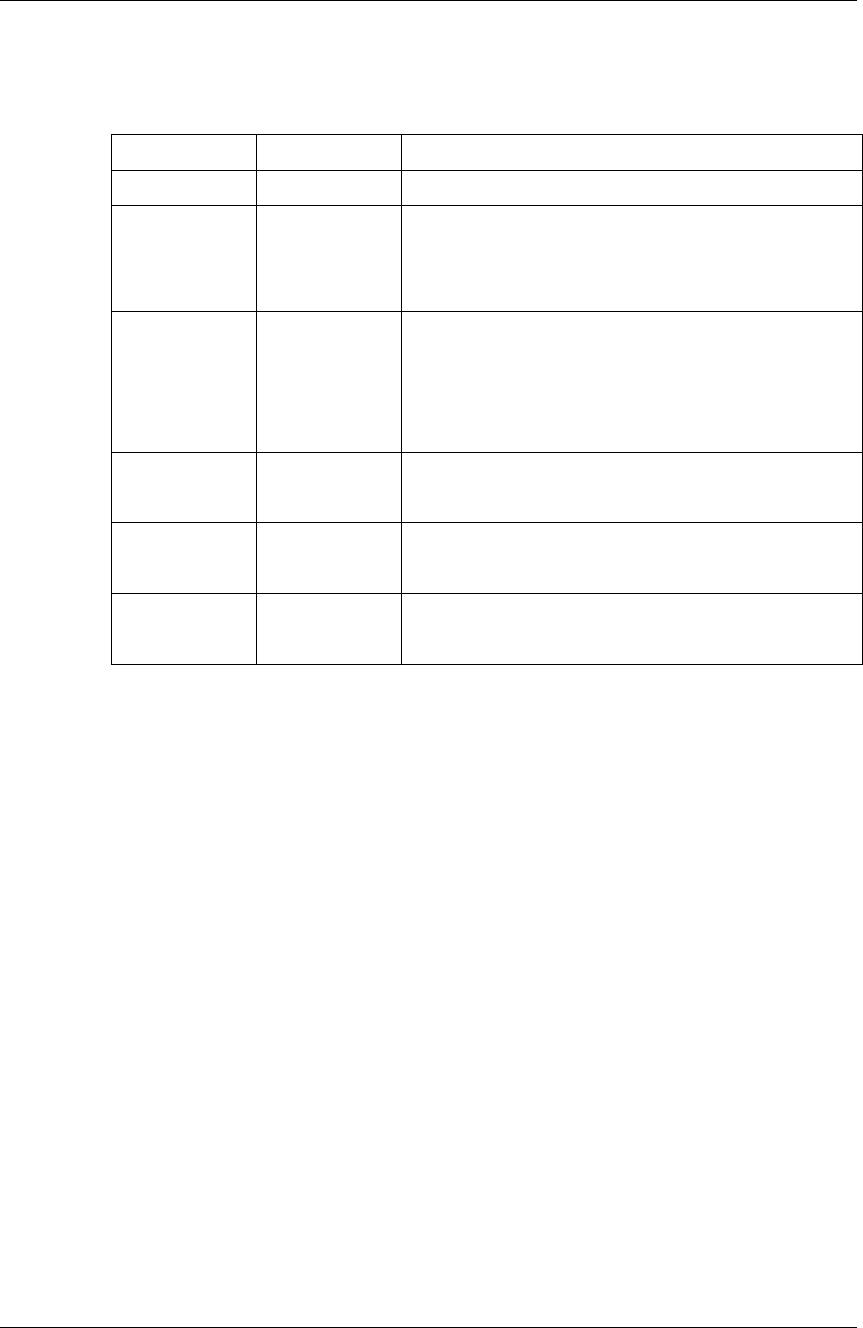
BioAdmin User Manual 13
Copyright © 2006, 2007 by Suprema Inc. http://www.supremainc.com
Revision History
Version Date Description
V1.0 2005.9.27 Created.
V1.1 2005.12.2 Incorporated the changes made by BioAdmin
V1.1.
Chapter 12. Site Key is added.
V2.0 2006.4.17 Incorporated the changes made by BioAdmin
V2.0.
Chapter 8. Access Control is added.
Chapter 9. Monitoring is added.
V3.0 2006.8.23 Time Attendance added
BioStation added.
V4.0 2007. 3. 5 Incorporated the changes made by BioAdmin
V4.0.
V4.1 2007. 5. 30 Incorporated the changes made by BioAdmin
V4.1.

BioAdmin User Manual 14
Copyright © 2006, 2007 by Suprema Inc. http://www.supremainc.com
1. Getting Started
1.1. Outline
This manual illustrates how to use BioAdmin software. BioAdmin is a PC Windows
software for the control and management of Suprema’s BioEntry, BioStation and
BEACon products. BioAdmin includes various functions needed for a host station
for applications of access control and time & attendance using these devices.
For proper hardware connection, please refer to BioEntry Installation manual and
BioStation Installation manual.
There are two approaches in managing BioEntry and BioStation. :
z Using BioAdmin program which is the management software running on
Windows based PC platforms. This manual is mainly focused on operating
BioEntry and BioStation using BioAdmin software.
z Integrating the management functionality into customer’s application software
using SDK which contains versatile API’s to control BioEntry and BioStation. For
further information, please refer to SFM SDK Reference Manual, BioStation
SDK manual, and UniFinger Engine SDK Reference Manual.
1.2. Fundamentals
This chapter provides introductive information on BioEntry, BioStation, and
BioAdmin including basic concepts, operation flow, and overview of the software.
1.2.1. Finger scan device
Fingerprint access device is a device to authenticate the identity of each person
using fingerprints. It can be easily integrated into access control system by
connecting with access control panel through industry standard interface such as
Wiegand interface. Since fingerprints contain biometric features which are unique
for each person, fingerprint access device can be substituted for existing access
devices, such as barcode, magnetic card, keypad, or RF card devices, with high
security and efficiency.
1.2.2. Finger scan smart card device
Fingerprint smart card device is an advanced model of fingerprint access device

BioAdmin User Manual 15
Copyright © 2006, 2007 by Suprema Inc. http://www.supremainc.com
which improves security of the system by integrating smart card technology.
Fingerprint data for each person is stored on user’s smart card and the device
authenticates the user by comparing the stored fingerprint data in the smart card
with the input fingerprint data.
1.2.3. Template
A template is the binary data representing the features of each fingerprint. The
fingerprint image acquired from a fingerprint sensor is converted to a template,
which is stored on the memory of the fingerprint access device or on user’s smart
card. In authenticating a user, a new template is also generated and compared
with the stored templates.
1.2.4. Enrollment
Enrollment is the process to store the fingerprint template with user information.
Through enrollment process, new users are entered into the system.
1.2.5. Verification
Verification is the process of authenticating an input fingerprint with the fingerprint of
the specified user. On BioEntry Smart, a user places smart card containing
personal fingerprint template and user information. Then, the device carries out
verification process by scanning an input fingerprint. On BioEntry Pass, verification
process can be implemented by connecting external Wiegand device, such as RF
card device, which provides the current user ID.
1.2.6. Identification
Identification is the process of searching a matched fingerprint among the stored
fingerprints on the device. BioEntry Pass and BioStation basically operate in
identification mode, which requires no additional input except the placement of a
finger.
1.2.7. User database
User database includes user ID, user name, fingerprint templates, and so on.
BioAdmin software is based on the central management of user database. That is,
the user database is created, updated, and stored on the host PC. Then, it is
selectively distributed to the BioEntry and BioStation connected on the network
using transfer menu.

BioAdmin User Manual 16
Copyright © 2006, 2007 by Suprema Inc. http://www.supremainc.com
1.2.8. Transfer
Transfer to Device is used to transfer the user database of the host PC to BioEntry
and BioStation. The user information such as User ID, templates, access group,
and security level is transferred by this process.
Detailed operations are as follows.
z Enroll new users on BioEntry and BioStation
z Replace inconsistent templates on BioEntry and BioStation
z Delete templates of unknown users or de-selected users on BioEntry and
BioStation
Transfer from Device is used to upload the user formation from BioEntry and
BioStation to the database of host PC. The user information such as User ID,
Template Number, Number of Access Group, and Security Level can be uploaded
by this process.
1.2.9. Site key for smartcard
Site key is a password for smart card to ensure that an authorized card should be
used for a specific installation. 48 bit key is used in BioEntry Smart allowing 0 to
281374976710655 (0xFFFFFFFFFFFF). For proper operation, the same key
should be configured on BioEntry Smart and user’s smart card.
1.3. How to place a finger
1.3.1. Select a finger to enroll
(1) It is recommended to use an index finger or a middle finger.
(2) Thumb, ring or little finger is relatively more difficult to place in a correct position.
1.3.2. How to place a finger on a sensor
(1) Place a finger as it completely covers the sensor with maximum contact.
(2) It is better to place the core part of a fingerprint to the center of a sensor.
People usually tend to place only the top end of a finger
Where is the core (center) of a fingerprint?
A peak where spirals of fingerprint ridges are dense
Usually opposite to lower part of a nail
It is recommended to place a finger as the lower part of a nail is located at the
center of a sensor
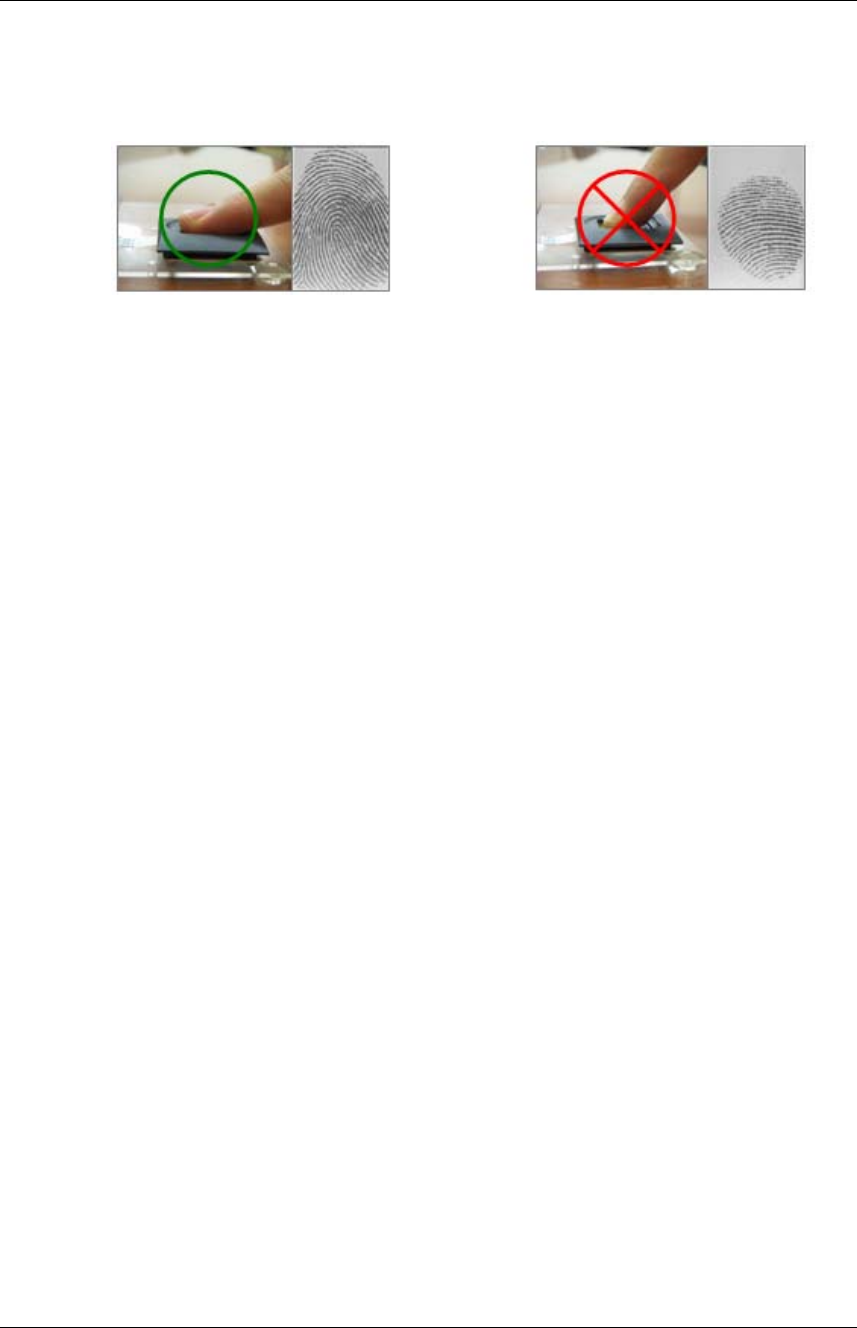
BioAdmin User Manual 17
Copyright © 2006, 2007 by Suprema Inc. http://www.supremainc.com
(3) If a finger is placed as in the right picture, only a small area of a finger is
captured. So it is recommended to place a finger as in the left picture.
1.3.3. Tips for different finger conditions
Suprema’s fingerprint products are designed to scan fingerprint smoothly
regardless of the conditions of a finger skin. However, if a fingerprint is difficult to
scan due to other influences, please refer to the followings tips.
(1) If a finger is stained with sweat or water, scan after wiping moisture off
(2) If a finger is covered with dust or impurities, scan after wiping them off
(3) If a finger is way too dry, scan after blowing warm breath on a fingertip.
1.3.4. Advices on fingerprint enrollment
(1) In fingerprint recognition, enrollment process is very important. Therefore,
when enrolling a fingerprint, please try to place a finger correctly with care.
(2) In case of low acceptance ratio, the following actions are recommended.
Delete enrolled fingerprints and re-enroll the fingers.
Enroll the same finger additionally
Try with another finger if a finger is not easy to enroll due to scar or worn-
out.
(3) For the case when an enrolled fingerprint can’t be used due to scar or
holding a baggage, it is recommended to enroll more than two fingers.
1.4. Concept of BioAdmin 4.1
BioAdmin 4.1 is operated as server-client application so that users can operate the
BioAdmin Client program from multiple host PCs at the same time. If the users
connect BioStation to the BioAdmin Server, logs from the BioStation will be
automatically stored on the database of BioAdmin Server real-time. In this server-
client application, BioAdmin Client is used as the user interface to manage the data.
If the user does not connect the BioStation to the BioAdmin Server, logs will not be

BioAdmin User Manual 18
Copyright © 2006, 2007 by Suprema Inc. http://www.supremainc.com
stored on the database automatically.
BioAdmin Server is designed only for BioStation. Therefore, you can not use the
BioEntry or BEACon as the server-client application.
This chapter describes the installation and operation of BioAdmin Server and
BioAdmin Client programs.
1.4.1. How to install BioAdmin Server
z Select the PC to be used as the server. Server PC should be always tuned on ,
because it should receive log data from the connected BioStation and store it on
the database real time.
z After selecting a PC to use as the BioAdmin Server, install the BioAdmin Server
program. This chapter shows the installation process under the condition that
you are using the database on your host PC. If you are using MySQL or SQL
Server, you can refer to the chapter 1. 4. 3.
z Start Installation.
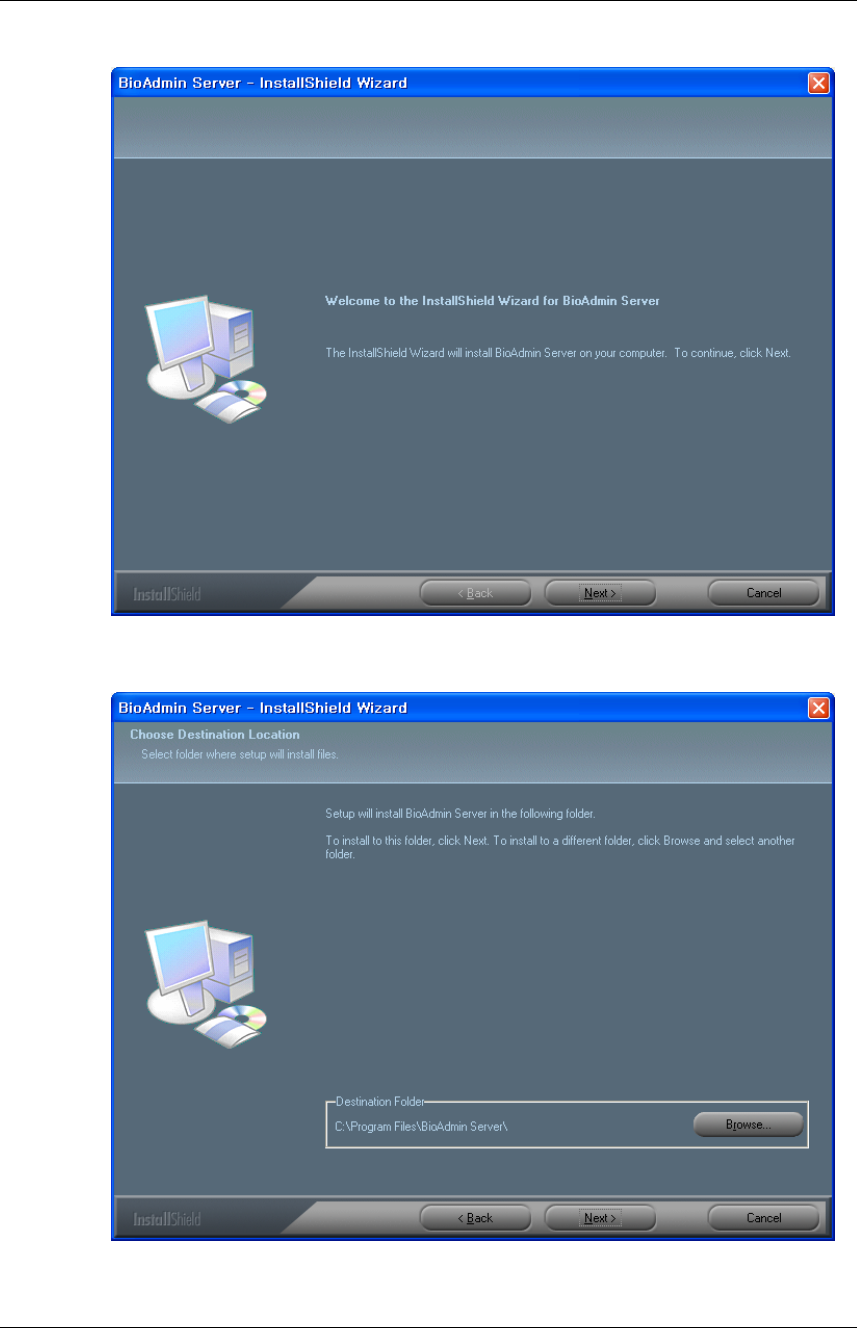
BioAdmin User Manual 19
Copyright © 2006, 2007 by Suprema Inc. http://www.supremainc.com
z Choose Destination Location
Choose the hard disk drive on which BioAdmin Server is to be installed. By
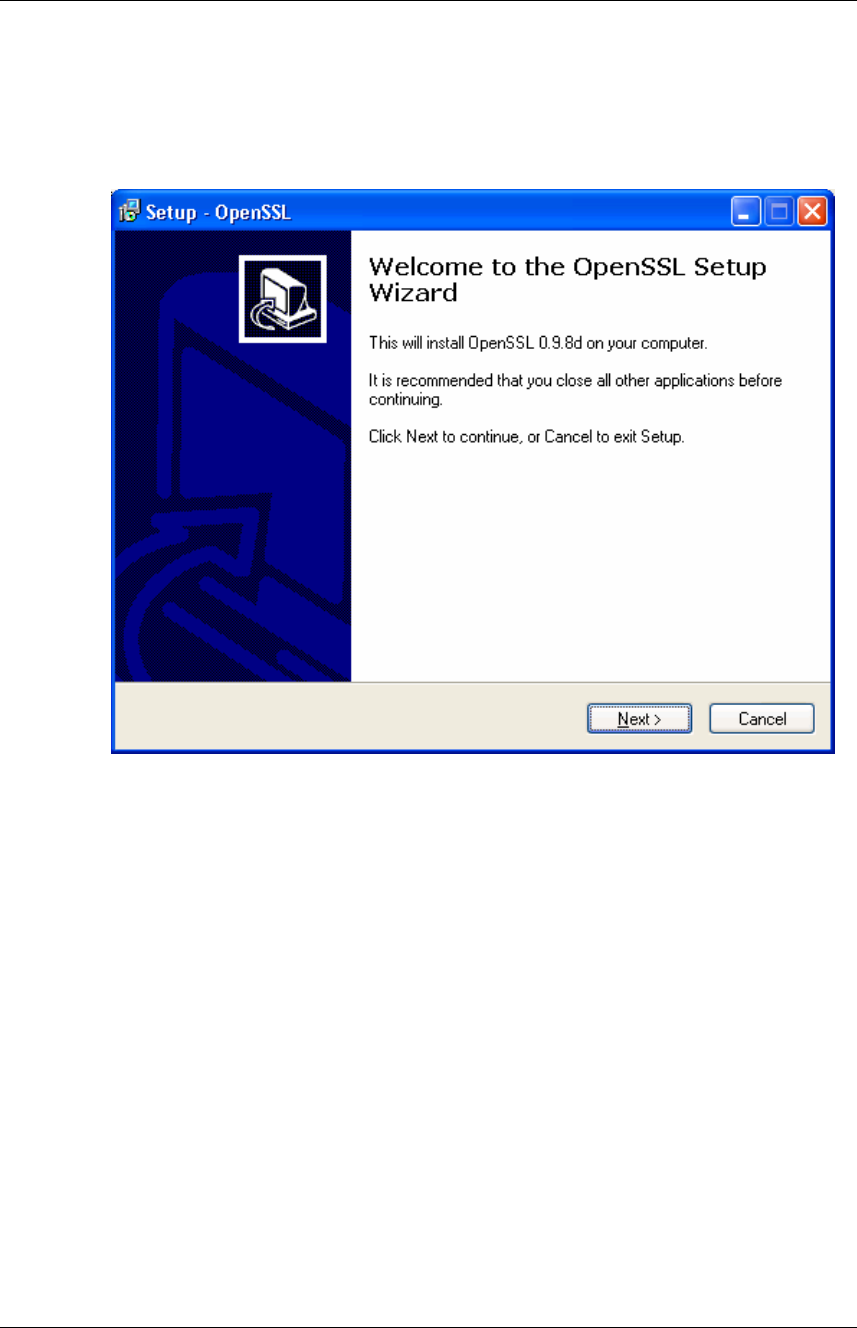
BioAdmin User Manual 20
Copyright © 2006, 2007 by Suprema Inc. http://www.supremainc.com
default, BioAdmin Server is installed in C:\Program Files\BioAdmin Server\.
z Setup Open SSL
After copying all files, set up the Open SSL.
z BioAdmin Server Configuration and Database Setting
If you finish the Open SSL set up, following window will appear which is to set
up the BioAdmin Server configuration. In most cases, you can maintain its
default value for the BioAdmin Server configuration.
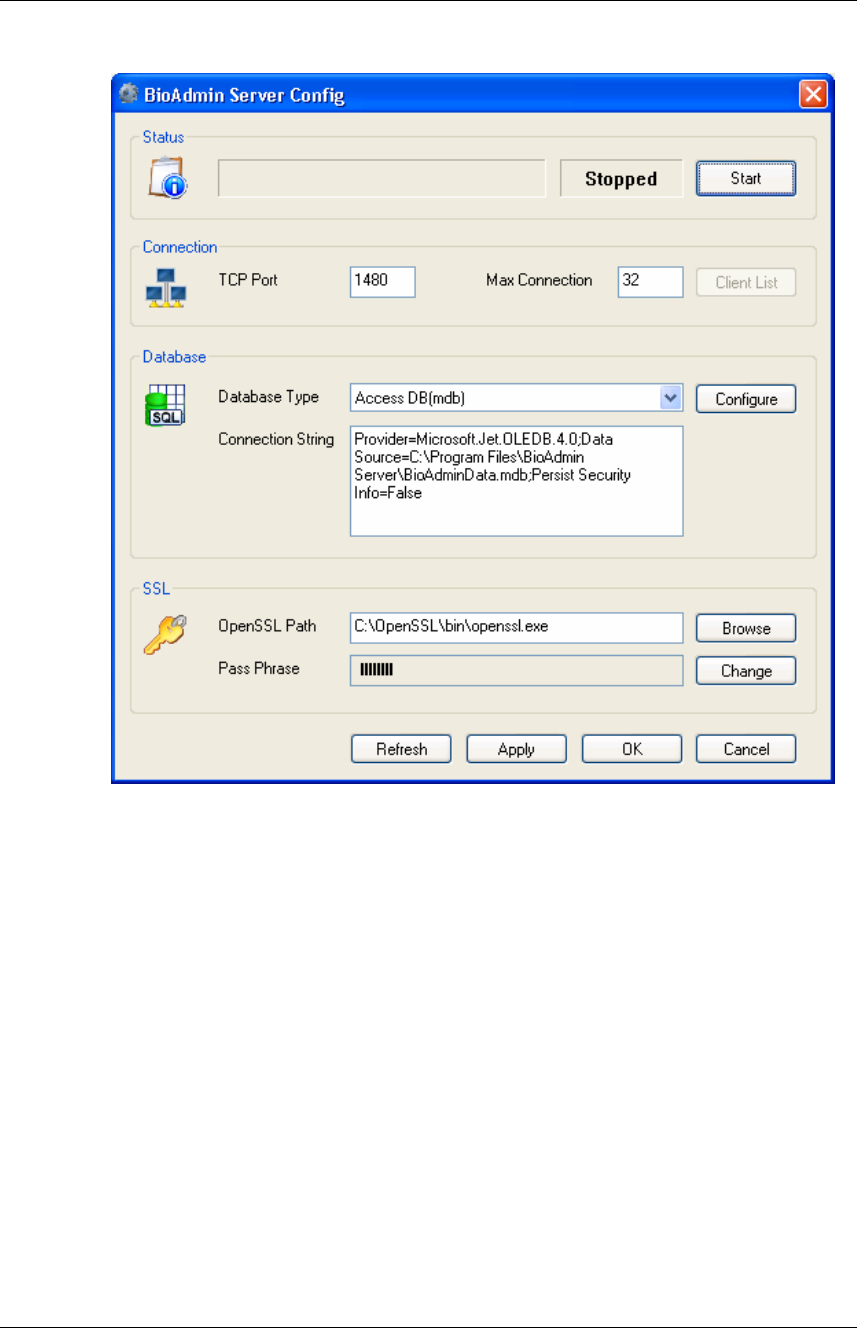
BioAdmin User Manual 21
Copyright © 2006, 2007 by Suprema Inc. http://www.supremainc.com
z Status
Status shows the current version and status of the BioAdmin Server. By pressing
Start or Stop button, you can start or stop the operation of BioAdmin Server.
If BioAdmin Server is stopped, logs from the networked BioStation will not be
stored on the database of the BioAdmin Server and BioAdmin Client will not be
able to access to the BioAdmin Server.
If you changed any server configuration or database setting, stop the BioAdmin
Server and restart it. Before you restart the BioAdmin Server, changes in the
BioAdmin Server configuration or database will not be applied to the BioAdmin
Server.

BioAdmin User Manual 22
Copyright © 2006, 2007 by Suprema Inc. http://www.supremainc.com
z Connection
On this menu, you can set up the networking details.
TCP Port
Enter the TCP port. This TCP port is used when you attach a BioStation to the
BioAdmin Server or when you access to the BioAdmin Server from BioAdmin
Client. Use a unique port, which is not used by any other software.
In most cases, you can use the default port, 1480.
Max Connection
Enter the maximum number of BioStation or BioAdmin Client, which can be
connected to the BioAdmin Server at the same time. For example, if you
designate it as 50, the total number of BioStation and BioAdmin Client, which
can be connected to the BioAdmin Server simultaneously, will be 50.
Maximum number for this connection should be less than 128. If the number
is less than 32, which is the default value, you do not need to lower this
number from the default.
Client List
Client List shows the list of BioStations, which are connected to the BioAdmin
Server. This list shows the IP Address of those connected BioStations and
indicates whether the SSL Certificate was issued. You can issue or remove
the SSL Certificate on this list. If the BioAdmin Server is stopped, this menu
will be deactivated.

BioAdmin User Manual 23
Copyright © 2006, 2007 by Suprema Inc. http://www.supremainc.com
Database
Select the database type of the BioAdmin Server. BioAdmin Server uses
Microsoft Access Database by default. If you are not using any external
database, leave this field just as its default, MS Access DB (mdb).
Additionally, if you are already using MySQL or SQL Server, BioAdmin Server
also supports MySQL and SQL Server. However, BioAdmin Server does not
provide any new installation of the MySQL or SQL Server.
For the details of the database management, refer to the chapter 1. 4. 3.
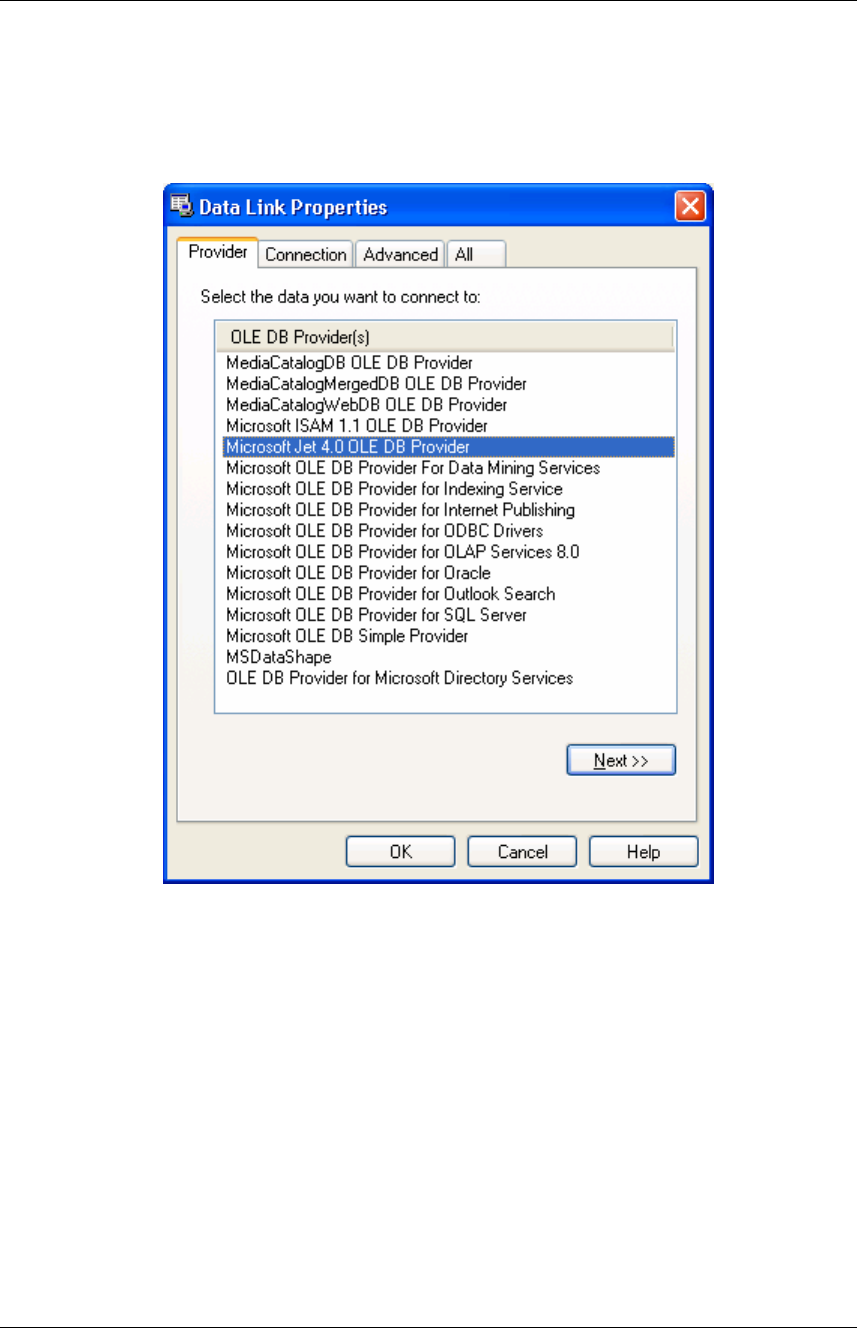
BioAdmin User Manual 24
Copyright © 2006, 2007 by Suprema Inc. http://www.supremainc.com
After selecting the database type, press Configure button and set up the
database. If you are using the default mdb file, select Microsoft Jet 4.0 OLE
DB Provider.
Press Next button.
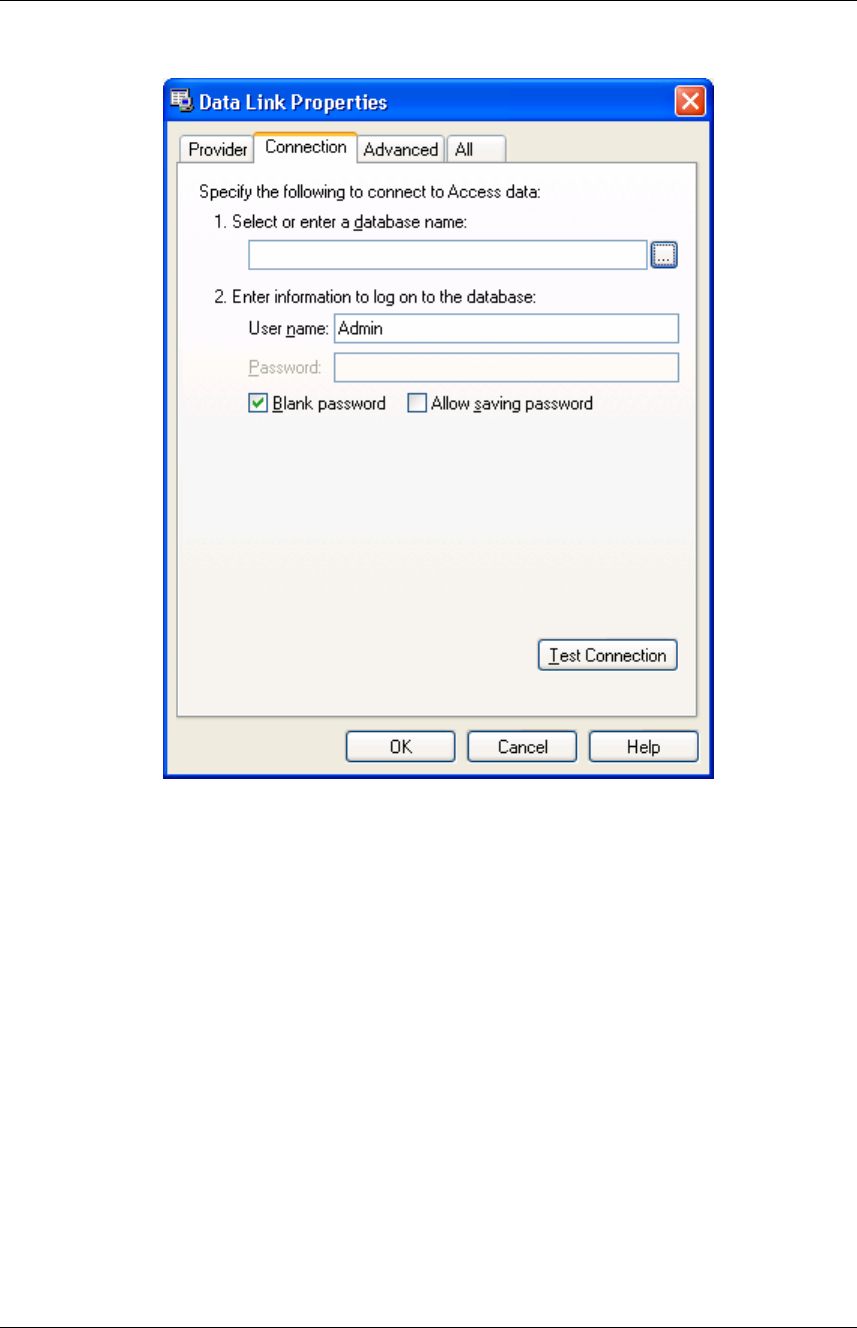
BioAdmin User Manual 25
Copyright © 2006, 2007 by Suprema Inc. http://www.supremainc.com
Select the Database file and press OK button.
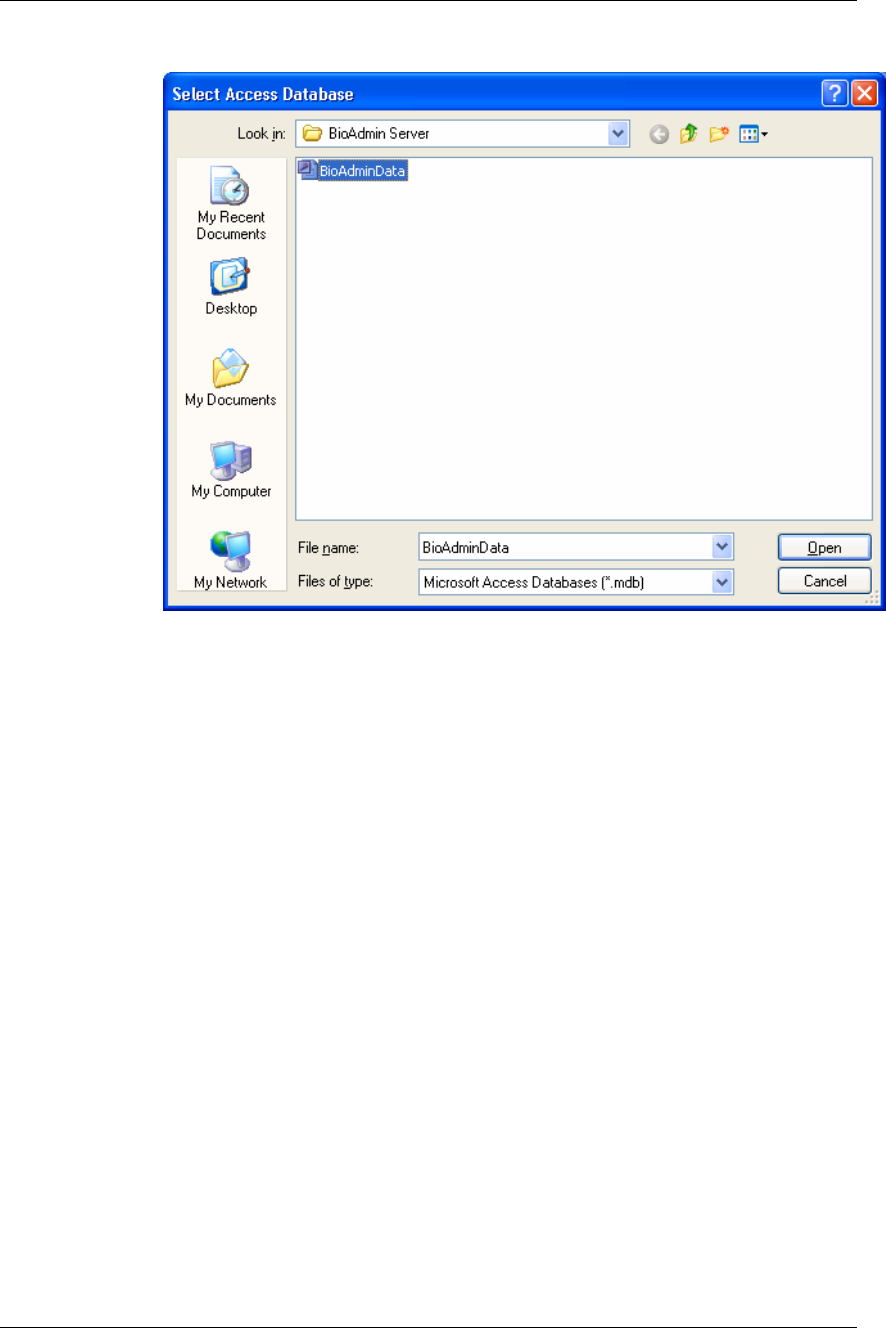
BioAdmin User Manual 26
Copyright © 2006, 2007 by Suprema Inc. http://www.supremainc.com
SSL
Set up the encryption details between BioAdmin Server and BioAdmin Client
or between BioAdmin Server and BioStation.
Press Refresh button to show the current setting.
Press Apply button to store the new setting. To apply the changes, you
should stop and restart the BioAdmin Server.
Press OK button to store the new setting and close the BioAdmin Server
Config window.
Press Cancel button to cancel the new setting and close the BioAdmin
Server Config window.
z OpenSSL Setting
BioAdmin Server uses a encrypted communication with BioAdmin Client and
BioStation by using SSL authentication. Encrypting the communication between
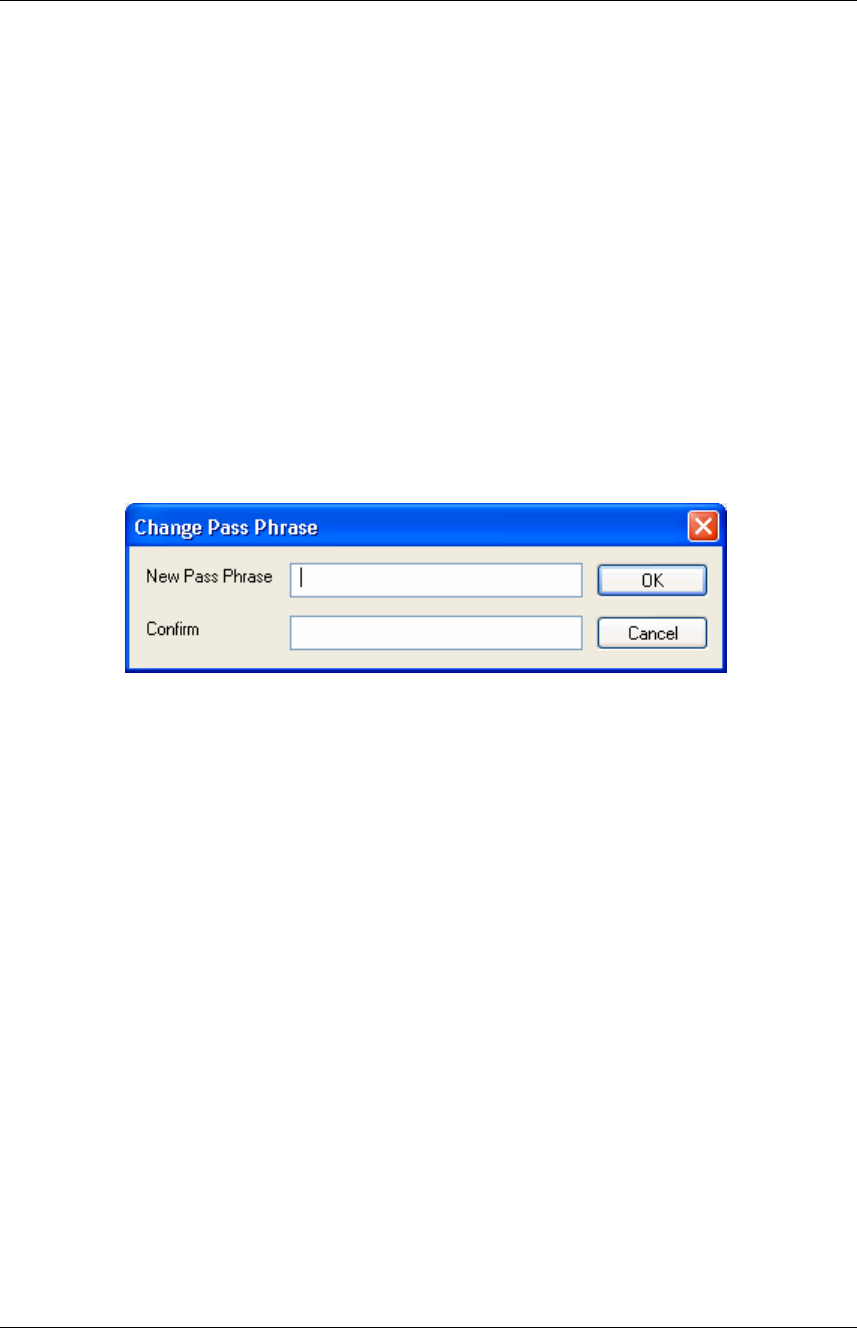
BioAdmin User Manual 27
Copyright © 2006, 2007 by Suprema Inc. http://www.supremainc.com
BioAdmin Server and BioAdmin Client (or BioStation) enables much more secure
solution to protect the information.
Designate the OpenSSL path. By default, you can find the file on the following
directory. If it is installed in any other directory, click the “Browse” and designate the
correct directory.
Default directory of the openssl.exe : (C:\OpenSSL\bin\openssl.exe)
Pass Phrase is required to issue the certificate. You should enter more than 8 digits,
combination of English, number, or special character. To make the system secure,
you are strongly recommended to change the Pass Phrase upon the initial
installation of BioAdmin Server.
If you change this Pass Phrase while using the BioAdmin Server after the
installation, you should conduct the following procedures.
Change the SSL option of the connected BioStations as Not Use.
Stop the BioAdmin Server.
Change the Pass Phrase.
Start the BioAdmin Server.
Issue the SSL certificate for BioStation.
If you are using BioAdmin Client, select the BioStation and press the right
button of the mouse. Select Authenticate Device.
If the certificate is issued properly and stored on the BioStation, BioStation
will restart automatically.
z DB Migration Tool
If you were BioAdmin version 3.X, you need to convert the data from BioAdmin 3.1
to BioAdmin 4.X.
If you do not need the old data, press Close button.
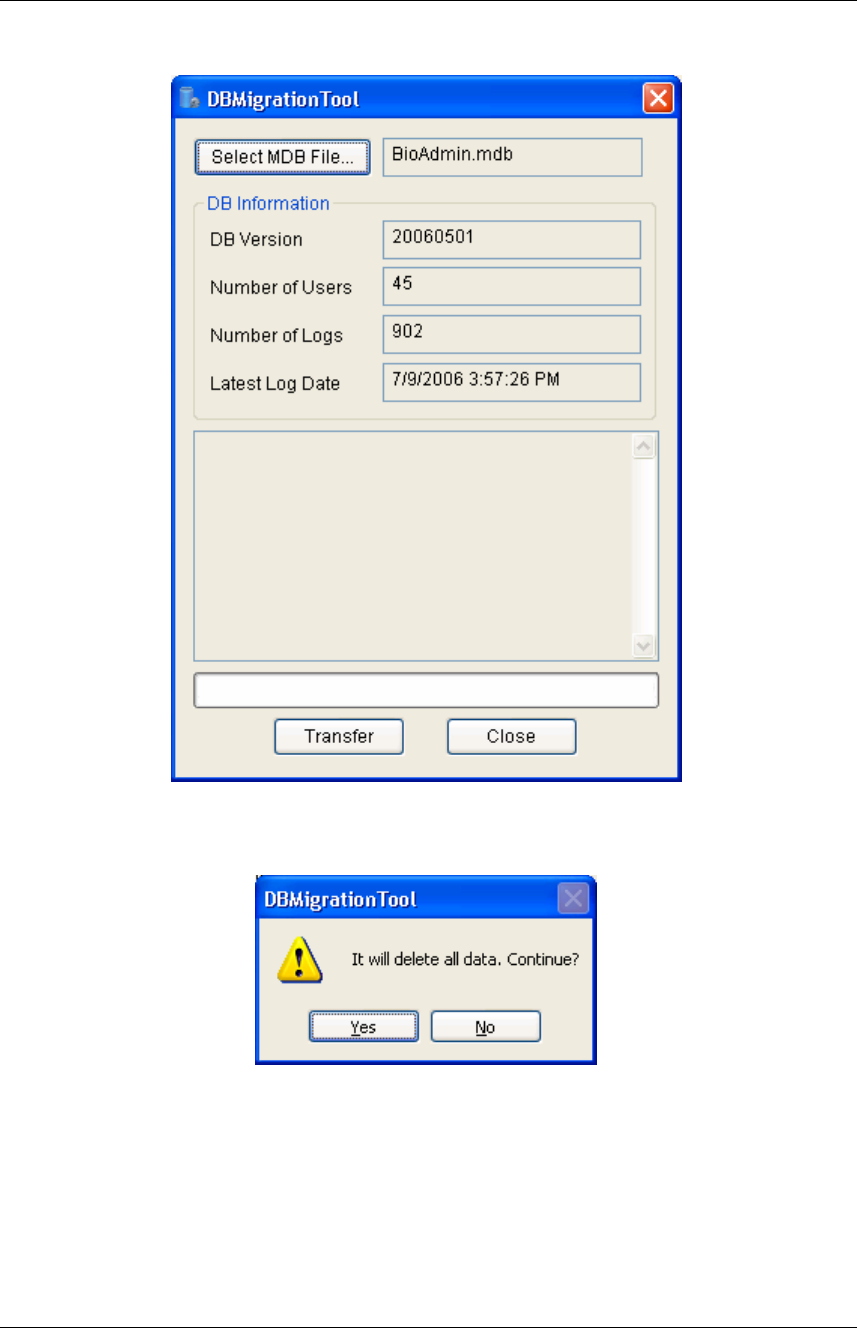
BioAdmin User Manual 28
Copyright © 2006, 2007 by Suprema Inc. http://www.supremainc.com
Select the old BioAdmin.mdb file.
Press Transfer button to transfer the old data to BioAdmin 4.X.
If you transfer the old data, old data will be deleted. Therefore, if necessary, back
up the old data before transferring to BioAdmin 4.X. This data transfer may take
time depending on the size of the existing database.
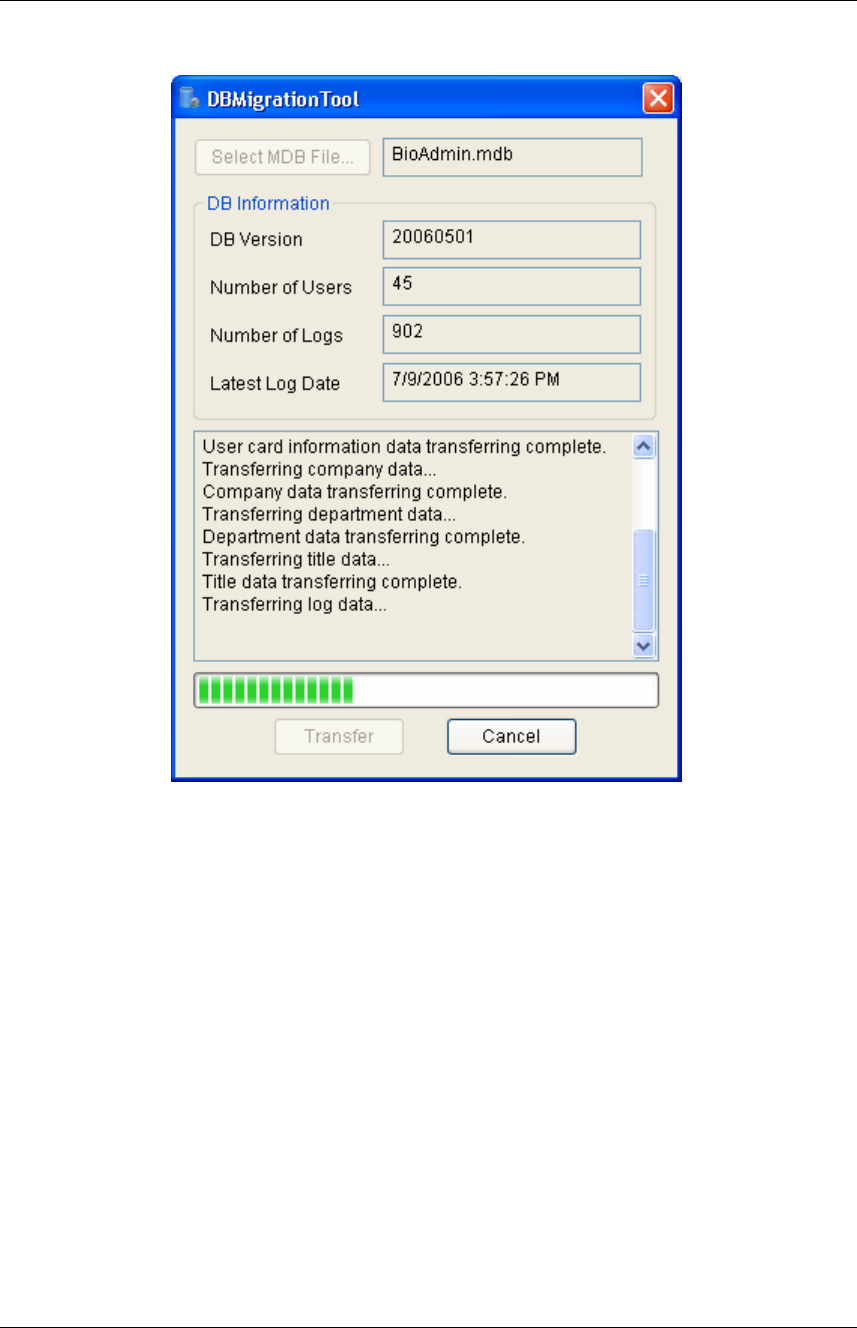
BioAdmin User Manual 29
Copyright © 2006, 2007 by Suprema Inc. http://www.supremainc.com
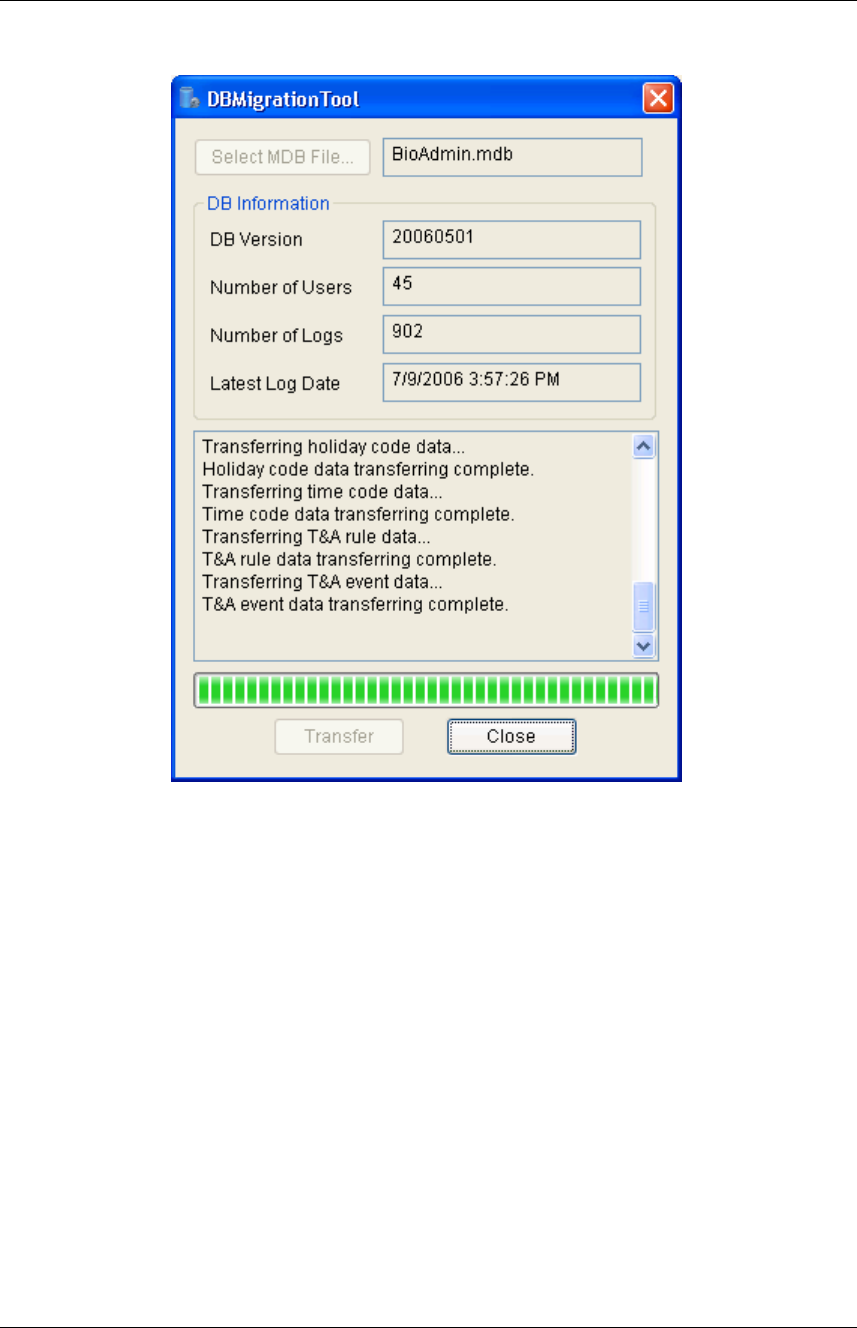
BioAdmin User Manual 30
Copyright © 2006, 2007 by Suprema Inc. http://www.supremainc.com
After the transfer, press Close button.
z Installation Complete
BioAdmin Server was successfully installed. If you are using the OS Windows
2000 or XP, BioAdmin Server will start as its background service. After this initial
installation, BioAdmin Server will run automatically.
1.4.2. How to install BioAdmin Client
z Start Installation.
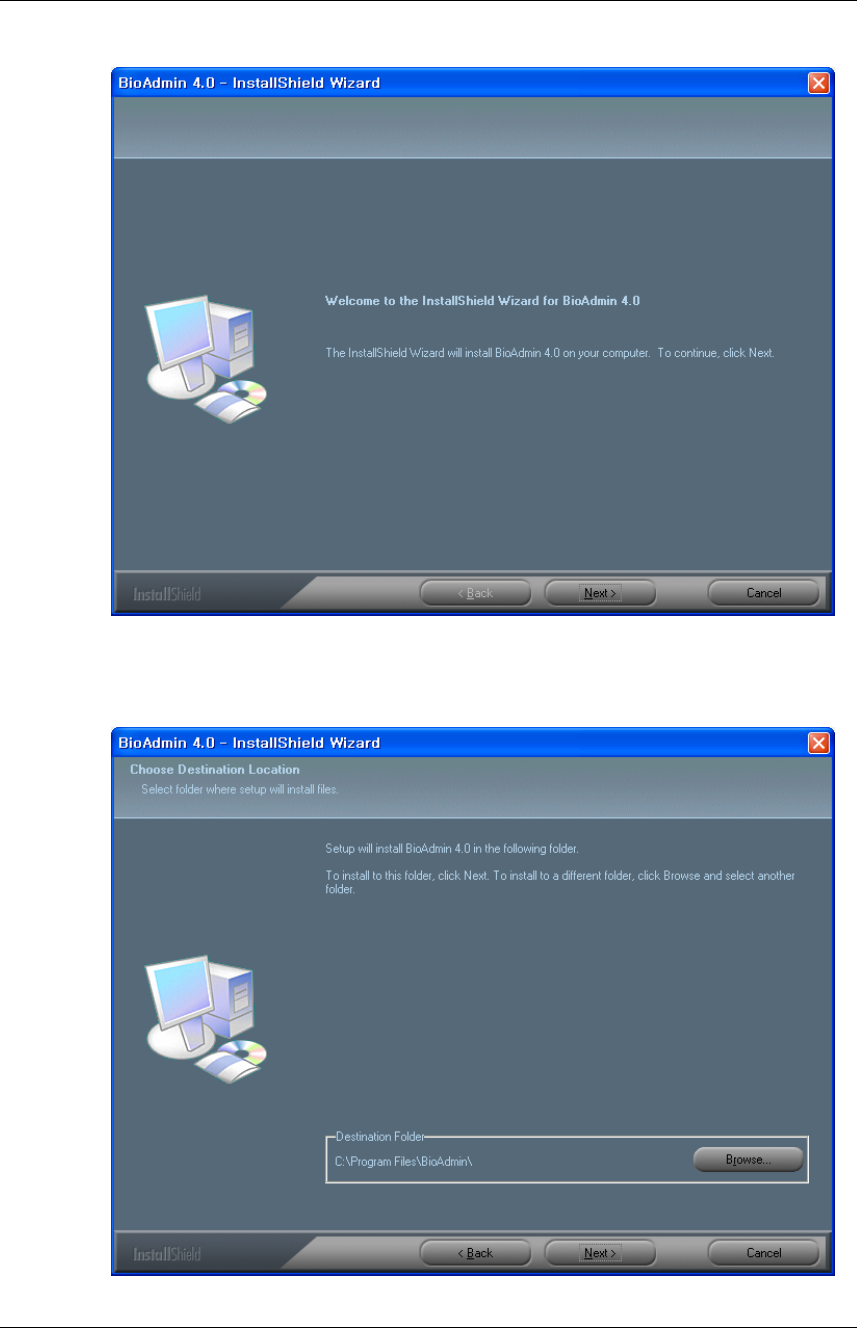
BioAdmin User Manual 31
Copyright © 2006, 2007 by Suprema Inc. http://www.supremainc.com
z Choose Destination Location
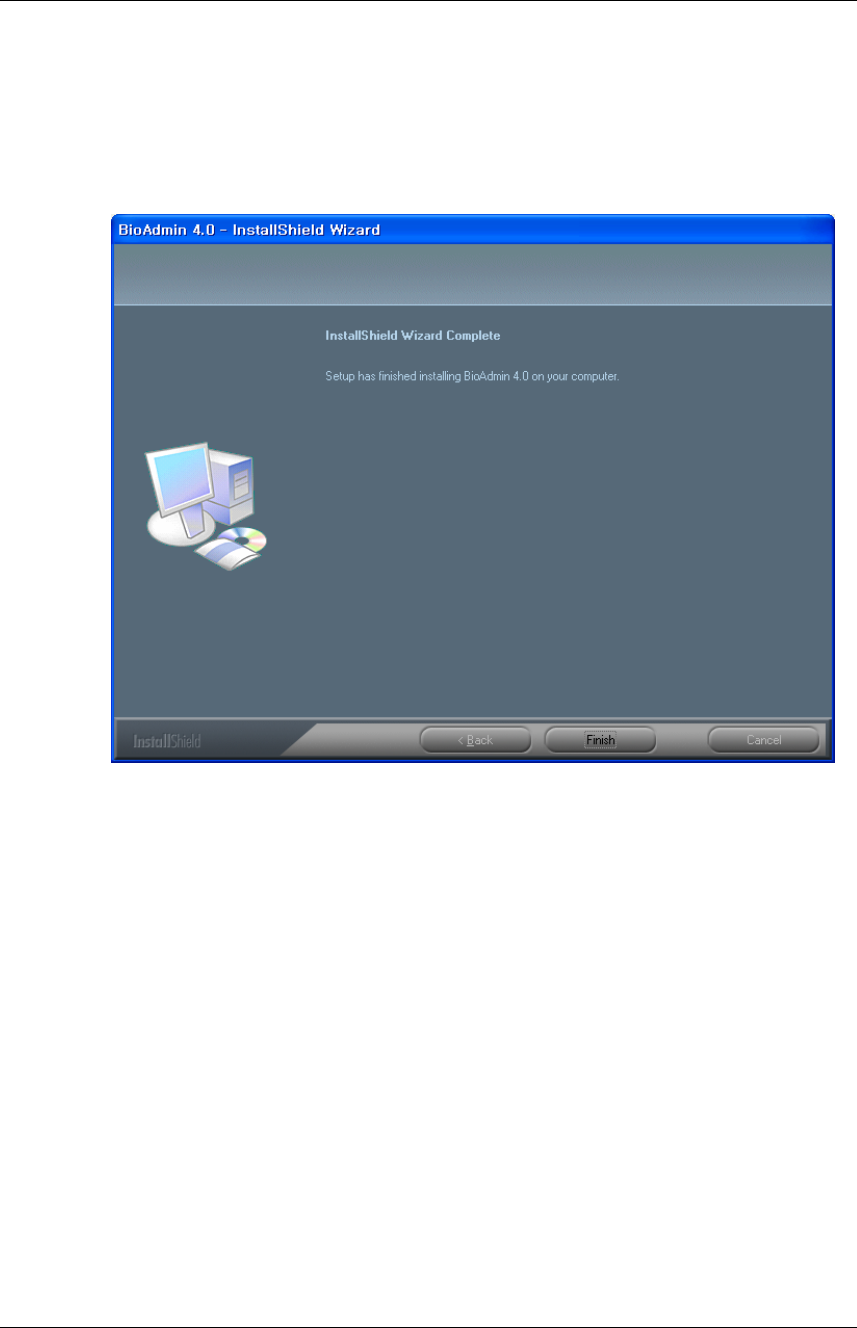
BioAdmin User Manual 32
Copyright © 2006, 2007 by Suprema Inc. http://www.supremainc.com
Choose the hard disk drive on which BioAdmin Client is to be installed. By
default, BioAdmin Client is installed in C:\Program Files\BioAdmin.
Installation Complete
BioAdmin Client was successfully installed. Close the installation program
and execute the BioAdmin Client.
1.4.3. Using MySQL or SQL Server database
You can use MySql or SQL Server database by the following procedures.
z Using MySQL database
If you are already using MySQL Server, you can use the MySQL database instead
of mdb.
Execute BioAdmin Server Config menu.
Click the Configure button on the Database field.
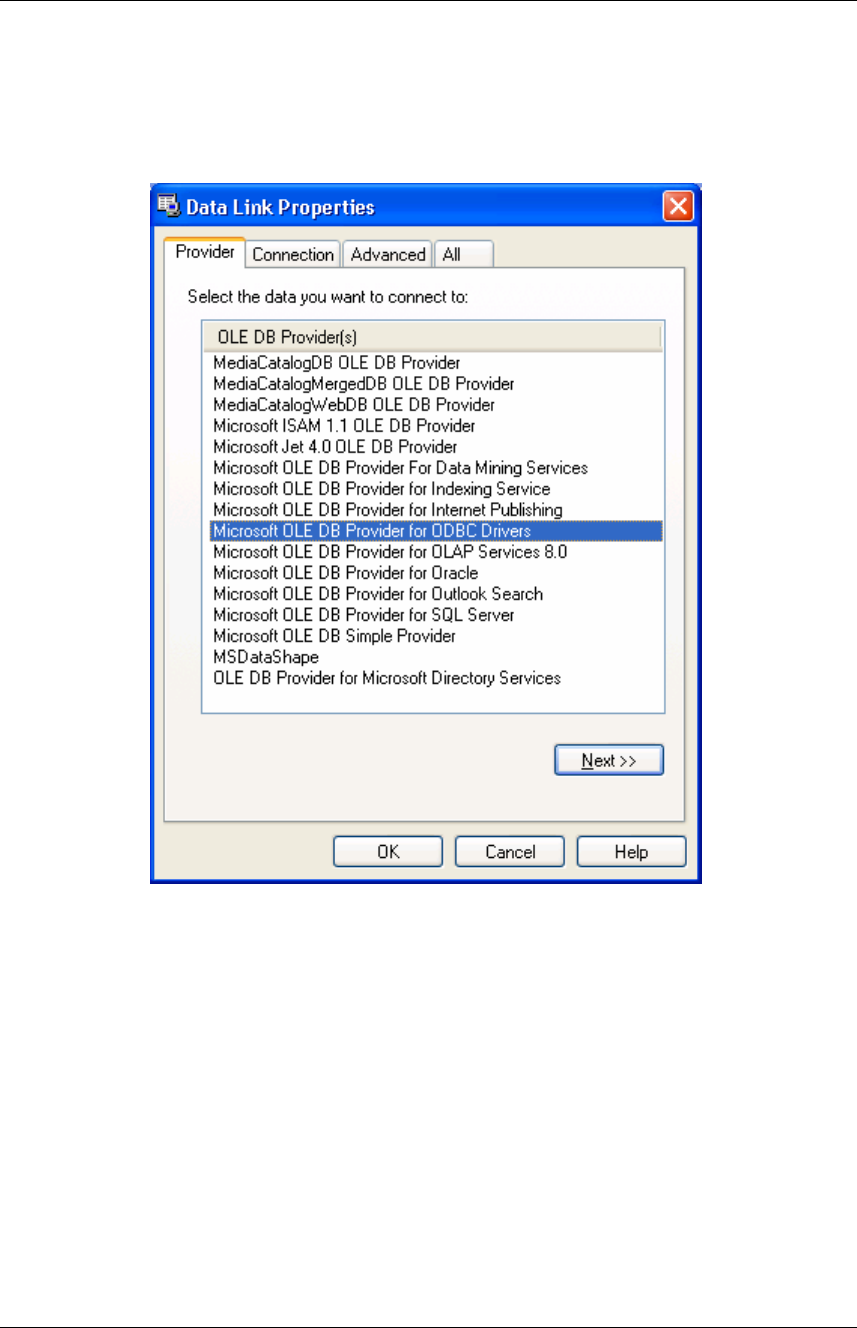
BioAdmin User Manual 33
Copyright © 2006, 2007 by Suprema Inc. http://www.supremainc.com
On the Data Link Properties window, select Microsoft OLE DB Provider
for ODBC Drivers and press Next button.
Select data source name.
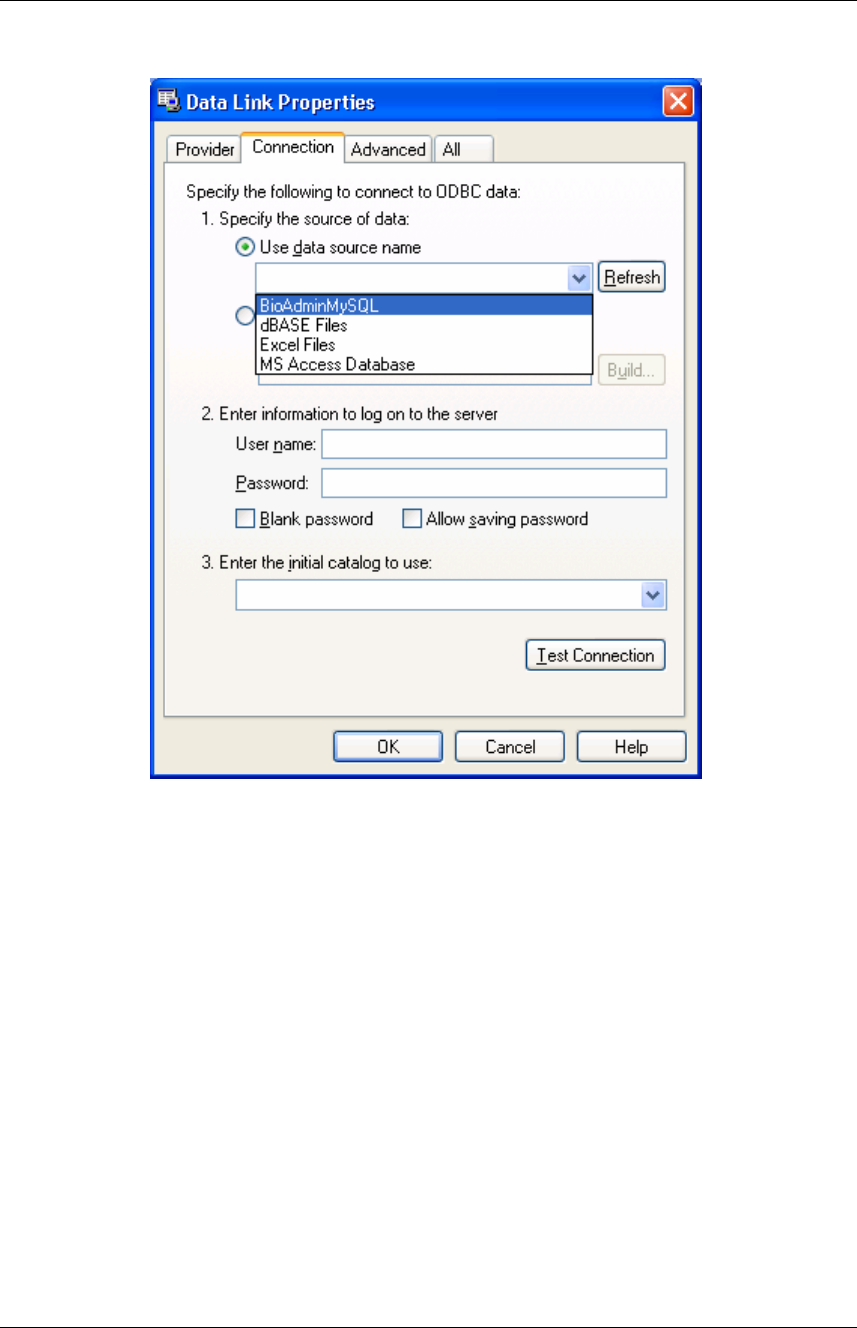
BioAdmin User Manual 34
Copyright © 2006, 2007 by Suprema Inc. http://www.supremainc.com
Enter the ID and password of the DB server. It there is no password
designated, check on the Blank password. If there is any password,
check on the Allow saving password.
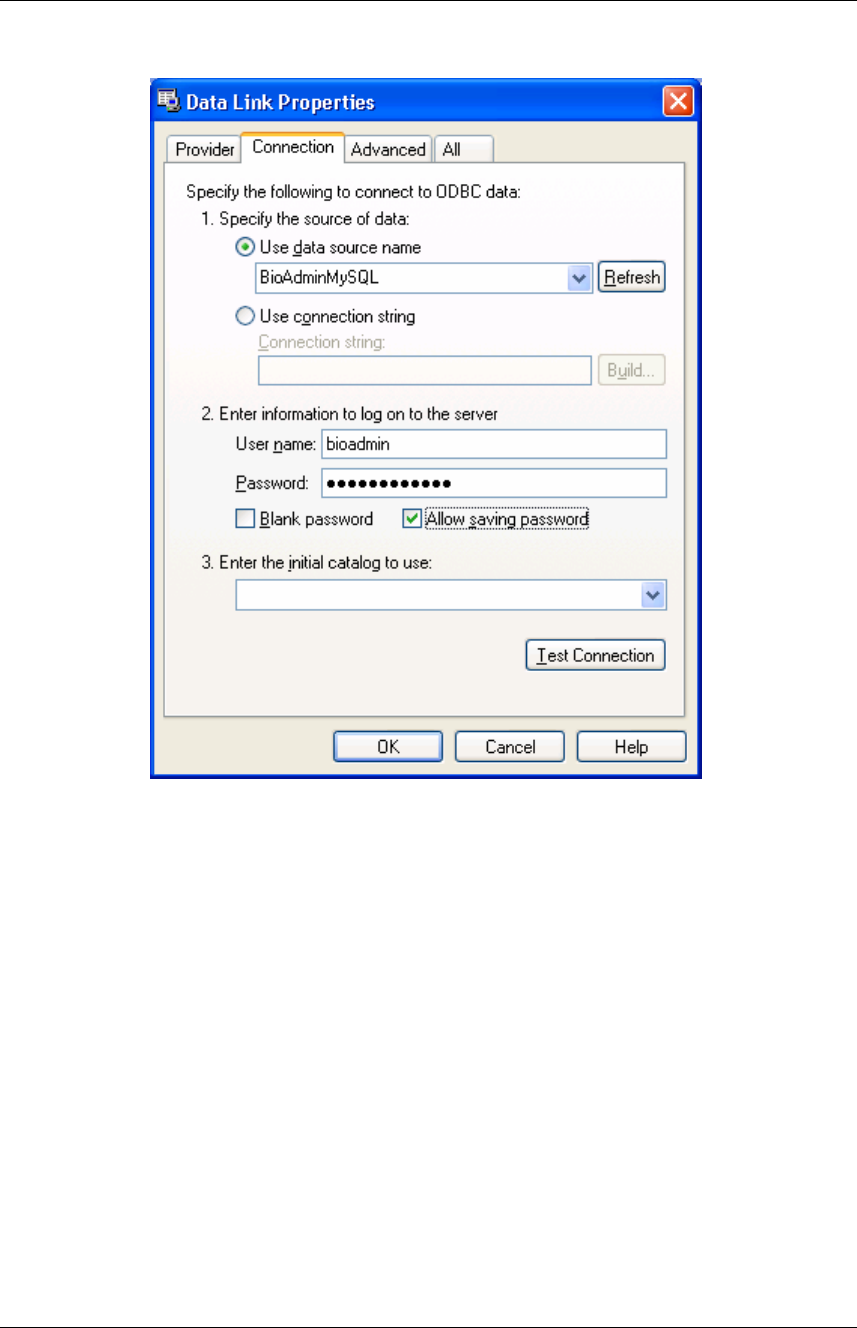
BioAdmin User Manual 35
Copyright © 2006, 2007 by Suprema Inc. http://www.supremainc.com
Press Test Connection button to check the connection status.
Press OK button.
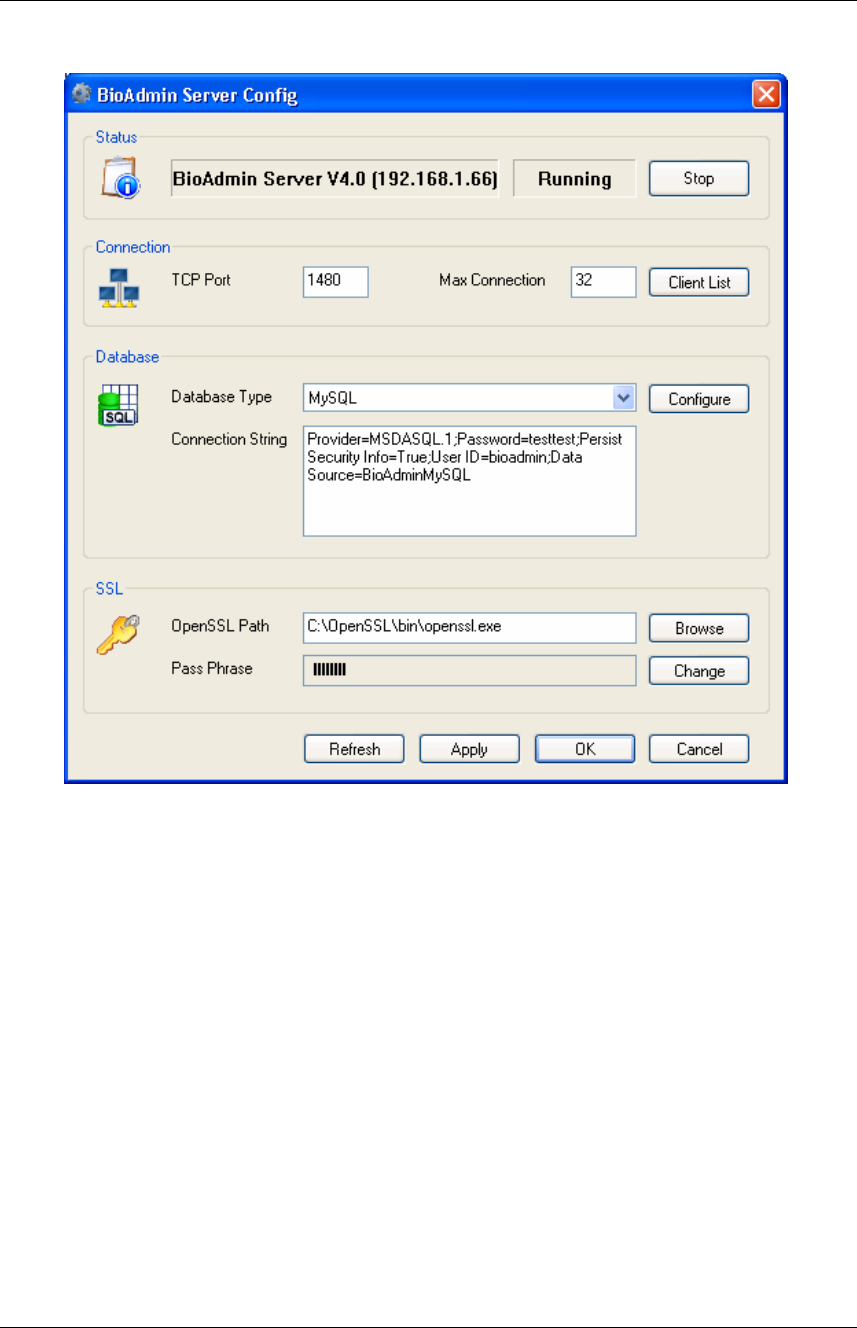
BioAdmin User Manual 36
Copyright © 2006, 2007 by Suprema Inc. http://www.supremainc.com
Select the database type as MySQL.
It you were already using the MySQL, press Apply button on BioAdmin
Server Config. Press Stop and Start the BioAdmin server.
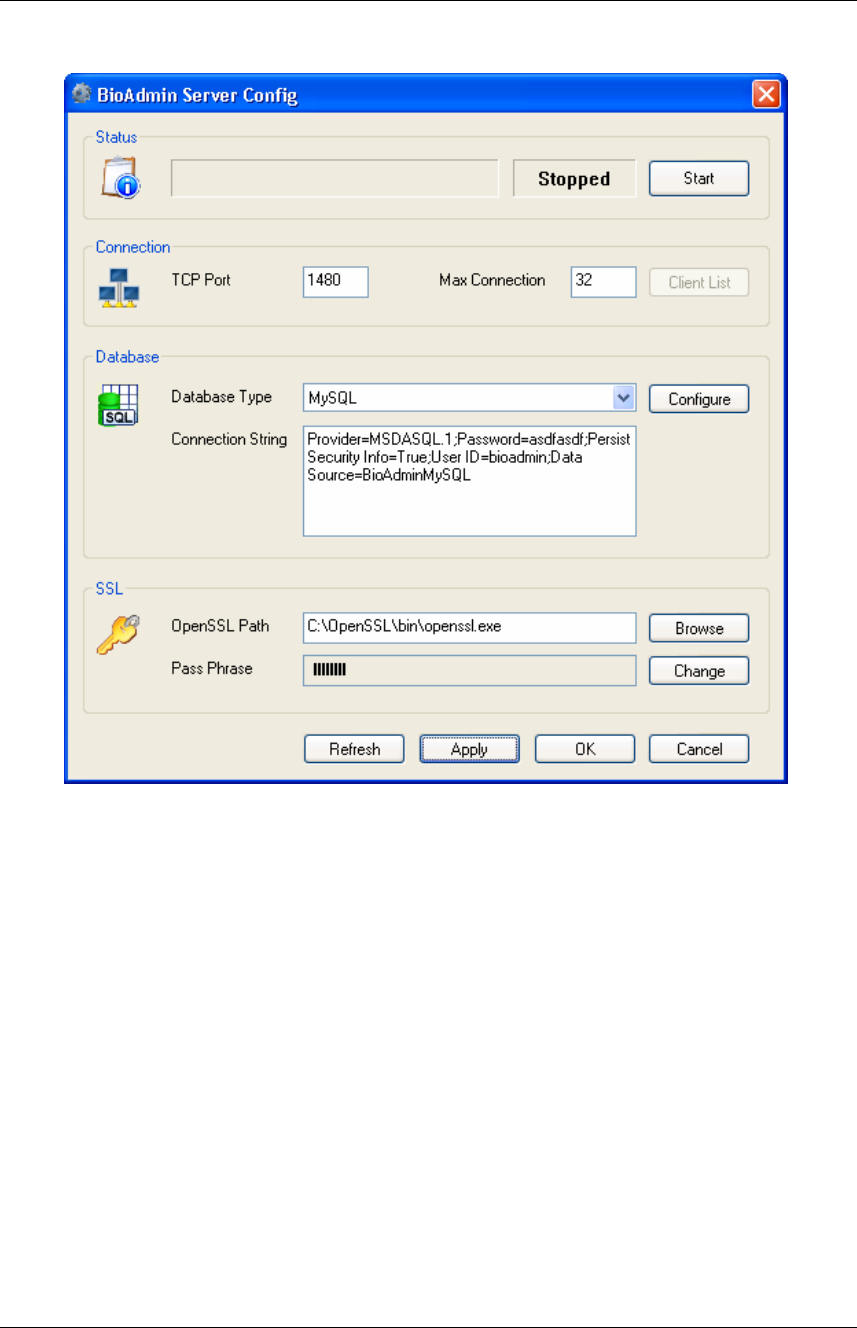
BioAdmin User Manual 37
Copyright © 2006, 2007 by Suprema Inc. http://www.supremainc.com
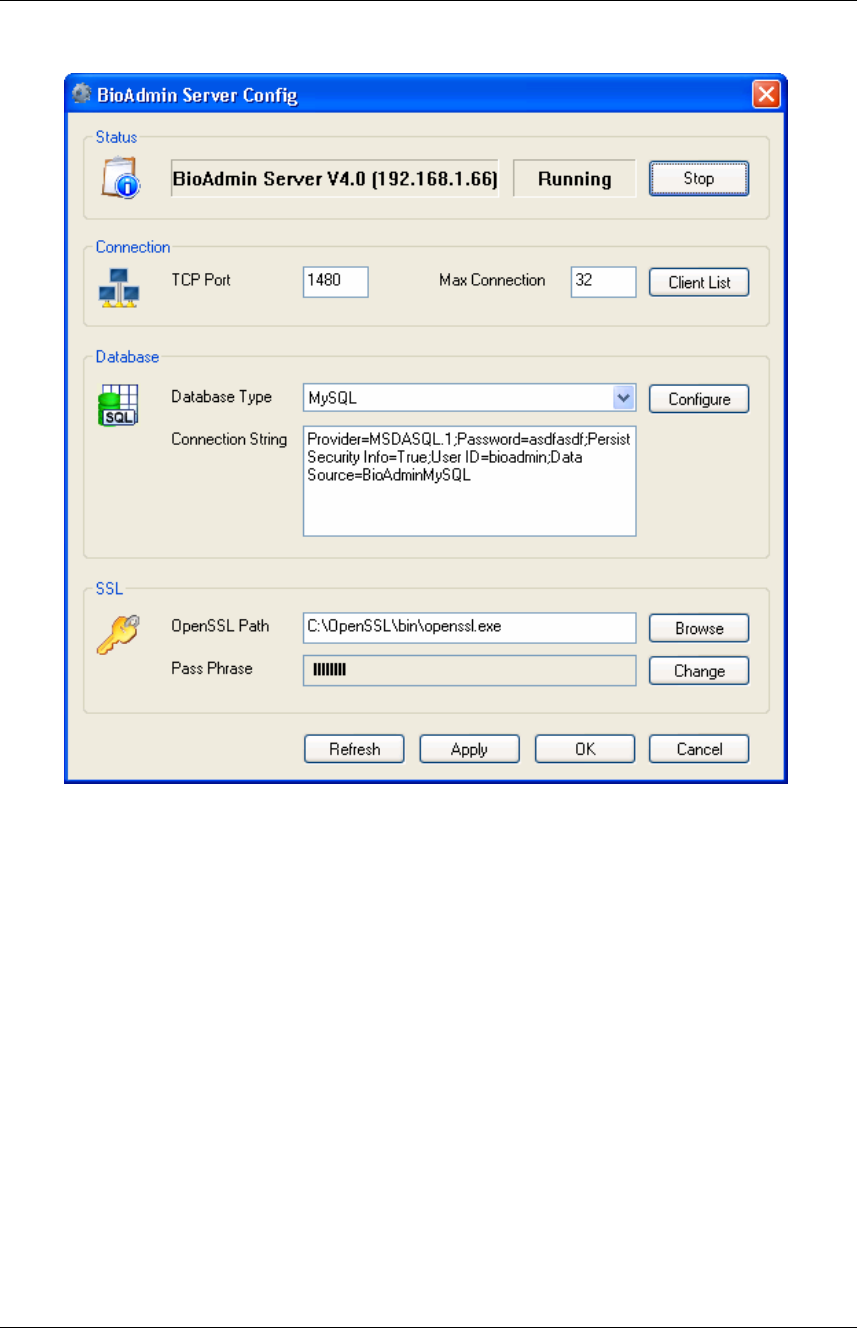
BioAdmin User Manual 38
Copyright © 2006, 2007 by Suprema Inc. http://www.supremainc.com
If the status is changed as Start, press OK button.
z Using SQL Server database
If you are already using MySQL Server, you can use SQL Server database instead
of mdb.
Execute BioAdmin Server Config menu.
Click the Configure button on the Database field.
On the Data Link Properties window, select Microsoft OLE DB Provider
for SQL Server and press Next button.
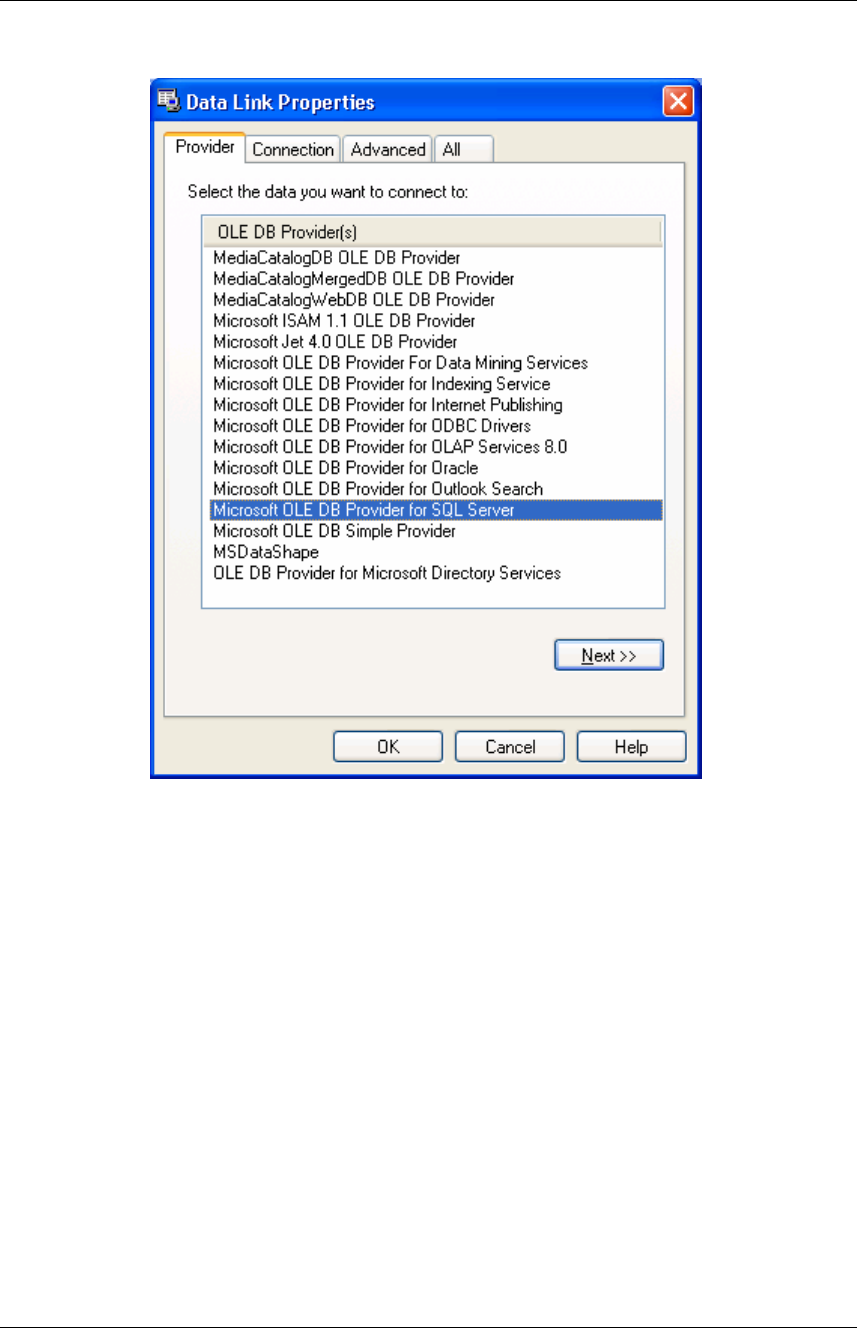
BioAdmin User Manual 39
Copyright © 2006, 2007 by Suprema Inc. http://www.supremainc.com
Enter the SQL Server name.
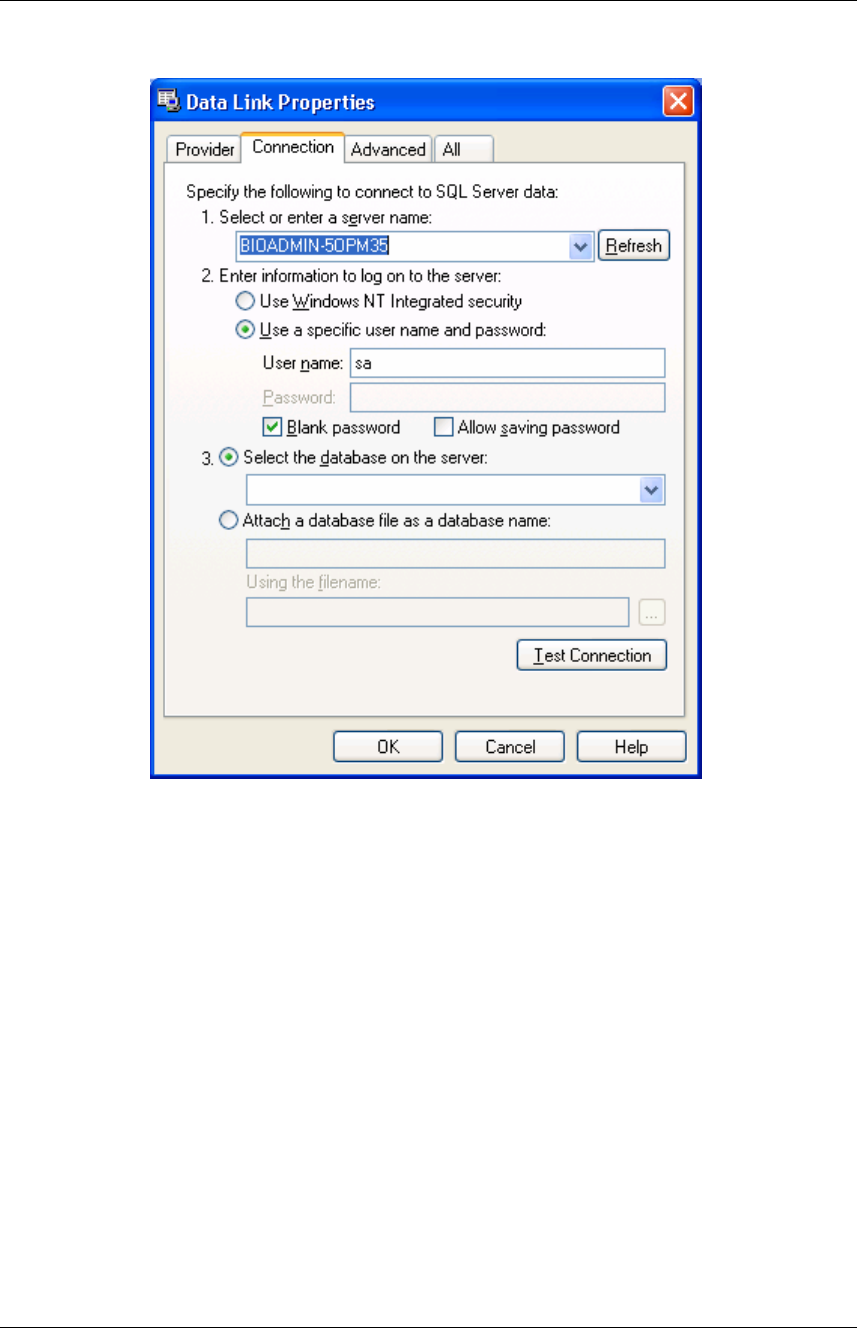
BioAdmin User Manual 40
Copyright © 2006, 2007 by Suprema Inc. http://www.supremainc.com
Enter the User name and Password for the database server. If there is no
password, check on the Blank password. If there is any password, check
on the Allow saving password.
Choose the Select the database on the server. To select this option, you
should create the database in advance on the SQL Server.
Press Test Connection button to check the connection status.
Press OK button.
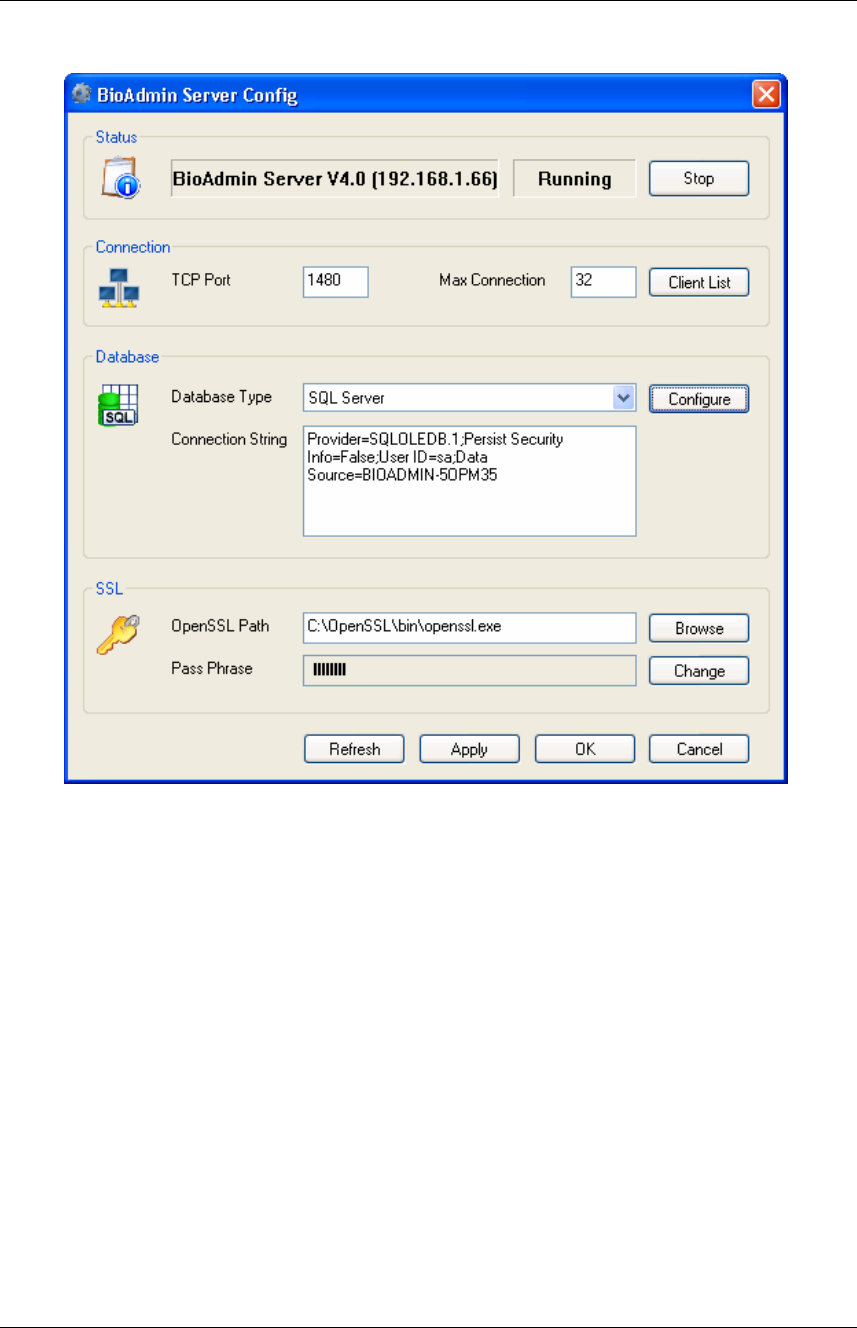
BioAdmin User Manual 41
Copyright © 2006, 2007 by Suprema Inc. http://www.supremainc.com
Select the database type as SQL Server.
Press Apply button.
Stop and restart the BioAdmin Server.
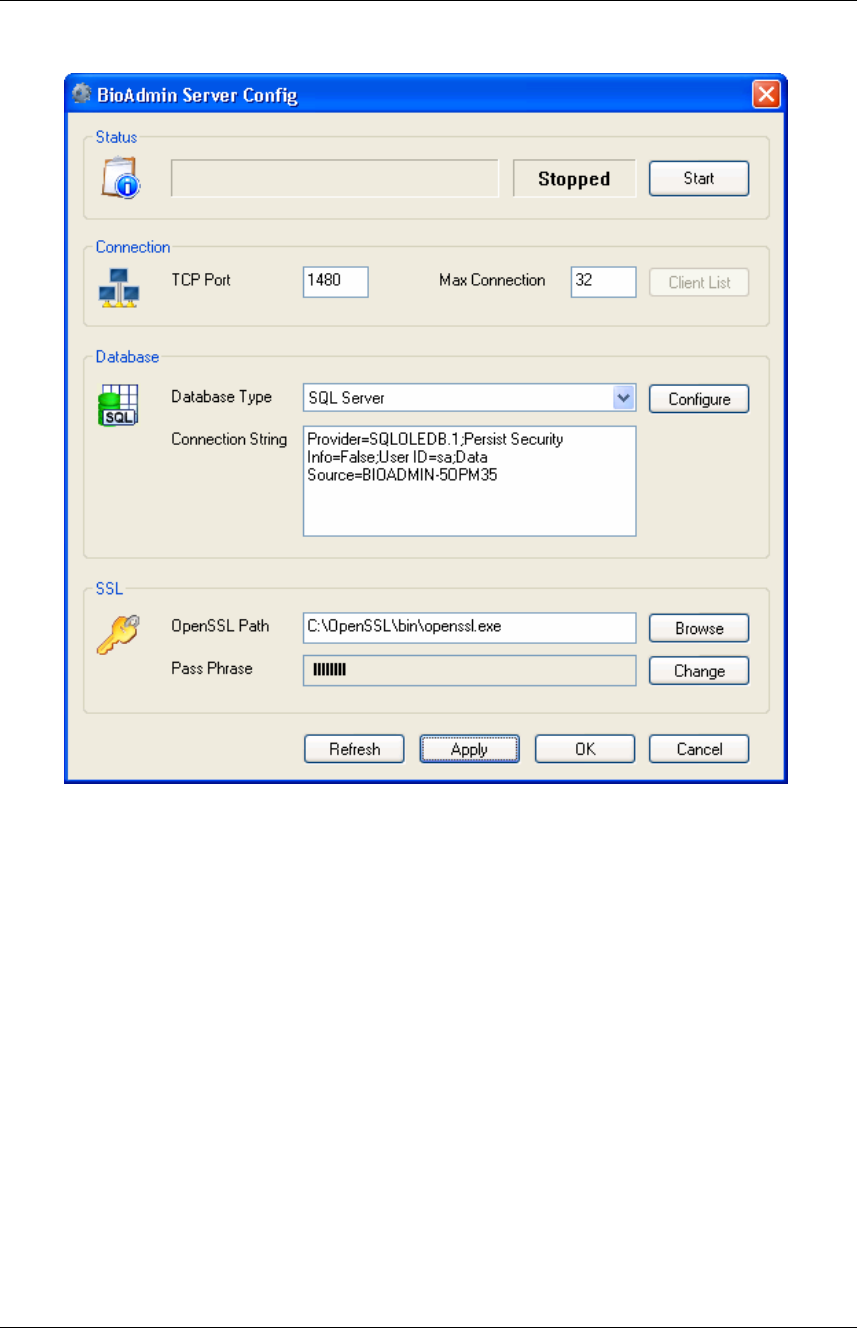
BioAdmin User Manual 42
Copyright © 2006, 2007 by Suprema Inc. http://www.supremainc.com
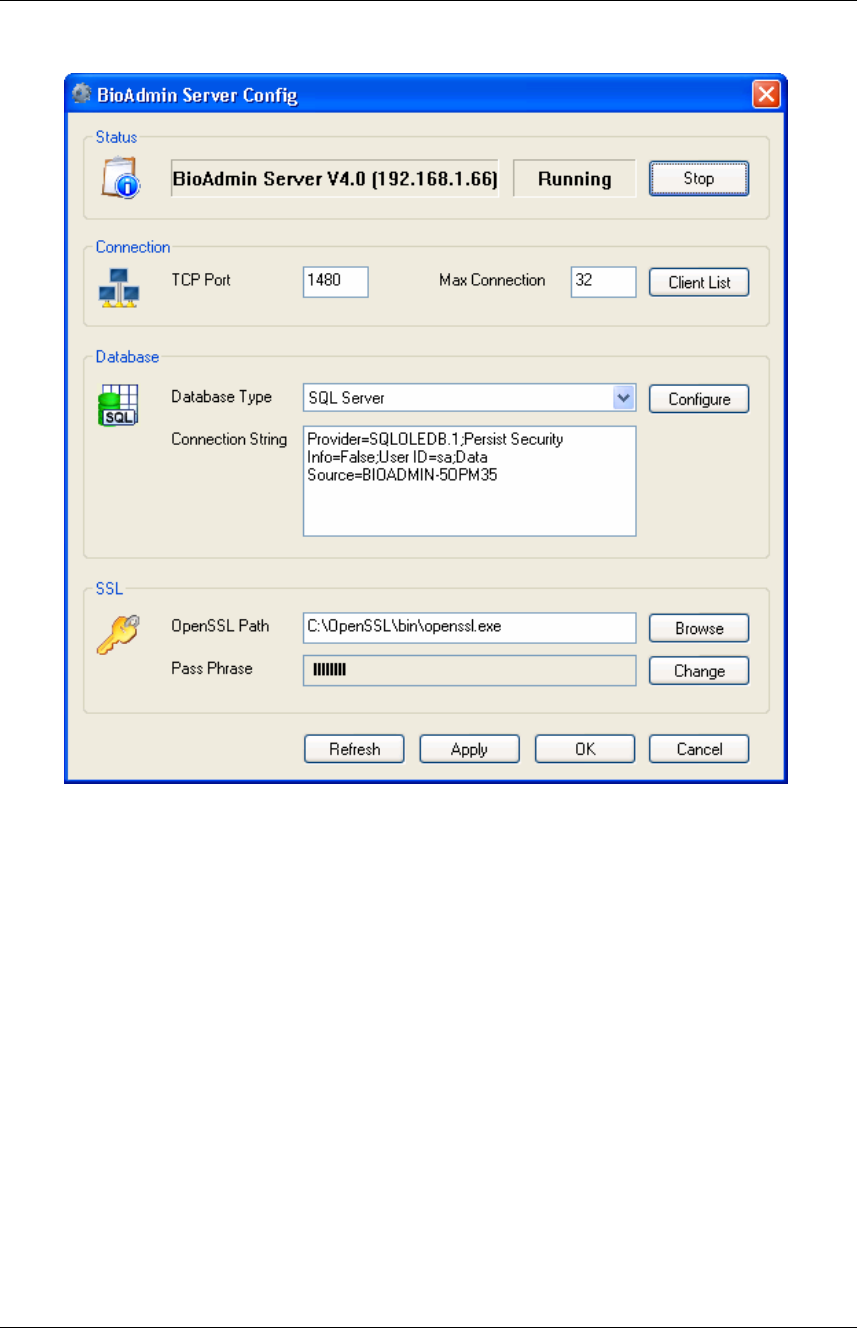
BioAdmin User Manual 43
Copyright © 2006, 2007 by Suprema Inc. http://www.supremainc.com
If the status is changed as Start, press OK button.
1.4.4. Check the BioAdmin software installation
z Network Configuration
Configure the Network menu of the BioStation as to use the server. Ask the IP
address of the server PC to your network manager. You can also check this IP
address on Network connection page of your operation system. For more details
on BioStation setting, refer to the BioStation Installation Guide.
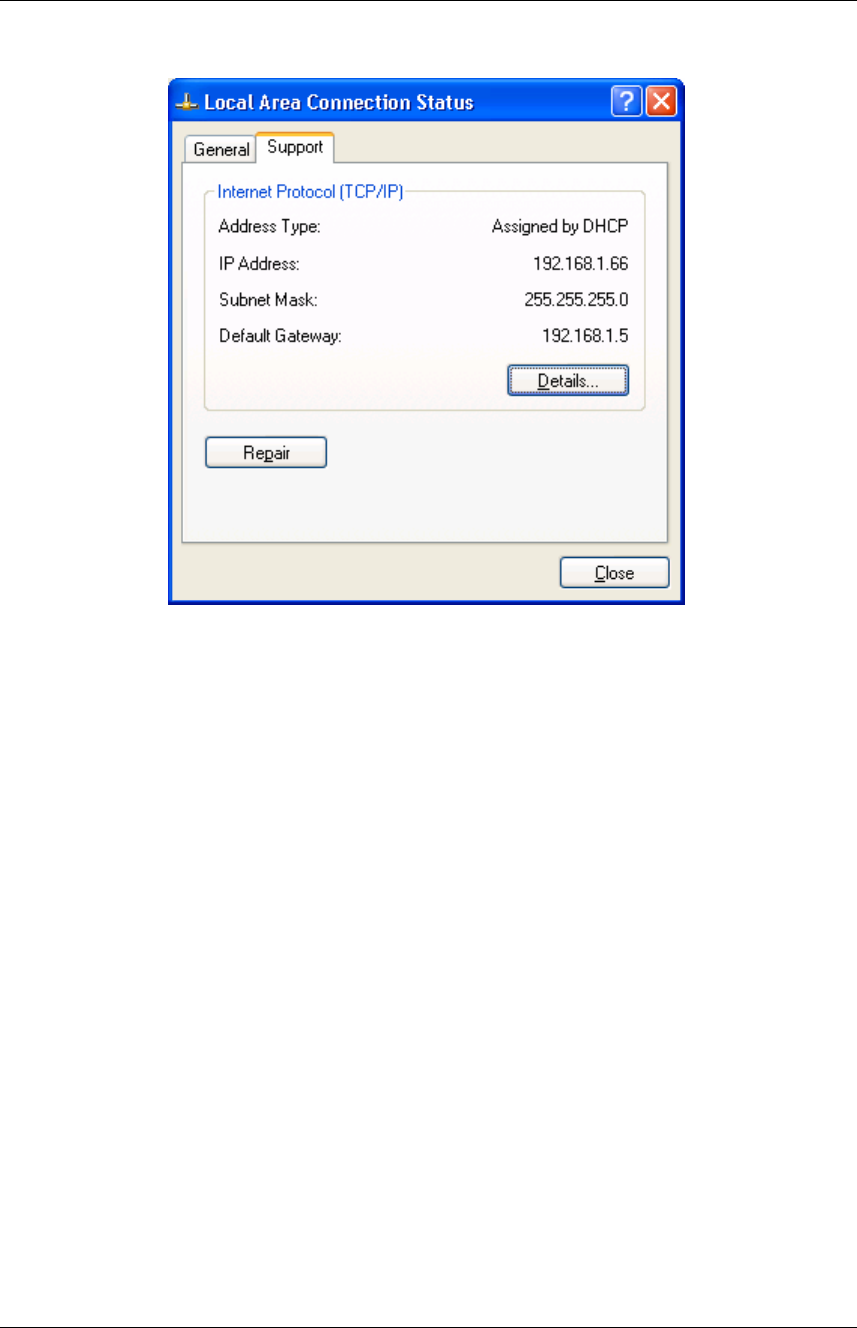
BioAdmin User Manual 44
Copyright © 2006, 2007 by Suprema Inc. http://www.supremainc.com
If you change the BioStation setting to use the server, BioStation will try the
connection with BioAdmin Server soon.
You can check the connected BioStation on BioAdmin Server Config
window.
At this stage, BioStation was just connected to BioAdmin Server, but not
managed by the BioAdmin Server. If you issue the certificate, BioStation will
get managed by the BioAdmin Server.
If the BioStation is connected to the BioAdmin Server, BioAdmin Server will
get the necessary information from BioStation. This may take a few
minutes depending on the data size on BioStation. While receiving data
from BioStation, you may not control the BioStation from BioAdmin Client.
z Check Server Status
If you finished the installation of BioAdmin Server and BioAdmin Client, you can
check the server status on BioAdmin Server Config window.
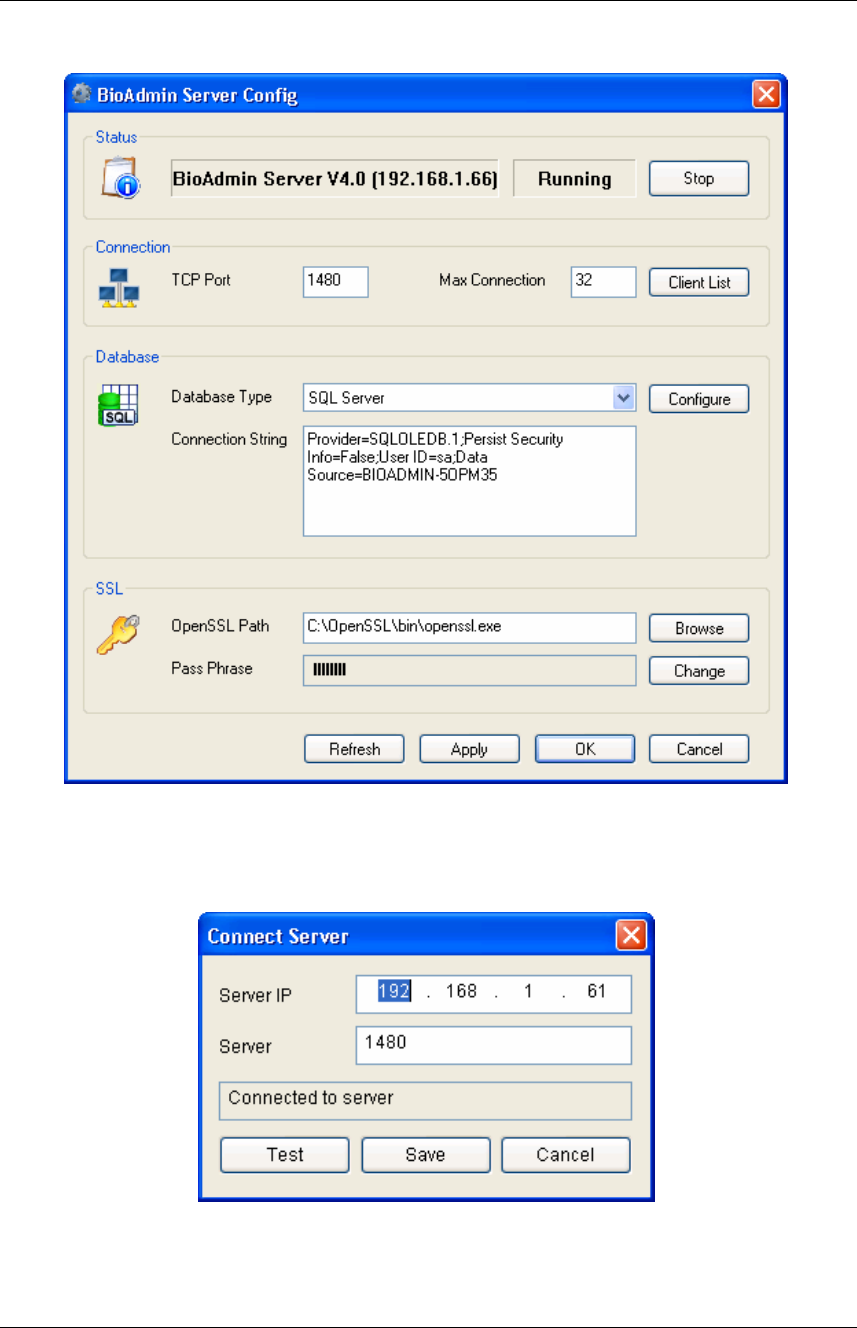
BioAdmin User Manual 45
Copyright © 2006, 2007 by Suprema Inc. http://www.supremainc.com
Check the version and status of the BioAdmin Server.
Enter the server IP and server port on BioAdmin Client.
You can check the connection status by pressing Test button.
If you can access to the BioAdmin Server, now you are ready to use the
BioAdmin Server and BioAdmin Client.
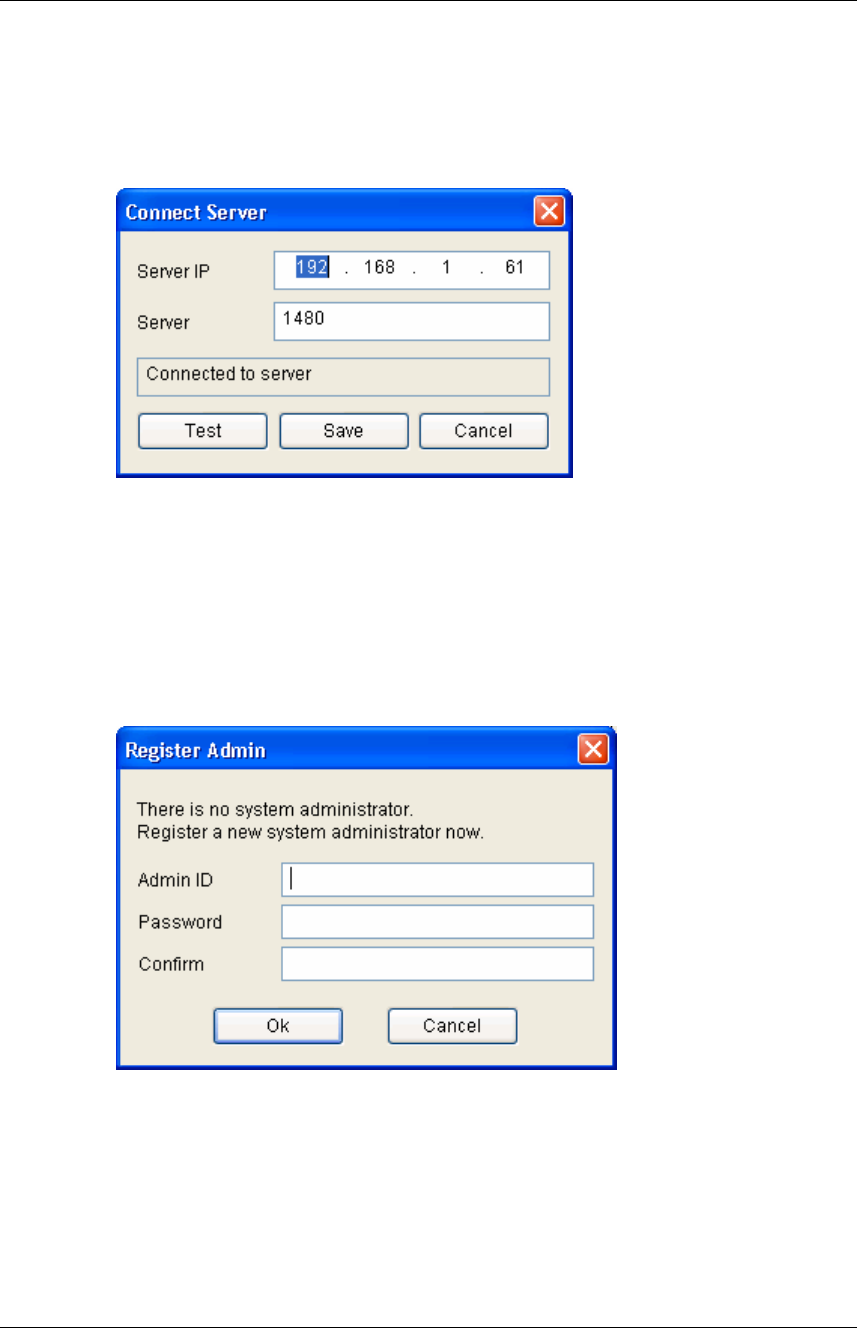
BioAdmin User Manual 46
Copyright © 2006, 2007 by Suprema Inc. http://www.supremainc.com
1.5. Log in to BioAdmin
1.5.1. Connect Server
z Enter the server IP and server port.
z Press Test button and check whether the BioAdmin Client can access to the
BioAdmin Server.
z Press Save button to store the server setting and access to that server.
1.5.2. Registering the initial system administrator account
z After entering Admin ID and password, press OK button. At this initial registering,
you can put any Admin ID and password.
z This initial registration is required to open the BioAdmin Client program after
installing the BioAdmin Server. Therefore, once you register this initial Admin ID
and password, you can log in to the BioAdmin Client without registering
additional admin account from the next time.
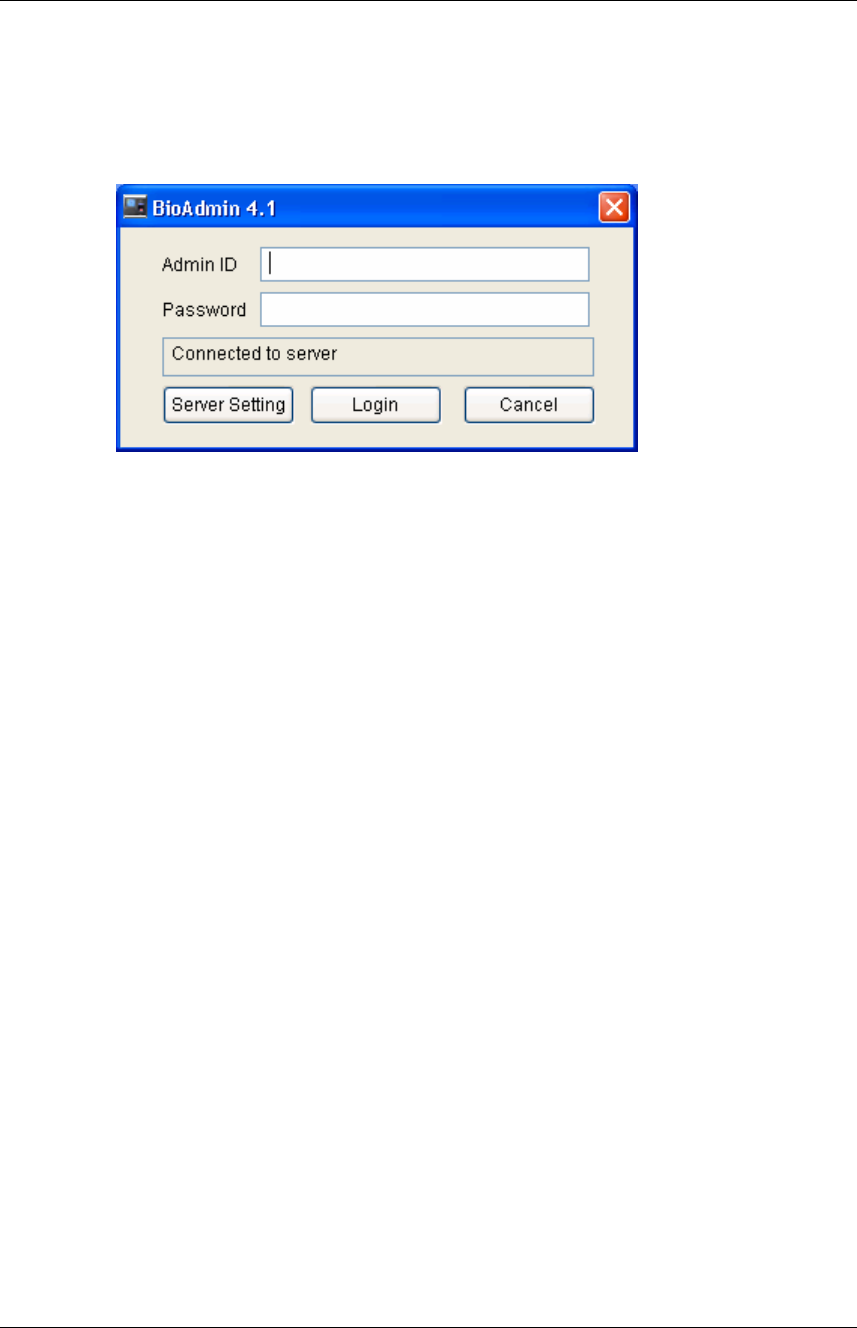
BioAdmin User Manual 47
Copyright © 2006, 2007 by Suprema Inc. http://www.supremainc.com
1.5.3. Log in to the BioAdmin 4.1
z After entering the Admin ID and password, press log in button.
z Enter the Admin ID and password you used upon registering the initial
administrator account.
z You can see the server information by pressing the Server Setting button.
1.6. User Level on BioAdmin 4.1
On BioAdmin 4.1, you can differentiate the user level into three groups as below.
z Administrator : Administrator can change and see all the settings on BioAdmin
software.
z Viewer : Viewer can see the settings, but can not change any settings on
BioAdmin software.
z User : User can see his log information.
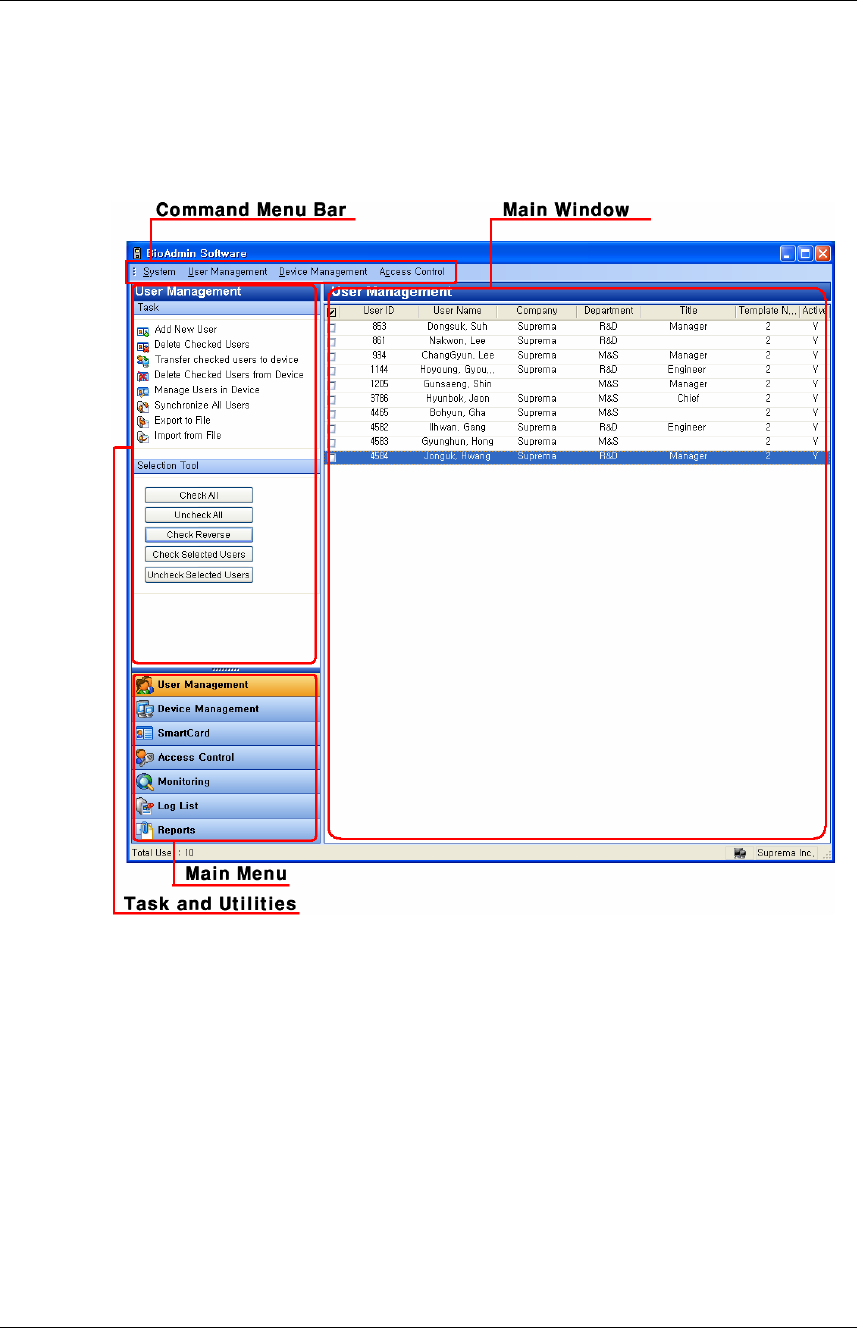
BioAdmin User Manual 48
Copyright © 2006, 2007 by Suprema Inc. http://www.supremainc.com
1.7. BioAdmin configuration
BioAdmin Software is composed of 4 elements, command menu bar, main menu,
task and utilities, and main window.
1.7.1. Command Menu bar
Command menu bar contains command items supported by BioAdmin software,
which are grouped into 4 categories:
z System : admin. Account, back up database, restore backup, lock all devices,
unlock all devices, upload 1.ⅹversion data, preference, BioAdmin information,
and close
z User management : add new user, company management, department
management, title management, and setup custom fields.
z Device management:: add new device, add new BEACon, set time, upgrade

BioAdmin User Manual 49
Copyright © 2006, 2007 by Suprema Inc. http://www.supremainc.com
firmware, upload password initialization code/ password initialization, site key
setting
z Access control : time code definition, holiday definition, time zone definition,
door zone definition, and access group definition.
1.7.2. Main menu
Major command menus can be accessed by buttons on the left pane, such as user
management, device management, smart card, access control, monitoring, log list,
or report.
1.7.3. Task list and tool list
Task window shows sub-menus for the selected main menu
Utility window shows the User selection tool, Device tree, and Log filtering tool.
1.7.4. Main window
On each command menu, relevant information is updated on the main window.
Main window contains the following information and controls:
z Retrieved information from currently selected device
z Information stored on host PC, such as user database or log data
z Controls to manage or to configure the information
1.8. User Database
User database refers to the entire user information including user ID, user name
and fingerprint information. BioAdmin software is based on user database
management in priority.
That is, user database is created, updated and saved to host PC. Then, it is
selectively distributed to BioEntry and BIoStation devices connected to network via
transfer.
Note : Difference between select and check – select is used when choosing each
user ID in select tool box (press Shift button and choose a user with an arrow key ↓
or click the last user ID with a mouse, to select multiple users. ), whereas, check is
to check each selected user ID. Using check tool, you can check all, uncheck all,
reverse check, check user and uncheck a selected user with ease.

BioAdmin User Manual 50
Copyright © 2006, 2007 by Suprema Inc. http://www.supremainc.com
2. Quick start
This chapter explains basic procedures of operating BioEntry and BioStation
device integrated with external system.
2.1. Quick start with BioStation
This paragraph describes basic procedures of operating BioStation.
2.1.1. Step 1 : HW installation
BioStation can be networked by cable/wireless LAN as well as by RS232,422,485.
Also, BioStation can be use with host PC via USB interface. For details on
installation, refer to BioStation installation manual.
2.1.2. Step 2 : Search new device
z Run BioAdmin software.
z Enter login ID and password.
z Select device management on main menu to display device management page
on main window.
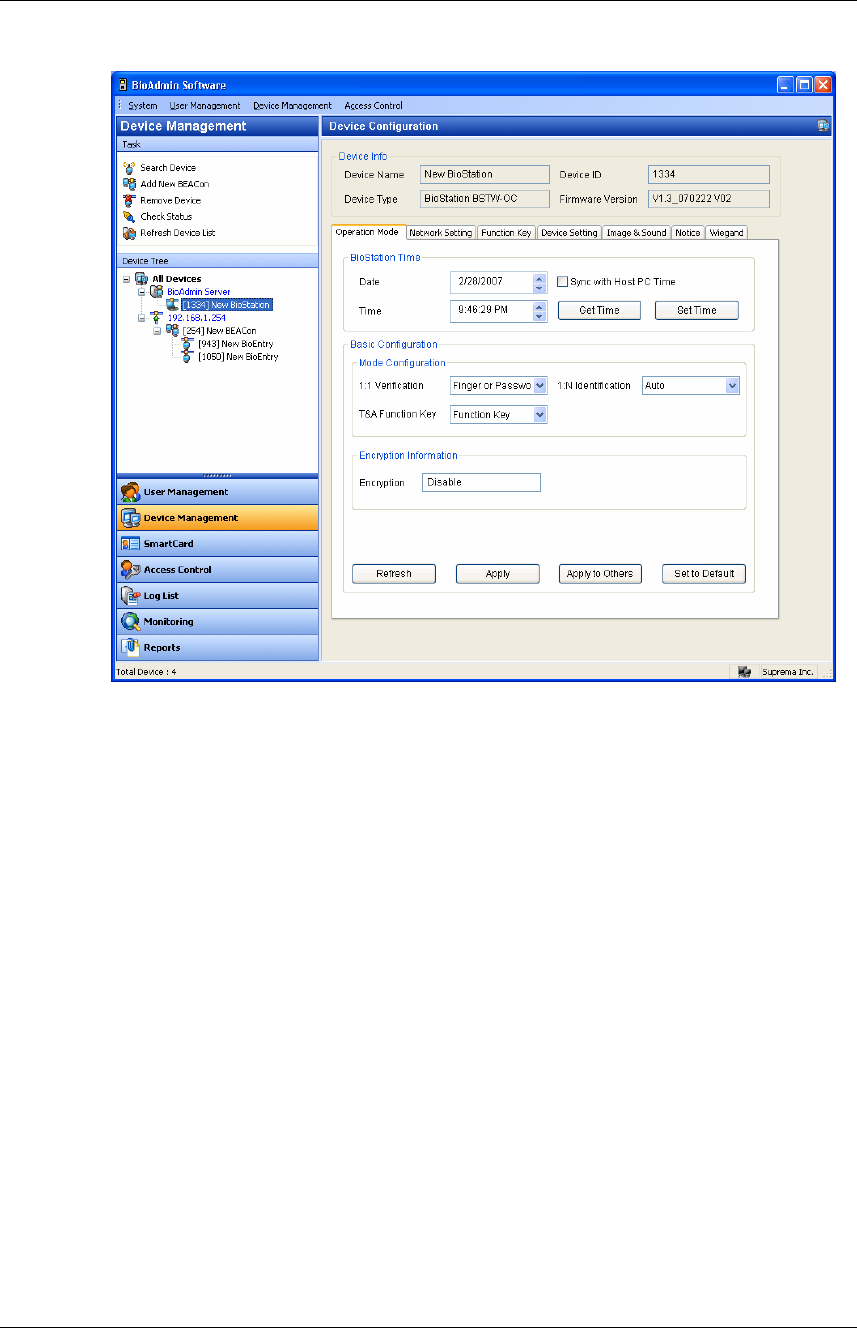
BioAdmin User Manual 51
Copyright © 2006, 2007 by Suprema Inc. http://www.supremainc.com
z Once the BioStation is connected to the BioAdmin Server, connected BioStation
will be added to the device tree whenever you start the BioAdmin software. Also,
you can see the connected BioStation by pressing the Refresh Device List.
Even though a BioStation is properly connected to the BioAdmin Server, it may
take several minutes to show up on the device tree.
z If a BioStation is unauthorized one, an orange color is indicated on the
BioStation icon. In this case, you can not communicate with that unauthorized
BioStation.
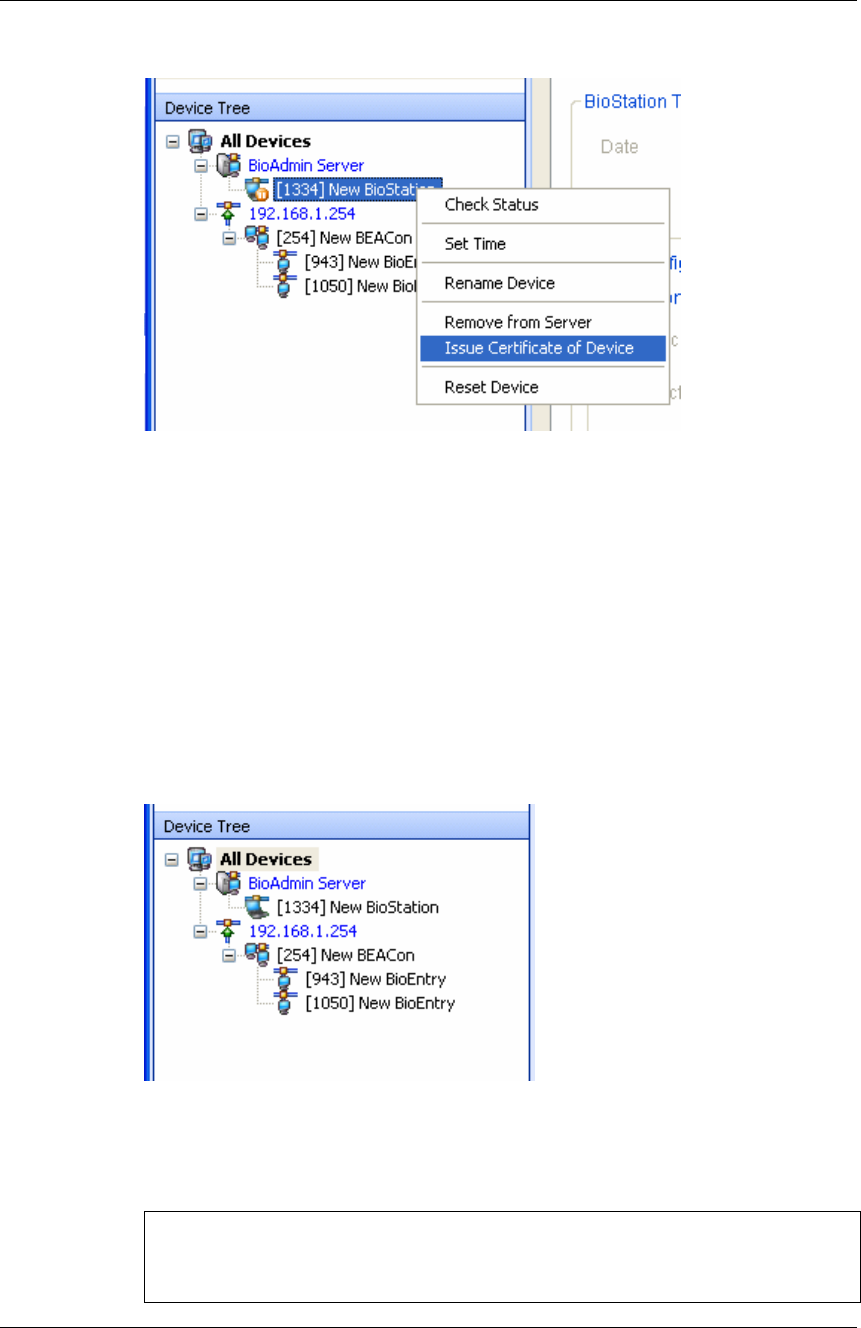
BioAdmin User Manual 52
Copyright © 2006, 2007 by Suprema Inc. http://www.supremainc.com
To communicate with the BioStation, select the unauthorized BioStation and
press the right button of the mouse. Press Issue Certificate of Device menu.
After issuing the certificate, you can use this BioStation.
Because the BioStation restart after issuing this certificate, it may take a few
minutes to show this BioStation again on the device tree.
z After the certificate is issued for the BioStation, orange mark will be removed
from the BioStation icon. This means that you can communicate with the
BioStation without any problem.
z Select Search device menu, click BioStation search, select a desired network
out of serial port TCP/IP and USB device (BioStation) and press search button.
Note : If you find a device from search results
Ex.) searching 192.168.1.101 (port : 1470),
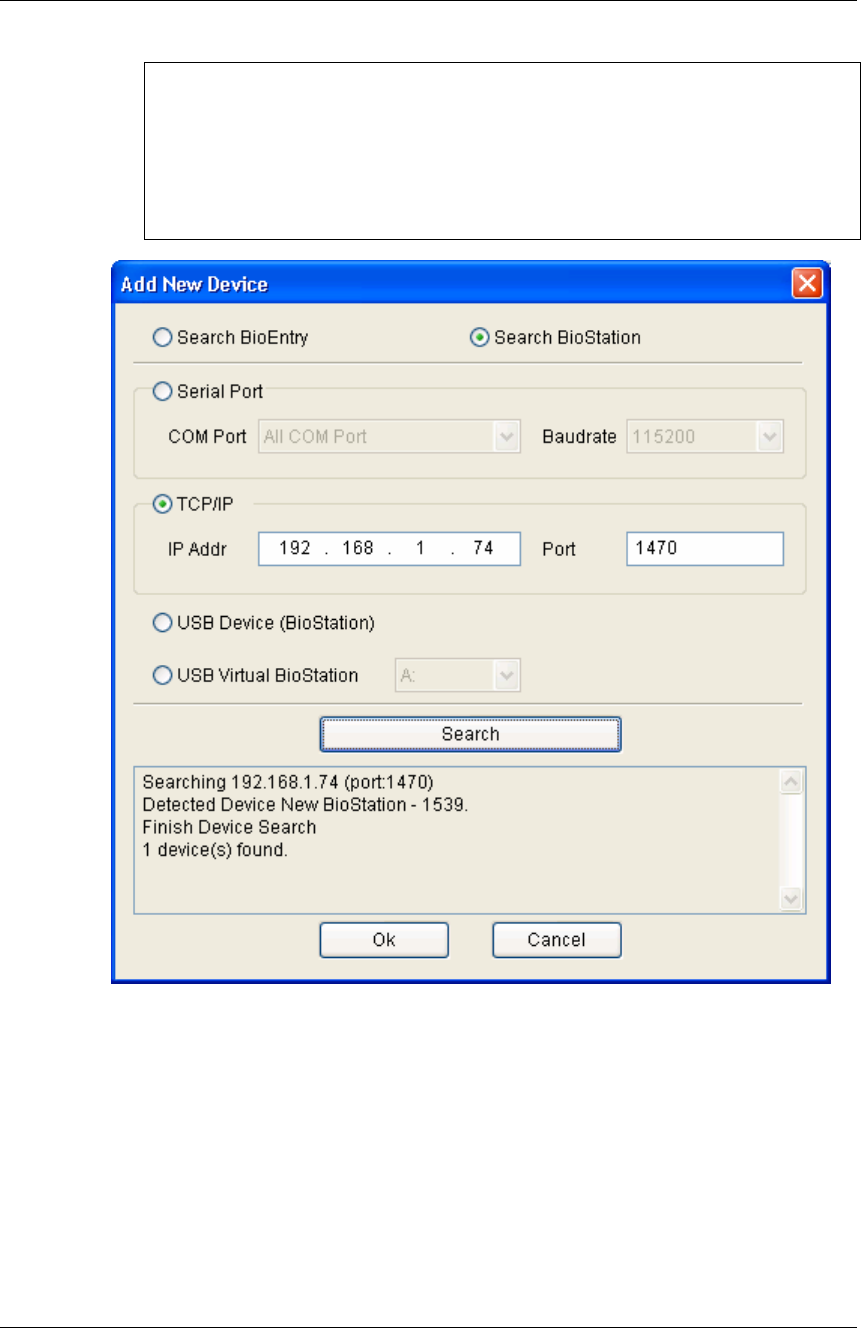
BioAdmin User Manual 53
Copyright © 2006, 2007 by Suprema Inc. http://www.supremainc.com
Detected device : new BioStation – device number
Finish device search.
Search result ‘---- device(s) found’ is displayed. Press OK button to select
a ,device.
z Once it’s connected to device successfully, new device ID and network
connected to device are also displayed in device tree window.
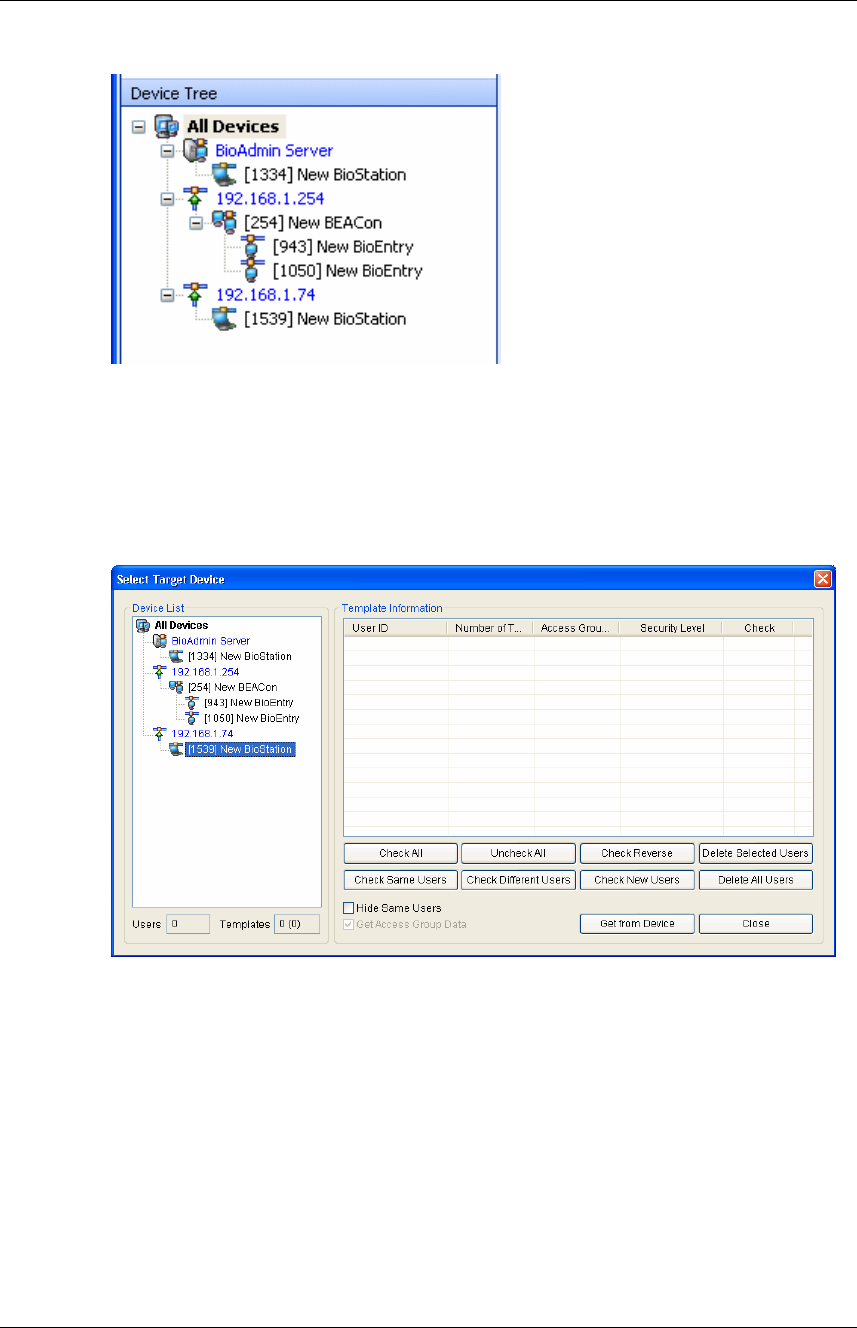
BioAdmin User Manual 54
Copyright © 2006, 2007 by Suprema Inc. http://www.supremainc.com
z Select user management button on main menu and select Manage users in
device on task window.
z Once device is selected, fingerprint information such as user ID, number of
fingerprint, access group, security level and select is displayed.
2.1.3. Step 3: Connect device
z Select Device Management menu to display device management page on
main window.
BioAdmin software network setup is divided into network, serial port and USB
connection. Change settings and apply them to device.
Network setup is to designate settings for local and wireless network connection.
You need to designate the port as “1470.”
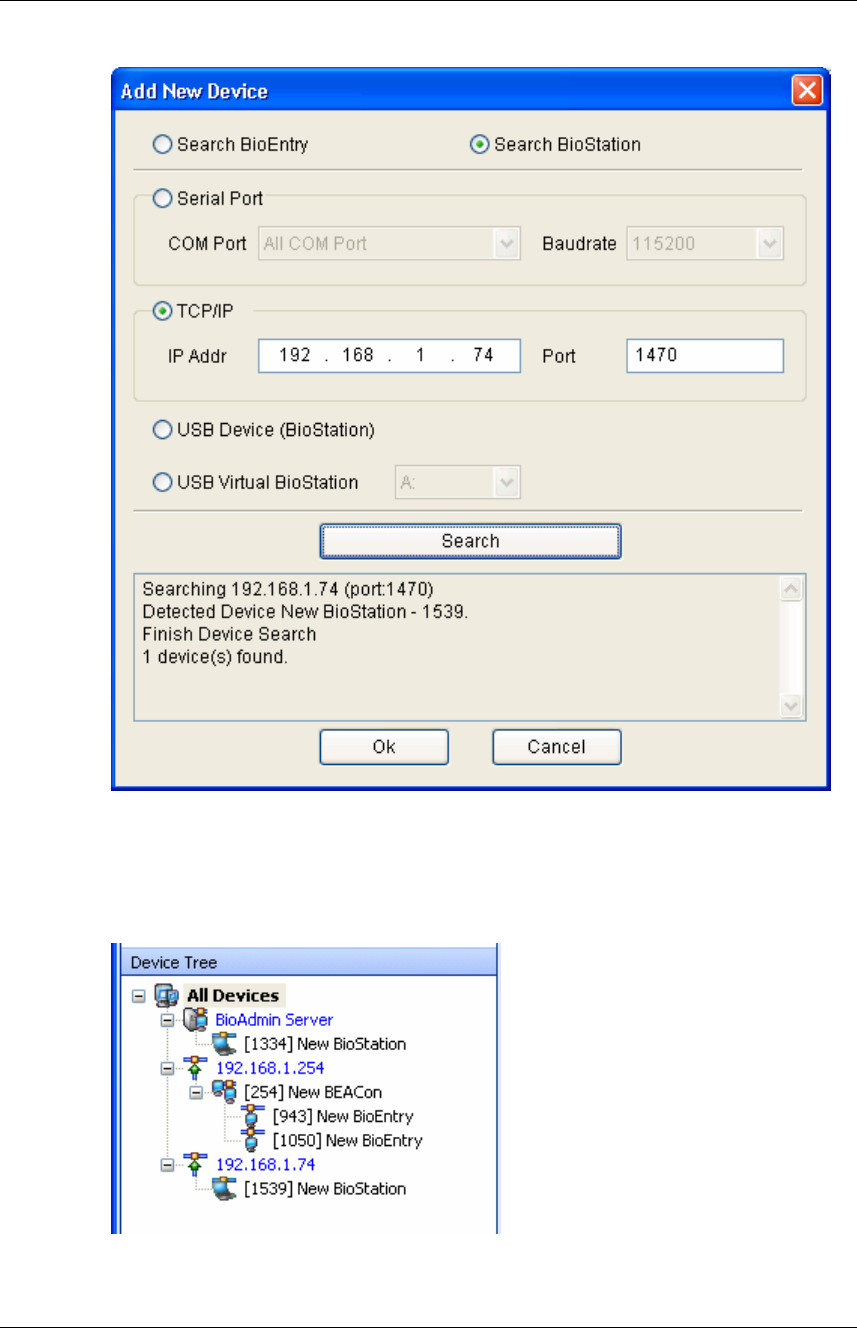
BioAdmin User Manual 55
Copyright © 2006, 2007 by Suprema Inc. http://www.supremainc.com
Administrator needs to know IP address and port # (1470). Once device is
connected properly, IP address is displayed as one group and device ID is
displayed with a bracket [****] on device tree window.
z Wireless network setup
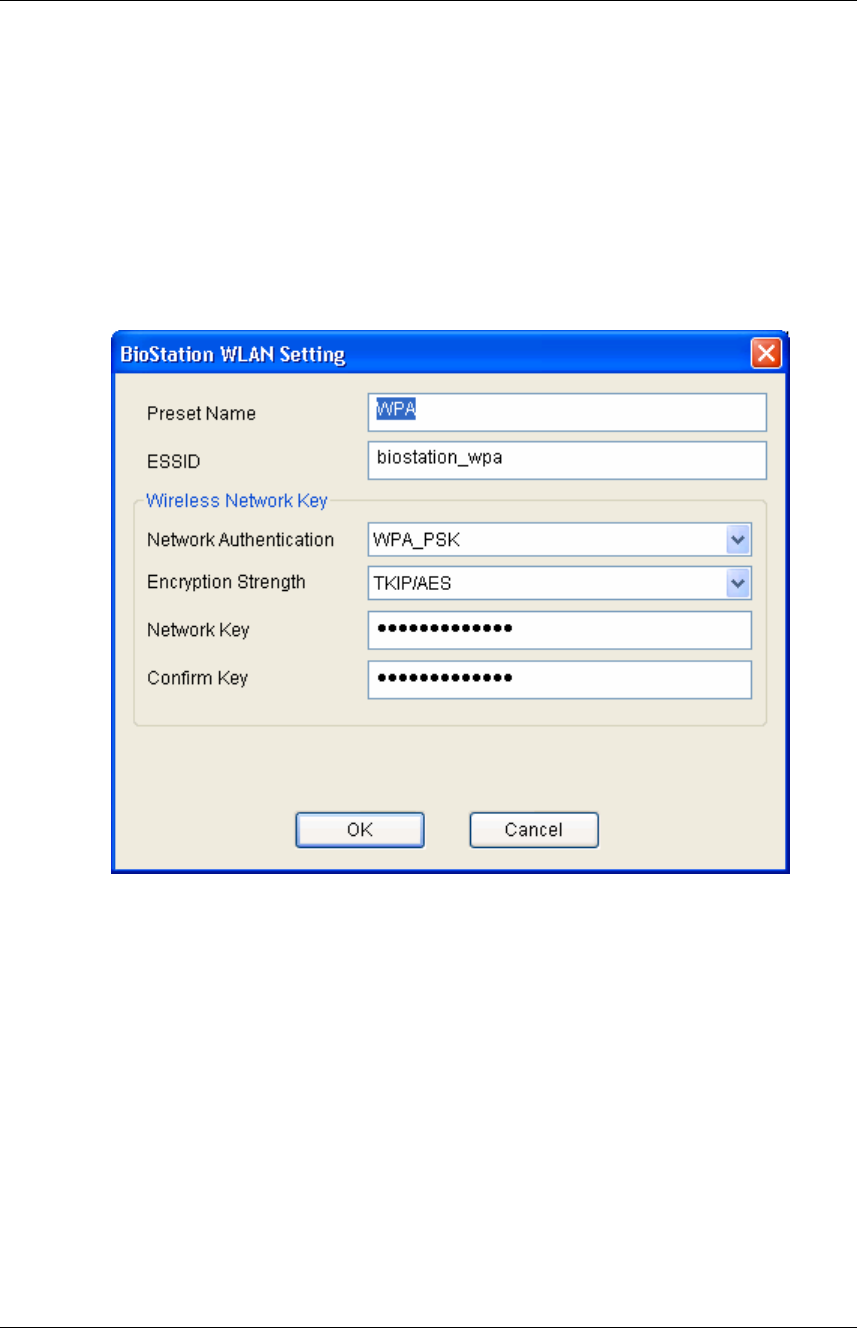
BioAdmin User Manual 56
Copyright © 2006, 2007 by Suprema Inc. http://www.supremainc.com
Set up free set name, network name (SSID), data encryption, key type, and
network key check on wireless network setup before operation.
Applying DHCP, you can set automatic upload of IP address on BioAdmin in
order to get IP address automatically, check such an IP address and search a
device in device management.
When setting IP address manually, you can search a device by specifying
assigned IP address, gateway and subnet mask.
z Serial
On RS422/485 network, a new device can be detected automatically or added
by new device search menu in device management. Once device is connected
to network properly, device ID will be displayed with a bracket [****] under port
on device tree window.
Baudrate in RS485 / RS232 interface represents the frequency of carrier wave
changing status per sec. In communicating with BioStation device, default is
115200 but if any trouble, lowering the baudrate can solve the problem.
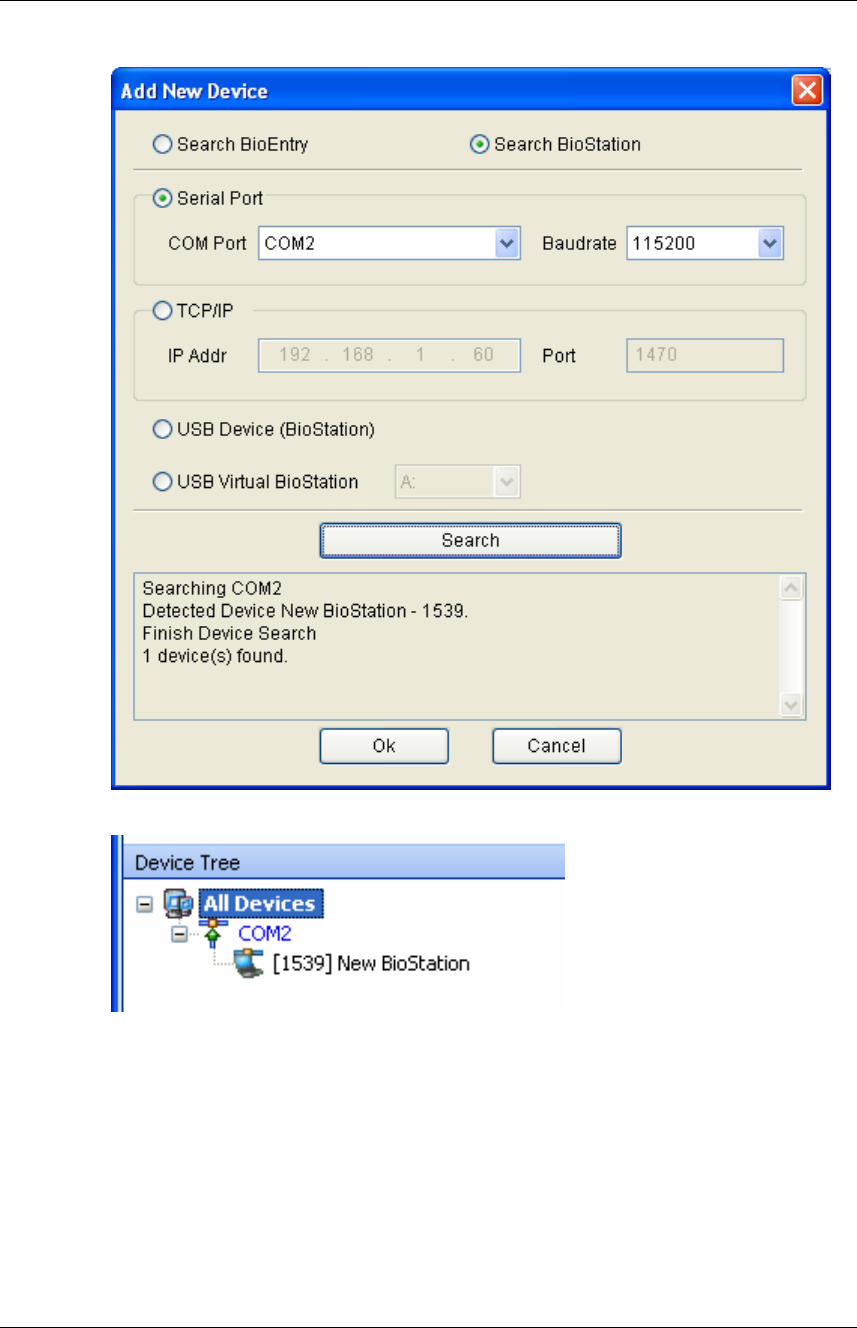
BioAdmin User Manual 57
Copyright © 2006, 2007 by Suprema Inc. http://www.supremainc.com
Although a device is disconnected from network, it still remains on device tree
window. Remove device menu is used when removing a device from device
tree window.
Device name can be changed using change device name menu but device ID
can’t be changed as it is fixed as one.
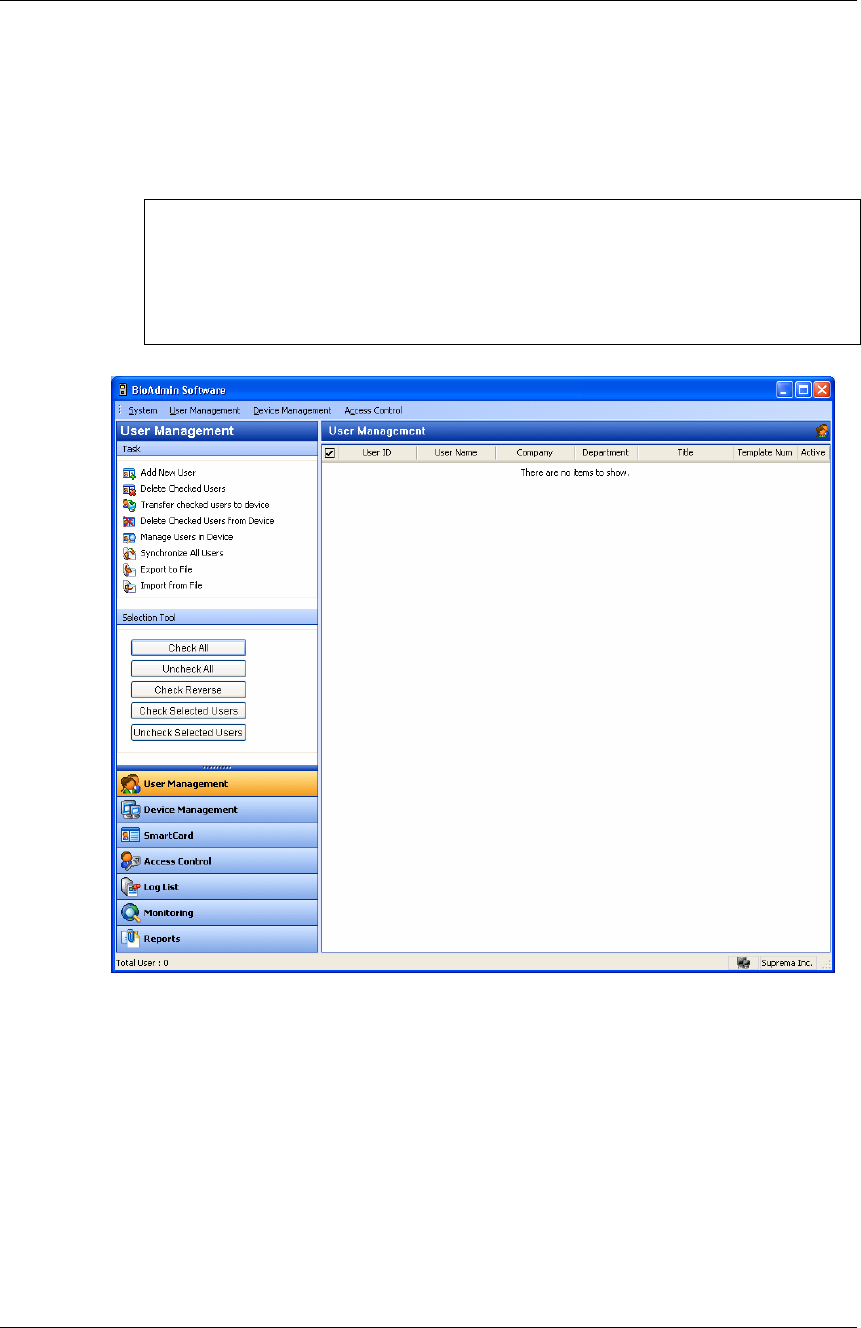
BioAdmin User Manual 58
Copyright © 2006, 2007 by Suprema Inc. http://www.supremainc.com
2.1.4. Step 4: User management
z Select user management menu to display user management page on main
window.
Note : In user management, user related information can be divided into basic
information and fingerprint information. Basic information includes user ID,
name, company, dept., position and telephone number. Fingerprint information
is about user’s fingerprint.
z Select add new user menu on task window to pop up a window.
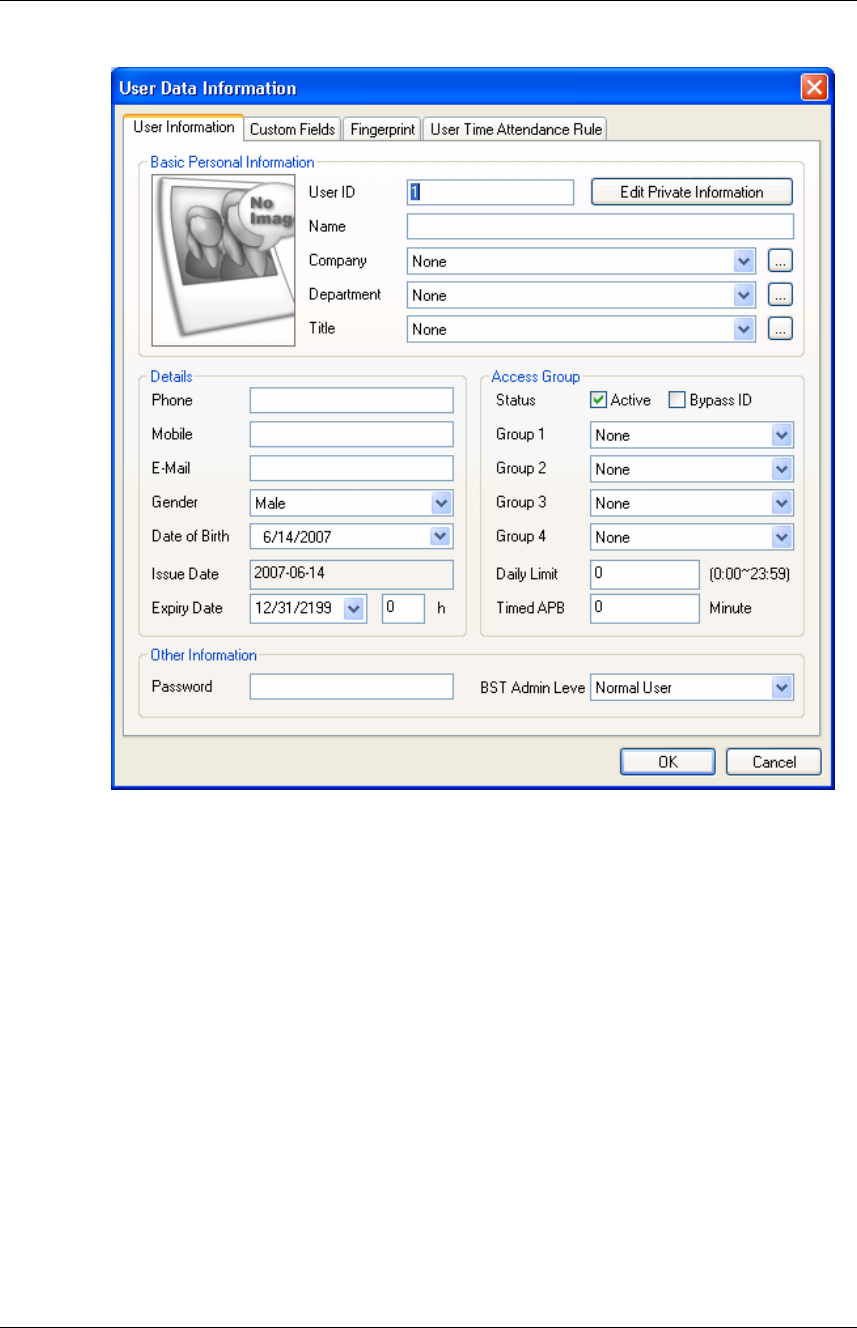
BioAdmin User Manual 59
Copyright © 2006, 2007 by Suprema Inc. http://www.supremainc.com
z Click user information tab and enter user information.
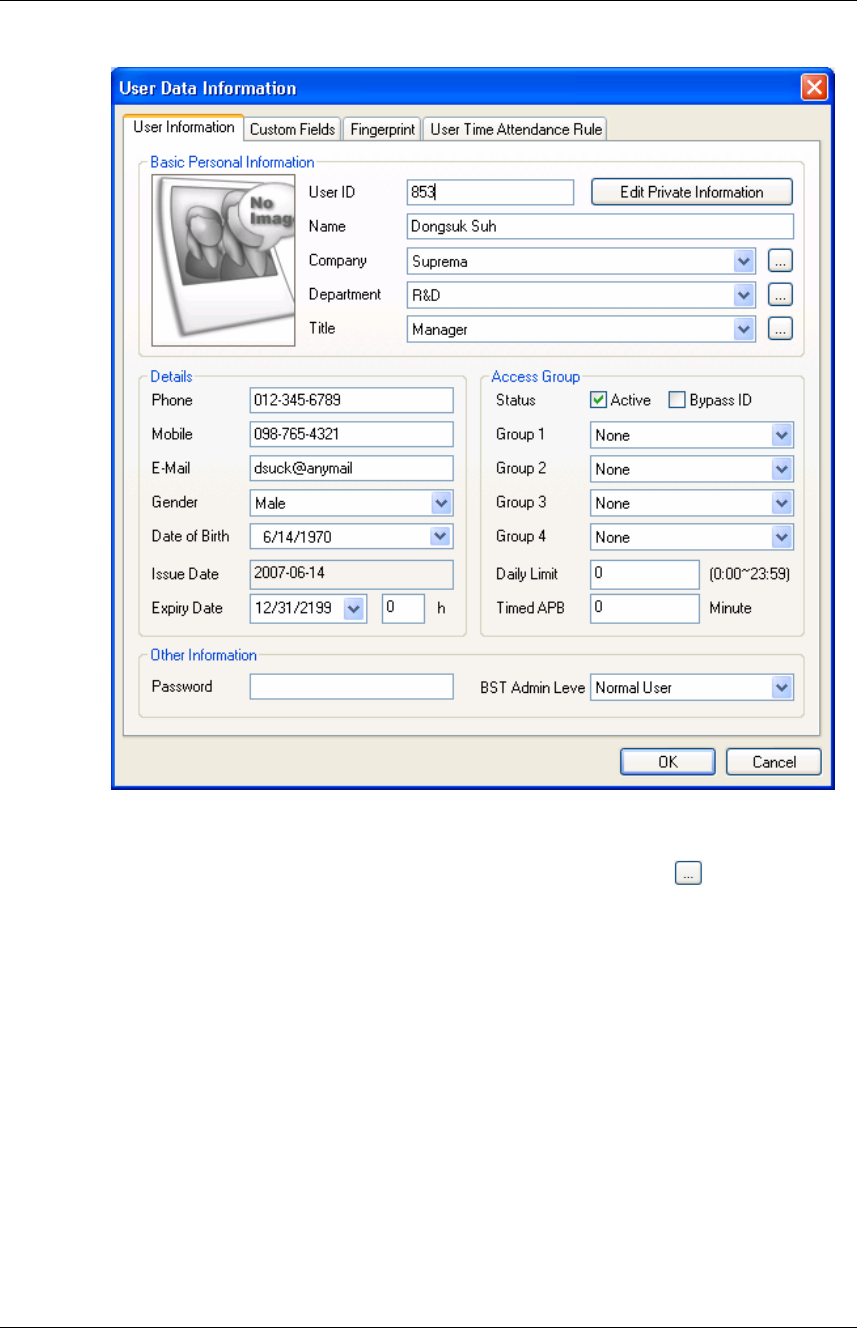
BioAdmin User Manual 60
Copyright © 2006, 2007 by Suprema Inc. http://www.supremainc.com
z Choose company, dept. and title using a combo box.
z To add a new company, dept., or title information, press button or enter
company, dept. or title in information input window and then press add button.
z To save added information, press save button.
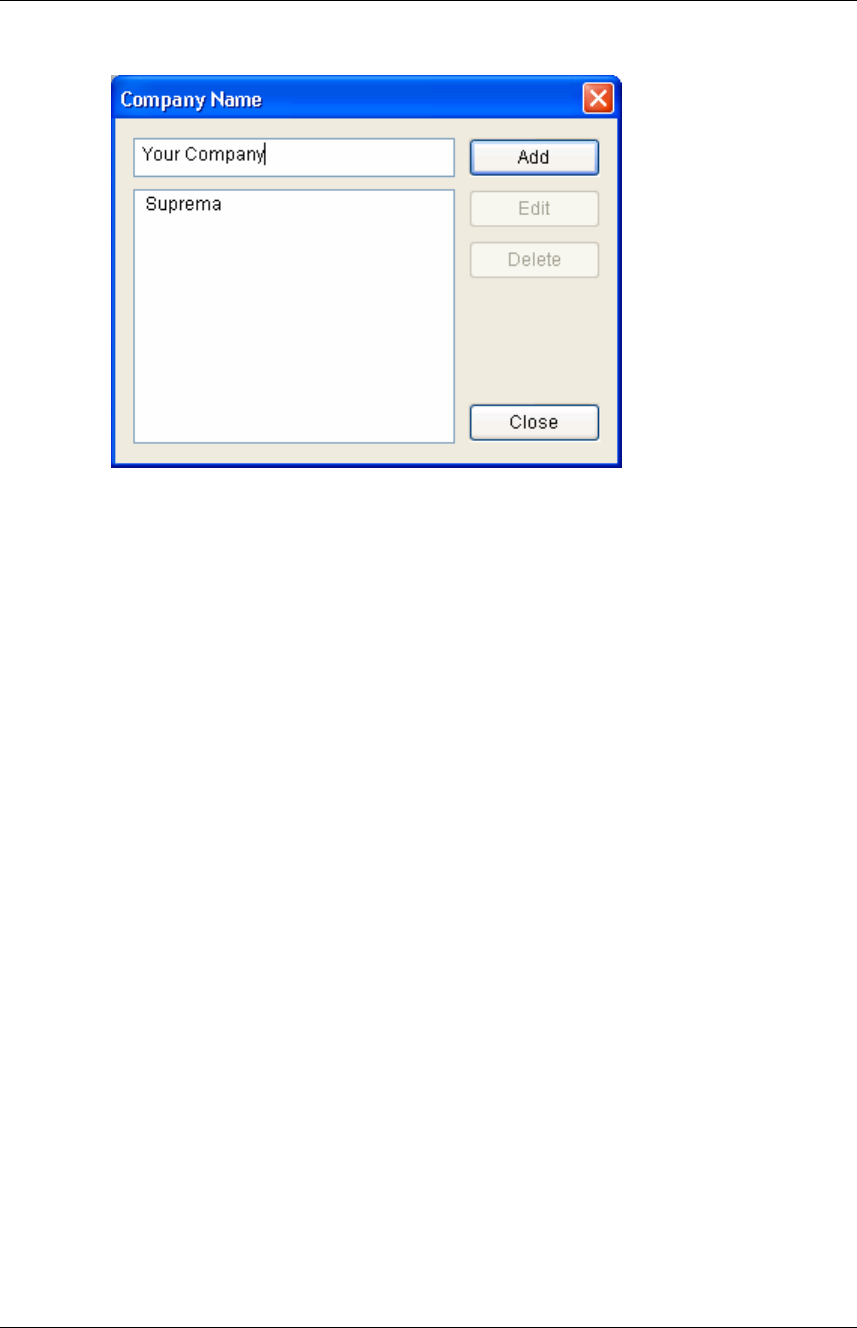
BioAdmin User Manual 61
Copyright © 2006, 2007 by Suprema Inc. http://www.supremainc.com
z To enroll user’s fingerprint information, click fingerprint tab.
z Fingerprint input process is divided into one by USB fingerprint scanner and the
other by BioStation device.
z How to input fingerprint information using USB fingerprint scanner is as follows.
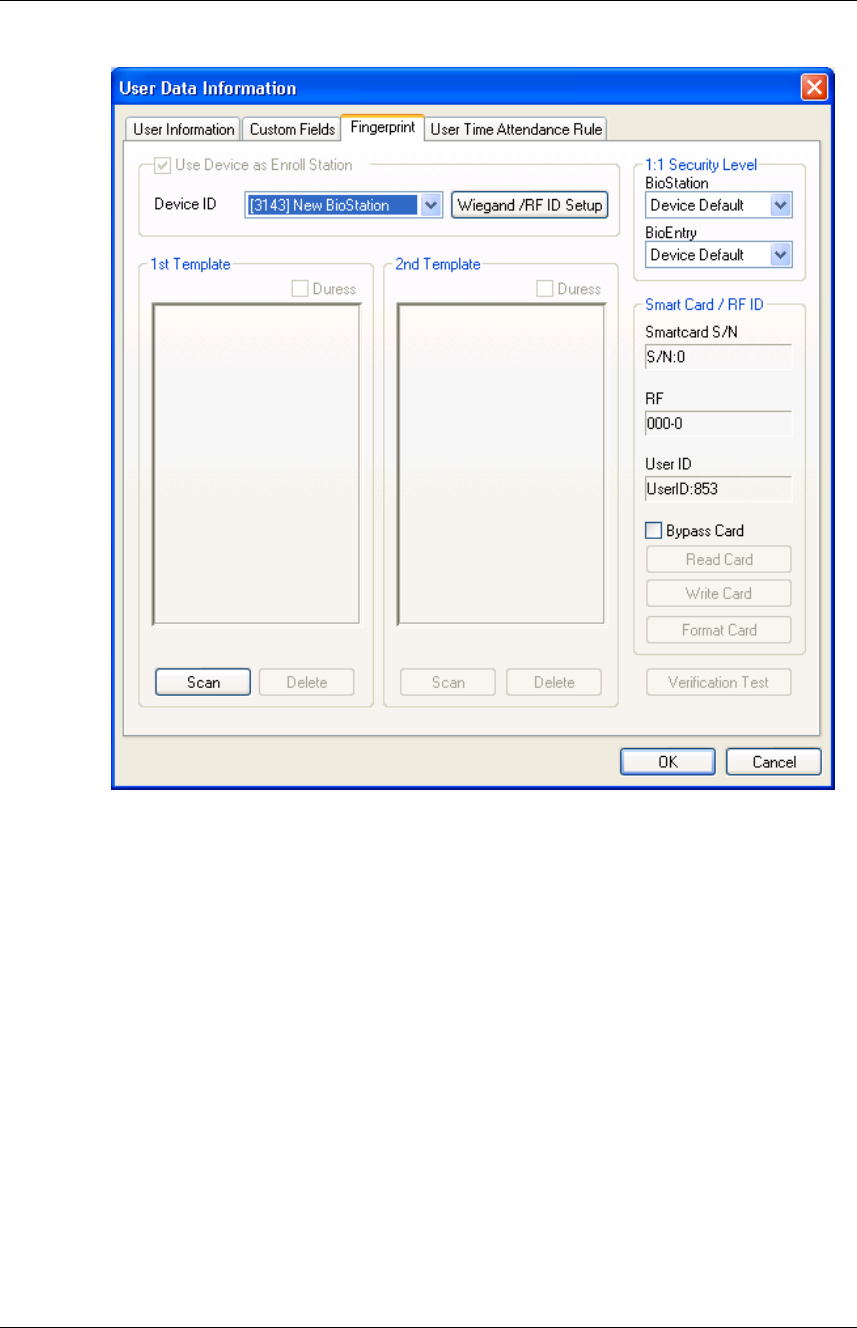
BioAdmin User Manual 62
Copyright © 2006, 2007 by Suprema Inc. http://www.supremainc.com
Press scan button, place a finger on USB fingerprint scanner twice and
input the first fingerprint information.
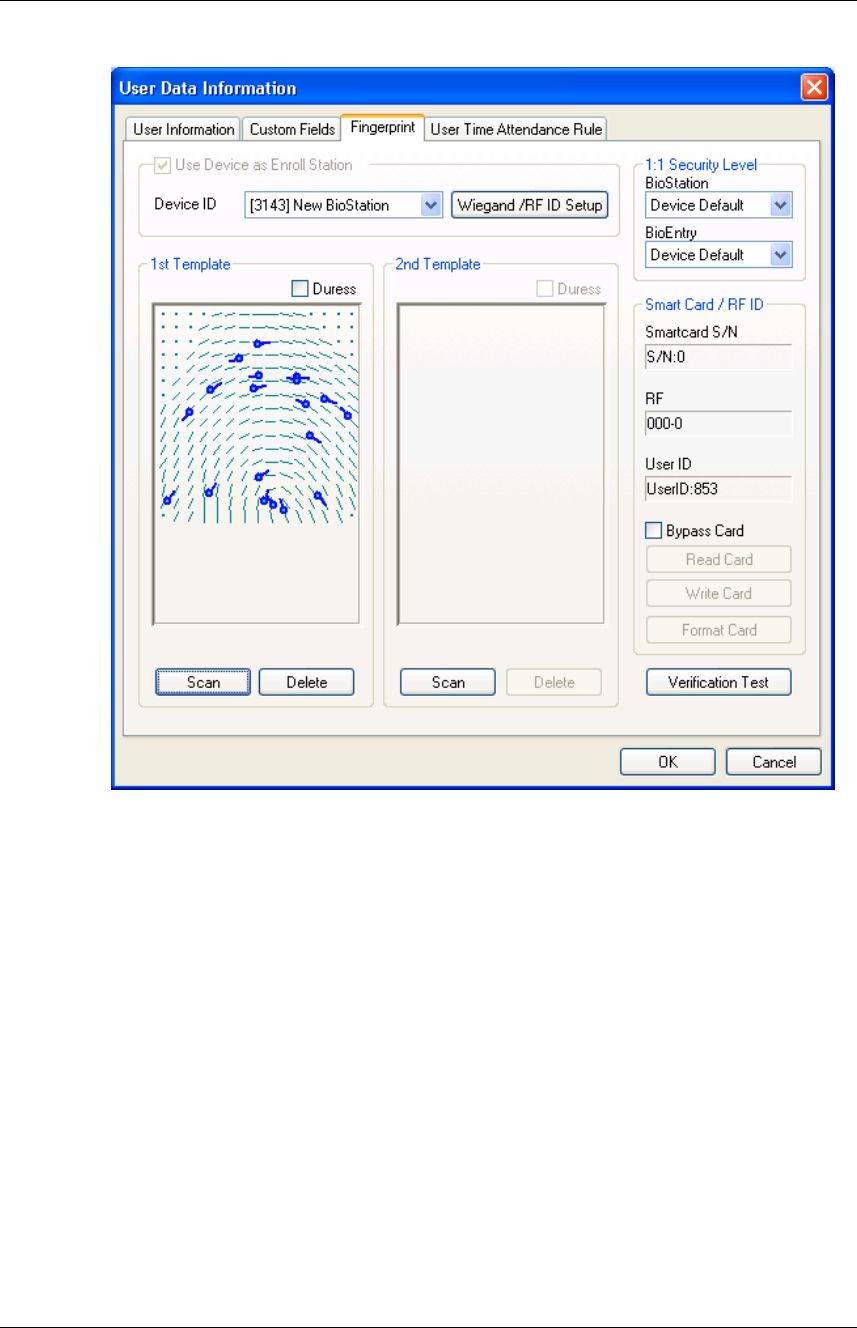
BioAdmin User Manual 63
Copyright © 2006, 2007 by Suprema Inc. http://www.supremainc.com
Input the second fingerprint information in the same way as the first
fingerprint information input process.

BioAdmin User Manual 64
Copyright © 2006, 2007 by Suprema Inc. http://www.supremainc.com
How to enter fingerprint information by BioStation device is as follows.
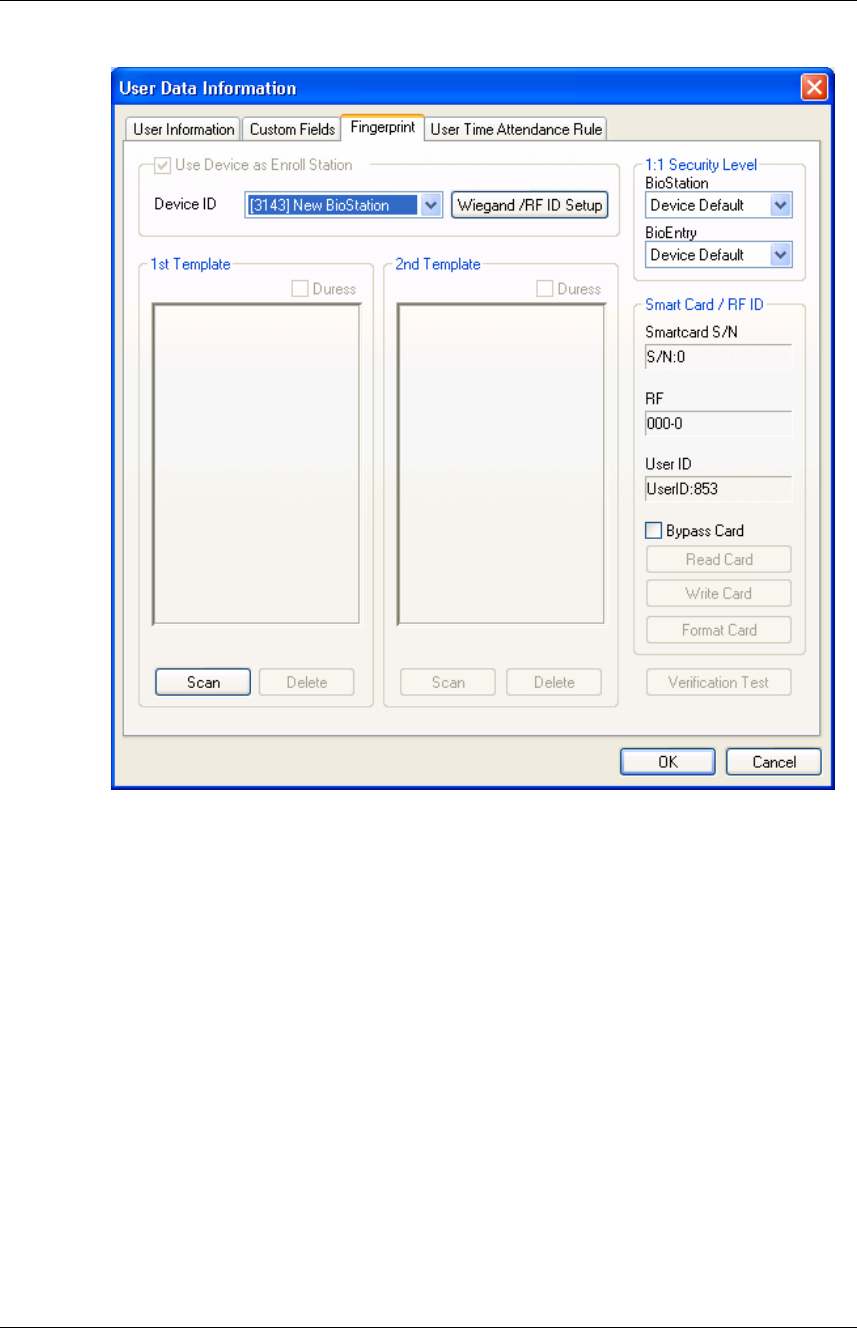
BioAdmin User Manual 65
Copyright © 2006, 2007 by Suprema Inc. http://www.supremainc.com
In case of stand alone mode without USB scanner, check Use BioStation
as Enroll Station, press scan button, place a finger twice on device and
then input the first fingerprint information. In case that device is configured
by 2 or more networks, specify BioStation ID, press scan button, place a
finger on device twice and then input the first fingerprint information.
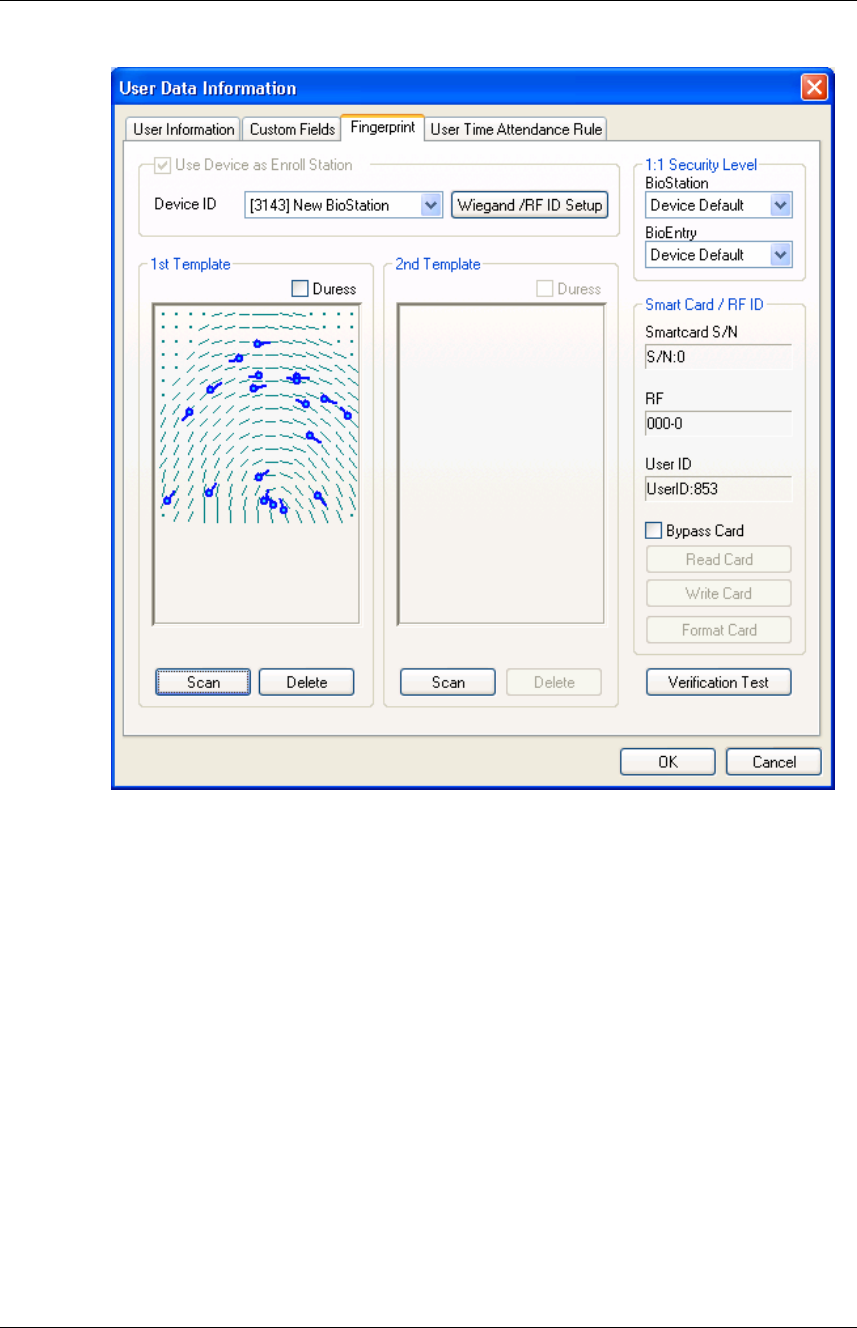
BioAdmin User Manual 66
Copyright © 2006, 2007 by Suprema Inc. http://www.supremainc.com
Input the second fingerprint information in the same way as the process of
first fingerprint information input.
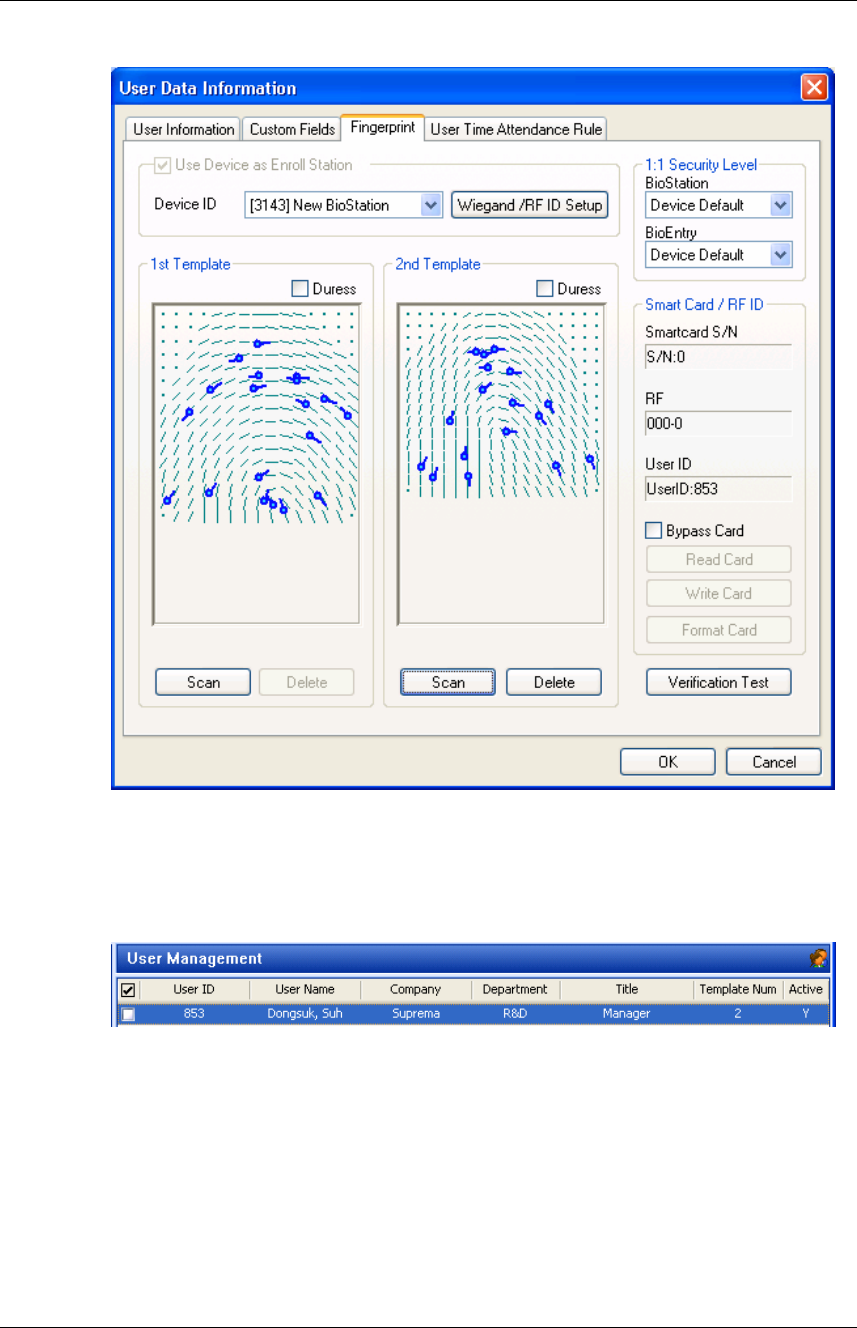
BioAdmin User Manual 67
Copyright © 2006, 2007 by Suprema Inc. http://www.supremainc.com
z To close enroll process, click OK button. Then you can see enrolled user
information on user list window. This means user information has been added
to Database in host PC.
2.1.5. Step 5 : Rules on user T&A event control
New T&A rule can be applied by day.
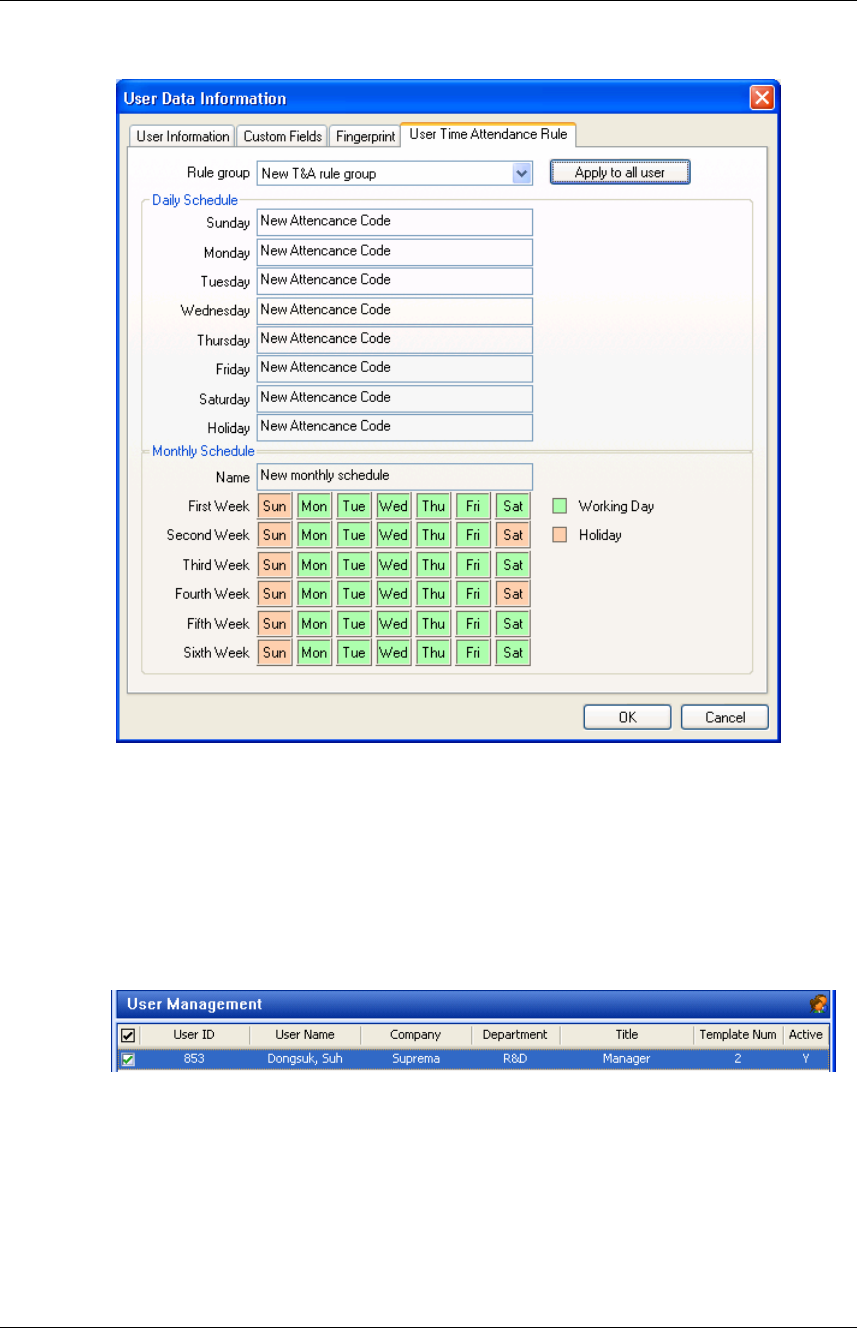
BioAdmin User Manual 68
Copyright © 2006, 2007 by Suprema Inc. http://www.supremainc.com
2.1.6. Step 6 : Enroll user with ‘transfer checked user to device’ menu
Transfer checked user to device is used to transfer user database from host PC
to BioStation. User information such as user ID, fingerprint information, access
group and security level is transferred through this process.
z Check enrolled user
z Click ‘transfer checked user to device’, check ‘device’ and click ok (select)
button.
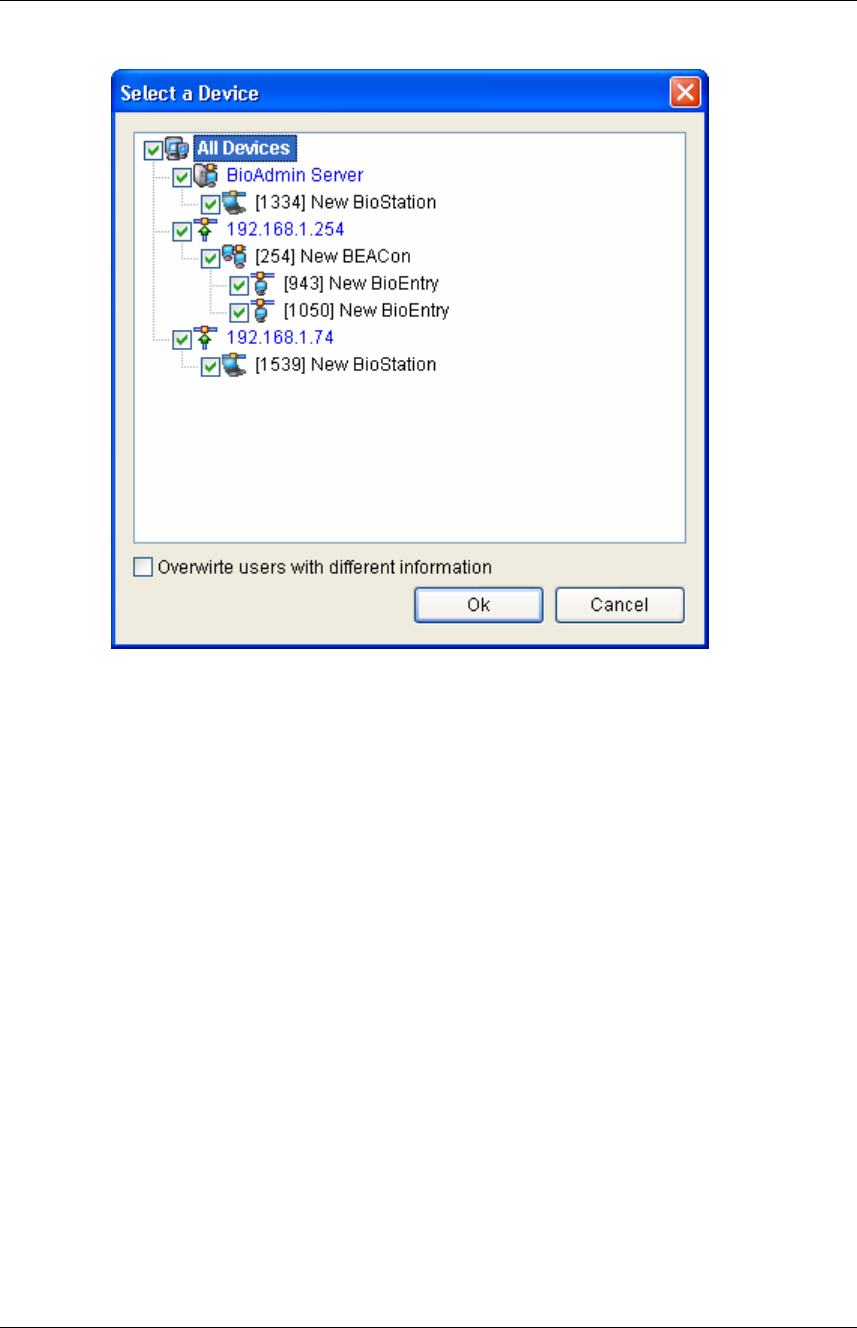
BioAdmin User Manual 69
Copyright © 2006, 2007 by Suprema Inc. http://www.supremainc.com
Press Manage users in device button and click device. If user information
fields are indicated in yellow, it means user information has been transferred to
device successfully.
2.1.7. Step 7: Monitoring
z Select Monitoring menu to show Monitoring display on main window.
z Select Monitoring setting menu and double click Monitoring on/off. To sa ve,
click ok button. To start monitoring for linked all BioStation devices, select start
monitoring.
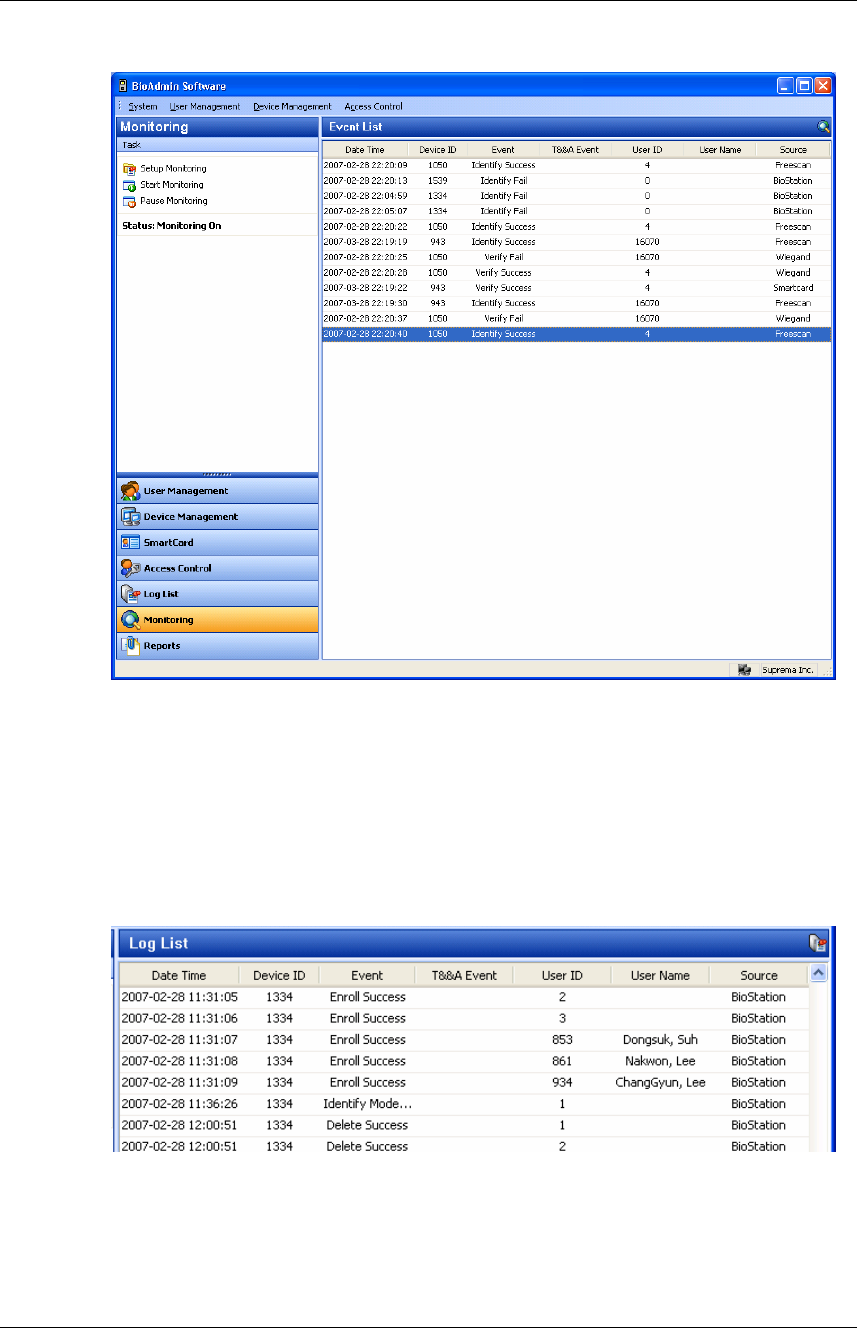
BioAdmin User Manual 70
Copyright © 2006, 2007 by Suprema Inc. http://www.supremainc.com
2.1.8. Step 8: Log List
z Select the Log List menu. Then, the log list window appears on the main
window.
z Select the Get Recent Logs / Auto Upload button to see the updated event
log data added to the existing log list of BioAdmin.
2.1.9. Step 9: Report
Select report menu to display report list on main window. You can specify company
name, dept. name, user ID and user name for setting and select required type of

BioAdmin User Manual 71
Copyright © 2006, 2007 by Suprema Inc. http://www.supremainc.com
report such as daily report by setting period or individual report.
Upload log is a button to upload a log saved in device and update report button
is a button which implements display prior to output listing a log uploaded device by
date and individual. Lastly, view report is a button to preview a report. Press print
button to print.
2.2. Quick start with BioEntry Plus
This paragraph describes basic procedures of operating BioEntry Plus.
2.2.1. Step 1 : HW installation
BioEntry Plus can be networked by LAN as well as by RS485. For details on
installation, refer to BioEntry Plus installation manual.
2.2.2. Step 2 : Search new device
z Run BioAdmin software.
z Enter login ID and password.
z Select device management on main menu to display device management page
on main window.
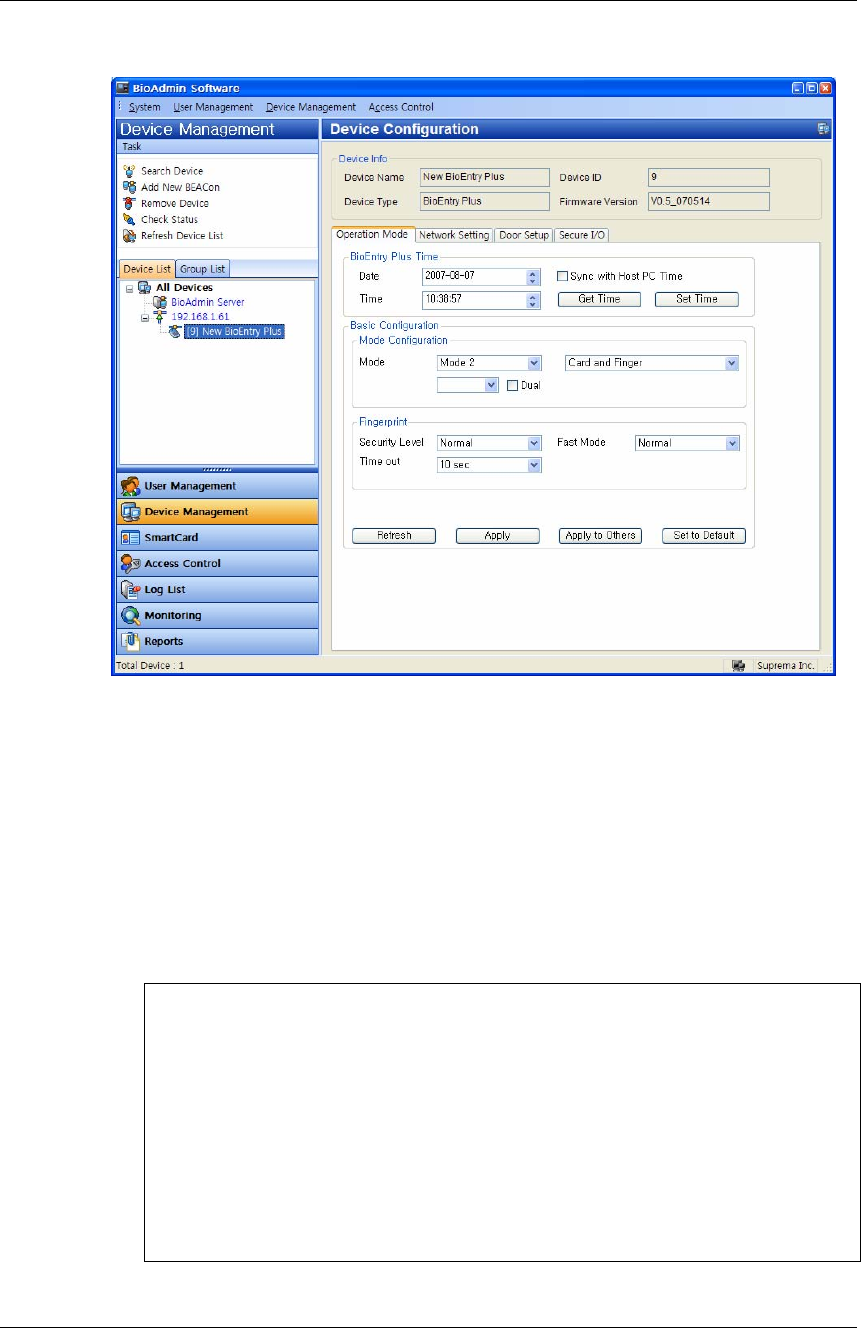
BioAdmin User Manual 72
Copyright © 2006, 2007 by Suprema Inc. http://www.supremainc.com
z Once the BioEntry Plus is connected to the BioAdmin Server, connected
BioEntry Plus will be added to the device tree whenever you start the BioAdmin
software. Also, you can see the connected BioEntry Plus by pressing the
Refresh Device List. Even though a BioEntry Plus is properly connected to the
BioAdmin Server, it may take several minutes to show up on the device tree.
z Select Search device menu, click BioEntry Plus search and press search button.
Note : If you find a device from search results
Ex.)
Detected device : new BioEntry Plus – device number
Finish device search.
Search result ‘---- device(s) found’ is displayed. Press OK button to select
a ,device.
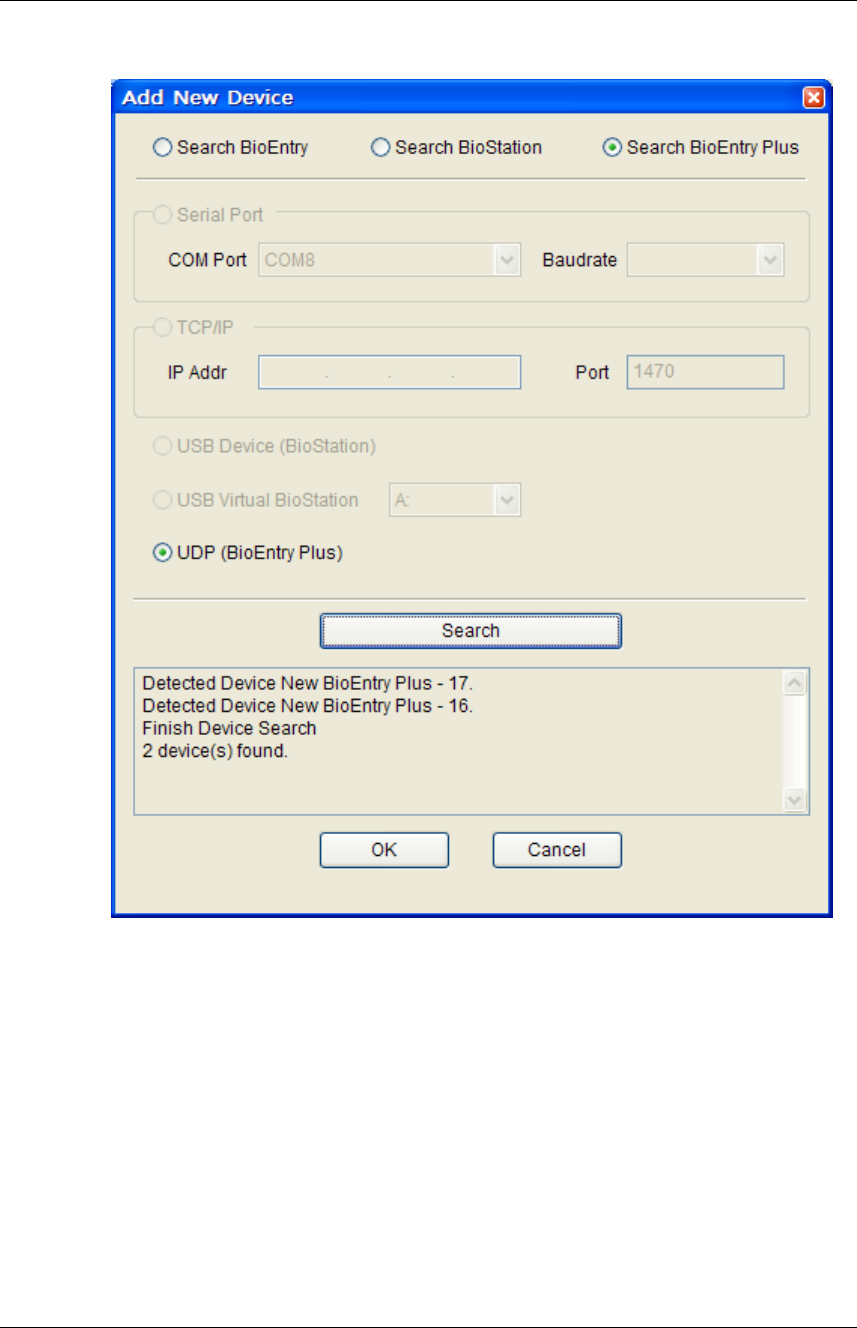
BioAdmin User Manual 73
Copyright © 2006, 2007 by Suprema Inc. http://www.supremainc.com
z Once it’s connected to device successfully, new device ID and network
connected to device are also displayed in device tree window.
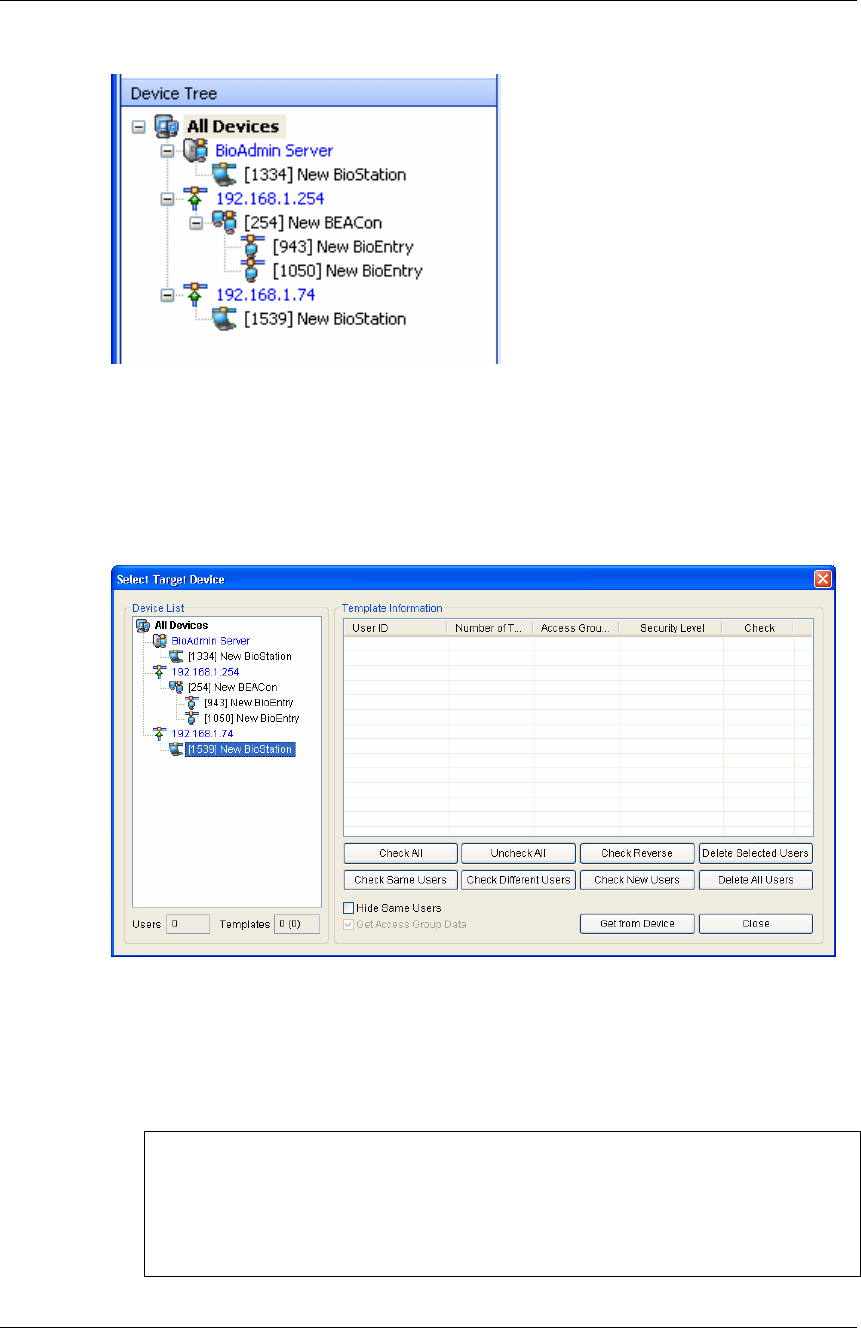
BioAdmin User Manual 74
Copyright © 2006, 2007 by Suprema Inc. http://www.supremainc.com
z Select user management button on main menu and select Manage users in
device on task window.
z Once device is selected, fingerprint information such as user ID, number of
fingerprint, access group, security level and select is displayed.
2.2.3. Step 3: User management
z Select user management menu to display user management page on main
window.
Note : In user management, user related information can be divided into basic
information and fingerprint information. Basic information includes user ID,
name, company, dept., position and telephone number. Fingerprint information
is about user’s fingerprint.
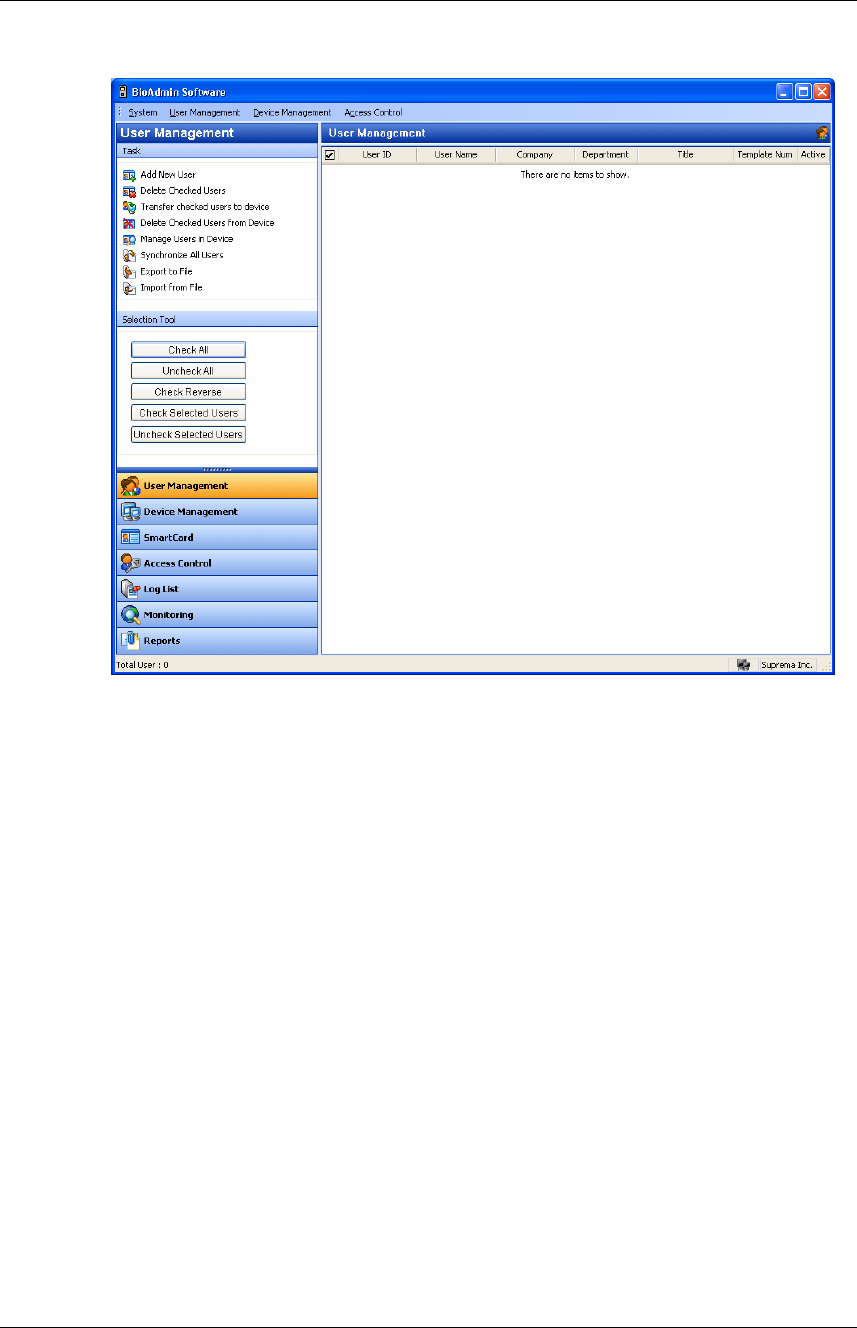
BioAdmin User Manual 75
Copyright © 2006, 2007 by Suprema Inc. http://www.supremainc.com
z Select add new user menu on task window to pop up a window.
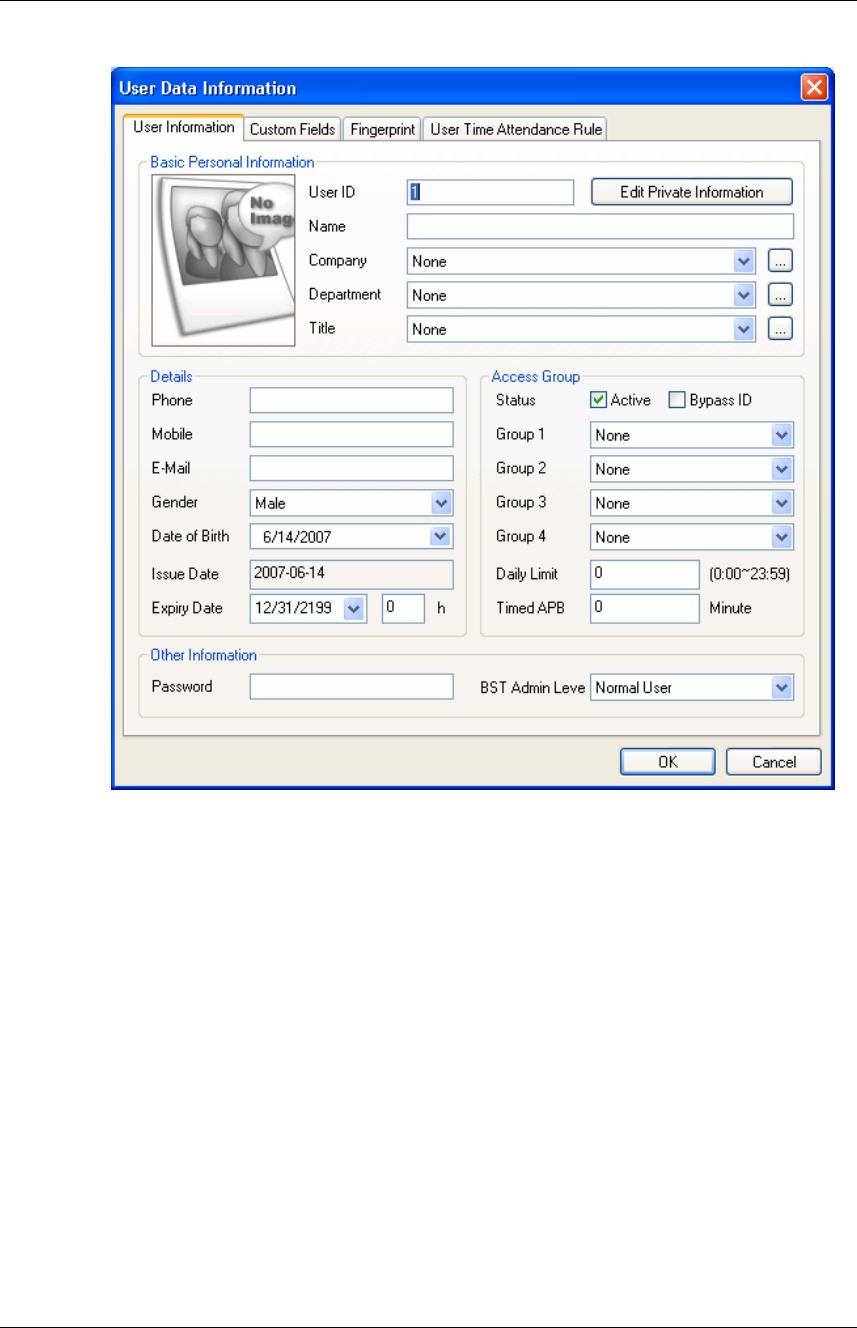
BioAdmin User Manual 76
Copyright © 2006, 2007 by Suprema Inc. http://www.supremainc.com
z Click user information tab and enter user information.
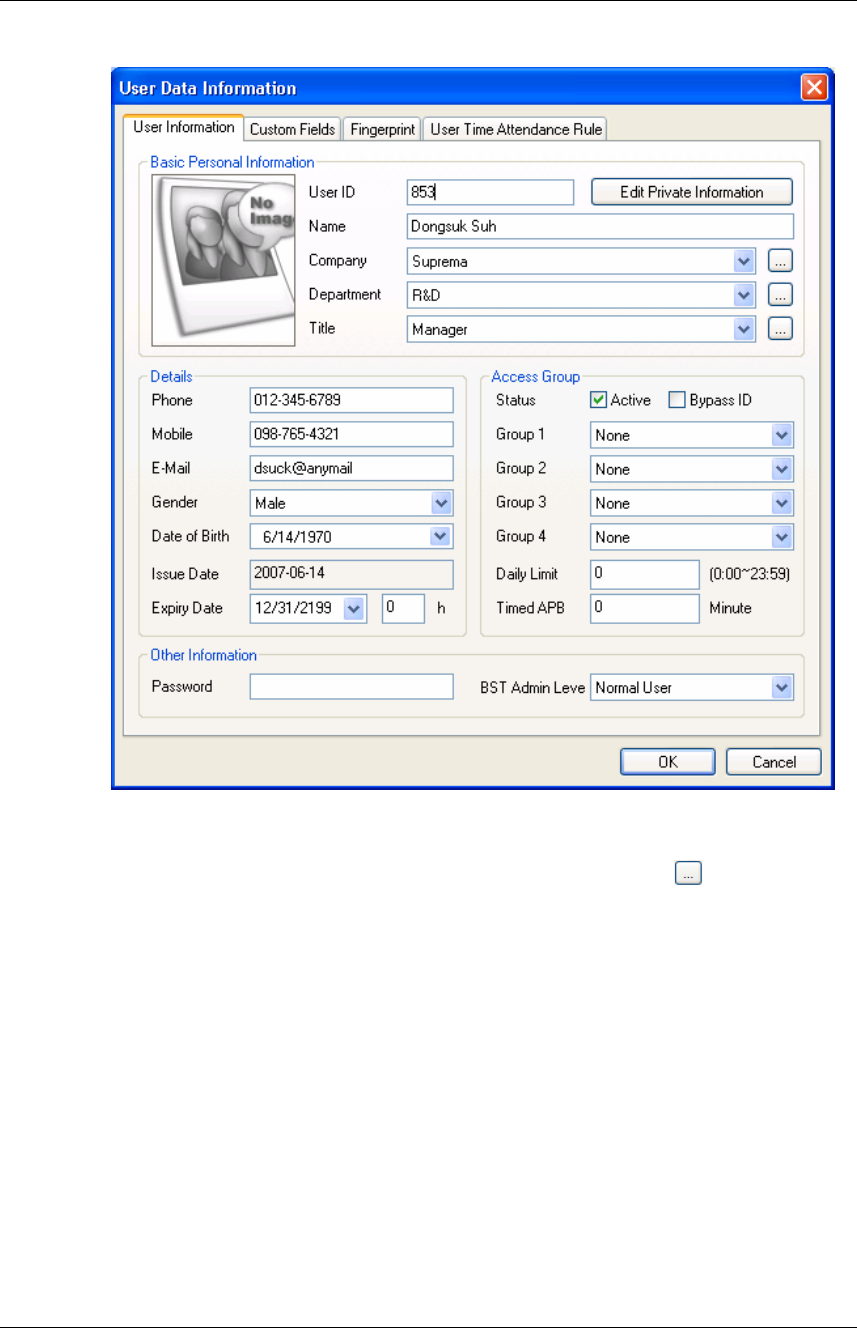
BioAdmin User Manual 77
Copyright © 2006, 2007 by Suprema Inc. http://www.supremainc.com
z Choose company, dept. and title using a combo box.
z To add a new company, dept., or title information, press button or enter
company, dept. or title in information input window and then press add button.
z To save added information, press save button.
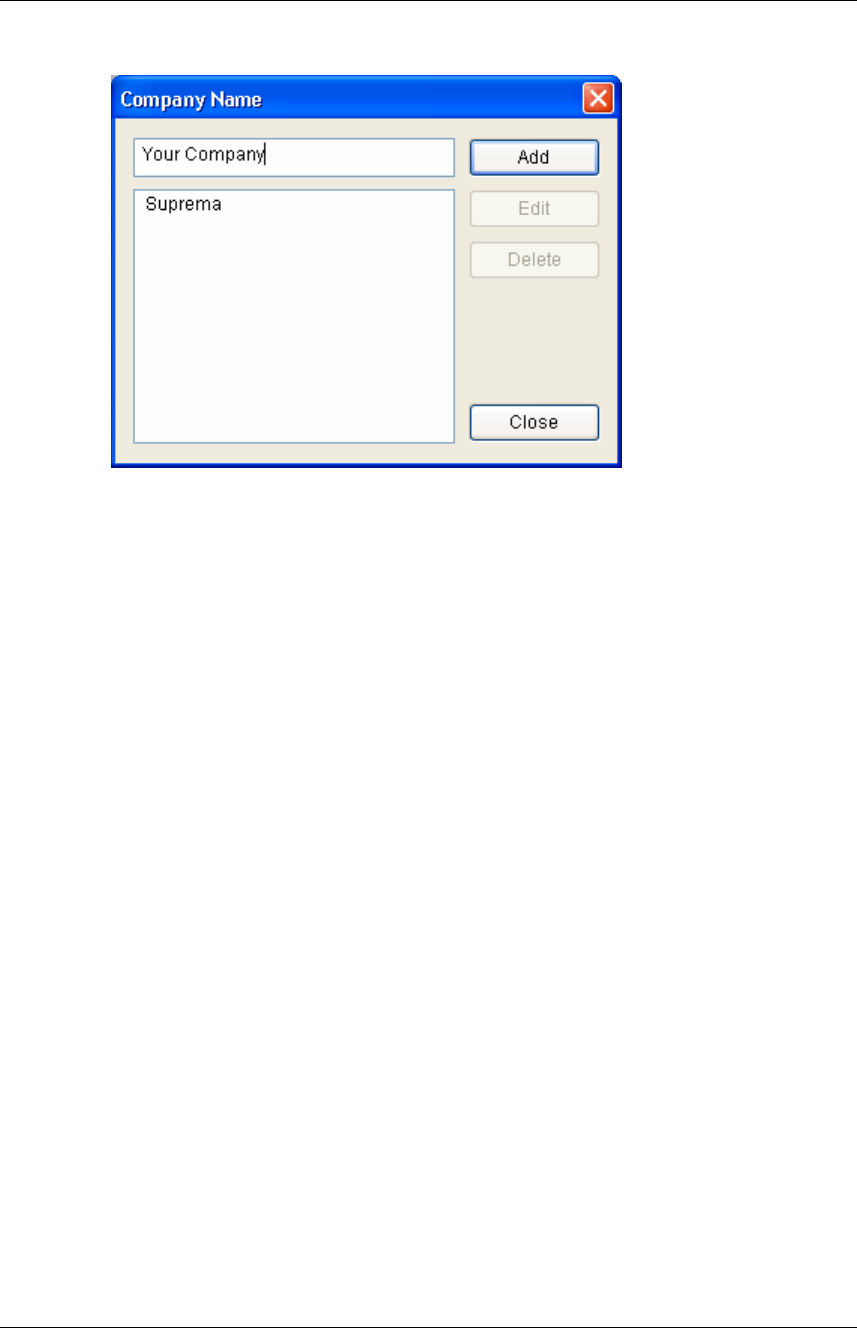
BioAdmin User Manual 78
Copyright © 2006, 2007 by Suprema Inc. http://www.supremainc.com
z To enroll user’s fingerprint information, click fingerprint tab.
z Fingerprint input process is divided into one by USB fingerprint scanner and the
other by BioEntry Plus device.
z How to input fingerprint information using USB fingerprint scanner is as follows.
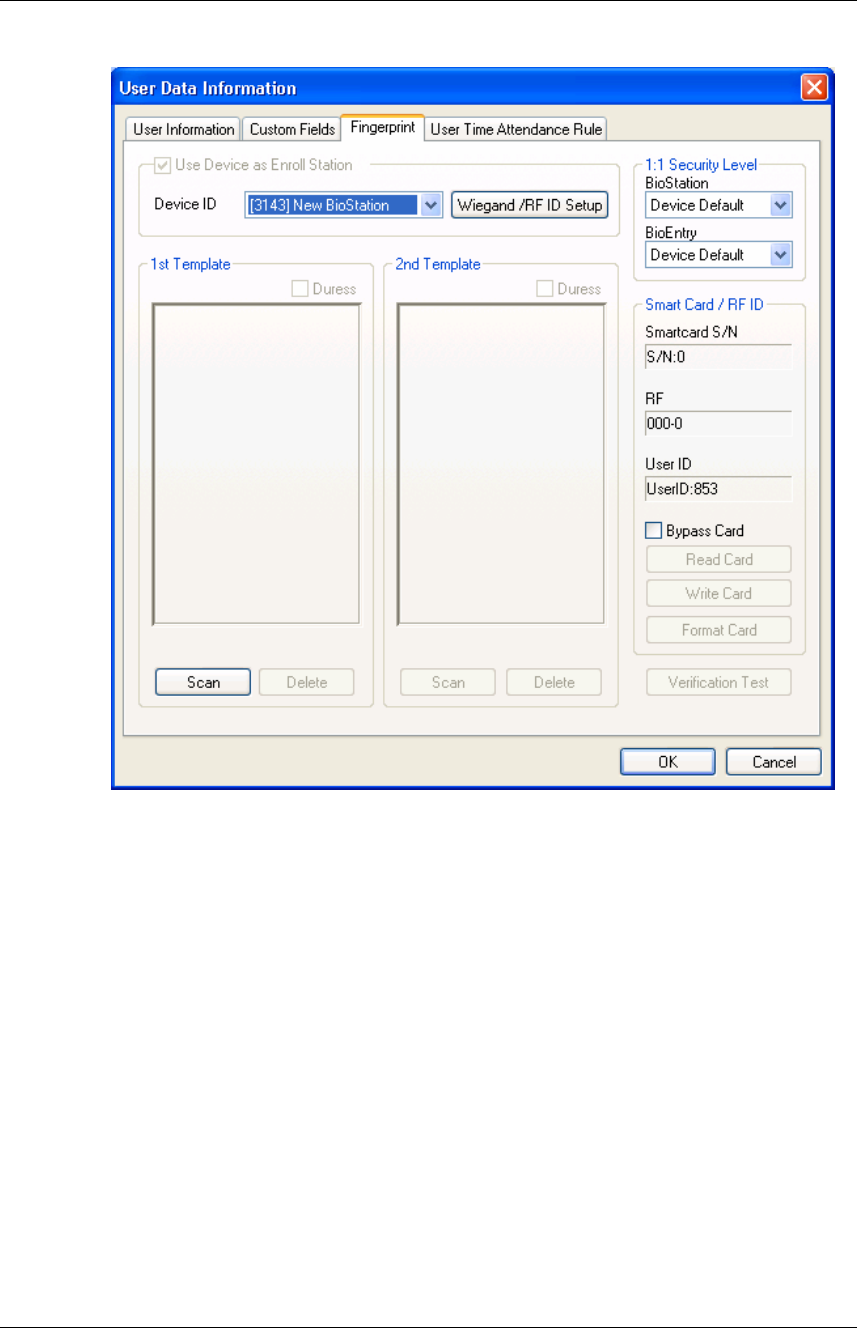
BioAdmin User Manual 79
Copyright © 2006, 2007 by Suprema Inc. http://www.supremainc.com
Press scan button, place a finger on USB fingerprint scanner twice and
input the first fingerprint information.
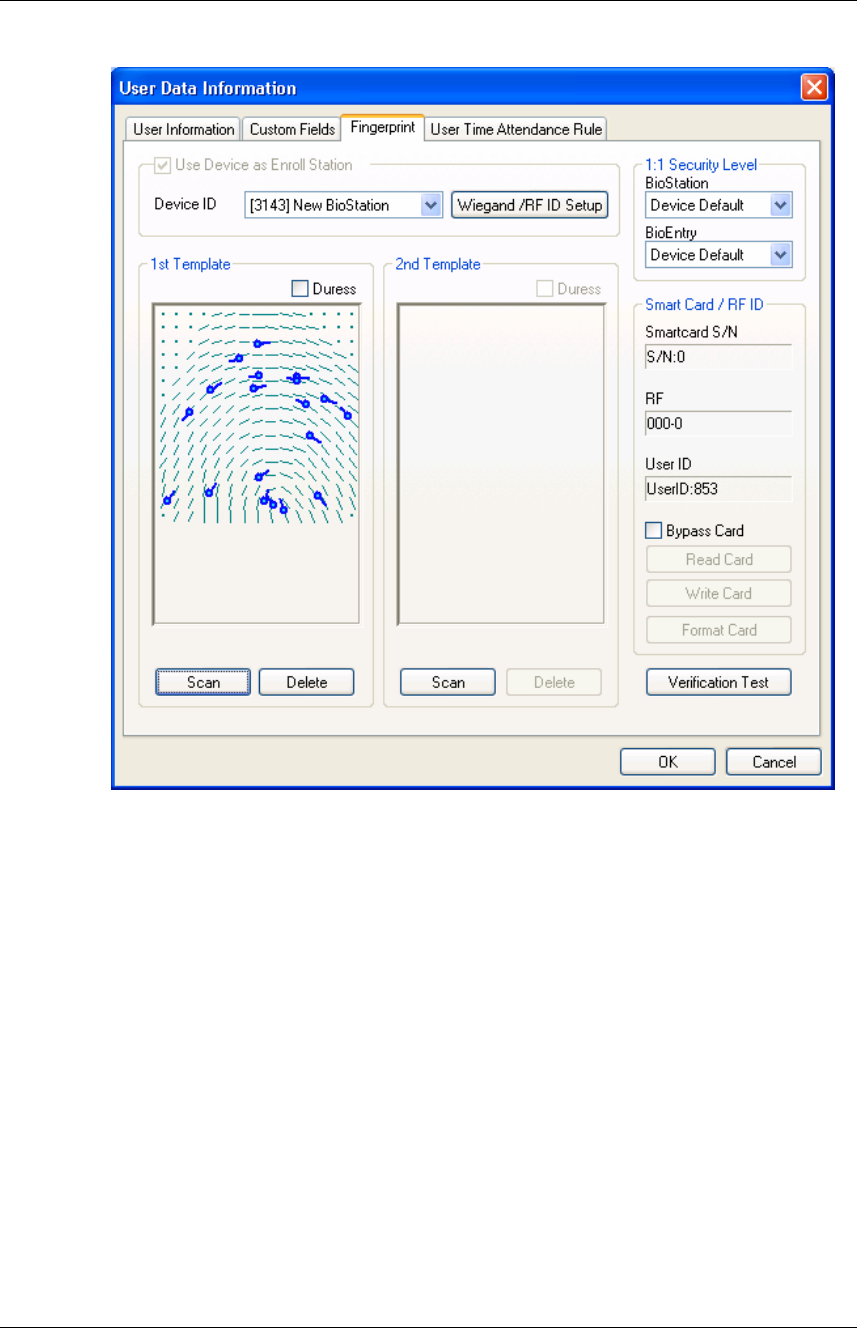
BioAdmin User Manual 80
Copyright © 2006, 2007 by Suprema Inc. http://www.supremainc.com
Input the second fingerprint information in the same way as the first
fingerprint information input process.
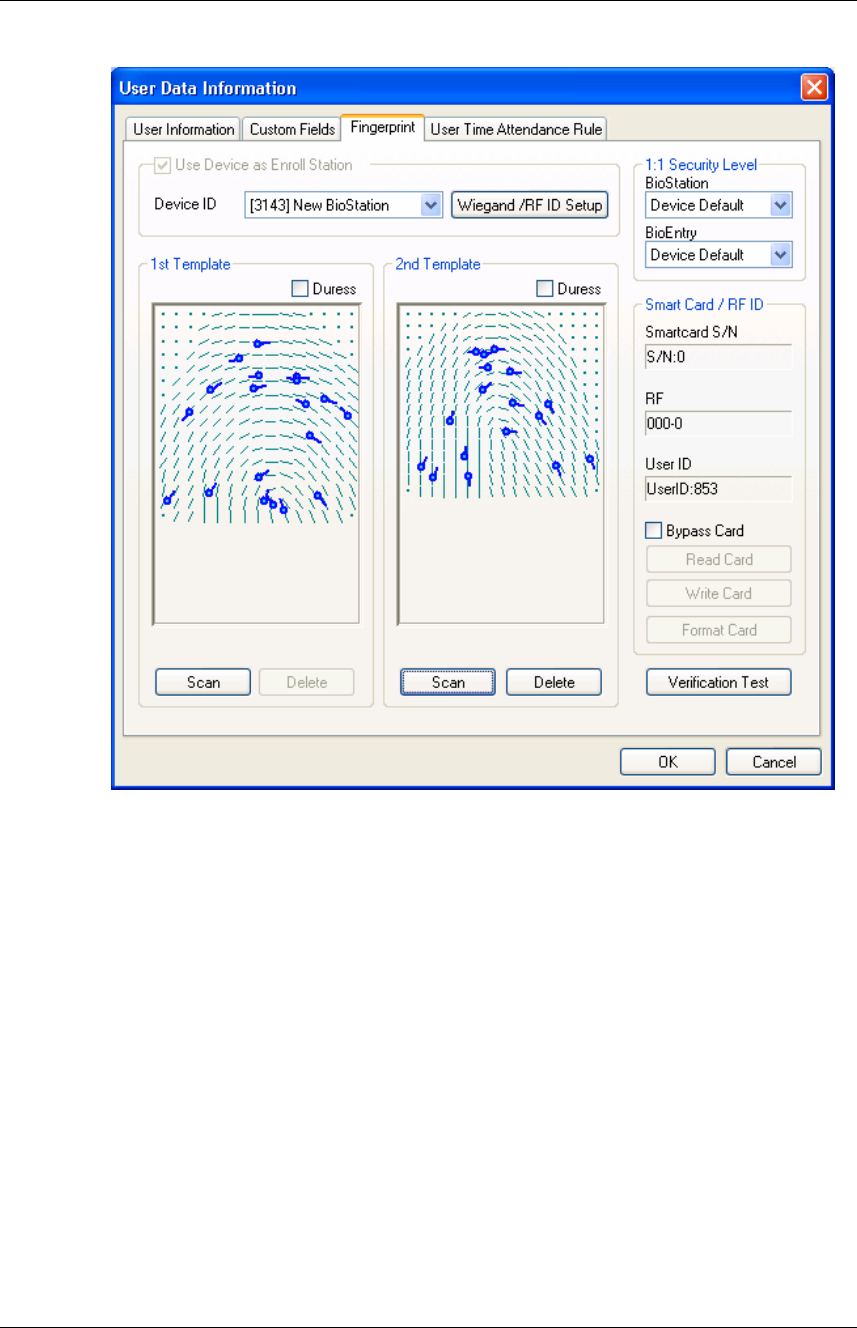
BioAdmin User Manual 81
Copyright © 2006, 2007 by Suprema Inc. http://www.supremainc.com
How to enter fingerprint information by BioEntry Plus device is as follows.
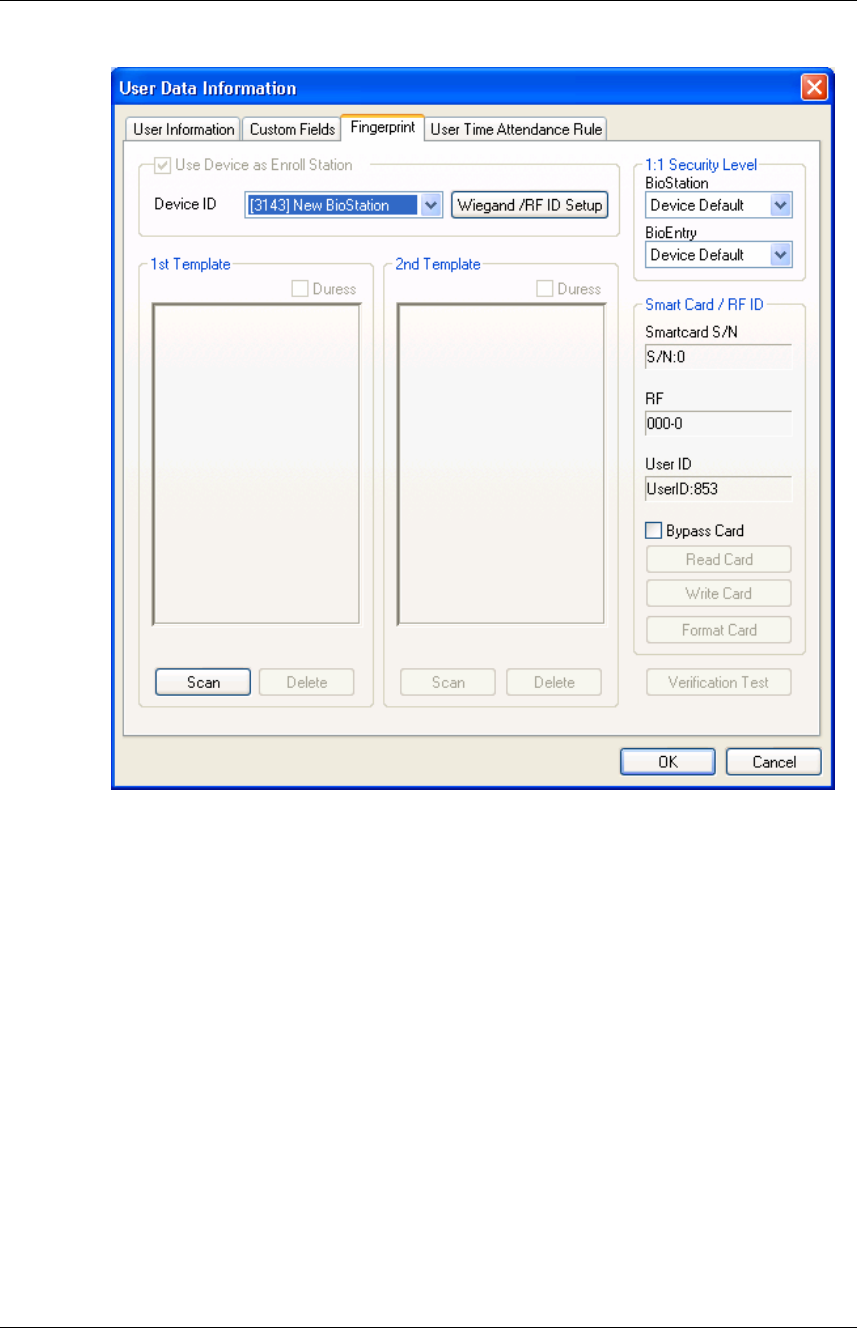
BioAdmin User Manual 82
Copyright © 2006, 2007 by Suprema Inc. http://www.supremainc.com
In case of stand alone mode without USB scanner, check Use BioEntry
Plus as Enroll Station, press scan button, place a finger twice on device
and then input the first fingerprint information. In case that device is
configured by 2 or more networks, specify BioEntry Plus ID, press scan
button, place a finger on device twice and then input the first fingerprint
information.
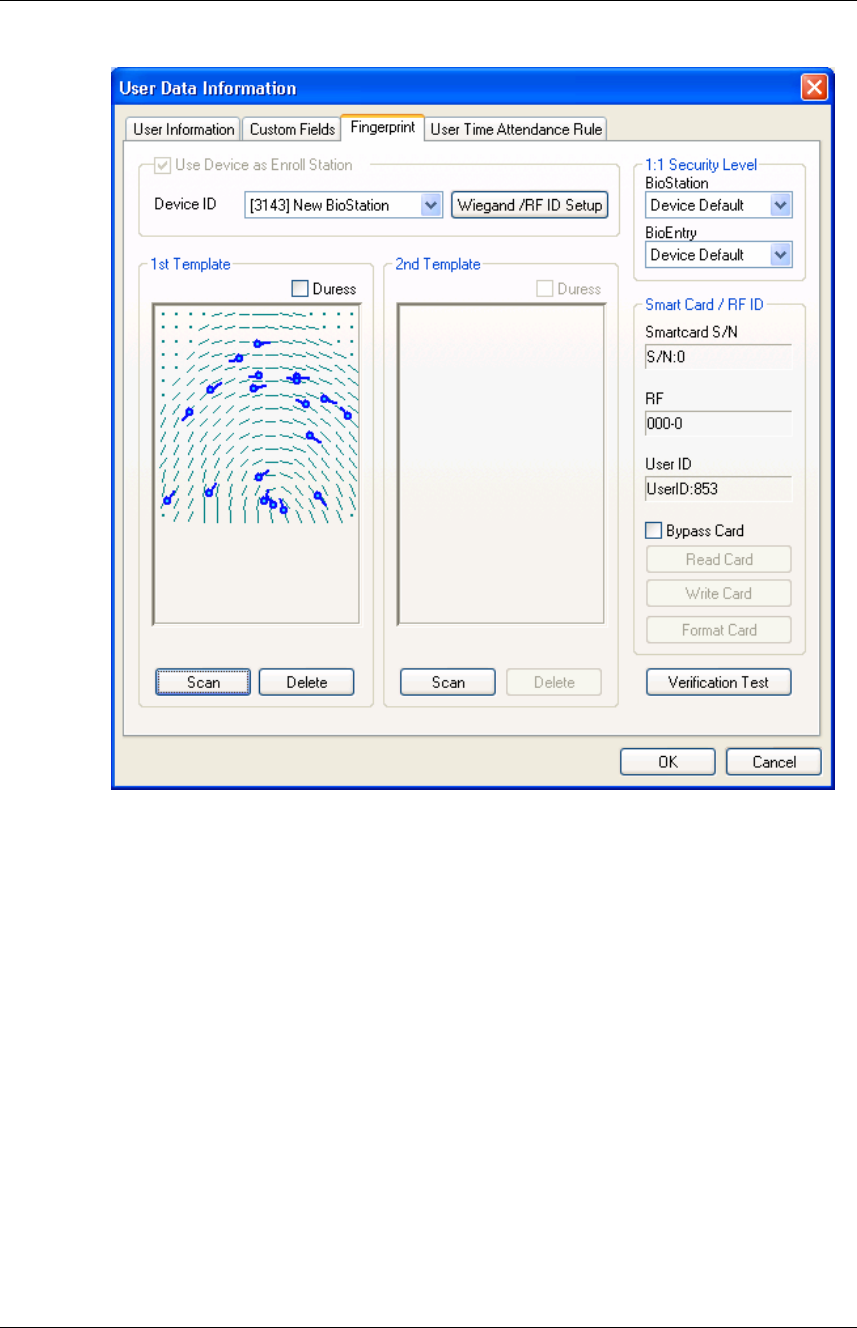
BioAdmin User Manual 83
Copyright © 2006, 2007 by Suprema Inc. http://www.supremainc.com
Input the second fingerprint information in the same way as the process of
first fingerprint information input.
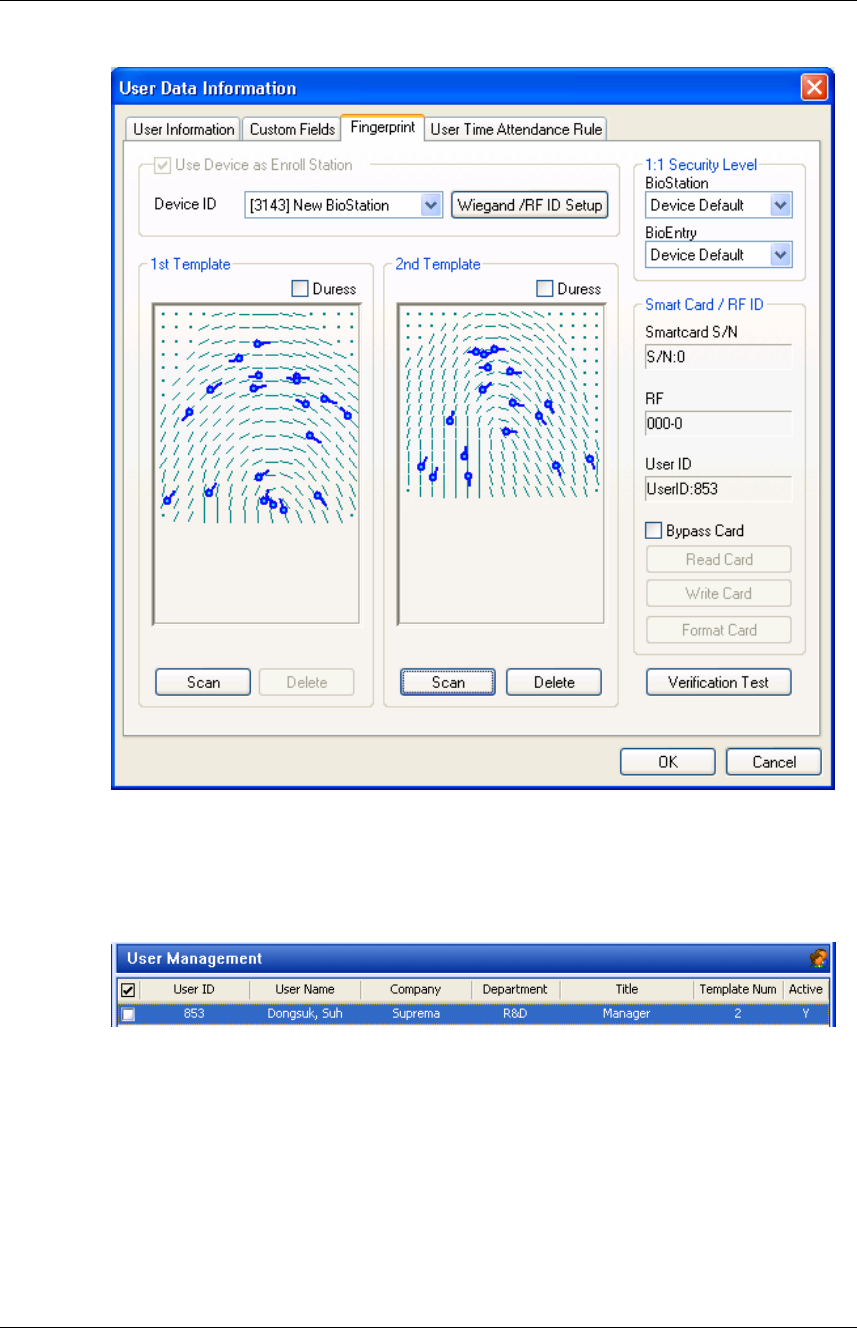
BioAdmin User Manual 84
Copyright © 2006, 2007 by Suprema Inc. http://www.supremainc.com
z To close enroll process, click OK button. Then you can see enrolled user
information on user list window. This means user information has been added
to Database in host PC.
2.2.4. Step 4 : Rules on user T&A event control
New T&A rule can be applied by day.
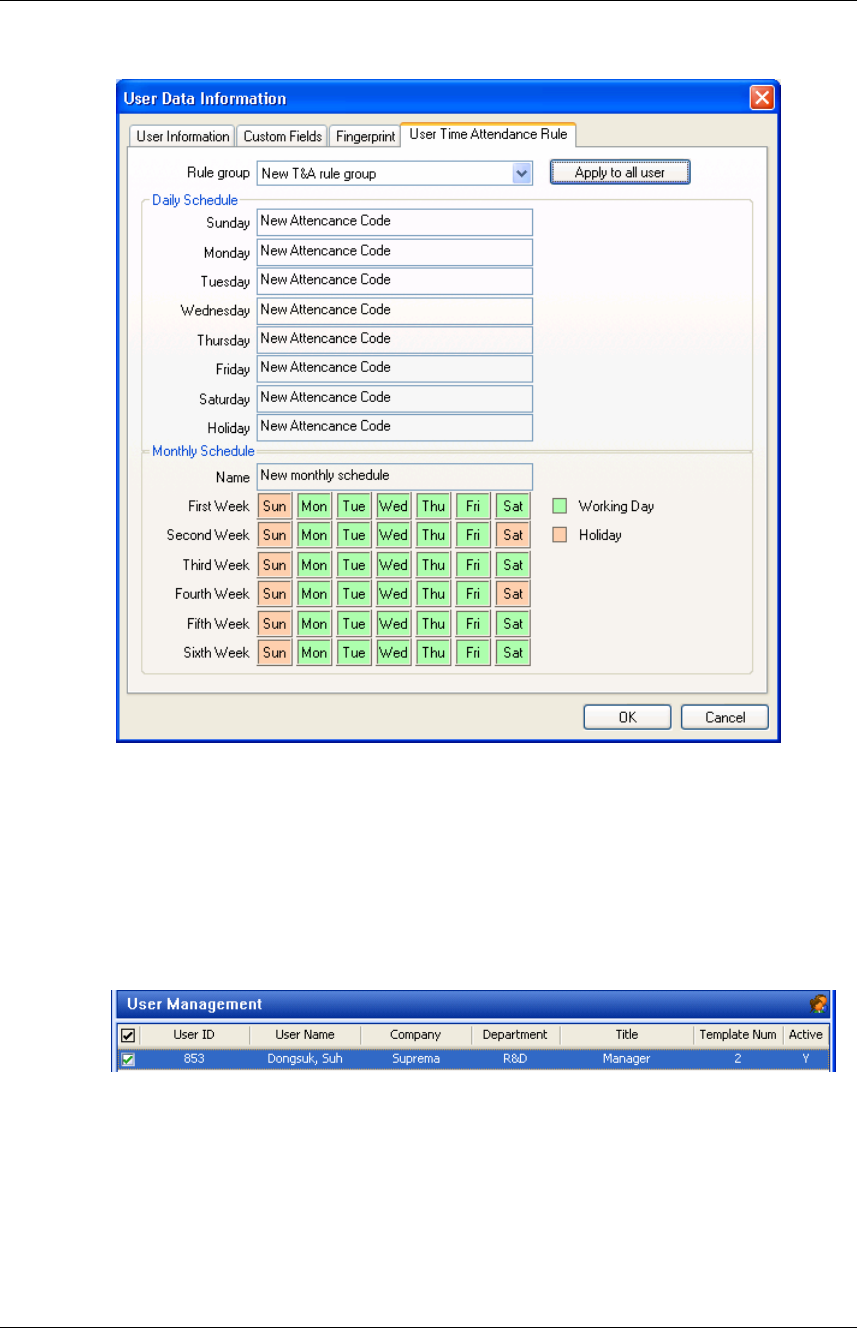
BioAdmin User Manual 85
Copyright © 2006, 2007 by Suprema Inc. http://www.supremainc.com
2.2.5. Step 5 : Enroll user with ‘transfer checked user to device’ menu
Transfer checked user to device is used to transfer user database from host PC
to BioEntry Plus. User information such as user ID, fingerprint information, access
group and security level is transferred through this process.
z Check enrolled user
z Click ‘transfer checked user to device’, check ‘device’ and click ok (select)
button.
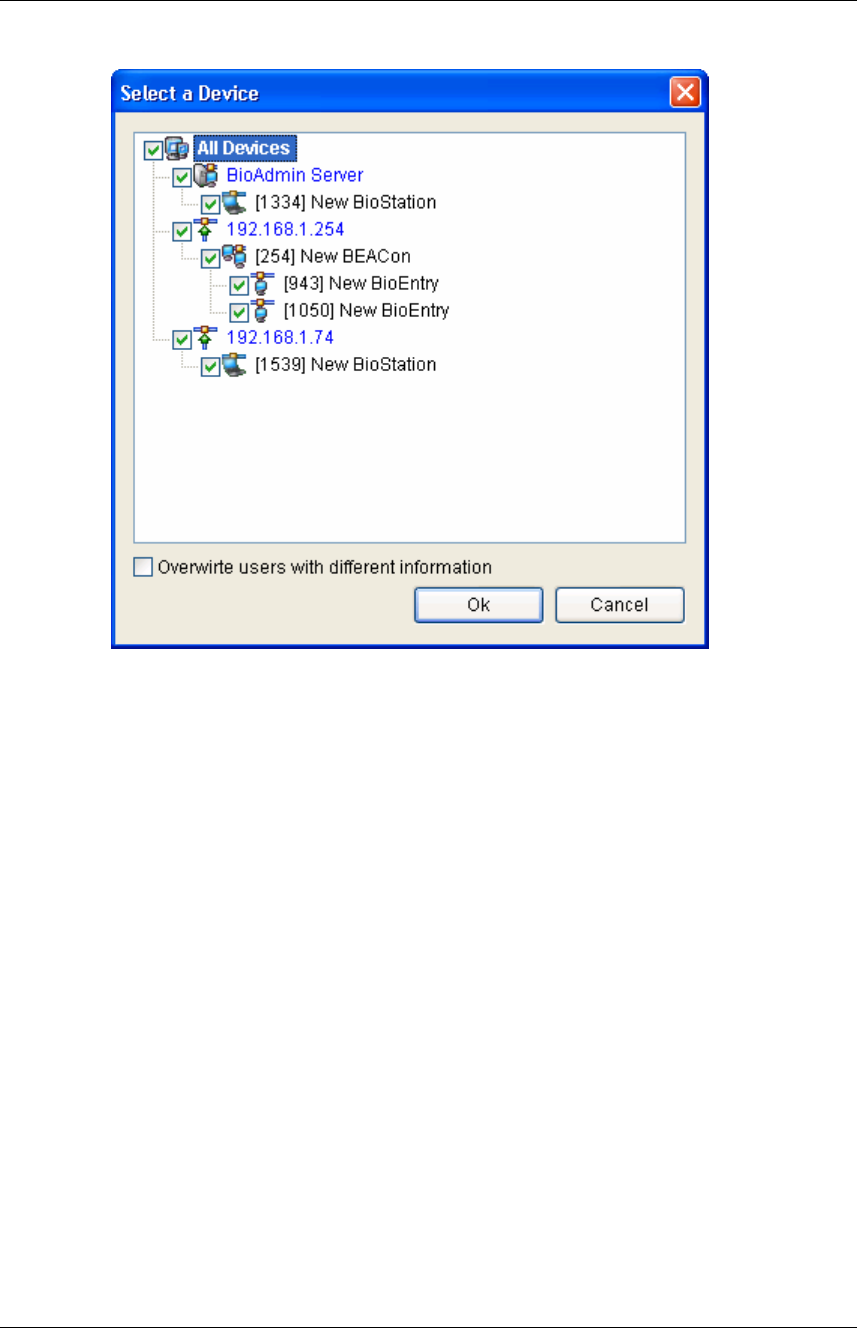
BioAdmin User Manual 86
Copyright © 2006, 2007 by Suprema Inc. http://www.supremainc.com
Press Manage users in device button and click device. If user information
fields are indicated in yellow, it means user information has been transferred to
device successfully.
2.2.6. Step 6: Monitoring
z Select Monitoring menu to show Monitoring display on main window.
z Select Monitoring setting menu and double click Monitoring on/off. To sa ve,
click ok button. To start monitoring for linked all BioEntry Plus devices, select
start monitoring.
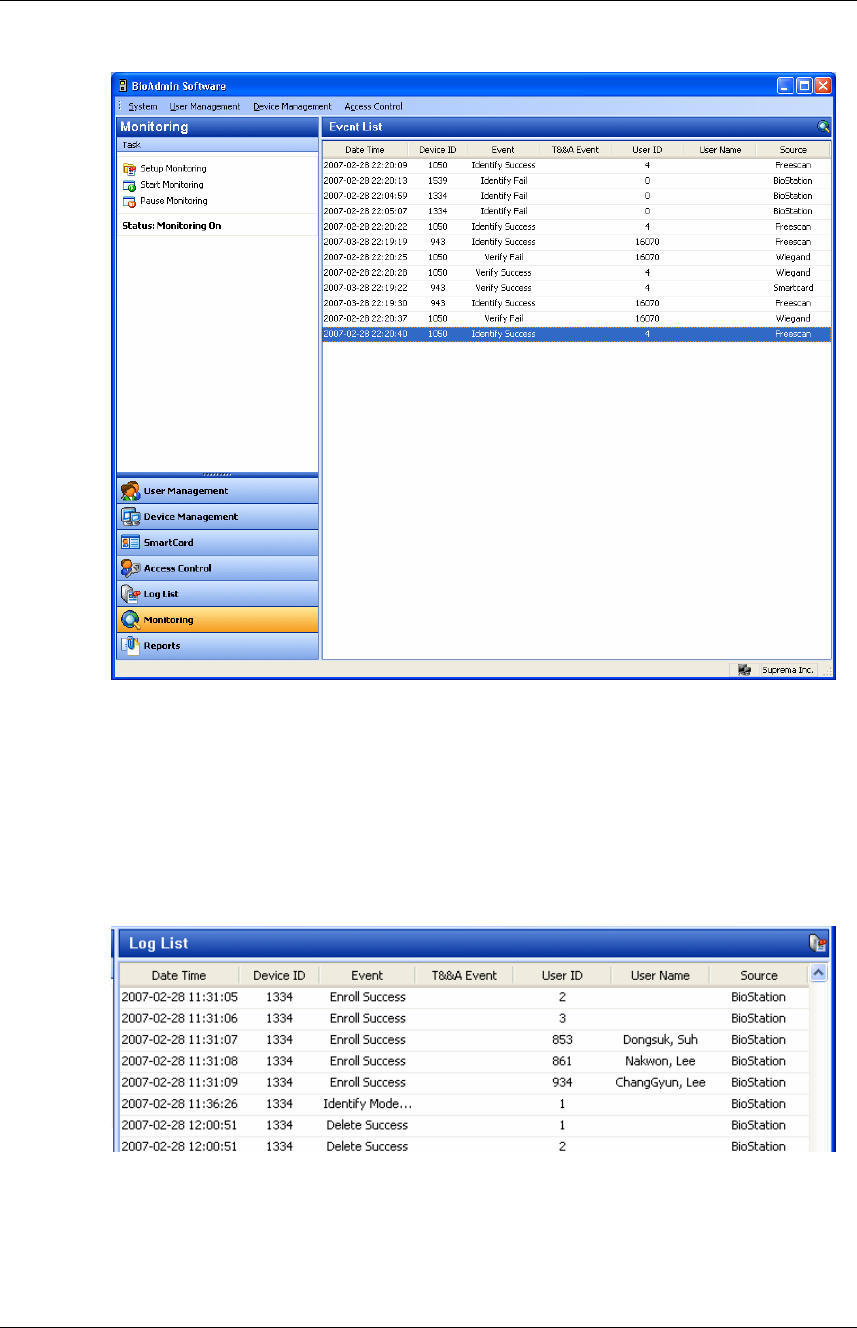
BioAdmin User Manual 87
Copyright © 2006, 2007 by Suprema Inc. http://www.supremainc.com
2.2.7. Step 7: Log List
z Select the Log List menu. Then, the log list window appears on the main
window.
z Select the Get Recent Logs / Auto Upload button to see the updated event
log data added to the existing log list of BioAdmin.
2.2.8. Step 8: Report
Select report menu to display report list on main window. You can specify company
name, dept. name, user ID and user name for setting and select required type of
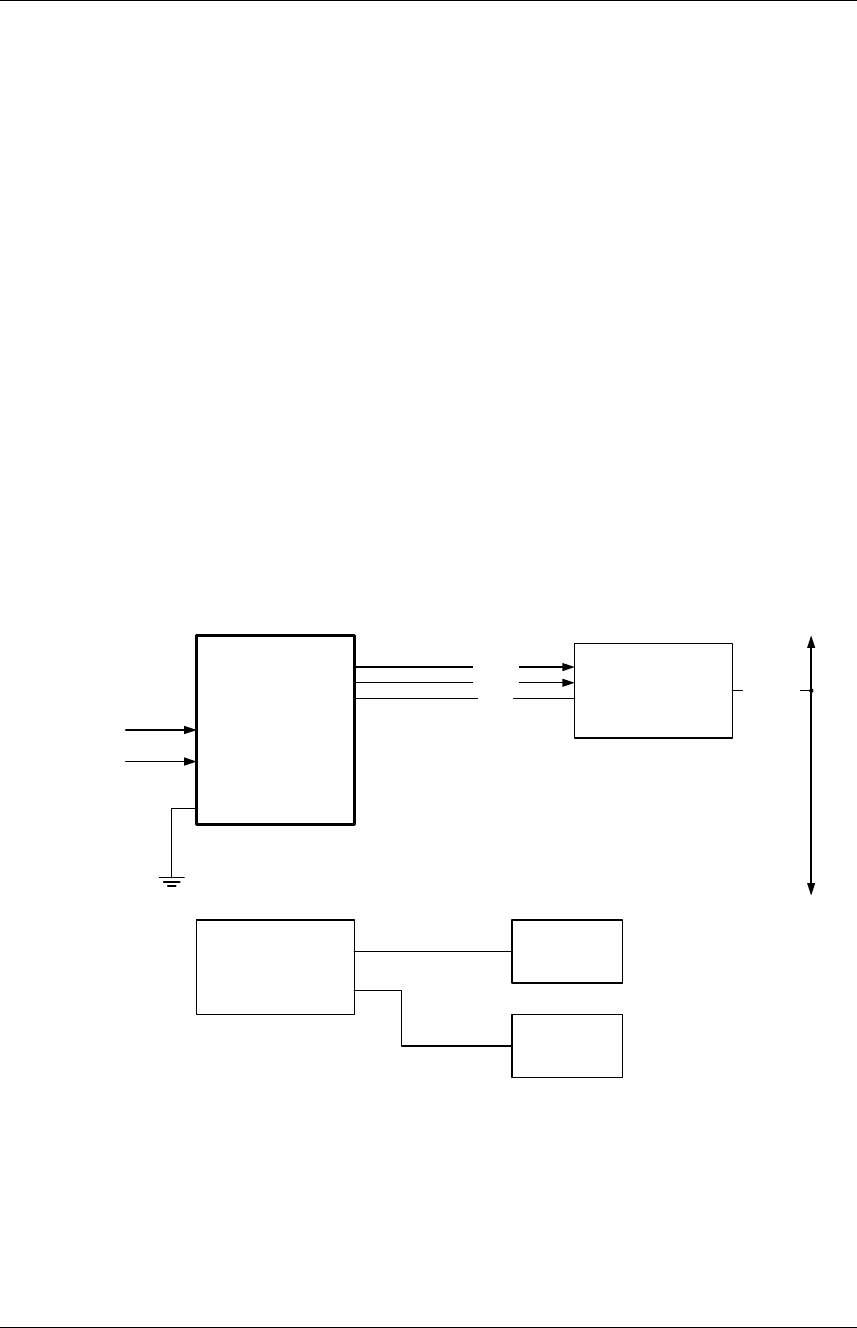
BioAdmin User Manual 88
Copyright © 2006, 2007 by Suprema Inc. http://www.supremainc.com
report such as daily report by setting period or individual report.
Upload log is a button to upload a log saved in device and update report button
is a button which implements display prior to output listing a log uploaded device by
date and individual. Lastly, view report is a button to preview a report. Press print
button to print.
2.3. Quick start with BioEntry Smart
This section describes the basic procedures to operate BioEntry Smart using a
USB fingerprint scanner and smart card device as its enrollment device.
2.3.1. Step 1: Hardware installation
In this hardware configuration, the device is not connected to the host PC, but to an
external controller via Wiegand interface. It is assumed that the controller supports
the standard 26 bit Wiegand format as default on BioEntry device. Connect the
device with the controller as shown on the following configuration.
Host PC
Data 1 Access Controller
Data 0
GND Network
To other controllers
or host computer
WO_D0
WO_D1
WO_GND
EARTH
BioEntry Smart
POW_GND
POW+
9~24Vdc
Wiegand I/F
Fingerprint
Reader
Smartcard
Reader
USB
For more details on the installation, refer to the BioEntry Installation manual or
BEACon Operation Manual.
2.3.2. Step 2: Enroll user
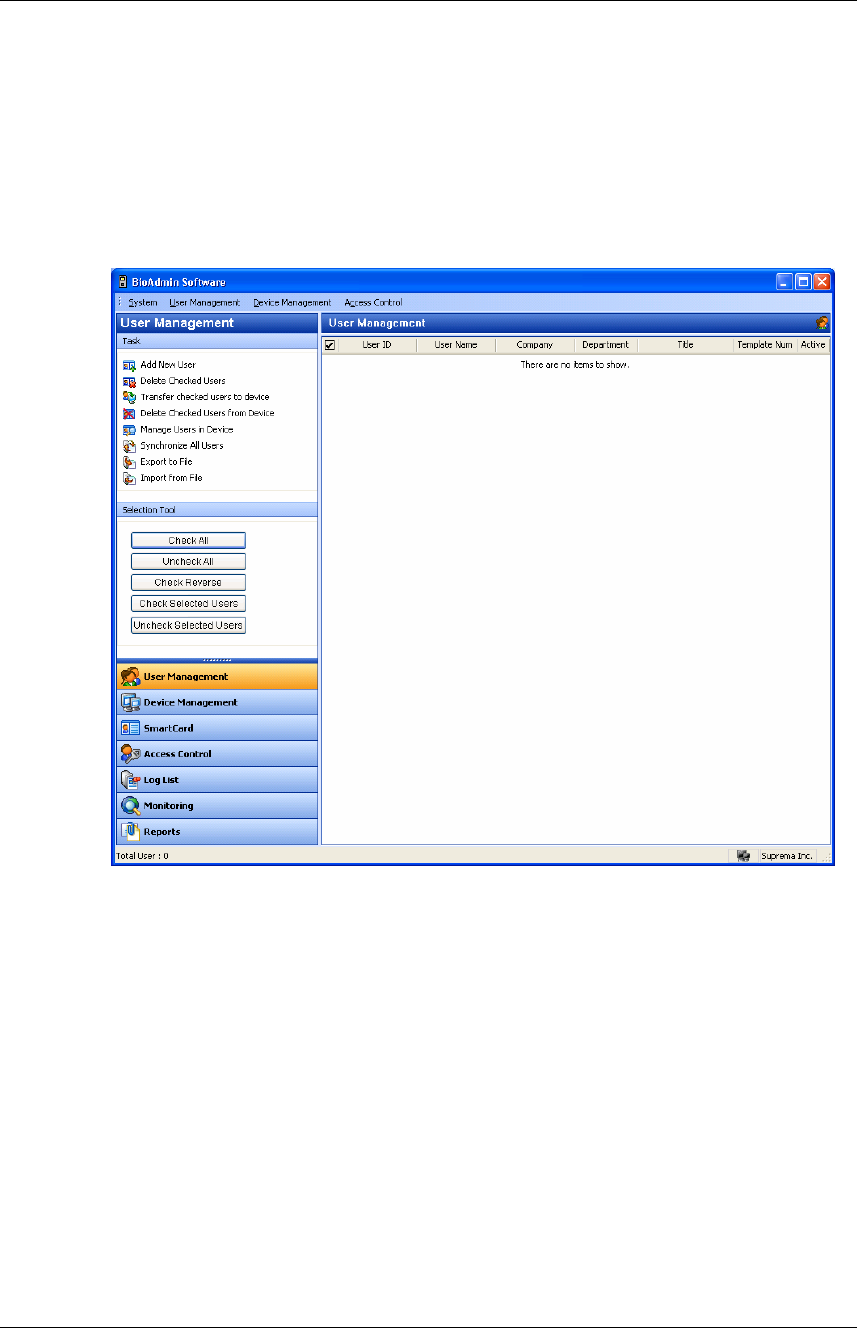
BioAdmin User Manual 89
Copyright © 2006, 2007 by Suprema Inc. http://www.supremainc.com
z Run BioAdmin software.
z Enter Login ID and password. By factory default, the initial Login ID is “admin”
and the password is blank.
z Select User Management on the main menu, then the user management page
appears on the main window.
z Select the Add New User menu on the task window, then the pop-up window
appears
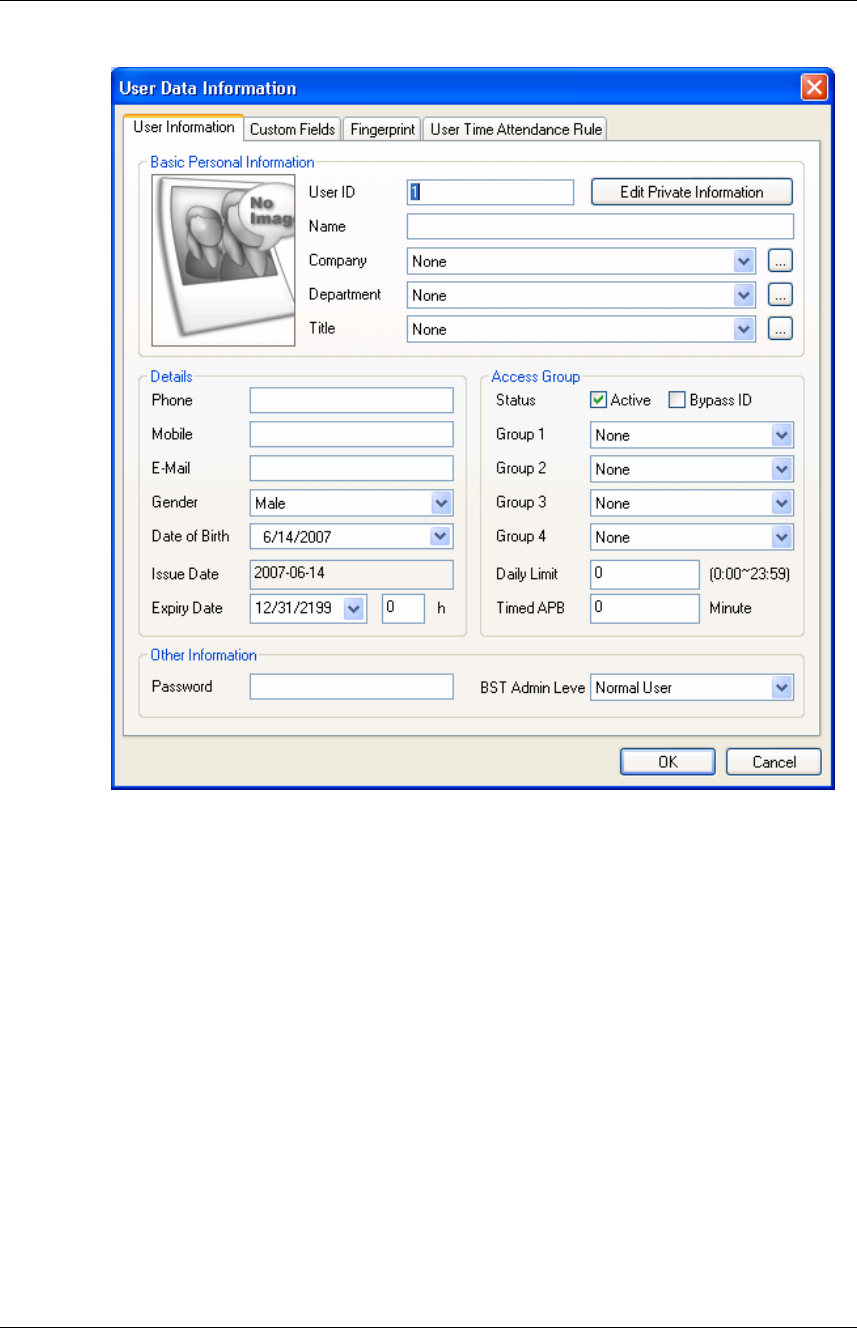
BioAdmin User Manual 90
Copyright © 2006, 2007 by Suprema Inc. http://www.supremainc.com
z Enter the user information on the User Information tab.
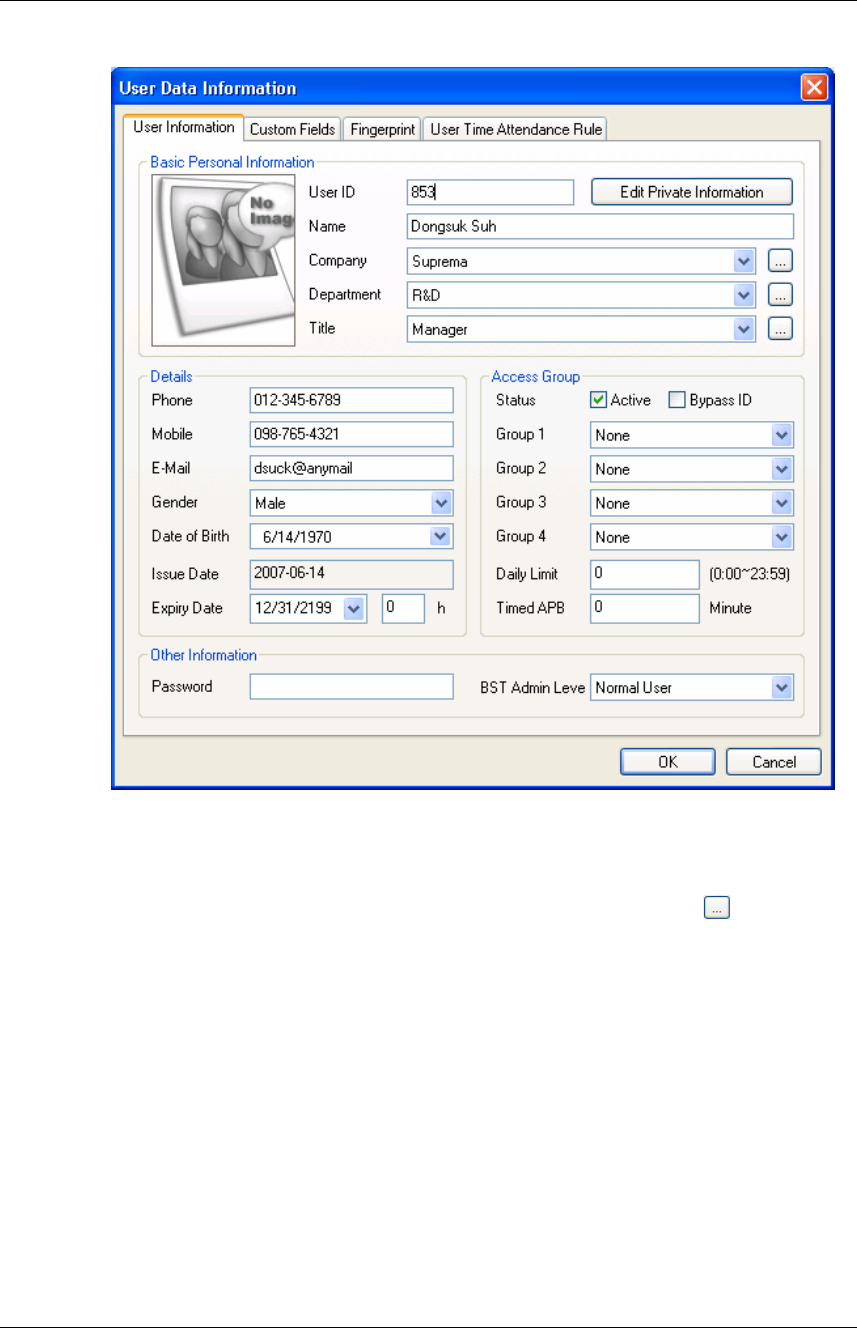
BioAdmin User Manual 91
Copyright © 2006, 2007 by Suprema Inc. http://www.supremainc.com
z Especially, you can select the Company, Department, and Title on the drag
down menu.
z To add new Company, Department, or Title information, press button. After
entering the required information, press Add button. Press Save button to save
the added information.
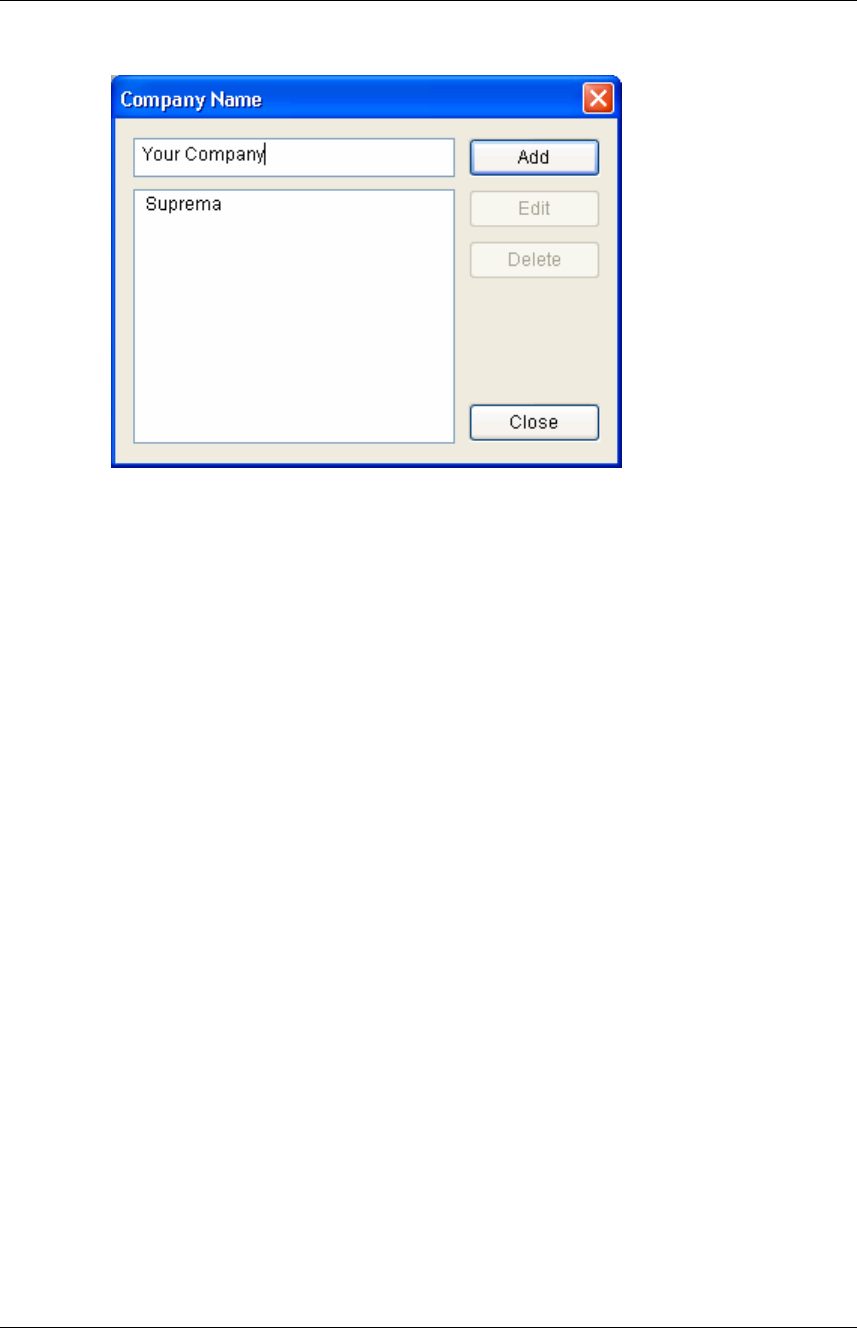
BioAdmin User Manual 92
Copyright © 2006, 2007 by Suprema Inc. http://www.supremainc.com
z In addition to the basic user information, you can add Custom Fields to the
user information. If you do not need these custom fields, just skip the custom
fields setting. To set up the custom fields, press Custom Fields tab.
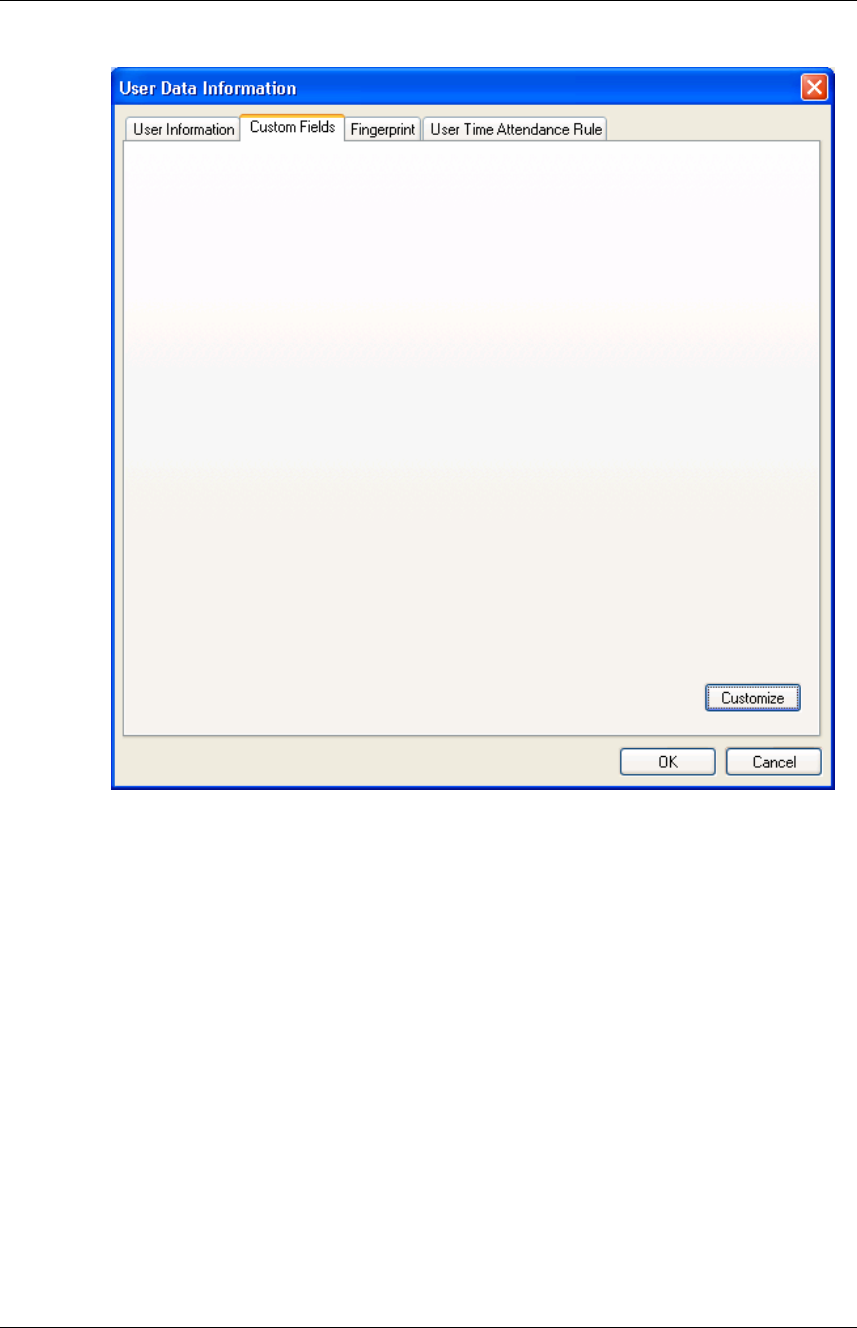
BioAdmin User Manual 93
Copyright © 2006, 2007 by Suprema Inc. http://www.supremainc.com
z Click the Customize... button.
z Check on the required Fields and enter the user information for those selected
fields.
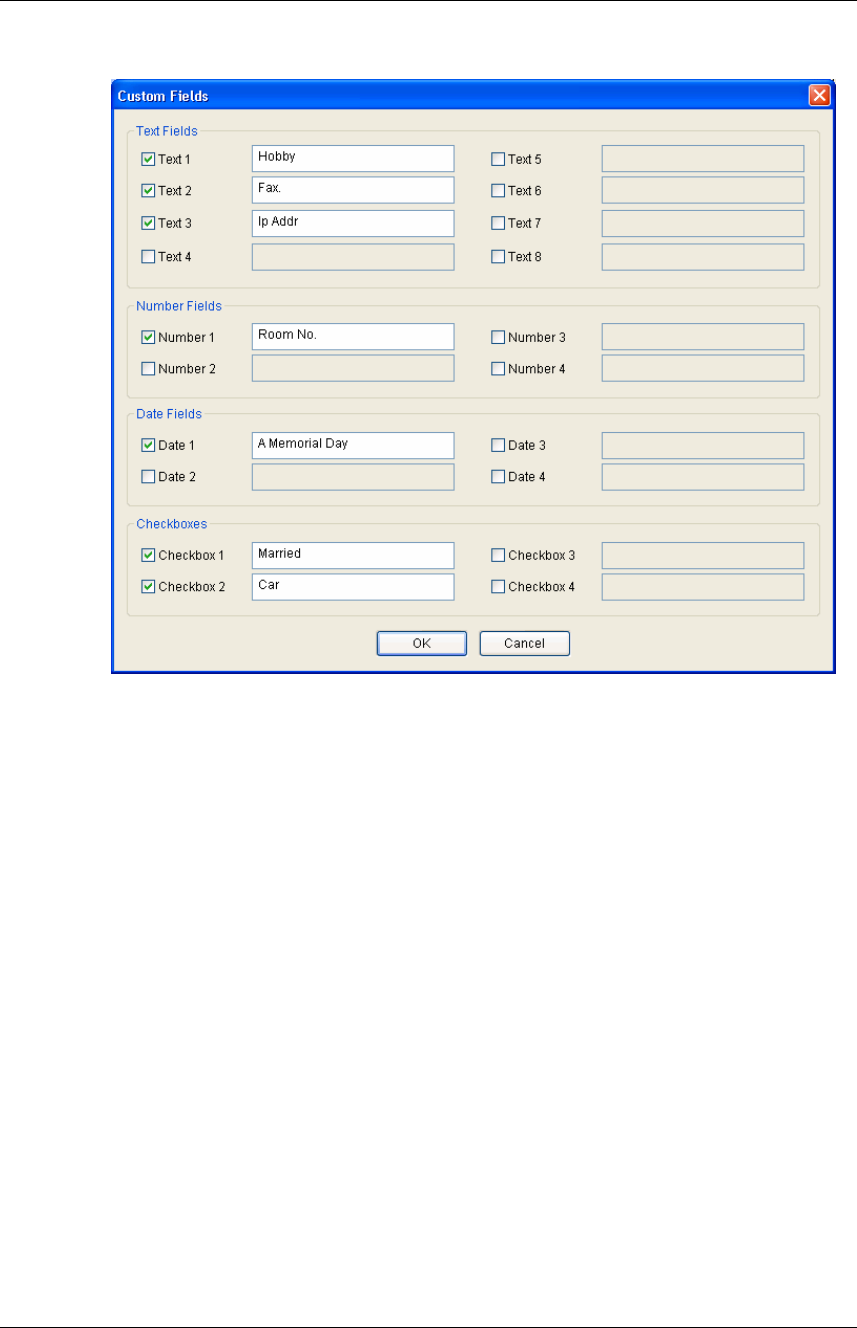
BioAdmin User Manual 94
Copyright © 2006, 2007 by Suprema Inc. http://www.supremainc.com
z After entering the user information, press the OK button.
z After filling out the custom fields, the following pop-up window will appear. On
this window, you can see the details of your selected custom fields. Press OK
button to save these custom fields.
z After entering the user information, press the Fingerprint tab to enroll user’s
fingerprint templates.
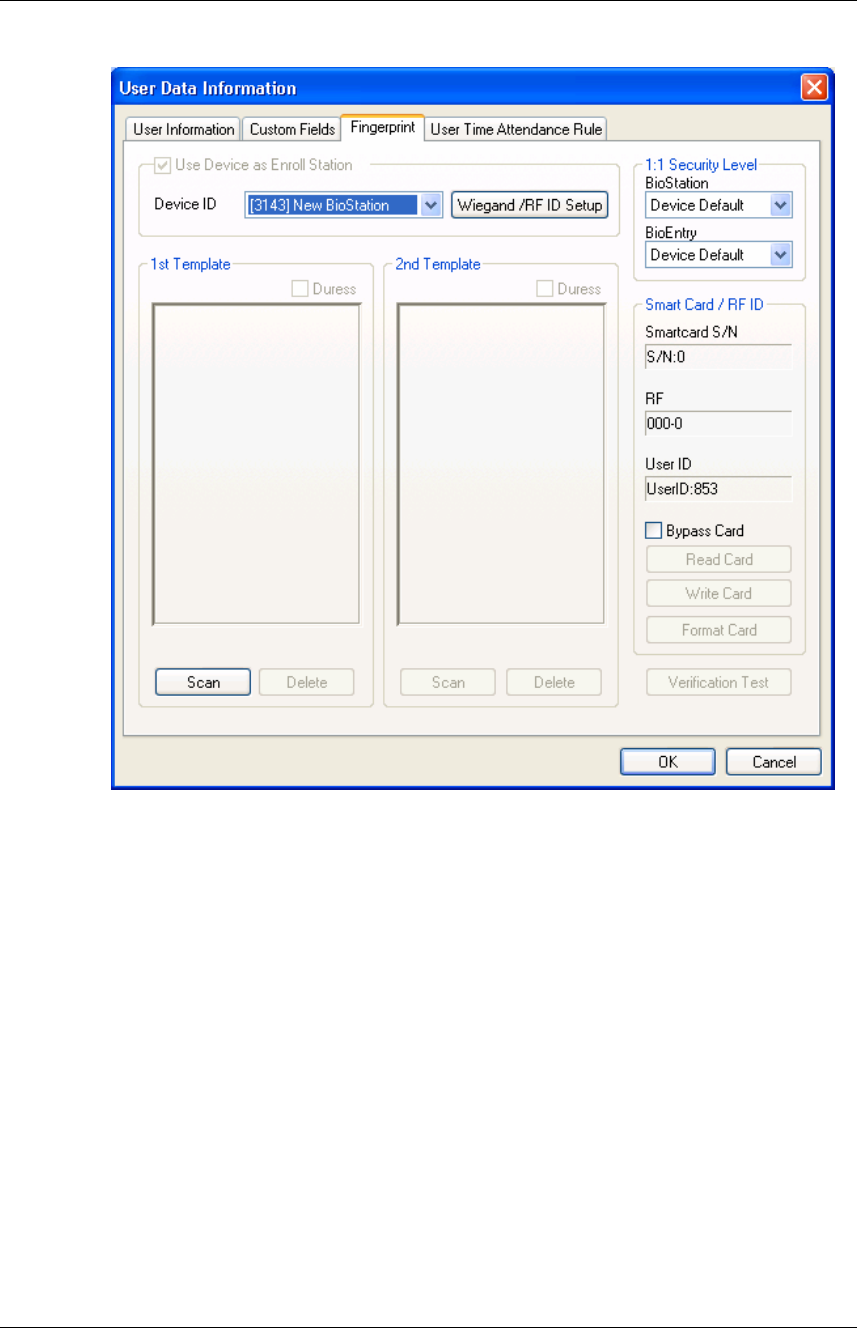
BioAdmin User Manual 95
Copyright © 2006, 2007 by Suprema Inc. http://www.supremainc.com
z Acquire first template by pressing the Scan button followed by touching finger
on the USB fingerprint scanner twice.
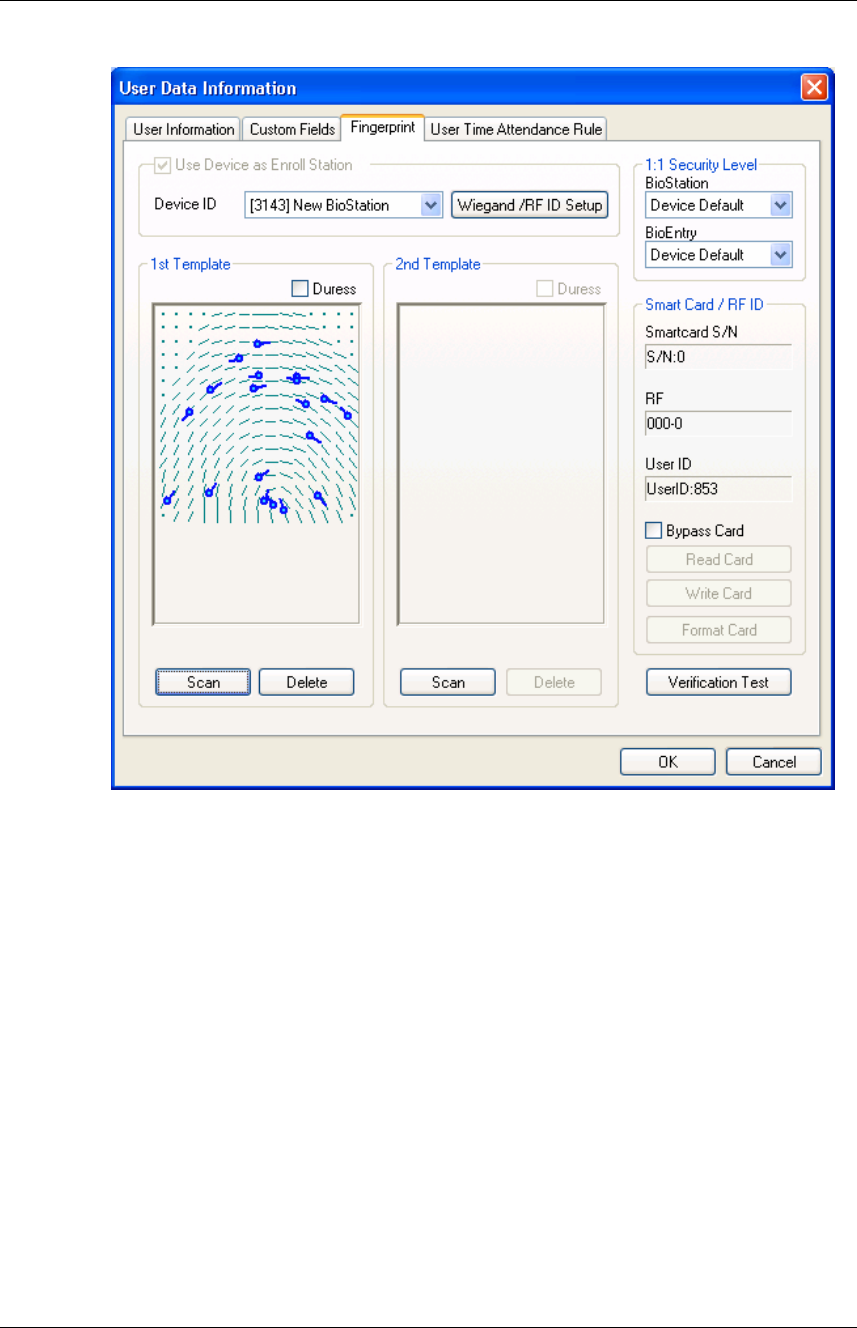
BioAdmin User Manual 96
Copyright © 2006, 2007 by Suprema Inc. http://www.supremainc.com
z Acquire second template similarly to the acquisition of first template.
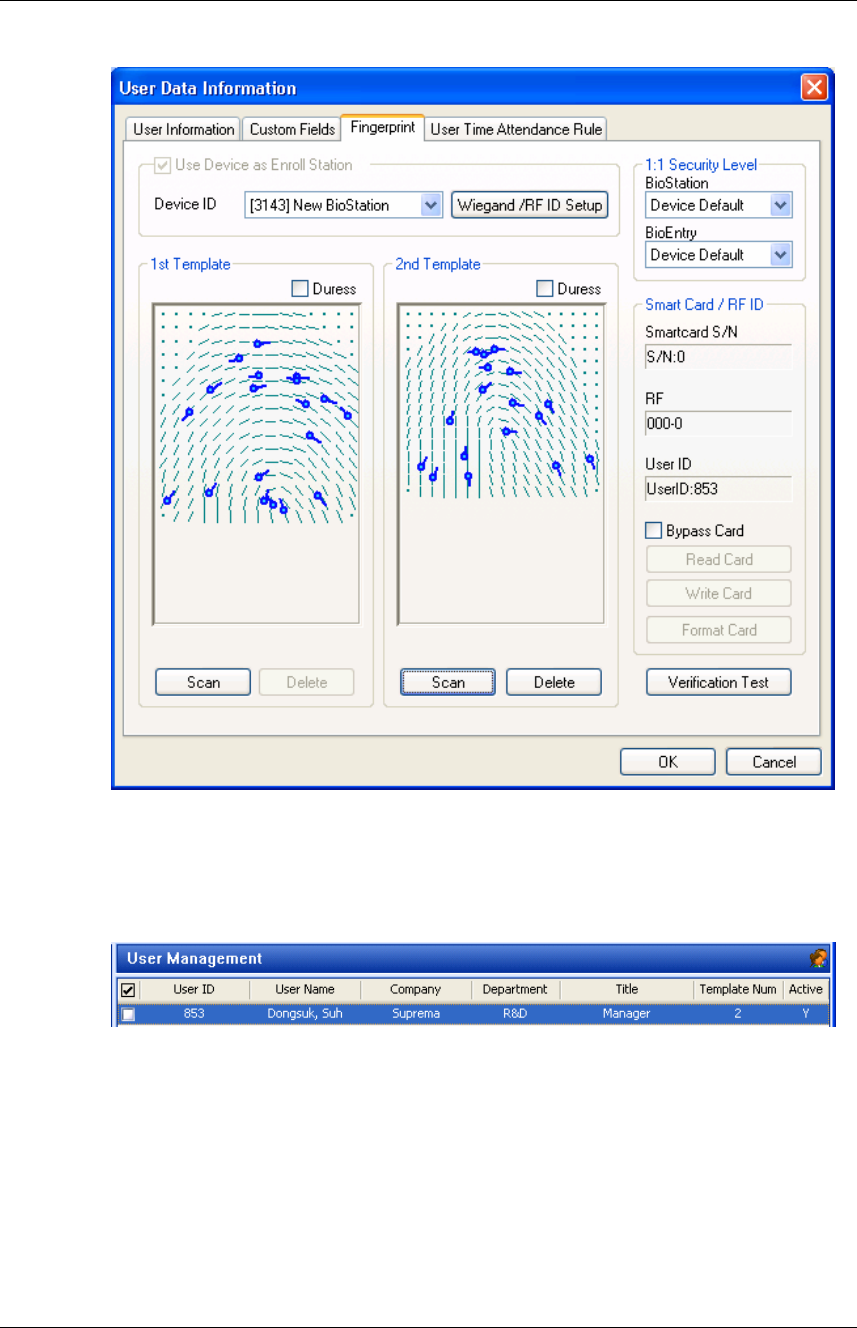
BioAdmin User Manual 97
Copyright © 2006, 2007 by Suprema Inc. http://www.supremainc.com
z Press the OK button to complete the registration process. Then, you can see
the information of the registered user on the user list window. It means that
user’s information is added to the database on host PC.
2.3.3. Step 3: Issuing user smart card
z Double click the registered user on the user list. Then, the user information
window appears showing the registered information of the user.
z Click Fingerprint tab on user information window.
z Place a smart card on PC USB smart card device and press Write button.
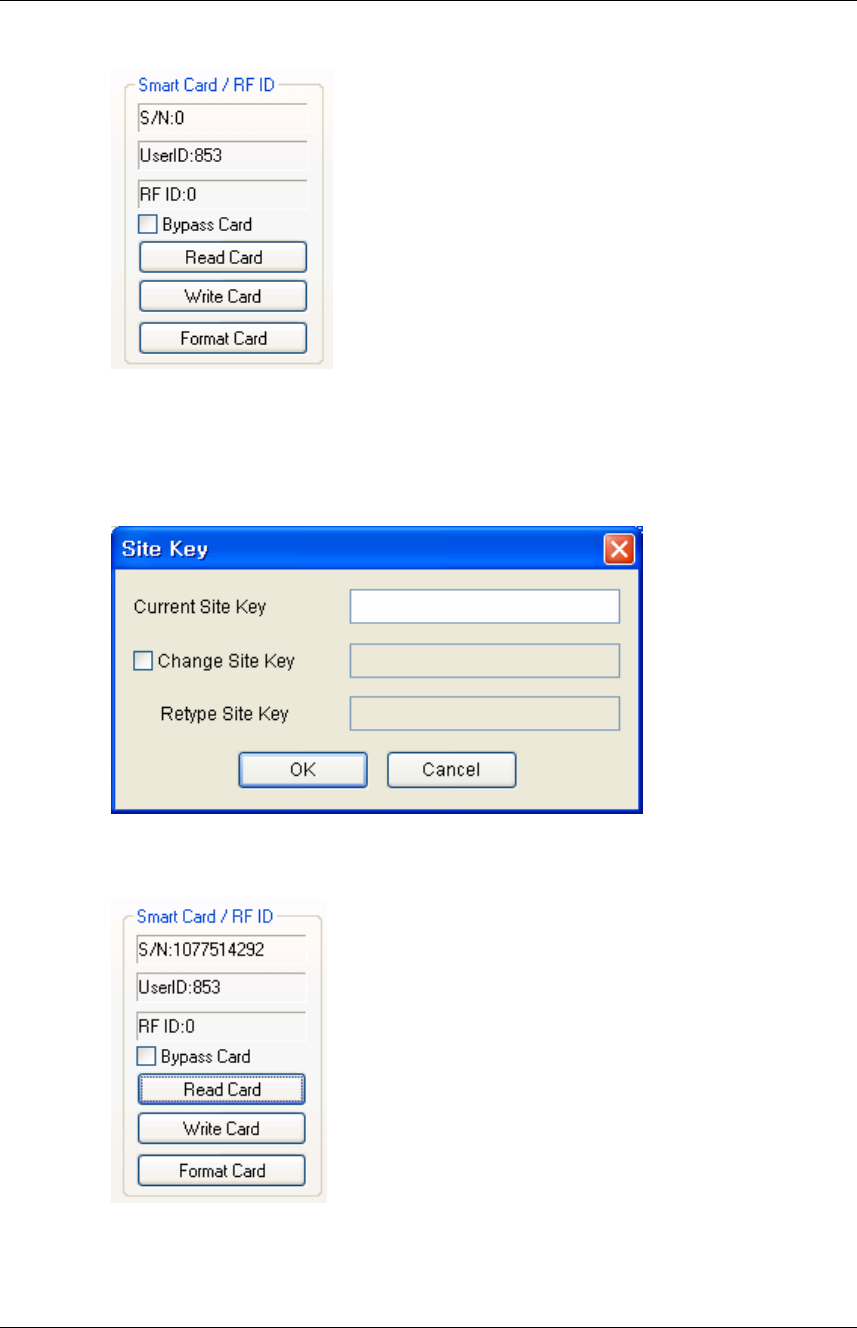
BioAdmin User Manual 98
Copyright © 2006, 2007 by Suprema Inc. http://www.supremainc.com
z At first trial, site key management window appears. If the key input remains
blank, factory default key is used. So, just press OK button to complete issuing
process if the site key was not changed from factory setting.
z On the user list window, you can see the serial number of the smart card.
z Select the Smart Card menu. Then you can see smart card is added on the list.
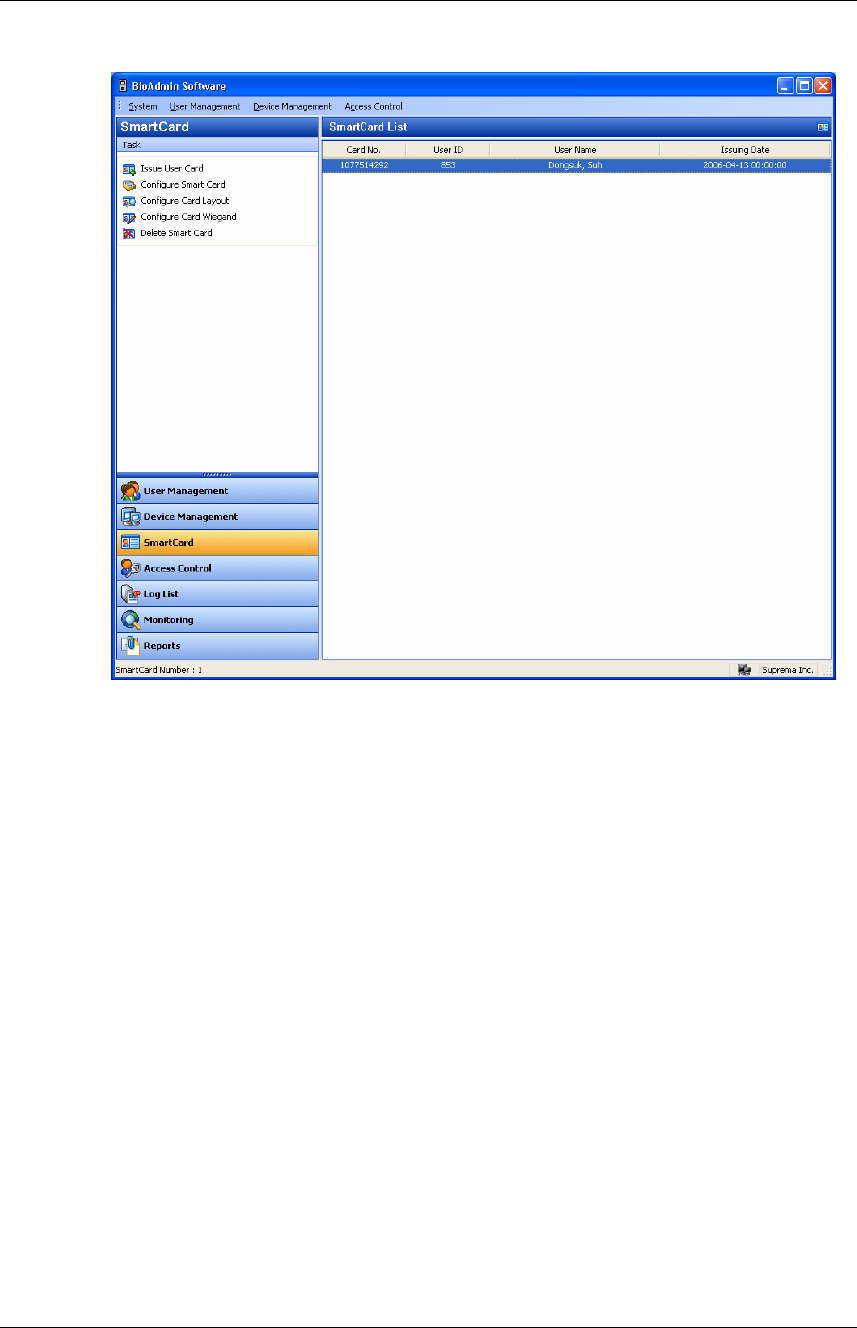
BioAdmin User Manual 99
Copyright © 2006, 2007 by Suprema Inc. http://www.supremainc.com
2.3.4. Step 4: Enroll user ID in the external controller
It is required that the issued user ID is also registered to the controller to grant
access when the Wiegand string for the user is received.
If you are using Suprema’s BEACon controller, you can just skip this additional
registration to the controller.
2.3.5. Step 5: Authentication Test
Procedure to test verification using the user’s smart card is as follows :
z First, place the user’s smart card in front of the device below the sensor. Then,
amber LED blinks rapidly indicating that the device is waiting for finger scan for
verification.
z Place a finger on the sensor. If the user is successfully verified steady green
LED appears with one beep sound. Otherwise, red LED appears with 3 beep
sounds.
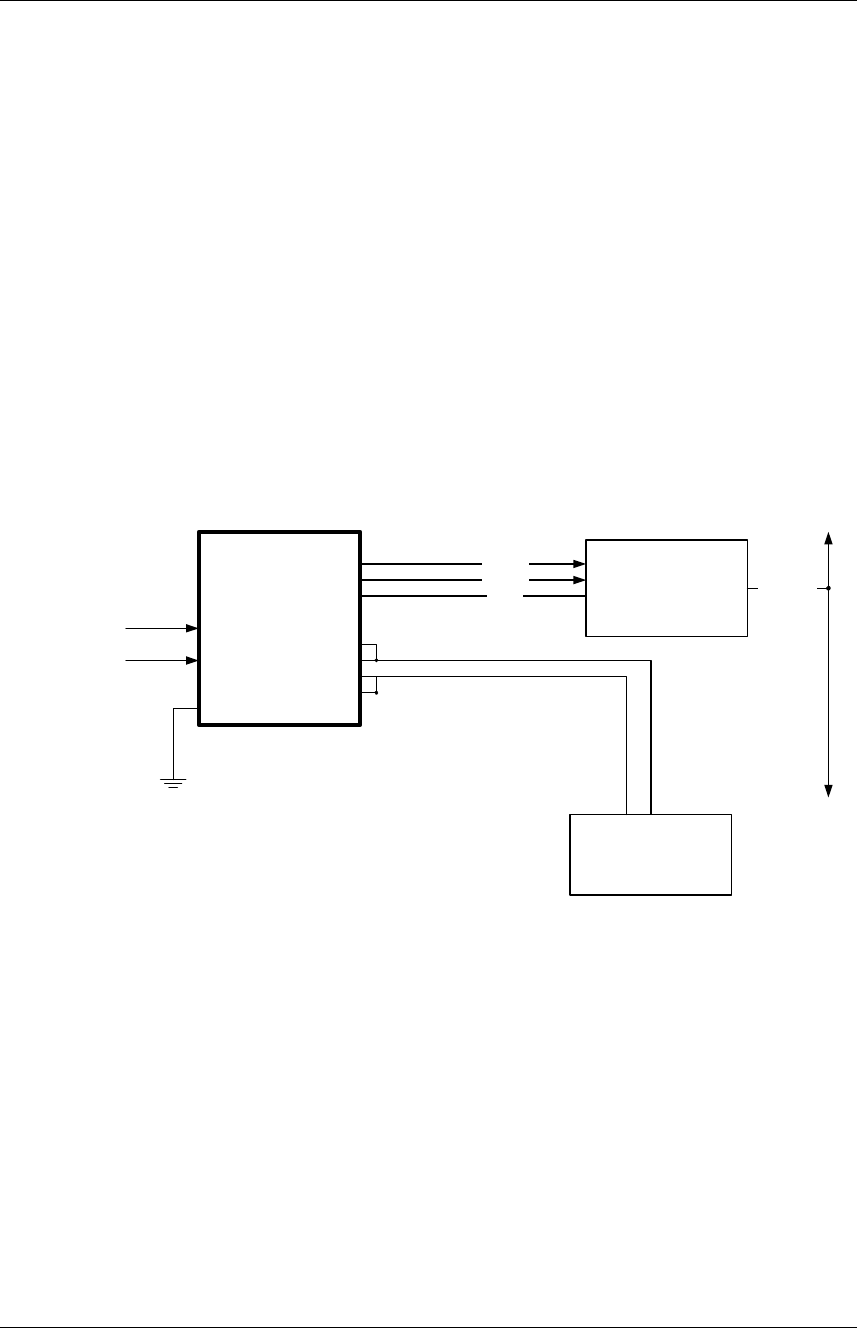
BioAdmin User Manual 100
Copyright © 2006, 2007 by Suprema Inc. http://www.supremainc.com
z On successful verification, the Wiegand string is also sent to the controller,
which can be checked by operation of relay on the controller.
2.4. Quick start with BioEntry Pass
This section describes the basic procedures to operate BioEntry Pass without a
PC device.
2.4.1. Step 1: Hardware installation
In this configuration, the device is connected to an external controller via Wiegand
interface as well as to the host PC through RS485 interface. It is assumed that the
controller supports the standard 26 bit Wiegand format as default of BioEntry
device.
Host PC
Data 1 Access Controller
Data 0
GND Network
To other controllers
or host computer
TRX+TRX-
WO_D0
WO_D1
WO_GND
TX+
RX+
RX-
TX-
EARTH
BioEntry Pass
POW_GND
POW+
9~24Vdc
Wiegand I/F
RS485
For more details on the installation, refer to the BioEntry Installation manual or
BEACon Operation Manual.
2.4.2. Step 2: Search new device
z Run BioAdmin software.
z Enter Login ID and password. By factory default, the initial Login ID is “admin”
and the password is blank
z Select Device Management on the Main menu, then device management
page will appear on the main window.
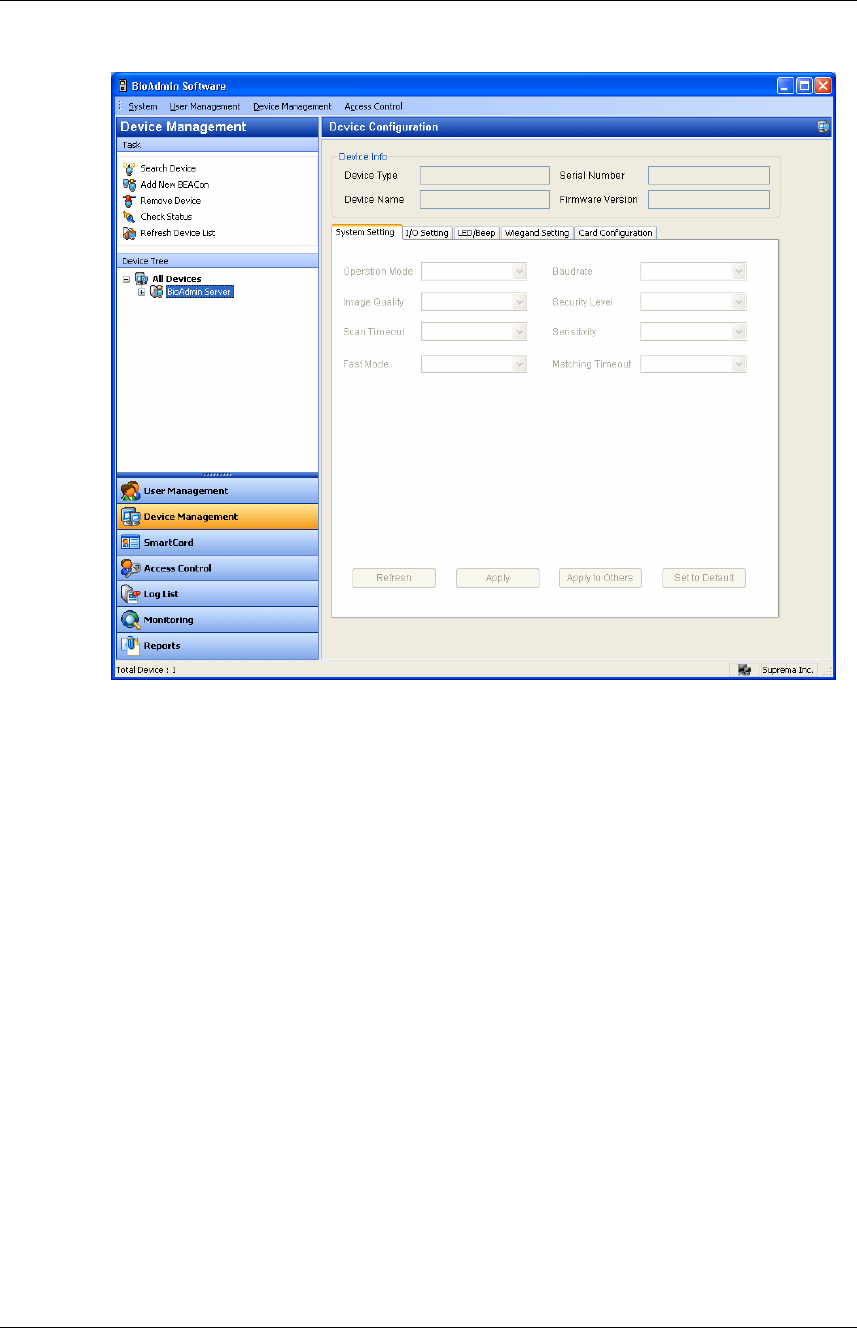
BioAdmin User Manual 101
Copyright © 2006, 2007 by Suprema Inc. http://www.supremainc.com
z Select Search Device menu, click Search BioEntry, select either serial port or
TCP/PI and then press search button. If device is found as a result of search,
result report reading ‘--- device(s) found’ is shown. Press OK button to select
device.
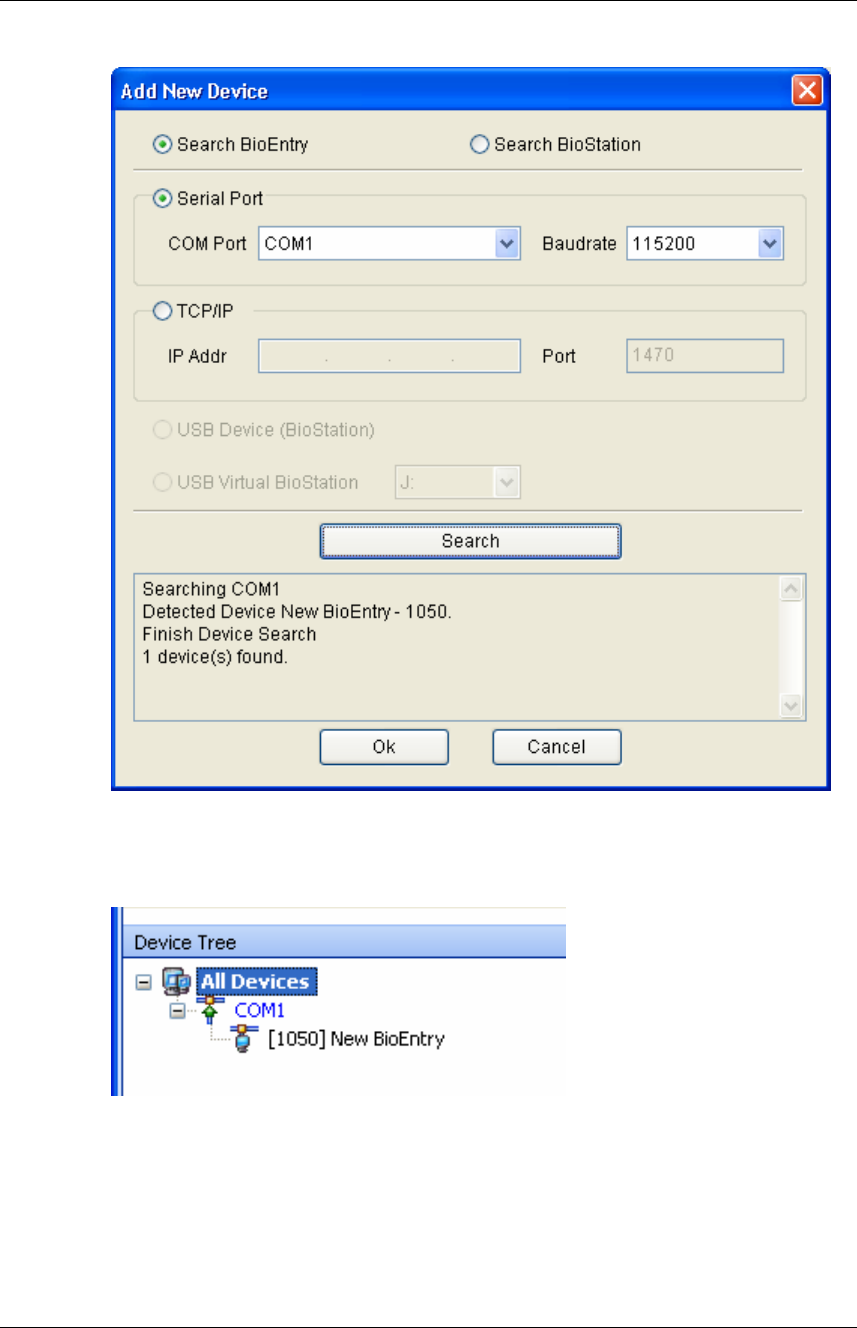
BioAdmin User Manual 102
Copyright © 2006, 2007 by Suprema Inc. http://www.supremainc.com
z If the devices are connected properly, new device ID appears on the Device
Tree window.
z Select User Management button on main menu and select Manage users in
device on task window.
z Once device is selected, fingerprint information such as user ID, number of
fingerprint, access group, security level and Check (to select) is displayed.
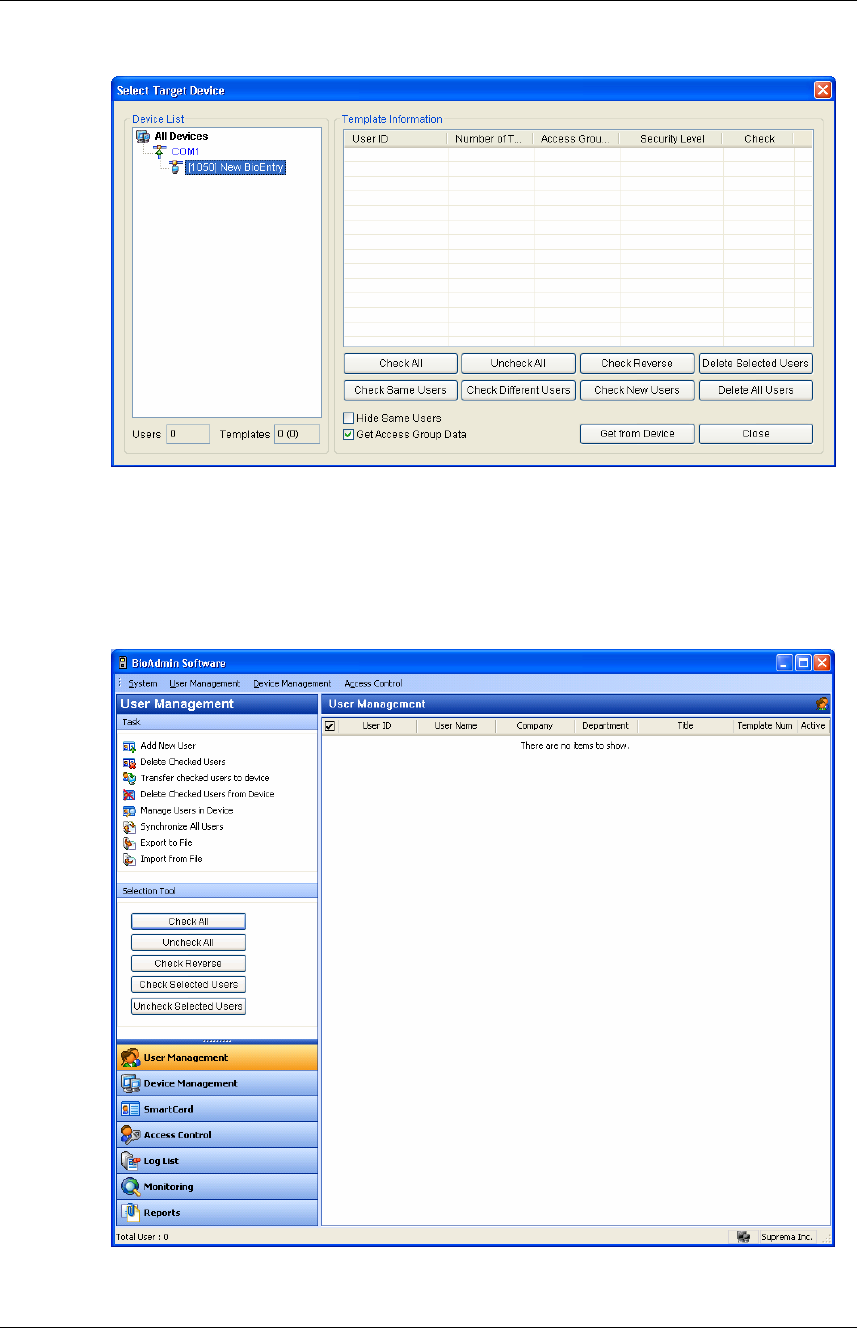
BioAdmin User Manual 103
Copyright © 2006, 2007 by Suprema Inc. http://www.supremainc.com
2.4.3. Step 3: Enroll user
z Select the User Management menu, then the user management page
appears on the main window
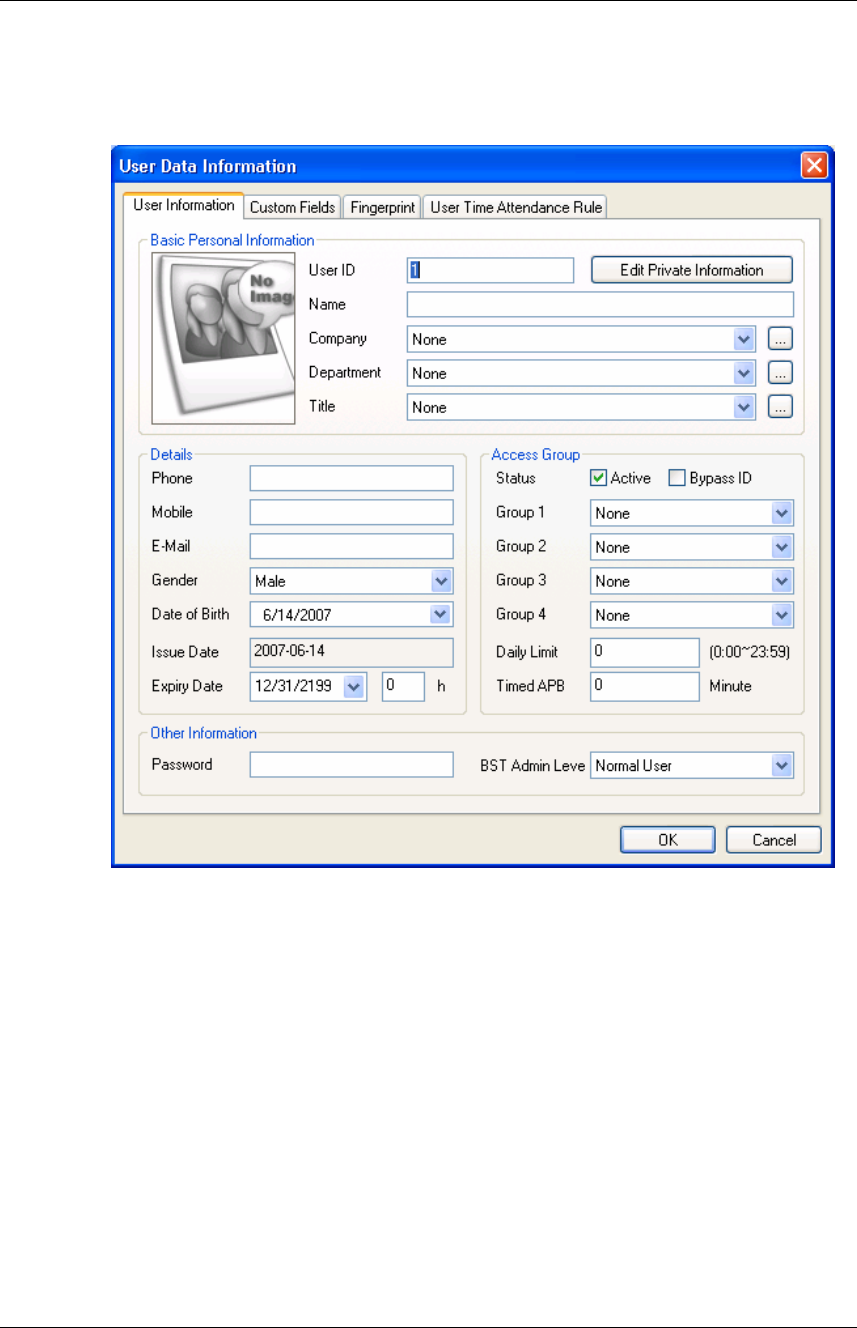
BioAdmin User Manual 104
Copyright © 2006, 2007 by Suprema Inc. http://www.supremainc.com
z Select the Add New User menu on the task window, and then the pop-up
window appears.
z Enter the user information on the User Information tab.
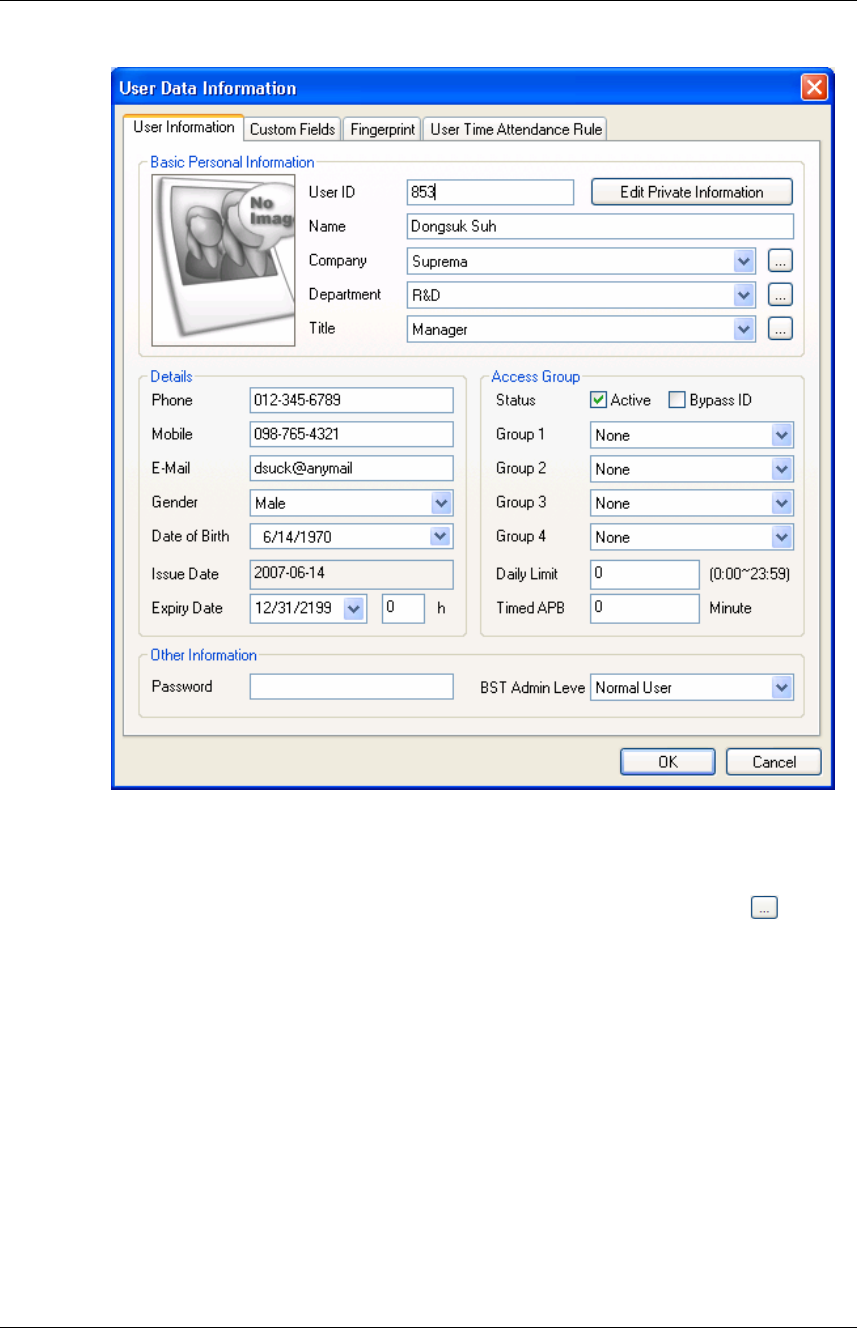
BioAdmin User Manual 105
Copyright © 2006, 2007 by Suprema Inc. http://www.supremainc.com
z Especially, you can select the Company, Department, and Title on the drag
down menu.
z To add new Company, Department, or Title information, press the button.
After entering the required information, press the Add button. Press the Save
button to save the added information.
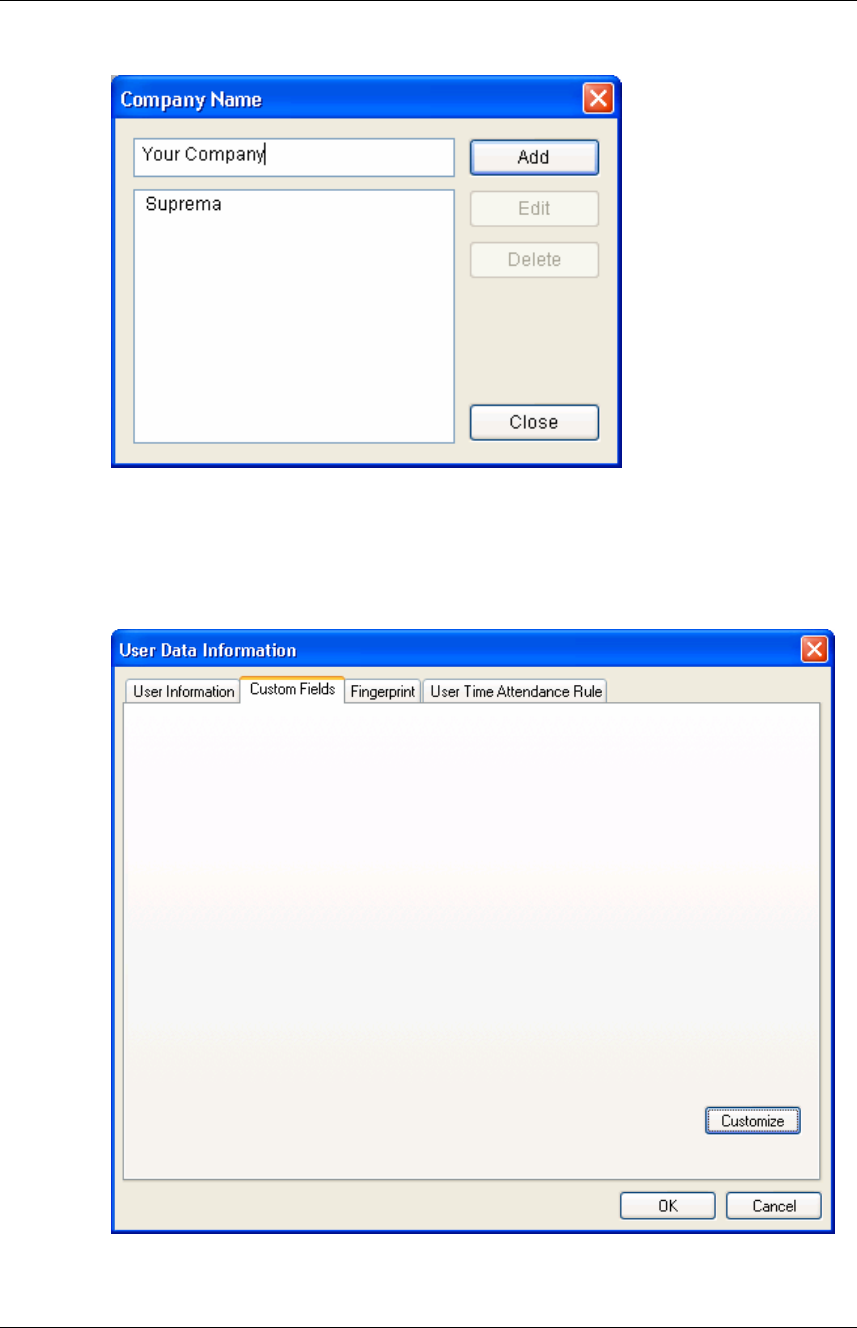
BioAdmin User Manual 106
Copyright © 2006, 2007 by Suprema Inc. http://www.supremainc.com
z In addition to the basic user information, you can add the Custom Fields to the
user information. If you do not need these custom fields, just skip the custom
fields setting. To set up the custom fields, press the Custom Fields tab.
z Click the Customize... button.
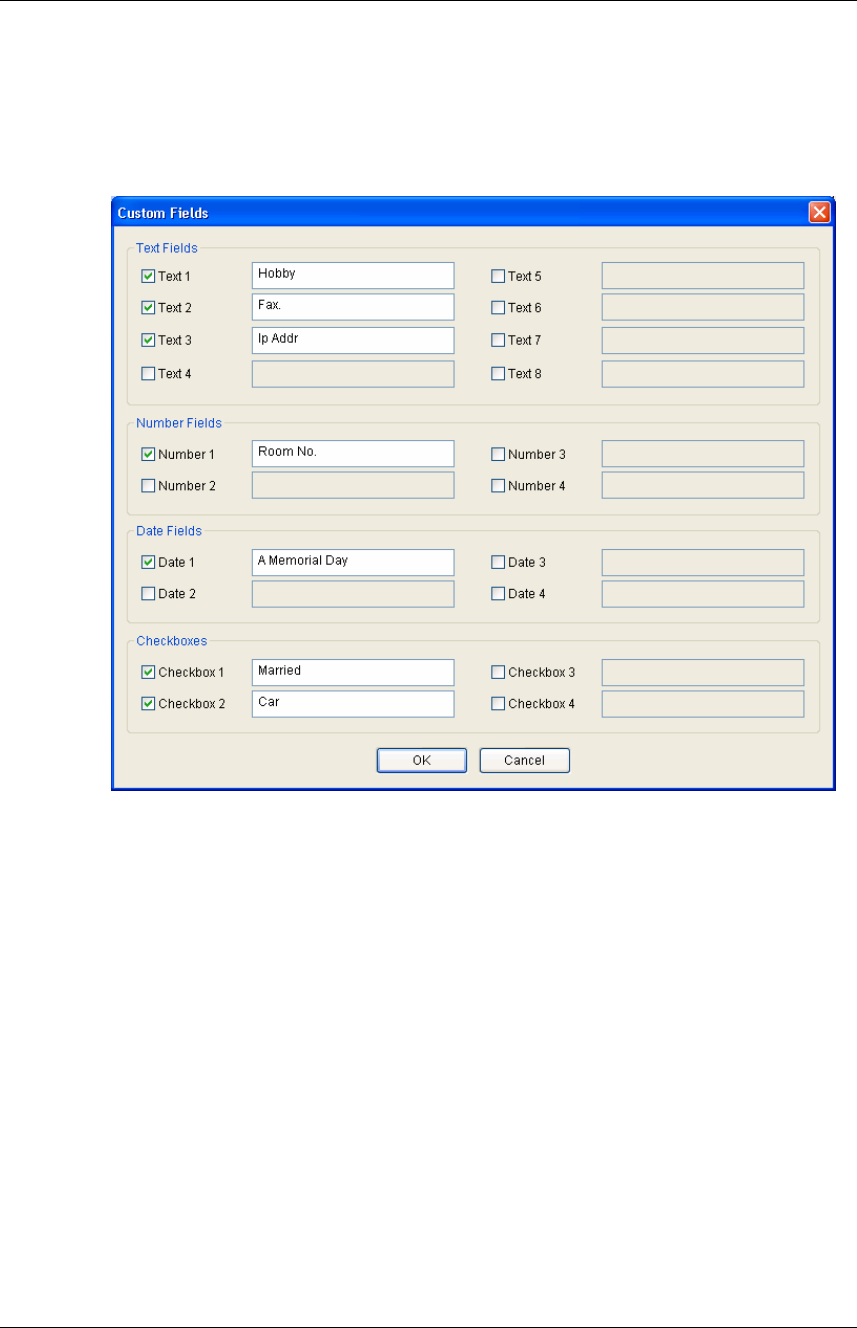
BioAdmin User Manual 107
Copyright © 2006, 2007 by Suprema Inc. http://www.supremainc.com
z Check on the required fields and enter the user information for those selected
fields.
z After entering the user information, press the OK button.
z After filling out the custom fields, following the pop-up window will appear. On
this window, you can see the detail of your selected custom fields. Press the
OK button to save these custom fields.
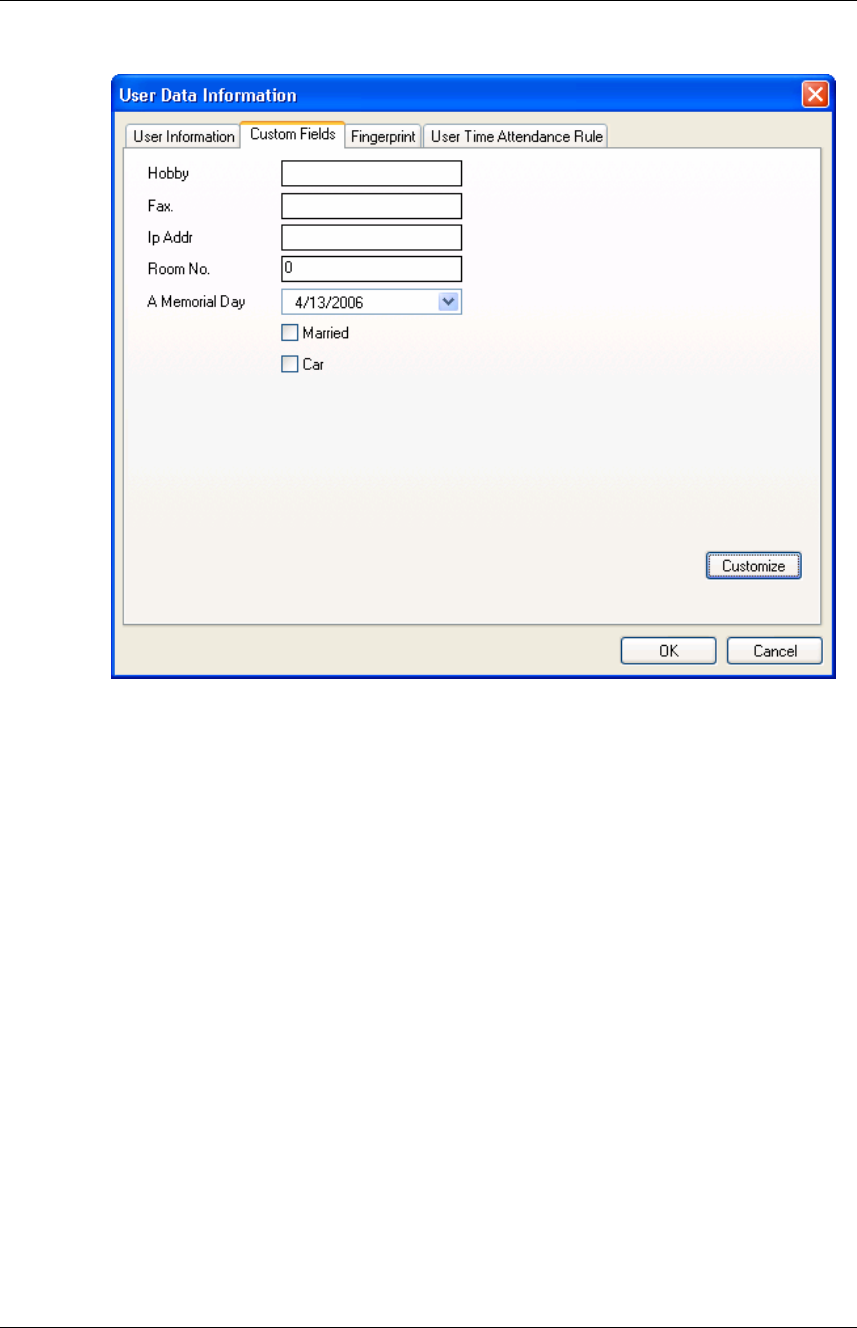
BioAdmin User Manual 108
Copyright © 2006, 2007 by Suprema Inc. http://www.supremainc.com
z After entering the user information, press the Fingerprint tab to enroll user’s
fingerprint templates.
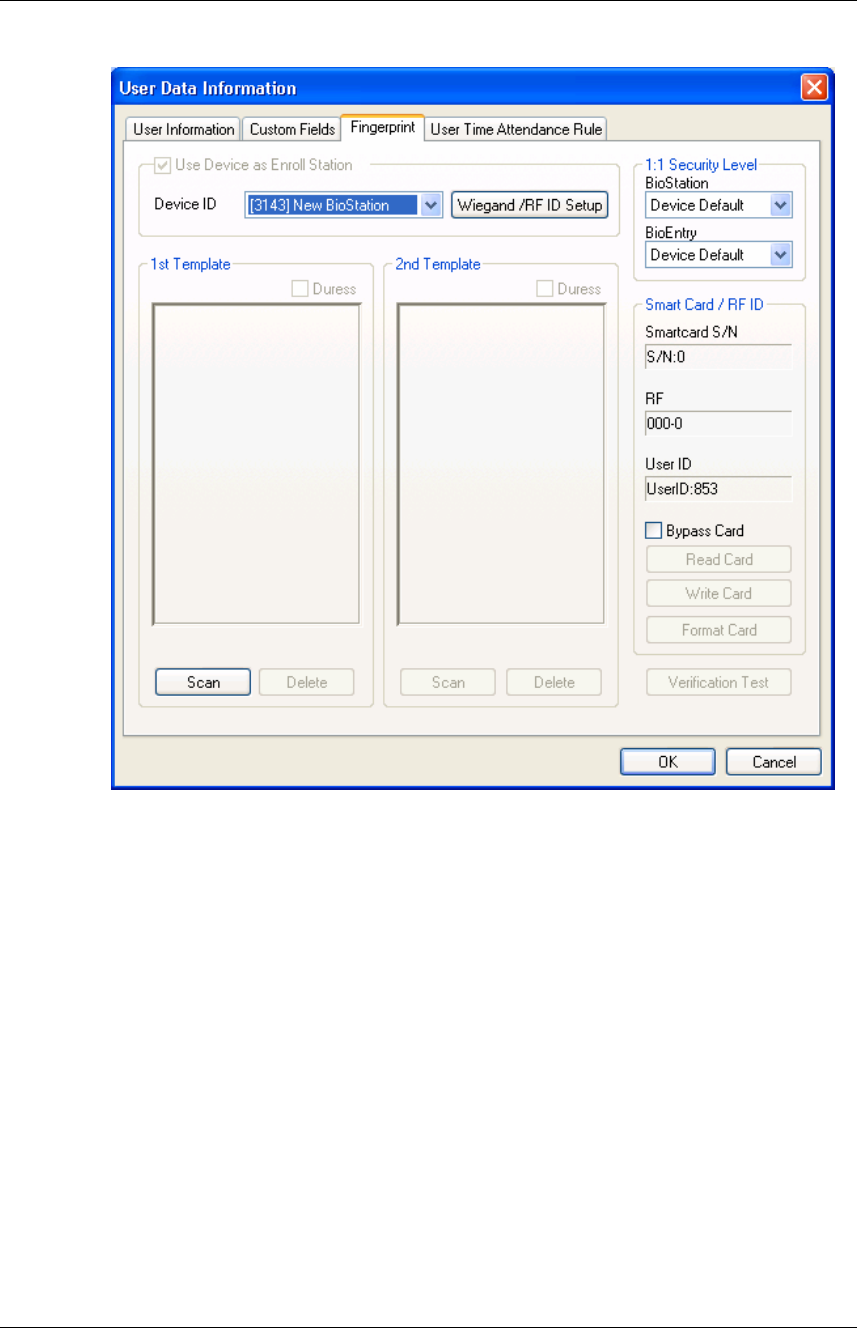
BioAdmin User Manual 109
Copyright © 2006, 2007 by Suprema Inc. http://www.supremainc.com
z Acquire first template by pressing the Scan button followed by touching a finger
on the USB fingerprint scanner twice.
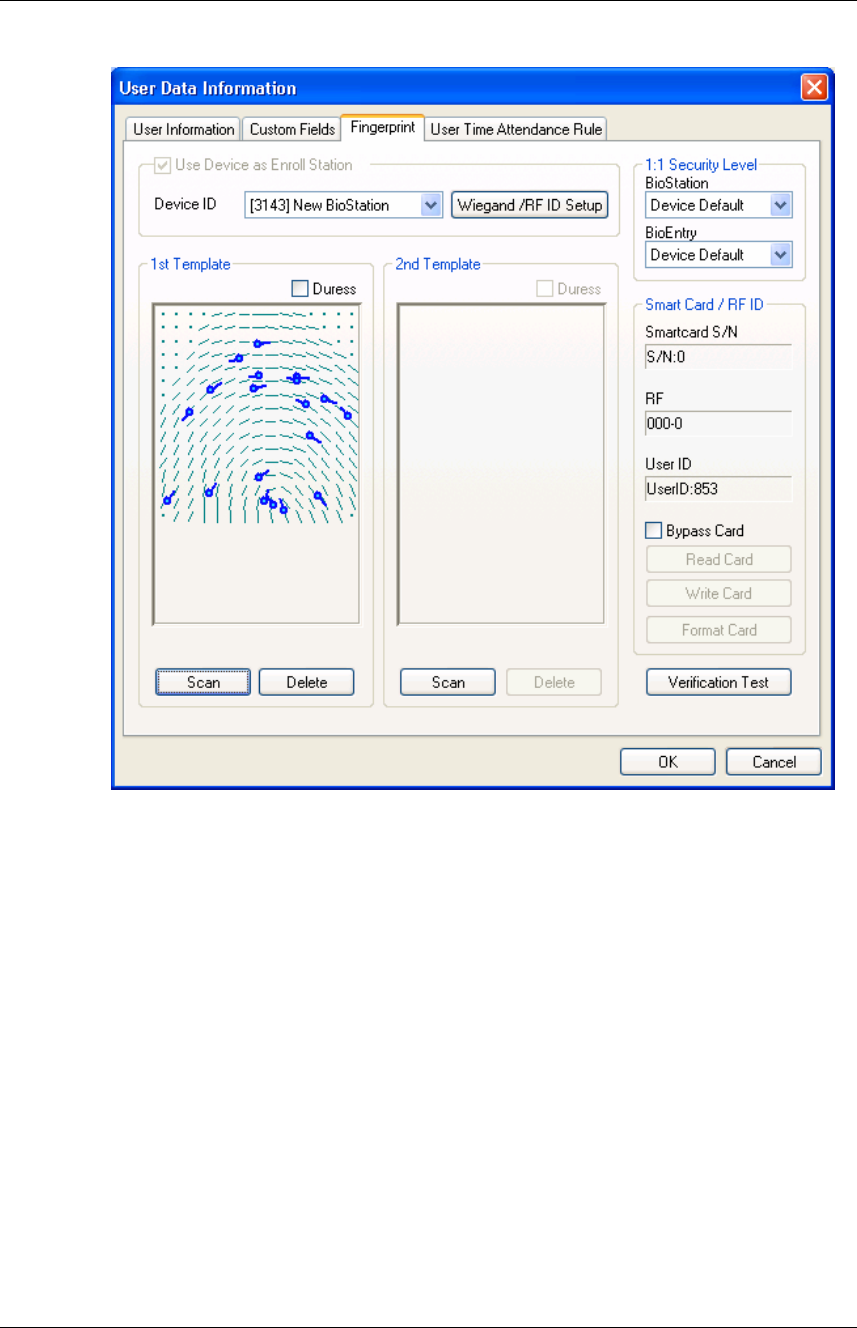
BioAdmin User Manual 110
Copyright © 2006, 2007 by Suprema Inc. http://www.supremainc.com
z Acquire second template similarly to the acquisition of first template.
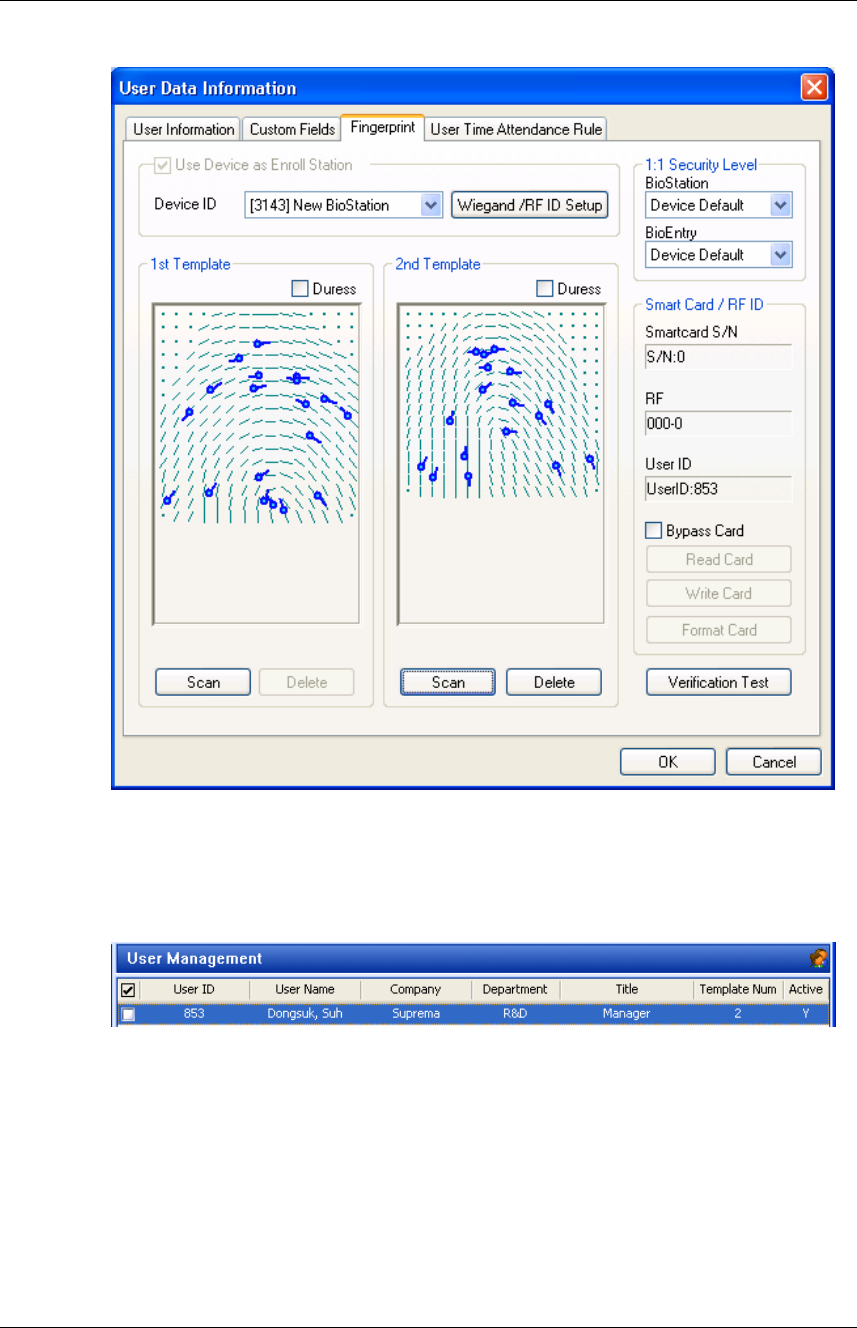
BioAdmin User Manual 111
Copyright © 2006, 2007 by Suprema Inc. http://www.supremainc.com
z Press the OK button to complete the registration process. Then, you can see
the information on the registered user on the user list window. It means that the
user’s information is added to the database on host PC.
2.4.4. Step 4: Enroll user with ‘transfer checked user to device’ menu.
Transfer to Device is used to transfer the user database of the host PC to
BioEntry™ devices. The user information such as User ID, templates, access
group, and security level is transferred by this process.
z Check the registered user to transfer
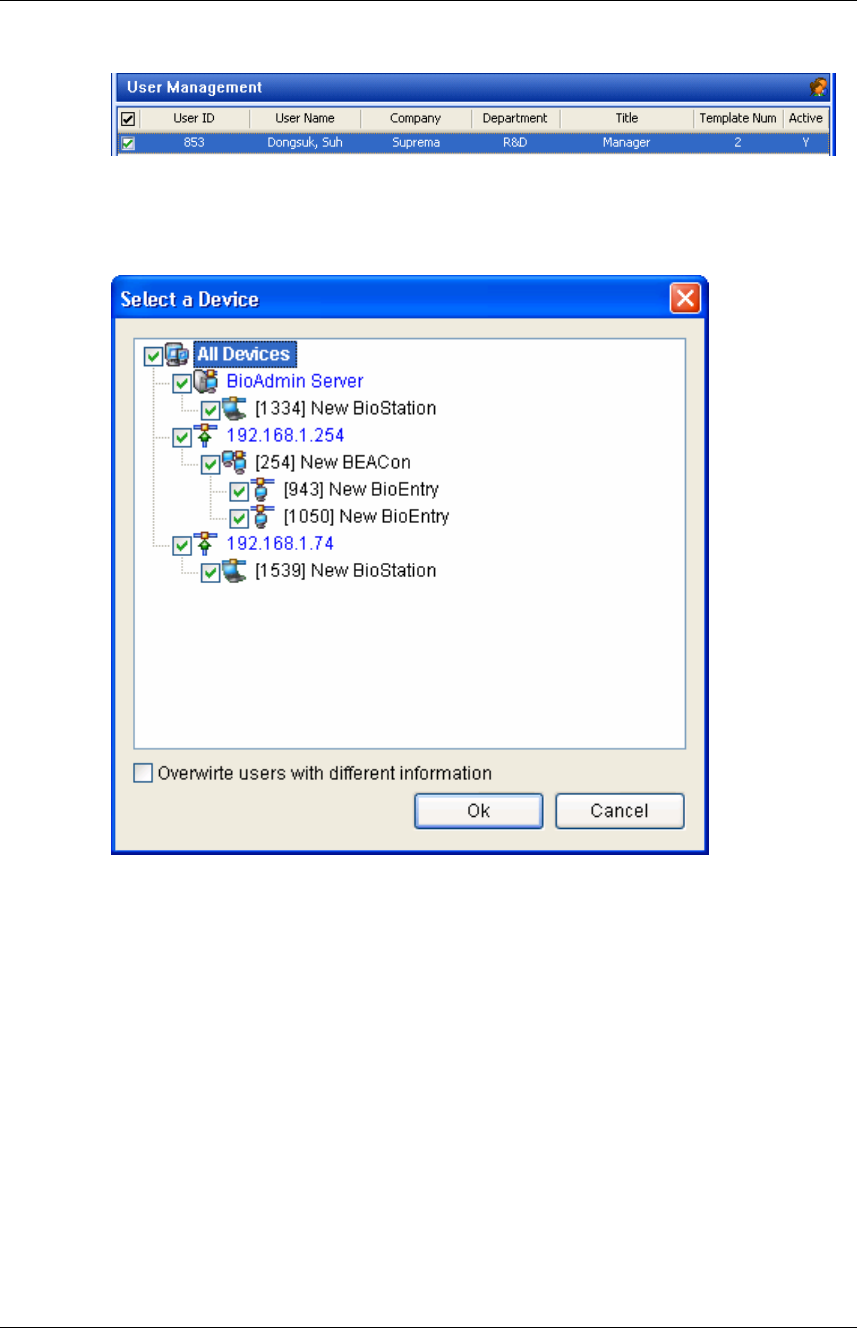
BioAdmin User Manual 112
Copyright © 2006, 2007 by Suprema Inc. http://www.supremainc.com
z Select the Transfer Checked Users to Device button and select the devices to
transfer the user data.
z Select the Manage Users in Device button to see the user list enrolled in the
selected device. If the color of user data is yellow, it means the user data has
been successfully transferred to the device.
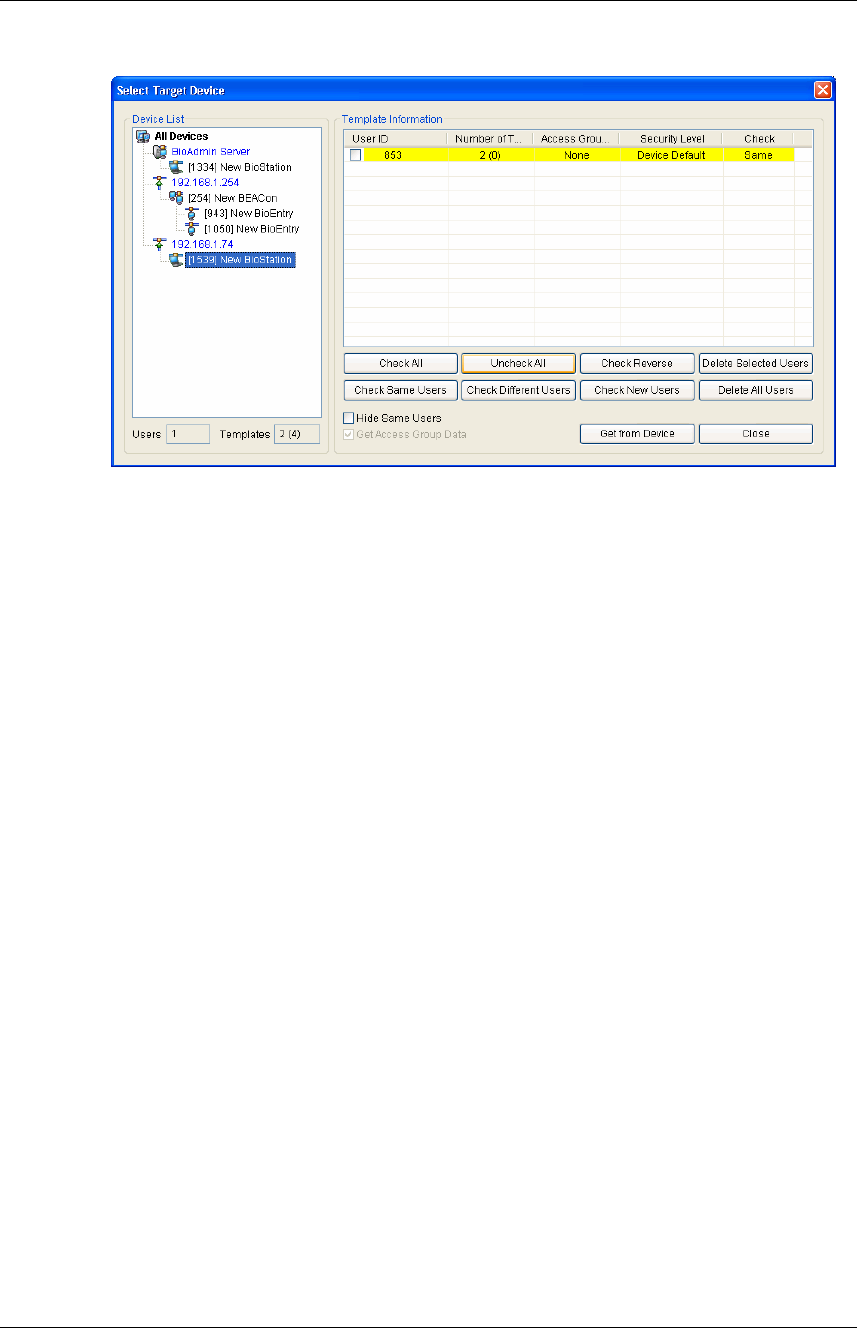
BioAdmin User Manual 113
Copyright © 2006, 2007 by Suprema Inc. http://www.supremainc.com
2.4.5. Step 5: Enroll user ID in the external controller
It is required that the issued user ID is also registered to the external controller to
grant access when the Wiegand string for the user is received.
If you are using Suprema’s BEACon controller, you can just skip this additional
registration to the controller.
2.4.6. Step 6: Authentication test
z Amber LED on the device blinks slowly indicating that the device is waiting for
finger scan for identification.
z Swipe finger on the sensor. If the user is successfully identified steady green
LED appears with one beep sound. Otherwise, red LED appears with 3 beep
sounds.
z On successful identification, the Wiegand string is also sent to the controller,
which can be checked by operation of relay on the controller.
2.4.7. Step 7: Monitoring
Select Start Monitoring menu to start the real-time monitoring on all of the
connected BioEntry devices.
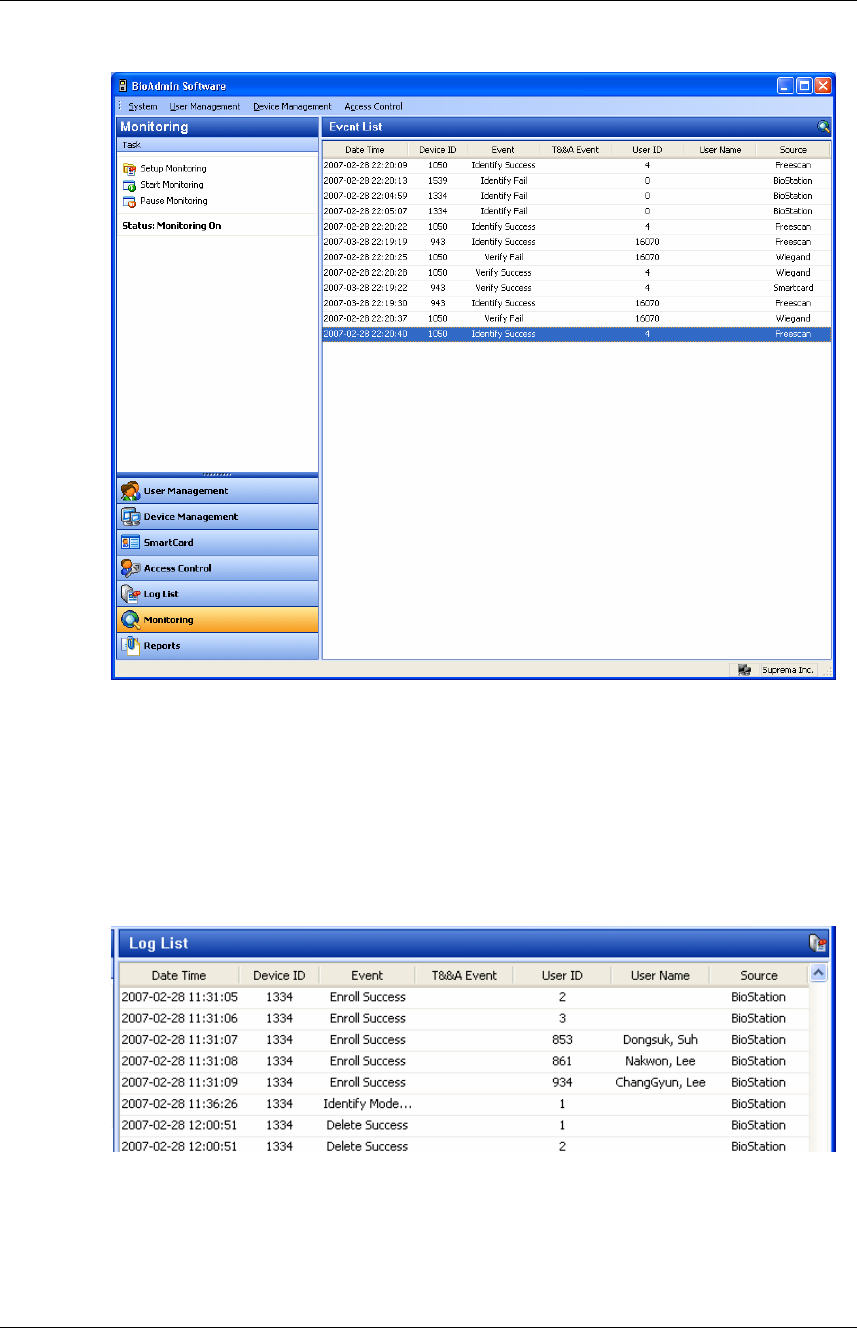
BioAdmin User Manual 114
Copyright © 2006, 2007 by Suprema Inc. http://www.supremainc.com
2.4.8. Step 8 : Check log
z Select the Reports menu. Then, the report list window appears on the main
window.
z Select the Get Recent Logs / Auto Upload button to see the updated event
log data added to the existing log list of BioAdmin.

BioAdmin User Manual 115
Copyright © 2006, 2007 by Suprema Inc. http://www.supremainc.com
3. User Management
User management covers the following operations:
z Add new user
z Delete checked user
z Transfer checked user to device
z Delete checked user from device
z Manage users in device
z Synchronize all users
z Export to file
z Upload from file
3.1. Configuration of user management page
By selecting User Management menu, user management page is updated on the
main window.
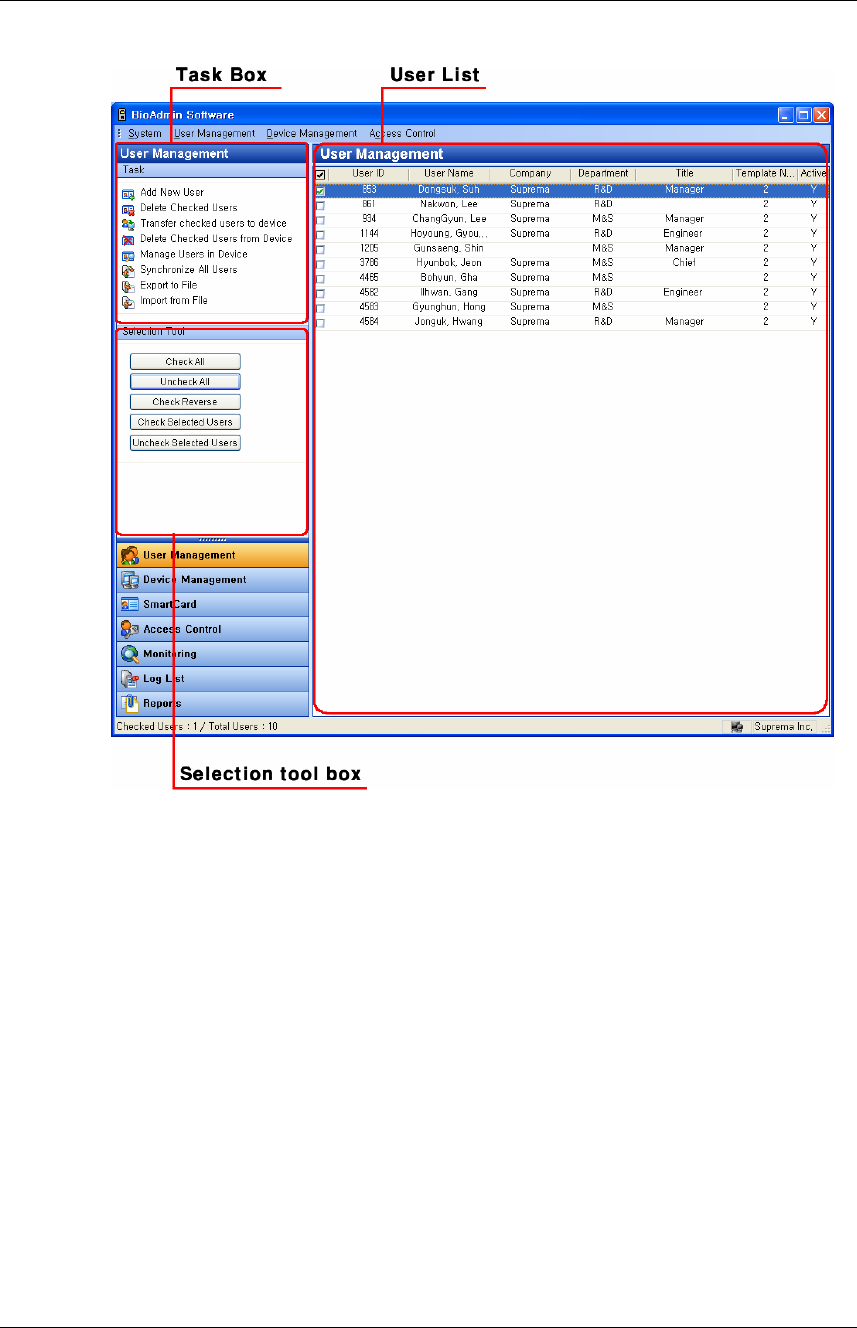
BioAdmin User Manual 116
Copyright © 2006, 2007 by Suprema Inc. http://www.supremainc.com
The user management page is divided into 3 sectors:
z User List
The user database is under central management on host PC. The user
management page includes detailed list of user database and summarized
information.
z Selection tool box
Selection tool box includes buttons to select users.
z Task box
Task box includes buttons to control basic operations of the user management
page.
3.2. User List window
User list includes the following information on the users.
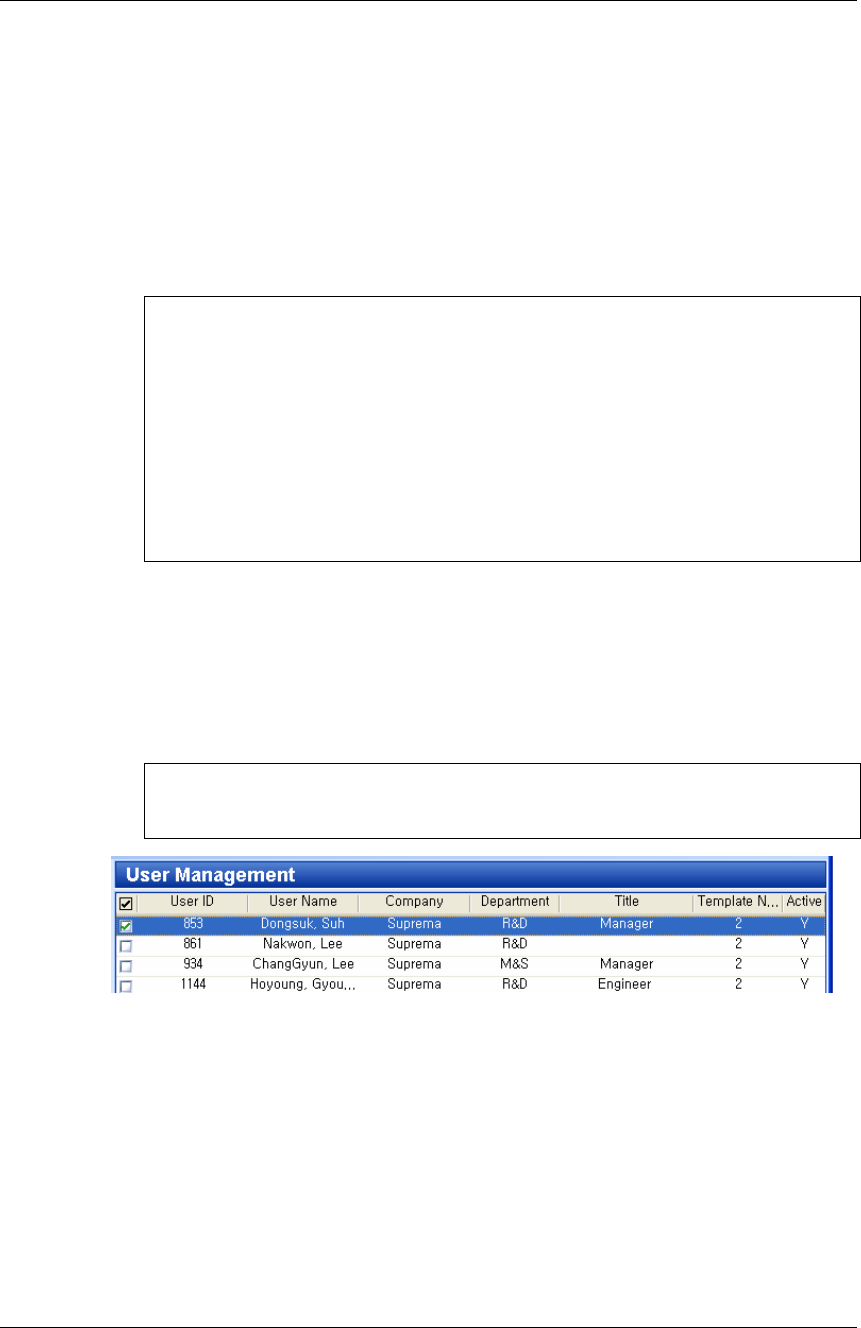
BioAdmin User Manual 117
Copyright © 2006, 2007 by Suprema Inc. http://www.supremainc.com
z Shows basic information such as user ID, name, company, dept., position title,
number of enrolled fingerprint and status.
z Double click user ID to pop up user information window. User information has 4
tabs, i.e. User information, custom field, fingerprint, and user time attendance
rule.
z Fingerprint templates ( fingerprint image is never stored )
Note : What is activation in access group setting? It is used when transferring
user data in host PC to device. If activation is not on (checked) upon
transferring checked in user list to device, user data can’t be transferred and
data in device is deleted.
For instance, when one returns to work after having been excluded from
access group and inactive due to dispatch or long term leave, activate him/her
and manage user list.
3.3. User List Display Setting
You can customize the display of the user list.
Detailed operations are as follows.
z Press the right button of your mouse on the column header of User List.
Note : What is “Column Header”? It is on the head of row (user ID, name,
company, dept.) on user list window.
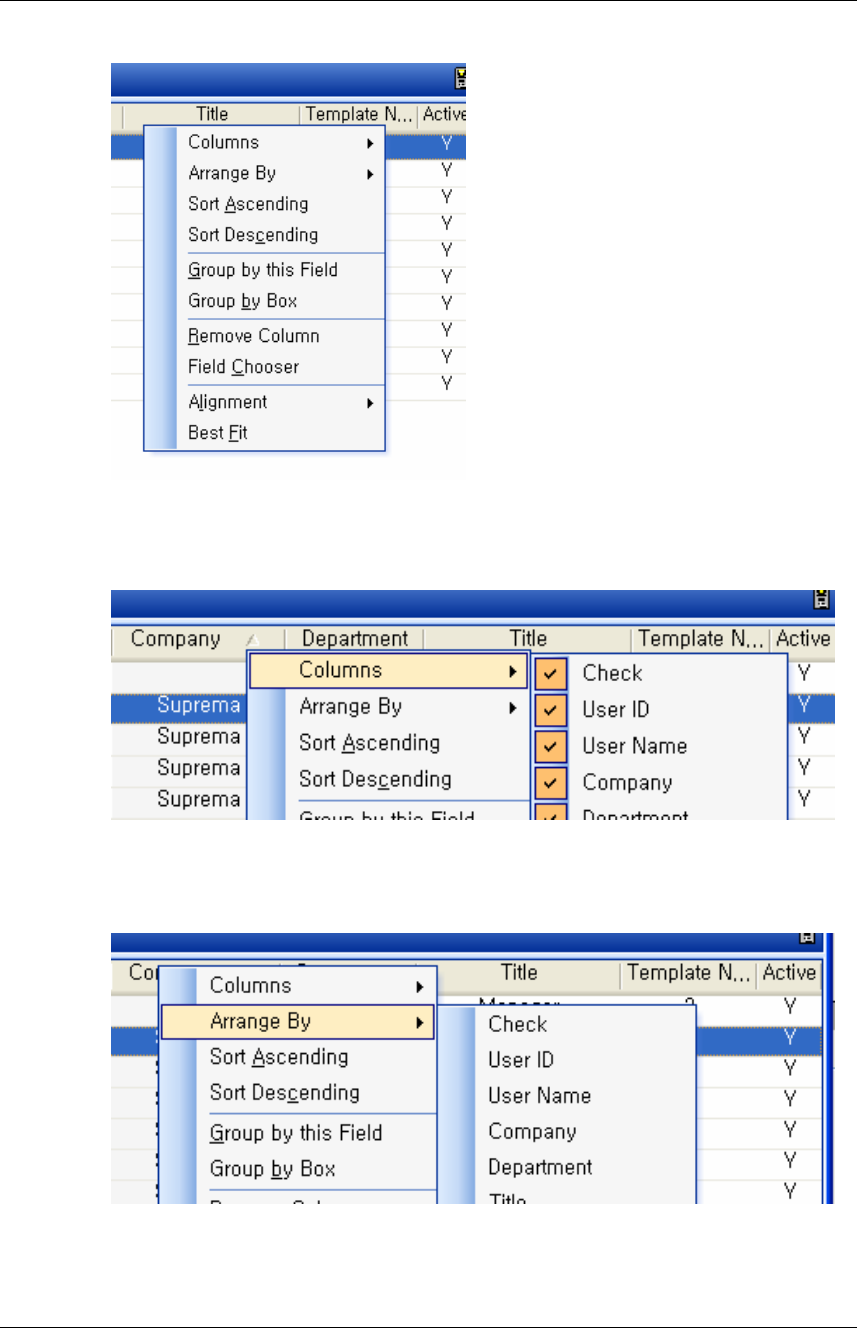
BioAdmin User Manual 118
Copyright © 2006, 2007 by Suprema Inc. http://www.supremainc.com
z Press the Columns button and check on your required columns to show them
on the user list.
z Press the Arrange By button and select your required columns to array the
user list by your selected column.
z Press the Sort Ascending button to array the user list in ascending order.
z Press the Sort Descending button to array the user list in descending order.
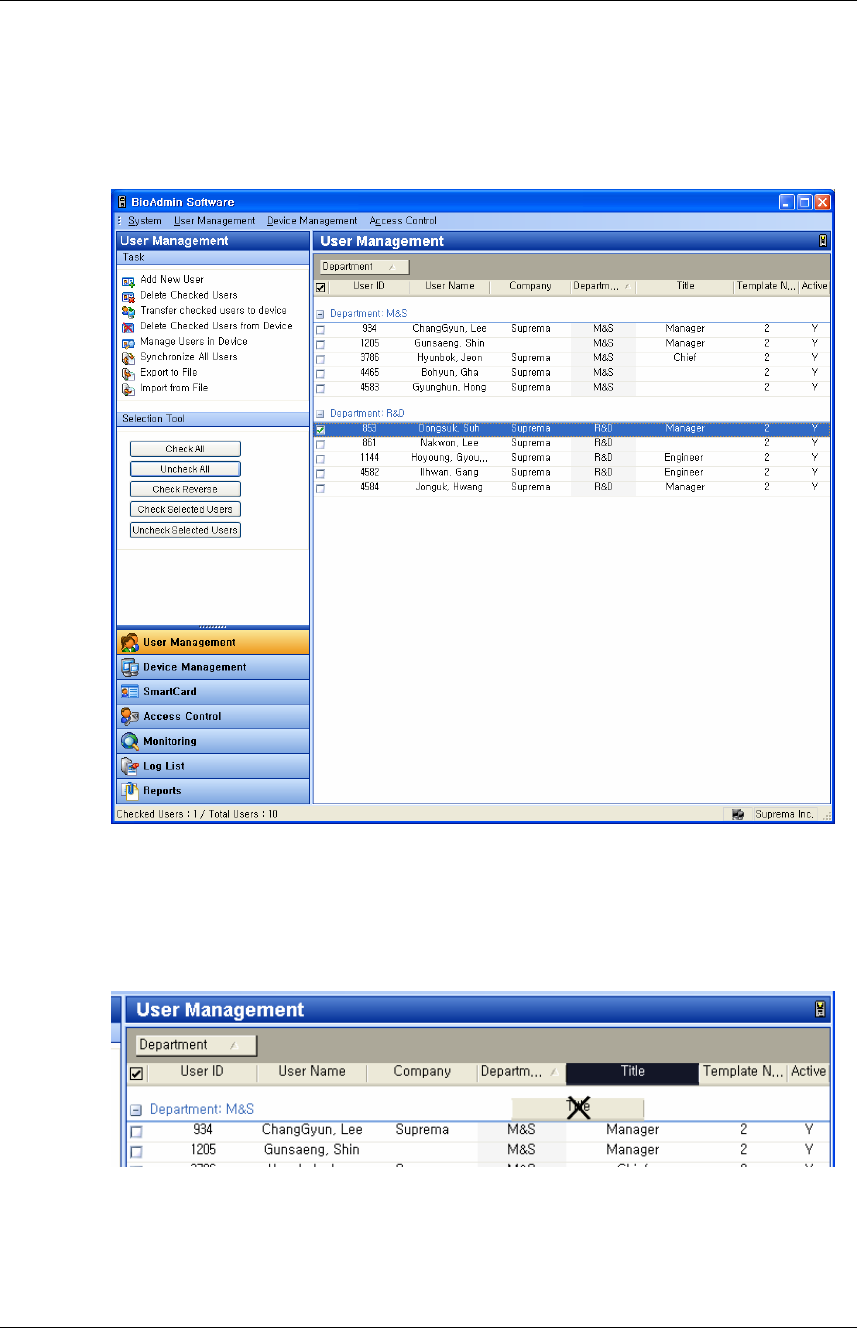
BioAdmin User Manual 119
Copyright © 2006, 2007 by Suprema Inc. http://www.supremainc.com
z Press the Group by this field button and Group by box button to manage the
user list as a group by your required columns. Also, you can add a column to
the group simply by dragging up the column to the header box.
z Press the Remove Column button to remove a column from the header. Also,
you can remove a column simply by dragging down the column from the
column header.
z Press the Alignment button to array the content in your preferred way.
z Press the Best Fit button to optimize the width of a column.
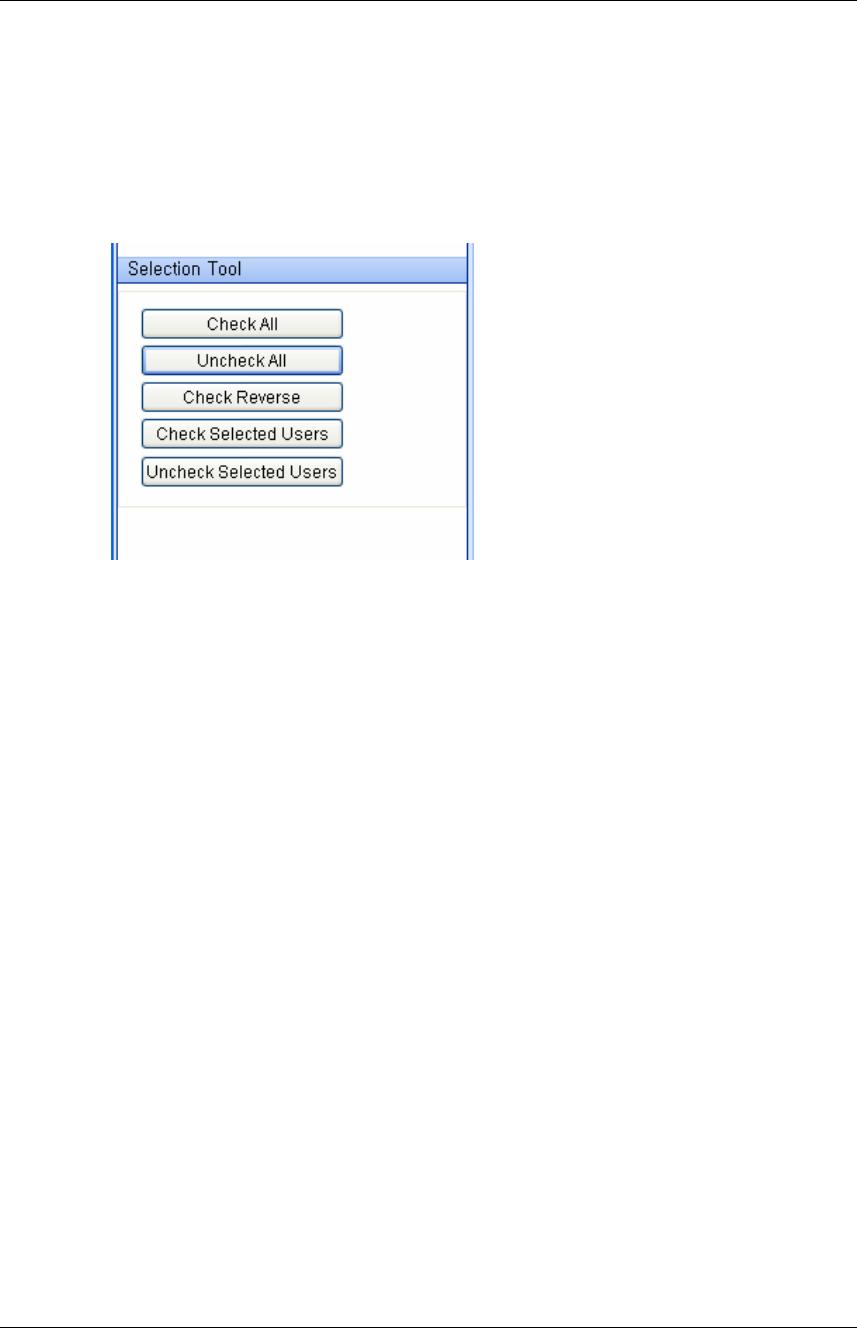
BioAdmin User Manual 120
Copyright © 2006, 2007 by Suprema Inc. http://www.supremainc.com
3.4. Select user
Users can be chosen for selective processing of operations, such as transfer,
removal, or exportation. You can select the required user simply by using the check
box on the user list,
z Check All : Check all users
z Uncheck All : Uncheck all users
z Check Reverse : Check all users except the users who were originally checked
z Check Selected Users : Check the selected users
z Uncheck Selected Users : Uncheck the selected users
3.5. Add New User
The Add New User button enables the pop-up window to register user data on
host PC.
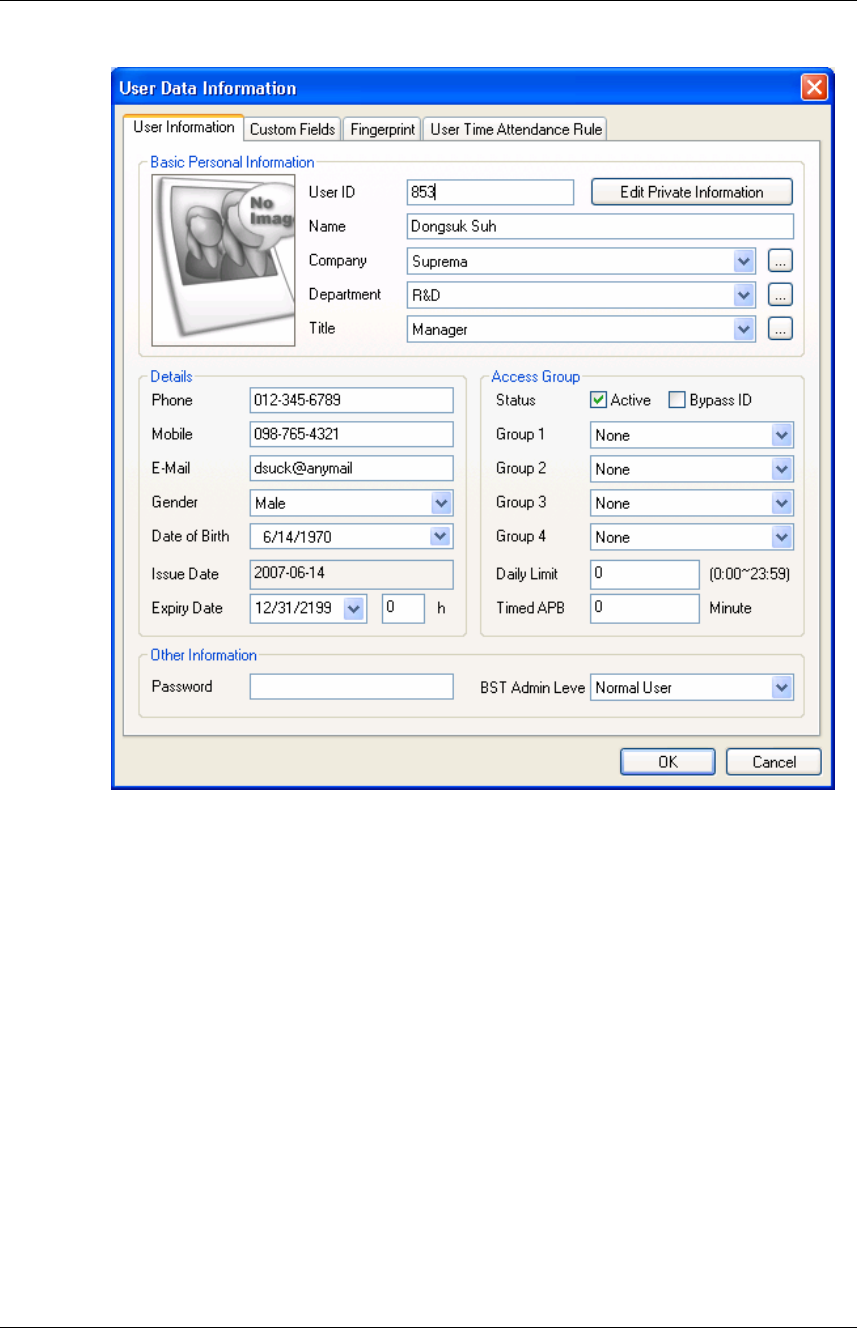
BioAdmin User Manual 121
Copyright © 2006, 2007 by Suprema Inc. http://www.supremainc.com
3.5.1. User information
z In user information, you can enter basic personal information, details
information, access group, other information, and additional information for
BioStation. In basic personal information, enter user ID, name, company, dept.
and title. For details, enter telephone number, mobile phone number, email,
gender, and date of birth. Make sure to check ‘Active’ in access group.
Otherwise, database in device will be deleted.
z Edit Private Information
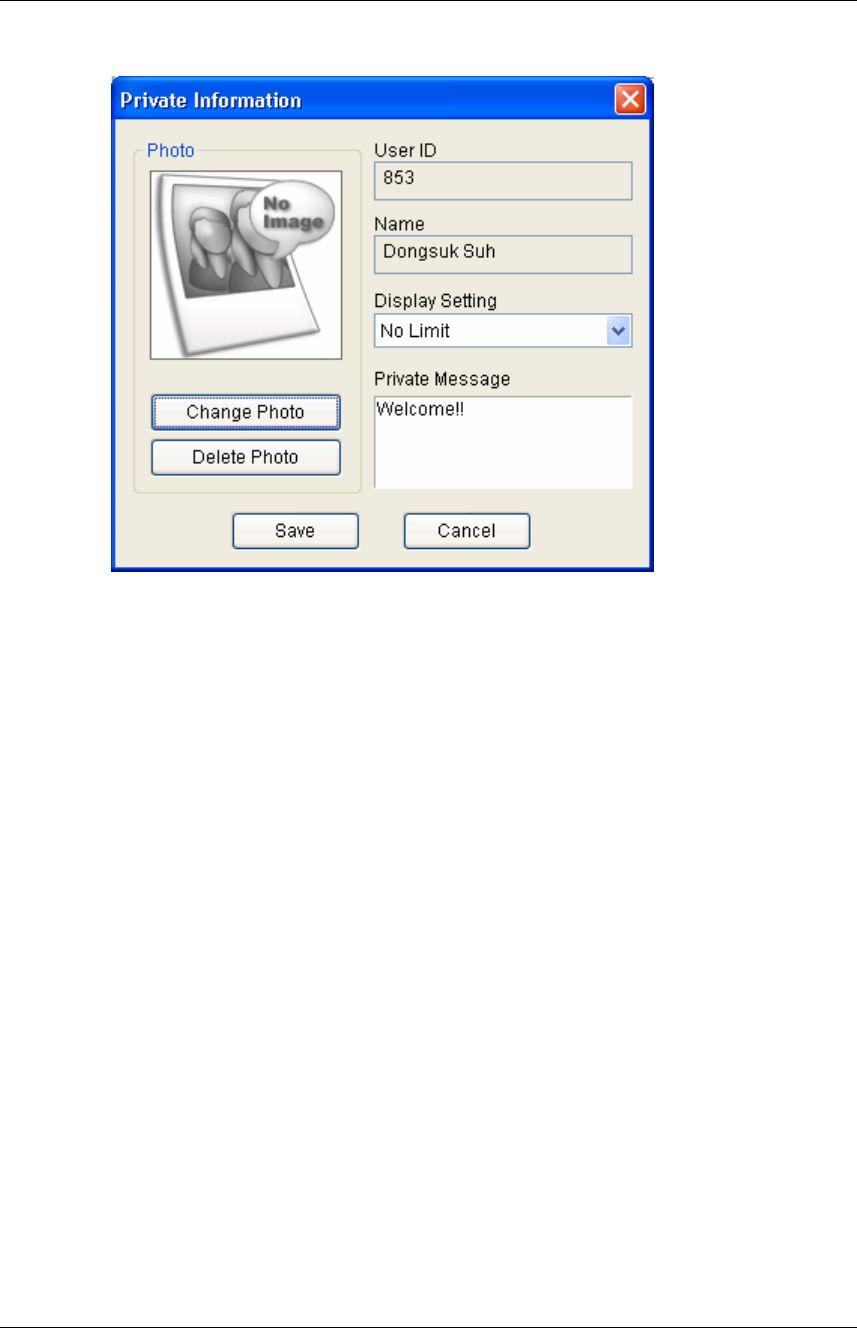
BioAdmin User Manual 122
Copyright © 2006, 2007 by Suprema Inc. http://www.supremainc.com
Change photo and message when succeeded in verification, and configure
display condition, which should be used ‘Private Information’ of the device.
z Access Group
Enter the access group information for each user.
To apply the designated access group information to each user, please
check on the Active option and sent transmit this user to the BioStation
and BioEntry. If you do not check on this option or do not transmit the user
to the BioStation or BioEntry, access group will not be applied to each user.
If you check on Bypass ID option, that user will be able to access the door
just by placing this card to the BioStation without fingerprint or password.
Auth Limit means the number of access that the user is allowed in a day
(from 00:00 to 24:00 of the day). If you do not want to restrict the number of
access for a user, leave this menu as the default, 0.
Timed means the minimum time interval required for access of the same
user. If you set this menu as 5, that user will not be able to enter the door
again within 5 minutes.
z Other Information
The Password on this menu is required when the BioStation requires the
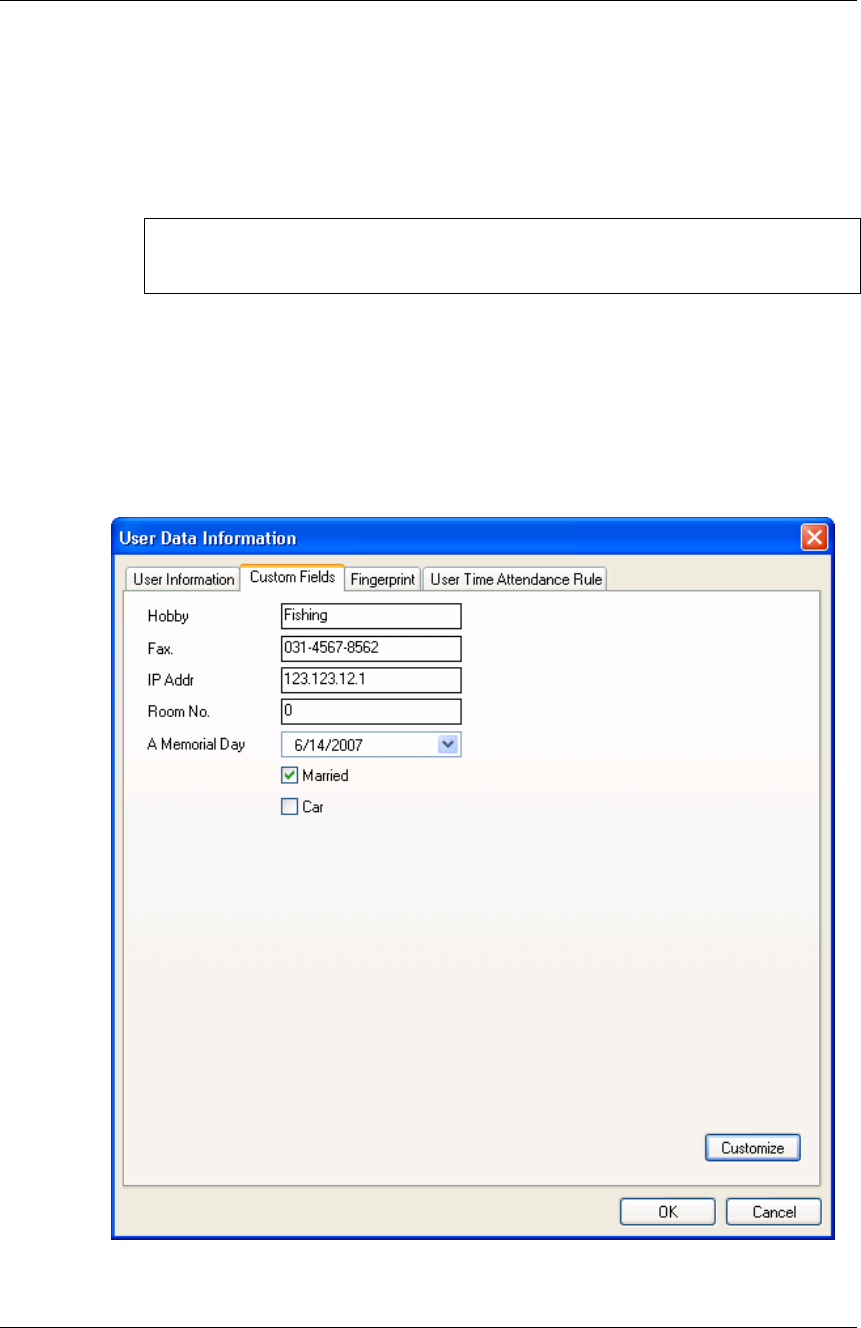
BioAdmin User Manual 123
Copyright © 2006, 2007 by Suprema Inc. http://www.supremainc.com
user’s password. Also, users should enter this password when they log in
to the BioAdmin Client to check their log information.
BioStation admin level : On this menu, you can select the user as an
administrator for BioStation terminal.
Note : in user information, user ID should be entered as it’s a required field but
the rest fields can be left blank.
3.5.2. Custom field
You can add customized user information columns on the user management
window by designating required fields on the Custom Fields menu.
z Customize… button enables the pop-up window to add the customized user
information column. After filling out the required contents, press the OK button.
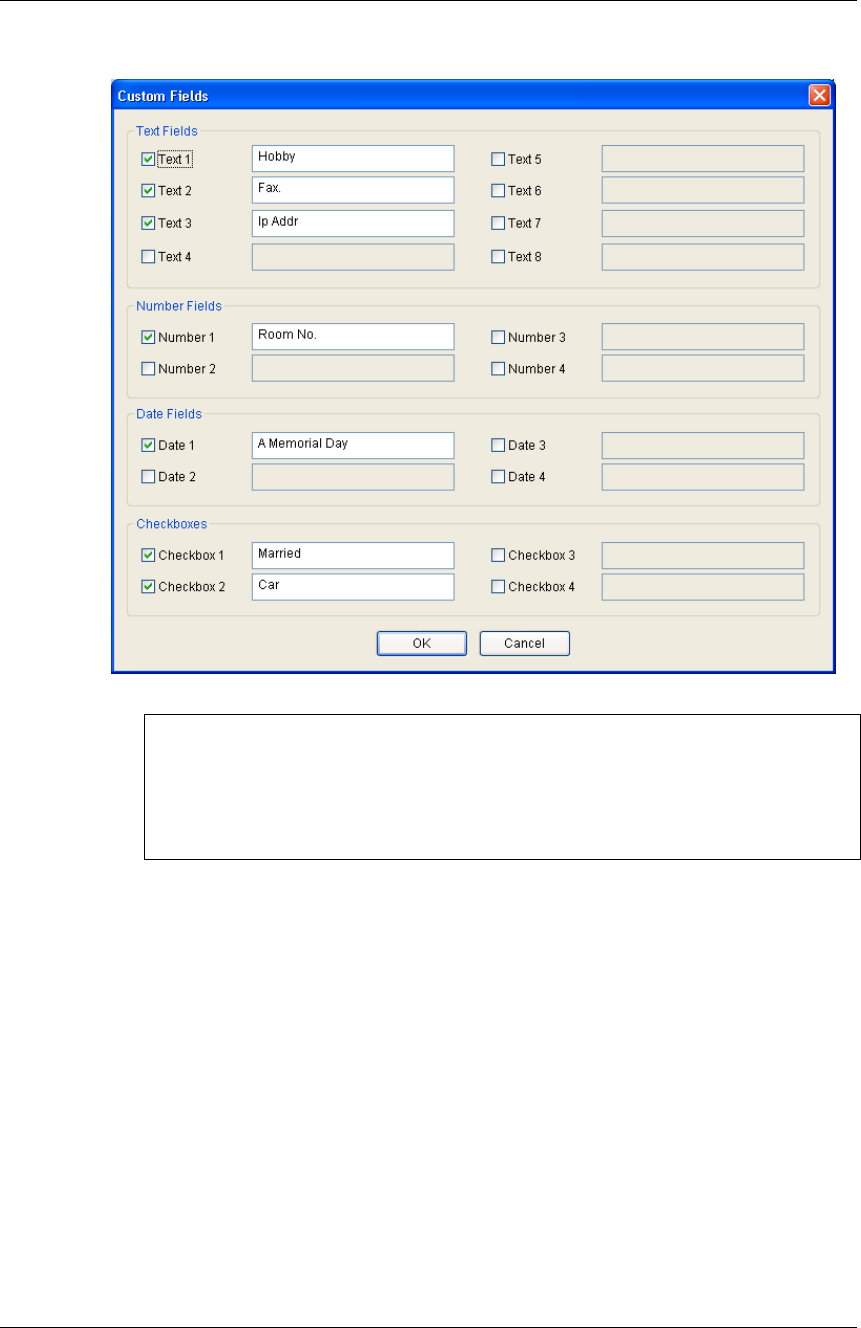
BioAdmin User Manual 124
Copyright © 2006, 2007 by Suprema Inc. http://www.supremainc.com
Note : Custom fields may look like a blank page but if you click settings on the
right lower end, a display where you are to set custom fields such as string,
number, date and checkbox appears. If you check such fields, items are
generated in blank custom fields.
3.5.3. Fingerprint
The next step of registration is adding user’s fingerprint templates to database.
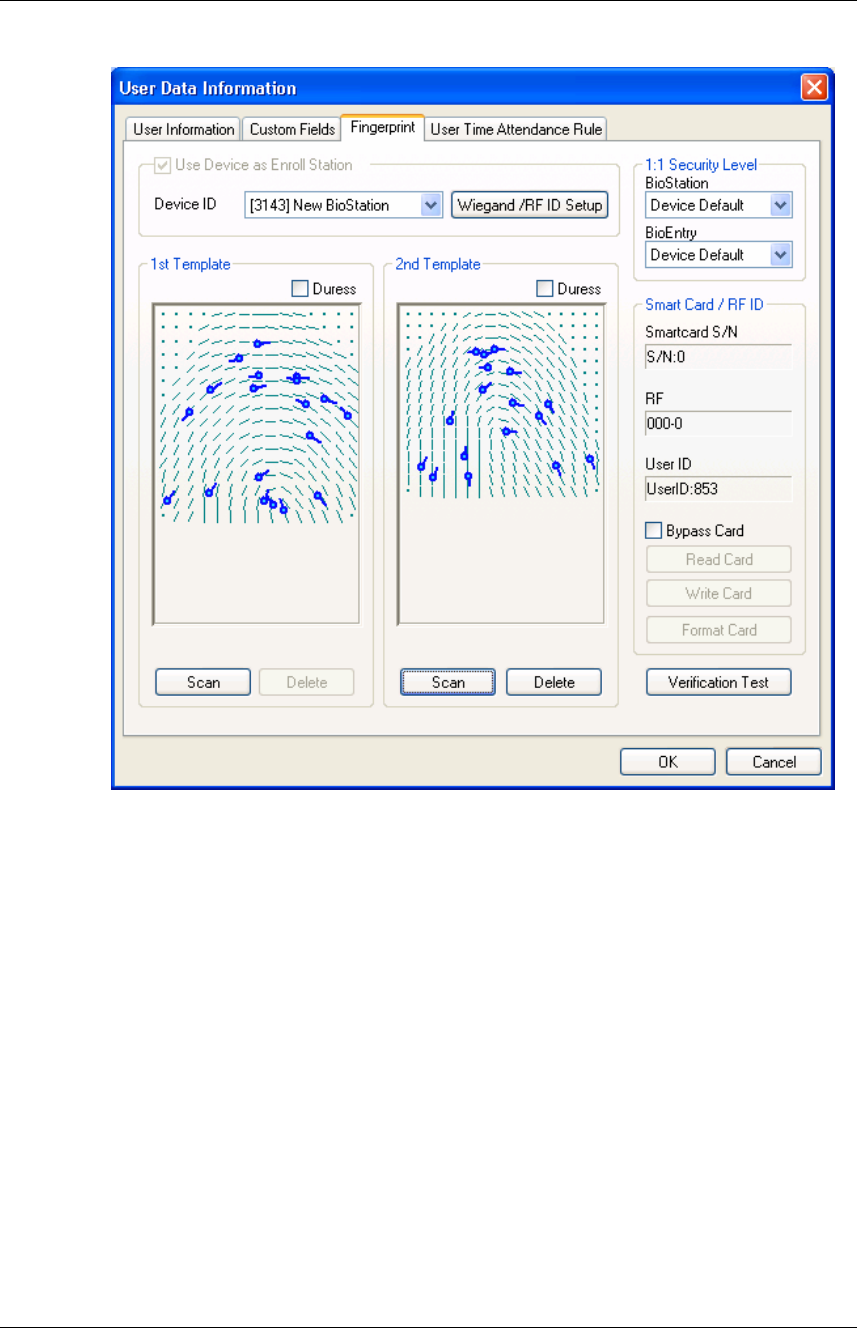
BioAdmin User Manual 125
Copyright © 2006, 2007 by Suprema Inc. http://www.supremainc.com
Templates can be enrolled by two methods:
z Enrollment using PC USB scanner
z Enrollment using BioEntry device connected to host PC
By default, USB scanner is used for enrollment. By enabling the Use BioEntry
as Enroll Station check box and selecting a device ID, BioEntry™ device is
used to get user’s templates. Up to 2 fingerprint templates can be included in
the user database.
z Acquisition of template
Press the Scan button and touch the same finger twice. If the acquisition of
template is successful, scanned template is depicted on the template window.
To register the second template for different finger, press the Scan button at the
right section.
z Enrollment of duress finger
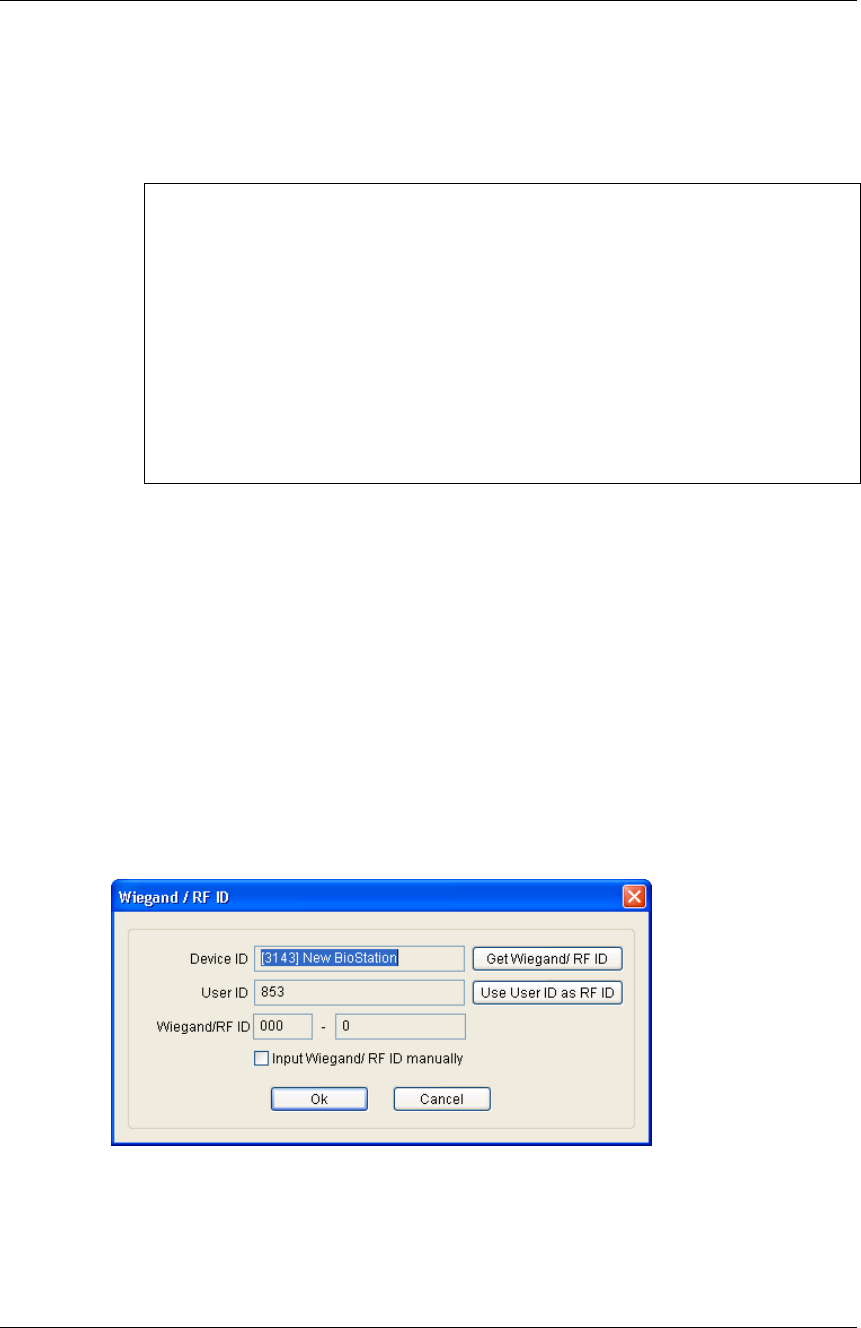
BioAdmin User Manual 126
Copyright © 2006, 2007 by Suprema Inc. http://www.supremainc.com
Duress finger can be enrolled to generate duress signal when the specified
finger is detected on the device. After a template is acquired, enable the Duress
check box to indicate that the template should be saved as duress mode.
Note : What is duress mode?
Duress finger can be used in a situation when one is threatened by a thief in
front of a door. If duress finger is entered, door is opened normally but it can be
set to sound an emergency alarm or ring an emergency call which has been
set as output port. For instance, in case of enrolling 2 fingers, the first finger
can be enrolled as normal finger whereas the second finger as duress finger.
Duress finger should be a different finger from a normal finger enrolled
beforehand.
z Delete fingerprint
To delete fingerprint, delete from the second fingerprint information on the right.
The first fingerprint information can be deleted after the second fingerprint
information is deleted.
z Test matching
In order to check that enrollment of template is properly completed, matching
test can be processed. Press the Test Matching button and touch the
registered finger on the specified device. Then, a message will appear to show
the matching result.
z Wiegand / RF ID Set up
If you use BioStation RF or use the normal BioStation along with an external
Wiegnad card reader, you need to allocate the card ID to each user. Press this
button to designate the users’ card ID.

BioAdmin User Manual 127
Copyright © 2006, 2007 by Suprema Inc. http://www.supremainc.com
Get Wiegand / RF ID : If you press Get Wiegand / RF ID button,
BioStation RF (or external Wiegand card reader) will be waiting for the card.
If the user put his card to the BioStation (or to the external Wiegand card
reader), the Wiegand ID of that card will be registered as the user’s card ID.
Therefore, you can use this option to get the Wiegand ID from the card and
apply it to the user.
Use User ID as RF ID : If you press Use User ID as RF ID button,
Wiegand card ID is entered as same as the user ID. This menu is useful
when the users were already using Wiegand cards of which card ID was
set as same as the user ID.
Input Wiegand / RF ID manually : If you press Input Wiegand / RF ID
manually button, you can enter the Wiegand / RF ID manually.
z 1:1 Security Level.
You can change the security level for the 1:1 verification of BioEntry and
BioStation. If a user’s fingerprint condition is very poor and he often fails in 1:1
verification, administrator may enroll his fingerprint after lowering the 1:1 security
level for that user.
3.5.4. Issue user smart card
BioEntry Smart basically operates with user’s smart card containing user
information and fingerprint templates. Issuing is required to create the user’s smart
card.
Issuing of user’s smart card is processed on the user management window, which
is initiated by double clicking a user on the user list or by pressing the Register
New User button on the main window.
Smart card can be issues by two methods:
z Issuing with PC USB smart card device
z Issuing with BioEntry™ Smart connected with host PC
To use a BioEntry™ Smart as a card issuer, enable the Use BioEntry as Enroll
Station check box and select a device ID. Otherwise, PC USB device is used as a
card issuer.
3.5.5. Issue with PC USB smart card device
z Place the target smart card on the PC smart card device

BioAdmin User Manual 128
Copyright © 2006, 2007 by Suprema Inc. http://www.supremainc.com
z Press the Write button to initiate issuing.
z The site key management window will appear at the first trial of issuing after
starting of BioAdmin software. Also, the window will appear if it fails to access
the smart card due to the mismatch of the site key.
z Type the current site key to access the smart card. If it remains blank, BioAdmin
software uses default key ( 0xFFFFFFFFFFFF ) as a current site key.
z If it is desired to change the site key on issuing, enable the Change Site Key
check box and type new site key. Then, new site key is updated on the smart
card. The new site key should be correspondent with the site key on BioEntry
Smart device.
3.5.6. Issue with BioEntry Smart
z Place the target smart card at selected BioEntry Smart
z Press the Write button to initiate issuing. Since the site key management
information is stored on BioEntry, issuing is processed without requesting site
key.
3.5.7. User security level and all-time pass card (Bypass) setting
On issuing, security level can be specified for each user. By changing Security
Level dropdown list, user’s security level can be specified from 1/1,000 to
1/100,000,000. If Device Default is selected, security level configured on BioEntry
Smart device is used.
To issue all-time pass card (bypass card), you can choose bypass card option.
Note : What is bypass card? Device authorizes a user with a card without
fingerprint authentication process.
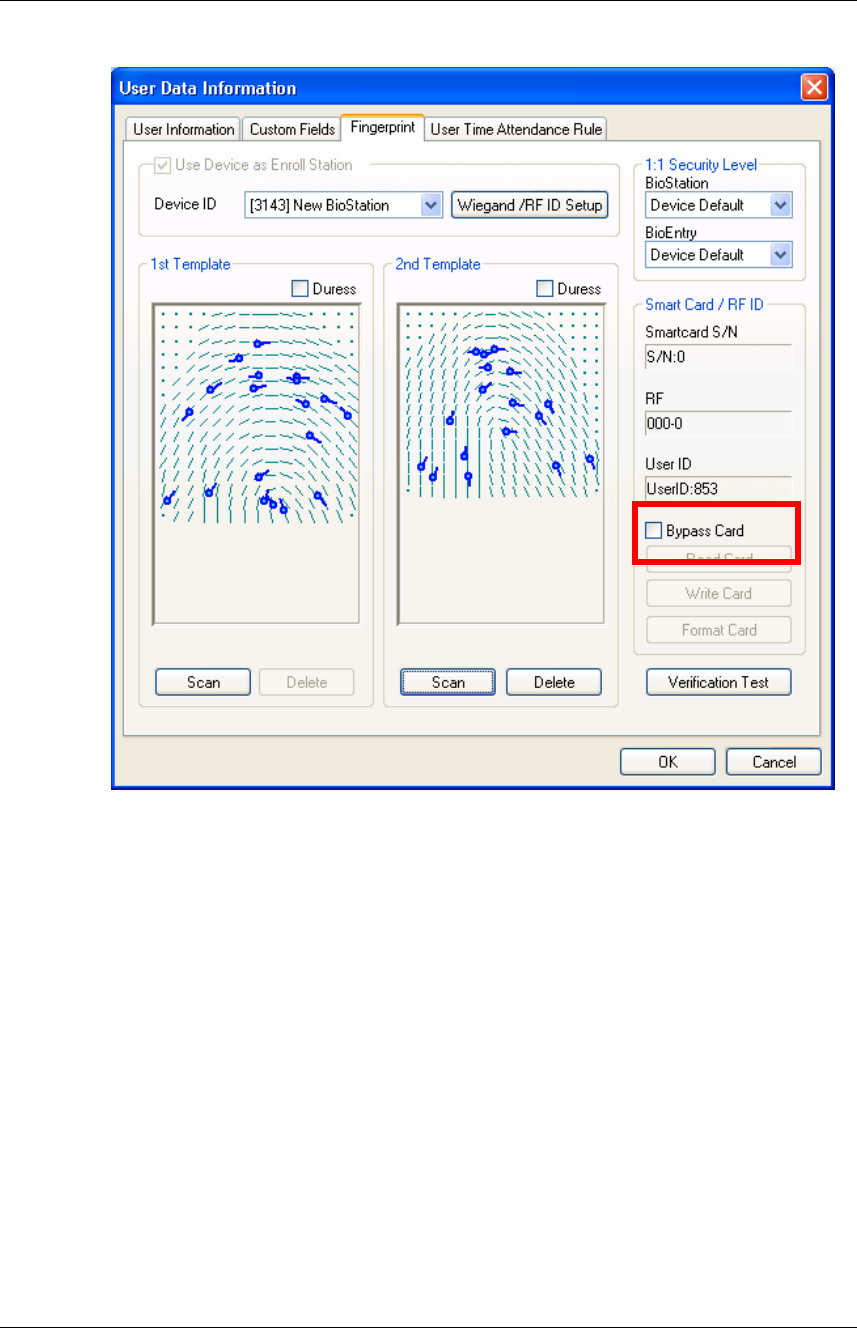
BioAdmin User Manual 129
Copyright © 2006, 2007 by Suprema Inc. http://www.supremainc.com
3.5.8. Wiegand string setting using ID card
On issuing a smart card, the specific Wiegand string contained in customer’s ID
card can be transferred to the smart card. For this operation, RF Wiegand device
should be connected to the Wiegand input port of the selected BioEntry device.
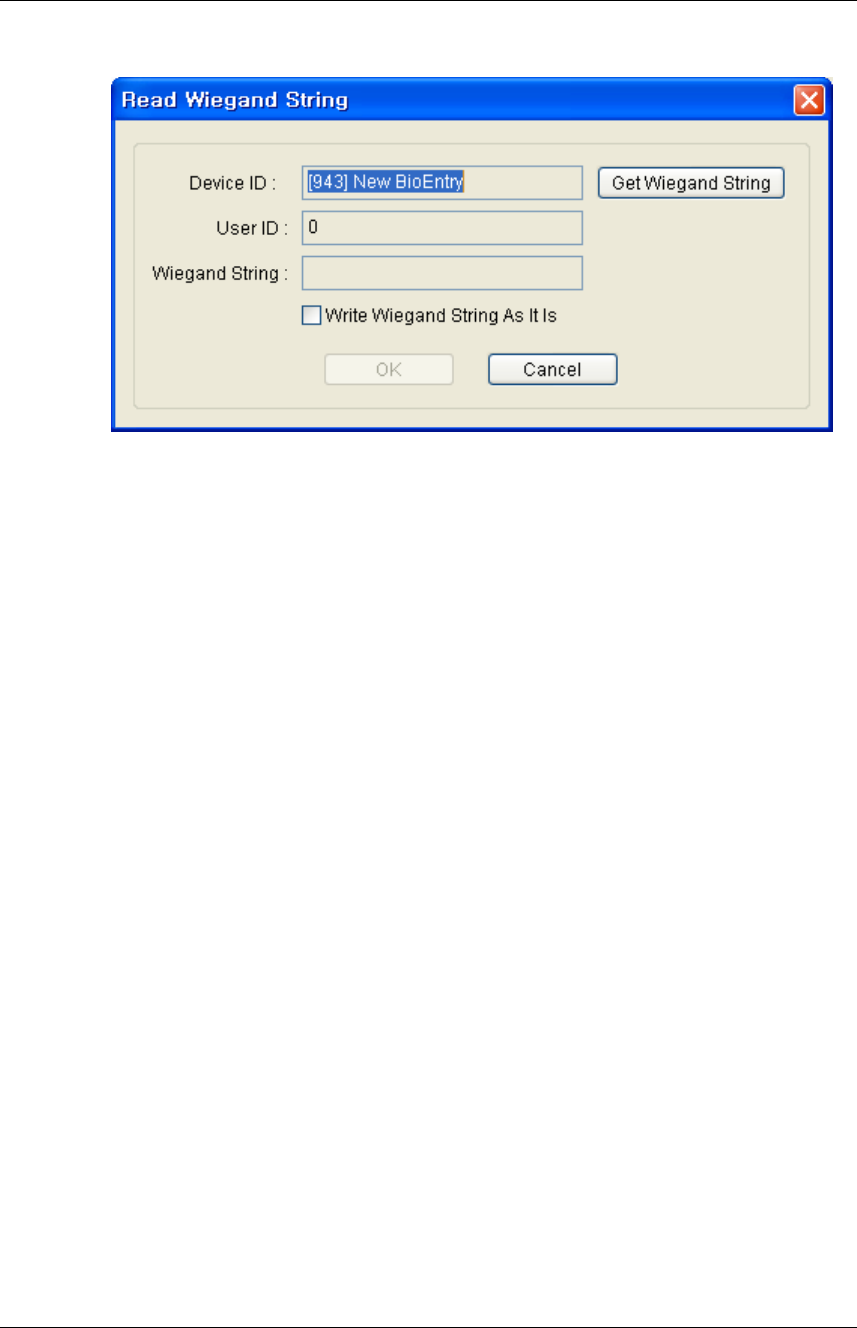
BioAdmin User Manual 130
Copyright © 2006, 2007 by Suprema Inc. http://www.supremainc.com
Detailed operations are as follows.
z Press the Wiegand String Setup button
z Press the Get Wiegand String button and touch the ID card containing
Wiegand string on the Wiegand device.
z The Wiegand string received from the device is displayed on the user
management window.
z Enable Write Wiegand String As It is check box to use the Wiegand string
instead of the user ID
z Press OK button to issue the user’s smart card. Then, the received Wiegand
string is stored on the smart card. If the check box is disabled, the Wiegand
string converted from user ID is written to the smart card.
3.5.9. Read issued smart card
The information stored on the issued smart card can be retrieved by Read Card
button on the user data information window. When PC USB smart card device is
used, the site key management window will also appear if the site key is
mismatched. In reading process, the site key change option is neglected.
3.5.10. Card format
Formatting is the process of erasing issued information on the smart card. The
Format Card button on the user data information window initiates formatting
process. The site key change option is effective in this process.
3.5.11. Notes on card issue

BioAdmin User Manual 131
Copyright © 2006, 2007 by Suprema Inc. http://www.supremainc.com
z Before writing on a new smartcard, you should format the new smart card first.
z Site key is not stored in BioAdmin software to improve the security of the
system.
Note : It is the necessary for the administrator to remember and keep in secret
the custom site key for proper management of the system. Also, please pay
keen attention to changing the site key on the smart card.
z If writing to smart card is stopped accidentally in issuing process, the smart card
might be corrupted and irrecoverable. Be careful to avoid accidental stop in
writing smart card.
3.5.12. Rules on user T&A event control
This menu is used to set user time attendance rule. For the detailed operation,
refer to Chapter 12 Report.
3.6. Delete checked user
3.6.1. Delete checked user from BioAdmin software
Delete checked user information on user list window. If you check a user and click
delete checked user in task box, a message “do you want to delete checked
(selected) user?” appears. If you press ok button, checked user is deleted from
BioAdmin of the host PC.
3.6.2. Synchronization deleted user information with device
If you transfer remaining user information after deleting a specific user, you can
also delete such deleted user information from device.
3.7. Transfer checked user to device
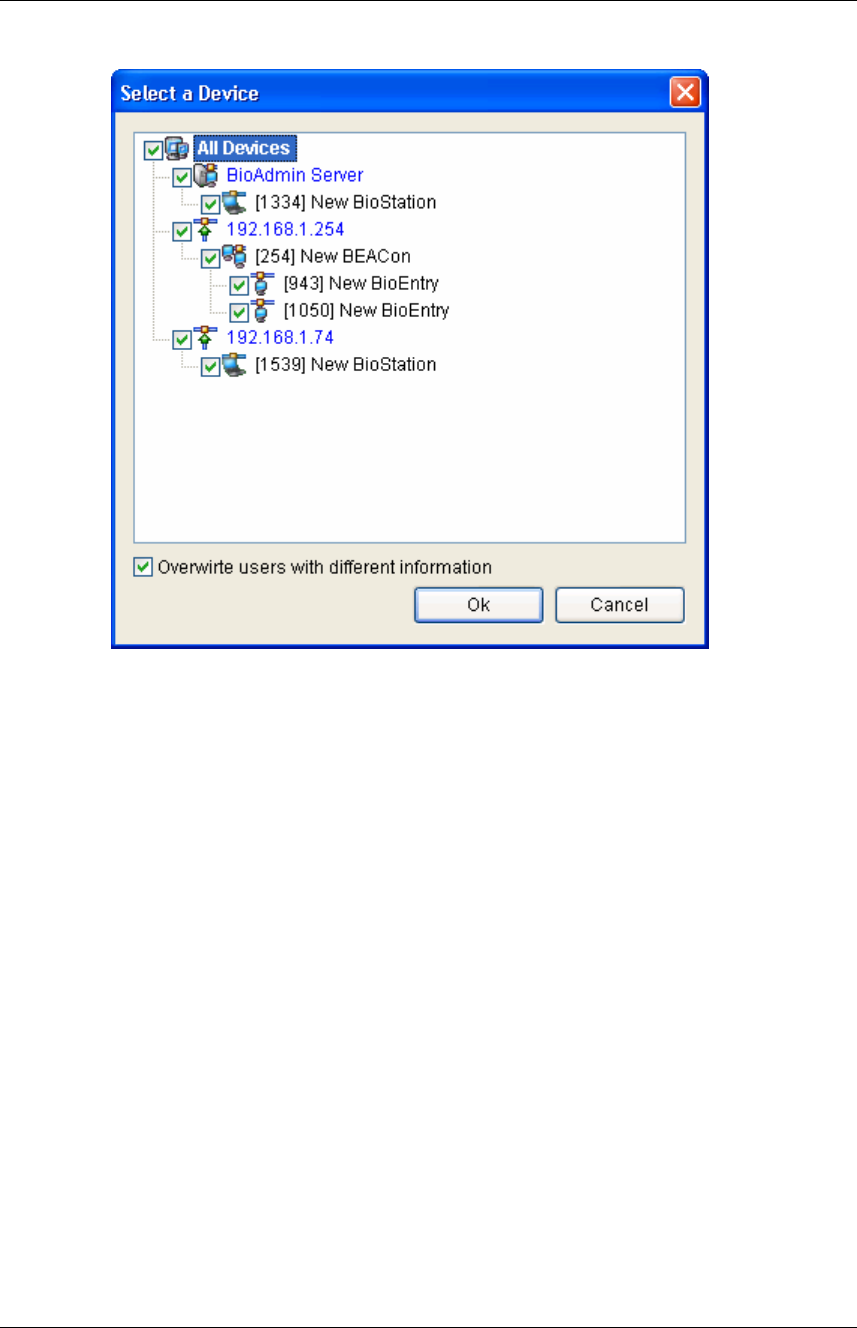
BioAdmin User Manual 132
Copyright © 2006, 2007 by Suprema Inc. http://www.supremainc.com
Transfer checked users to device is to transfer user DB in host PC to device. To
run a device, user data including fingerprint information should be transferred to
device after user enrollment.
User information such as user ID, finger scan information, access group and
security level is transferred through this process. Transfer procedure is processed
in selected device, selected group or all devices linked on network. In how to select
(check) user, user information can be transferred selectively.
Detailed operating process is as follows.
z Check a user to transfer.
z Press transfer checked users to device button.
z Select a device on select device window.
z In case user ID is same but user information is different, if you check overwrite,
data in host PC will overwrite the same user’s information in device.
z If not able to find a selected user in device, new user data is transferred from
host PC database to device.
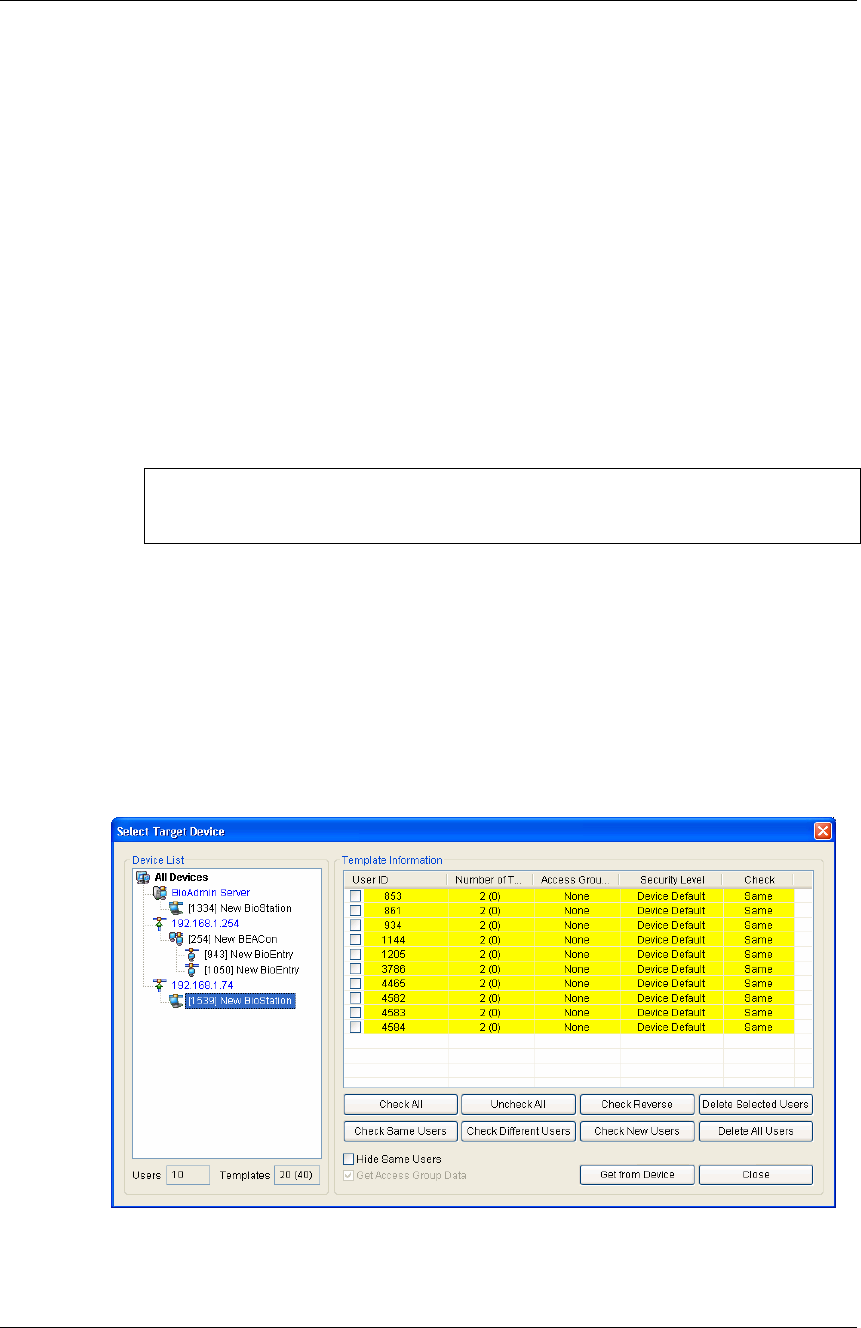
BioAdmin User Manual 133
Copyright © 2006, 2007 by Suprema Inc. http://www.supremainc.com
3.8. Delete checked users from device
On user list window, enrolled user can be deleted by delete checked user from
device button.
Detailed operating process is as follows.
z Select a user to delete
z Press delete checked user from device button on task window.
z Select a corresponding device on select device display.
z Selected (checked) user is not deleted on host PC user list. To delete it from
host PC user list, press ‘delete checked user’ button.
Note : Be careful in selecting a device in a network because it is a task to
delete user information from selected device.
3.9. Manage users in device
Manage users in device is to upload user information from device to host PC
database. User information such as user ID, fingerprint information, access group
number, security level is uploaded thru this process.
In this menu, you can upload user database selectively from chosen device on
network.
Detailed operating process is as follows.

BioAdmin User Manual 134
Copyright © 2006, 2007 by Suprema Inc. http://www.supremainc.com
z Press Manage users in device button.
z Select a corresponding device on device list window.
z Under device list window, you can see user and number of fingerprint
information enrolled in the selected device.
z User classification
Same user : user whose user information in BioAdmin software
corresponds to user information uploaded from device.
Different user : user whose user information in BioAdmin software doesn’t
correspond to user information uploaded from device.
New user : user information uploaded from device doesn’t exist in
BioAdmin software. it can be construed as surplus user in device.
z Color classification
Same user : indicated in yellow.
Different user : indicated in red.
New user : indicated in white.
z Check classification
Check all: check (select) all user information
Uncheck all : to uncheck after checking all user information
Check reverse : to uncheck checked user or check unchecked user
Delete selected user : to delete selected user
Check same users : select users whose user information in BioAdmin
software corresponds to user information uploaded from device.
Check different users : select users whose user information in BioAdmin
software doesn’t correspond to user information uploaded from device.
Check new users : select users who are enrolled in device only but do not
exist in BioAdmin software.
Delete all : to delete selected users and the other all users
z Hide same users
If you press check same users, checkbox of a user whose data is same both in
device and host PC is checked. If you display hide same users, these users can
be hidden on finger scan information window.
z Get access group data
Check a checkbox of get access group data and execute Get from device, to
upload user access group information.
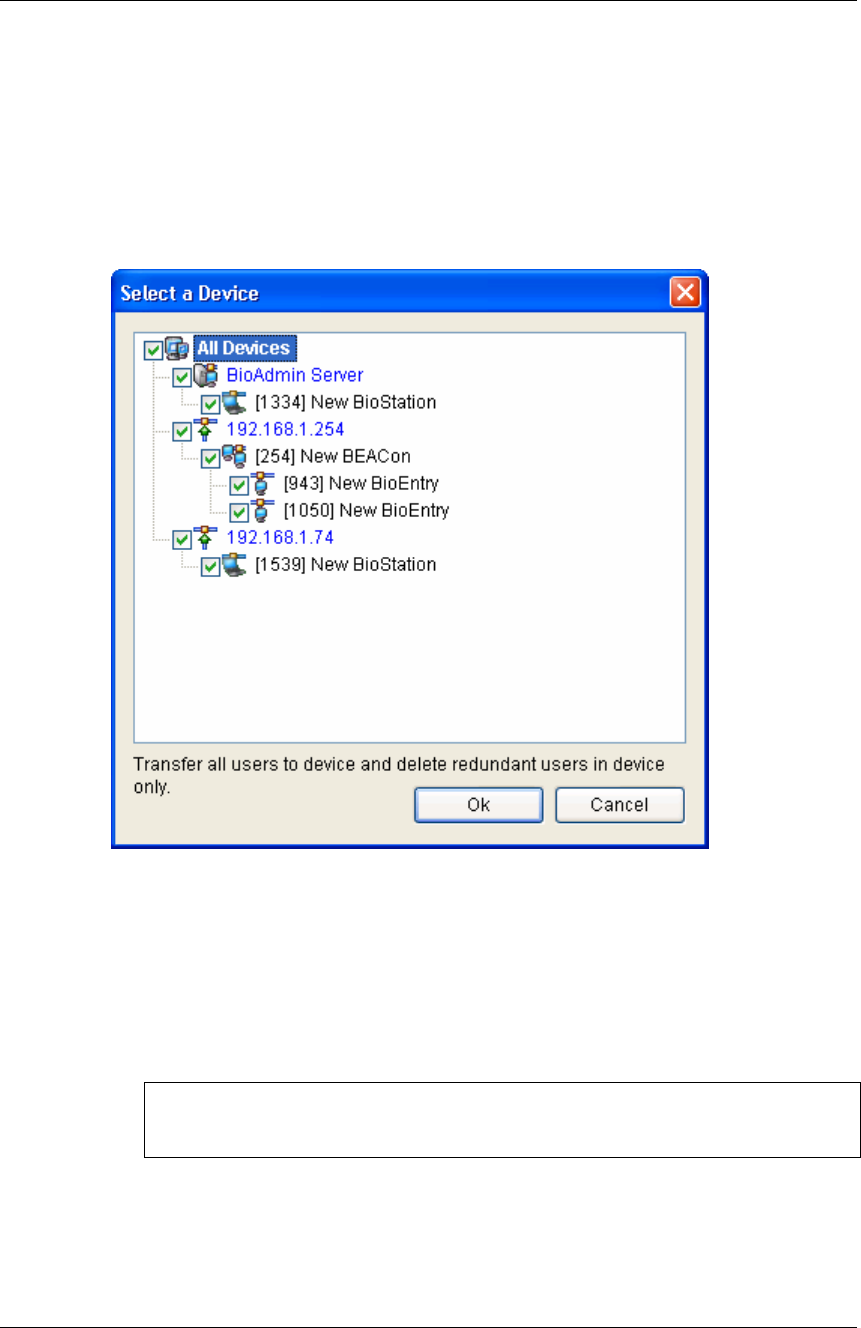
BioAdmin User Manual 135
Copyright © 2006, 2007 by Suprema Inc. http://www.supremainc.com
3.10. Synchronize all users
Synchronization all users button transfers all user data base in host PC to device
and surplus users remaining in device only are deleted. User information such as
user ID, fingerprint information, access group number and security level is
uploaded thru this process.
Detailed operating process is as follows.
z Press synchronize all users button.
z Select applicable device on device list window.
z Press select button to transfer user information database in device from host
PC to device.
Note : By transferring all users to device, surplus users in devices will be
deleted.
3.11. Export to file
The Export to file button initiates saving information of selected users in CSV
format. Fingerprint templates are not included in this exportation. Exported CSV file
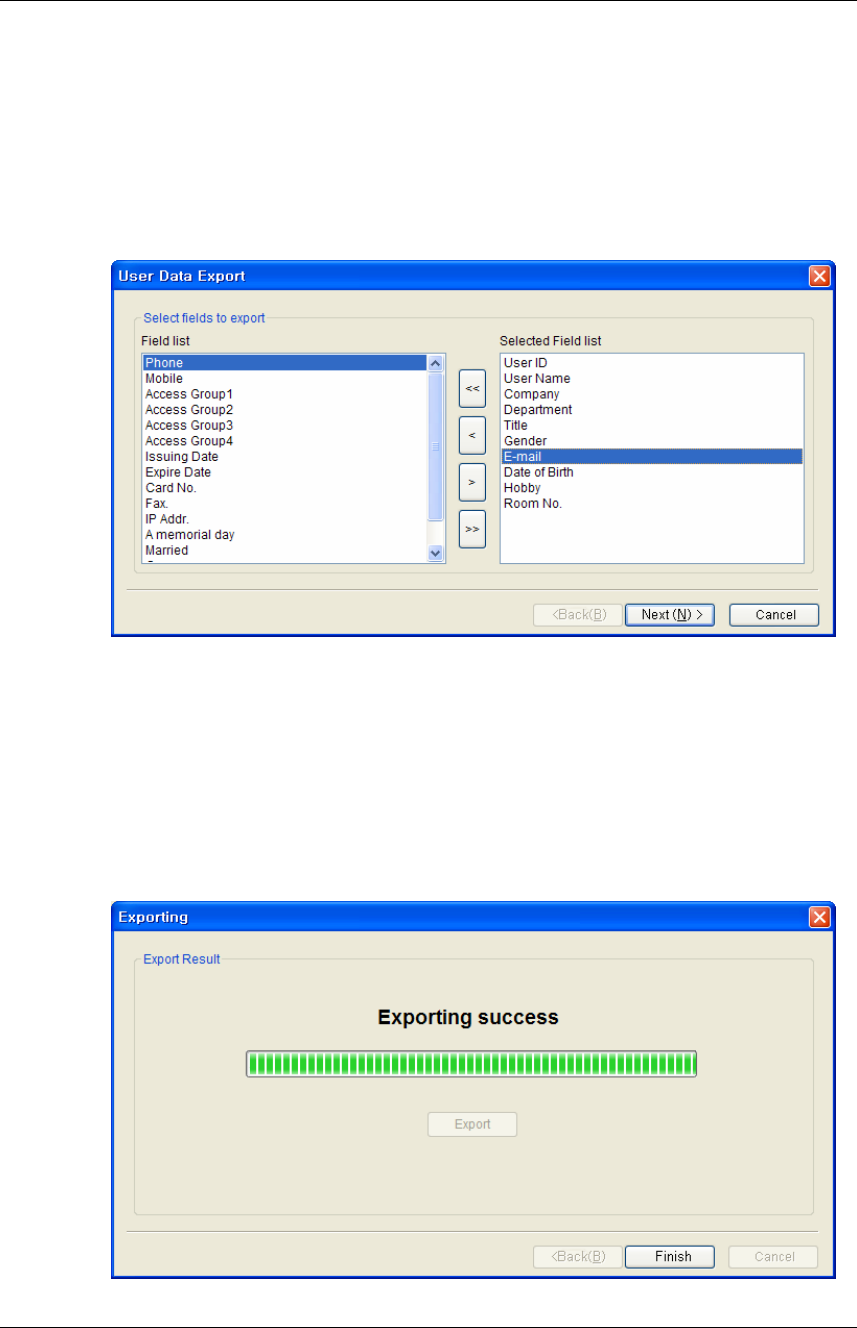
BioAdmin User Manual 136
Copyright © 2006, 2007 by Suprema Inc. http://www.supremainc.com
can be edited using Microsoft Office Excel or usual text editor.
Detailed operations are as follows.
z Check on the users to export.
z Press the Export to file button.
z Select fields to export. You can select the target fields simply by moving the
target fields from Field list to Selected Field list.
z After selecting the fields, press the Next button.
z Select a file to export.
z After selecting the file, press Next button.
z Press Export button.
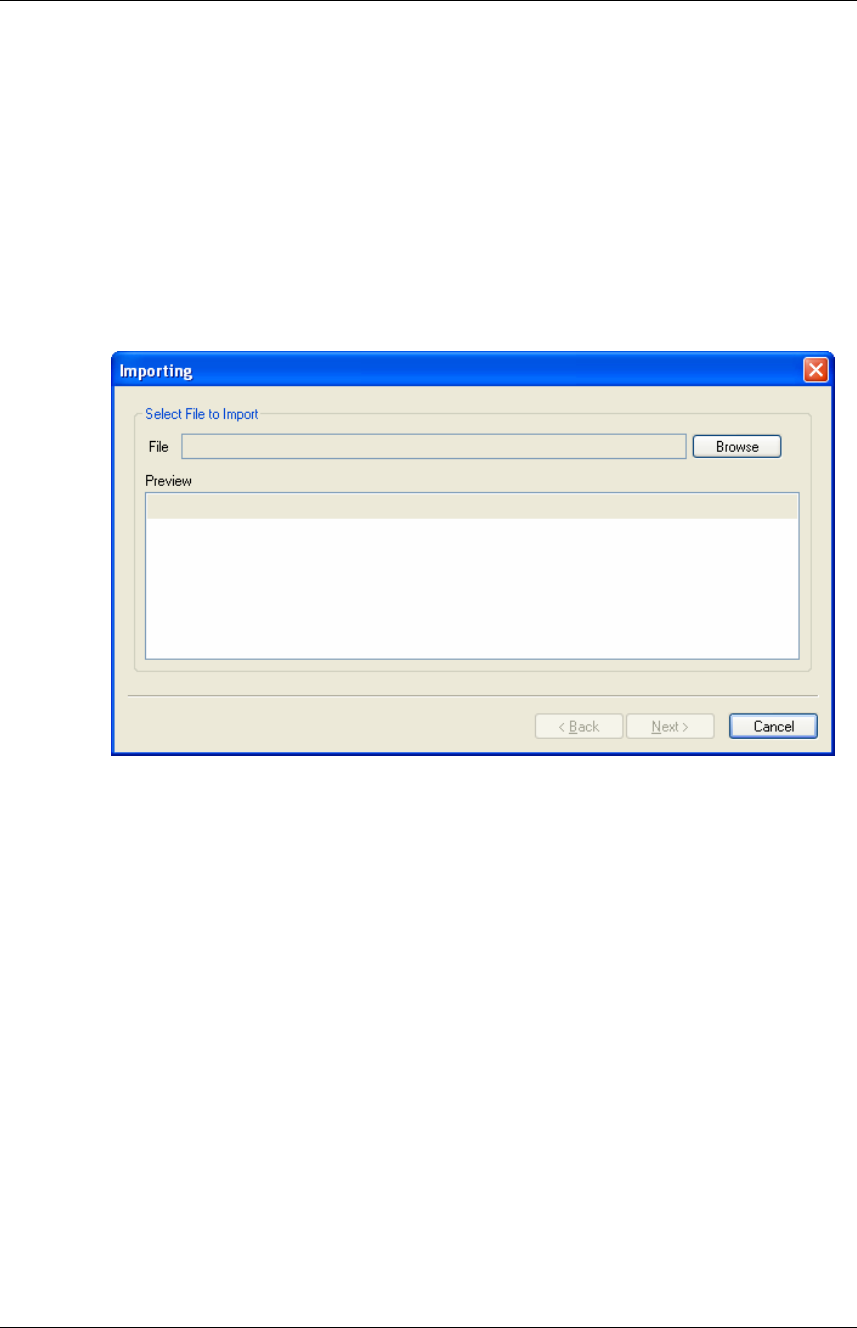
BioAdmin User Manual 137
Copyright © 2006, 2007 by Suprema Inc. http://www.supremainc.com
3.12. Import from file
The Import from file button is used to upload user database from an external
database to BioAdmin Software user database. User list saved as CSV (Comma
Separated Values) format can be loaded into user database list.
Detailed operations are as follows.
z Press the Import from file button.
z Select a file to upload.
z After selecting the file, you can see the content examples of 5 users on the
preview window. Check the preview window to confirm the selected file is the
right file from which you want to upload the database.
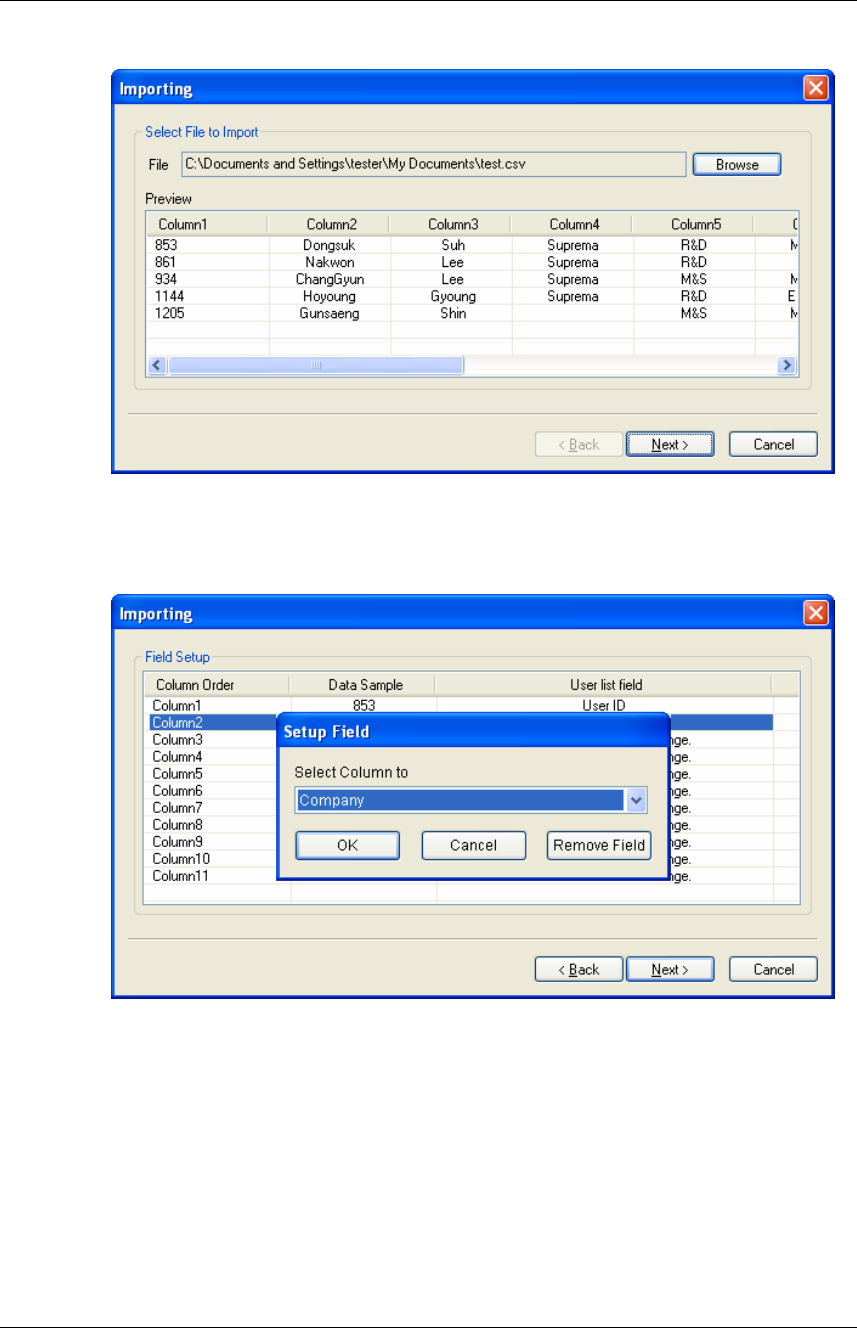
BioAdmin User Manual 138
Copyright © 2006, 2007 by Suprema Inc. http://www.supremainc.com
z If the file is correct, press the Next button.
z Select a column to upload.
z Press the Upload button.
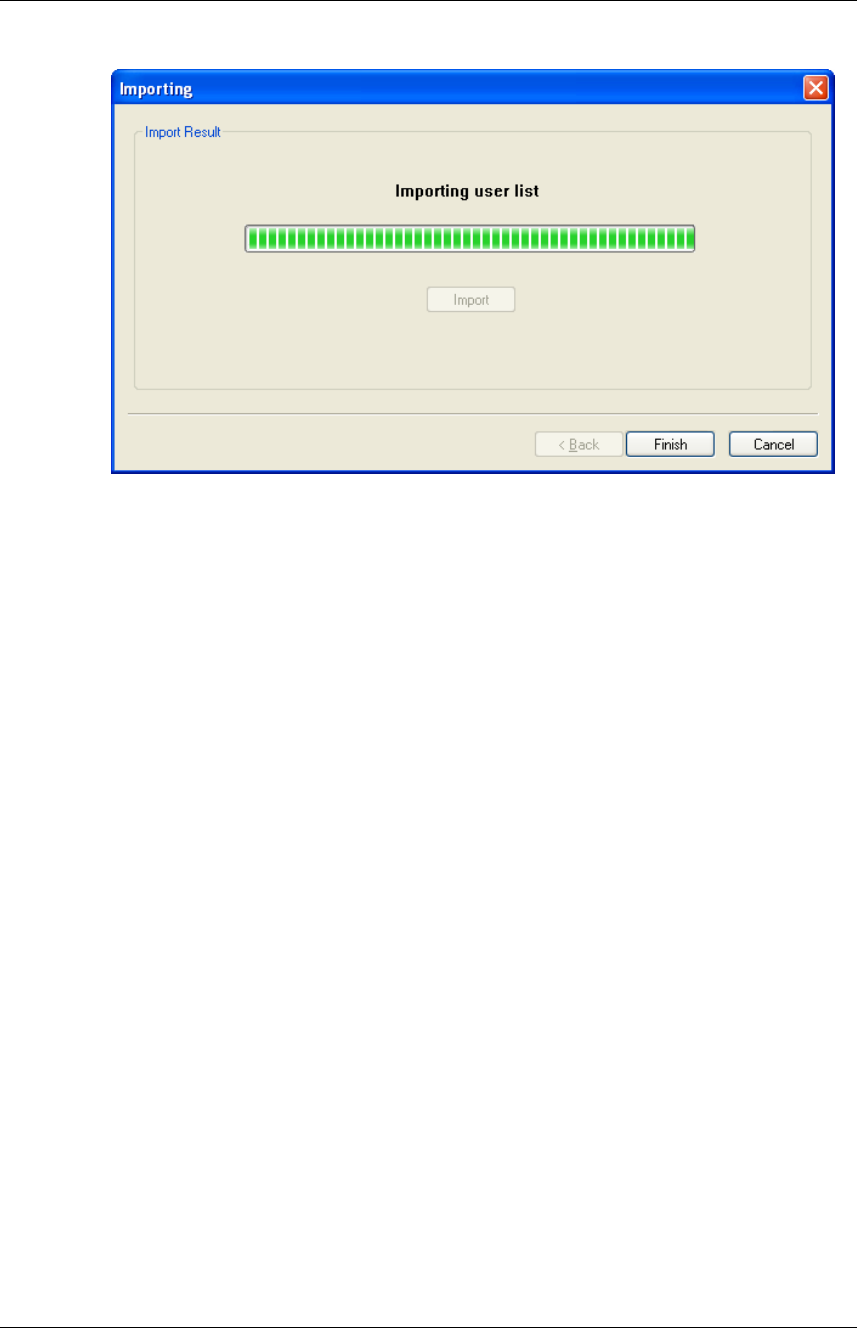
BioAdmin User Manual 139
Copyright © 2006, 2007 by Suprema Inc. http://www.supremainc.com
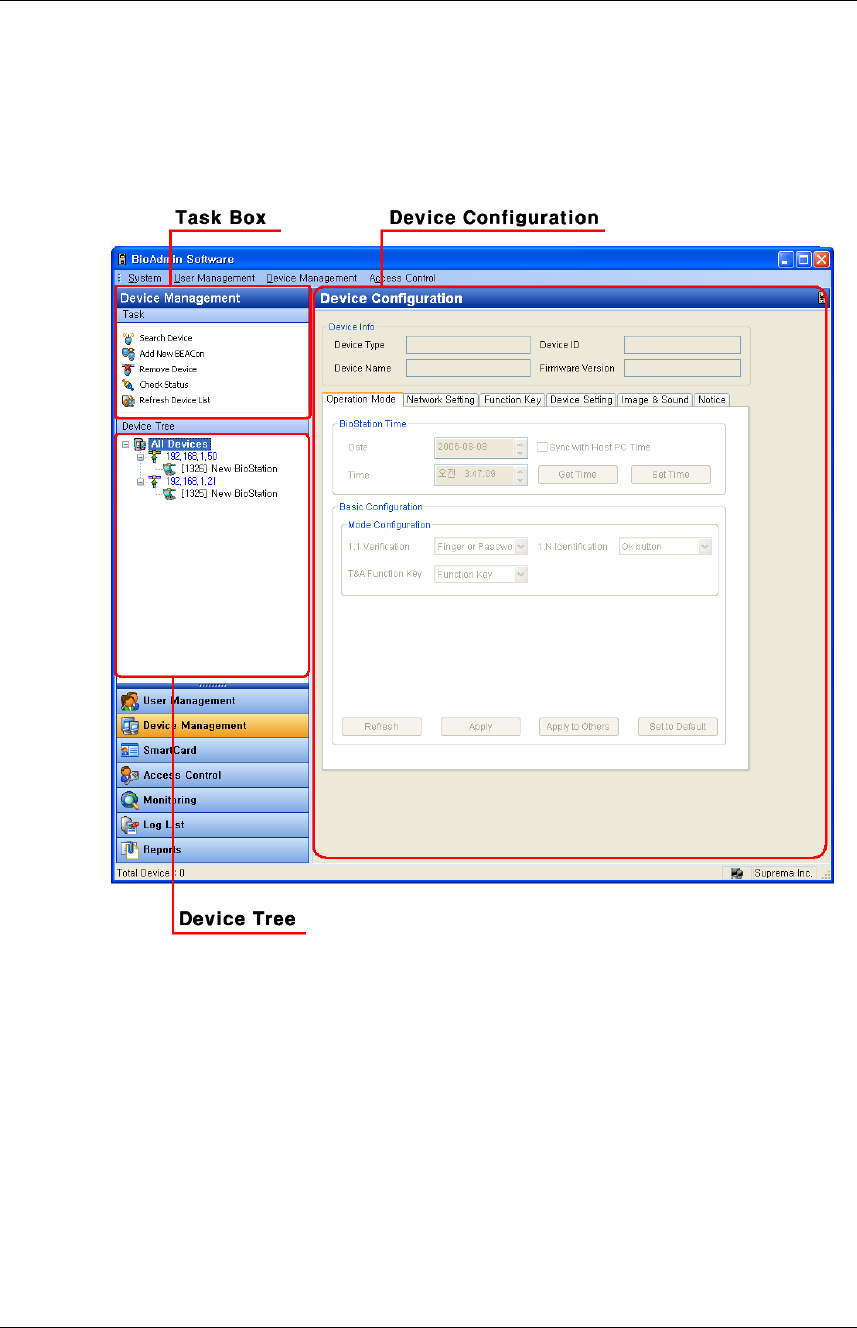
BioAdmin User Manual 140
Copyright © 2006, 2007 by Suprema Inc. http://www.supremainc.com
4. Device Management
By selecting the Device Management menu, the device management page is
updated on the main window.
Device management page is divided into 3 sectors:
z Device configuration
The configuration set up window shows the current configurations of networked
BioEntry, BioStation, and BEACon. Also, this window shows the configurations
to be changed.
z Task box
The Task box includes buttons to control basic operations of the Device
Management page.
z Device Tree
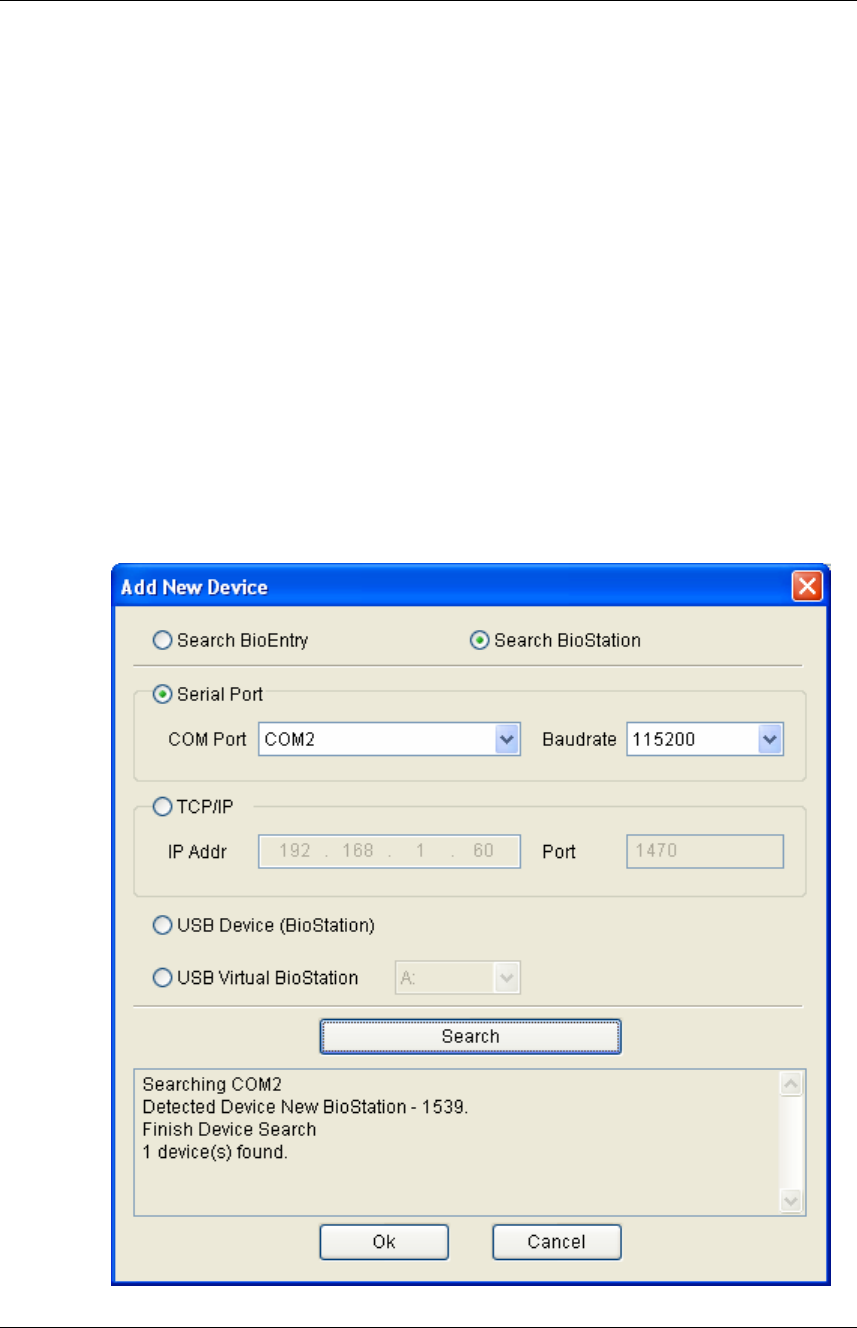
BioAdmin User Manual 141
Copyright © 2006, 2007 by Suprema Inc. http://www.supremainc.com
The Device Tree window shows the network condition of connected BioEntry,
BioStation, and BEACon.
4.1. Search device
To search new BioStation or BioEntry device and add, click search device menu in
task box. If add new device window pops up, select a device for search from
BioEntry or BioStation and select serial port, TCP/IP (Ethernet) or USB device
according to interface between device and host PC. Of these, USB connection is
available only with BioStation.
4.1.1. Serial port
In case device and host PC are linked by serial network, set applicable COM port
of host PC and select baudrate. Default baudrate of BioStation, BioEntry and
BEACon is 115,200 bps.
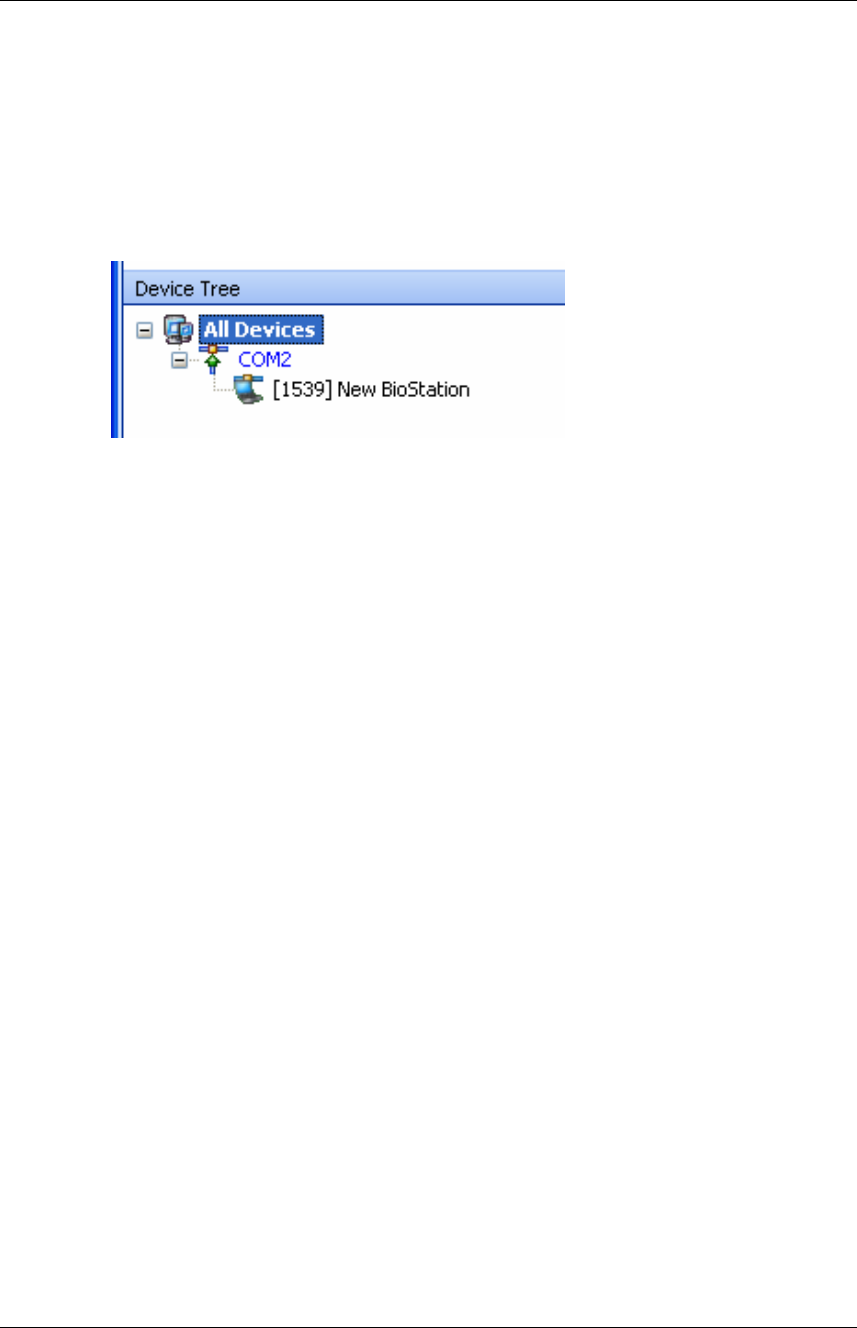
BioAdmin User Manual 142
Copyright © 2006, 2007 by Suprema Inc. http://www.supremainc.com
Press search button to display search result. Press ok button to display searched
device on device list. The number in bracket [ ] ahead of searched device name is
device ID. To change device name, place a cursor on applicable device and press
the right button of the mouse to display a menu. Choose ‘change name’ then input
window appears where a new name can be entered.
4.1.2. Ethernet
In case device and host PC is connected by Ethernet, enter IP address and pot in
TCP/IP field on add new device window.
In case of BioStation and BEACon, IP address can be checked in device. For
details, refer to manual of each device. In case of BioEntry, Ethernet interface is not
supported but can be linked by Ethernet using Ethernet to Serial converter in host
PC. Input IP address of mounted Ethernet to Serial converter.
Input 1470 for all ports.
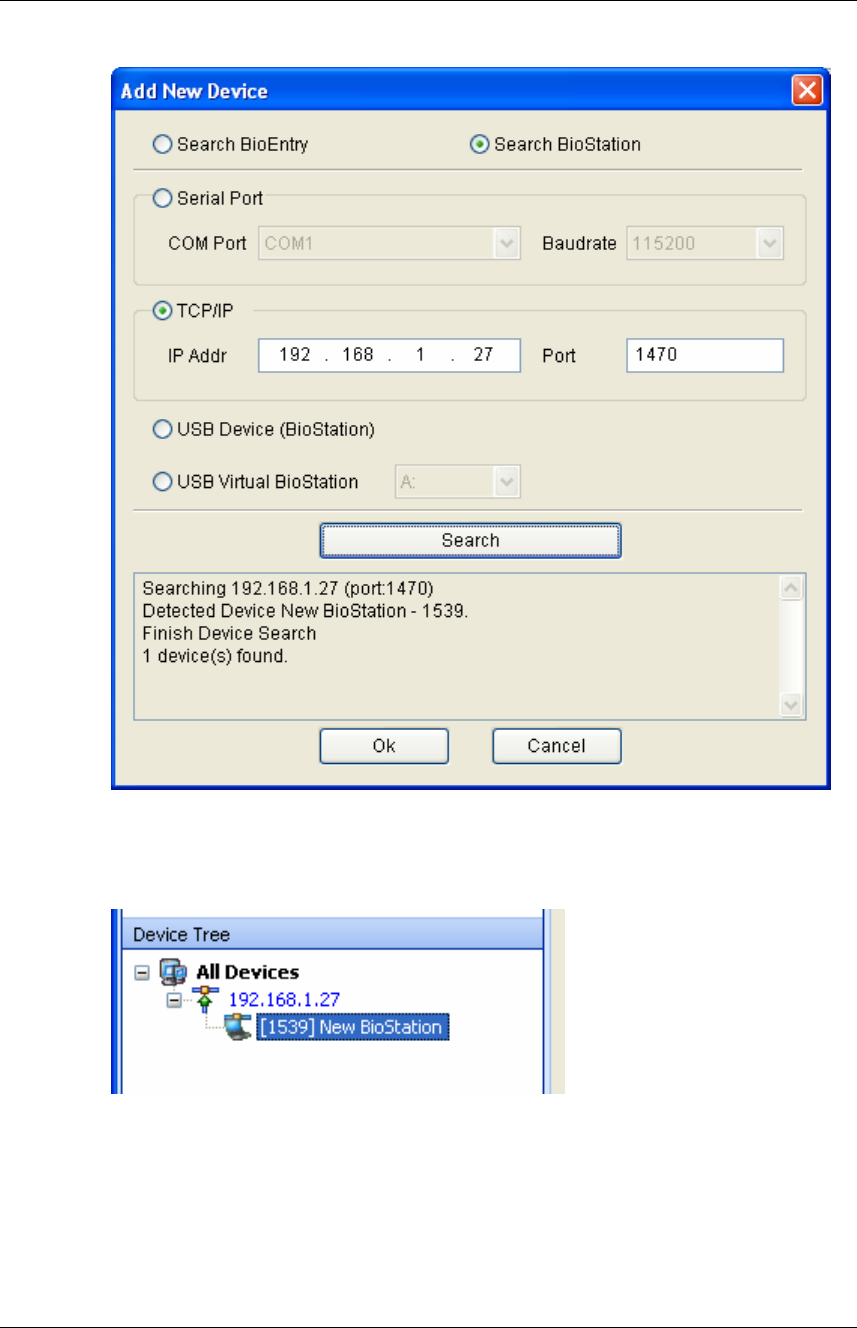
BioAdmin User Manual 143
Copyright © 2006, 2007 by Suprema Inc. http://www.supremainc.com
Once device is linked correctly with network, searched device ID appears with
bracket [****] under port on device tree window.
4.1.3. USB device
In case of connecting BioStation with host PC by USB, select USB device and
search.
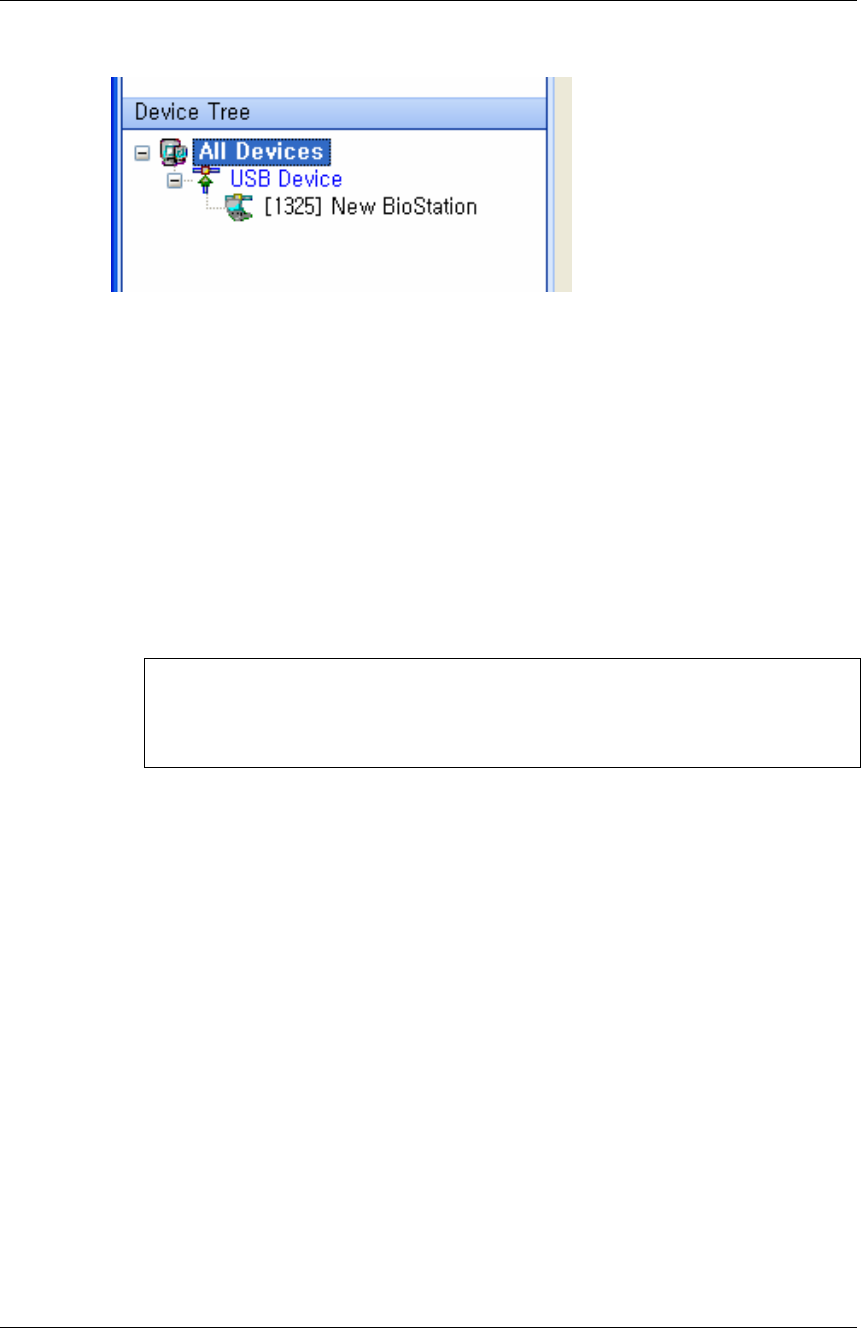
BioAdmin User Manual 144
Copyright © 2006, 2007 by Suprema Inc. http://www.supremainc.com
4.1.4. Virtual Terminal
You can use a USB memory as a virtual BioStation terminal. After connecting a
USB memory to BioStation, store the necessary information such as user
information, log, and various setting values of the BioStation. Then, by connecting
the USB memory to the host PC, you can utilize most of the BioAdmin menus with
the connected virtual terminal.
Note : To use a virtual terminal, OS of your host PC should recognize the USB
memory as a correct USB drive. Thus, user should not change or remove
the file in the USB drive.
You can add a virtual terminal to the network by the following procedures.
z Register a USB memory as a virtual terminal. You can do so with the Initialize
menu of the Network / USB memory menu on BioStation. For the detailed
operation, please refer to the BioStation User Guide.
z After registering a USB memory as a virtual terminal, connect it to the host PC.
z Check whether your host PC properly recognizes the virtual terminal as a drive.
z Select the virtual terminal on the Search Device menu.
z Select the drive of the connected virtual terminal and press Search button.
z After finding the virtual terminal, press OK button.
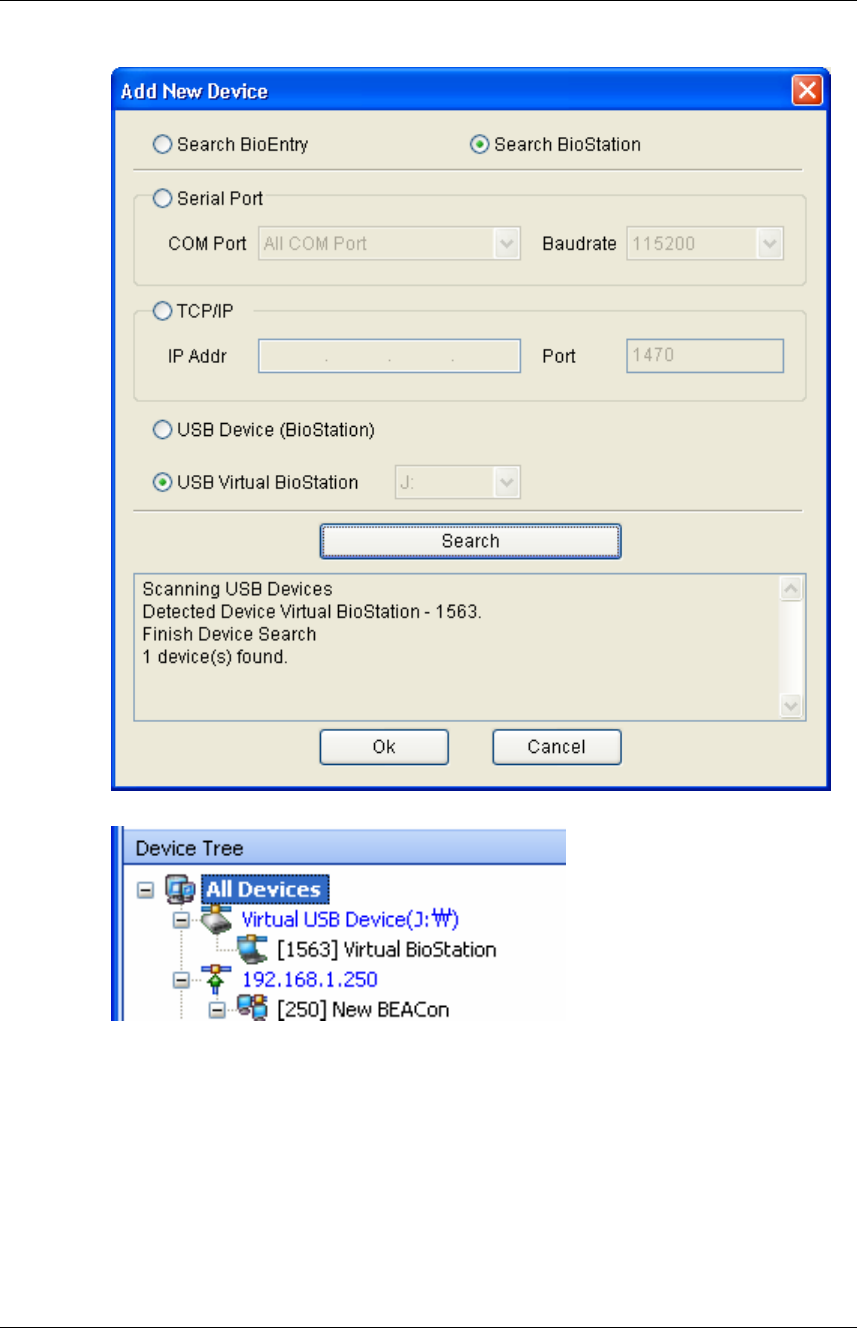
BioAdmin User Manual 145
Copyright © 2006, 2007 by Suprema Inc. http://www.supremainc.com
4.2. Add New BEACon
Searching and adding process of BEACon.
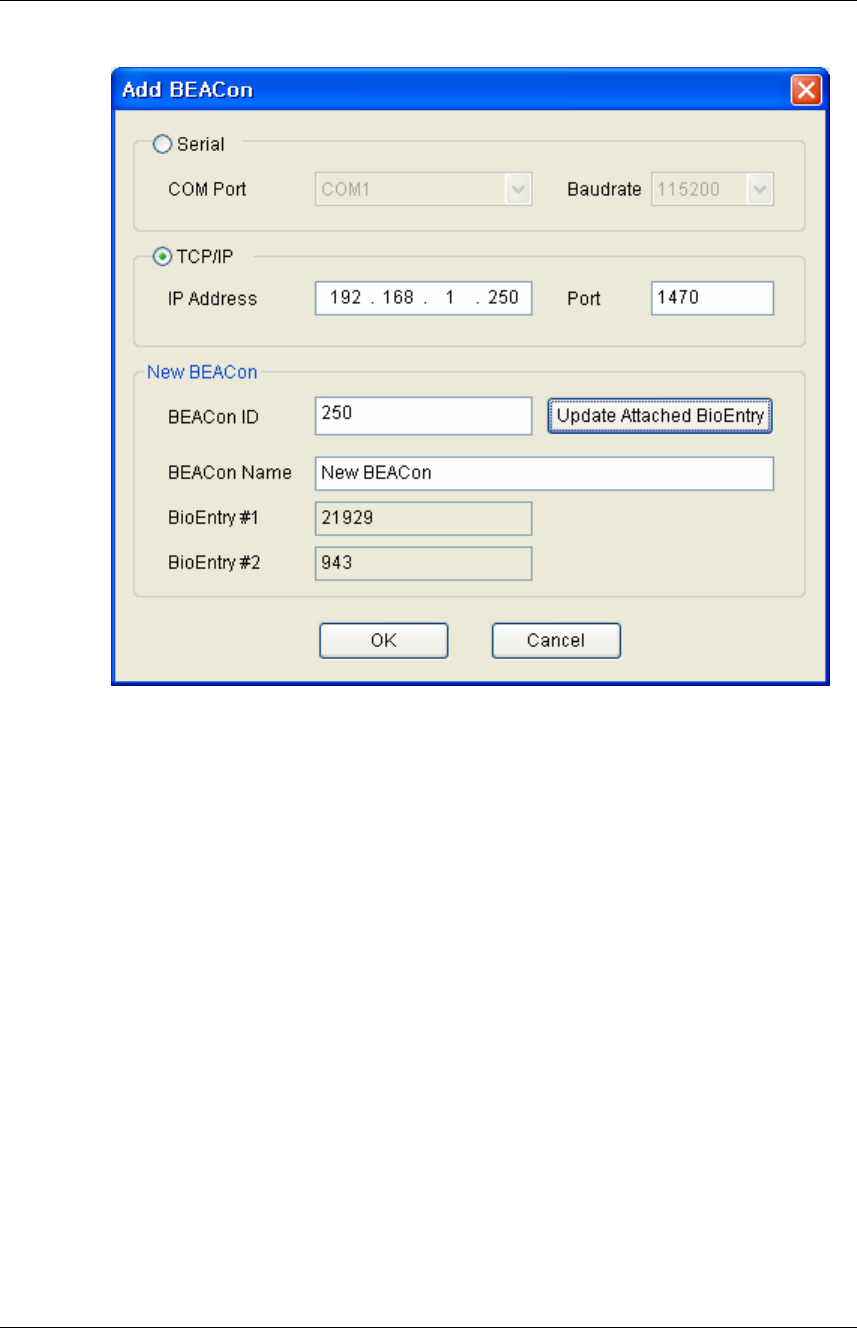
BioAdmin User Manual 146
Copyright © 2006, 2007 by Suprema Inc. http://www.supremainc.com
Detailed operations are as follows.
z Press the Add New BEACon button on the task box.
z Select the communication method between Serial and TCP/IP.
z In case of serial, set COM port and network baudrate and incase of TCP/IP,
input IP address of BEACon to add. For how to check IP address in BEACon,
refer to BEACon manual.
z Input BEACon ID to add in BEACon ID field. For how to check ID in BEACon,
refer to BEACon manual.
z Designate and input BEACon name in Name field.
z If you press update attached BioEntry button, it starts searching applicable
BEACon and linked BioEntry device.
z As a result of search, linked BioEntry ID is indicated in BioEntry #1 and BioEntry
#2 fields. In case of failing to search BEACon due to wrong input of IP address
or ID, none is indicated here.
z Press ok button to view searched BEACon and linked BioEntry on device list.
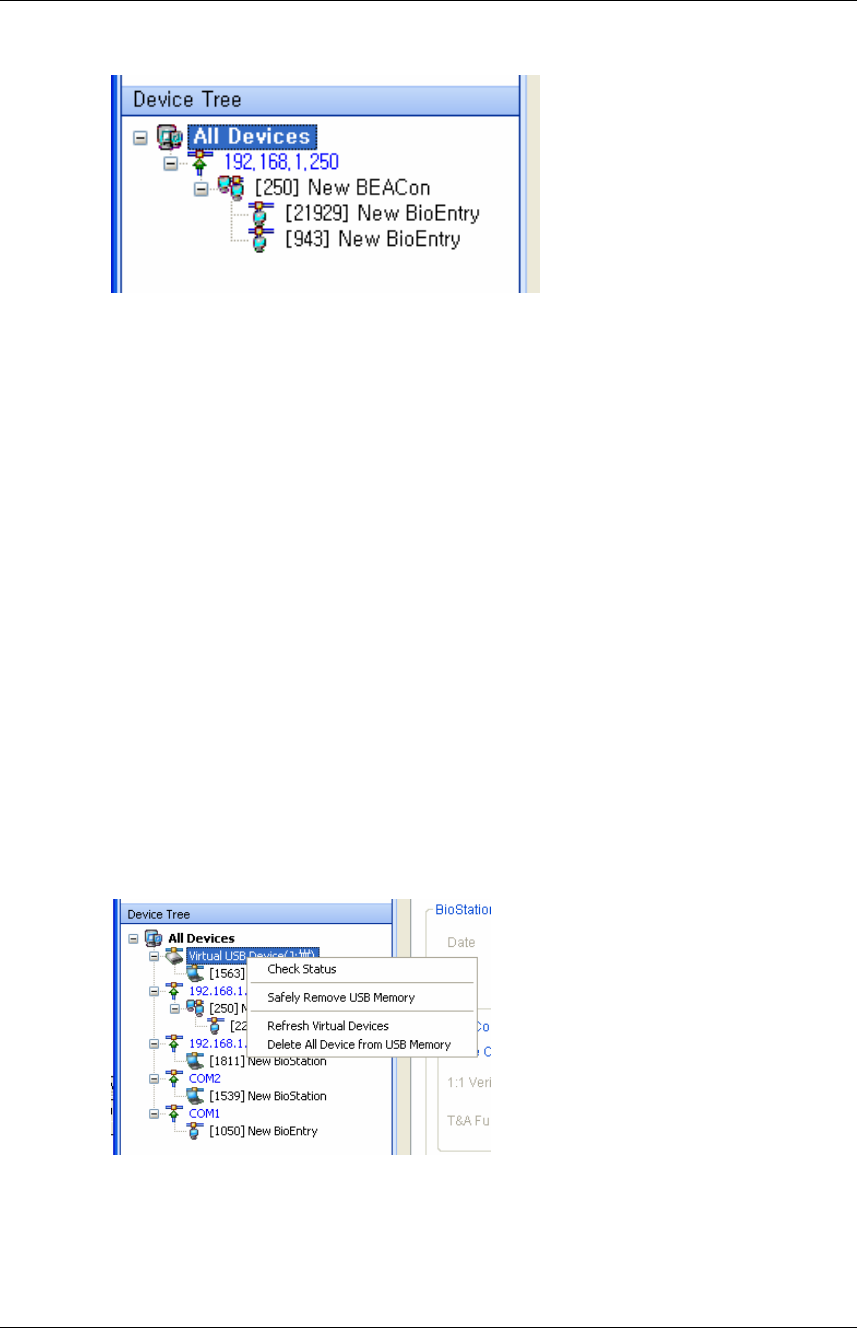
BioAdmin User Manual 147
Copyright © 2006, 2007 by Suprema Inc. http://www.supremainc.com
4.3. Remove device
z Select a device on task list and click Remove Device on task box to remove
the selected device. You can also remove a device by selecting a device on
device list and clicking a right button of the mouse.
z You can remove virtual terminal from the network by the following procedures.
Select a virtual terminal on the device tree and click the right button of your
mouse.
Safely Remove USB Memory: Click this menu to detach the virtual terminal
from your host PC after storing data on it. If you detach the virtual terminal
while storing or using data, it can cause a data loss from the virtual terminal
Delete All Device From USB Memory: Remove the data of all virtual
terminals from the USB memory. To use the USB memory again as a
virtual terminal, you need to register the USB memory as a virtual terminal.
Delete Device from USB Memory: Remove the data of the selected virtual
terminal from the USB memory.
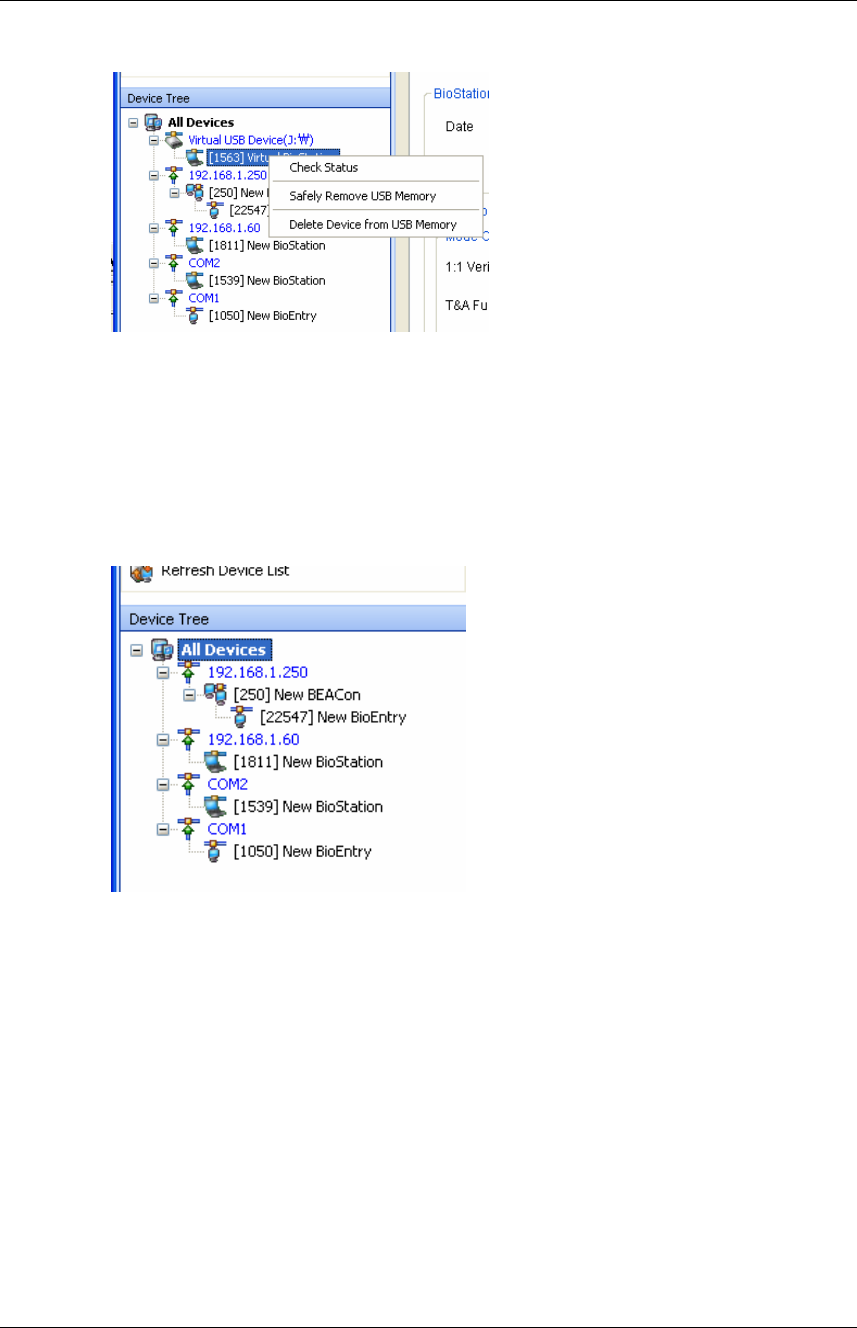
BioAdmin User Manual 148
Copyright © 2006, 2007 by Suprema Inc. http://www.supremainc.com
4.4. Check status
Device’s current status is classified by device icon on device list window.
z If a device is connected, icon is active.
z If a device is not connected, icon is inactive.
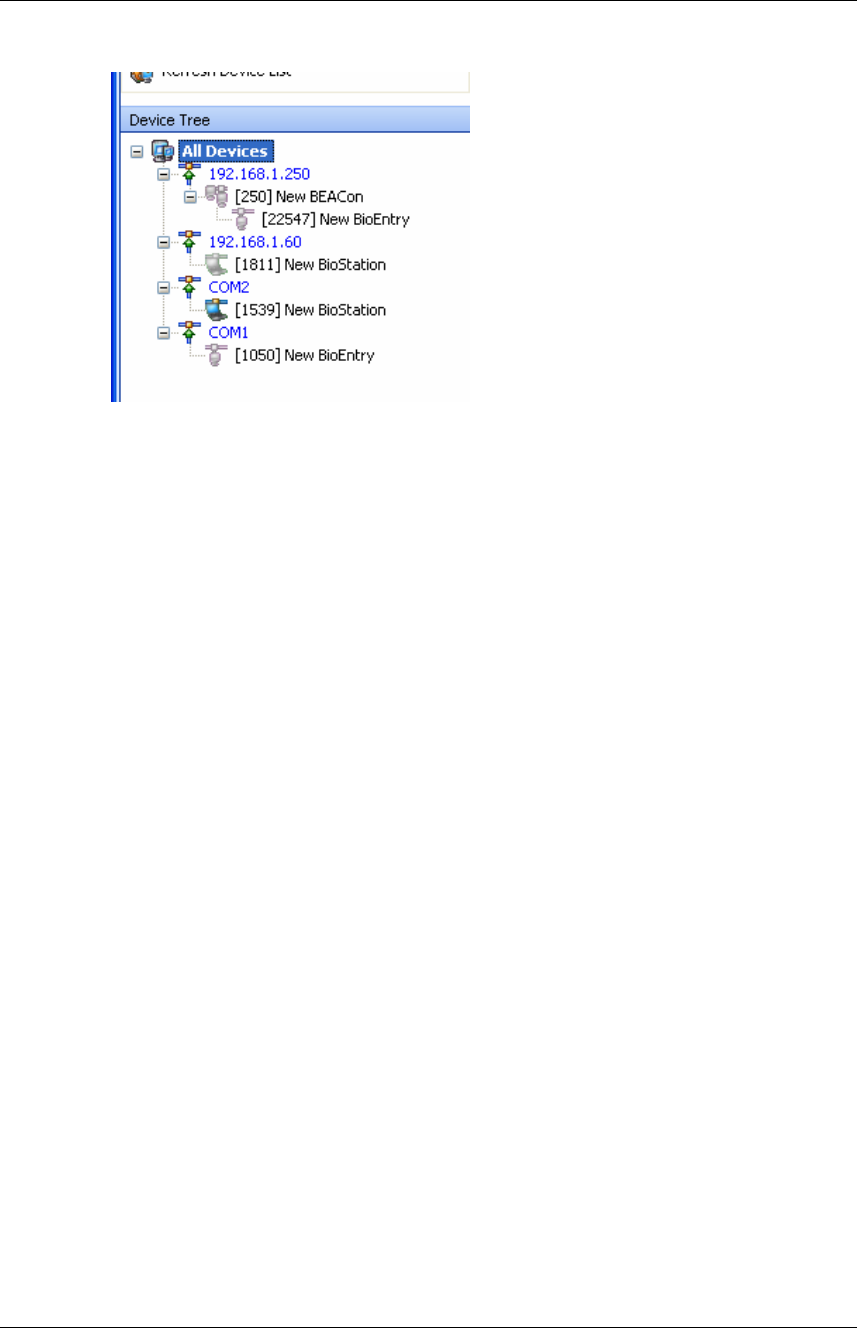
BioAdmin User Manual 149
Copyright © 2006, 2007 by Suprema Inc. http://www.supremainc.com
Status of each device is updated in case of the followings.
z When BioAdmin software starts
z When a device is selected anew
z When clicking check status menu
z When connecting BioStation to host PC via USB
4.5. Manage BioStation device
If you select BioStation on device list, the device setup window of selected
BioStation is updated on main window.
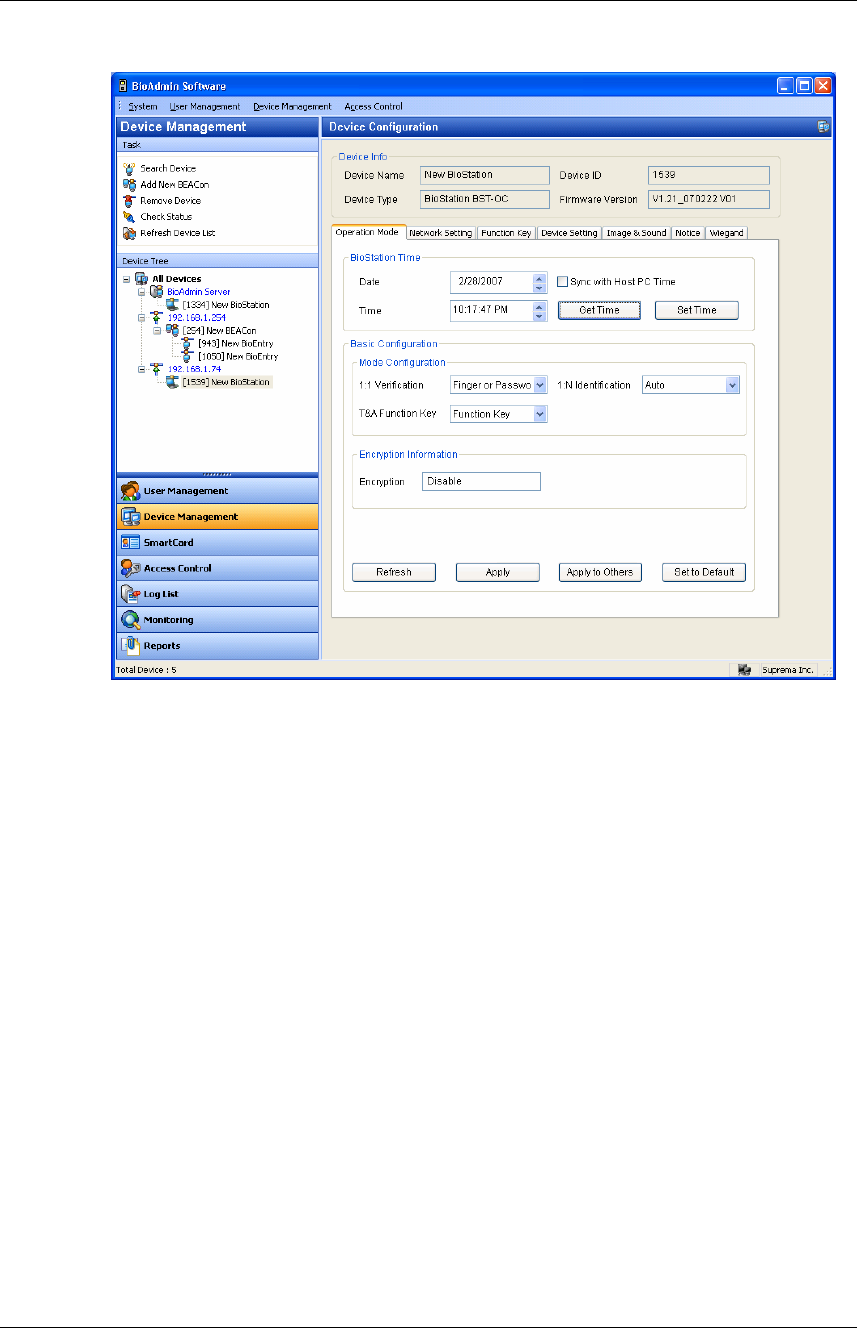
BioAdmin User Manual 150
Copyright © 2006, 2007 by Suprema Inc. http://www.supremainc.com
Device setup window is divided into 2 areas.
z Device information
Device information displays type, name, serial number and FW version of
selected device.
z Configuration window
Configuration window shows settings of selected BioStation device and enables
user to correct those settings. Configuration menu consists of separated tabs,
i.e. operation mode, network, setting, function key, device setting, image &
sound, and notice.
At lower part of configuration window are 4 buttons, i.e. refresh, apply, apply to
others and set to default.
Refresh : call device setting again.
Apply : apply corrected setting on the current window to device.
Apply to others : apply corrected setting on current window to another
device. Device can be selected on select device window.
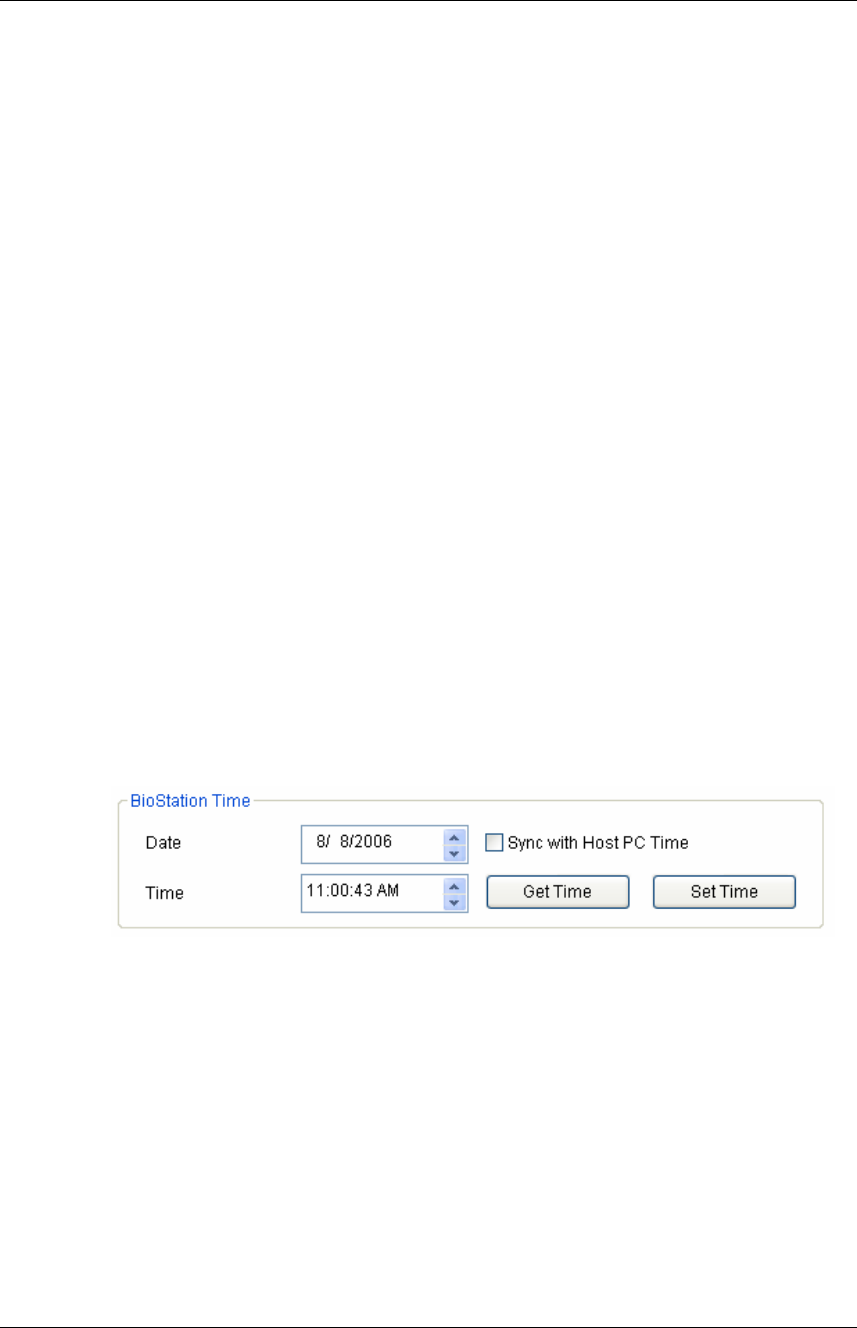
BioAdmin User Manual 151
Copyright © 2006, 2007 by Suprema Inc. http://www.supremainc.com
Set to default : change setting as default. To apply this value to device,
make sure to press apply button.
4.5.1. Device information
You can check device name, device type, device ID and firmware version of
selected BioStation. Device ID number and firmware version are necessary
information to check a product for technical support after installation.
4.5.2. Operation mode
z Time setting
Date and time shown first are those read from BioStation. If you click get time
button, it reads date and time from BioStation once again.
Method of BioStation time change is divided into direct input and
synchronization with current PC time.
Direct input : either input numbers directly in date and time window or place
a cursor on a number and click up/down arrow keys for input. Press set
time button after input to transfer input date and time to the selected
BioStation.
Synchronization with PC time : check sync with current PC time and set
time button, then selected BioStation time is set by current PC time.
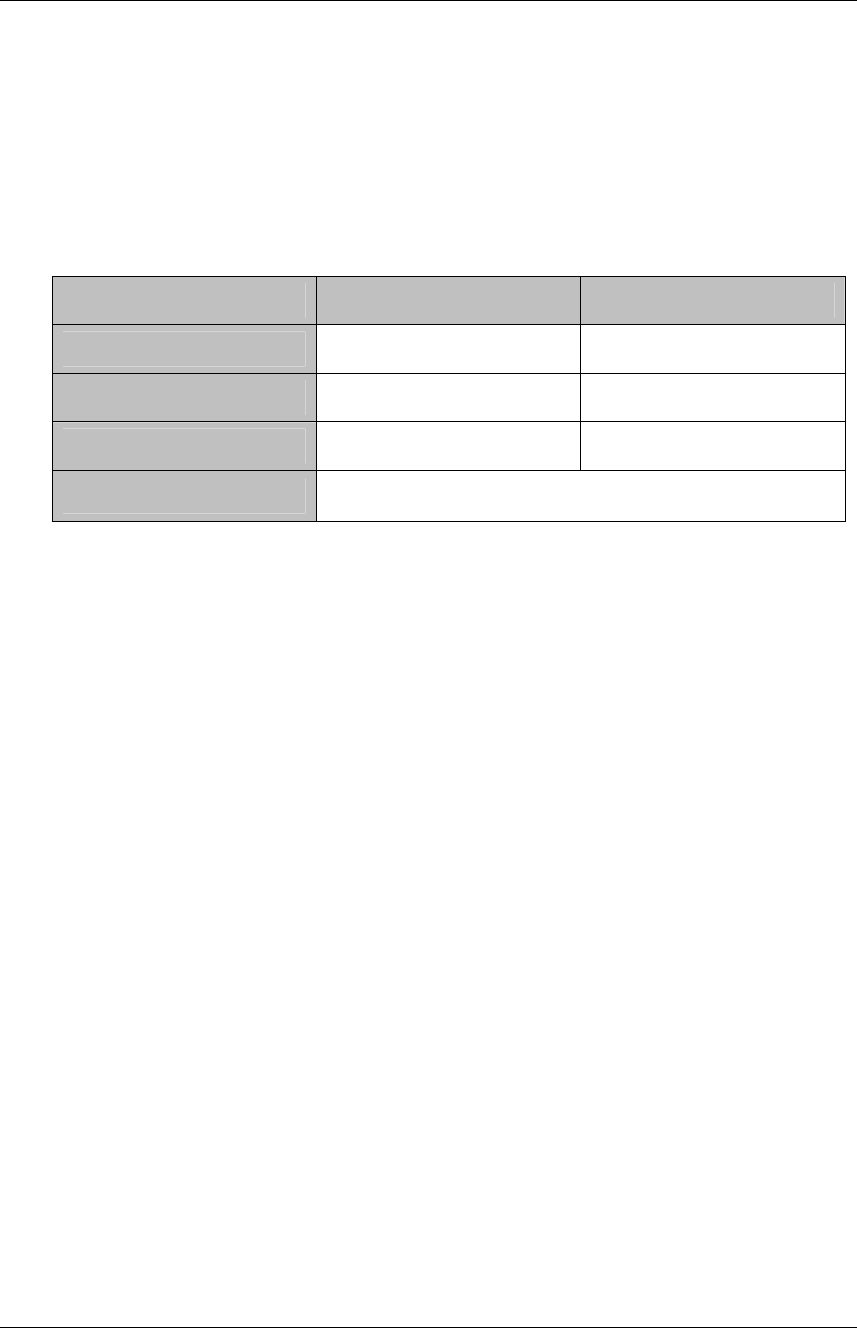
BioAdmin User Manual 152
Copyright © 2006, 2007 by Suprema Inc. http://www.supremainc.com
z Mode setting
1:1 verification : if you select 1:1 verification on BioStation, user ID should be
suggested first and then the user should authorized himself with his fingerprint
or password.
1:1 verification How to suggest User ID How to authorize
Finger or Password Enter User ID or Put the card Put finger or enter password
Finger Only Enter User ID or Put the card Put Finger
Password Only Enter User ID or Put the card Enter password
Card Only Put the card
Finger or Password : User should suggest his User ID by entering User ID on
the keypad or by putting his card to the BioStation RF. After
suggesting his User ID, user should verify himself with his
fingerprint or password.
Finger Only : User should suggest his User ID by entering User ID on the
keypad or by putting his card to the BioStation RF.
After suggesting his User ID, user should verify himself with his
fingerprint.
Password Only : User should suggest his User ID by entering User ID on the
keypad or by putting his card to the BioStation RF.
After suggesting his User ID, user should verify himself with
password.
Card Only : User can verify himself only by putting his card to the
BioStation RF.
1:N identification : in 1:N identification, user is authorized by fingerprint
without user ID input. About how to start fingerprint input, user can choose
one of 3 modes, i.e. auto, OK button and none. In auto mode, because
BioStation sensor is always on as standby mode, scan starts right after a
finger is placed on the sensor. If you choose OK button mode, place a
finger after pressing OK button on BioStation when entering fingerprint. In

BioAdmin User Manual 153
Copyright © 2006, 2007 by Suprema Inc. http://www.supremainc.com
case of not using 1:N mode but using 1:1 mode only, choose none mode.
T&A function key : T&A function key is to enter T&A event before entering
fingerprint for T&A control such as in, out, in duty, out duty. In BioStation,
usually from F1 to F4 function keys are used for this and, if necessary,
function key can be increased up to 16 keys. T&A key mode can be
chosen from function key mode and none mode. In case of using
BioStation for exclusive use of access control, choose none while in case of
using for T&A control, choose function key. Pressing T&A key on BioStation
first and then enter fingerprint to record applicable T&A event in a log. In the
future T&A software, this log information can be used for various T&A and
salary control data.
In case of changing settings such as various modes, changes are applied only
after apply button is pressed. For detailed explanation on buttons at lower part
of a window, refer to the previous page.
z Encryption Information
Encryption: if you use encrypted template, encryption is Enable.
4.5.3. Network setting
This window shows setup for various networks of a device. As per interface
methods, it is divided into LAN, serial, and USB.
z LAN
In network setup list box at upper part of a window, set whether or not to use
LAN and if yes, whether to use cable LAN or wireless LAN. Specify a port as
1470.
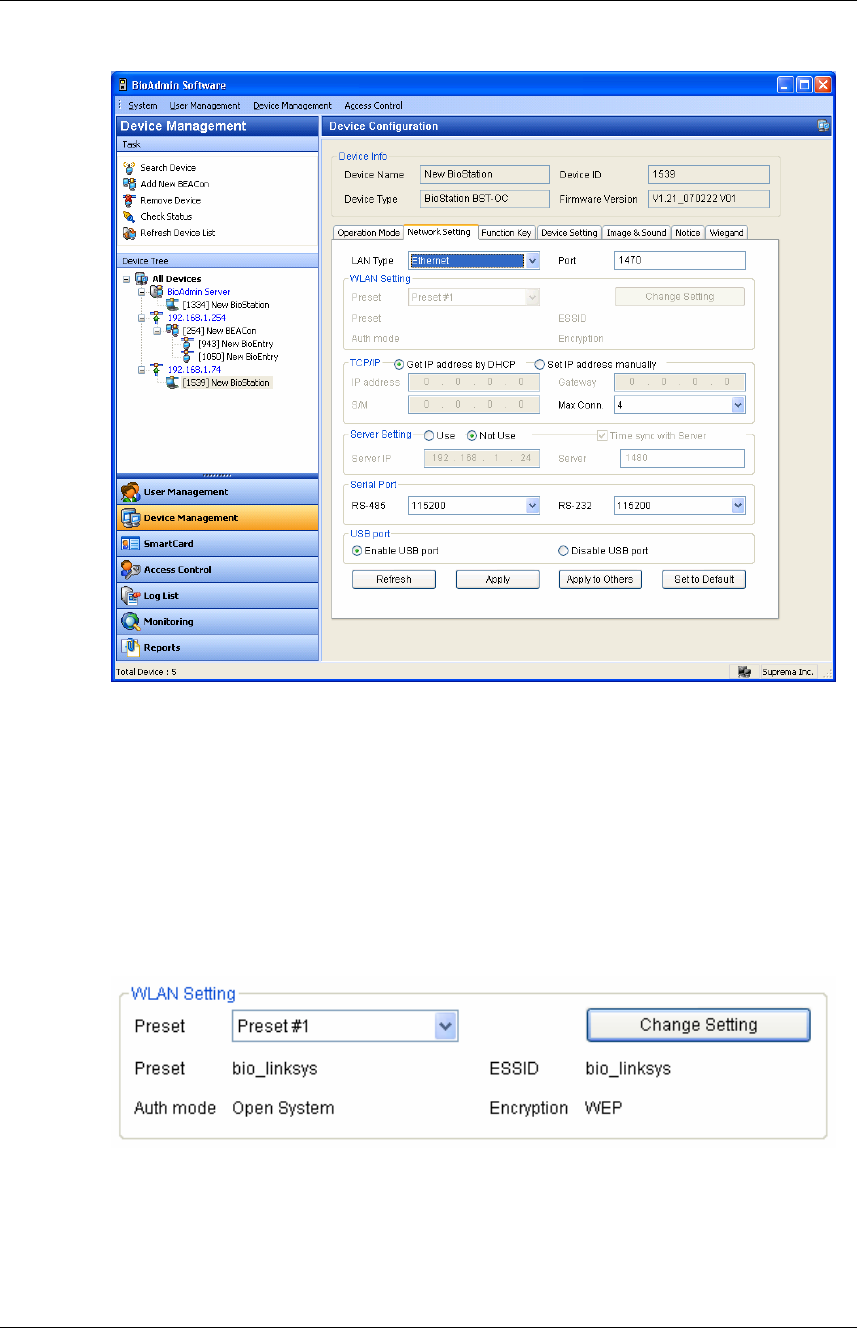
BioAdmin User Manual 154
Copyright © 2006, 2007 by Suprema Inc. http://www.supremainc.com
z Setup wireless LAN
To setup the wireless network, you need the following procedures.
First, you need an access point. Each access point has its own SSID, and, in
some cases, it use the data encryption. BioStation supports WPA_PSK and
WEP as the data encryption methods. Refer to the manual of your access point
device and check whether it is using the data encryption. If yes, you need to
check the type of the data encryption.
Preset: To activate the wireless network, you should select one of the 4
preset. Of course, you can not use the wired LAN upon using wireless LAN
function.
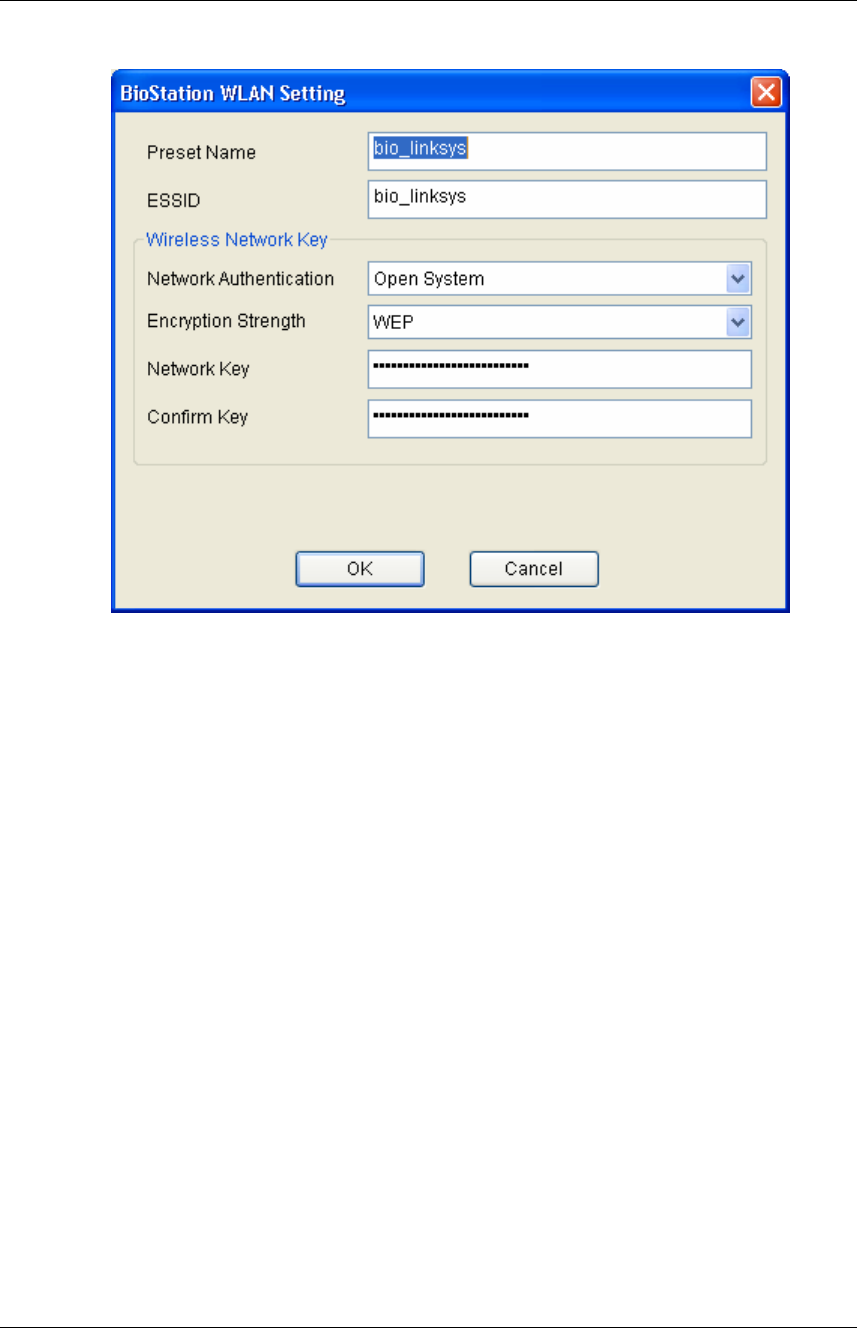
BioAdmin User Manual 155
Copyright © 2006, 2007 by Suprema Inc. http://www.supremainc.com
Preset Name: preset name is displayed on the BioStaiton using WLAN
setting.
ESSID: ESSID is the unique ID of the access point. To check the ESSID of
your access point, refer to the manual of your access point or ask your
network administrator.
Auth mode: You can select the network authentication open system,
shared key and WPA-PSK. It must have same setting to authentication of
access point. You can see this setting on security page in access point
setup application.
Encryption Strength: You can select the encryption strength between WEP
and WPA-PSK. By selecting WEP or WPA-PSK, you can encrypt the
communication data between access point and BioStation.
If the BioStation is too far from the access point, or there is an obstacle
between BioStation and access point, the network can be interrupted. Also,
the wireless network may not be successful due to the unique
characteristics of the access point. Thus, it is highly recommended to have
another network method rather than wireless LAN.
z Setup cable LAN

BioAdmin User Manual 156
Copyright © 2006, 2007 by Suprema Inc. http://www.supremainc.com
In BioStation settings, choose whether to get IP address automatically or set
manually.
In case that IP address is automatically assigned to DHCP in BioStation, check
‘get IP address automatically’. In case of not using DHCP, check ‘set IP address
manually’ and set IP address, gateway, subnet mask and DNS. Changing LAN
setting like this is required to set IP address in order to connect Serial or USB
linked BioStation by LAN or to change IP address of BioStation connected by
LAN to another address.
Max Conn means the maximum number of host PCs. Server-Client application
is available only when the system is networked through Ethernet. If the system
operates as server-client, users can operate the BioAdmin Client program from
multiple host PCs. However, if the system is not operated as BioAdmin Server-
BioAdmin Client but connected just as normal Ethernet, there will be a limit to
the maximum number of host PCs to operate BioAdmin at the same time. For
example, if you select this menu as 4, you can operate the BioAdmin program
on 4 host PCs at the same time.
z Server Setting
This menu shows that the BioStation is connected to the server.
You can connect the BioStation to the server by checking on Use option and
entering the server IP and server port.
If you connect a BioStation to the server, existing Ethernet connection of the
BioStation is disconnected and the BioStation is connected to the server. It
may take a few minutes to reconnect to the server depending on the network
condition.
If you check on the Time sync with Server menu, the time of BioStation will be
automatically set as the time of the server.
If the network between a BioStation and BioAdmin Server is not stable, you can
reconnect the BioStation to the server. Select the BioAdmin Server on the
device tree window of Device Management menu and press the right button of
your mouse. Press the Reconnect Server menu. You can also find this
Reconnect Server menu on the System menu of Command Menu Bar.

BioAdmin User Manual 157
Copyright © 2006, 2007 by Suprema Inc. http://www.supremainc.com
z Serial
Set baudrate of BioStation’s RS485, RS232 ports. Default is 115,200 bps. As to
serial, in case of any trouble in condition of cable, lowering baudrate can be a
solution.
z USB connection
Select whether or not to allow connection with host PC via USB port of
BioStation. As USB port is exposed to outside, in some cases, connection is not
allowed for security reason.
4.5.4. Function key
Function key is to input T&A event before fingerprint input for T&A control such as
in, out, in duty or out duty. In BioStation, usually, function keys from F1 to F4 are
used and if necessary, it can be increased up to 16 keys. Pressing function key on
BioStation first and then enter fingerprint to record applicable T&A even in a log. In
the future T&A SOFTWARE, this log information can be used for various T&A and
salary control data.
In respect of function key in BioAdmin software, reference needs to be made to all
explanations on T&A event rule in both device management menu and report
menu.
Function key setting in device management menu is to set T&A event message
shown on BioStation display whereas T&A key setting in repot menu is to set T&A
event message applied when creating T&A report. In BioStation log, actual T&A
event message is not recorded but the number of pressed T&A key is recorded.
BioAdmin reads this value, refers to the table between previously defined function
key and T&A event and generates suitable T&A report. Thus, function key set in
this chapter doesn’t show in an actual BioAdmin report or upon log check.
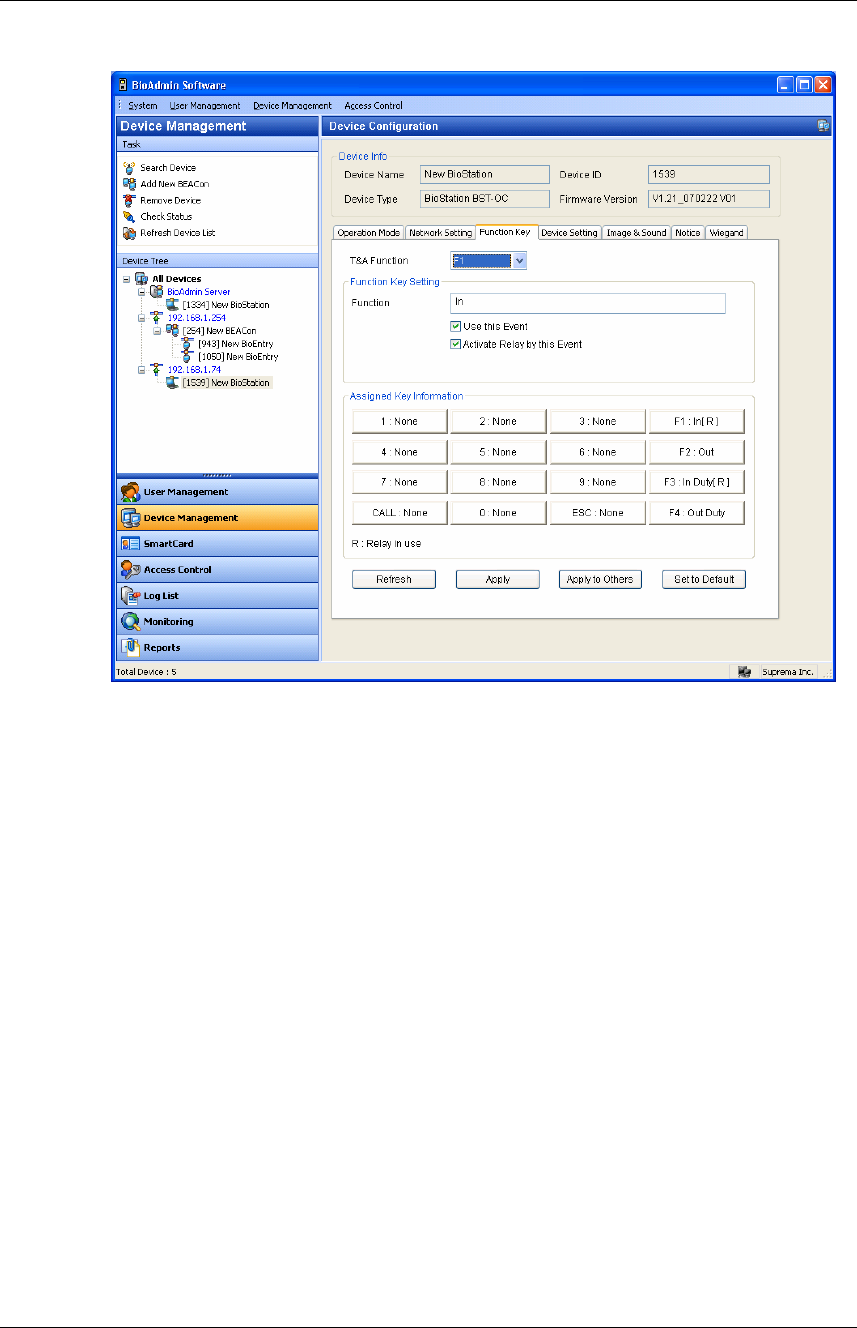
BioAdmin User Manual 158
Copyright © 2006, 2007 by Suprema Inc. http://www.supremainc.com
Set 16 keys in device and choose one out of 16 function keys to check function key
event message displayed on BioStation LCD, use of this function key and relay
use.
Choose a function key to set.
Enter event name in function field.
Decide whether or not to check use this event.
Decide whether or not to check activate relay by this event. Relay is
usually linked to door lock control device and used to open/close a door.
4.5.5. Device Setting
This window is to check and change various settings of BioStation
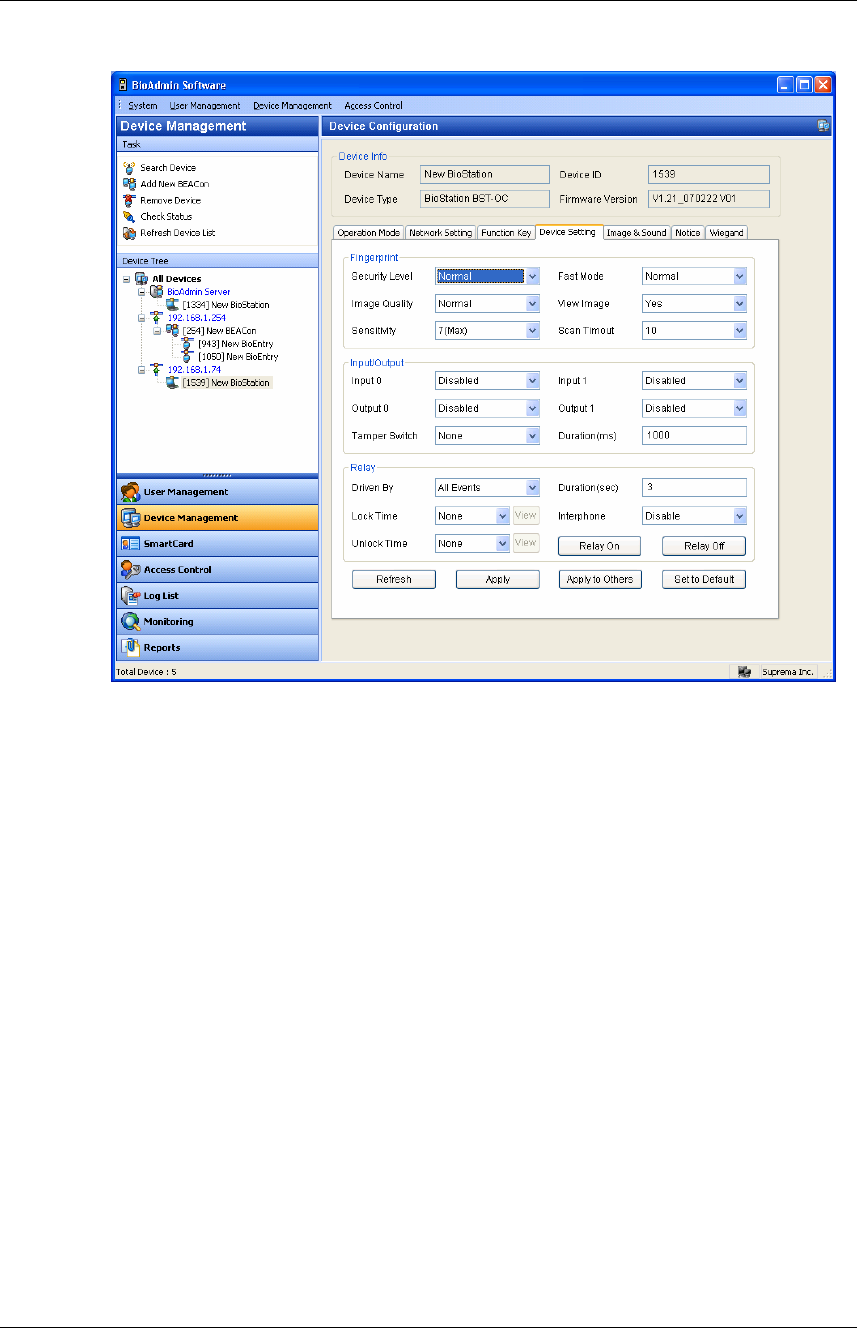
BioAdmin User Manual 159
Copyright © 2006, 2007 by Suprema Inc. http://www.supremainc.com
z Security level
Security level can be chosen among normal, secure, and most secure.
Internally security level adjusts FAR(False Acceptance Ratio). As FAR and
FRR(False Rejection Ratio) are in inverse proportion to each other, the higher
security level is the more FRR increases, so does FRR. Default is normal.
z Image quality
Decide standards by which the quality of input fingerprint image is over certain
level. You can choose from weak, normal, and strict. Default is normal.
z Sensitivity
Sensitivity decides sensitivity of detecting a finger. In high sensitivity, finger input
is accepted more easily but if sensitivity is lowered, input fingerprint image gets
more stable as fingerprint is captured only when fingerprint covers more than a
certain part of a finger. In case of optical model, sensitivity can be moderated by
lowering setting of sensitivity against the rays of the sun. Default is 7 (Max)
z Fast mode
In case more than hundreds fingerprints are saved in device, 1:N mode may
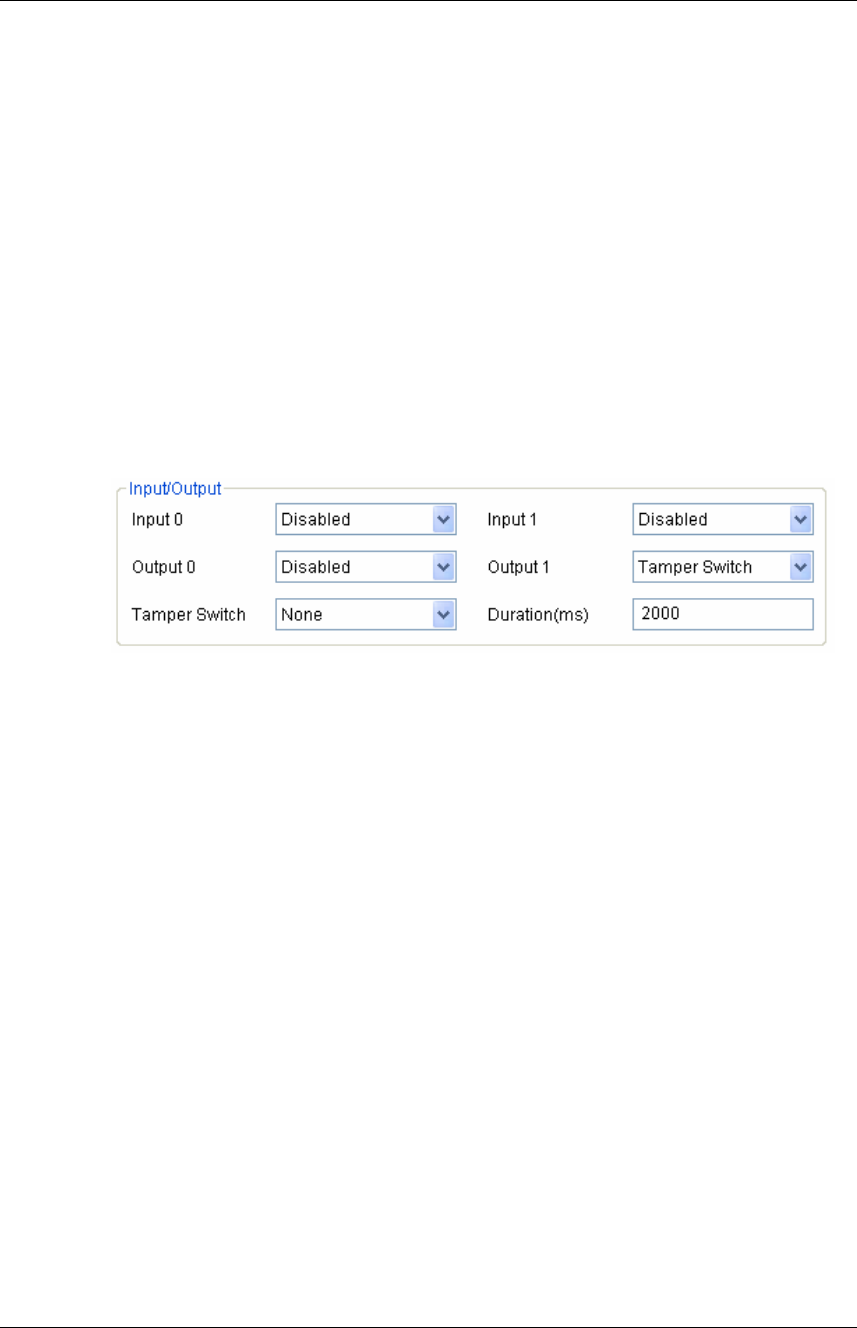
BioAdmin User Manual 160
Copyright © 2006, 2007 by Suprema Inc. http://www.supremainc.com
take longer. If you set fast mode as fast or fastest, performance is somewhat
low but 1:N recognition can take less time. Default is normal.
z View image
User can choose either to yes or no to view or hide input fingerprint image on
LCD display of BioStation. Default is yes.
z Scan timeout
User can designate the standby time when entering fingerprint. If a user doesn’t
enter fingerprint within this time, it is construed as input failure. Default is 10 sec.
z Input/Output setting
BioStation provides 2 respectively programmed input and output which can be
connected to external device. In input/output menu, set input/output port.
Input port setting : 2 ports of input 0 and input 1. Choose from exit switch
and disabled.
Output port setting : 2 ports of output 0 and output 1. Choose from duress,
tamper switch, authentication success, authentication failure, and disabled.
Signal output time of output port can be set in msec unit.
Tamper switch : in case BioStation case is open, choose whether or not to
set system lock mode for security reason.
BioStation relay setting (driven by) : user can change relay setting in
BioStation. Choose from all events, selected events and disabled. In case
of all events and selected events, user can set door open time.
Open time/close time : door open time and close time can be set
separately by day / holiday group. It should be set in advance in time zone
setting on access control menu.
Duration (sec) : relay running time as per set event. Once door is released,
door can be locked again after set door open time.
Interphone: Enable this option when you are using a interphone along with
BioStation.
Relay On / Off : Administrator can control the relay of the BioStation by
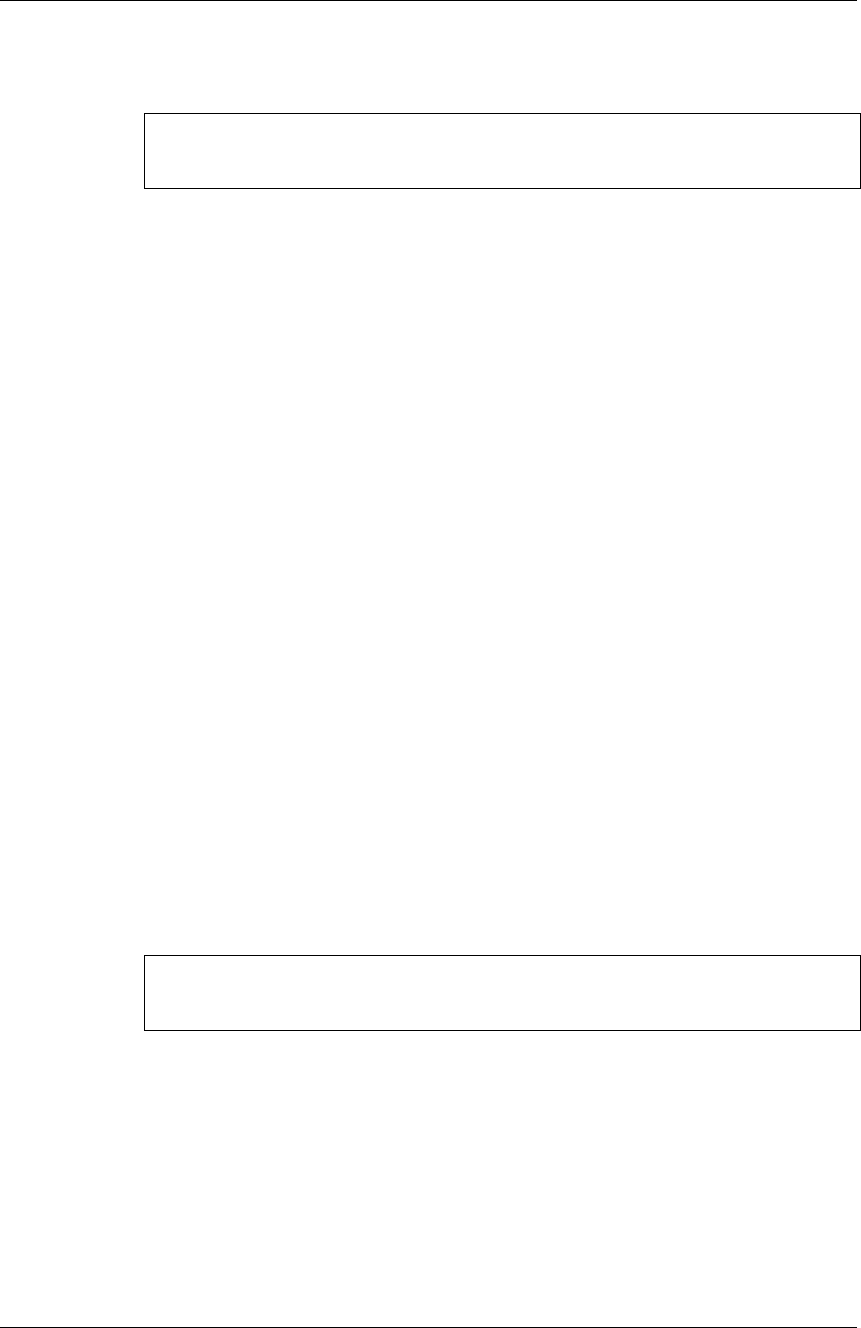
BioAdmin User Manual 161
Copyright © 2006, 2007 by Suprema Inc. http://www.supremainc.com
using this Relay On/Off menu.
Note : overall system door open time is computed by adding door lock open
time and device open time.
4.5.6. Image & sound
Menu to set background, sound effects and other display/sound of BioStation. User
can set desired background, notice and log image and also change sound effect fit
for user’s style.
z Change background
In this menu, user can change background image of BioStation. BioStation
background can be chosen from logo image, slideshow, and notice. Image file
format which can be uploaded to background are varying, i.e. JPG, GIF, BMP
and PNG but size is fixed as 320*240 pixels. In case the size of image file to
upload is different, adjust image size using graphic tool.
In background, user can choose and upload one image file as background of
logo image and notice. As for slideshow, maximum 16 image files can be
uploaded and it shows images in turn at a set interval.
z Change sound effects
In this menu, user can change sounds of device or check current sound effects.
Sound effects of device consists of 6 sounds in total, i.e. start sound when
device is turned on, button sound when pressing a button, scan success sound
when finger scan is successful, question sound when pressing a ESC button,
error sound when finger scan failed, detect finger sound when a finger is placed
on fingerprint sensor.
Note : the size of sound file can’t exceed 512KB and sounds may not change
depending on the format of the file.
z Display/sound setting
Language : choose language used for menu and various messages on
BioStation LCD display. Language can be chosen from Korean, English
and Custom.
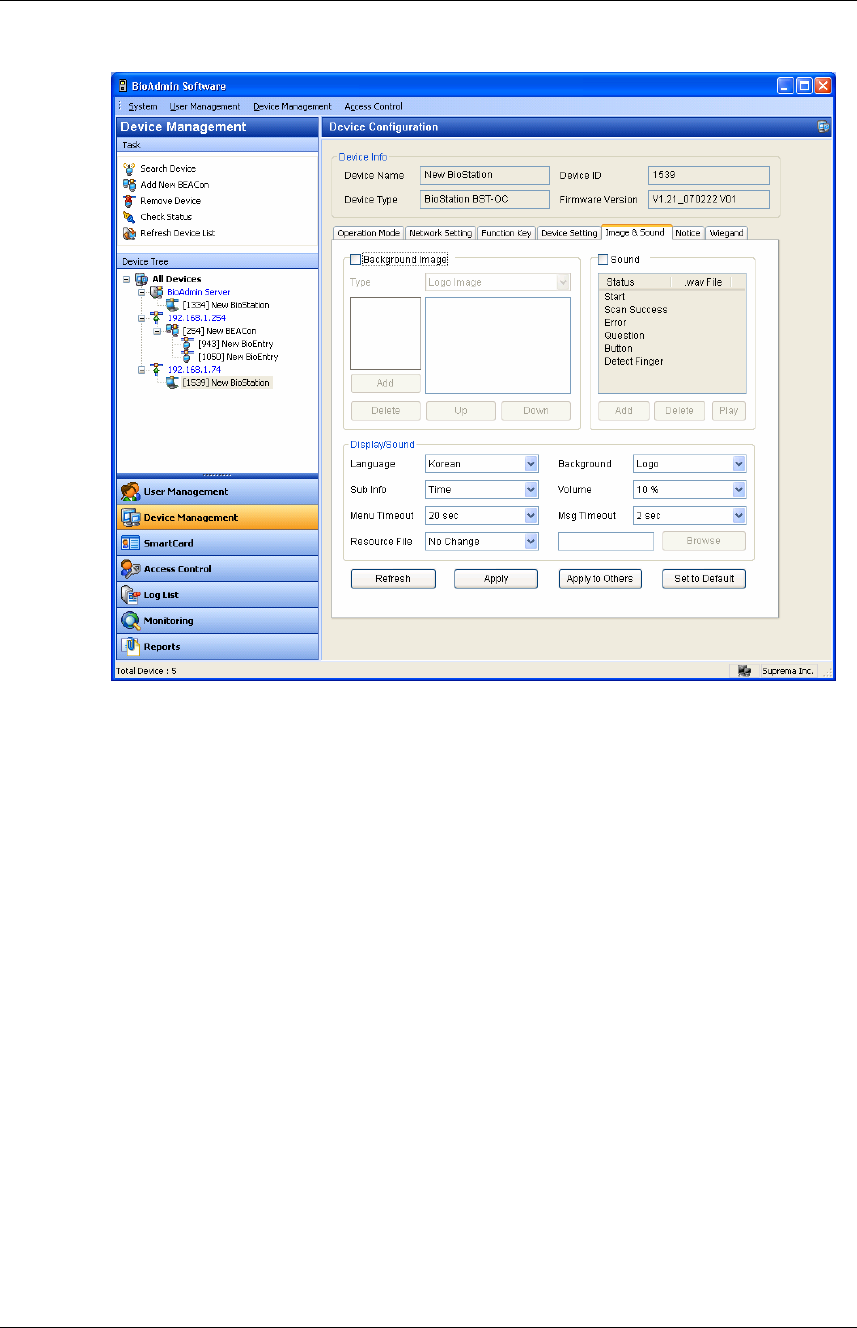
BioAdmin User Manual 162
Copyright © 2006, 2007 by Suprema Inc. http://www.supremainc.com
Sub information : set items displayed at the lower part of BioStation
background. Choose from notice, time, and none. In case of notice,
contents are scrolled from right to left on display. Default is time
Menu timeout : if no input is made in a certain menu for a set time, it
returns to initial page. Choose from infinite, 10 sec, 20 sec, 30 sec. Default
is 20 sec.
Resource file : choose from English, Korean, Custom, no change.
Select language to change, click browse and choose applicable
configuration file(*.rc) after changing configuration file, reset BioStation to
apply and select applicable language on language select menu to view.
Background : Choose from logo, notice and slideshow as background of
BioStation LCD display.
Volume : to adjust speaker volume of BioStation. Volume ranges from 0 to
100%. When using daily in normal situation, set a volume as 20-50%.
Default is 20%.
Msg Timeout : When a user matches his fingerprint, BioStation shows the
success or fail message on its screen. Administrator can change the time

BioAdmin User Manual 163
Copyright © 2006, 2007 by Suprema Inc. http://www.supremainc.com
during which those messages are shown on the BioStation. Default is set
as 2 seconds.
4.5.7. Notice
If there’s company notice, administrator can show the notice on LCD of BioStation.
Notice can be input up to maximum 1024 byte and a number of letters varies
depending on language.
After transferring notice to device by pressing apply button, you can check and
view notice on LCD of BioStation only if you selected notice as background in
display/sound menu and apply.
4.5.8. Wiegand Setting
The Wiegand Setting tab is used to manage the Wiegand input/output format of
BioStation. By selecting the menu, the Wiegand setting page is updated on the
main window.
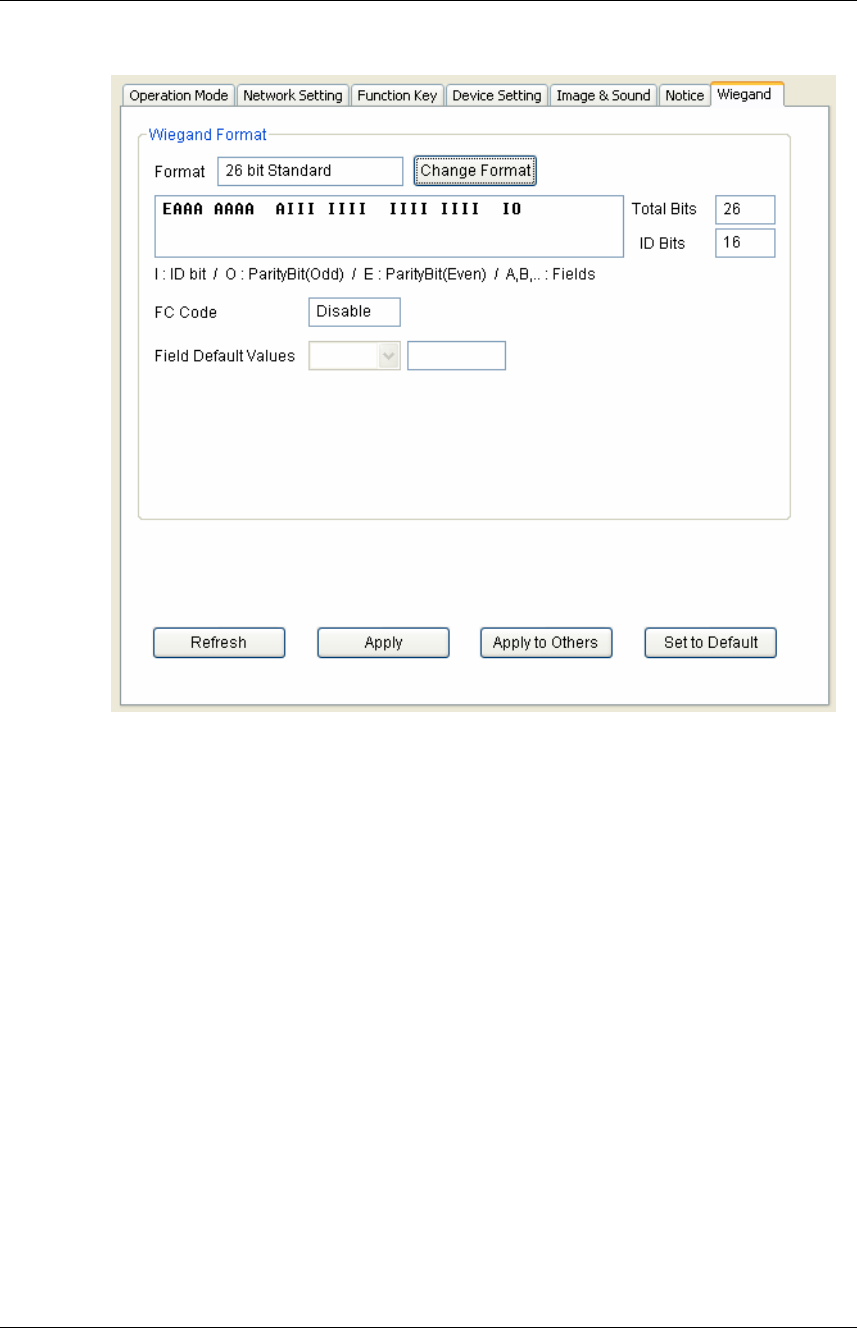
BioAdmin User Manual 164
Copyright © 2006, 2007 by Suprema Inc. http://www.supremainc.com
z Wiegand Format
New Wiegand format can be configured graphically using the Wiegand
Configuration wizard. The Wiegand Configuration wizard will be shown by
pressing the Change format button.
z Select format
You should select one of the three supported formats in the first page.
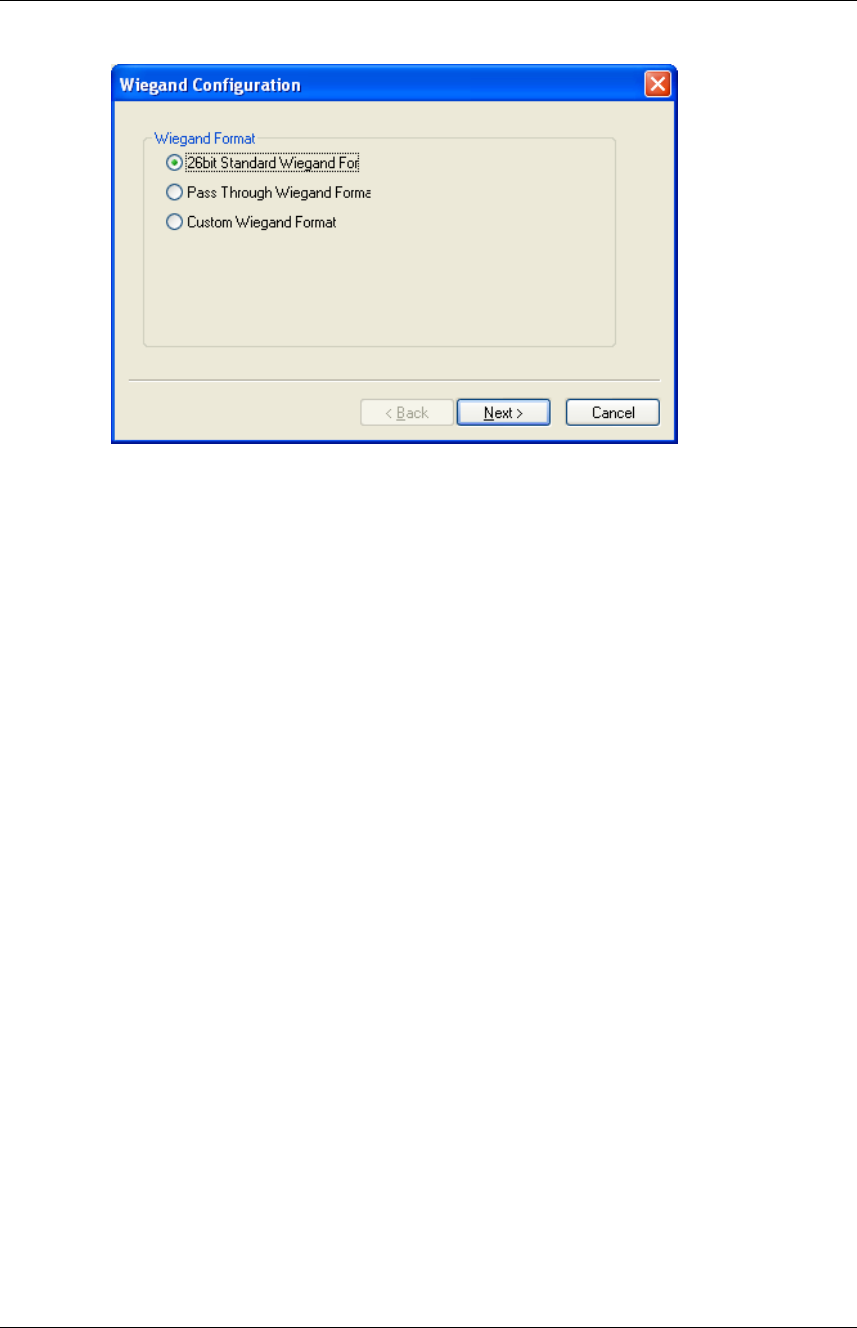
BioAdmin User Manual 165
Copyright © 2006, 2007 by Suprema Inc. http://www.supremainc.com
26 bit standard
The 26 bit standard format is most widely used and consists of 8 bit FC code and
16 bit ID. You cannot change the bit definition and the parity bits in 26 bit standard
format.
Pass Through format
Pass Through format is used when only the format of ID field is known. When the
Wiegand input string is detected, BioEntry device extracts ID bits and starts
verification with the ID. If the verification succeeds, the device outputs the Wiegand
input string as unchanged. Parity check and advanced options are ignored in this
format. By definition, Pass Through format is only useful when the operation mode
is 1:1. If the mode is 1:N, the bits other than ID field are set to 0.
For example, assume that 32 bit Pass Through format is composed as follows:
XIIIIIII IIIIIIIX XXXIIIII IIIIIIIX (left most bit is 0th bit, BIT0)
I: Id field, X: Unknown field
You can configure this format in the following sequences.
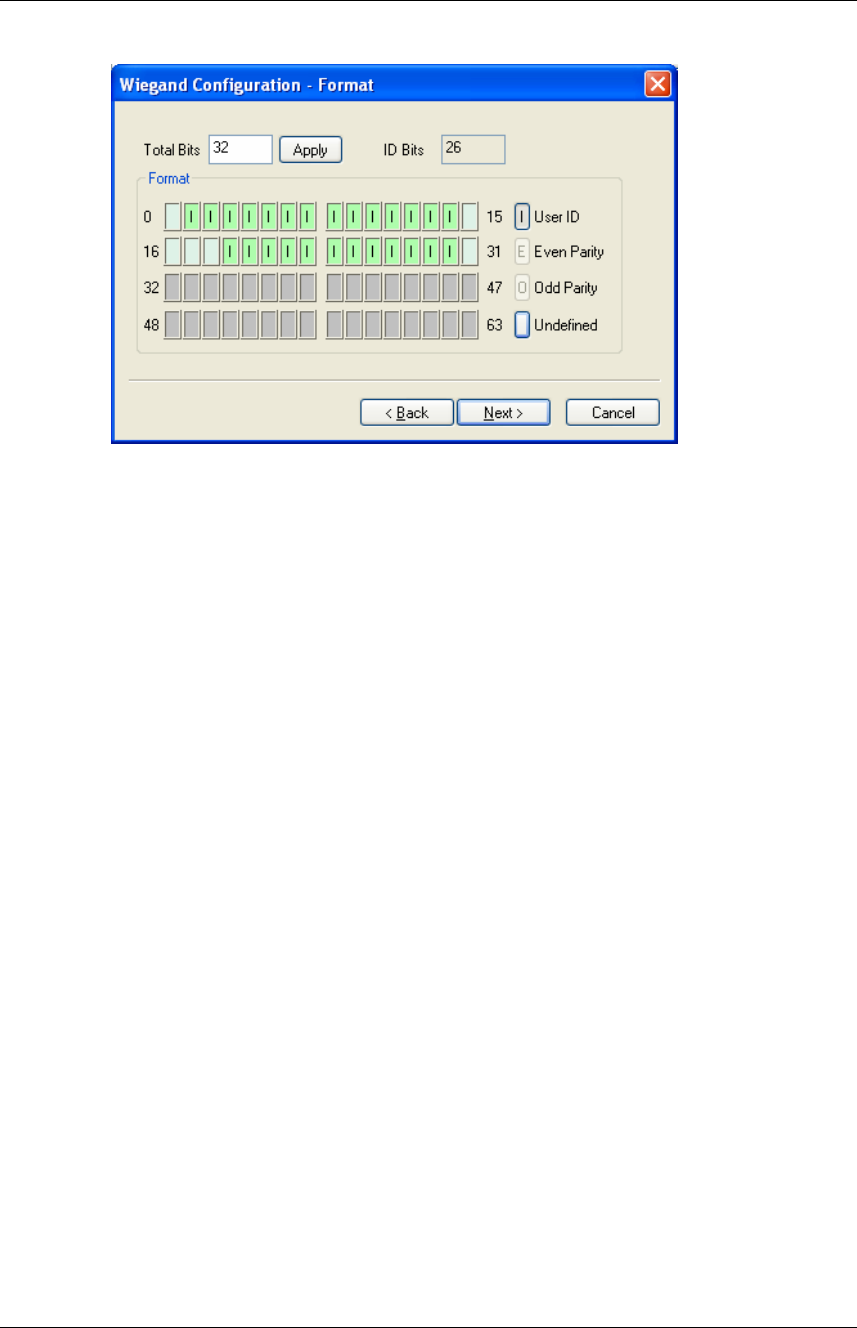
BioAdmin User Manual 166
Copyright © 2006, 2007 by Suprema Inc. http://www.supremainc.com
(1) Enter 32 in the Total Bits field.
(2) Select ID bits according to the definitions.
(3) Press Next. You cannot specify parity bits in Pass Through mode.
Custom format
When users know all the information of a Wiegand format, Custom format can be
defined. When a Wiegand input string is detected, BioEntry device checks the parity
bits first. If all the parity bits are correct, the device extracts ID bits and starts
verification with the ID. Users can also set alternative values of each field and
enable advanced options such as Fail ID. If the verification succeeds, the device
outputs a Wiegand string. The output string may be different from the input string
according to the alternative values and advanced options.
For example, assume that 44 bit Custom format is composed as follows:
EAAAAAAA IIIIIIII IIIIIIII BBBBBBBI IIIIIIII IIIO
(left most bit is 0th bit, BIT0)
E: Even parity for BIT1 ~ BIT22
O: Odd parity for BIT23 ~ BIT42
I: ID bits(Field1 and Field 3), A: Field 0, B: Field 2
You can configure this format in the following sequences.
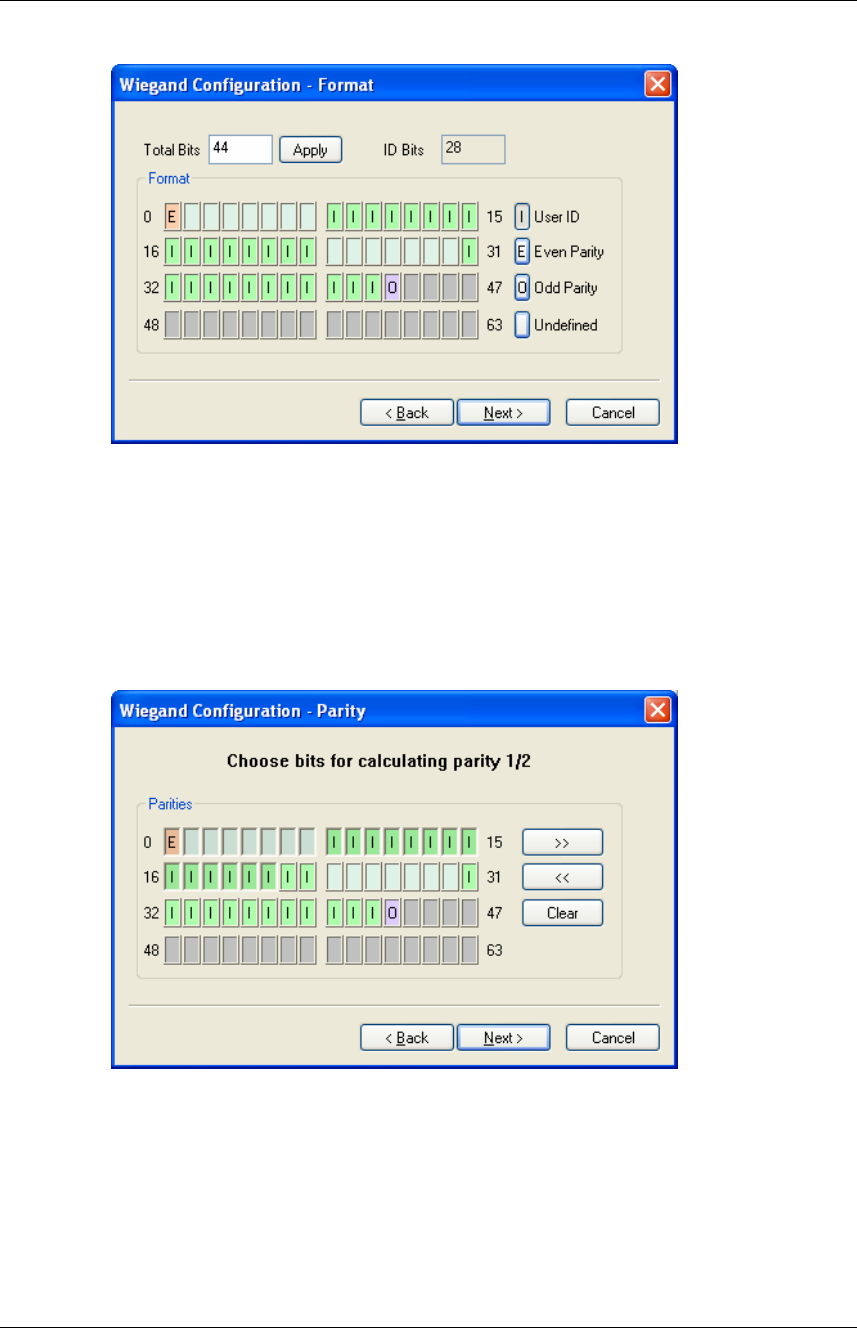
BioAdmin User Manual 167
Copyright © 2006, 2007 by Suprema Inc. http://www.supremainc.com
Enter 44 in the Total Bits field.
Select Even Parity.
Press the even parity bit. In this example, it is BIT0.
Select Odd Parity and press the odd parity bit and User ID according to the
definition.
Press Next.
Press the bits which are used in calculating the first parity bit. In this example, they
are BIT1 ~ BIT22
Press >>.
Press the bits which are used in calculating the second parity bit. In this example,
they are BIT23~ BIT42.
Press Next.

BioAdmin User Manual 168
Copyright © 2006, 2007 by Suprema Inc. http://www.supremainc.com
z Alternative values
In 26 bit standard you can specify alternative FC code. In Custom format, you
can specify alternative values for non-ID field. If alternative values are set, the
BioEntry™ device will replace corresponding fields with these values before
sending outputs.
4.6. Manage Virtual Terminal
You can manage a virtual terminal with the same device management menus for
BioStation, except the followings.
z Time Setting : You can not set the time of BioStation with virtual terminal. Thus,
you should set time directly to BioStation.
z Lock all devices / Unlock all devices : You can not set lock/unlock of BioStation
with virtual terminal. Thus, you should the lock/unlock directly to BioStation.
z Firmware Upgrade : Store a firmware file on a virtual terminal. Connect the
virtual terminal to BioStation and upgrade the firmware using firmware upgrade
menu on BioStation.
After connecting a virtual terminal to BioStation, you can use the following menus of
BioStation. For the detailed operation, refer to the BioStation User Guide.
z Synchronize : Change the user data and device settings of BioStation as same
as the stored data on virtual terminal .
z Export Virtual Terminal : Remove the stored data on virtual terminal and make a
new virtual terminal with the current data of the BioStation.
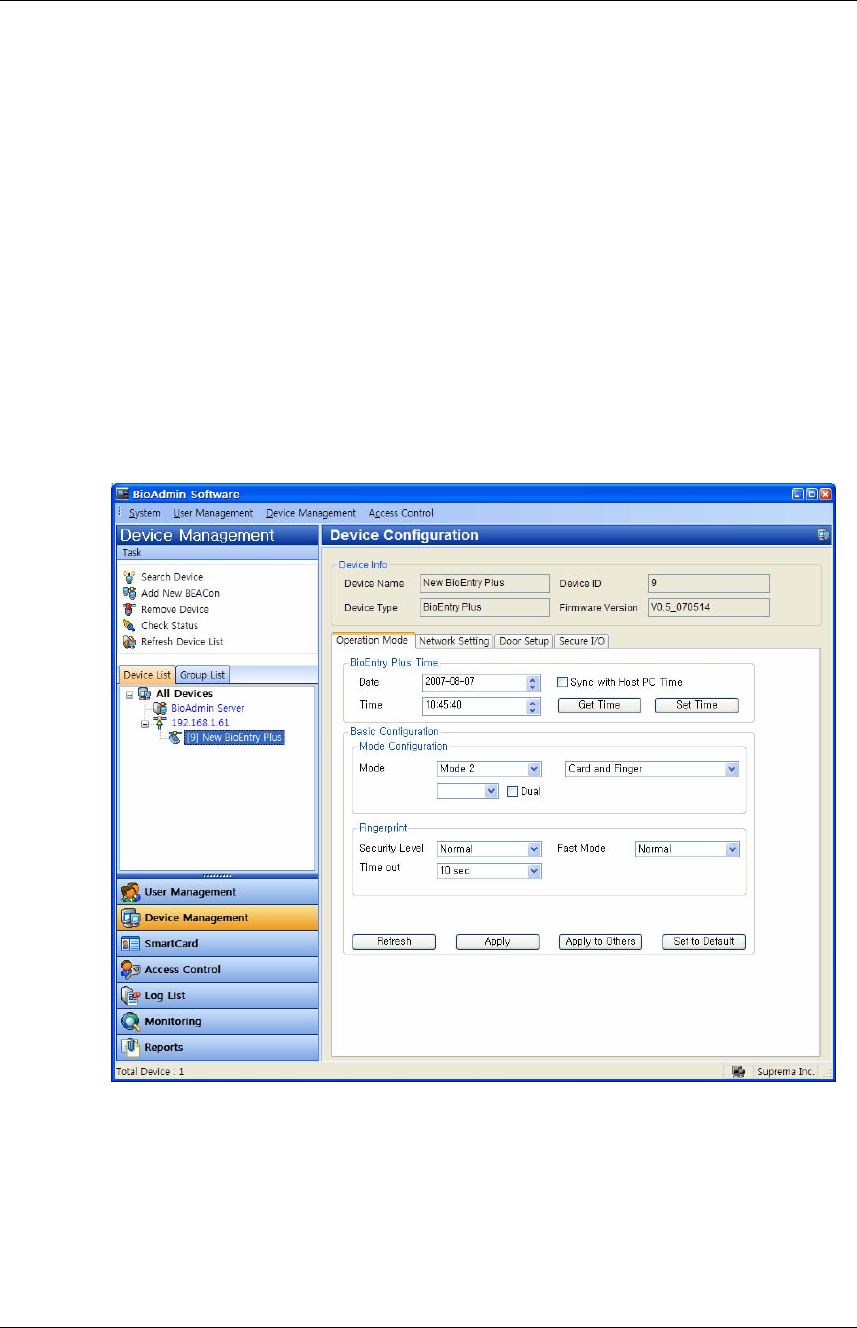
BioAdmin User Manual 169
Copyright © 2006, 2007 by Suprema Inc. http://www.supremainc.com
z Import Virtual Terminal : Remove the stored data on BioStation and apply the
data store on virtual terminal.
z Firmware Upgrade : Upgrade the BioStation firmware with the stored firmware
file on virtual terminal.
z Initialize : Remove all virtual terminals on from USB memory.
z Refresh : Check the status of the USB memory and activate menus regarding
USB memory.
4.7. Manage BioEntry Plus device
If you select BioEntry Plus on device list, the device setup window of selected
BioEntry Plus is updated on main window.
Device setup window is divided into 2 areas.
z Device information
Device information displays type, name, serial number and FW version of
selected device.
z Configuration window
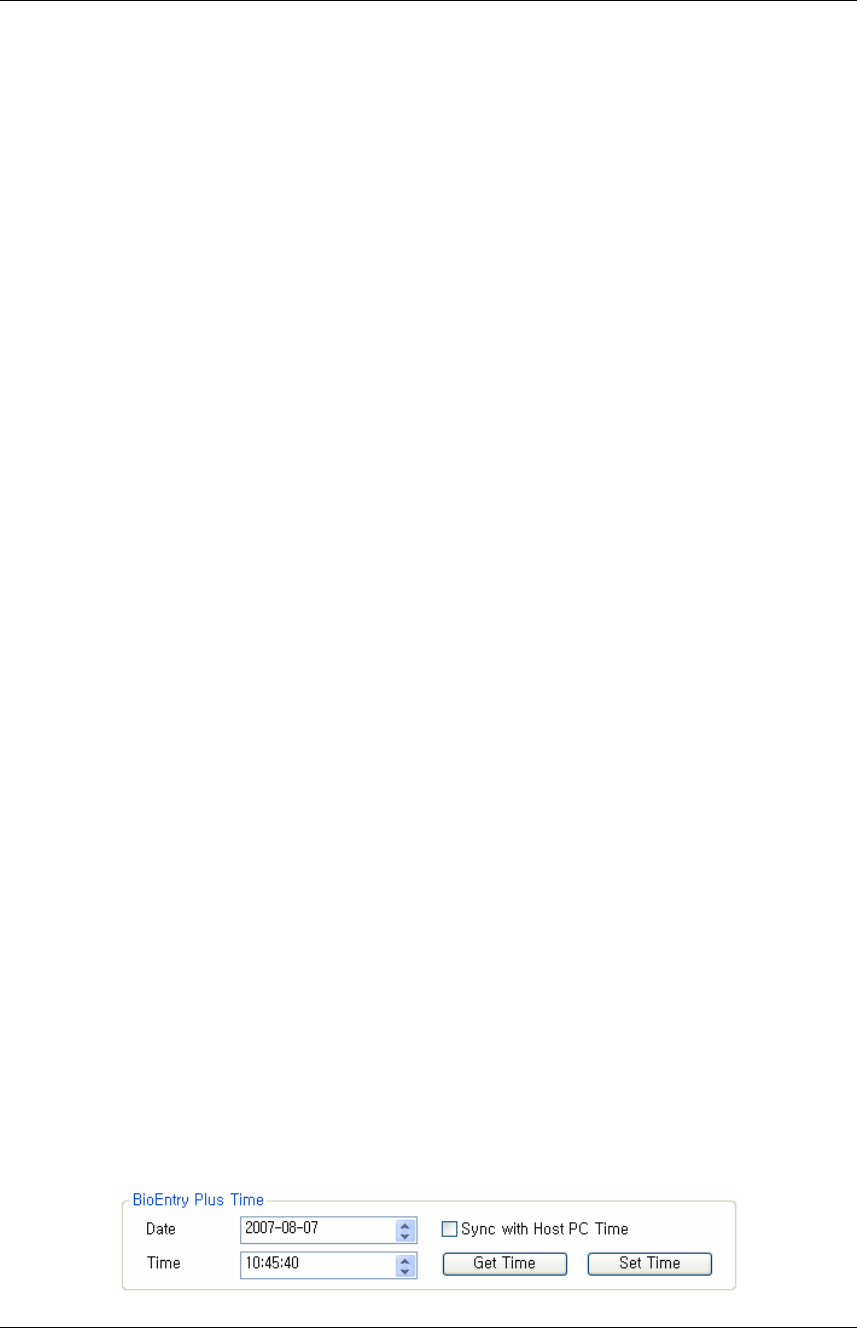
BioAdmin User Manual 170
Copyright © 2006, 2007 by Suprema Inc. http://www.supremainc.com
Configuration window shows settings of selected BioEntry Plus device and
enables user to correct those settings. Configuration menu consists of
separated tabs, i.e. operation mode, network, setting, function key, device
setting, image & sound, and notice.
At lower part of configuration window are 4 buttons, i.e. refresh, apply, apply to
others and set to default.
Refresh : call device setting again.
Apply : apply corrected setting on the current window to device.
Apply to others : apply corrected setting on current window to another
device. Device can be selected on select device window.
Set to default : change setting as default. To apply this value to device,
make sure to press apply button.
4.7.1. Device information
You can check device name, device type, device ID and firmware version of
selected BioStation. Device ID number and firmware version are necessary
information to check a product for technical support after installation.
4.7.2. Operation mode
z Time setting
Date and time shown first are those read from BioEntry Plus. If you click get
time button, it reads date and time from BioEntry once again.
Method of BioEntry time change is divided into direct input and synchronization
with current PC time.
Direct input : either input numbers directly in date and time window or place
a cursor on a number and click up/down arrow keys for input. Press set
time button after input to transfer input date and time to the selected
BioEntry Plus.
Synchronization with PC time : check sync with current PC time and set
time button, then selected BioEntry Plus time is set by current PC time.
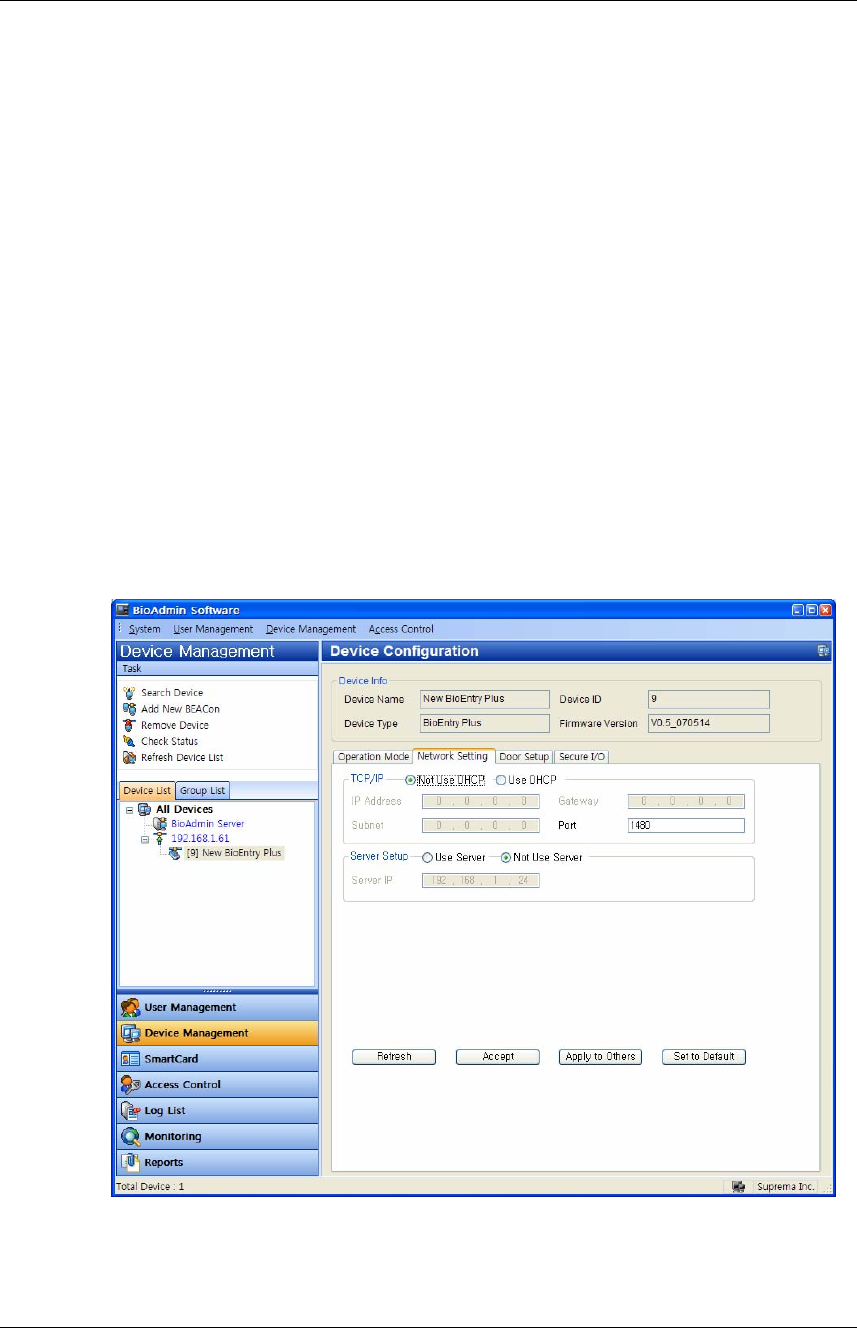
BioAdmin User Manual 171
Copyright © 2006, 2007 by Suprema Inc. http://www.supremainc.com
z Mode setting
In case of changing settings such as various modes, changes are applied only
after apply button is pressed. For detailed explanation on buttons at lower part
of a window, refer to the previous page.
z Fingerprint
You can configure Security Level, Fast Mode and Time out parameter.
4.7.3. Network setting
This window shows setup for TCP/IP.
z TCP/IP
You can setup DHCP, IP address, gateway, subnet mask and port. The Port
work with server port.
4.7.4. Door Setup
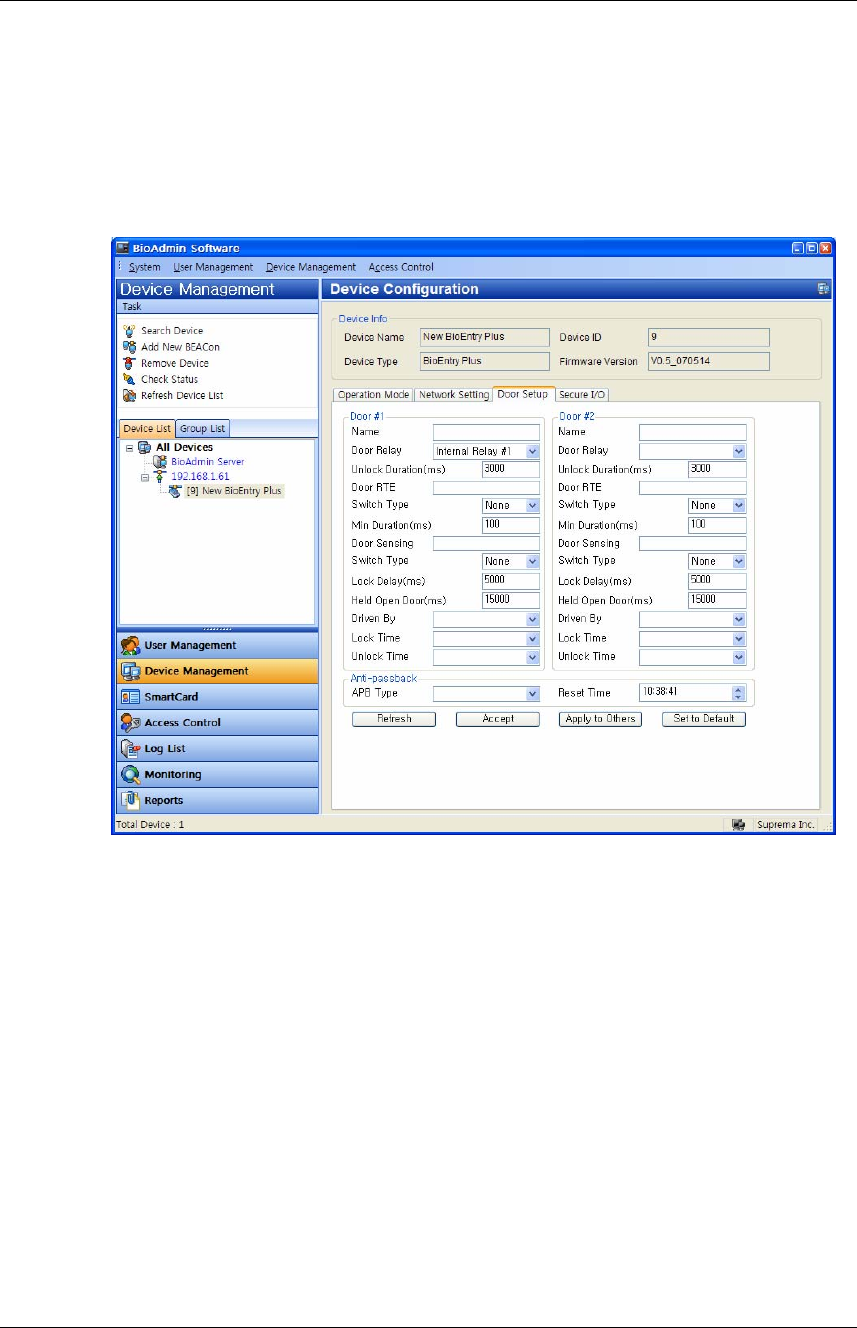
BioAdmin User Manual 172
Copyright © 2006, 2007 by Suprema Inc. http://www.supremainc.com
This window shows setup between BioEntry Plus and the connected Door
z Door
One BioEntryPlus can control two doors and add Anti-passback setup.
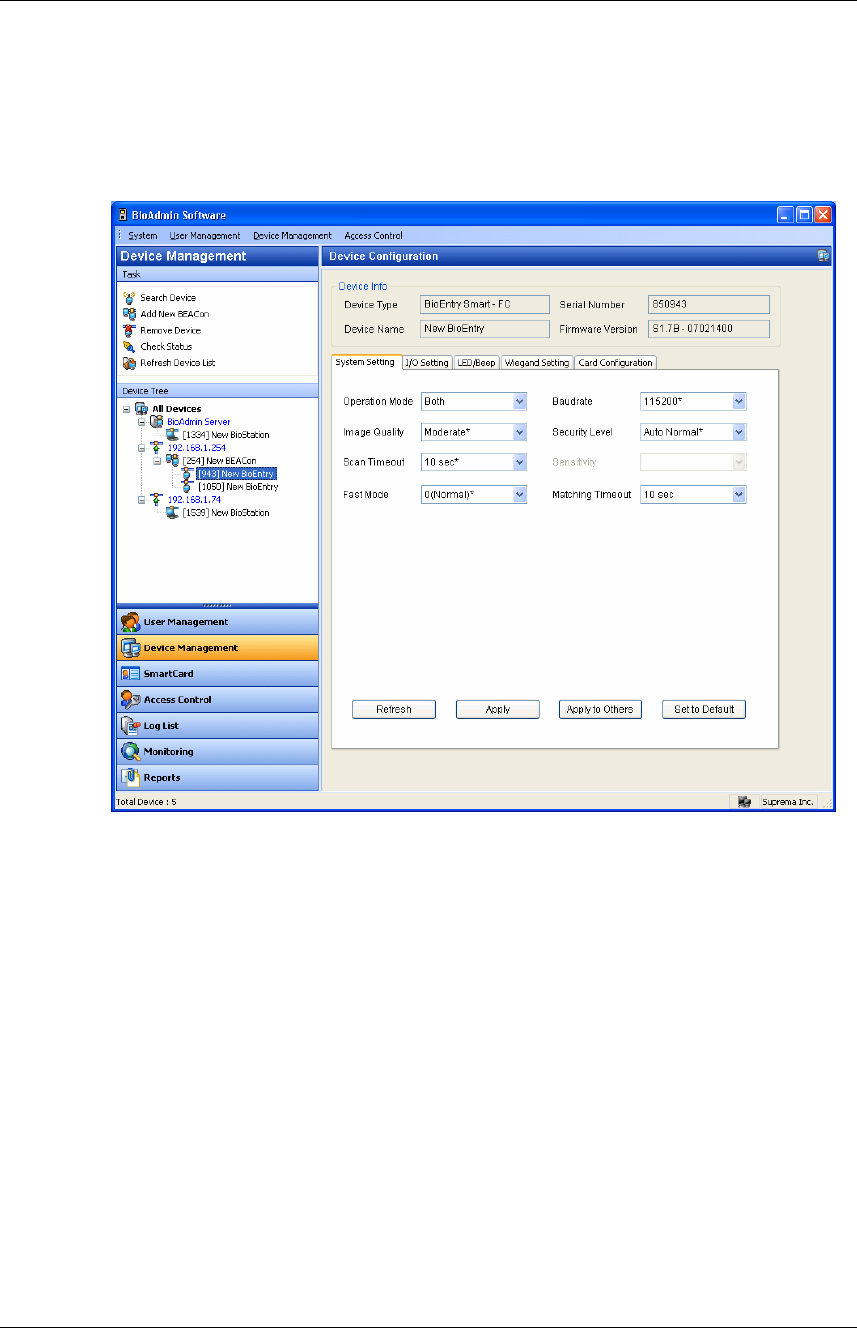
BioAdmin User Manual 173
Copyright © 2006, 2007 by Suprema Inc. http://www.supremainc.com
4.8. Manage BioEntry device
By selecting a BioEntry on the Device tree, the Device Configuration window for
the selected BioEntry is updated on the main window.
Device Configuration window is divided into 2 sectors:
z Device information
Device information shows the model name, serial number, device name, and
firmware version of the selected BioEntry.
z Configuration Set up window
The configuration set up window shows the current configurations of selected
BioEntry. Also, this window shows the configurations to be changed. The
configuration set up menus are divided by separate tabs, such as System setting,
I/O setting, LED/BEEP setting, Wiegand setting, and Card Layout.
4.8.1. Device information
Administrator can check device name, device type, device ID and FW version of
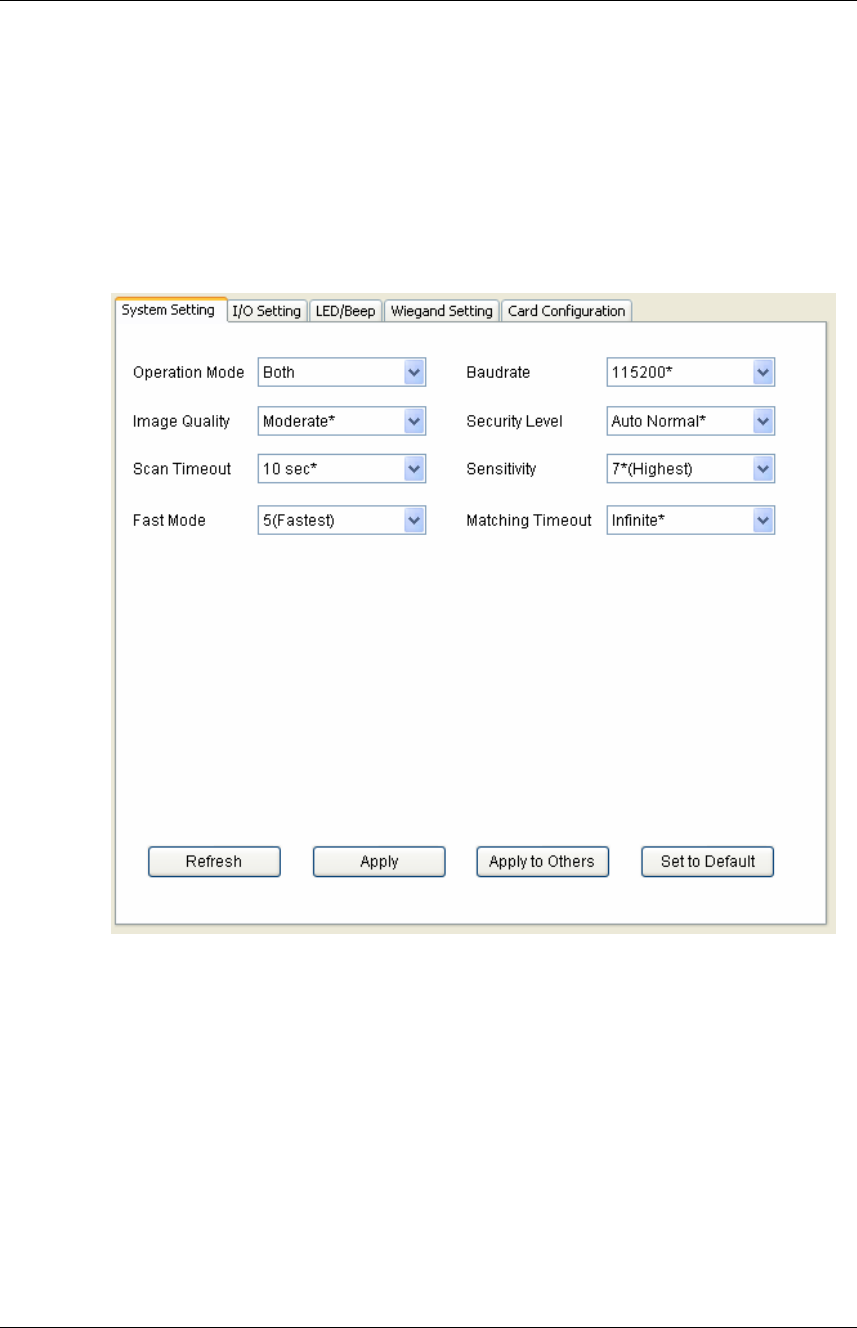
BioAdmin User Manual 174
Copyright © 2006, 2007 by Suprema Inc. http://www.supremainc.com
BioEntry. Device ID number and FW version are necessary information to check a
product for technical support after installation.
4.9. System Setting
User can set up the parameters of BioEntry on the System tab. When this tab is
selected, the system setting page is updated on the main window.
z Operation Mode
1:1 verification : if 1:1 mode is selected in BioEntry Smart, present user
smart card first and finger scan starts. In case of BioEntry Pass, finger scan
is processed by Wiegand input from external device such as ID card or
user fingerprint.
1:N identification : in 1:N mode, finger scan (authentication) is done with
user’s fingerprint only. As device sensor is always on input standby mode,
1:N scan starts right away once a finger is placed on.
Both : Both 1:1 verification and 1:N identification are supported.

BioAdmin User Manual 175
Copyright © 2006, 2007 by Suprema Inc. http://www.supremainc.com
z Baud rate
Baud rate is the number of times per second that the carrier signal value
changes state. If you have some problems to communicate with BioEntry or
with BioStation, changing baud rate to lower value can be a solution.
z Image Quality
When a fingerprint is scanned, the module will check if the quality of the image
is adequate for further processing. The image quality parameter specifies the
strictness of this quality check.
z Security Level
Security level specifies FAR(False Acceptance Ratio). If it is set to 1/100,000, it
means that the probability of accepting false fingerprints is 1/100,000. Since
FAR and FRR(False Rejection Ratio) is in inverse proportion to each other,
FRR will increase with higher security levels. Default value is Auto Normal.
z Scan Timeout
Scan Timeout specifies the timeout period for user input. If a user does not
make his/her finger scanned, place smartcard, or input Wiegand during this
period, error will be returned.
z Sensitivity
Sensitivity specifies sensor sensitivity to detect a finger. On high sensitivity, the
module will accept the finger input more easily. In other hand, by decreasing the
sensitivity, the input fingerprint image will be more stabilized. In case of optical
models, sensitivity to sunlight is also alleviated by decreasing sensitivity
parameter. Default value is 7.
z Fast Mode
When more than hundreds of templates are stored in BioEntry, the matching
time for 1:N identification can be very long. Fast Mode parameter can be used
to shorten the 1:N matching time with little degradation of authentication
performance. The security level – FAR – is not affected by this parameter, but
the FRR can be a bit higher than in normal mode. In typical cases, Fast Mode 1
is as 2 ~ 3 times faster than Normal mode. And Fast Mode 5 is 6 ~ 7 times
faster than Normal mode. Default value is 0.
z Matching Timeout
Timeout period for 1:N matching. If identification process is not finished during
this period, error will be returned.
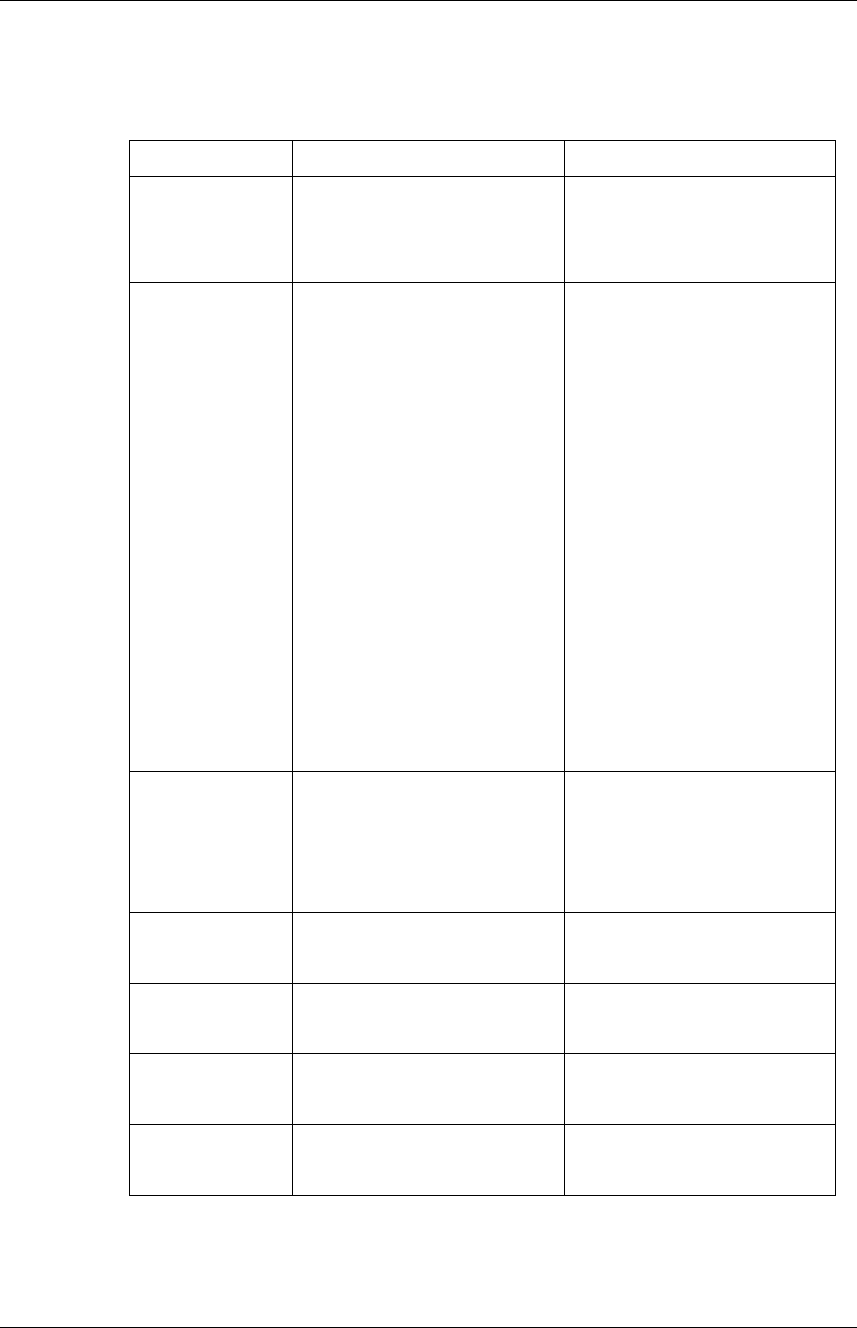
BioAdmin User Manual 176
Copyright © 2006, 2007 by Suprema Inc. http://www.supremainc.com
z Factory defaults of parameters
BioEntry Factory defaults list of parameters for BioEntry Pass is as follows :
Factory defaults Selectable values
Operation mode 1:1 verification (BioEntry
Smart)
1:N verification (BioEntry Pass)
1:1 verification
1:N identification
Both
Security level Auto Normal 1/1,000
3/10,000
1/10,000
3/100,000
1/100,000
3/1,000,000
1/1,000,000
3/10,000,000
1/10,000,000
3/100,000,000
1/100,000,000
Auto Normal
Auto Secure
Auto More Secure
Image quality Moderate Weak
Moderate
Stronger
Strongest
Sensitivity 7 0(lowest) to
7(highest)
Scan timeout 10 sec 1 to 20 sec or
Infinite
Matching timeout Infinite 1 to 20 sec or
Infinite
Fast mode 0(Normal) 0(Normal) to
5(Fastest)
4.9.1. I/O Setting
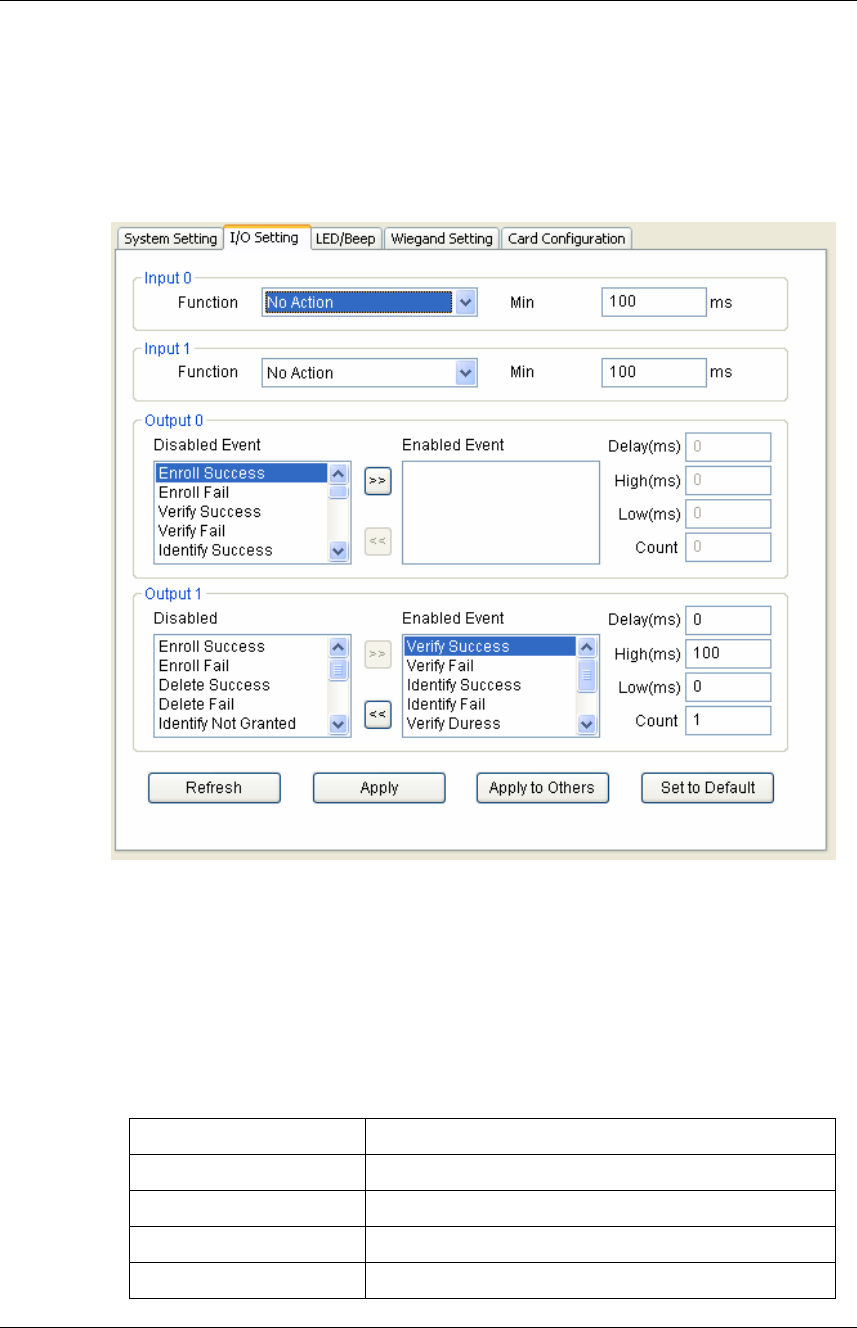
BioAdmin User Manual 177
Copyright © 2006, 2007 by Suprema Inc. http://www.supremainc.com
BioEntry provides 2 programmable inputs and 2 programmable outputs which can
be used to interface with external devices. I/O Setting menu refreshes the main
window to manage the I/O settings. By factory default, no functions are defined for
each programmable I/O’s.
z Configuration of input port
To define the configuration of input port, function and minimum duration should
be specified. Function means what to do when the input port is activated and
minimum duration means the required duration of pulse to activate the input
port.
z Description of Input functions
Function Description
No Action Disable input port
Enroll by Scan initiate enrollment using finger scan
Identify by Scan initiate identification using finger scan
Delete by Scan delete user by identifying input finger
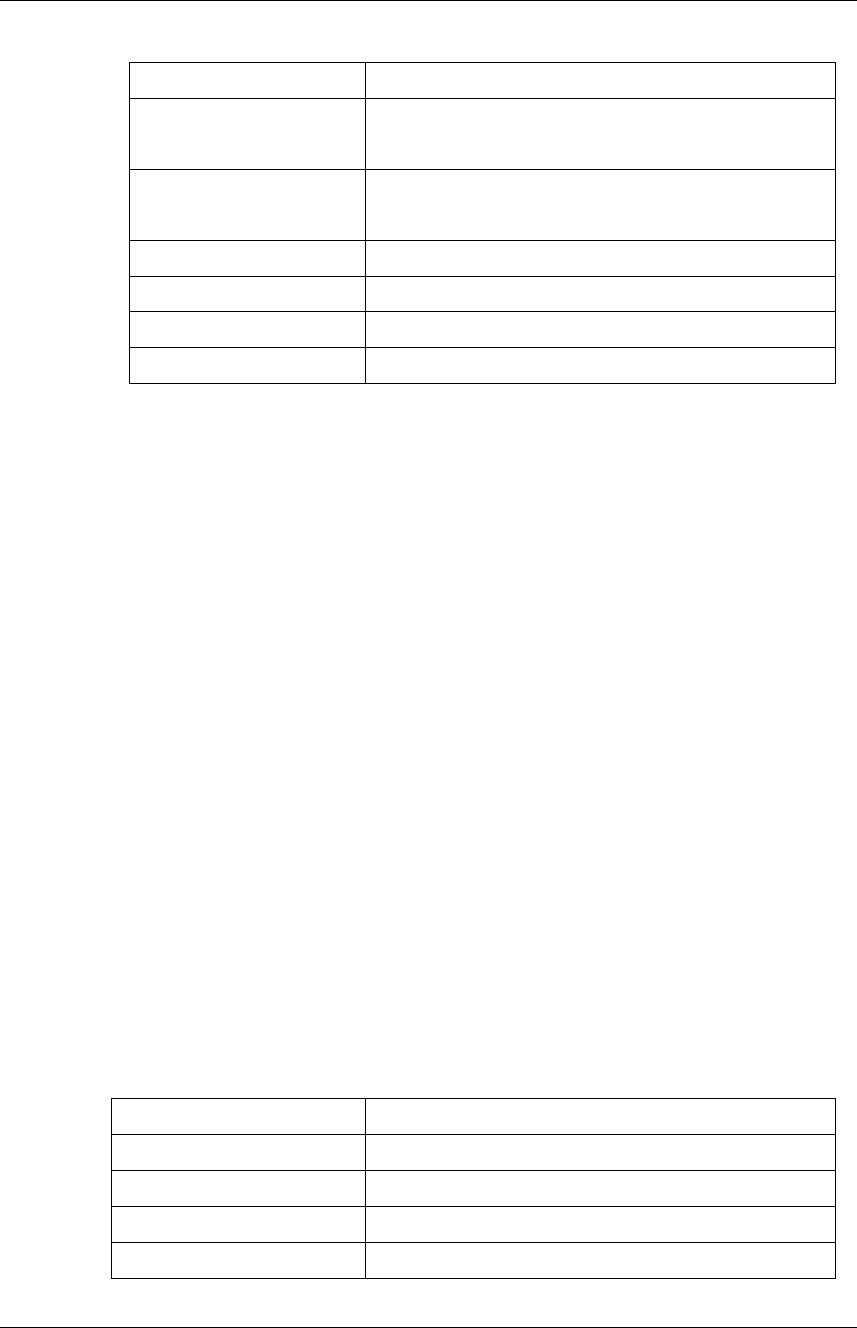
BioAdmin User Manual 178
Copyright © 2006, 2007 by Suprema Inc. http://www.supremainc.com
Delete All delete all user data
Enroll by Wiegand ID enroll by scan with user ID received at Wiegand input
port
Verify by Wiegand ID initiate verification using finger scan with user ID
received at Wiegand input port
Delete by Wiegand ID delete user with user ID received at Wiegand input port
Controller Reject input for reject signal from controller
Controller Accept input for accept signal from controller
Software Reset initiate software reset
Program sample for input port
If administrator wants to connect the wiegand input of the user ID to the input
button to initialize enrollment, the following procedure is required.
Suppose to use input port 0, user should press a button for at least 500 ms to
activate a function.
First, choose applicable device on device list window.
Choose a function of input port 0 with Enroll by Wiegand ID.
Input 500 as minimum input time of input port 0.
Press apply button to transfer new settings to applicable device.
z Configuration of output port
In configuring output port, multiple functions can be programmed to produce
different output pattern on each event. Event means when to activate the output
port and output pattern defines how to activate the output port, respectively.
Programming procedure is as follows:
Enable required event by selecting event from disabled event.
Program output pattern by editing delay, high, low, and count values.
z Output events
Event Description ( when to activate the output port )
Enroll Success When a user is successfully enrolled on the device
Enroll Fail When enrollment fails
Identify Success When identification is successfully done
Identify Fail When the device fails to find out the matched user
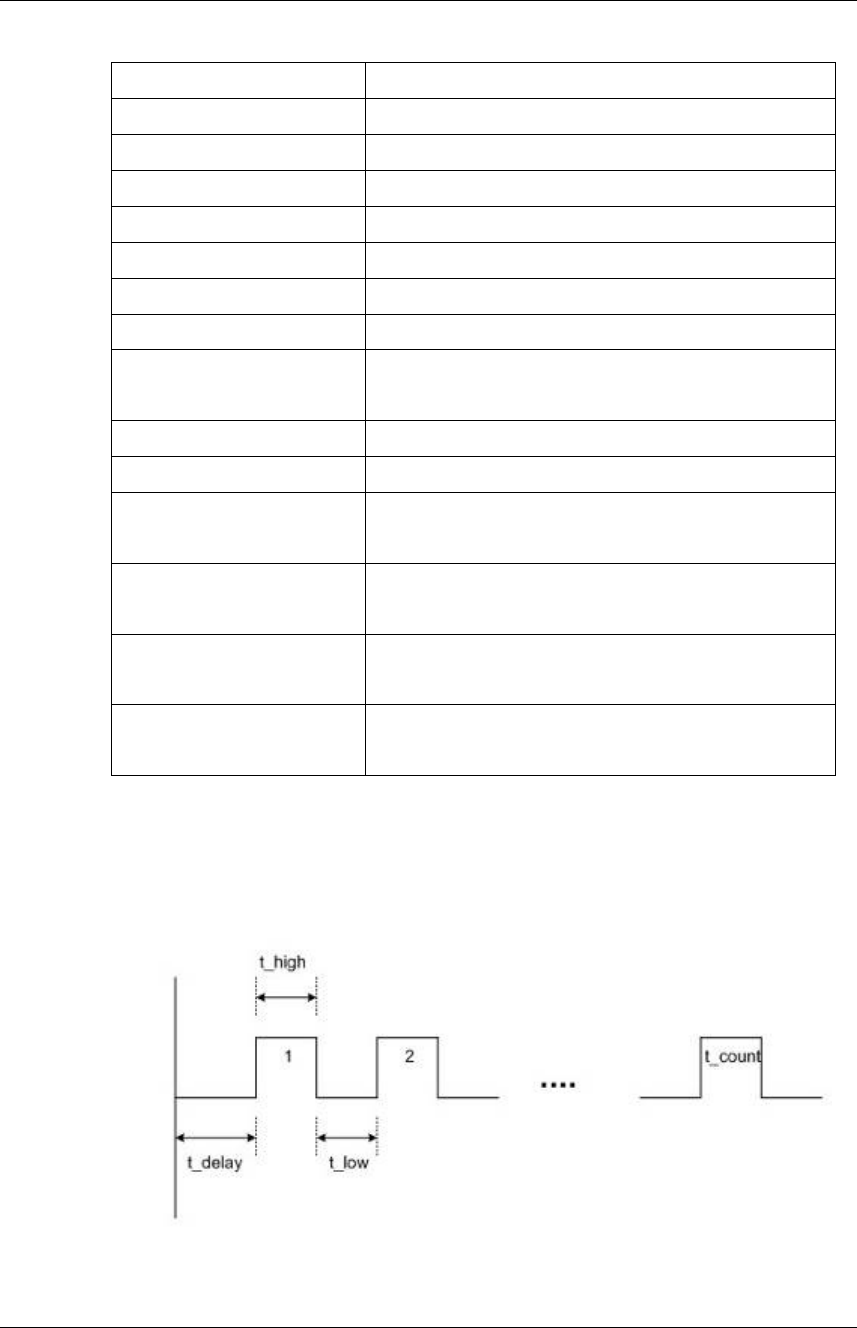
BioAdmin User Manual 179
Copyright © 2006, 2007 by Suprema Inc. http://www.supremainc.com
Verify Success When verification is successfully done
Verify Fail When the user is not verified
Delete Success When deletion of user succeeds
Identify Not Granted Identification is successfully done, but entrance denied
Verify Not Granted Verification is successfully done, but entrance denied
Delete Fail When deletion of user fails
Verify Duress When duress finger is verified
Identify Duress When identified finger is a duress finger
Temper Switch On When temper switch on the device is enabled implying
device is opened.
Command Card Success When command card operation successfully completed
Command Card Fail When command card operation is failed
Controller Reject When input port on which Controller Reject function is
assigned, is activated
Controller Accept When input port on which Controller Accept function is
assigned, is activated
Detect Input 0 When input port 0 is activated regardless of assigned
function
Detect Input 1 When input port 1 is activated regardless of assigned
function
z Describing output pattern
On each enabled event, output pattern can be flexibly described by
programming using 4 parameters whose meanings are depicted as
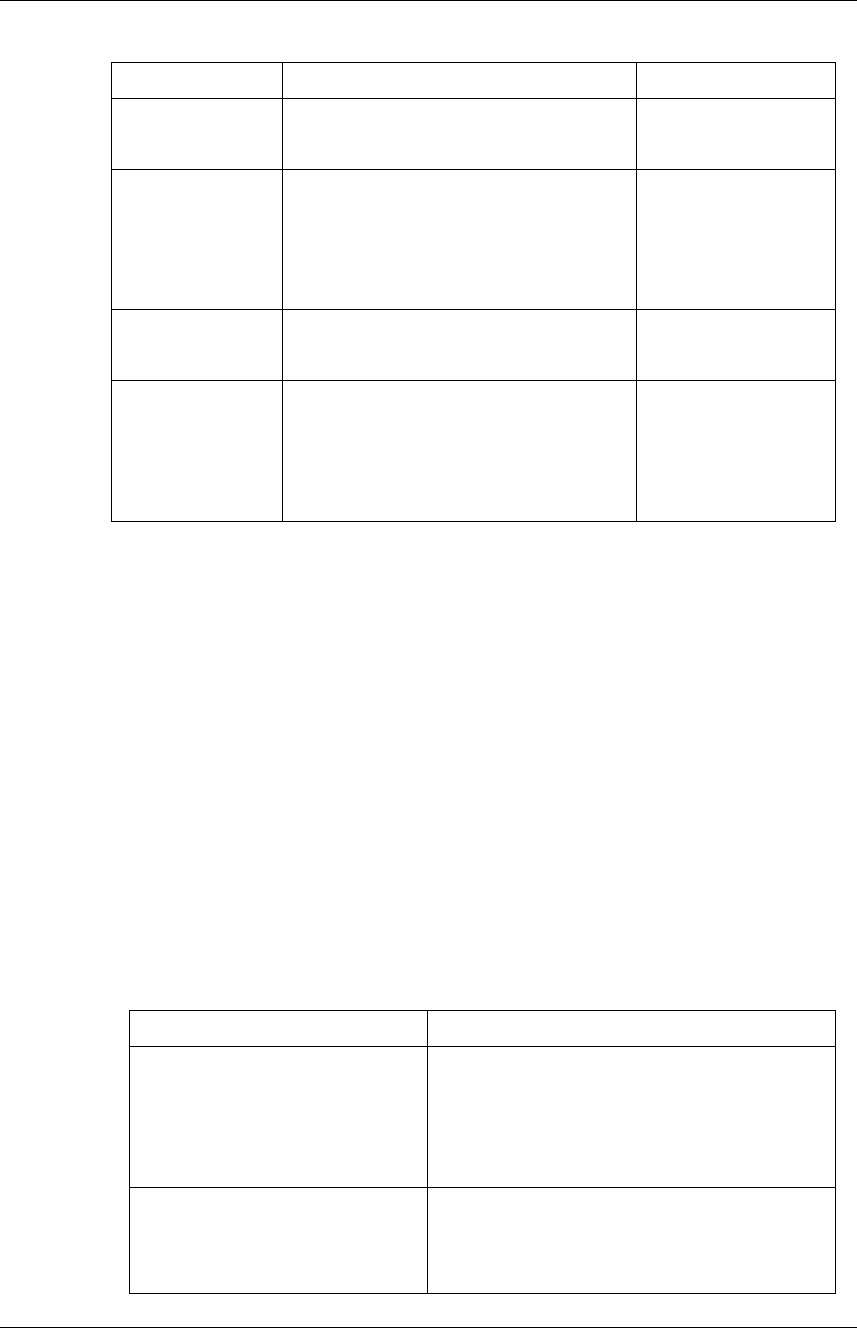
BioAdmin User Manual 180
Copyright © 2006, 2007 by Suprema Inc. http://www.supremainc.com
Parameter Meaning Allowed value
Delay initial delay before generating output
pulses in msec
0 ~ 65535
High duration duration of pulse in high state in msec 0 ~ 65534
65535 : continuously
active until new output
event occurs
Low duration interval between consecutive pulses
where the output signal remains low
0 ~ 65535
Count Number of pulses 0 : infinitely repeated
until new output event
occurs
1 ~ 255
Programming example of output pattern
Assume that a user want to assign an alarm signal at output port 0 generating
following patterns:
On identification success or verification success for duress finger, the device
sends blinking output during 5 seconds.
When temper switch is on, the device sends steady output during 10 seconds.
Programming procedure is as follows:
First, select a target device on the network window.
Disable currently selected events on output 0 by moving enabled ones to the
disabled sector.
Program the required events by enabling each event followed by editing output
pattern parameters as follows:
Event to be enabled Output pattern parameters
Verify Duress Delay : 0
High : 500
Low : 500
Count : 5
Identify Duress Delay : 0
High : 500
Low : 500
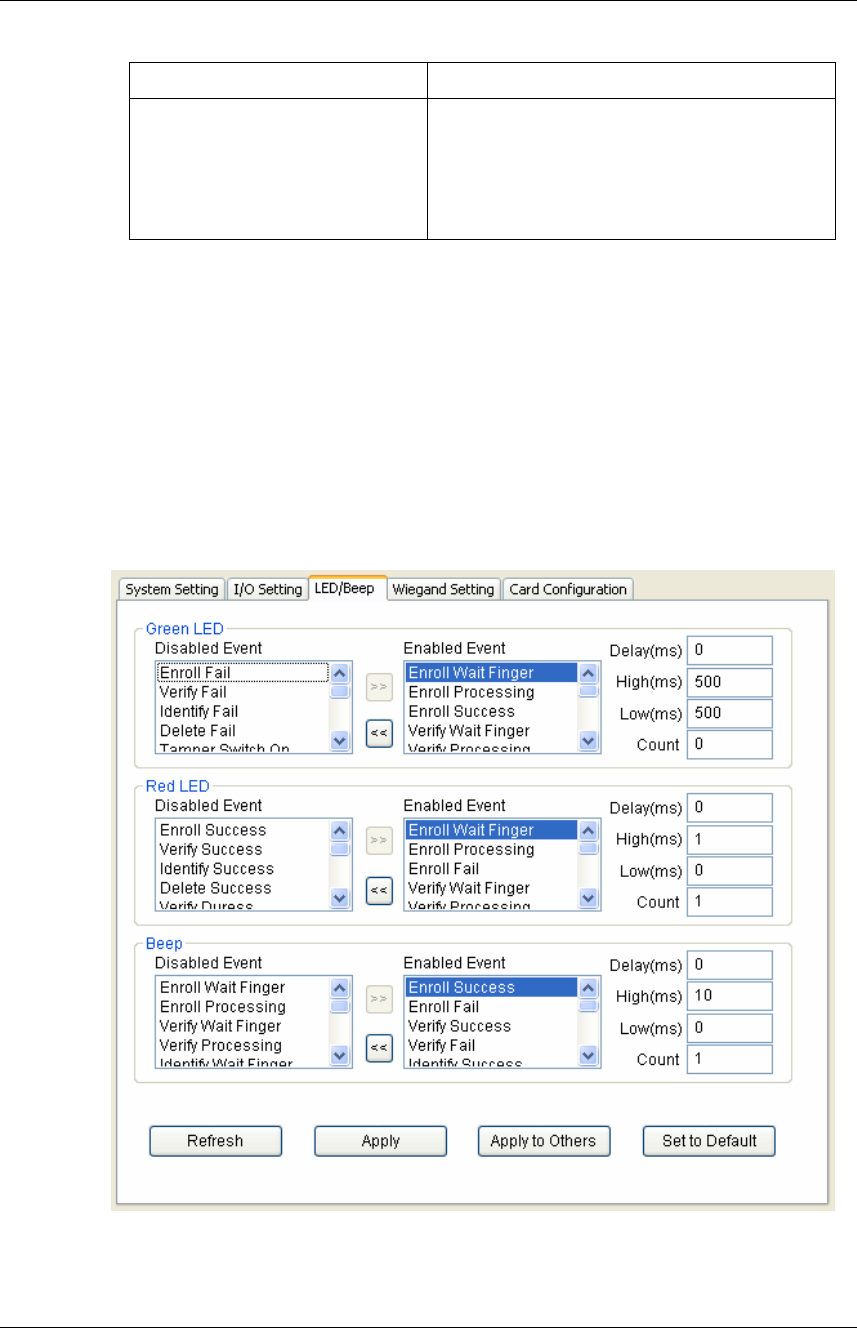
BioAdmin User Manual 181
Copyright © 2006, 2007 by Suprema Inc. http://www.supremainc.com
Count : 5
Temper Switch On Delay : 0
High : 10000
Low : 0
Count : 1
Press the Apply button to transmit the new configuration to the target device.
4.9.2. LED/Beep sound Setting
There are two LED’s and one beep on BioEntry device to provide processing
status and result to users. The colors of two LED’s are mixed to generate 3 colors,
green, red, and amber. By selecting the LED/Beep Setting tab, the LED/Beep
configuration page is updated on the main window.
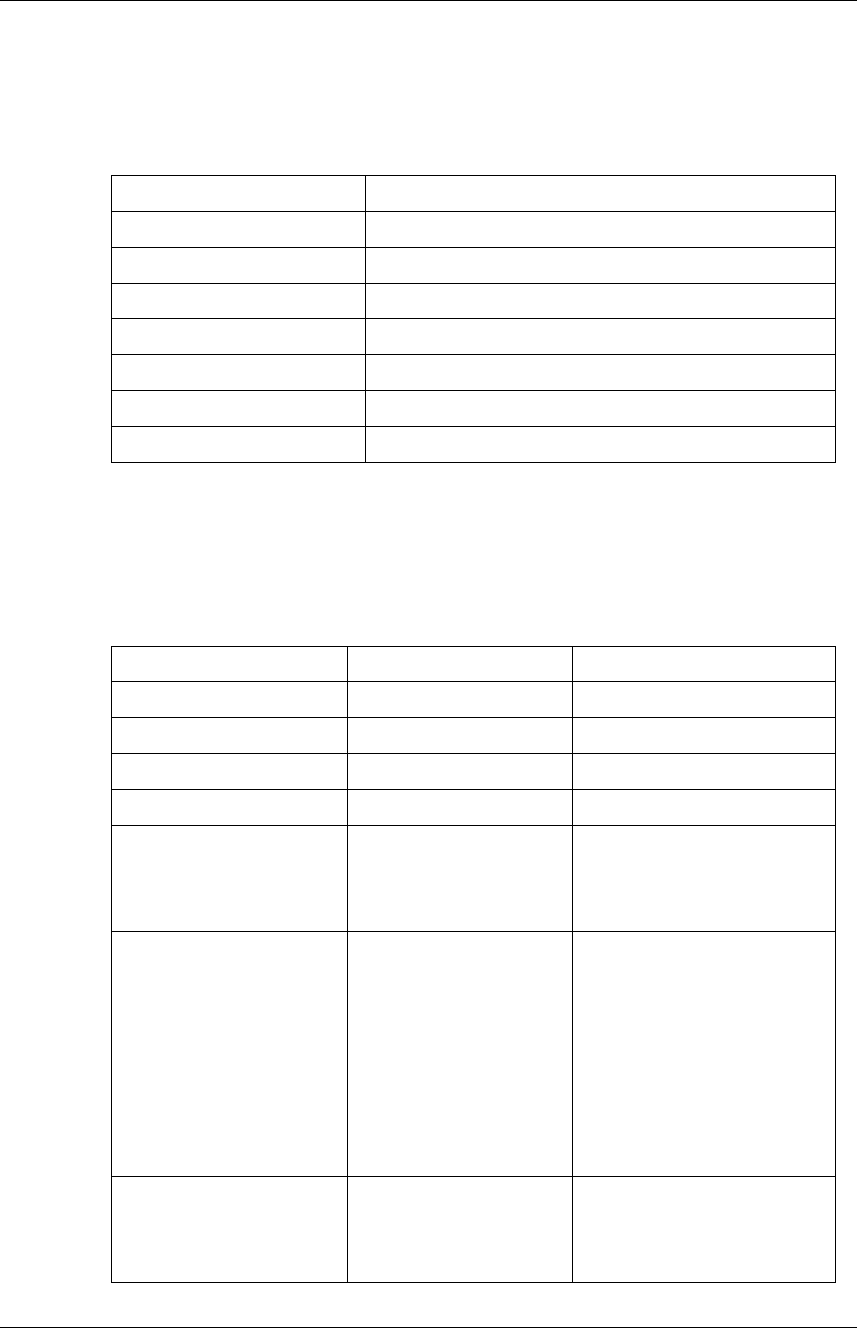
BioAdmin User Manual 182
Copyright © 2006, 2007 by Suprema Inc. http://www.supremainc.com
z Configuration of LED/Beep
Programming steps for LED and Beep is similar to output port configuration.
Additional events are selectable, listed as
Event Description ( when to activate the output port )
Enroll Wait Finger When the device is waiting for a finger scan to enroll
Enroll Processing When the device is in enrollment process
Identify Wait Finger When the device is waiting for a finger scan to identify
Identify Processing When the device is in identification process
Verify Wait Finger When the device is waiting for a finger scan to verify
Verify Processing When the device is in verification process
Delete Wait Finger When the device is waiting for a finger scan to delete
z Description of default LED/Beep configuration
By factory default, various output patterns are defined for LED and beep to
show current status and processing result. The description of default LED/Beep
configuration is listed as follows:
Events LED Beep
Enroll Wait Finger Slow blinking amber None
Verify Wait Finger Fast blinking amber None
Identify Wait Finger Slow blinking amber None
Delete Wait Finger Fast blinking amber None
Enroll Processing
Identify Processing
Verify Processing
Steady amber None
Enroll Success
Verify Success
Identify Success
Delete Success
Command Card Success
Verify Duress
Identify Duress
Steady green One beep sound
Enroll Fail
Verify Fail
Identify Fail
Steady red Three short beep sounds
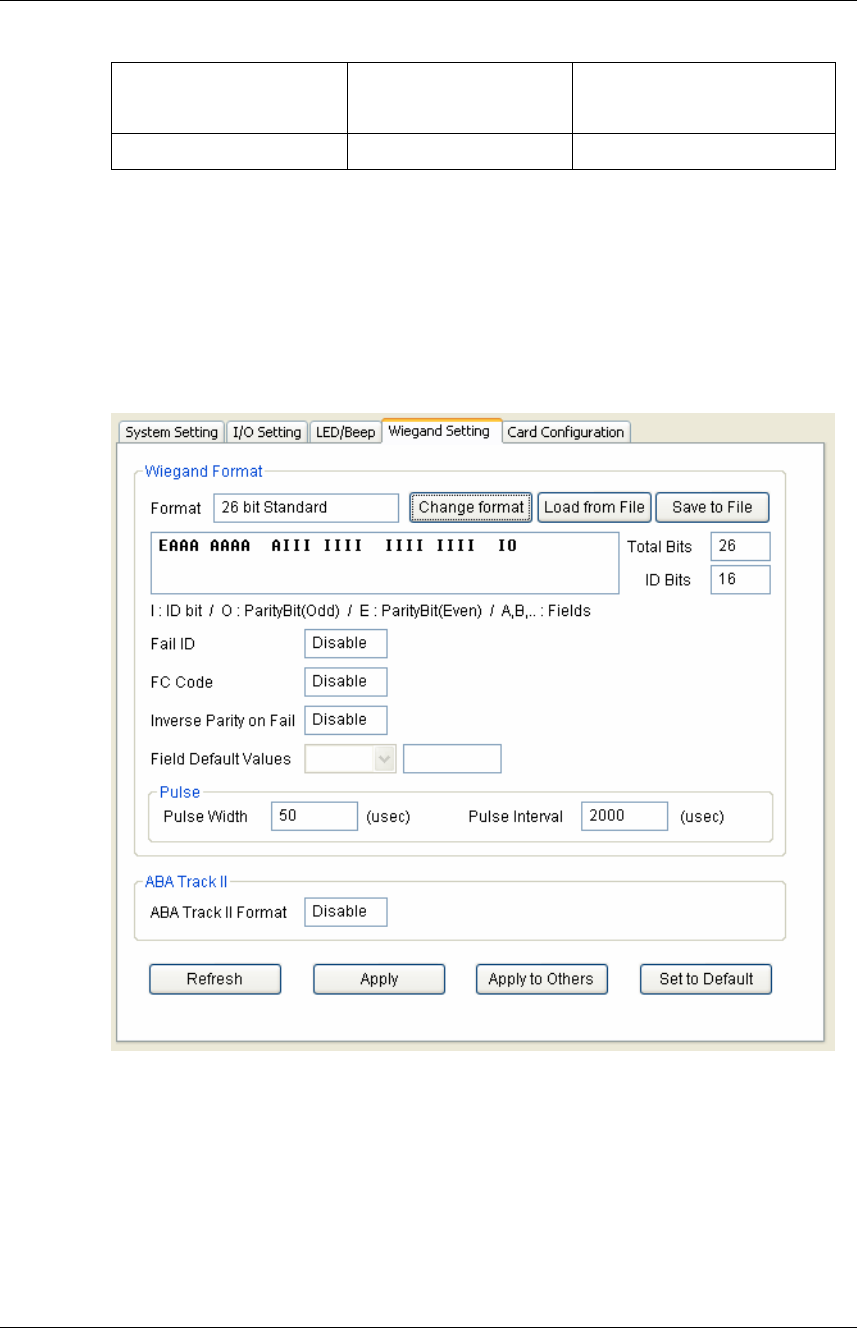
BioAdmin User Manual 183
Copyright © 2006, 2007 by Suprema Inc. http://www.supremainc.com
Delete Fail
Command Card Fail
Waiting Smart Card Input Fast blinking red (fixed) None
4.9.3. Wiegand Setting
The Wiegand Setting tab is used to manage the Wiegand input/output format of
BioEntry. By selecting the menu, the Wiegand setting page is updated on the main
window.
z Wiegand Format
New Wiegand format can be configured graphically using the Wiegand
Configuration wizard. The Wiegand Configuration wizard will be shown by
pressing the Change format button.
z Select format
You should select one of the three supported formats in the first page. If
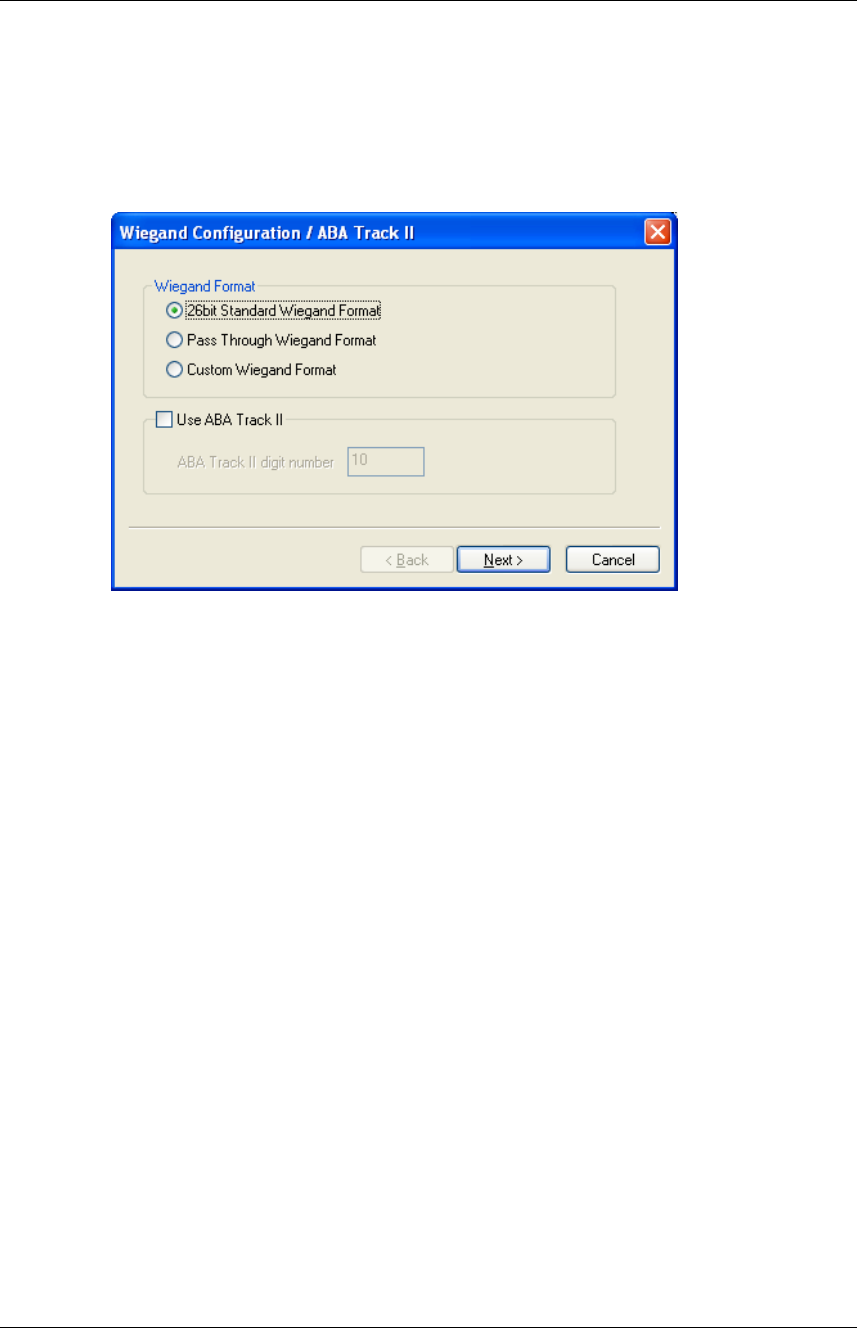
BioAdmin User Manual 184
Copyright © 2006, 2007 by Suprema Inc. http://www.supremainc.com
BioEntry device is connected to the controller by ABA Track II output, not by
Wiegand interface, you should check Use ABA Track II. In that case, the output
signal will be in ABA Track II format. You can also specify the number of
characters for ABA Track II output.
26 bit standard
The 26 bit standard format is most widely used and consists of 8 bit FC code and
16 bit ID. You cannot change the bit definition and the parity bits in 26 bit standard
format.
Pass Through format
Pass Through format is used when only the format of ID field is known. When the
Wiegand input string is detected, BioEntry device extracts ID bits and starts
verification with the ID. If the verification succeeds, the device outputs the Wiegand
input string as unchanged. Parity check and advanced options are ignored in this
format. By definition, Pass Through format is only useful when the operation mode
is 1:1. If the mode is 1:N, the bits other than ID field are set to 0.
For example, assume that 32 bit Pass Through format is composed as follows:
XIIIIIII IIIIIIIX XXXIIIII IIIIIIIX (left most bit is 0th bit, BIT0)
I: Id field, X: Unknown field
You can configure this format in the following sequences.
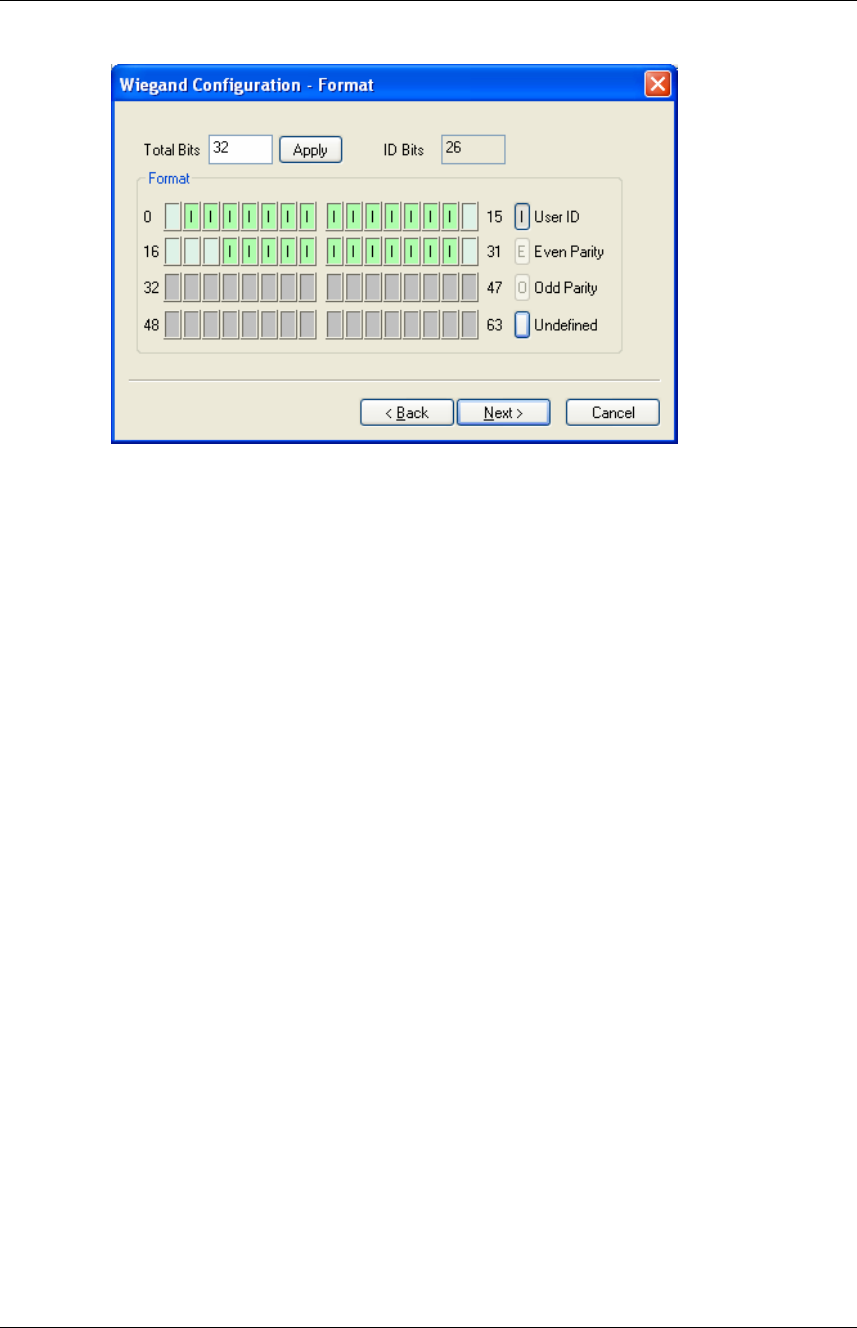
BioAdmin User Manual 185
Copyright © 2006, 2007 by Suprema Inc. http://www.supremainc.com
(1) Enter 32 in the Total Bits field.
(2) Select ID bits according to the definitions.
(3) Press Next. You cannot specify parity bits in Pass Through mode.
Custom format
When users know all the information of a Wiegand format, Custom format can be
defined. When a Wiegand input string is detected, BioEntry device checks the parity
bits first. If all the parity bits are correct, the device extracts ID bits and starts
verification with the ID. Users can also set alternative values of each field and
enable advanced options such as Fail ID. If the verification succeeds, the device
outputs a Wiegand string. The output string may be different from the input string
according to the alternative values and advanced options.
For example, assume that 44 bit Custom format is composed as follows:
EAAAAAAA IIIIIIII IIIIIIII BBBBBBBI IIIIIIII IIIO
(left most bit is 0th bit, BIT0)
E: Even parity for BIT1 ~ BIT22
O: Odd parity for BIT23 ~ BIT42
I: ID bits(Field1 and Field 3), A: Field 0, B: Field 2
You can configure this format in the following sequences.
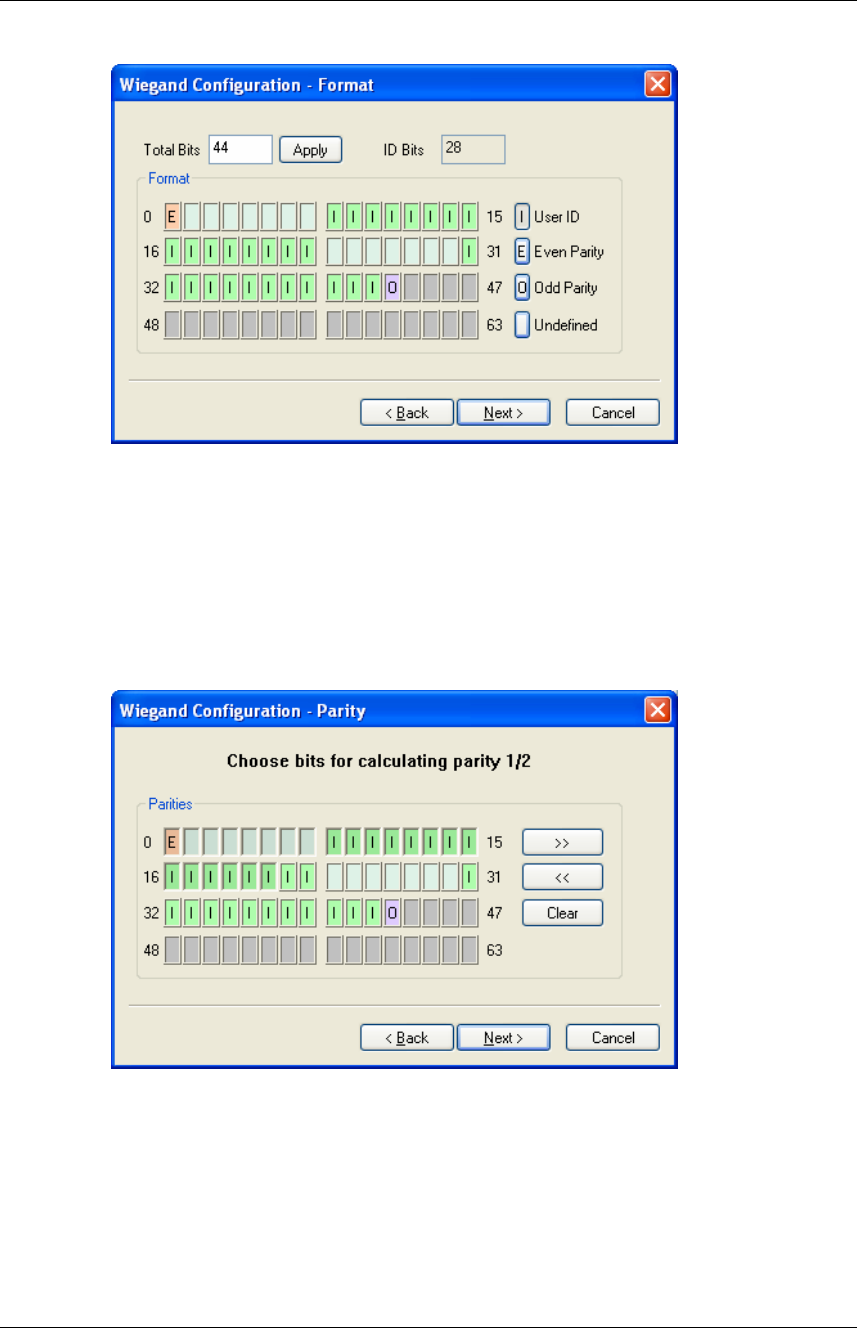
BioAdmin User Manual 186
Copyright © 2006, 2007 by Suprema Inc. http://www.supremainc.com
Enter 44 in the Total Bits field.
Select Even Parity.
Press the even parity bit. In this example, it is BIT0.
Select Odd Parity and press the odd parity bit and User ID according to the
definition.
Press Next.
Press the bits which are used in calculating the first parity bit. In this example, they
are BIT1 ~ BIT22
Press >>.
Press the bits which are used in calculating the second parity bit. In this example,
they are BIT23~ BIT42.
Press Next.
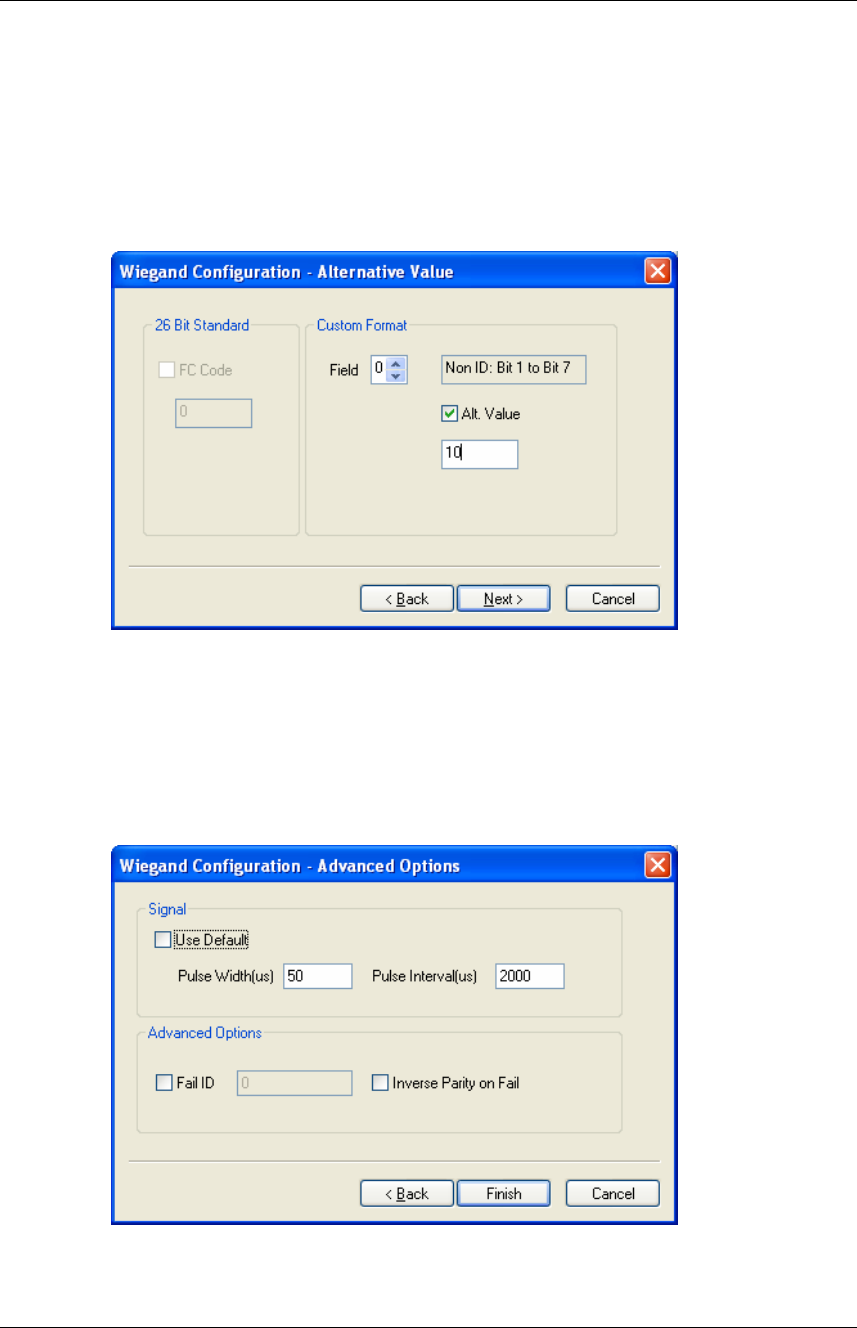
BioAdmin User Manual 187
Copyright © 2006, 2007 by Suprema Inc. http://www.supremainc.com
z Alternative values
In 26 bit standard you can specify alternative FC code. In Custom format, you
can specify alternative values for non-ID field. If alternative values are set, the
BioEntry™ device will replace corresponding fields with these values before
sending outputs.
z Advanced options
You can specify the characteristics of Wiegand signal and the advanced options
in the last page of the wizard. Advanced options are not available for Pass
Through format.
Use Default: Uses default values for Wiegand signals.
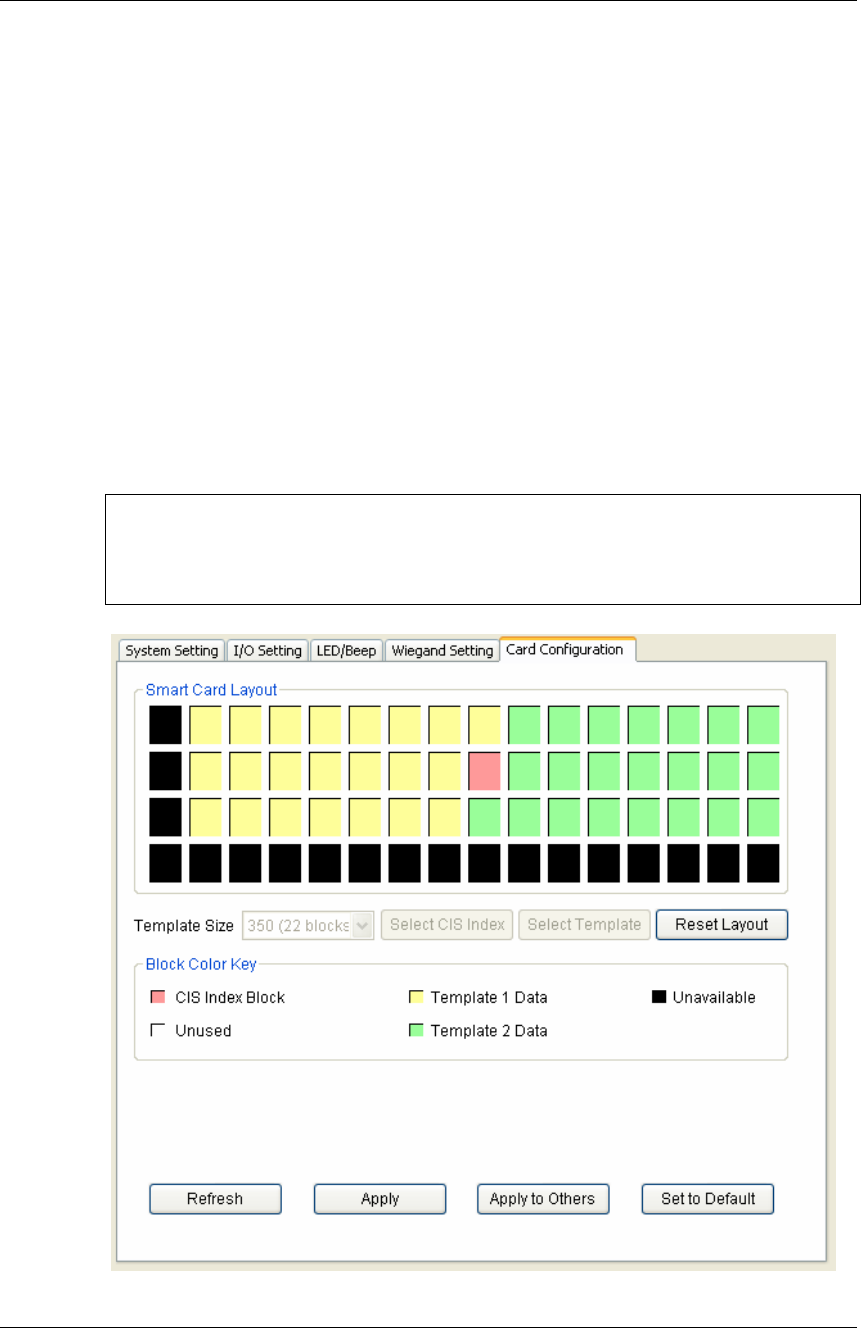
BioAdmin User Manual 188
Copyright © 2006, 2007 by Suprema Inc. http://www.supremainc.com
Pulse Width : The width of pulse. The default is 50 us.
Pulse Interval : The interval of pulse. The default is 2000us.
Fail ID : Normally the module outputs Wiegand signals only if matching
succeeds. If this option is checked, the module outputs the fail ID when
matching fails.
Inverse Parity on Fail : If this option is checked, the module outputs
Wiegand signals with inverted parities when matching fails.
4.9.4. Smart Card setting
Card Configuration is the process of defining custom sectors on user’s smart card
to store user information including user ID and templates. By selecting Card
Configuration menu, smart card layout page is updated on the main window.
Note : It is recommended that only advanced users attempt to change the
layout since improper changes may render the smart card unusable. Read
this chapter carefully for changing the layout from the default configuration.

BioAdmin User Manual 189
Copyright © 2006, 2007 by Suprema Inc. http://www.supremainc.com
z Editing layout
Template size : Template size is configurable from 254 to 382. By factory
default, template size is specified as 350 bytes storing two templates on the
card.
CIS index block : Header information is stored on the CIS index block
which is depicted by red color.
Template data block : Blocks for template 1 data and template 2 data.
Number of blocks for each template data is determined by template size.
Template 1 data is depicted by yellow and template 2 data is depicted by
green, respectively.
Unused block : Blank block which is not defined by layout.
Unavailable block : Block that is prohibited from use.
z Editing procedure
To configure customer’s layout, following procedures are required.
Initialize all the blocks to unused ones by pressing the Reset Layout button.
Select the required template size.
Press the Select CIS Index button and click an unused block to select a
CIS index block.
Press the Select Template button and click an unused block to indicate the
start block of template data. Then, the blocks of template 1 data are set
automatically from the selected start block.
Press the Select Template button again and click an unused block to
indicate the start block of template 2 data.
The Apply button transmits smart card layout to selected devices.
z Factory default layout
Factory default smart card layout is as follows :
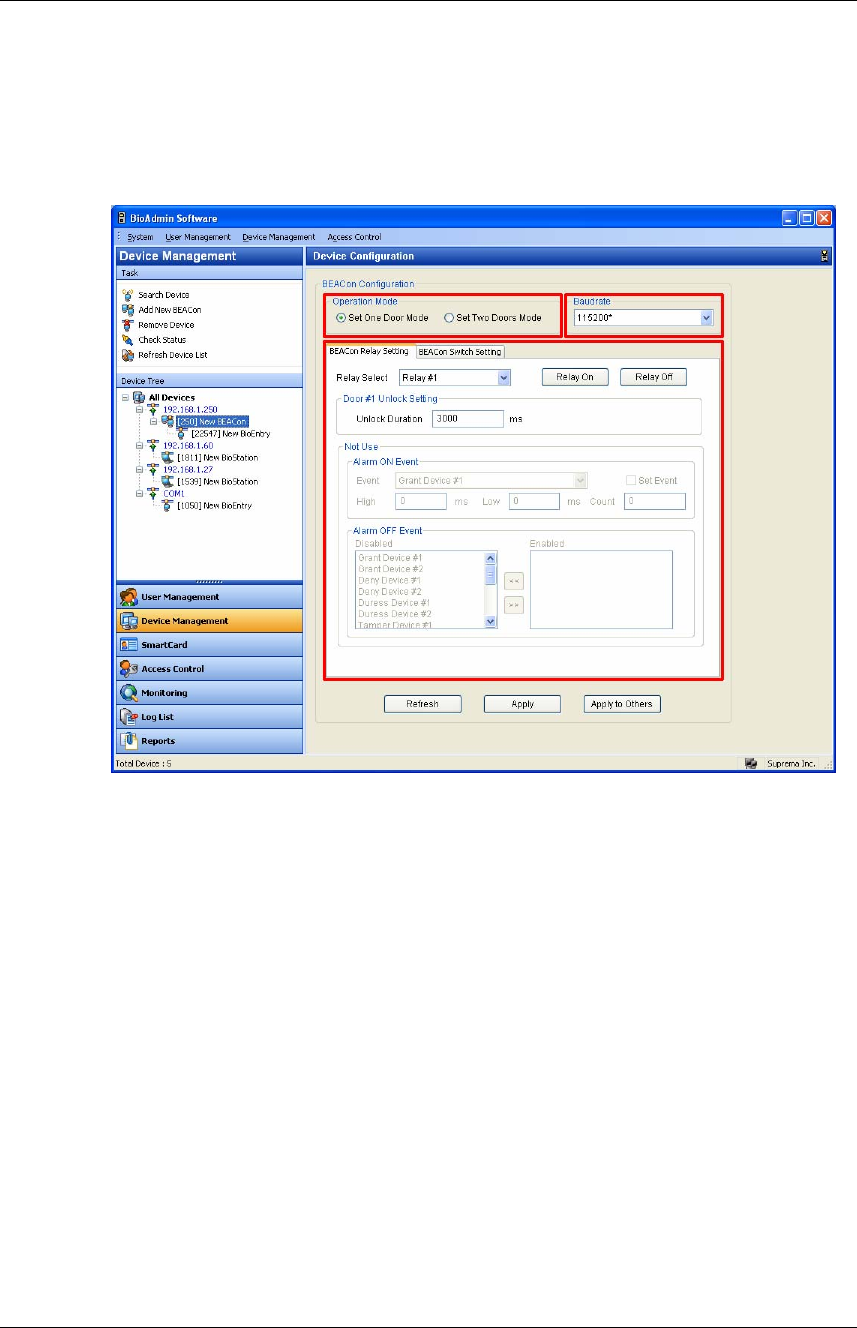
BioAdmin User Manual 190
Copyright © 2006, 2007 by Suprema Inc. http://www.supremainc.com
4.10. BEACon Configuration
By selecting a BEACon on the Device tree, the Device Configuration window for
the selected BEACon is updated on the main window.
The Device Configuration window is divided into 3 sectors:
z Operation Mode
BEACon can control up to two doors. The Operation Mode window shows
whether the selected BEACon is configured as one door mode or two door
mode.
z Baud Rate
The Baud rate window shows the transfer speed of the selected BEACon.
z Configuration Set up window
The Configuration set up window shows the current configurations of the
selected BEACon. Also, this window shows the configurations to be changed.
The configuration set up menu is divided by separate tabs, such as BEACon
Relay Setting and BEACon Switch Setting. For the detailed operation of
BEACon, refer to BEACon operation manual.
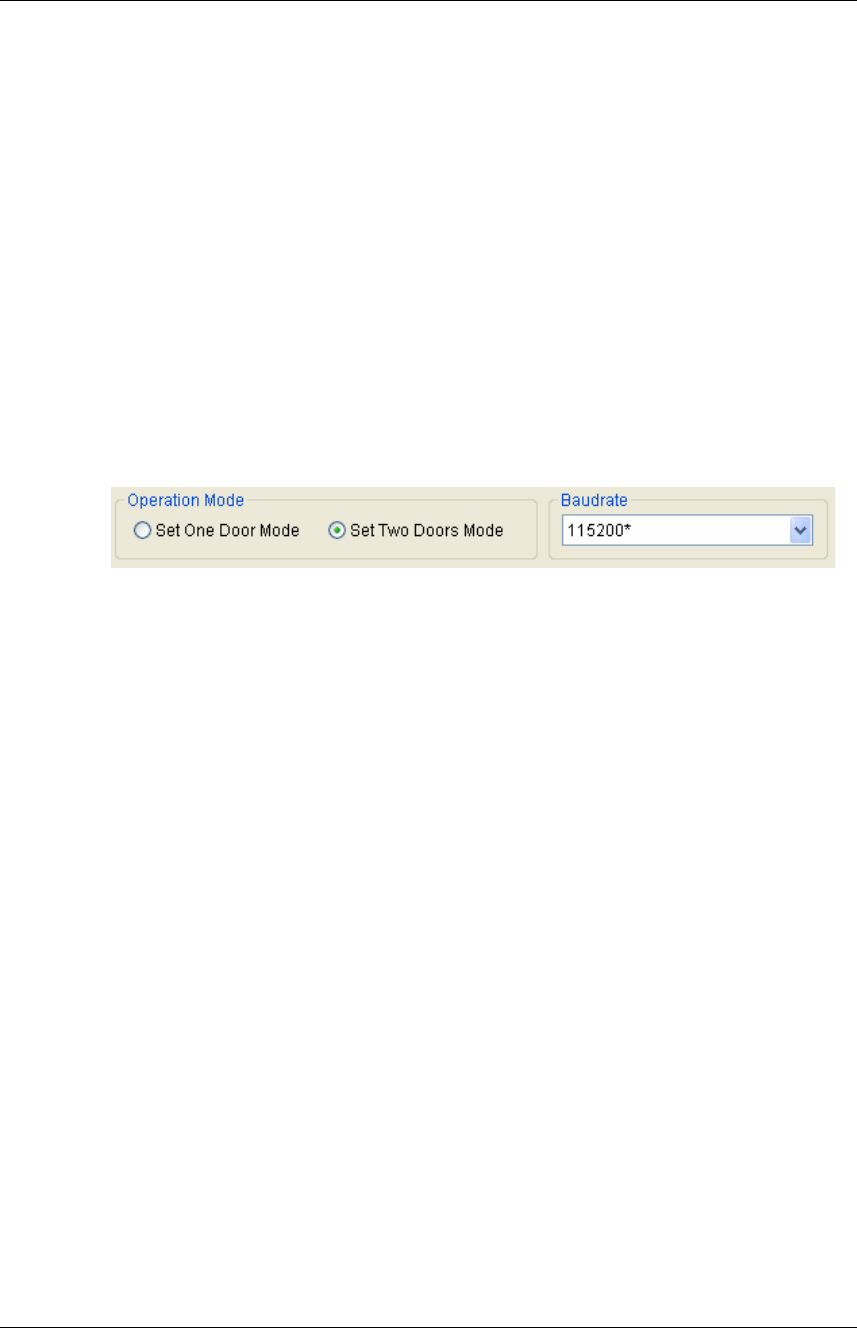
BioAdmin User Manual 191
Copyright © 2006, 2007 by Suprema Inc. http://www.supremainc.com
4.10.1. Operation Mode
BEACon can control up to two doors. The Operation Mode window shows whether
the selected BEACon™ is configured as one door mode or two door mode.
4.10.2. Signaling speed (Baud rate)
The Baud rate window shows the transfer speed of the selected BEACon.
z Baud rate: On this menu, you can select the transfer speed of BEACon. If you
change the Baud rate on this menu, communication speed between BEACon
and host PC will be changed.
z Once you change the Baud rate of BEACon, you also need to accord the Baud
rate of BioEntry and BioStation with the changed Baud rate of BEACon.
4.10.3. BEACon Relay Setting
On this menu, you can change the relay setting of BEACon. The relay setting can
be differently configured depending on the operation mode of BEACon.
z On 1 door mode, relay #1 is automatically set up as door release. Therefore,
you can set up relay #2, #3, and #4 as alarm.
z On 2 door mode, relay #1 and #2 are automatically set up as door release.
Therefore, you can set up relay #3 and #4 as alarm.
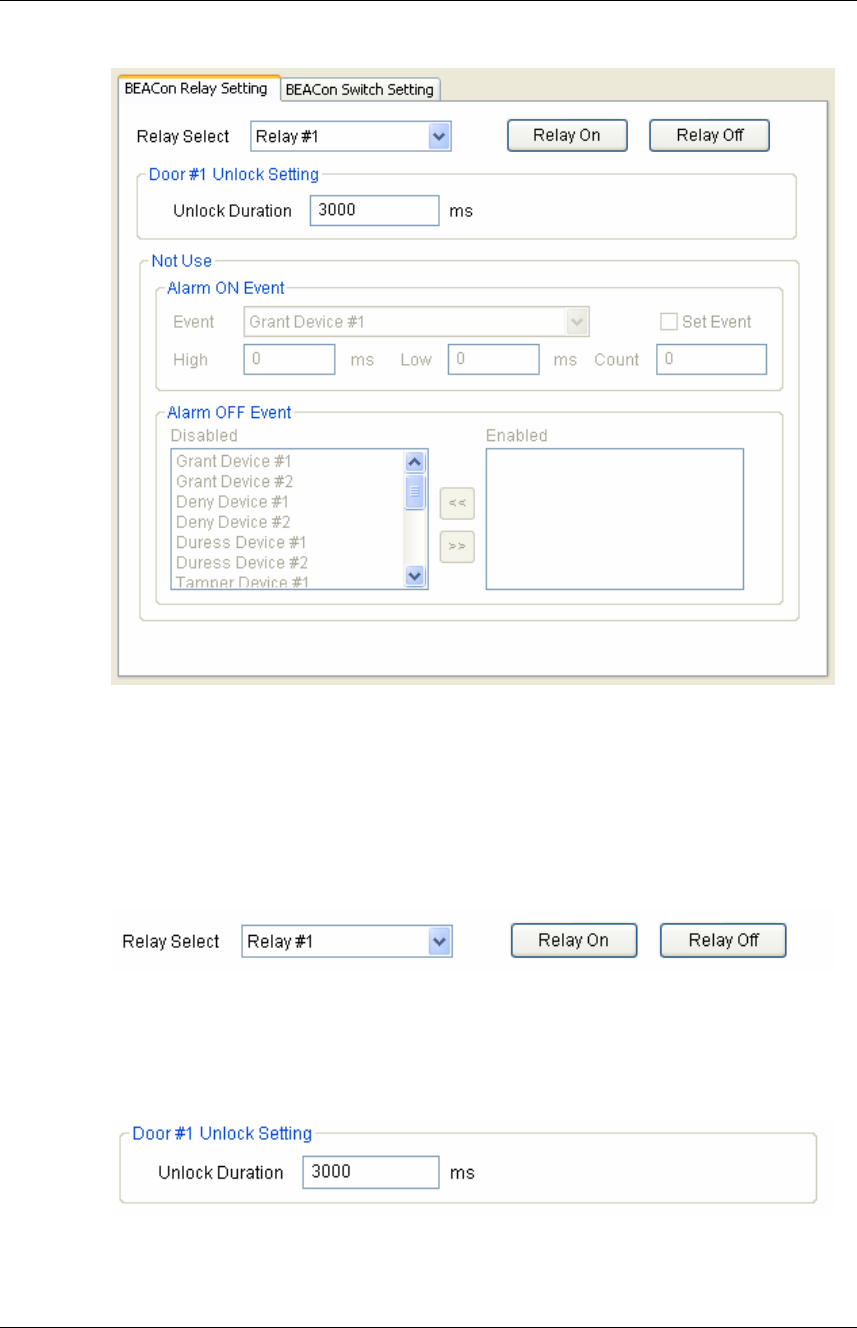
BioAdmin User Manual 192
Copyright © 2006, 2007 by Suprema Inc. http://www.supremainc.com
Detailed Operations are as follows.
z Select a relay to set up the configuration. Once you select a relay, applicable
items for the selected relay will be activated on the relay setting window.
z You can also open/close the relays by pressing the Relay On / Relay Off
buttons.
z Unlock Setting
Enter the unlock duration time. Once the door is unlocked, it can be locked
again after this unlock duration time.
z Alarm On Event:
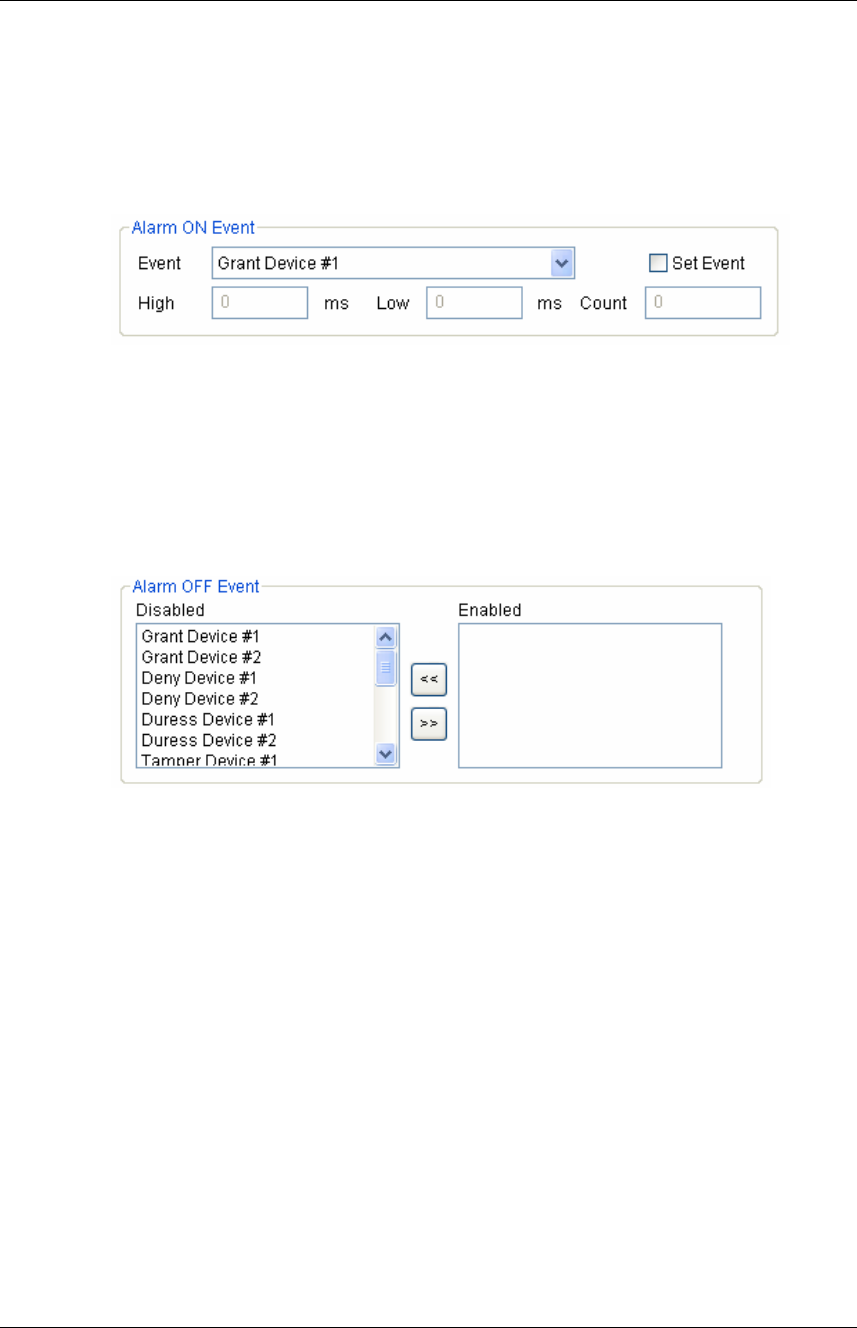
BioAdmin User Manual 193
Copyright © 2006, 2007 by Suprema Inc. http://www.supremainc.com
Select alarm on events on the drag down menu by checking on the Set Event
check box. Enter High, Low, and Count to set up the alarm frequency. If any of
the alarm on events is triggered, the alarm will be activated at your designated
frequency.
z Alarm Off Event:
Select alarm off events. You can enable the alarm off events simply by double
clicking the events on the disabled event list. If any of the alarm off events is
triggered, the alarm will be deactivated, regardless of remaining duration or
pulse counts.
4.10.4. Switch Setting
On this menu, you can change the switch setting of BEACon. The switch setting
can be differently configured depending on the operation mode of BEACon.
z On 1 door mode, switch#1 is automatically set up as the door sensor and #3 as
RTE (request to exit). Therefore, you can set up switch#2, #4, #5, and #6 as
other various functions on the Normal Switch Setting menu.
z On 2 door mode, switch#1 and #2 are automatically set up for the door sensor.
Also, switch#3 and #4 are automatically set up for RTE. Therefore, you can set
up switch#5 and #6 for other various functions on the Normal Switch Setting
menu.
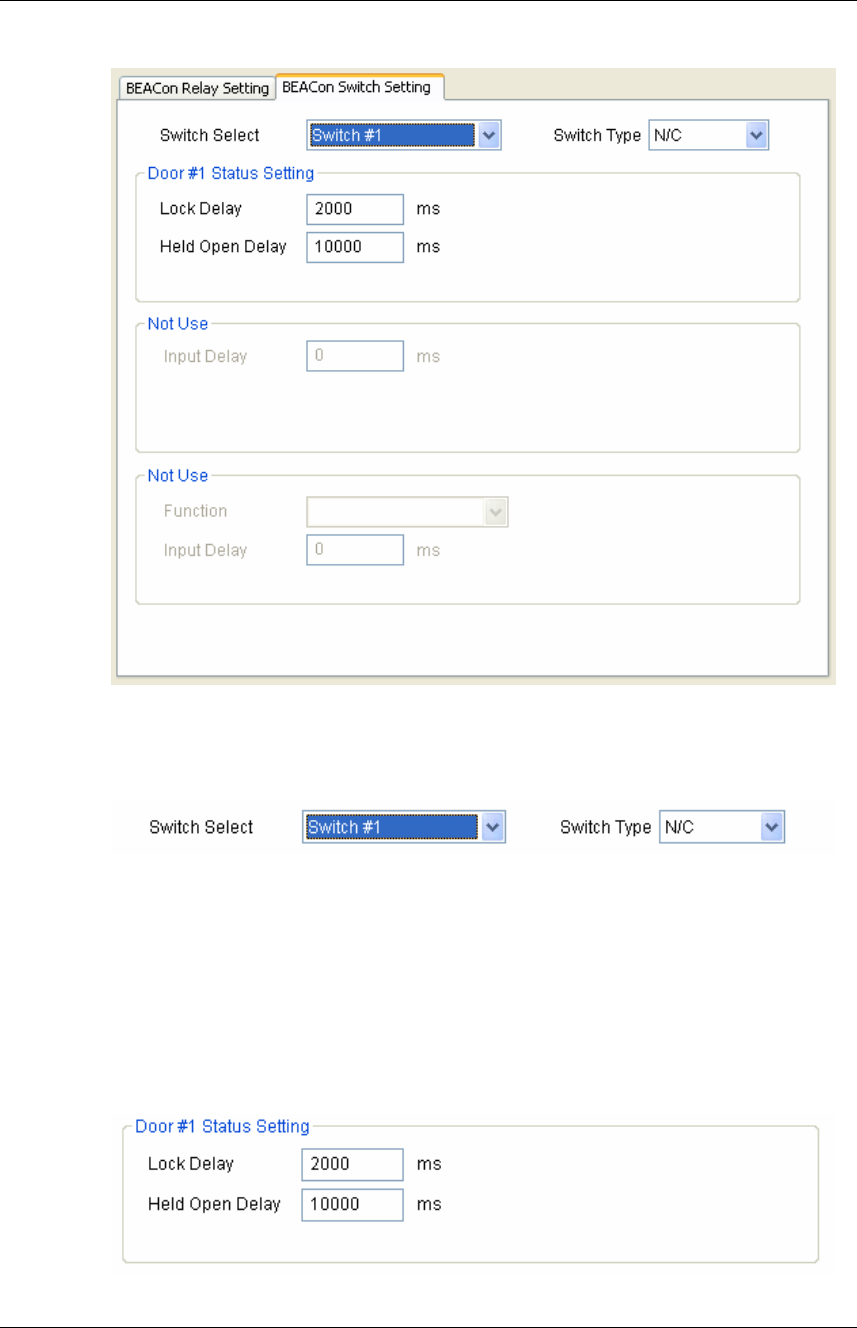
BioAdmin User Manual 194
Copyright © 2006, 2007 by Suprema Inc. http://www.supremainc.com
z Select a switch to set up the configuration. Once you select a switch, applicable
items for the selected switch will be activated on the switch setting window.
z Door Status Setting
By selecting a door sensor switch, you can set up the lock delay and held open
delay of the connected BEACon. If the door is closed, the door strike will be
locked after your designated lock delay time. If the door is opened for more than
your designated Held Open Delay time, the held open door event will be
triggered.
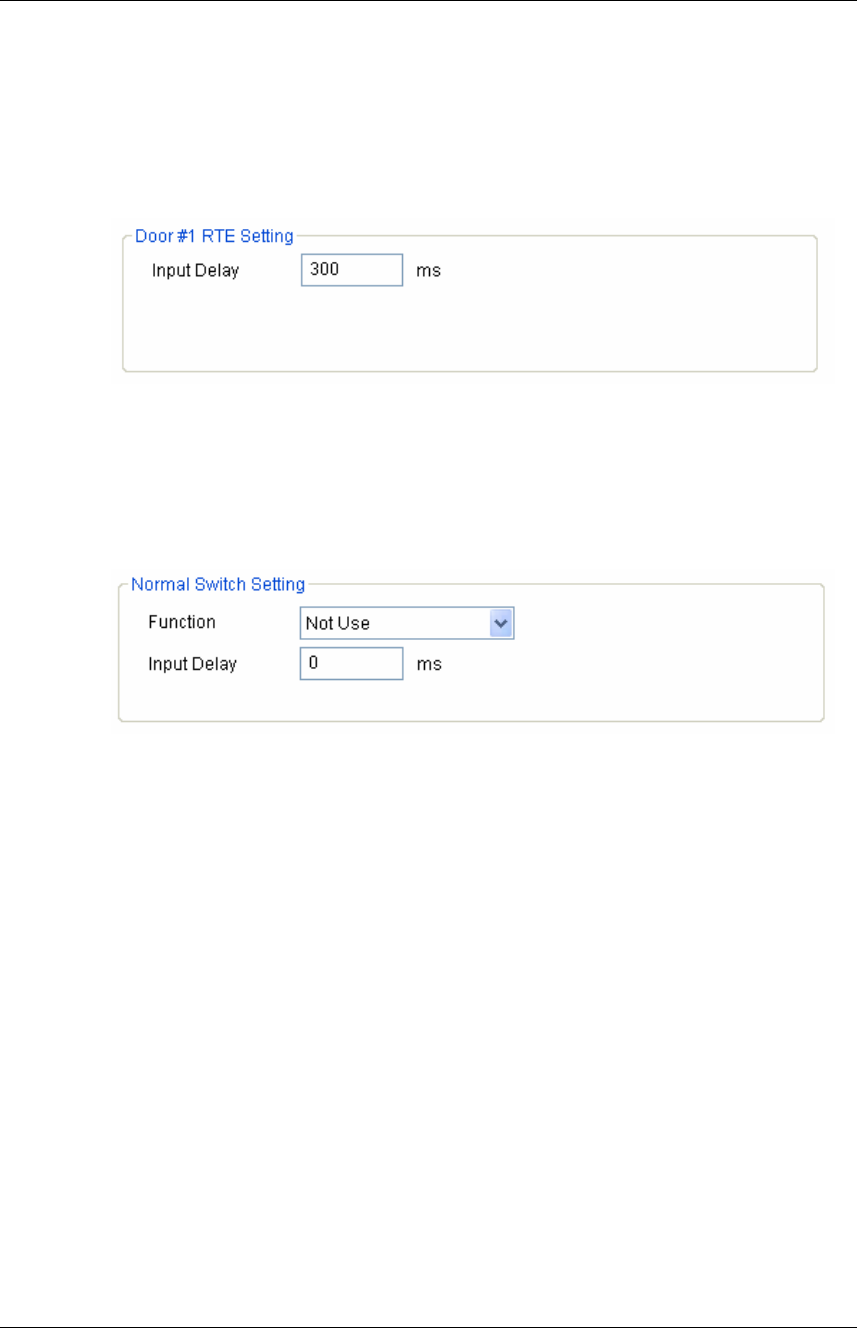
BioAdmin User Manual 195
Copyright © 2006, 2007 by Suprema Inc. http://www.supremainc.com
z Door RTE Setting
By selecting RTE switch, you can set up the input delay. If the RTE switch is
activated for more than your designated input delay time, the door will be
opened.
z Normal Switch Setting
For the remaining switches, you can set up other various functions, such as
RTE, tamper, clear alarm switch. If the switch is activated for more than your
designated input delay time, the selected function will be triggered.
4.10.5. Refresh / Apply / Transfer (apply to another device)
z Refresh : You can restore the original configuration by pressing the Refresh
button before pressing Apply button.
z Apply : After changing the configuration, you need to press the Apply button to
save.
z Transfer : You can transmit the changed configurations to other devices by
pressing the Transfer button.
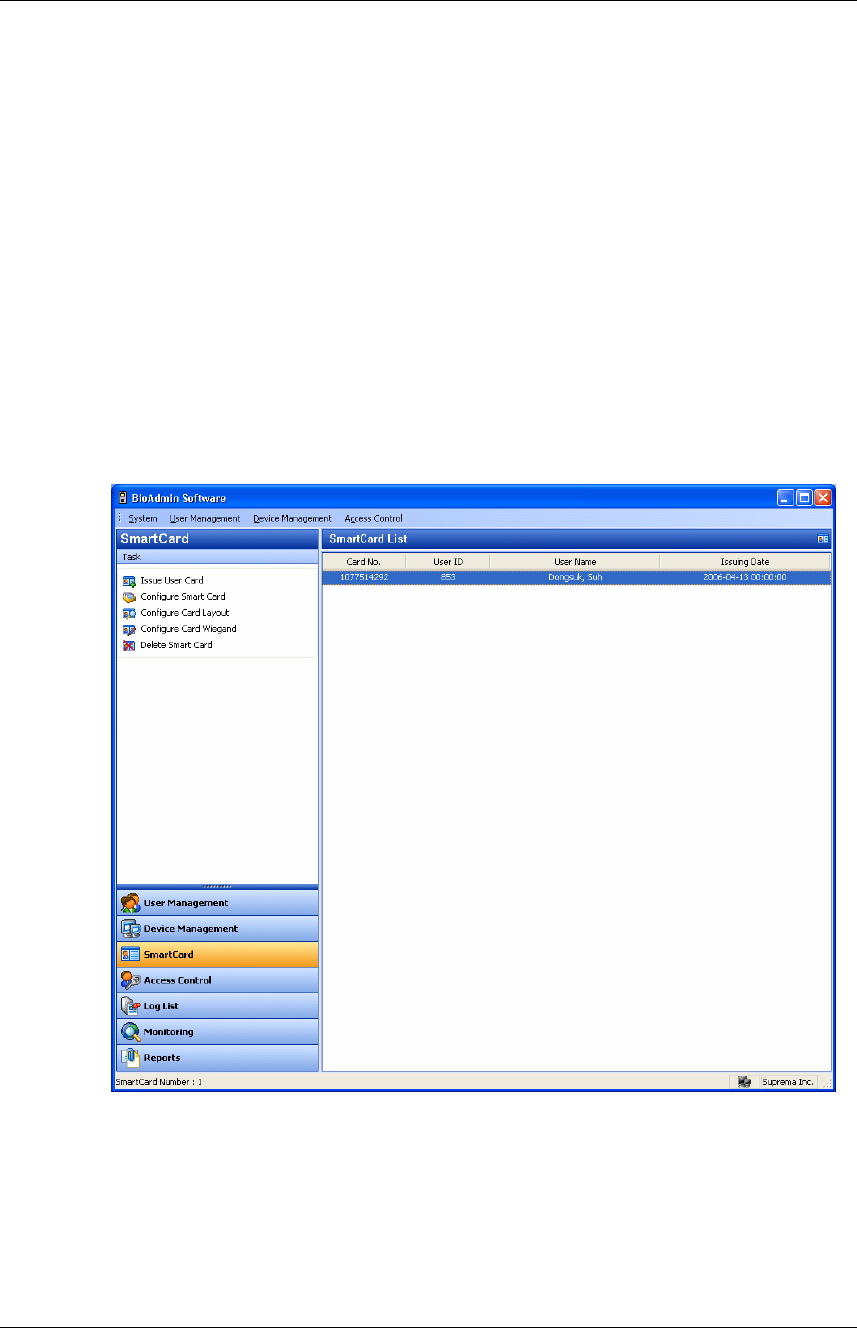
BioAdmin User Manual 196
Copyright © 2006, 2007 by Suprema Inc. http://www.supremainc.com
5. Smartcard
The Smart Card menu is used to see the list of smartcards issued on the BioAdmin
Software. All of user’s smart cards will be automatically shown on the Smartcard
list of this menu.
The Smartcard menu covers the following operations:
z Issue User Card
z Manage Smartcard
z Configure Card Layout
z Configure Card Wiegand
z Delete Smartcard
5.1. Configuration of Smartcard page
By selecting Smart Card menu, Smart Card management page is updated on the
main window.
The Smartcard page is divided into 2 sectors:

BioAdmin User Manual 197
Copyright © 2006, 2007 by Suprema Inc. http://www.supremainc.com
z Smartcard List
The Smart card database is under central management on host PC. The
Smartcard list includes the detailed list of smart cards issued on BioAdmin
software.
z Task box
Task box includes buttons to control the basic operations of the Smartcard page.
5.2. Smartcard List
The Smartcard list includes the following information of the Smartcards.
z Card Number
z User ID
z User Name
z Issuing Date
z Expiry Date
5.3. Card issue
The Issue User Card menu enables a pop-up window to issue a user’s smart card.
For the detailed operation, refer to the issuing procedure on the User Management
menu.
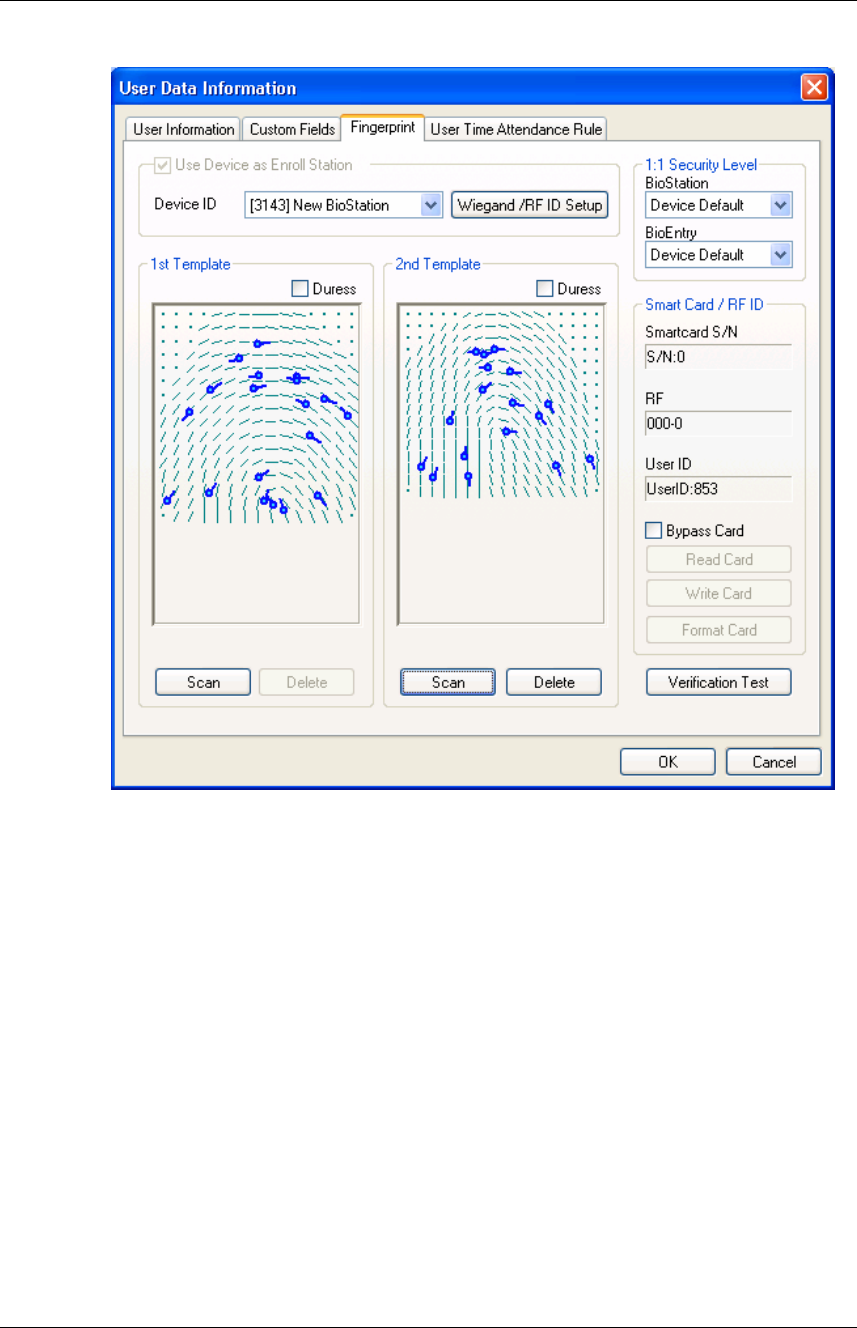
BioAdmin User Manual 198
Copyright © 2006, 2007 by Suprema Inc. http://www.supremainc.com
5.4. Manage Smartcard
The Manage Smartcard menu enables a pop-up window to read the smart card
information and format smart card. On this window, you can check the smartcard
information such as Serial No, Wiegand string(if applicable), User ID, Security
Level, User Name, Access Group, and Template Data.
If you do not have a USB smart card Device/Writer, you can also read the smart
card information directly through BioEntry by check on Use BioEntry as Enroll
Station.
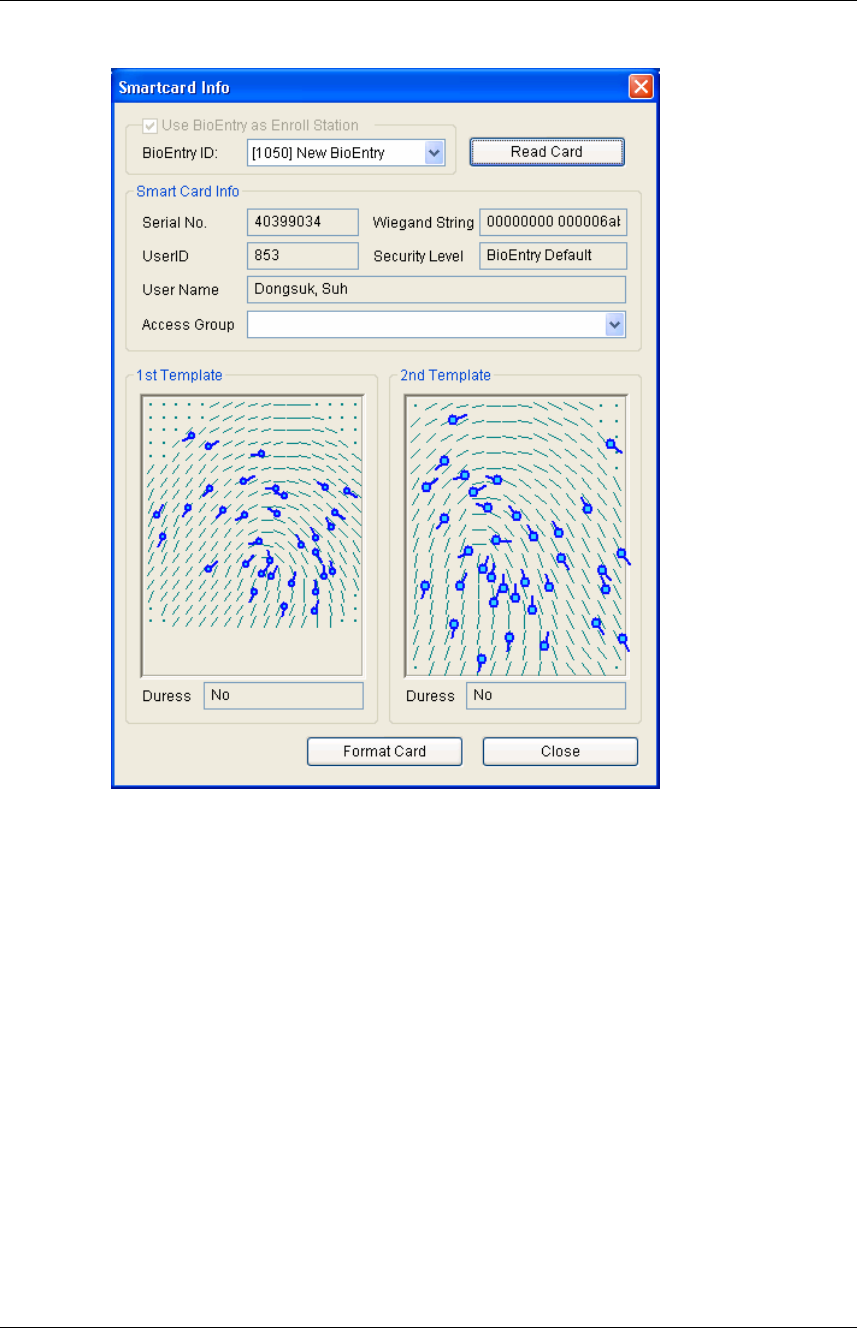
BioAdmin User Manual 199
Copyright © 2006, 2007 by Suprema Inc. http://www.supremainc.com
5.4.1. Read issued smart card
On this Manage Smartcard window, information stored on the smart card can be
retrieved similarly to the reading process described in Chapter 3. User
Management.
5.4.2. Smart card format
On this Manage Smartcard window, the formatting can be processed similarly to
the formatting process described in Chapter 3. User Management.
5.5. Edit Card Layout
Smartcard layout is the process of defining custom sectors on user’s smart card to
store user information including templates. By selecting the Configure Smartcard
Layout button, the smartcard layout page is updated on the main window. It is
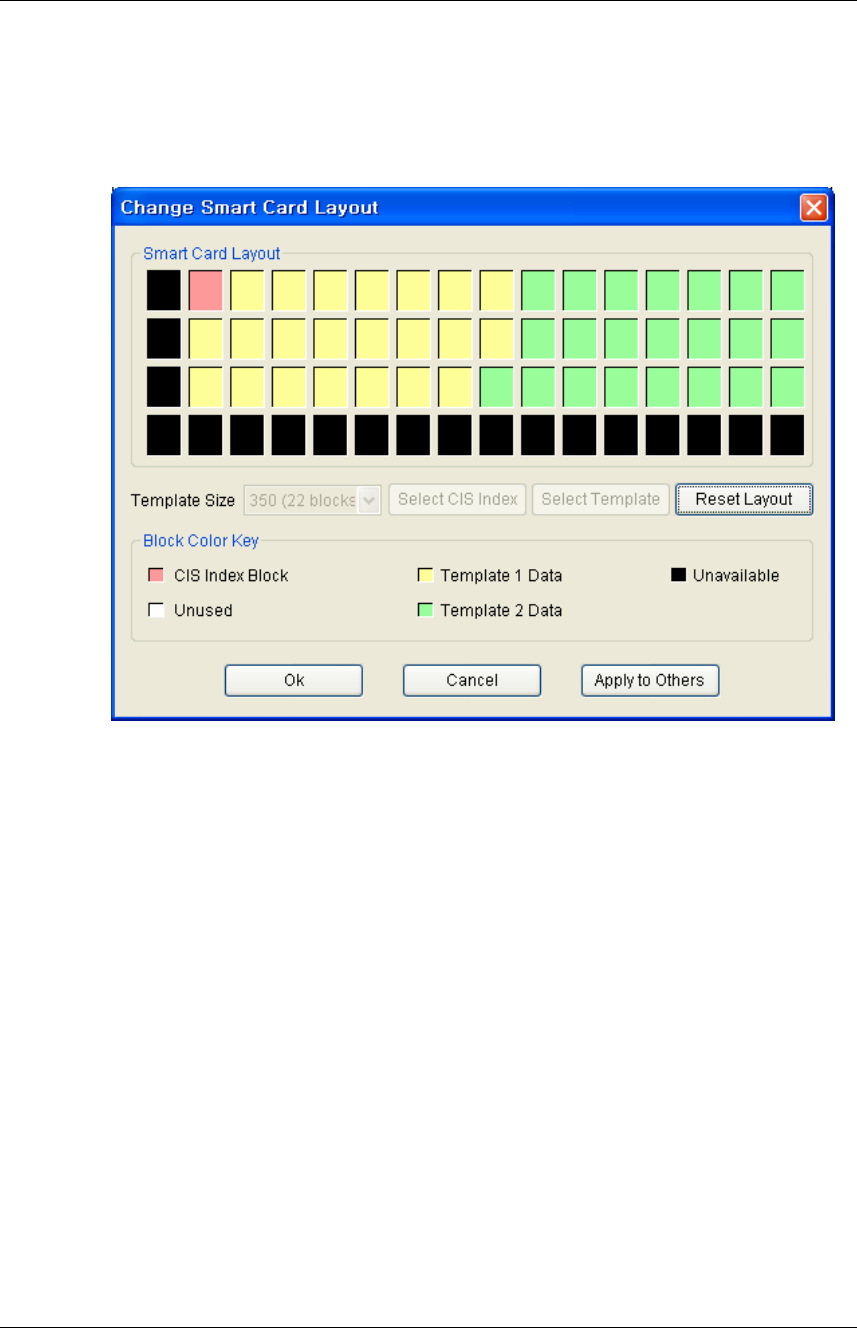
BioAdmin User Manual 200
Copyright © 2006, 2007 by Suprema Inc. http://www.supremainc.com
recommended that only advanced users attempt to change the layout since
improper changes may render the smart card unusable. Read this chapter
carefully for changing the layout from the default configuration.
5.5.1. Configuration of smartcard layout edit page
The Configure Smartcard layout page is divided into 3 sectors :
z Smart Card Layout
It shows the smartcard layout of the Smartcard Device/Writer device connected
to the host PC.
z Smart Card Layout
It shows the name of currently selected device and the layout of the current
device. If a group or all devices are selected, the contents are not available.
z New configuration
This sector is used for editing new layout to be applied to the devices and the
user’s smart card.
z Controls for managing layout
Fill with Current Configuration Value button updates the contents of the new
configuration using the retrieved layout from currently selected device. Transfer

BioAdmin User Manual 201
Copyright © 2006, 2007 by Suprema Inc. http://www.supremainc.com
button transmits new layout to the selected BioEntry™ device, selected group,
or all BioEntry™ devices. Several control buttons for editing layout also exist.
5.5.2. Size of Fingerprint data (Template)
Template size is configurable from 254 to 382. By factory default, template size is
specified as 350 bytes storing two templates on the card.
5.5.3. Block
z CIS index block : The header information is stored on the CIS index block which
is depicted by red color.
z Template data block : Blocks for template 1 data and template 2 data. The
number of blocks for each template data is determined by template size.
Template 1 data is depicted by yellow and template 2 data is depicted by green,
respectively.
z Unused block : Blank block which is not defined by layout.
z Unavailable block : Block that is prohibited from use.
5.5.4. Editing process
To configure customer’s layout, the following procedure is required.
z Initialize all the blocks to unused ones by pressing the Reset Layout button.
z Select the required template size.
z Press the Select CIS Index button and click an unused block to select a CIS
index block.
z Press the Select Template button and click an unused block to indicate the
start block of template data. Then, the blocks of template 1 data are set
automatically from the selected start block.
z Press the Select Template button again and click an unused block to indicate
the start block of template 2 data.
z Press the Transfer button to transfer the new smart card layout to selected
devices.
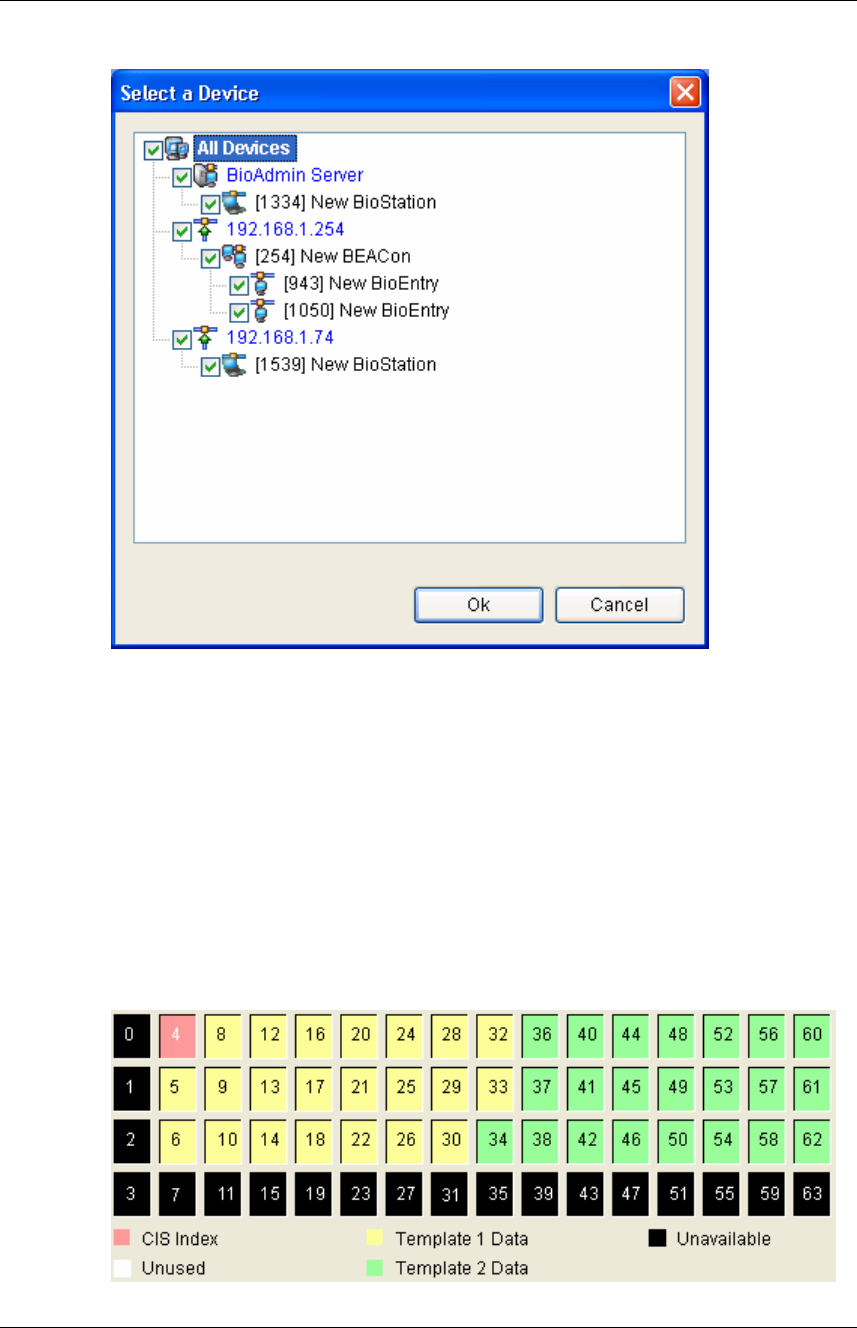
BioAdmin User Manual 202
Copyright © 2006, 2007 by Suprema Inc. http://www.supremainc.com
z The smart card layout window is activated only for BioEntry™ Smart model. If
the selected device is BioEntry™ Pass, this menu will not be activated.
z Press the OK button to save the new smartcard layout to the PC USB
smartcard device/writer.
z The saved layout is also applied in issuing a new smartcard using PC USB
smartcard device/writer.
5.5.5. Factory default (initial setting) layout
Factory default smart card layout is as follows :
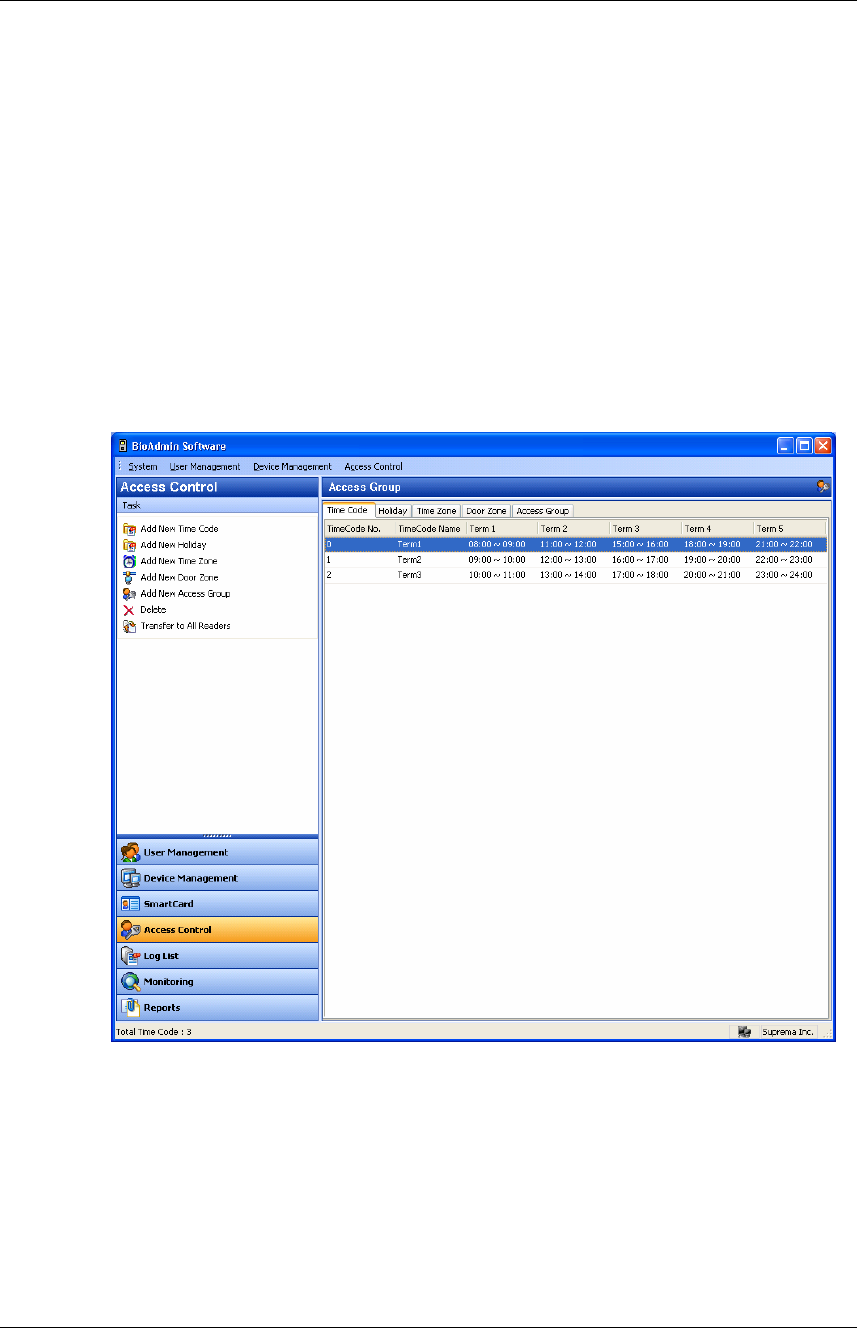
BioAdmin User Manual 203
Copyright © 2006, 2007 by Suprema Inc. http://www.supremainc.com
6. Access (In/Out) Control
On this menu, you can set up the Time Zone and Access Group. Time Zone and
Access Group are used to restrict user’s right to access according to previously
designated rules.
z If a user is not included in any access group, the user is allowed to enter every
door.
z If a user is included in an access group, but a BioEntry™ device does not have
the access group information, the user is allowed to enter the door without
restriction.
6.1. Time zone setting
You can set up Time Zone by combining several Time Codes. Therefore, before
setting up the time zone, you need to set up the time code first. Maximum 5 time
sections can be selected for each time code.
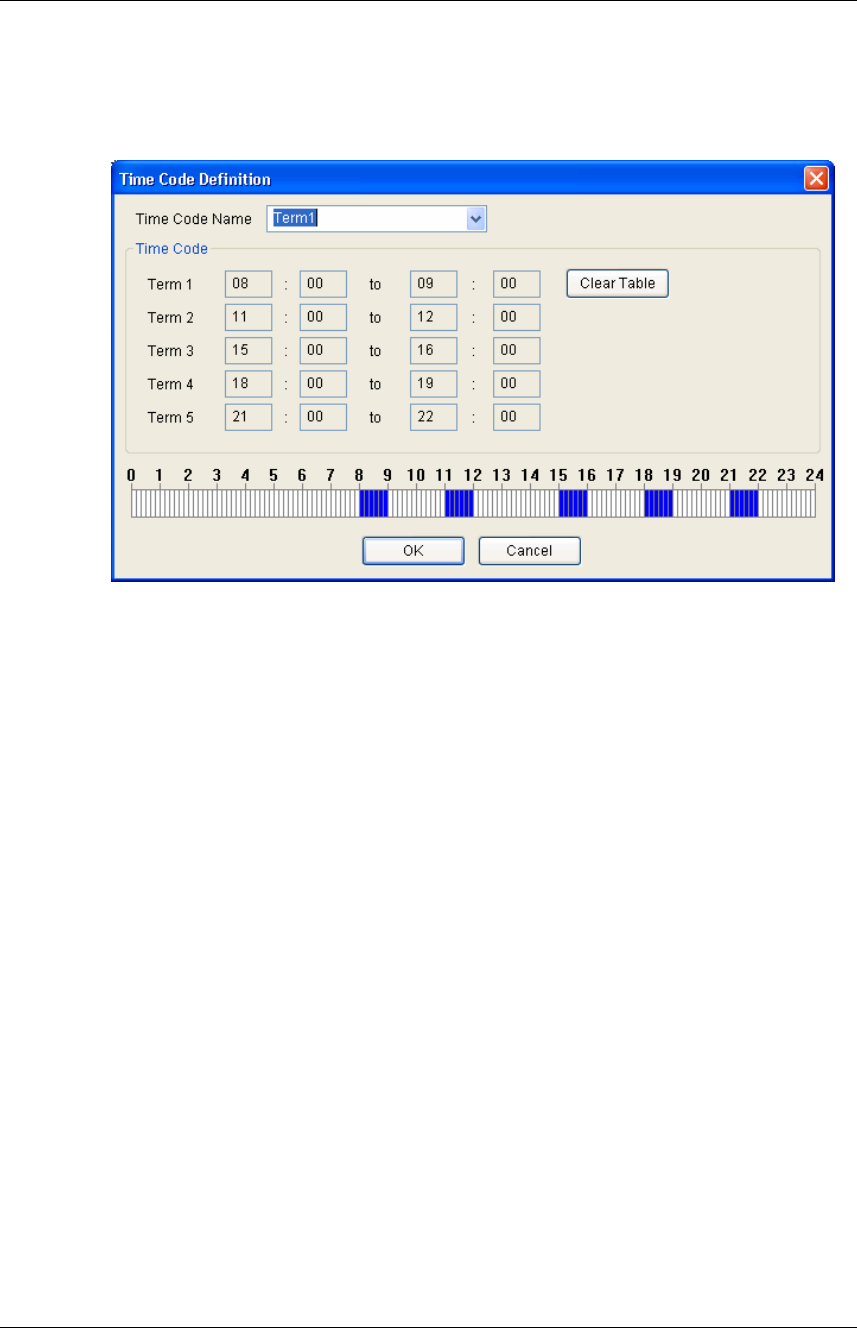
BioAdmin User Manual 204
Copyright © 2006, 2007 by Suprema Inc. http://www.supremainc.com
Detailed operations are as follows.
z Press the Add New Time Code button.
z Enter the name of time code.
z Set up the time code by entering time on the boxes.
z You can also set up the time code simply by dragging on the time bar on the
bottom of time definition window.
z Press the OK button to add the time code on time code list.
6.2. Holiday setting
To include holidays on the Time Zone, you need to set up holidays in advance.
Detailed operations are as follows.
z Press the Add New Holiday button.
z Press the Edit Code list in Holiday Setting window.
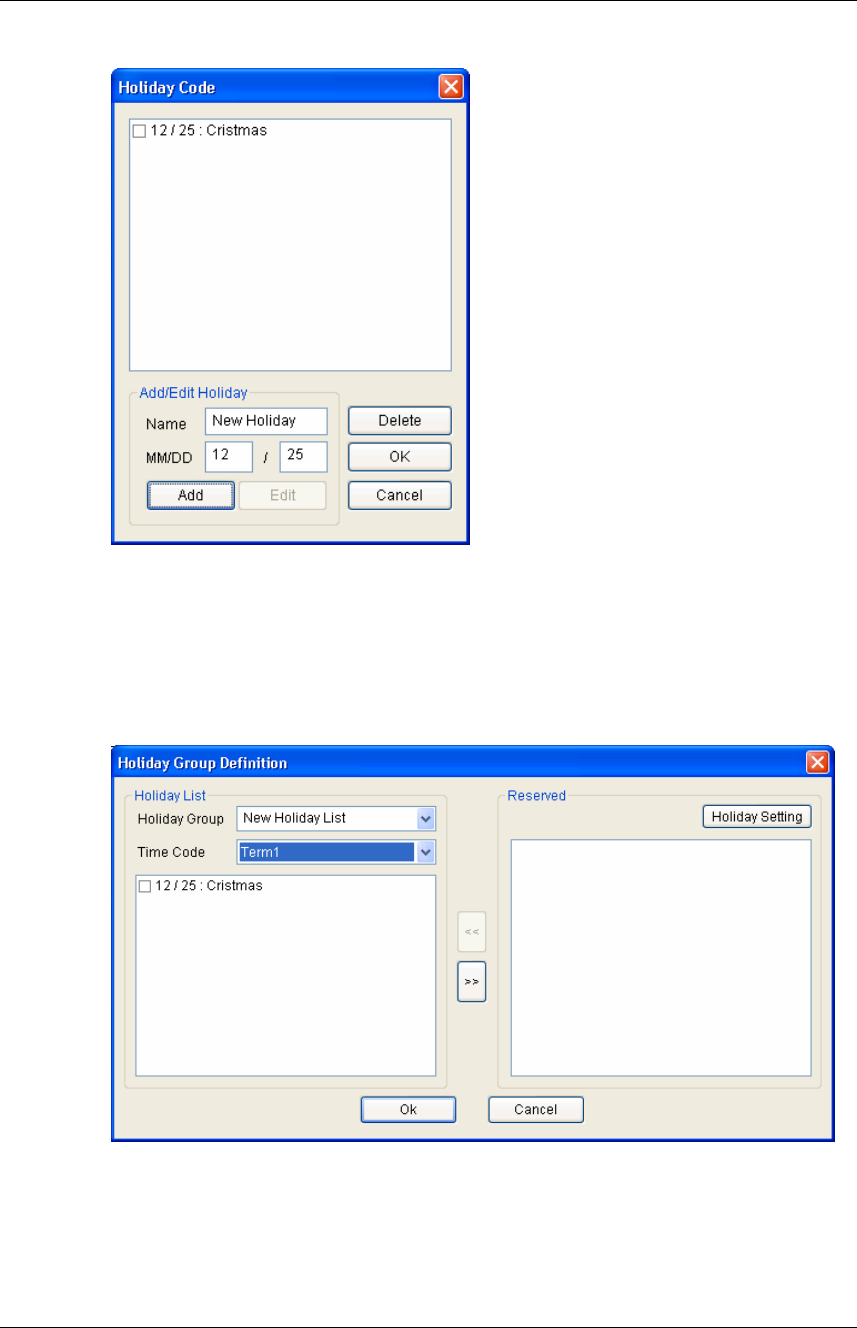
BioAdmin User Manual 205
Copyright © 2006, 2007 by Suprema Inc. http://www.supremainc.com
z Add, edit or delete holiday code list, and press the OK button.
z Enter the name of holiday group.
z Select Time Codes for the holiday.
z After checking on the Holiday Code, click << button.
z Press OK button to add the holiday on the holiday list.
6.3. I/O time zone setting
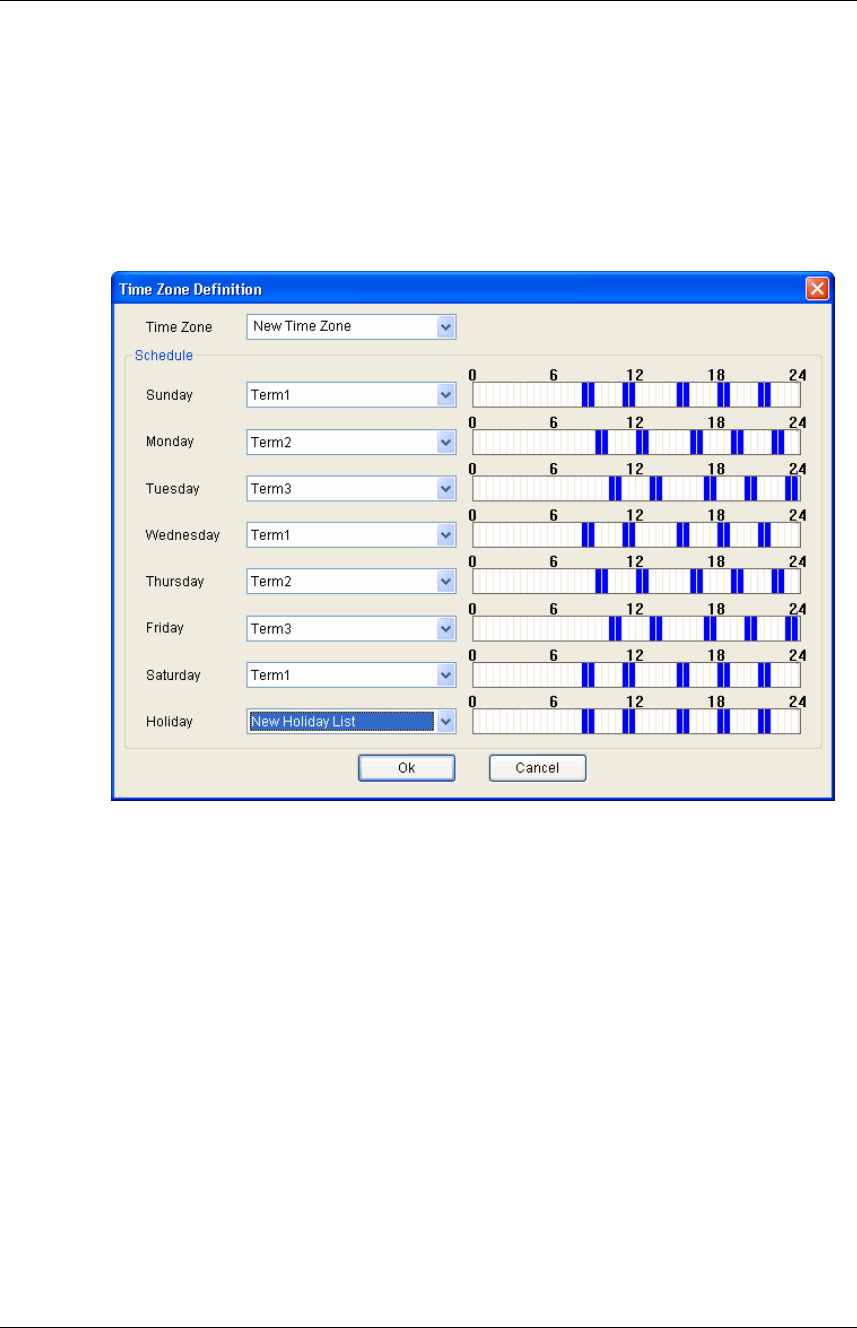
BioAdmin User Manual 206
Copyright © 2006, 2007 by Suprema Inc. http://www.supremainc.com
You can set up a Time Zone by combining time codes and a holiday group. One
time code is selected for each day from Monday to Sunday.
Detailed operations are as follows.
z Press the Add New Time Zone button.
z Enter the name of the Time Zone.
z Select a time code for each day from Monday to Sunday.
z Select a holyday group for the time zone.
z Press the OK button to add the holiday group to the time zone list.
6.4. I/O Door Zone setting
You can set up a door zone combining multiple BioEntry™ devices.
z Enter the name of the door zone.
z Check on the target BioEntry™ devices and click the << button.
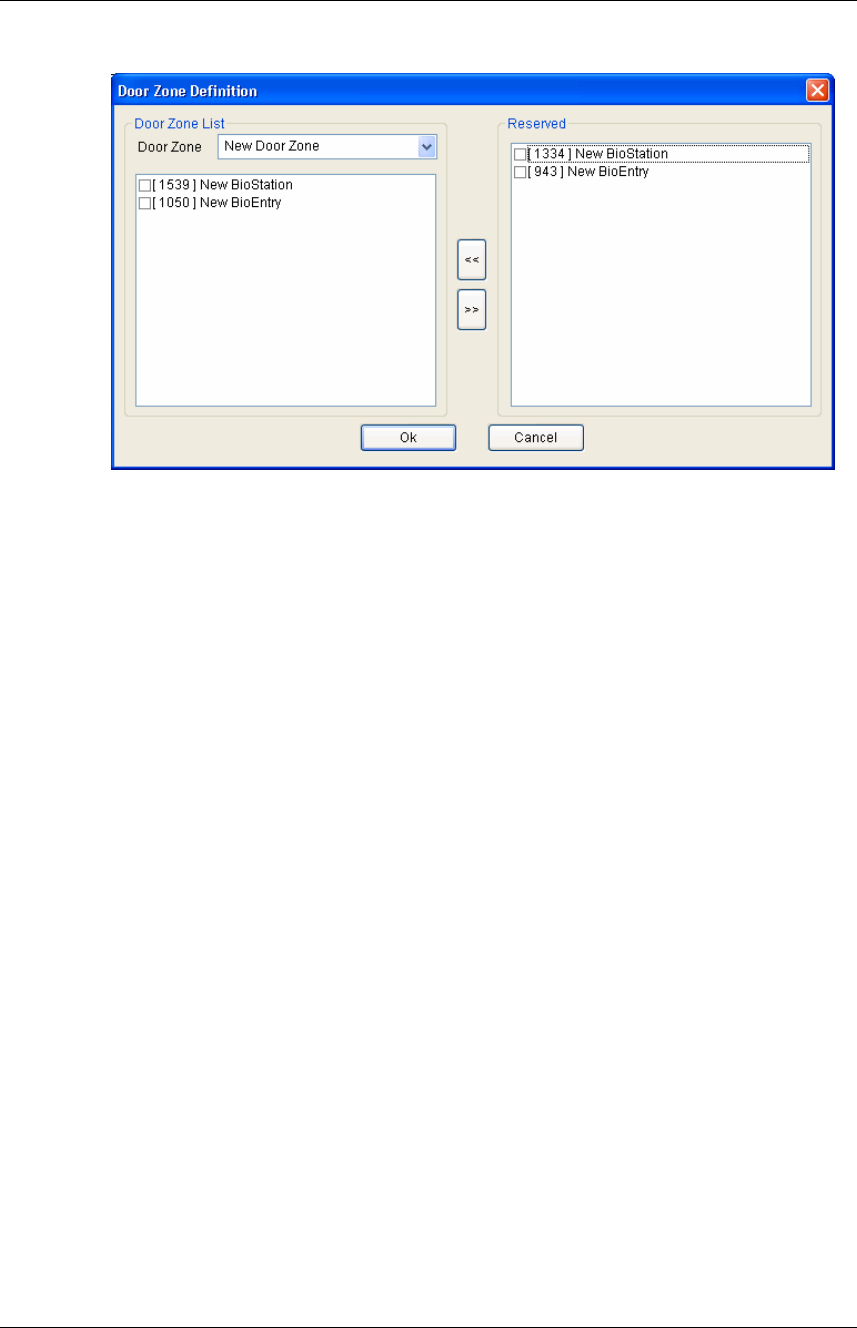
BioAdmin User Manual 207
Copyright © 2006, 2007 by Suprema Inc. http://www.supremainc.com
z Press the OK button to add the door zone on the door zone list.
6.5. Access (I/O) Group setting
By combining time zone and door zone, you can designate an access group. With
this access group, you can restrict the user’s right to access.
z Press the Add New Access Group button.
z Enter the name of access group.
z Check on the time zone and door zone and press the << button.
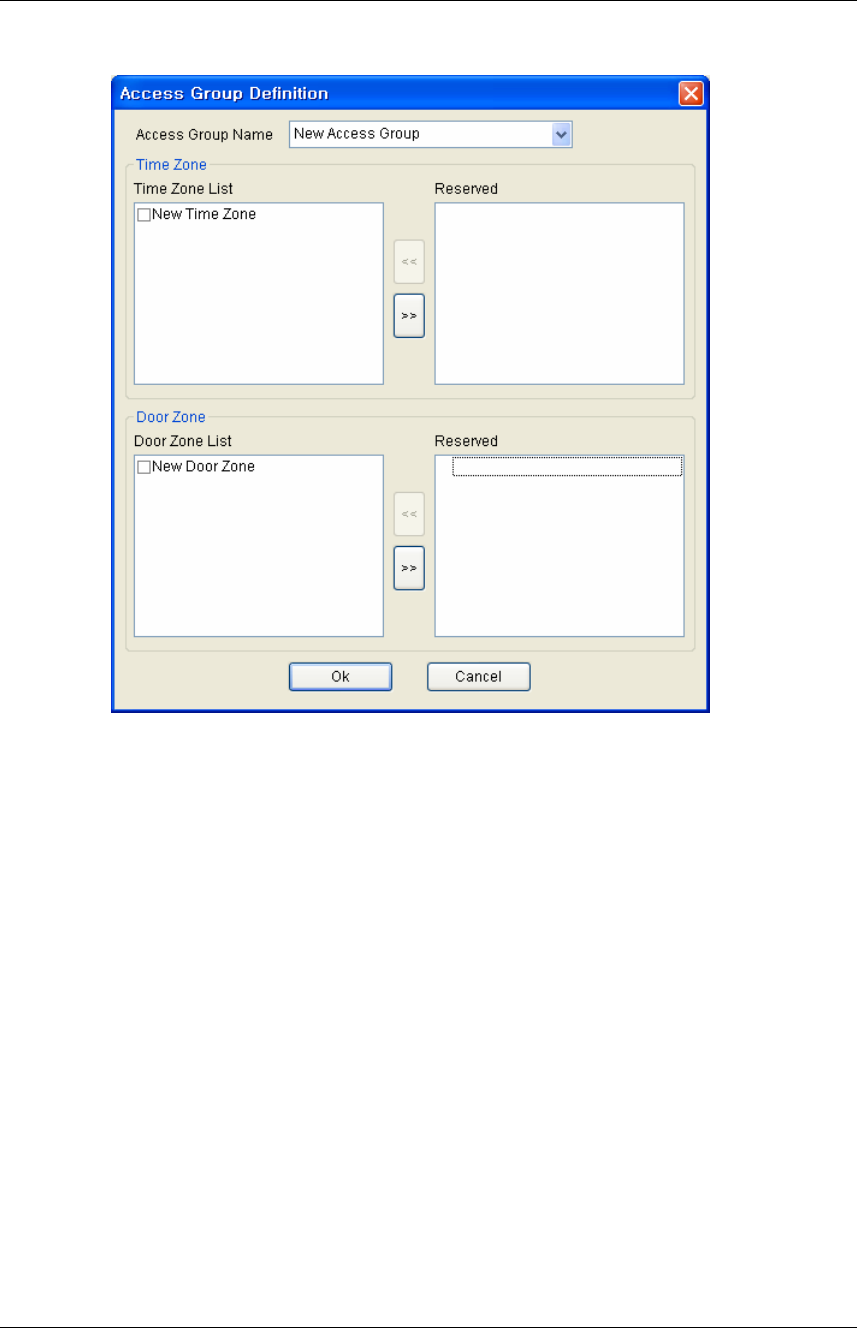
BioAdmin User Manual 208
Copyright © 2006, 2007 by Suprema Inc. http://www.supremainc.com
z Press the OK button to add the selected access group to the access group list.
You can apply this access group to users on the User Management menu.
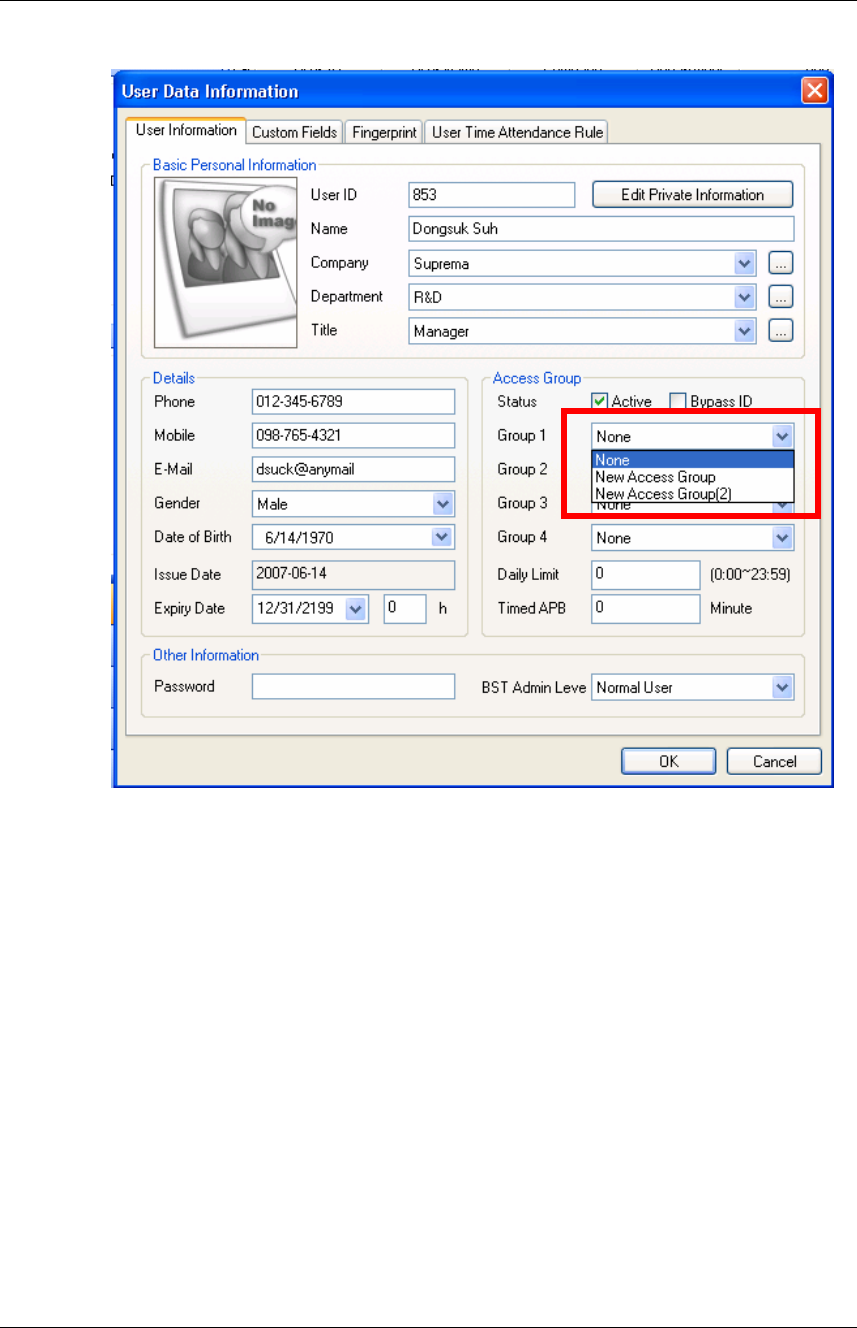
BioAdmin User Manual 209
Copyright © 2006, 2007 by Suprema Inc. http://www.supremainc.com
z For the detailed operation on User data, refer to Chapter 3. User Management
menu.
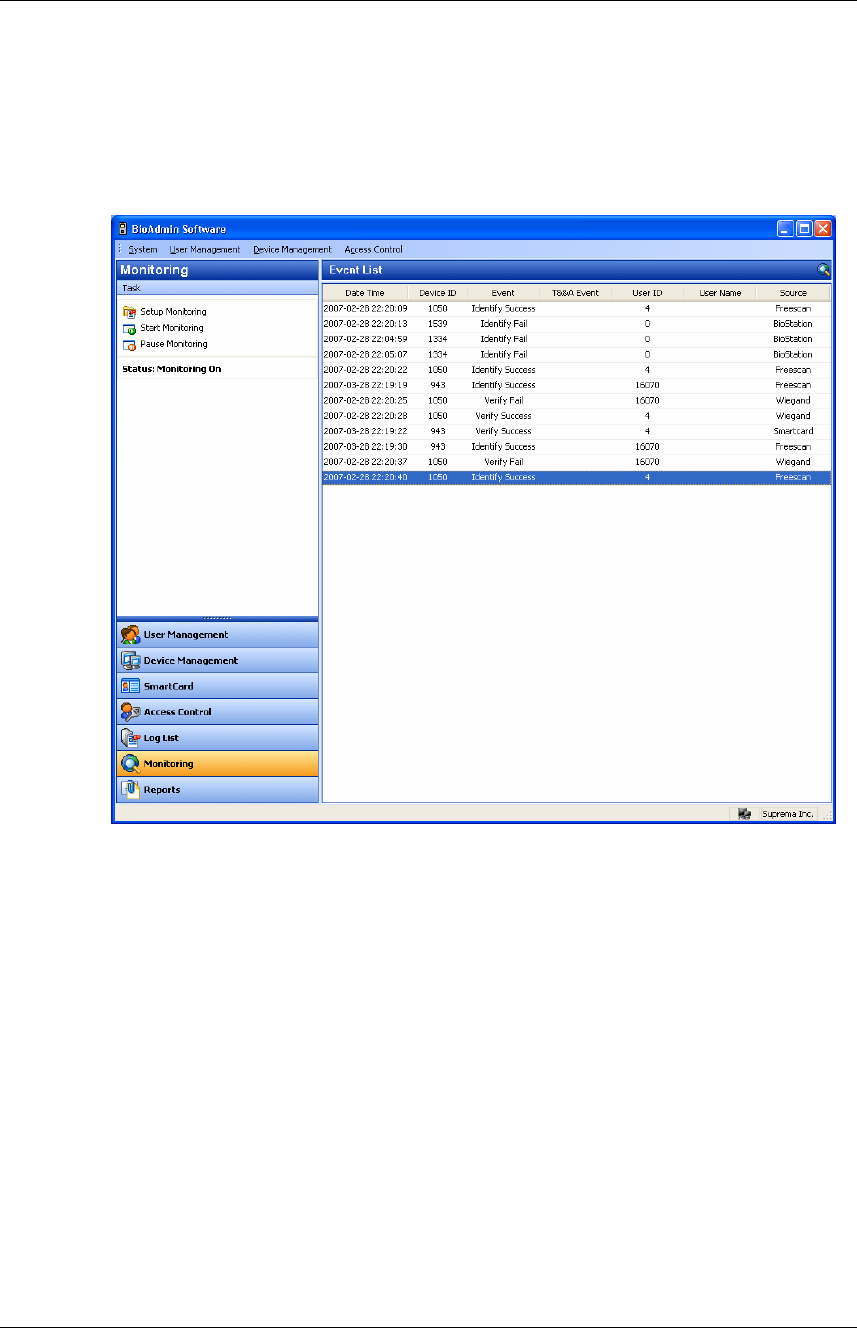
BioAdmin User Manual 210
Copyright © 2006, 2007 by Suprema Inc. http://www.supremainc.com
7. Monitoring
BioAdmin supports real time monitoring functions. By selecting the Monitoring
menu, you can check the log events of networked BioEntry and BioStation on time.
7.1. Monitoring setup
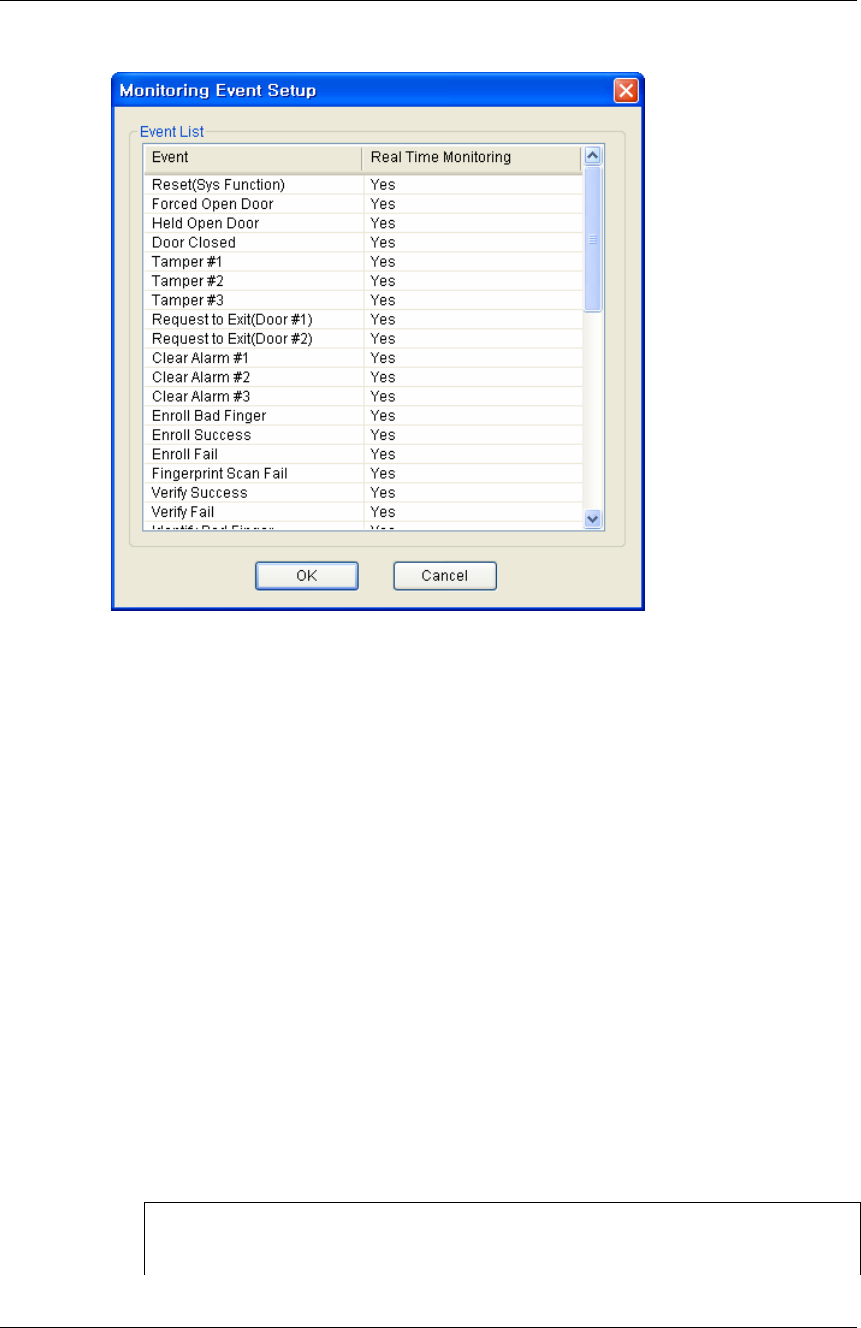
BioAdmin User Manual 211
Copyright © 2006, 2007 by Suprema Inc. http://www.supremainc.com
On this menu, you can select the events to be shown on the monitoring window
simply by double clicking on the Yes/No field of each event.
z If you double click the Yes field, it will be changed to No, and the event will not
be listed on the monitoring window.
z If you double click the No field, it will be changed to Yes and the event will be
listed on the monitoring window.
7.2. Start Monitoring
z By pressing the Start Monitoring button, you can start the real time monitoring
of the log events from all networked BioEntry and BioStation.
z If you select another menu during monitoring mode, monitoring will be stopped.
z Event List on the monitoring window shows up to 5000 events. If the number of
events is more than 5000, the oldest event will be automatically deleted from
the list. Even though the oldest event is deleted from the monitoring list, it still
remains on the log data of BioEntry and BioStation.
Monitoring is automatically started when the menu Monitoring is selected
from another menu. So, the Start Monitoring is needed only to restart

BioAdmin User Manual 212
Copyright © 2006, 2007 by Suprema Inc. http://www.supremainc.com
monitoring after pausing monitoring.
7.3. Pause Monitoring
By pressing the Pause Monitoring menu, you can stop monitoring.
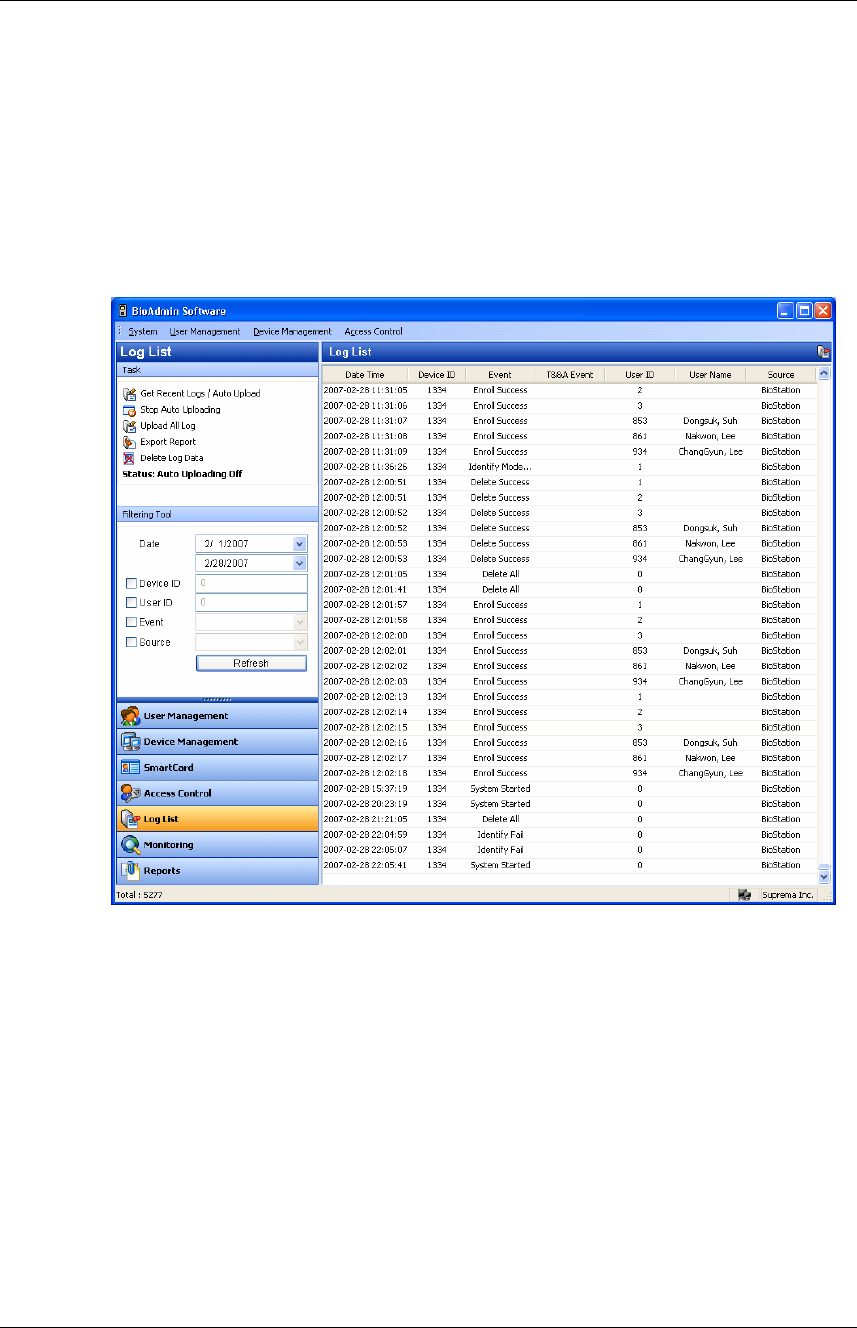
BioAdmin User Manual 213
Copyright © 2006, 2007 by Suprema Inc. http://www.supremainc.com
8. Log List
The Reports menu covers the following operations:
z Management of log database stored on host PC
z Upload new log events from BioEntry and BioStation into the log database
By selecting the Log List, the log list page is updated on the main window.
8.1. Configuration of Log check page
The Reports page is composed of 2 components:
z Log List
Log database is stored on host PC enabling to preserve old log data. Log list
shows stored log events describing Date, Time, Device ID, Event, User ID, User
Name, and Source.
z Filtering Tool
You can filter log records by Date, Device, User ID, Name, Event, and Source.
For example, if a device is selected, log events of the selected device will be
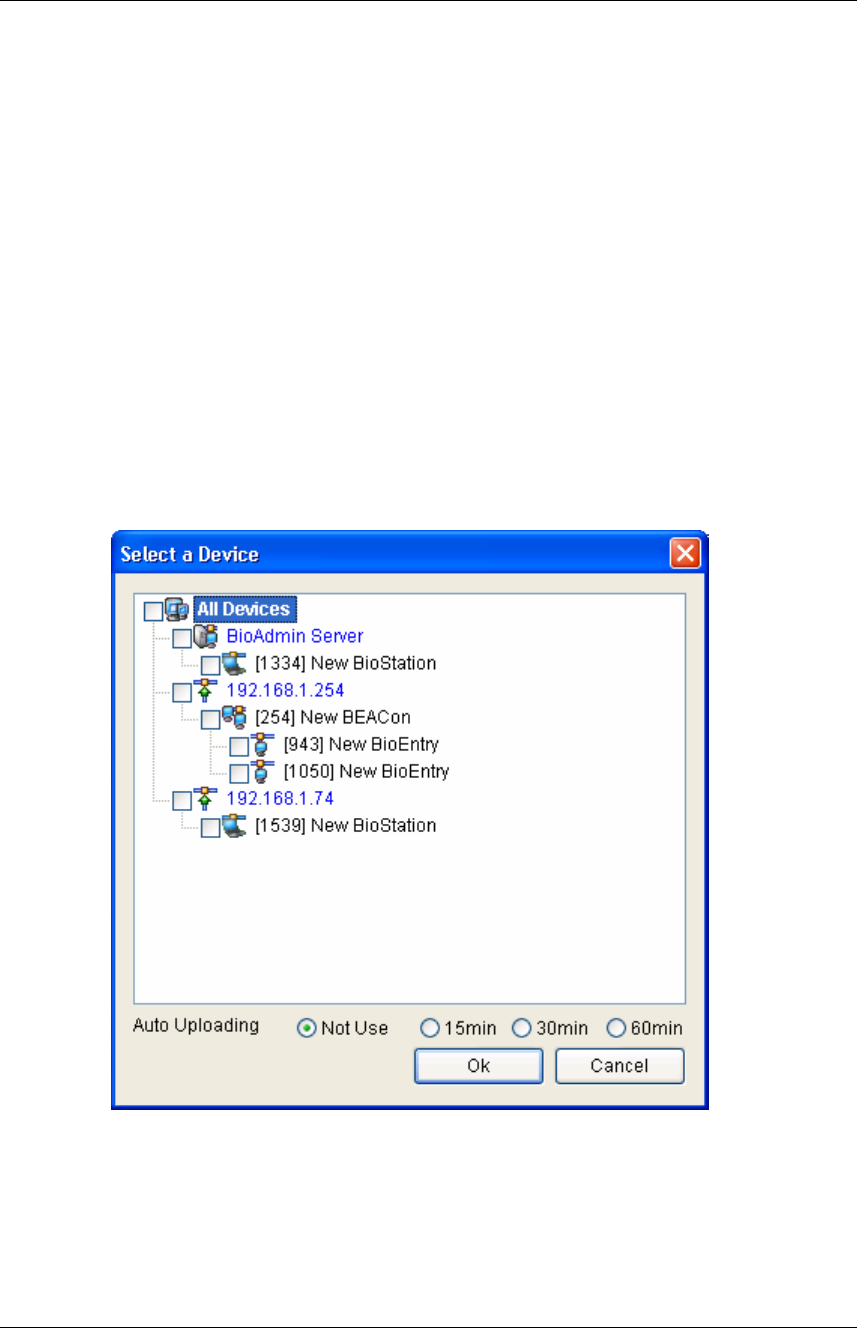
BioAdmin User Manual 214
Copyright © 2006, 2007 by Suprema Inc. http://www.supremainc.com
shown.
z Task box
Task box includes buttons to control basic operations of the Log List page.
8.2. Manage Log database
8.2.1. Get recent logs
In case of pressing get recent logs/ auto upload button, window for select device
pops up and as to selected device here, log information newly generated after log
information in BioAdmin is uploaded.
For the BioStation connected to BioAdmin Server, you do not need to get logs from
them, because logs will be automatically saved on BioAdmin Server on real time.
8.2.2. Auto uploading setting
In case of pressing get recent logs/ auto upload button, log information
generated in BioEntry and BioStation for set period can be uploaded automatically
to BioAdmin. Administrator can execute auto uploading by choosing 15 min / 30
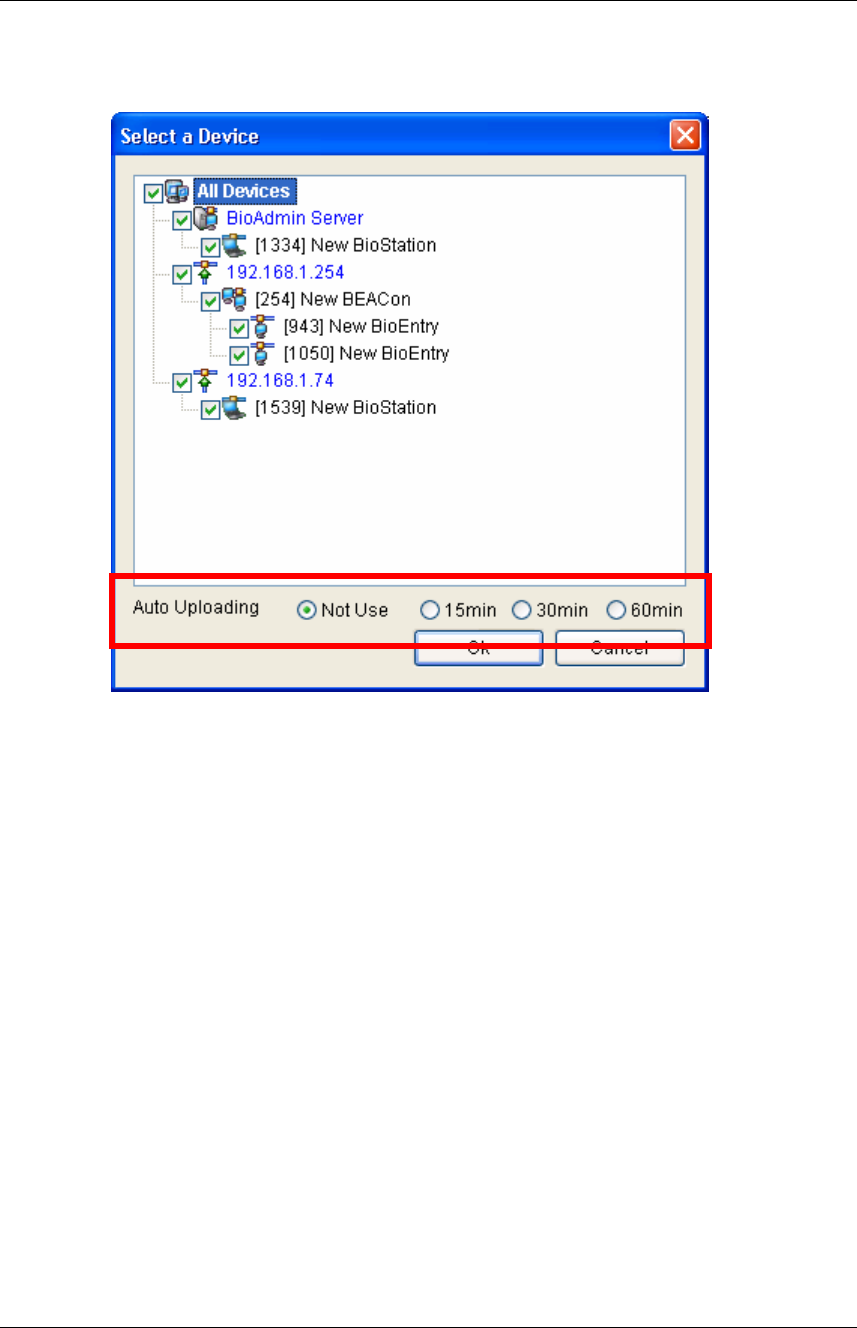
BioAdmin User Manual 215
Copyright © 2006, 2007 by Suprema Inc. http://www.supremainc.com
min / 60 min according to applied environment.
Once auto uploading is applied, status : auto uploading on is indicated on task
box.
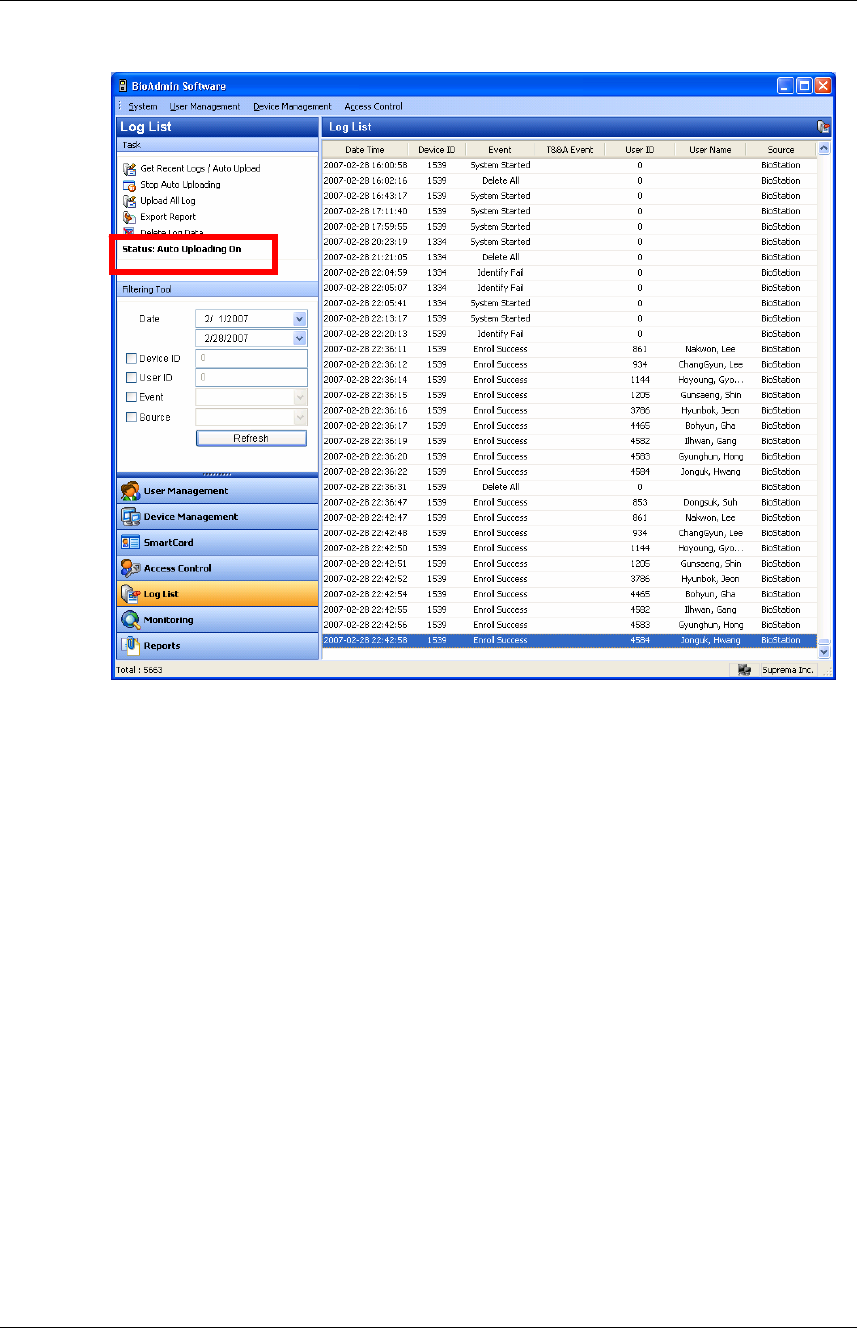
BioAdmin User Manual 216
Copyright © 2006, 2007 by Suprema Inc. http://www.supremainc.com
8.2.3. Release auto uploading
In case of pressing stop auto uploading button, user can release set auto
uploading. Also, in case of disabled mode when setting time transfer, user can
release time transfer.
Once auto uploading is released, status : auto uploading off is indicated on task
box
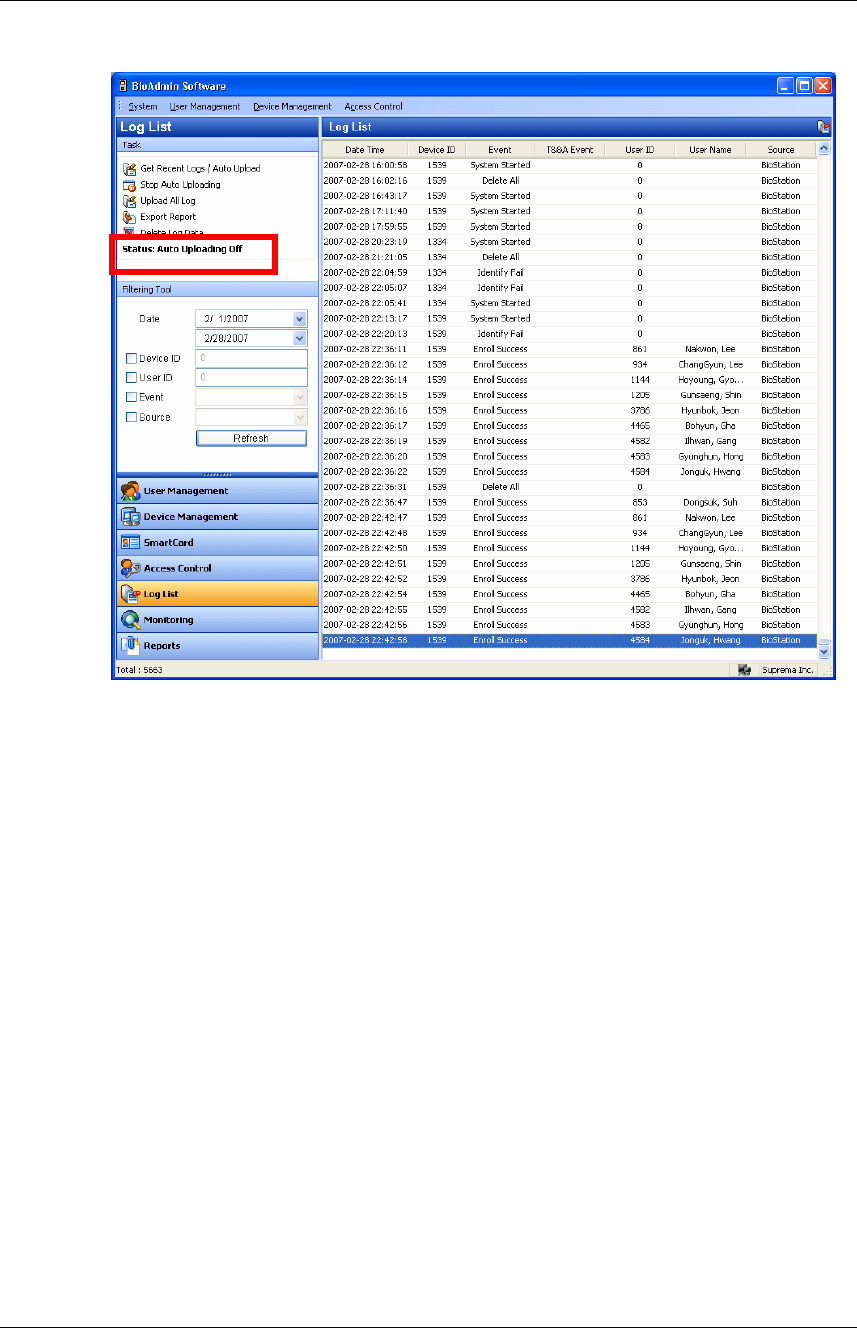
BioAdmin User Manual 217
Copyright © 2006, 2007 by Suprema Inc. http://www.supremainc.com
8.2.4. Upload all logs
In case of pressing upload all logs button, select device window appears and all
logs of device selected here are uploaded. In case partial log information remains
in BioAdmin, existing log information is kept as it is and new log information is
uploaded.
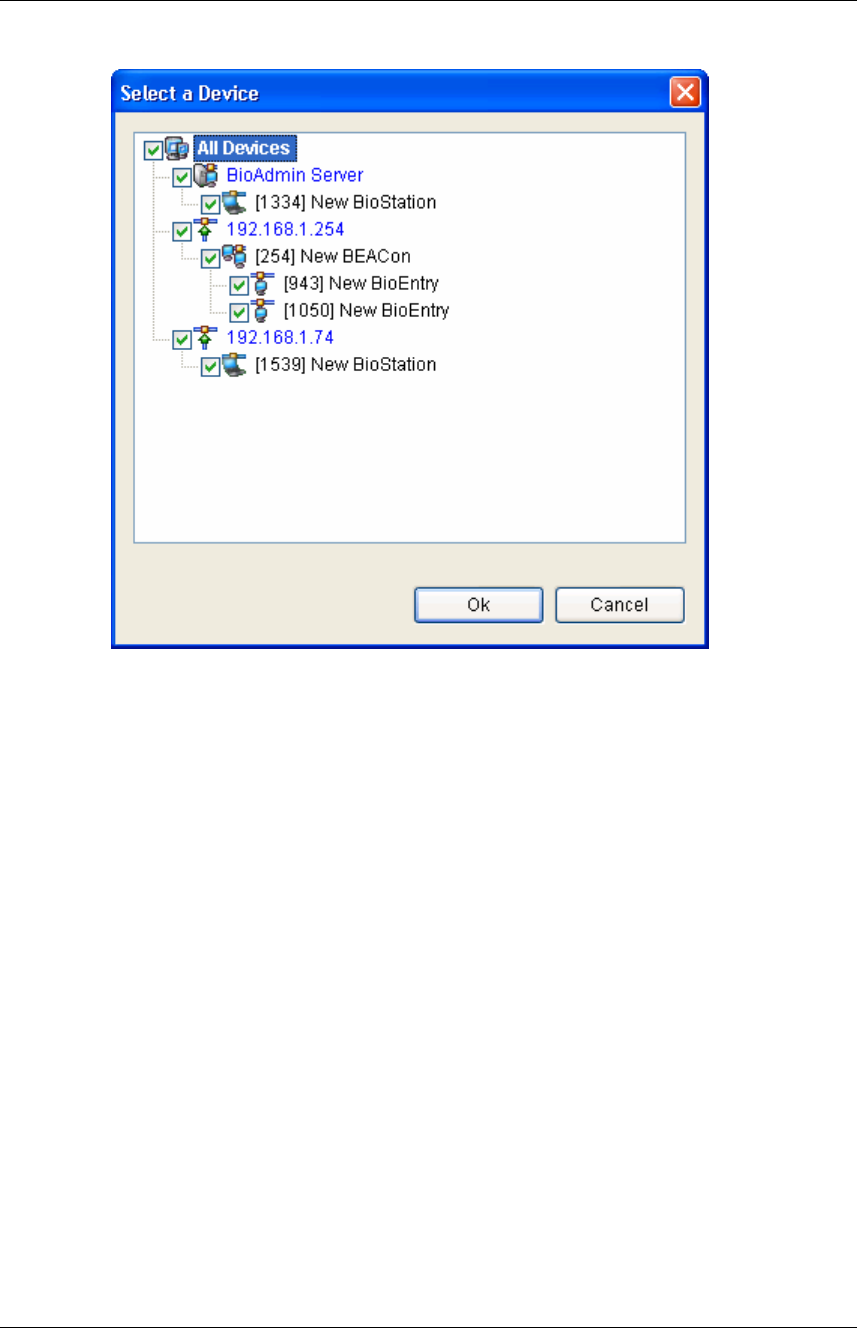
BioAdmin User Manual 218
Copyright © 2006, 2007 by Suprema Inc. http://www.supremainc.com
8.2.5. Export Report
Log data can be exported to CSV file format using the Export Report button.
Detailed operations are as follows:
z Press the Export Report button.
z Select fields to export by simply moving the target field from Field List to
Selected Field List.
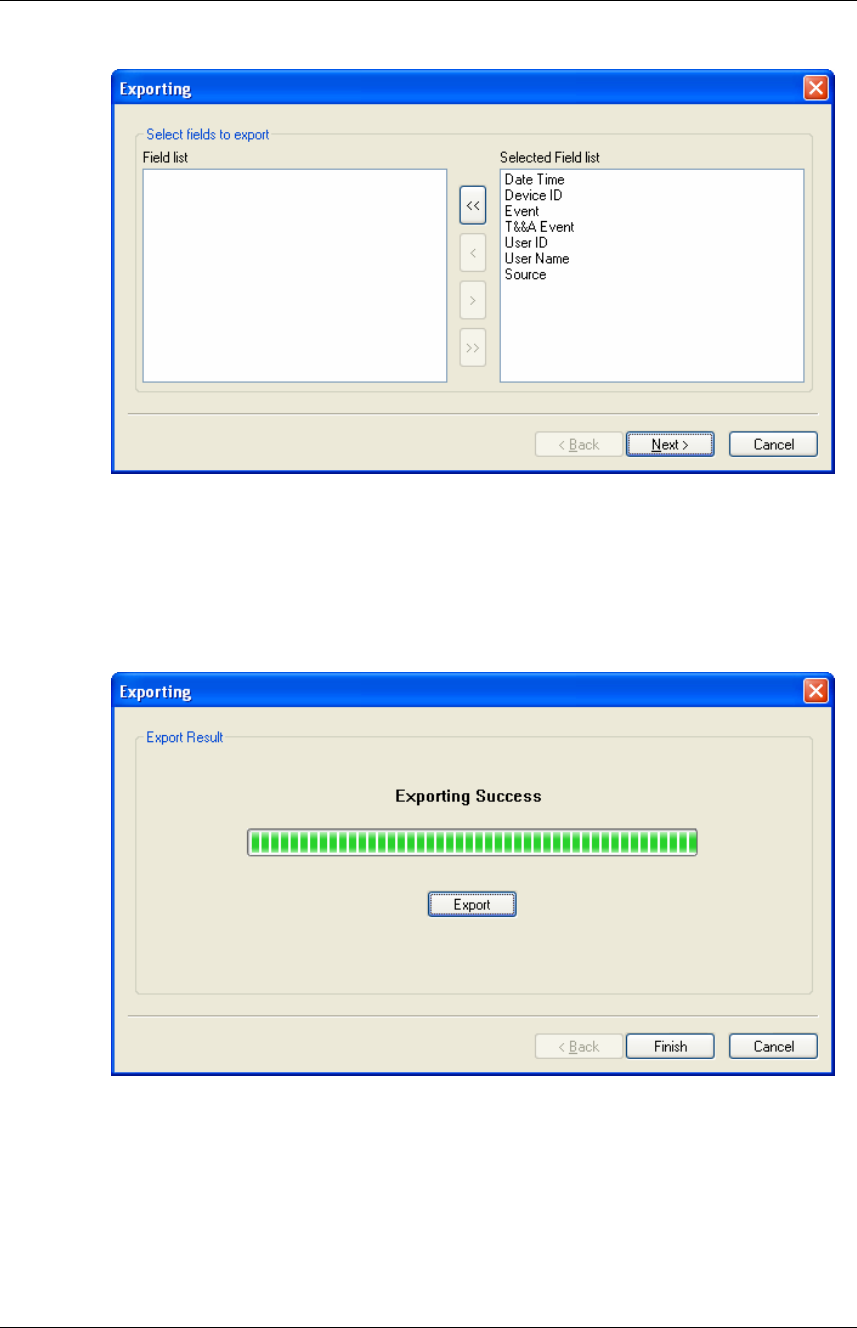
BioAdmin User Manual 219
Copyright © 2006, 2007 by Suprema Inc. http://www.supremainc.com
z After selecting the fields, press the Next button.
z Select a file to export
z After selecting the file, press the Next button.
z Press the Export button.
8.2.6. Delete Log information
The Delete Log Data button eliminates selected log data from log database on
host PC. Log data on BioEntry and BioStation are not removed by this command,
but automatically removed only when the device requires space for additional log
data.
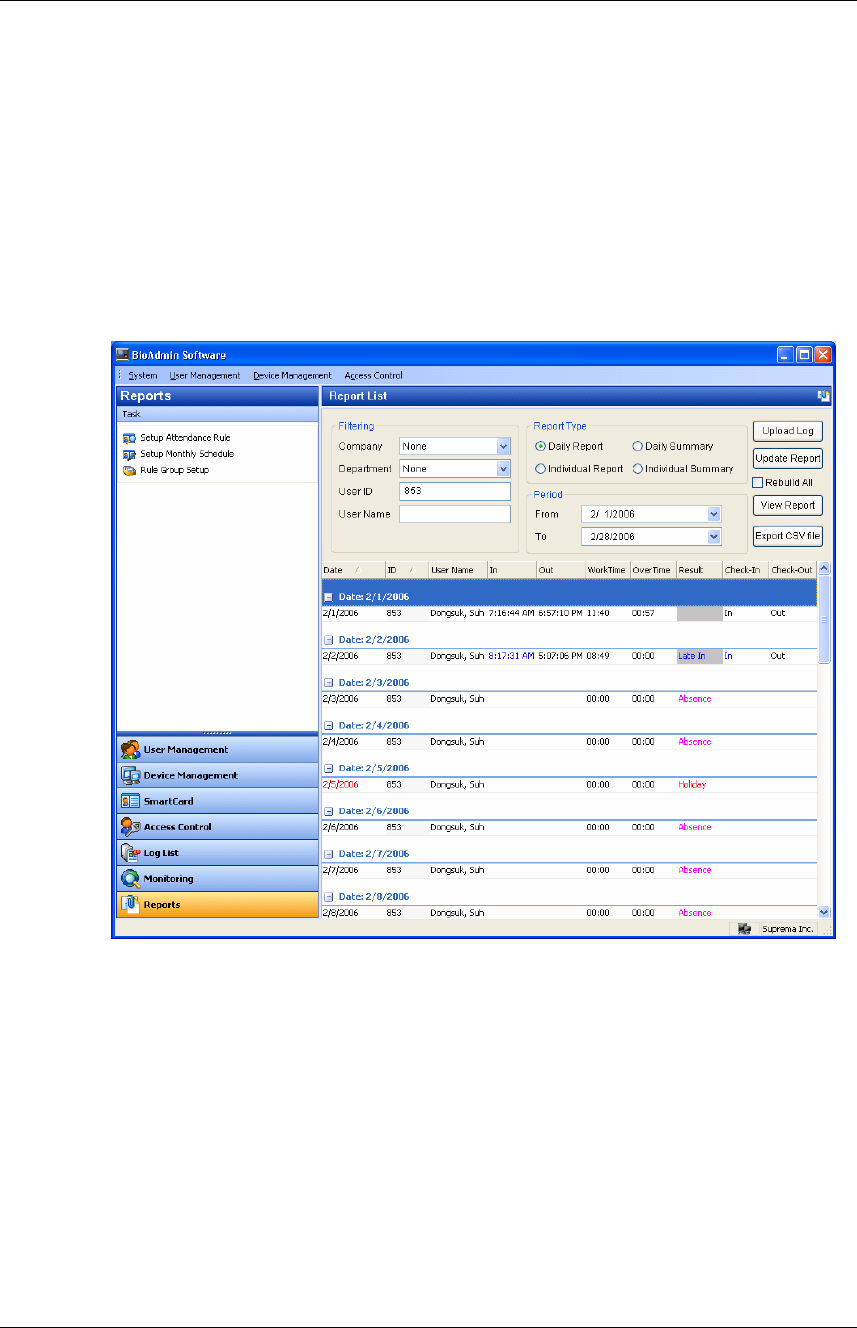
BioAdmin User Manual 220
Copyright © 2006, 2007 by Suprema Inc. http://www.supremainc.com
9. Reports
Repot menu includes the followings operations.
z Set up attendance rule
z Upload log from device and create T&A event report.
z Export a created report to file
z Print created report
9.1. Configuration of reports page
Repot list page consists of 2 elements:
z Repot list page
Repot list shows menus setting filtering, report type, period and basic
information required for creating a report.
z Task box
Task box has buttons to set T&A rule.
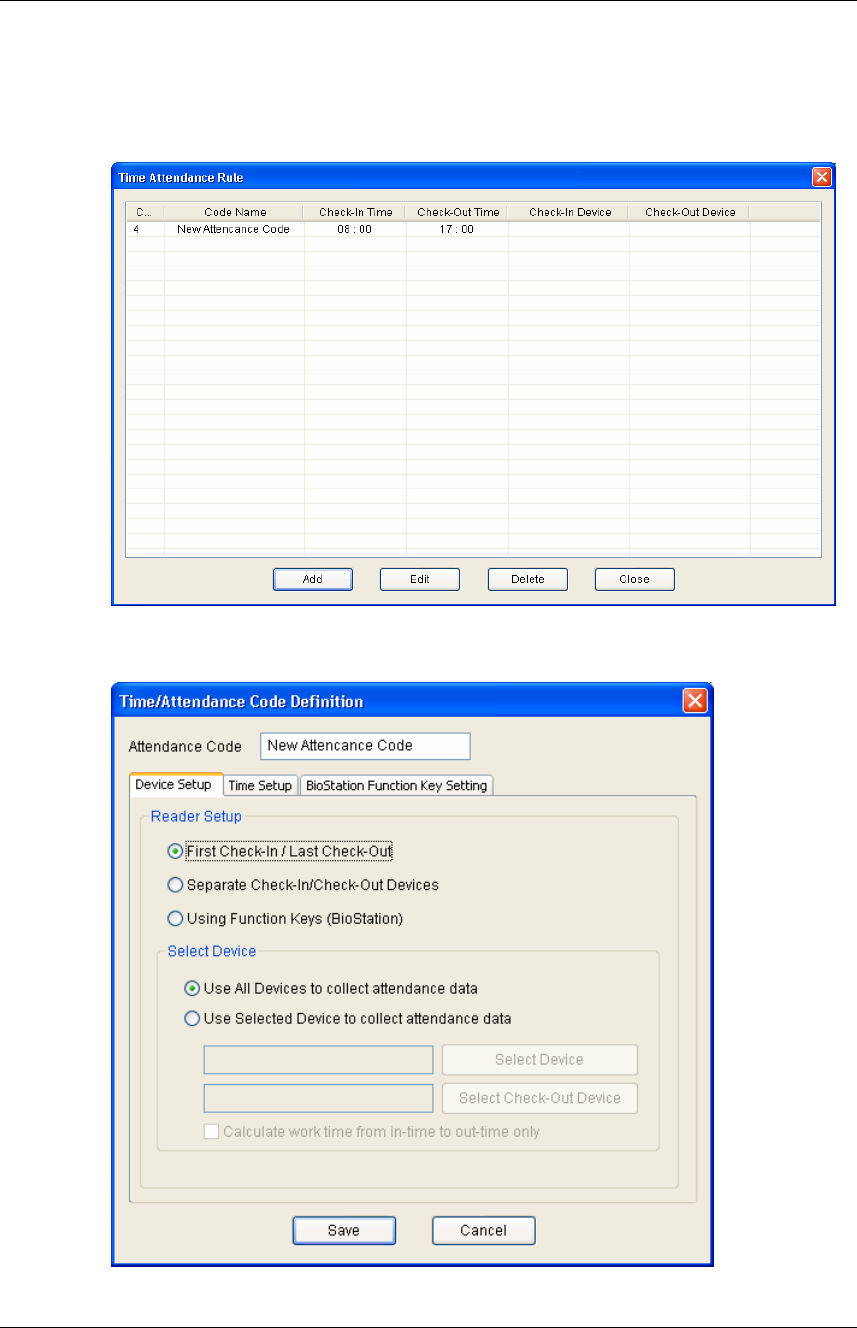
BioAdmin User Manual 221
Copyright © 2006, 2007 by Suprema Inc. http://www.supremainc.com
9.2. Setup attendance rule
z Press setup attendance rule button to set a new T&A rule.
z In case of pressing add button, time attendance rule window appears.
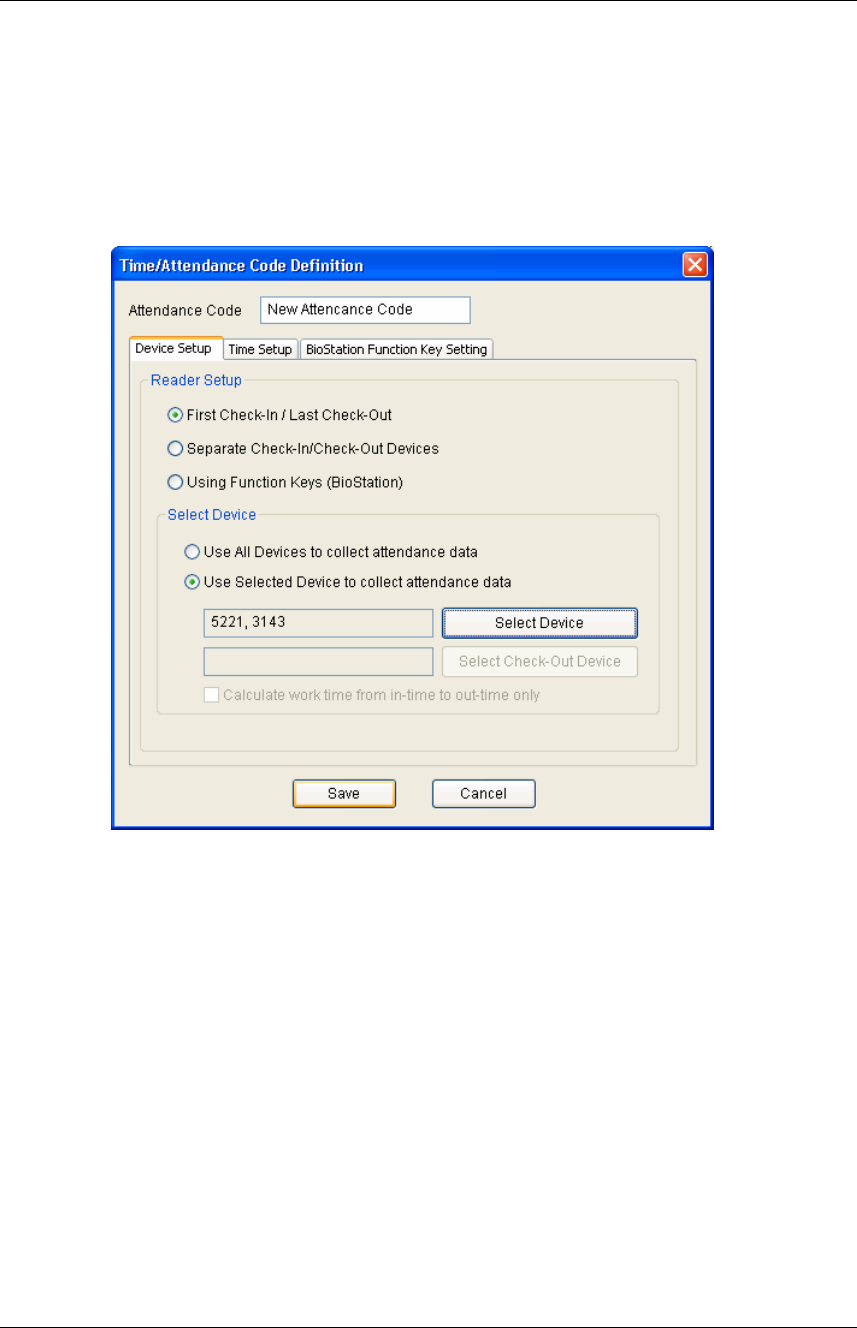
BioAdmin User Manual 222
Copyright © 2006, 2007 by Suprema Inc. http://www.supremainc.com
z Enter attendance code.
9.2.1. Device setup
Select device setup menu on time attendance rule page and set In/Out input
device as below.
z In case of choosing first check-in/last check-out, user applies first authorized
time as check-in and last authorized time as check-out.
z In case of choosing separate check-in/check-out devices, check-in/check-out
devices can be designated separately using select device menu. In that case,
limited to check in device, first time is applied as check-in and limited to check-
out device, last time is applied as check-out. In case user inputs check-in or
check-out for unselected device, log information is indicated as check-in or
check-out but when creating a report, check-in or check-out is not applied.
z Using function keys (BioStation) – In case of choosing using function keys
(BioStation), limited to the cases when T&A key set in BioStation, it is applied to
a report as check-in or check-out. This menu is applied only to BioStation.
Therefore, BioEntry can’t be used as T&A device in this case.
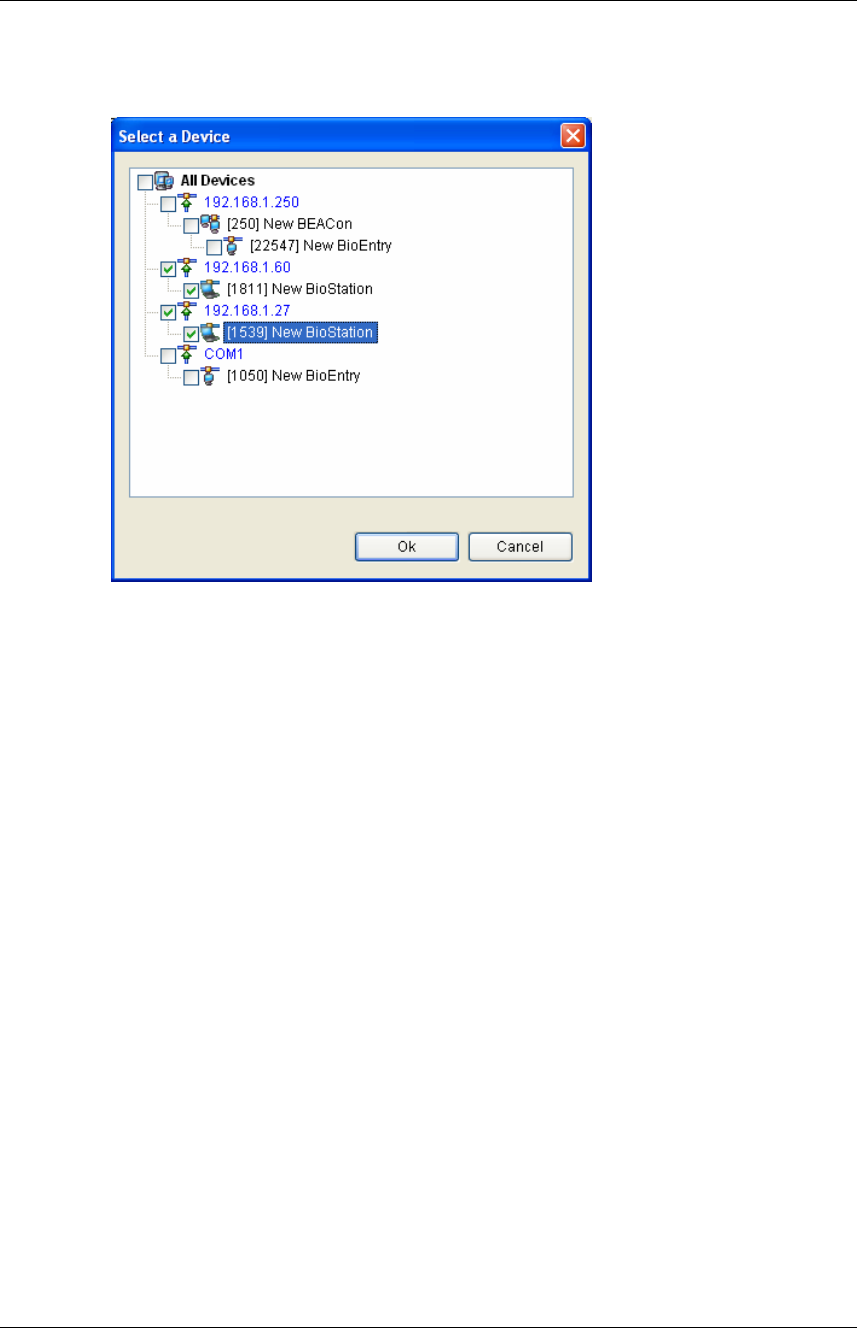
BioAdmin User Manual 223
Copyright © 2006, 2007 by Suprema Inc. http://www.supremainc.com
User can choose a device for T&A use thru select device menu.
z In case of choosing use all devices to collect attendance data, all devices
connected to network are used for T&A device. However, in case of choosing
using function keys (BioStation), BioEntry can’t be used for T&A device.
z In case of choosing use selected device to collect attendance data, only
selected device can be used for T&A device.
9.2.2. Time setup
Select time setup menu on time attendance code definition page and set time
attendance time as follows.
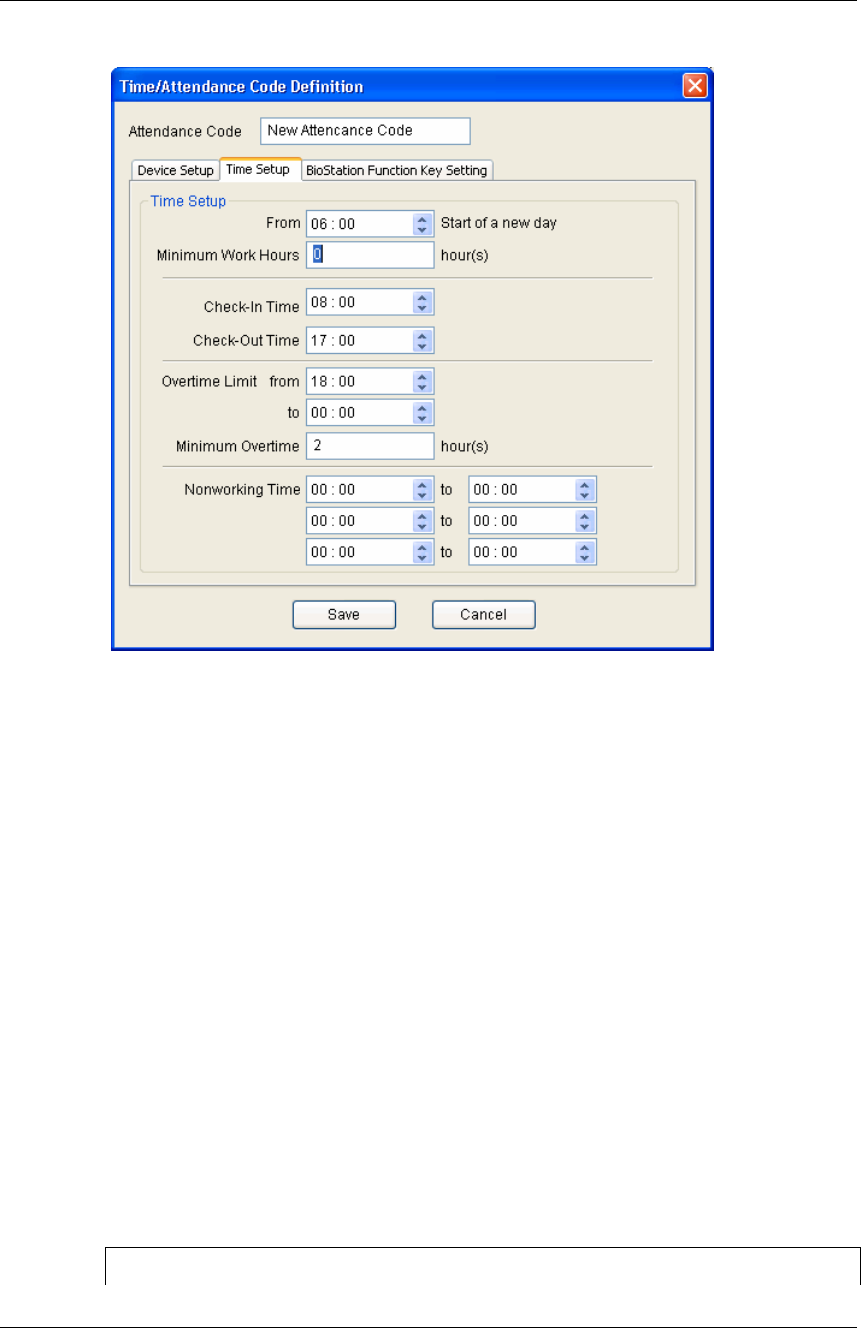
BioAdmin User Manual 224
Copyright © 2006, 2007 by Suprema Inc. http://www.supremainc.com
Detailed setting process is as follows
z Set standard time of work start in from ----- start of a new day
z Set minimum work hrs of applicable day in minimum work hrs. In case work
hrs is less than set minimum work hrs, absence is applied to report. In case of
setting minimum work hrs as 0, this function may not be used.
z Enter check-in time.
z Enter check-out time.
z Enter maximum overtime hours. In case one works overtime more than set
maximum OT hrs, such hrs are not included in report as OT.
z Enter minimum overtime hours. In case of working overtime less than set
minimum overtime hours, such hours are not applied as overtime in report.
z Set up Nonworking Time to exclude certain period of time from work time. This
time will not be included in the working hour on report. You can select up to
three Nonworking Time and see the Nonworking Time by using the drop down
menu.
Note : Drop down menu on Nonworking Time is not to select a certain
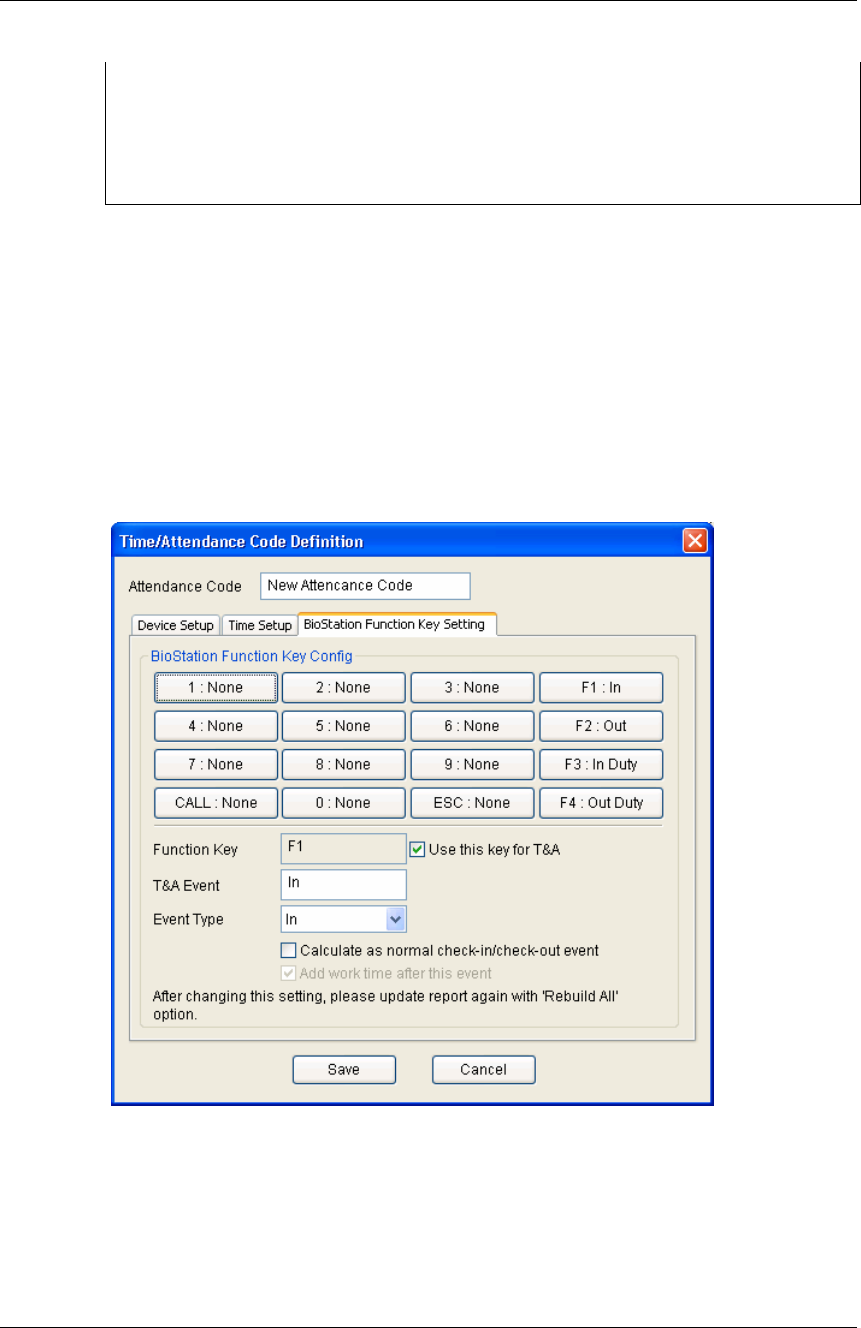
BioAdmin User Manual 225
Copyright © 2006, 2007 by Suprema Inc. http://www.supremainc.com
Nonworking Time among the three Nonworking Times, but to just show the time
setting of the Nonworking Time. Thus, once you set up two or three Nonworking
Times on this menu, all of those Nonworking Times will be excluded from the
working hour on report.
9.2.3. BioStation function key setting
On time attendance code definition page, select BioStation function key setting
menu and set log information and report display as below.
Detailed setting process is as follows:
z Select applicable key.
z In case of using selected key as T&A key, check on Use this key for T&A.
z Input T&A event for selected function key. Upon Monitoring and log check,
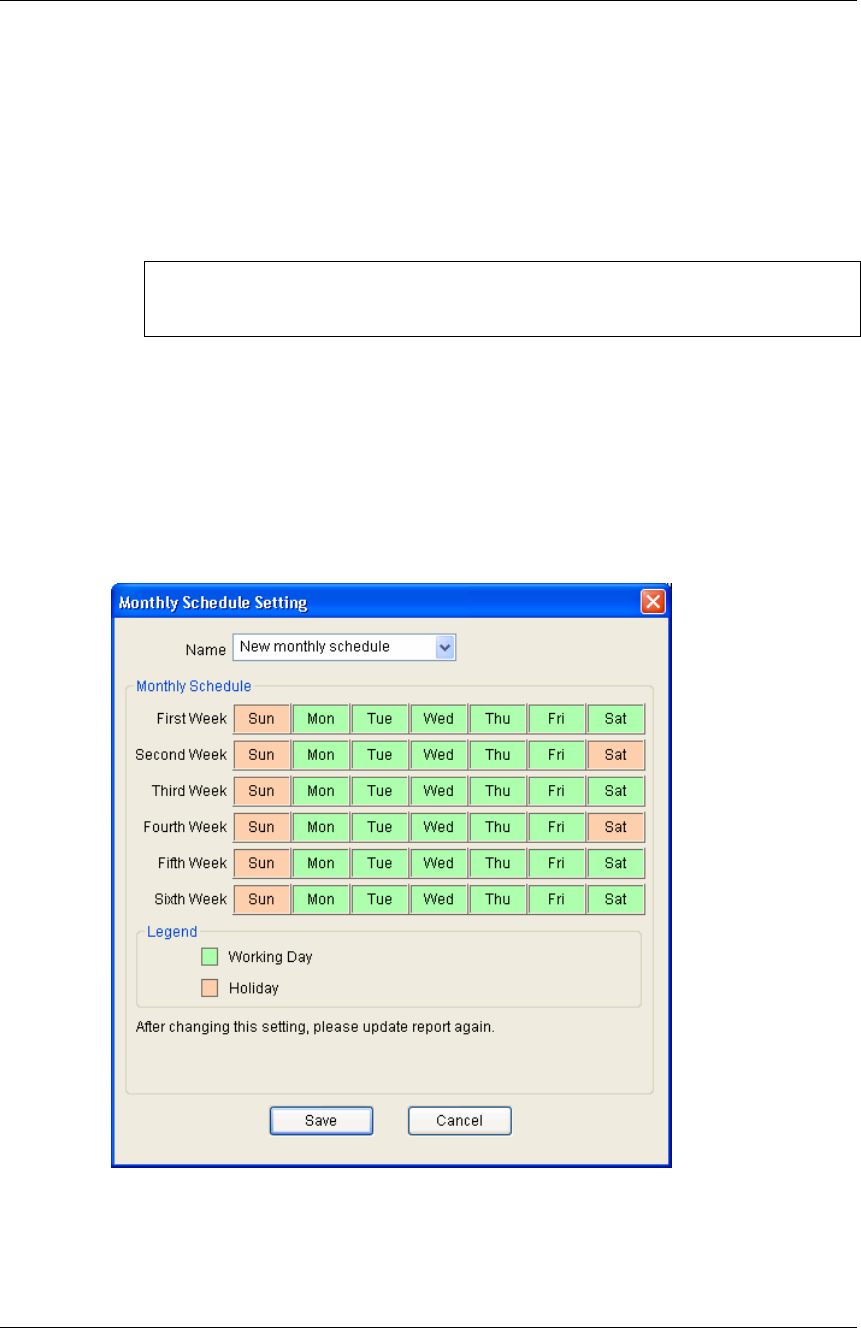
BioAdmin User Manual 226
Copyright © 2006, 2007 by Suprema Inc. http://www.supremainc.com
input in T&A event for applicable key is displayed.
z Select Even Type among Check-In, Check-Out, In, Out. Selected events are
used as basis of T&A result and computation of work hours.
z If you do not want to apply Late-In or Early-Out to a specific key, check on
Calculate as normal check-in/check-out event.
Changes will apply only when report is updated after changing BioStation
function key setting.
9.3. Setup Monthly Schedule
By setting monthly schedule, you can select working day and holiday, which are
used as a basis of T/A report. On holiday, late-in, early-out, absence are not applied.
Work hours on holiday will be added to the holiday work time.
z Press Setup Monthly Schedule button.
z Select Working Day and Holiday and press Save button.
z To apply new monthly schedule to T/A report, check on the ‘Rebuild All’ of the
Report List window and press Update Report button.
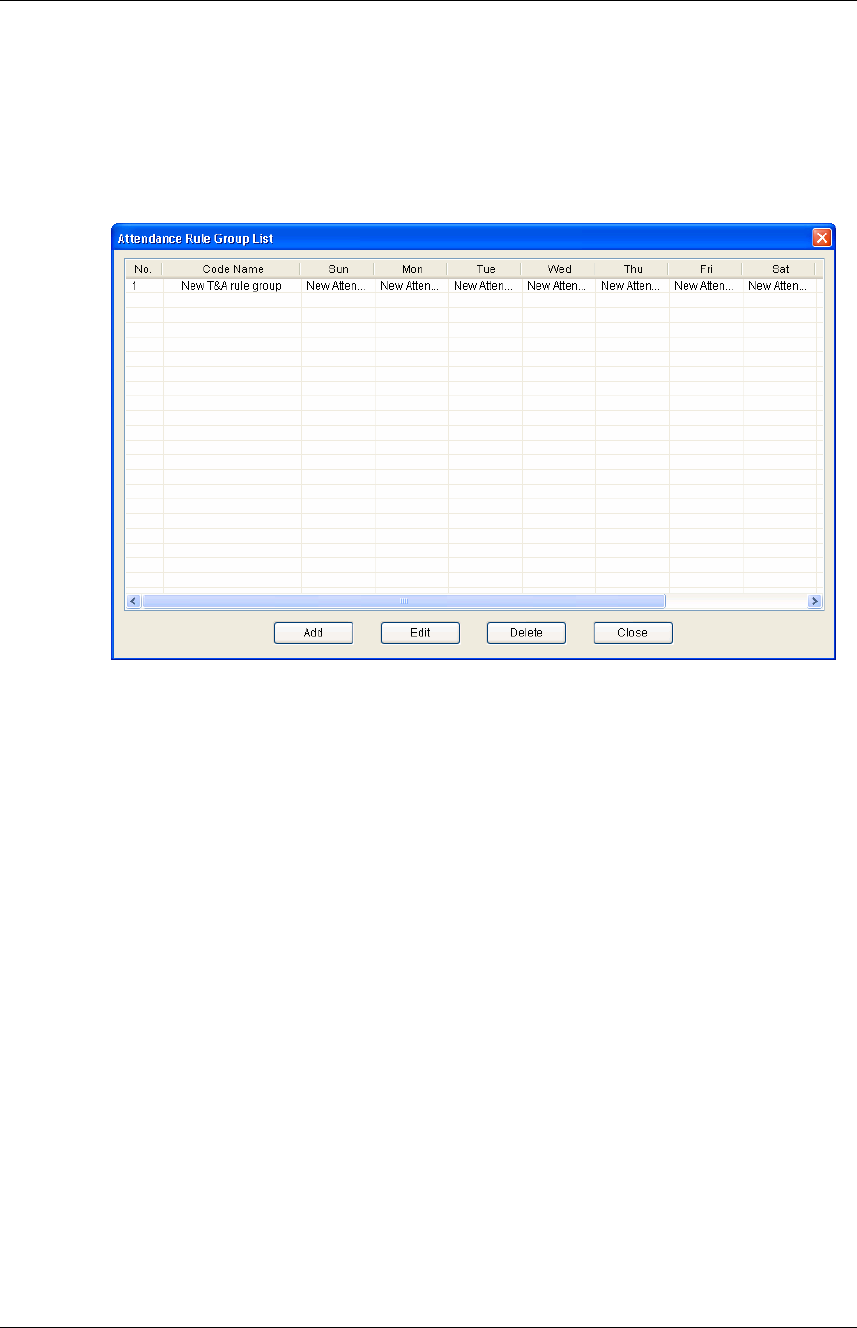
BioAdmin User Manual 227
Copyright © 2006, 2007 by Suprema Inc. http://www.supremainc.com
9.4. Group Configuration for T&A Control
You can make a group for the rules on T&A event control using the above
configuration.
Press “Add” button to generate new rules on T&A group and configure
each specific rule.
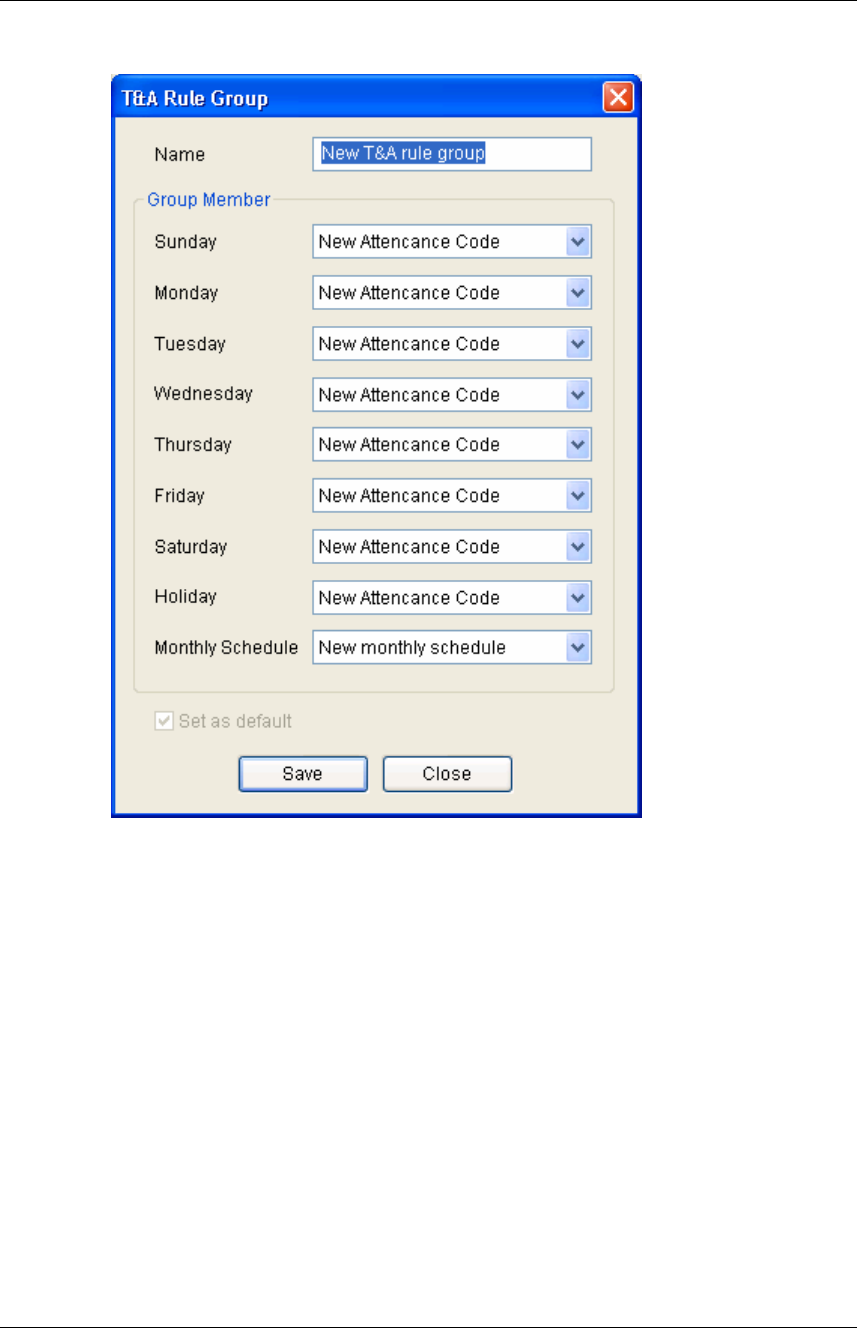
BioAdmin User Manual 228
Copyright © 2006, 2007 by Suprema Inc. http://www.supremainc.com
9.4.1. Use as default
By checking on set as default, apply selected T&A rule as basic rule. In case
T&A rule is not set for certain users, basic rule applies to such users.
9.5. How to prepare report
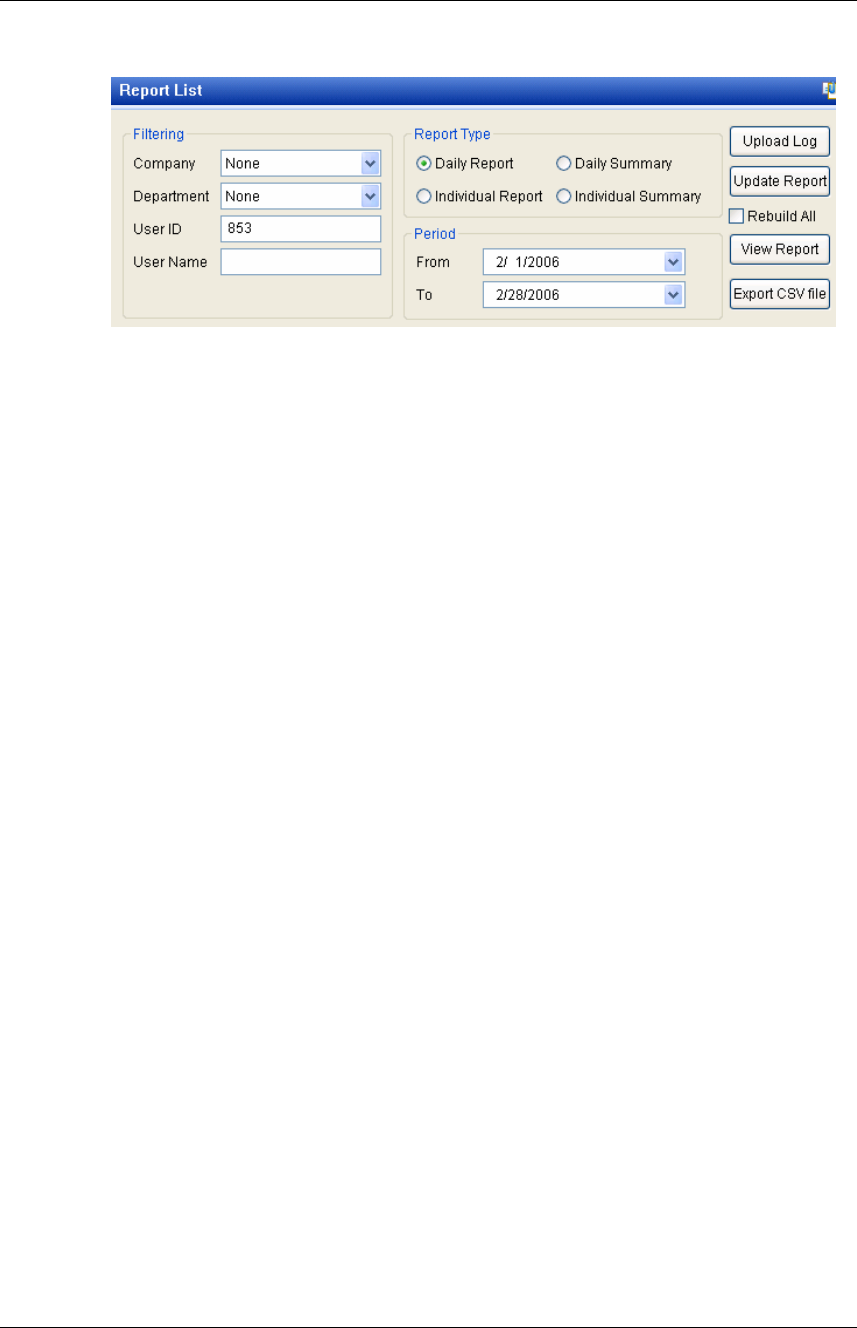
BioAdmin User Manual 229
Copyright © 2006, 2007 by Suprema Inc. http://www.supremainc.com
z Press upload log and import the latest log information. This process is to
create a report based on the latest event logs, so even after completing upload
log, log is not displayed on report list.
z Select company, dept. and user on setting (filtering) menu to creating a report.
z Choose either daily report or individual report on type menu.
z Choose start date and finish date of report on period menu.
z Press update report button.
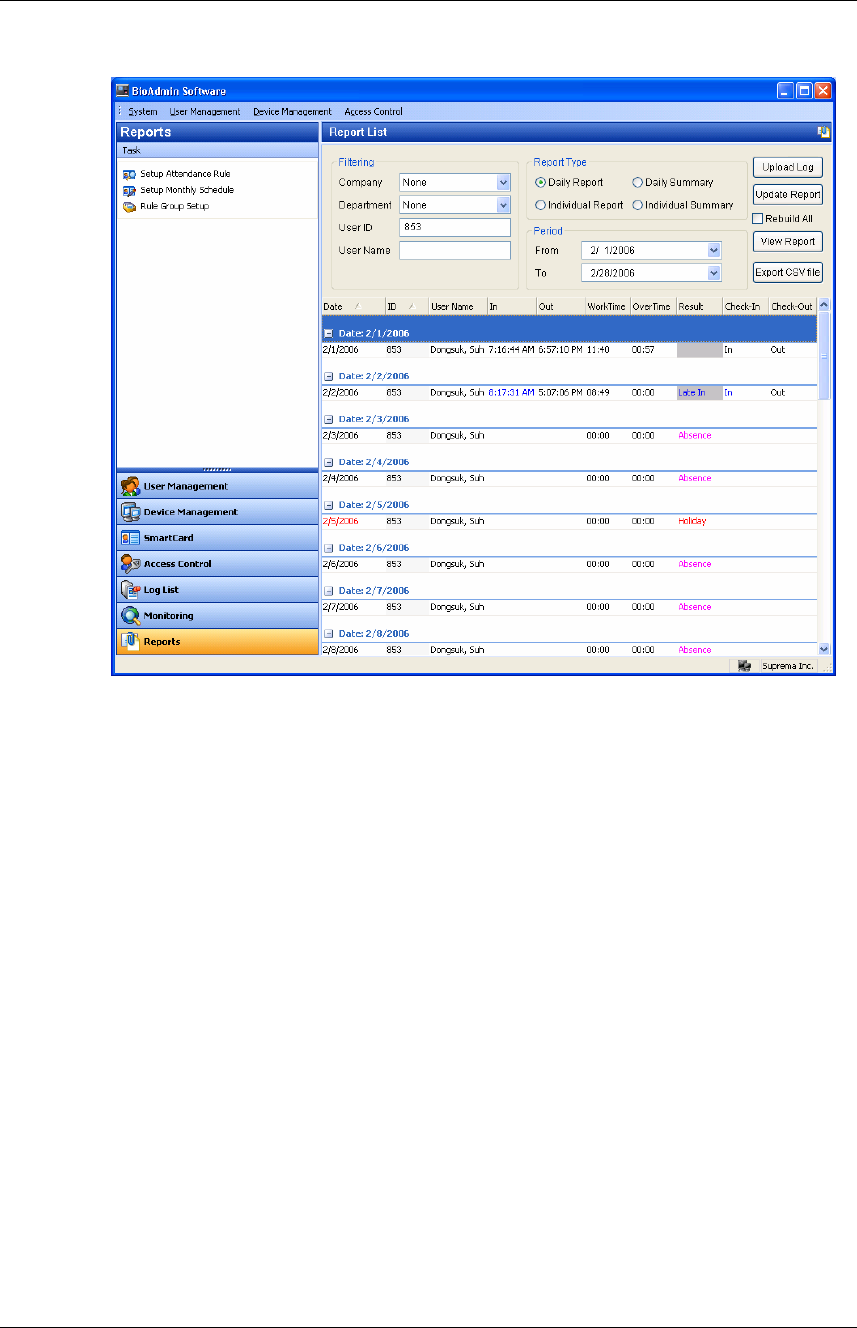
BioAdmin User Manual 230
Copyright © 2006, 2007 by Suprema Inc. http://www.supremainc.com
z Press view report button.
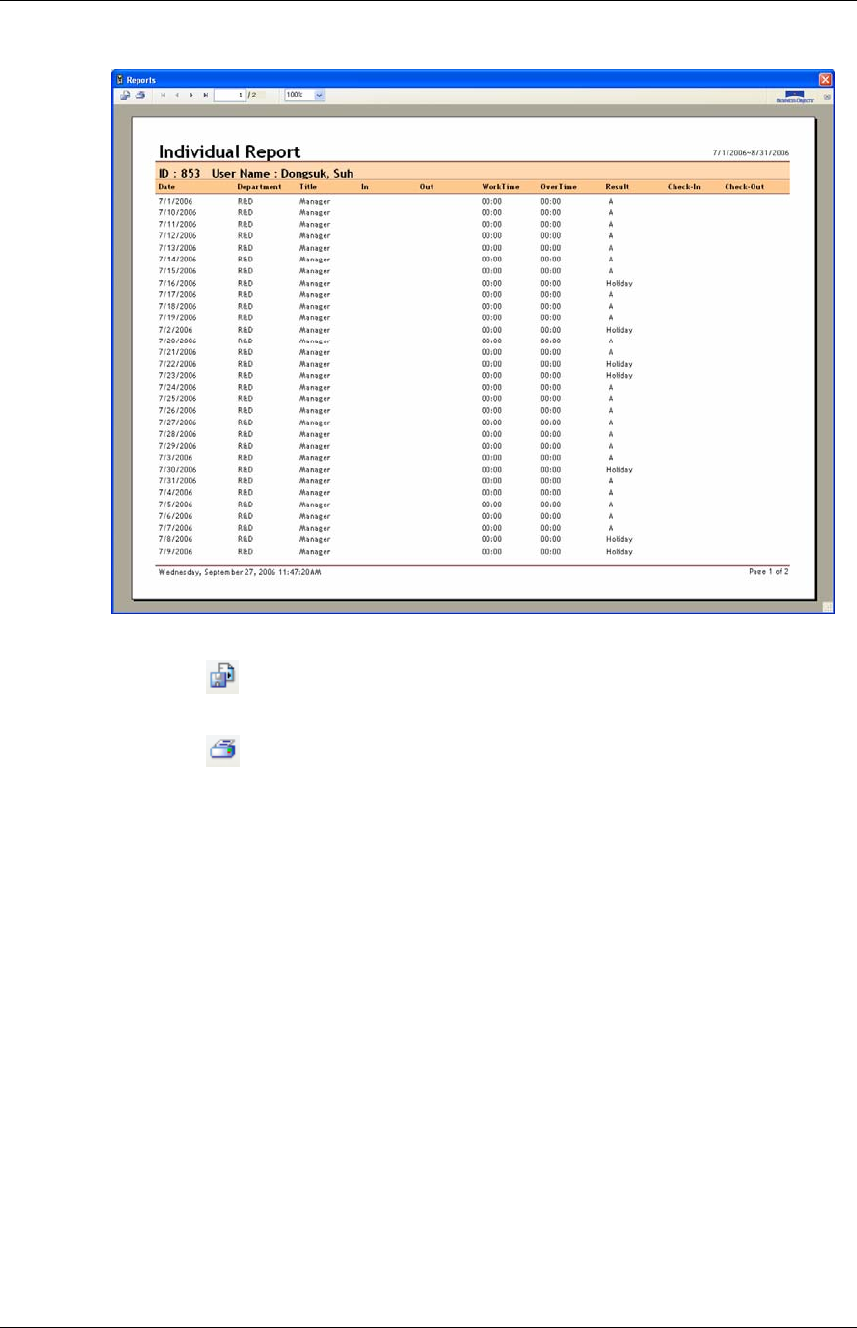
BioAdmin User Manual 231
Copyright © 2006, 2007 by Suprema Inc. http://www.supremainc.com
z Press to save a file in varying formats.
z Press to print out the report.
9.6. Edit Data
If necessary, administrator can add or correct user’s T/A data.
z If you double click a specific T/A data on daily report or individual report, Edit
Data window will be initiated.
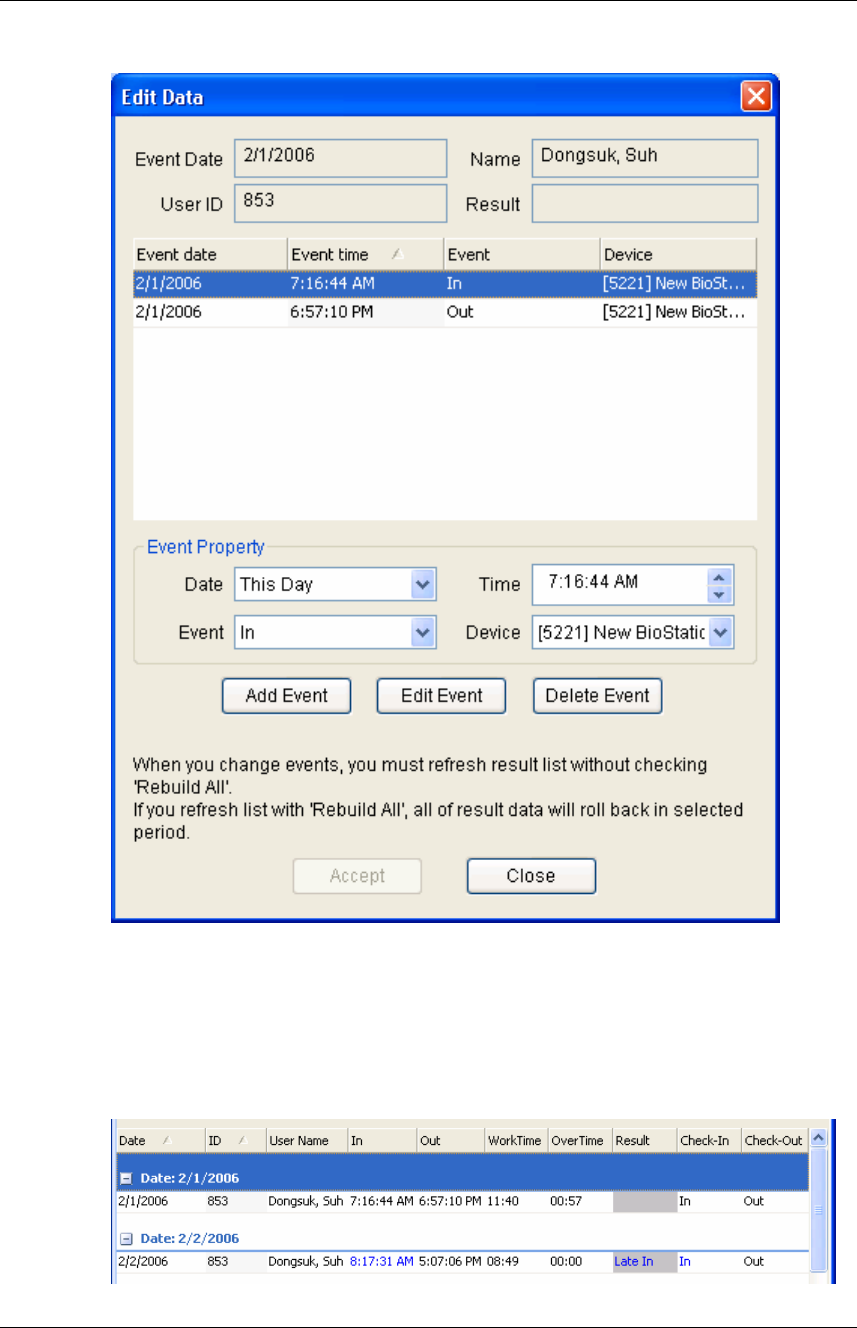
BioAdmin User Manual 232
Copyright © 2006, 2007 by Suprema Inc. http://www.supremainc.com
z Enter desired event values on the Event Property box and press Add Event
or Edit Event button.
z Press Accept button to apply the corrected data to T/A report.
z The changed events are displayed as “Result” field in grey color.
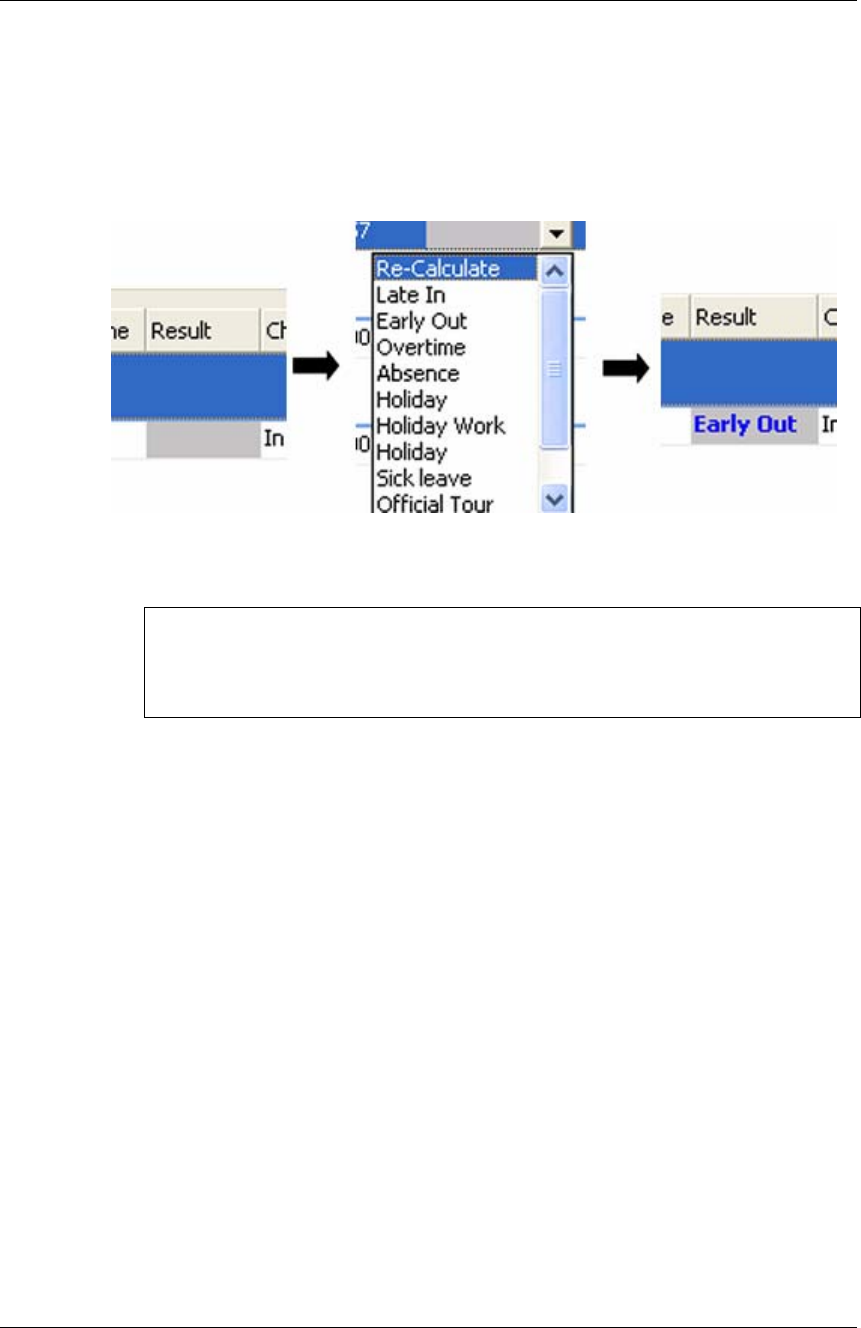
BioAdmin User Manual 233
Copyright © 2006, 2007 by Suprema Inc. http://www.supremainc.com
z The result can be modified at the report. By clicking “Result” of the report, the list
to select displaying result will be shown as above figure, which is appeared on
bold strokes and verified the changes easily.
Note : After correcting report data, you should press Update Report button
without checking on ‘Rebuild All’. If you check on ‘Rebuild All’, T/A data will
return to the original data before such correction.
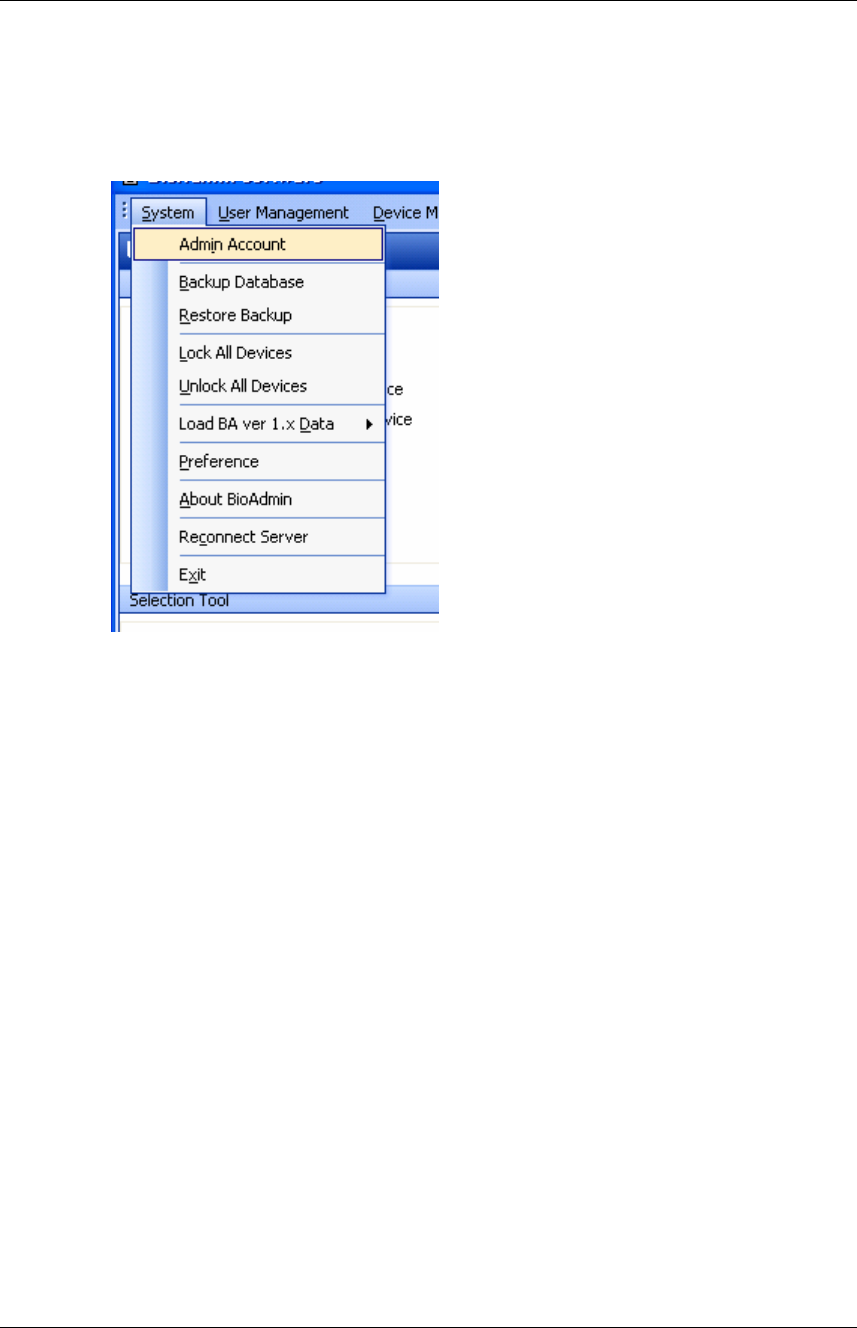
BioAdmin User Manual 234
Copyright © 2006, 2007 by Suprema Inc. http://www.supremainc.com
10. Menu bar functions
10.1. System
10.1.1. Manage admin account
Add administrator to log in the BioAdmin or change password / user level of an
existing administrator.
10.1.2. Data backup
Make manual backup file as well as auto backup file on the option menu. Backup
file is saved as date-serial number format at the server installed a path.
10.1.3. Data recovery
After BioAdmin software modified to server/client type, data recovery is possible to
copy backup file to server installed PC.
To recover a data, previously created backup file should be existed. By coping the
file in the created folder as data-serial number type at the server installed path, all
data can be restored as original backup status. All administrator & user information,
rules, and log history are restored at the corresponding point, but data after
restoration will be disappeared.
10.1.4. Lock all devices
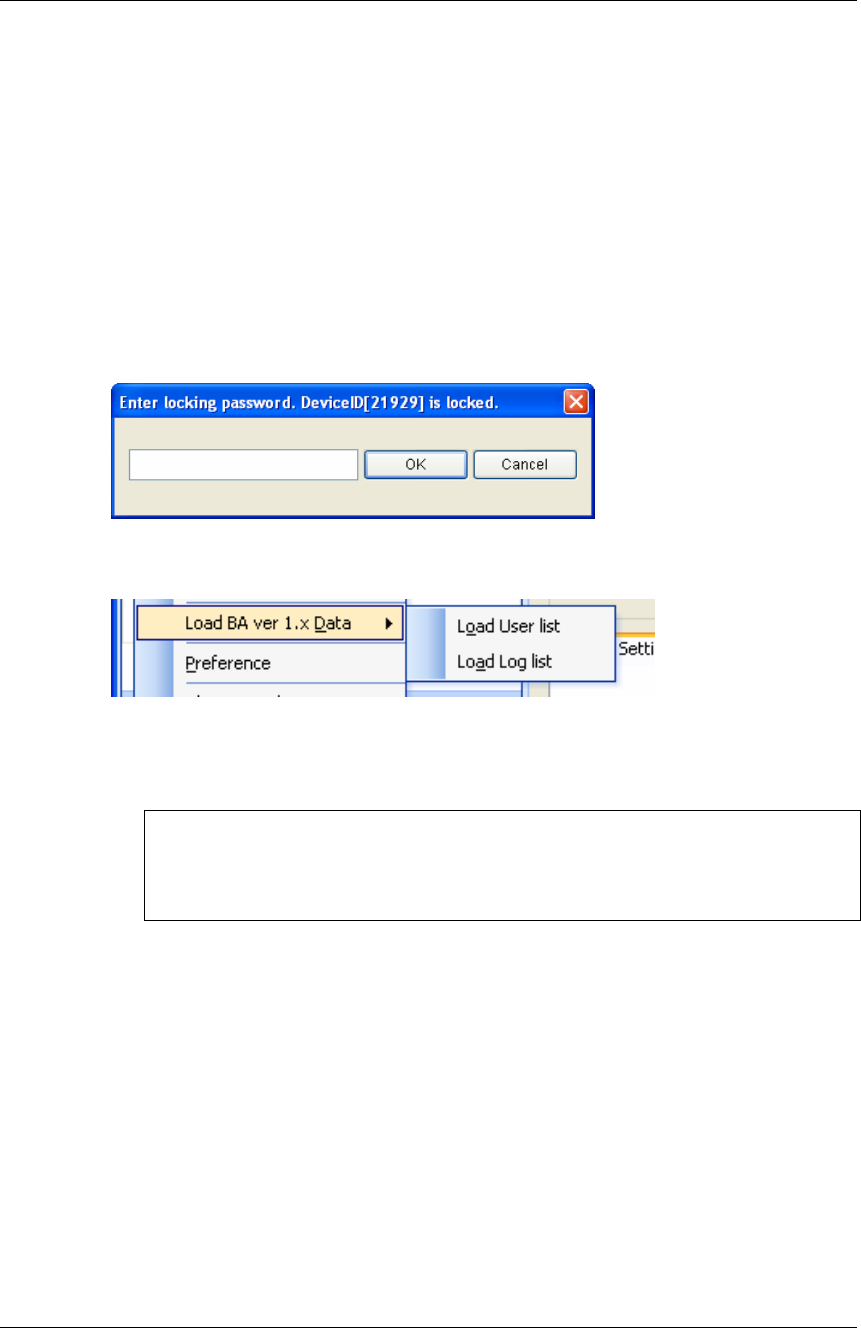
BioAdmin User Manual 235
Copyright © 2006, 2007 by Suprema Inc. http://www.supremainc.com
Lock/unlock linked all BioEntry and BioStation while using BioAdmin software. If
administrator clicks lock all devices menu, all linked BioEntry and BioStation are
locked and once locked, they don’t react to any external packet except unlock
command. In case of BioStation connected to the server, lock device does not
support.
10.1.5. Unlock all devices
By clicking ‘unlock all devices’ menu, user can unlock all locked BioEntry and
BioStation. If lock password has been set, user needs to enter password to unlock.
10.1.6. Load BioAdmin 1.X data
z Click Load BioAdmin 1.X data menu to import previous user data and log data
generated while using BioAdmin software version 1.
Note : This menu can be used at a time of first execution of BioAdmin software
version 3.0 only. It is because data is created anew after deleting existing data
when importing previous data running this menu.
10.1.7. Preferences
Preferences menu supports the following functions.
z Device Time Setting
z Automatic Locking
z Backup Options
z Security Option
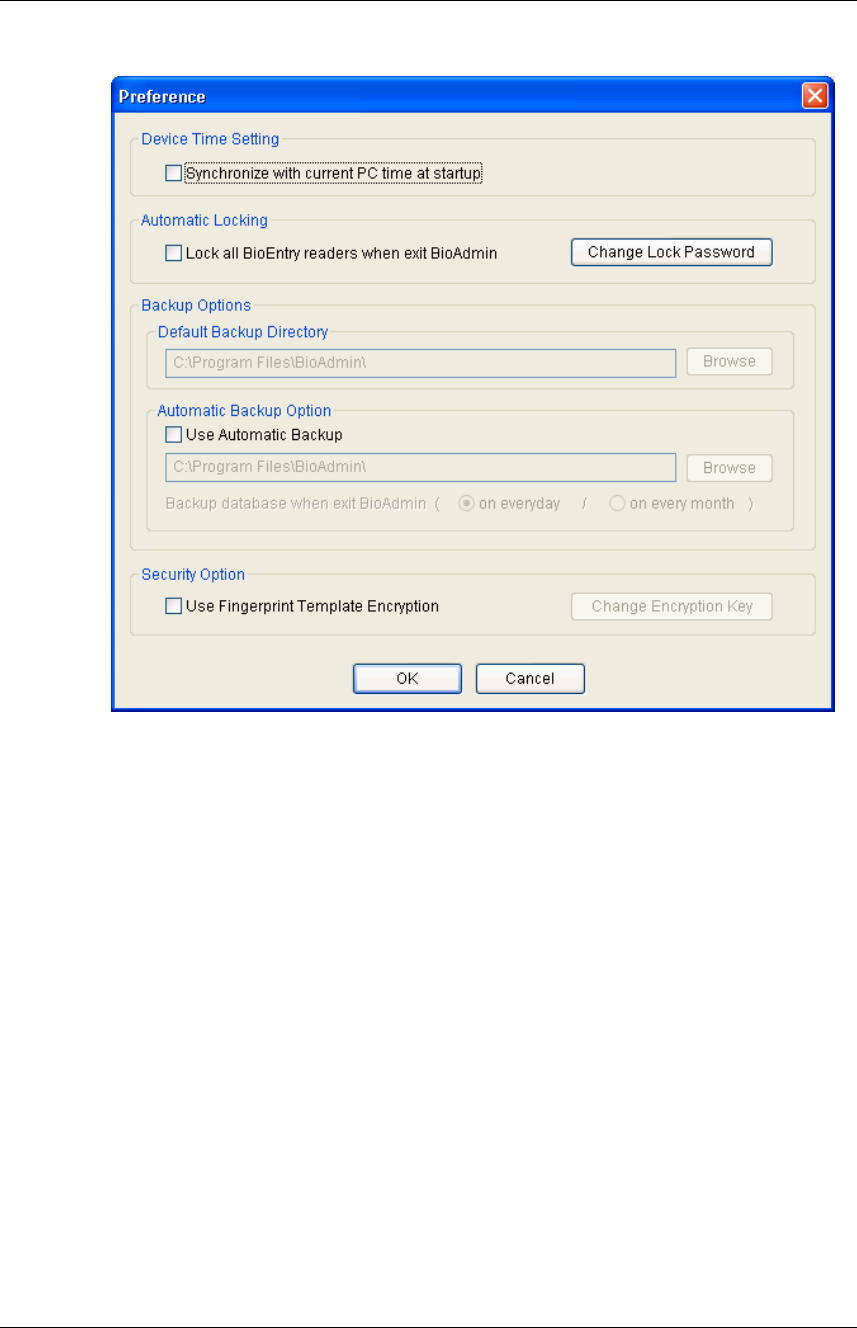
BioAdmin User Manual 236
Copyright © 2006, 2007 by Suprema Inc. http://www.supremainc.com
z Device Time Setting
By checking synchronize with current PC time at startup on preference
window, administrator can set time of linked all devices by host PC time.
z Automatic Locking
BioEntry and BioStation can be locked by password to enhance the security. If
the locked BioEntry or BioStation is found on the network, BioAdmin software
requests to enter password to unlock BioEntry and BioStation. Locking
mechanism is enabled by the Lock all BioEntry devices on exit check box in
this window or the Lock All Devices menu below the System menu in
Command menu bar. If it is enabled, BioAdmin software locks the devices at
termination of the program. The Change Lock Password button initiates the
password management window.
Lock password of BioEntry and BioStation can be changed by pressing
change button and entering old and new password.
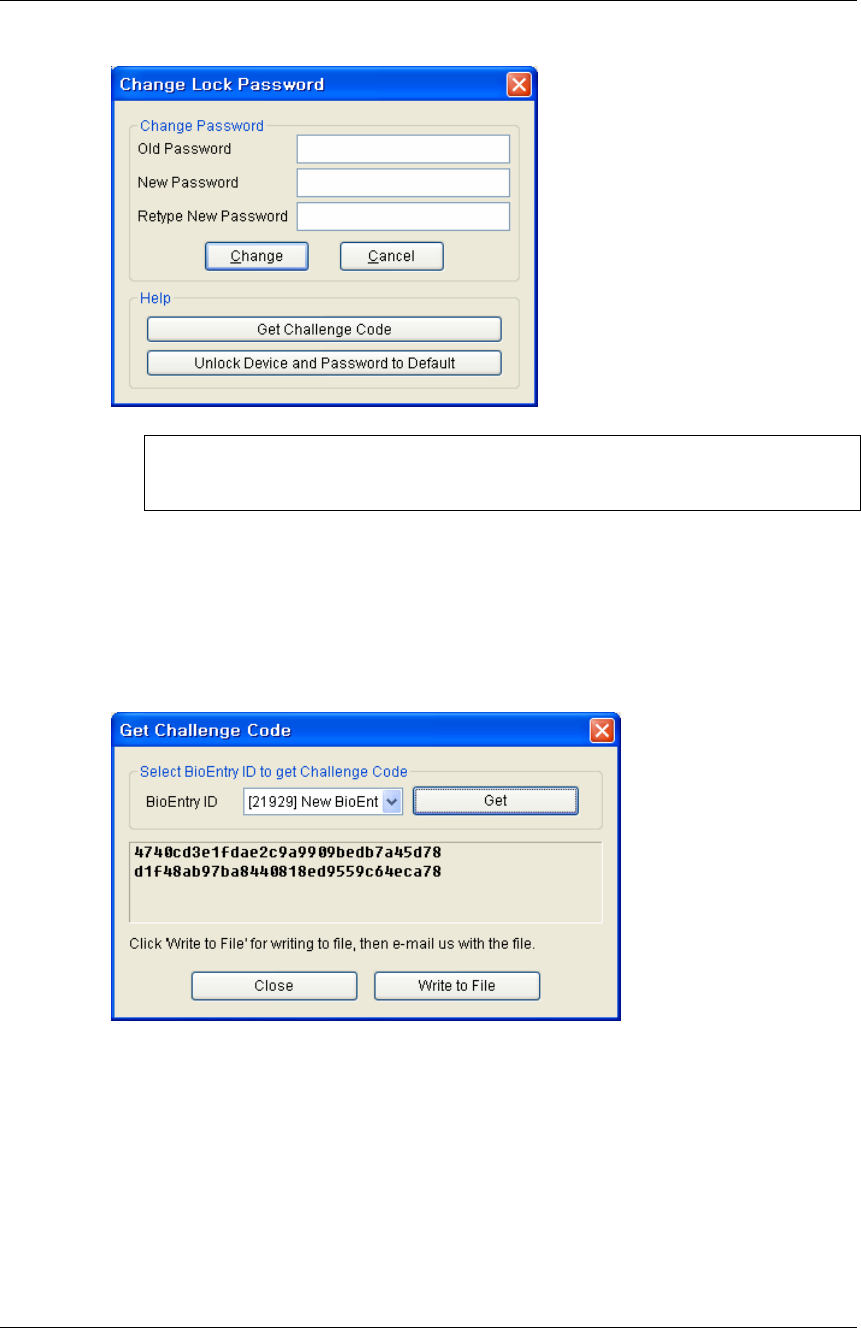
BioAdmin User Manual 237
Copyright © 2006, 2007 by Suprema Inc. http://www.supremainc.com
Note : As BioAdmin software doesn’t save lock password, administrator
should remember the password when using lock mechanism.
Resolving the locked devices. If the devices are locked but cannot be
unlocked in case of forgetting password, the following procedures are
required. Obtain a challenge code file using the Get Challenge Code
button and send the file to technical support team
( support@supremainc.com )
z The support team will send you the unlock code file corresponding to the
challenge code. Use Unlock a BioEntry and Password to the Default button
to resolve the device. Then, the device is unlocked and password is changed to
default (null).
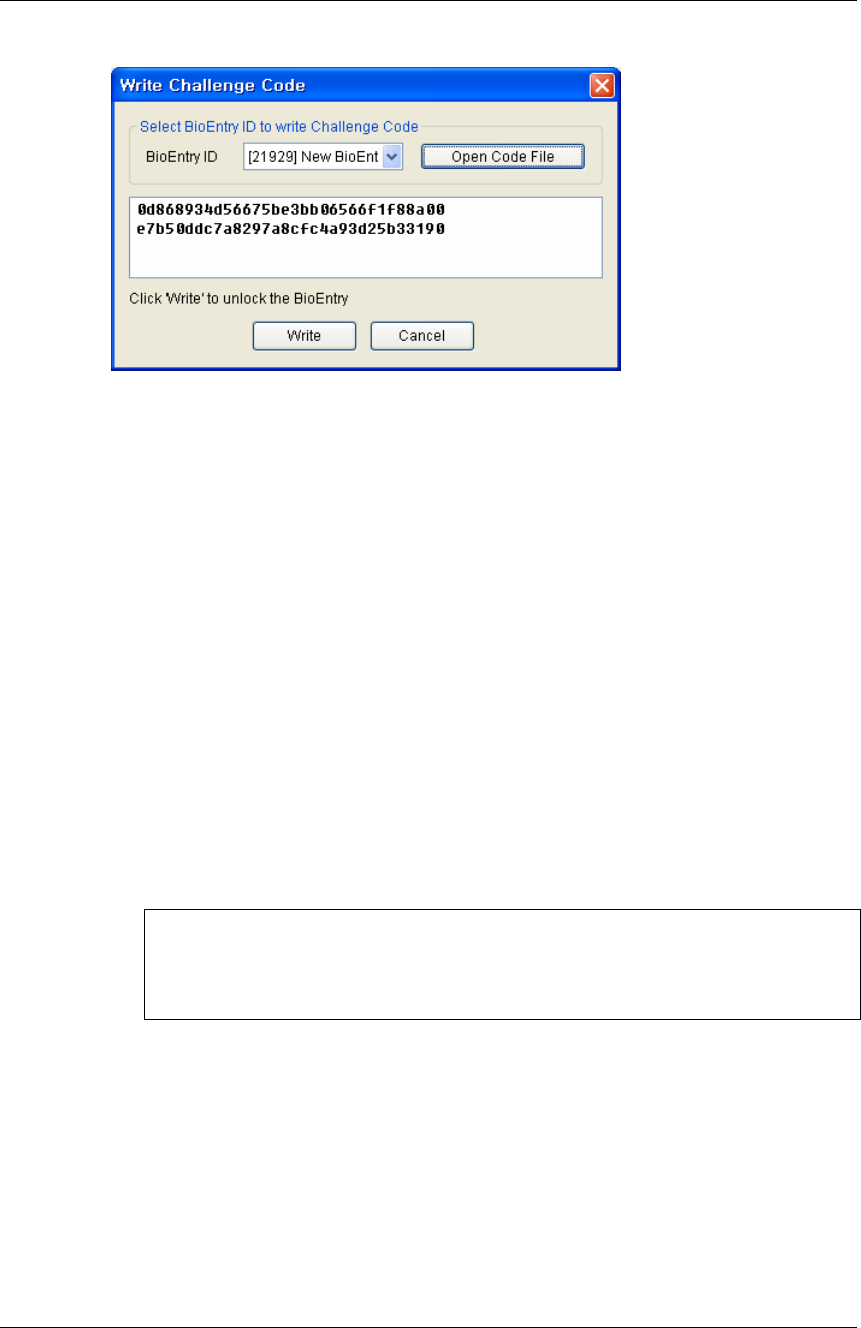
BioAdmin User Manual 238
Copyright © 2006, 2007 by Suprema Inc. http://www.supremainc.com
z Backup Options
Default backup directory: Default backup directory for database can be
specified on the preference page. Related backup files will be stored on the
specified directories. In case of BioAdmin Software v4.0 above, this option
cannot create a backup path, but backup file at the server installed path.
Automatic Backup Option: By checking on the Use Automatic Backup
check box, you can automatically save the backup database whenever you
close the BioAdmin software. In case of BioAdmin Software v4.0 above,
the backup file is created at the server installed path, which is similar to
manual backup.
You can select the period of the automatic backup between everyday and
every month. This automatic backup replaces the old database with the
new database at the termination of BioAdmin software.
Note : automatic backup option saves data on the basis of closing BioAdmin
software. Thus, in case of not running BioAdmin or not closing BioAdmin after
running, data is not saved.
z Security Option
Security option is used to encrypting fingerprint template data which is used
between host PC and BioStation. By encrypting the template data, you can
enhance the security level of of the system.
Security option should be used only when there is no fingerprint data on the
BioStation. Otherwise, BioAdmin will remove all fingerprint templates on the
BioStation.
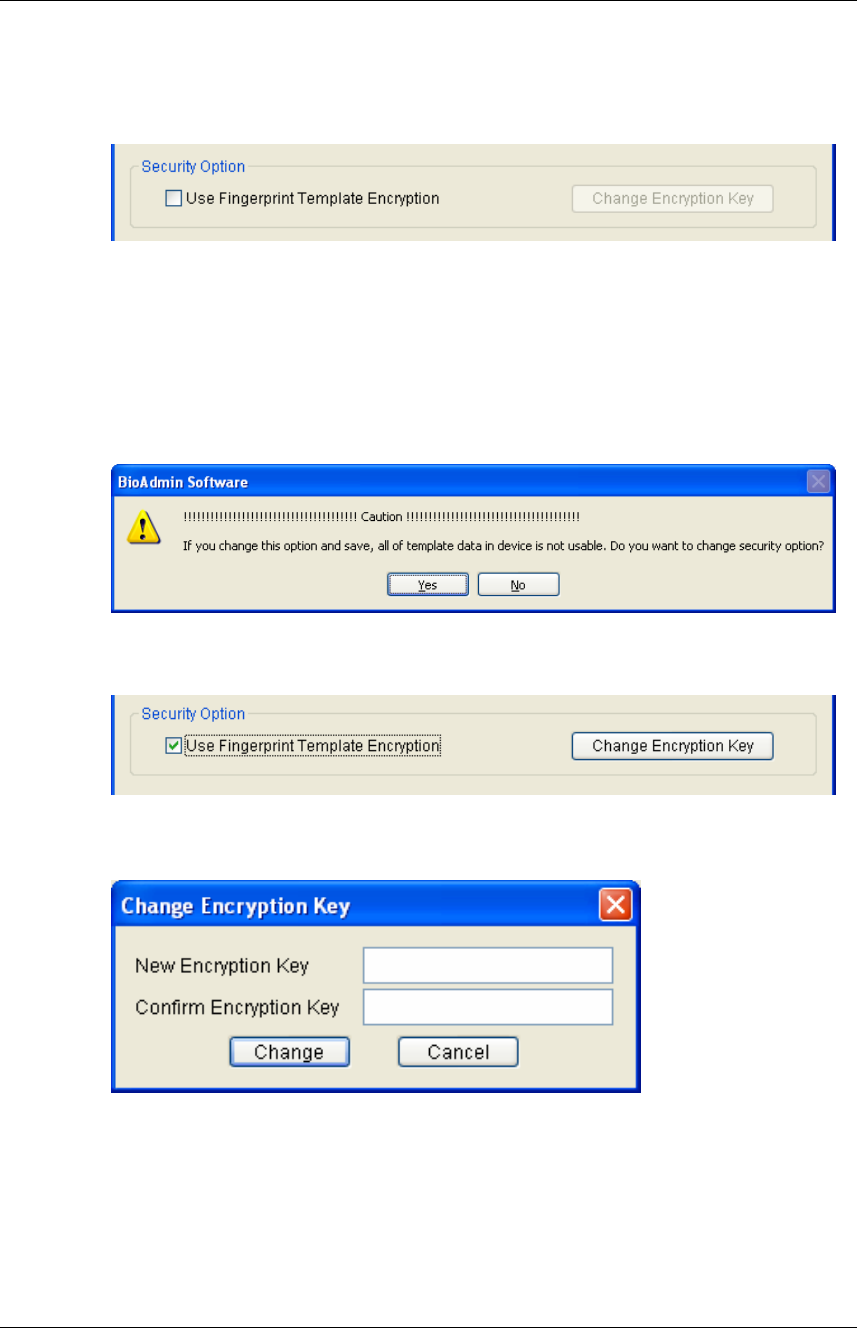
BioAdmin User Manual 239
Copyright © 2006, 2007 by Suprema Inc. http://www.supremainc.com
Check on the Use Fingerprint Template Encryption.
If you select the encryption option, a warning message will appear. If you
want to continue the encryption, press Yes button.
Press Change Encryption Key button.
Enter Encryption Key.
Press Change button in Change Encryption Key window.
Press OK button in Preference window.
If you press Cancel button in Preference window or if the data encryption
is interrupted by a network error, system will return to its earlier status
before encryption.
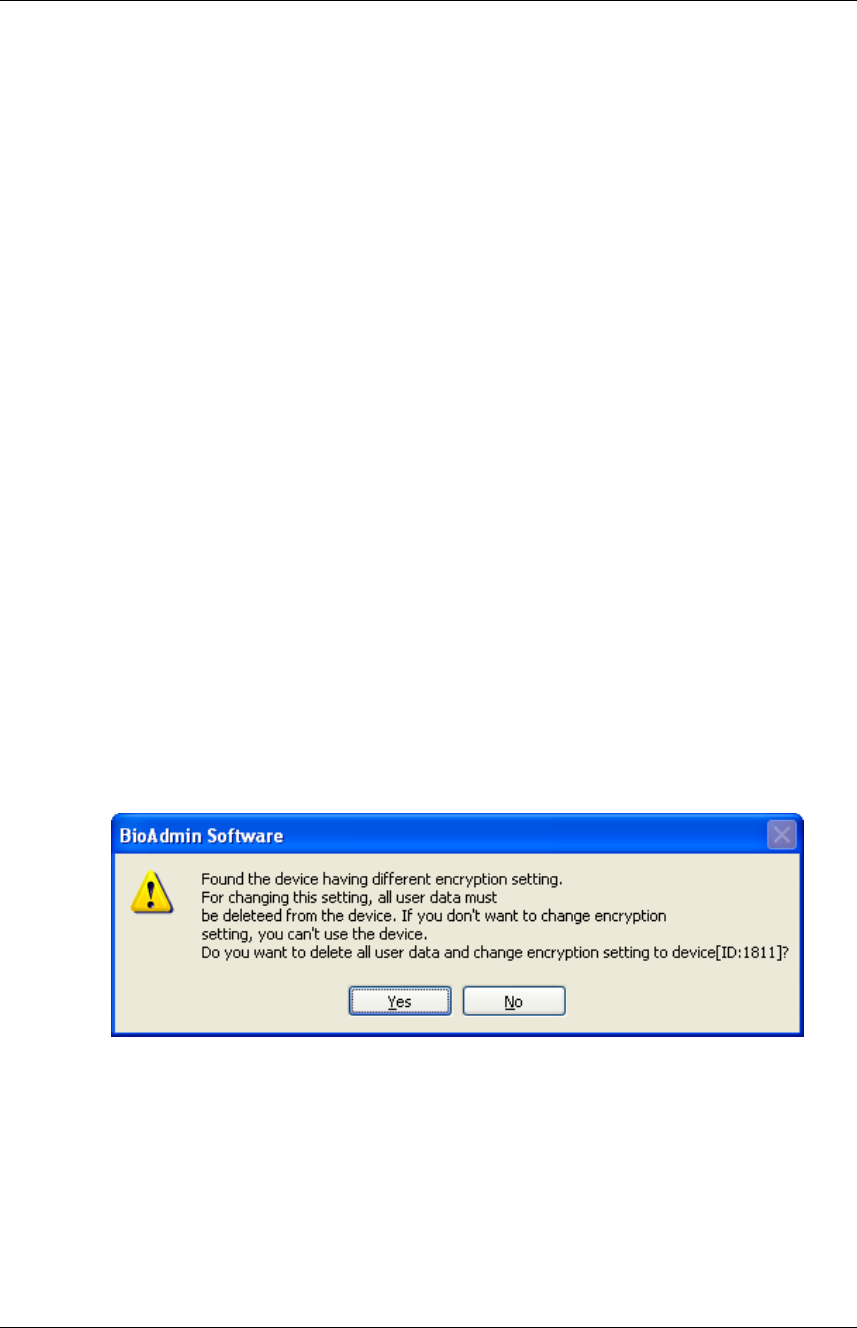
BioAdmin User Manual 240
Copyright © 2006, 2007 by Suprema Inc. http://www.supremainc.com
Whenever you change the encryption key, you need to apply the new
encryption key for each of the connected BioStation. Also, you need to do
so whenever you add a new BioStation to the network. Because encryption
process will remove the existing user’s templates on BioStation, you need
to transfer the user’s templates to the BioStation after finishing the
encryption.
When you use the encryption function, It is highly recommended to change
the encryption key.
Encryption key should be less than 31 digits.
If the encryption is interrupted by a network error or by power failure, restart
the BioAdmin program. Then, BioAdmin will automatically transfer the
encryption setting to the remaining BioStation devices.
You should be very careful in using the encryption function. If you are set
different encryption key among BioStation devices, you may not be able to
use the user’s template compatibly among those devices.
If the encryption key on host PC is different from that of BioStation, or if only
either of host PC and BioStation is using the encryption option, following
warning message will appear whenever such device is found on the
network. If you press No, such BioStation devices will be disconnected
from the network.
10.1.8. BioAdmin information
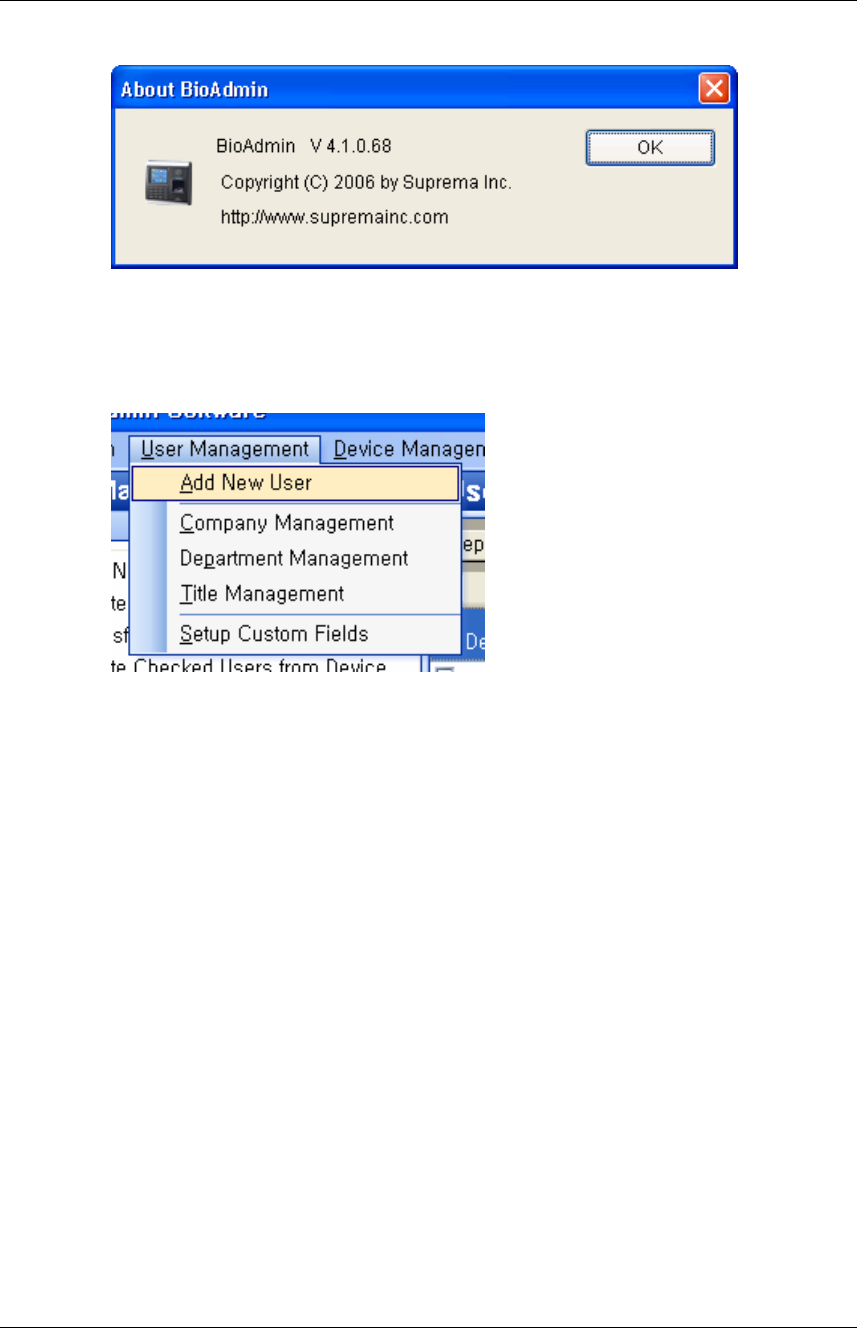
BioAdmin User Manual 241
Copyright © 2006, 2007 by Suprema Inc. http://www.supremainc.com
About BioAdmin on menu bar represents information on BioAdmin in use.
10.2. User Management
User management menu on menu bar supports following functions.
z Add New User
z Company Management
z Department Management
z Title Management
z Setup Custom Fields
For detailed setting, refer to ‘chapter 5, user management’
10.3. Device Management
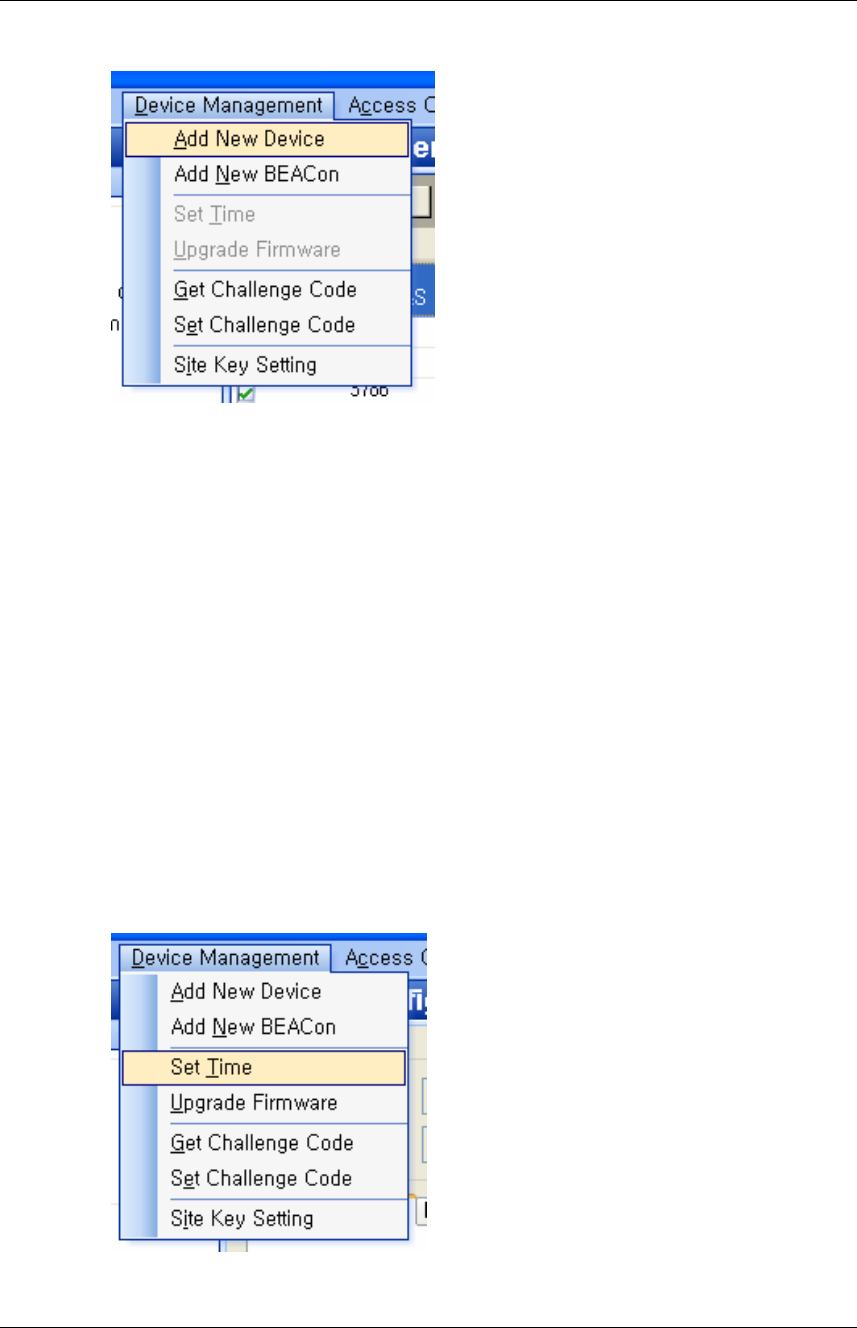
BioAdmin User Manual 242
Copyright © 2006, 2007 by Suprema Inc. http://www.supremainc.com
Device management menu on menu bar supports following functions.
z Add New Devices
z Add New BEACon
z Set Time
z Upgrade Firmware
z Get Challenge Code
z Set Challenge Code
z Site Key Setting
For detailed setting as to add new device, add new controller, import factory
password code, factory password (password initialization), refer to ‘chapter 6,
device management’.
10.3.1. Time setting
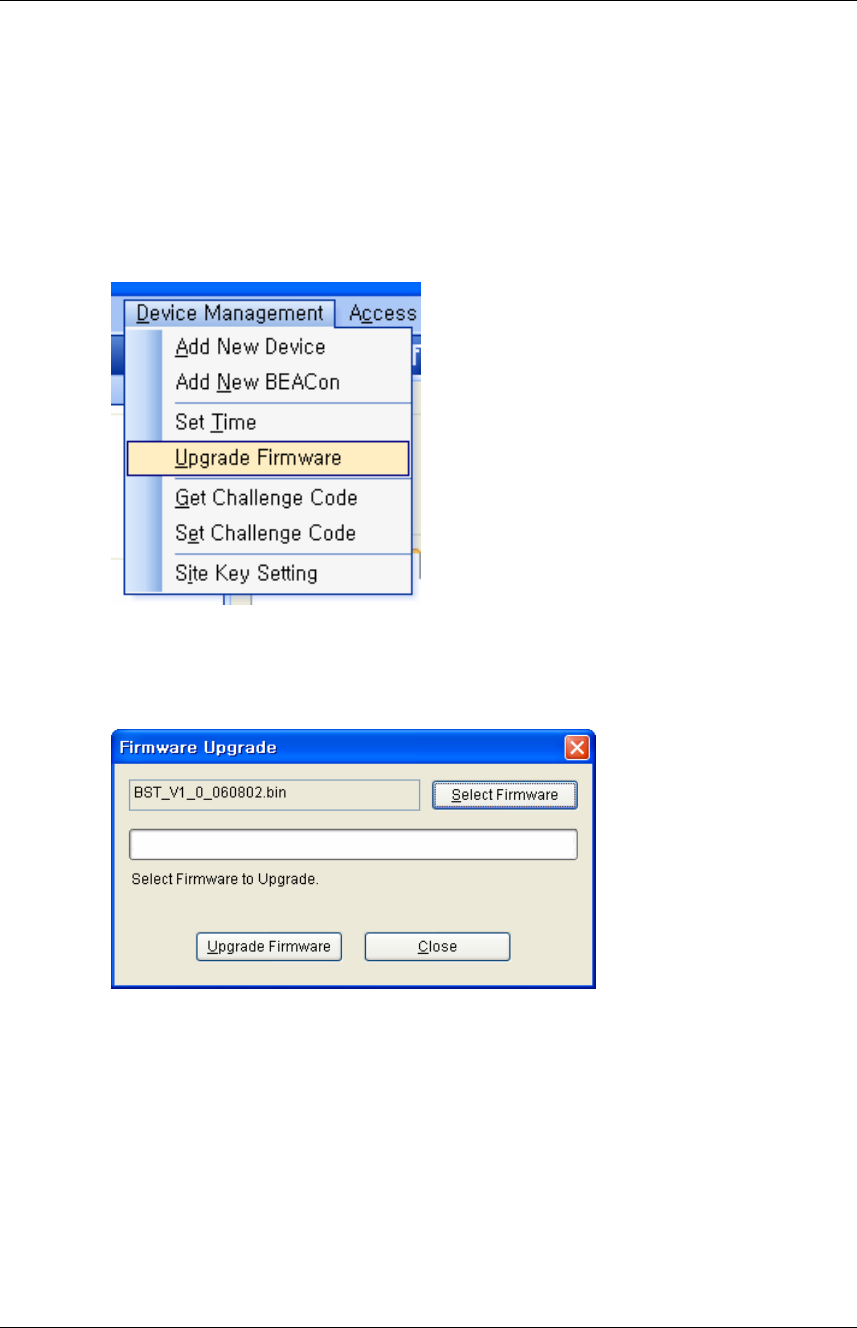
BioAdmin User Manual 243
Copyright © 2006, 2007 by Suprema Inc. http://www.supremainc.com
z You can synchronize the time of all of the networked BioEntry™ to the time of
host PC. If you already checked on the Synchronize current PC time at
startup check box, which is on Options Æ Preference Æ Device Time Setting,
you do not need to synchronize the time on this menu.
10.3.2. FW upgrade
z By selecting the Firmware Upgrade menu, a pop-up window for firmware
upgrade appears:
z Select a firmware file by clicking the Search Firmware button.
z Execute upgrade by clicking the Upgrade Firmware button.
z If BioEntry or BioStation is turned off or reset in the process of upgrading,
restoration might be impossible.
z Firmware upgrade is processed for one device. Selection of a group or all
devices is not allowed.
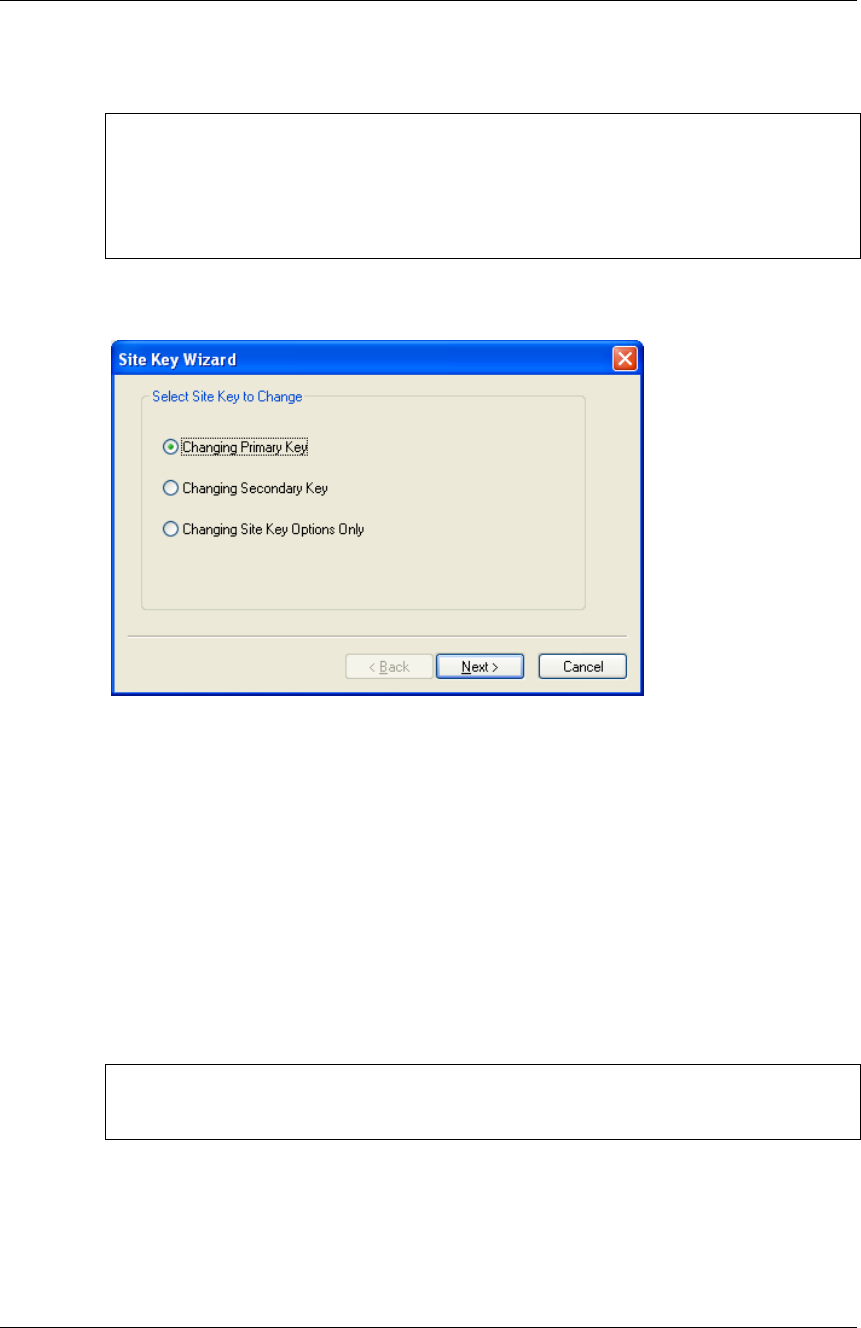
BioAdmin User Manual 244
Copyright © 2006, 2007 by Suprema Inc. http://www.supremainc.com
For detailed setting, refer to chapter 5 ‘user management’.
Note : Once firmware upgrade is complete, BioEntry and BioStation are rebooted
automatically and connected to network. It is recommended not to do any other
operation for about 5-10 sec after BioEntry or BioStation are rebooted due to
upgrade.
10.3.3. Site Key Setting
To prevent unauthorized access, Smartcards are encrypted with a 48 bit site key.
For a BioEntry device to decrypt a Smartcard, the site key stored in the device
should match with that of the card. Users can store as many as two site keys in the
BioEntry device and select two advanced options. If the Use Secondary Key
option is selected, the device will try both the primary and secondary keys when
decrypting a Smartcard. If it is not selected, the device will try only the primary key.
The Auto Update option is useful when changing the keys of Smartcards. With
this option on, the device will re-encrypt a Smartcard with the primary key when it is
encrypted with the secondary key.
Note : Site keys should be handled with utmost caution. If it is revealed, the
whole system is not secure any more.
z Primary Key
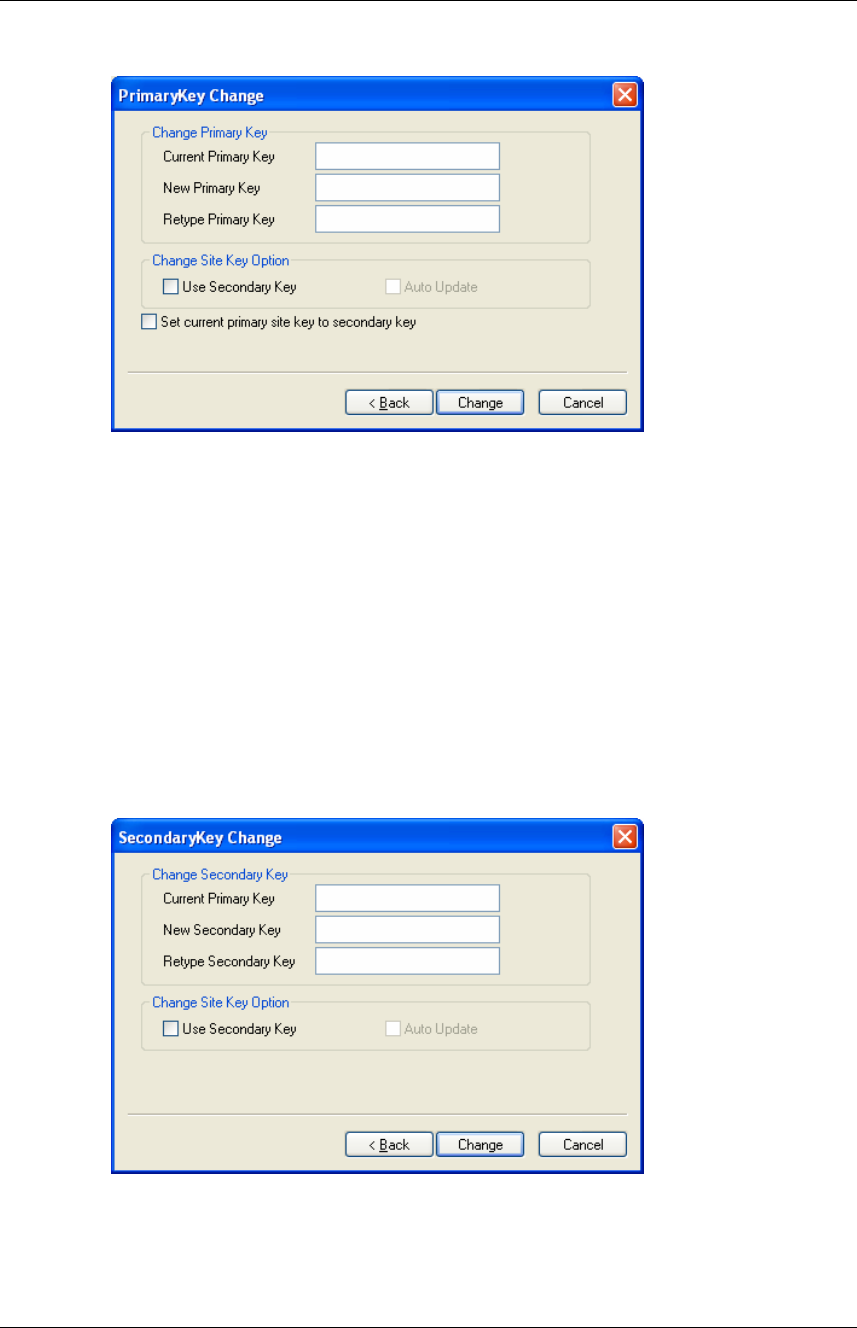
BioAdmin User Manual 245
Copyright © 2006, 2007 by Suprema Inc. http://www.supremainc.com
To change the primary key, you should enter the current and new primary keys.
Besides the Auto Update option, you can also select the following options.
Set current primary site key to secondary key : Replaces the
secondary key with the current primary key before changing the primary
key.
z Secondary Key
To change the secondary key, you should enter the current primary key and the
new secondary key.
z Key Options
You can also change the key options only. In this case, you only have to enter
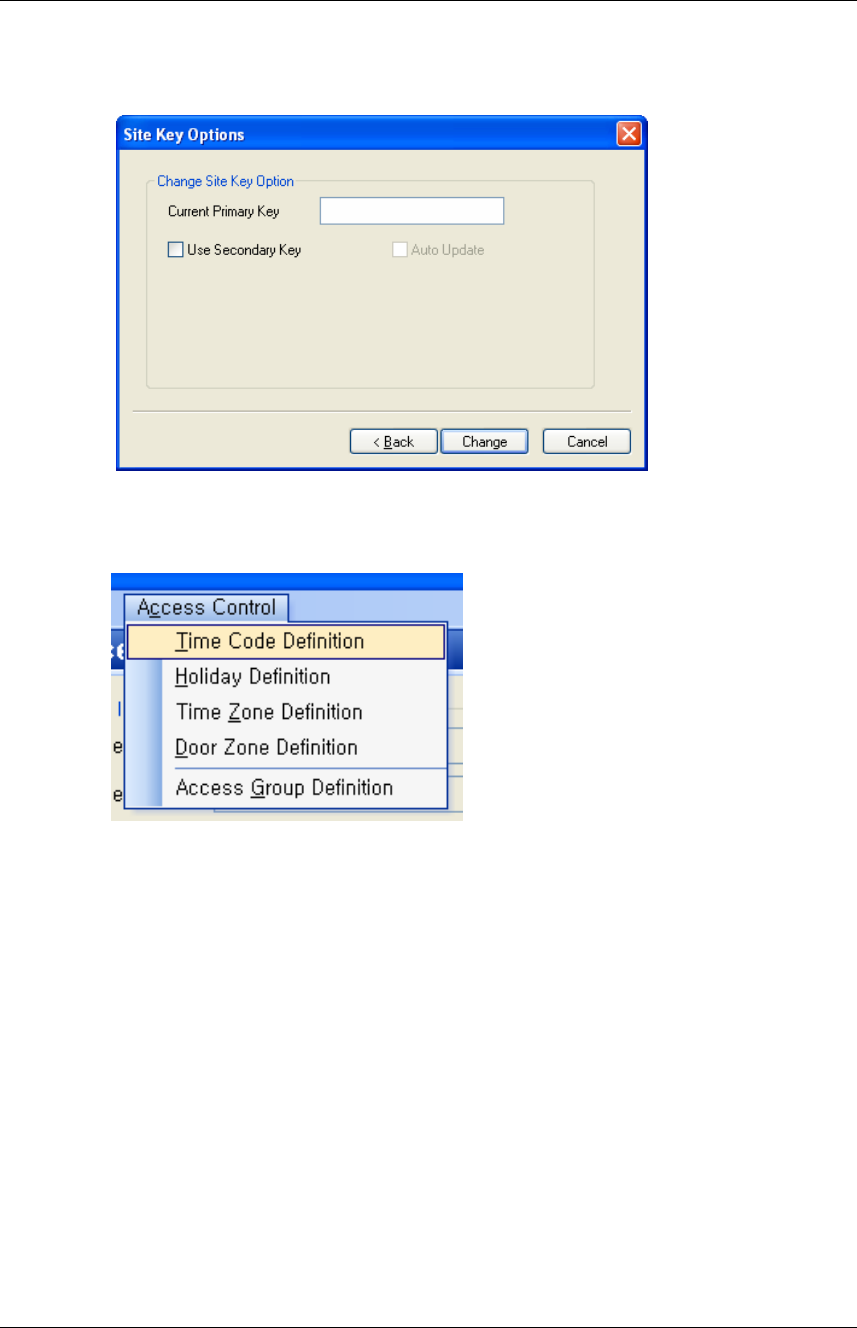
BioAdmin User Manual 246
Copyright © 2006, 2007 by Suprema Inc. http://www.supremainc.com
the current primary key with the options.
10.4. Access (I/O) Control
Access control menu on menu bar supports following functions.
z Time Code Definition
z Holiday Setting
z Time Zone Setting
z Door Zone Setting
z Access Group Setting
For detailed setting, refer to chapter 8, access control.

BioAdmin User Manual 247
Copyright © 2006, 2007 by Suprema Inc. http://www.supremainc.com
Contact Information
Suprema Inc.
16F Parkview Office Tower, Jeongja-dong, Bundang, Seongnam, Gyeonggi, Korea
Tel : +82-31-783-4502
Fax : +82-31-783-4503
Website : http://www.supremainc.com
Sales inquiry : sales@supremainc.com
Technical inquiry : support@supremainc.com
CAUTION: Changes or modifications not expressly approved by the manufacturer
responsible for compliance could void the user’s authority to operate the equipment
WARN IN G
This device complies with part 15 of the FCC Rules. Operation is subject to the
following two conditions: (1) This device may not cause harmful interference, and (2)
this device must accept any interference received, including interference that may cause
undesired operation.
INFORMATION TO USER:
This equipment has been tested and found to comply with the limit of a Class B digital
device, pursuant to Part 15 of the FCC Rules. These limits are designed to provide
reasonable protection against harmful interference in a residential installation. This
equipment generates, uses and can radiate radio frequency energy and, if not installed
and used in accordance with the instructions, may cause harmful interference to radio
communications. However, there is no guarantee that interference will not occur in a
particular installation; if this equipment does cause harmful interference to radio or
television reception, which can be determined by turning the equipment off and on, the
user is encouraged to try to correct the interference by one or more of the following
measures:
1. Reorient / Relocate the receiving antenna.
2. Increase the separation between the equipment and receiver.
3. Connect the equipment into an outlet on a circuit difference from that to which
the receiver is connected.
4. Consult the dealer or an experienced radio/TV technician for help